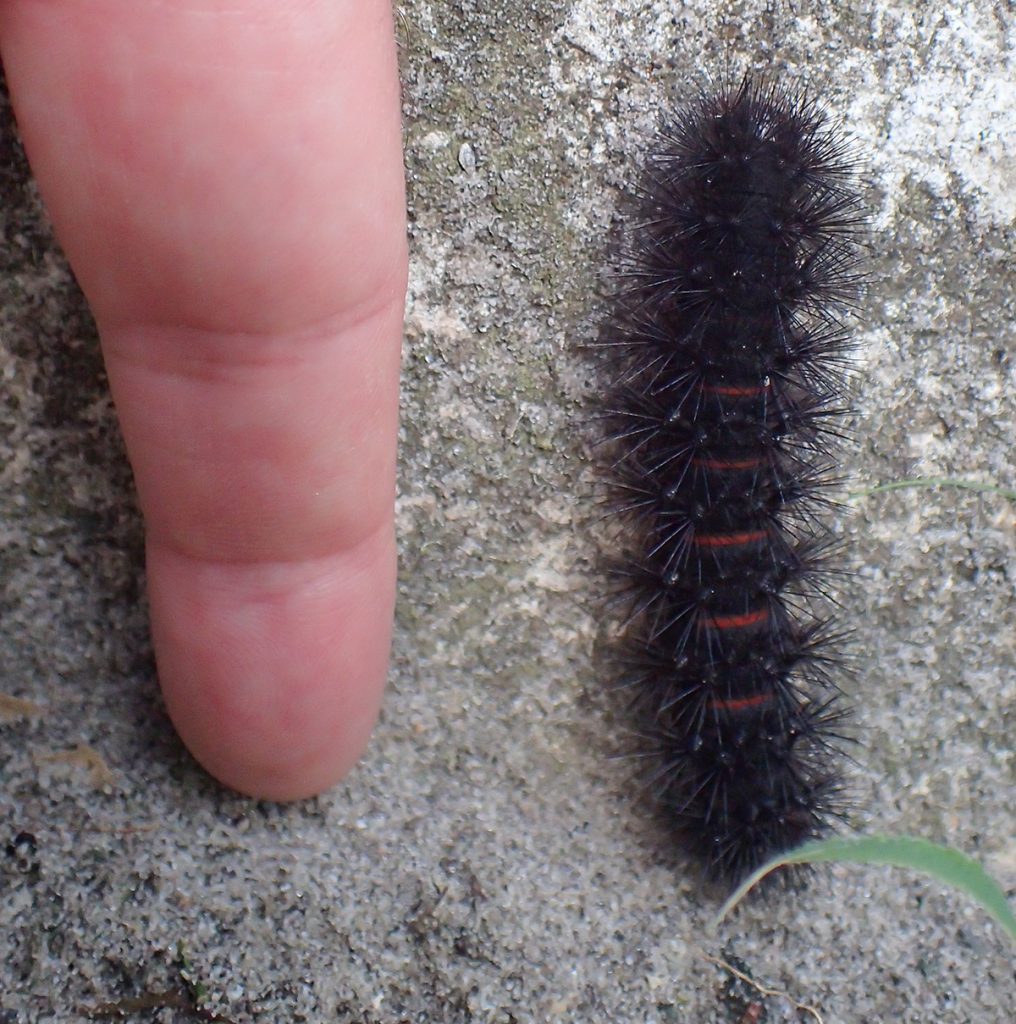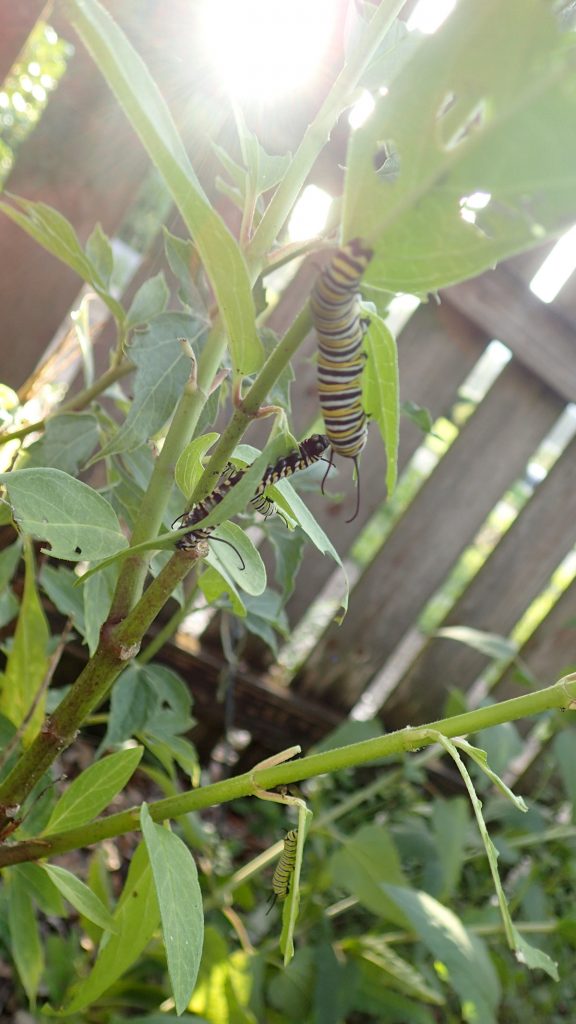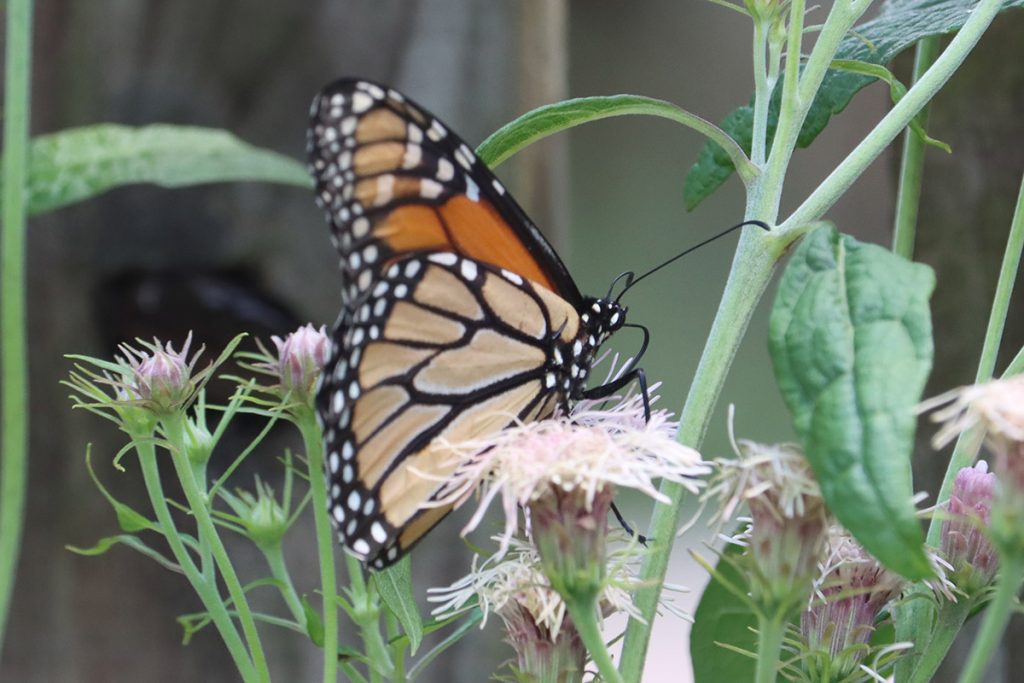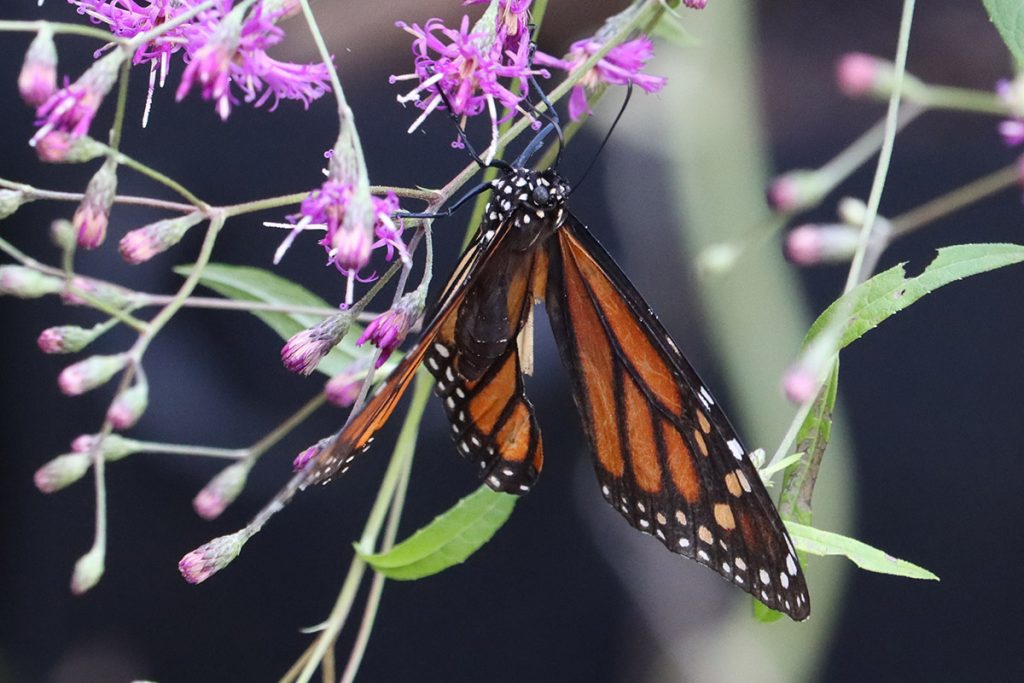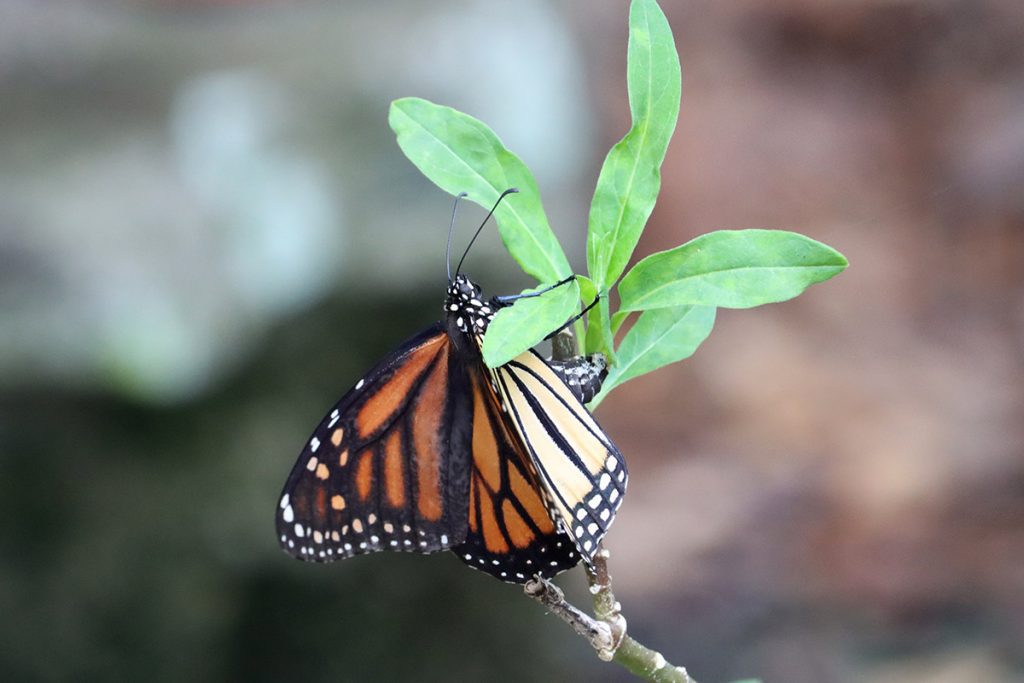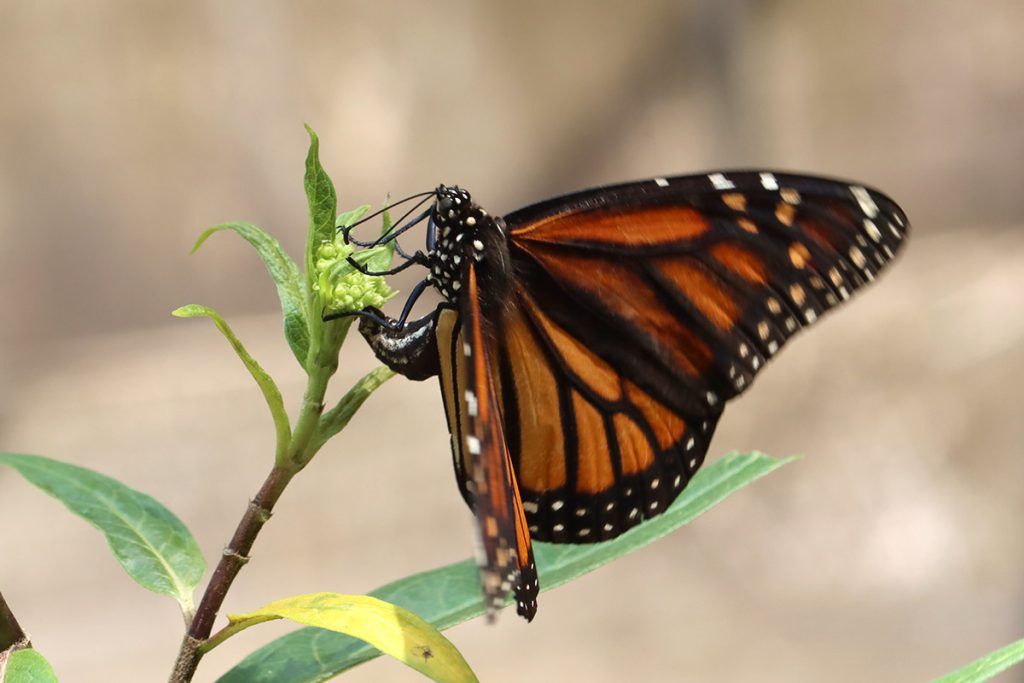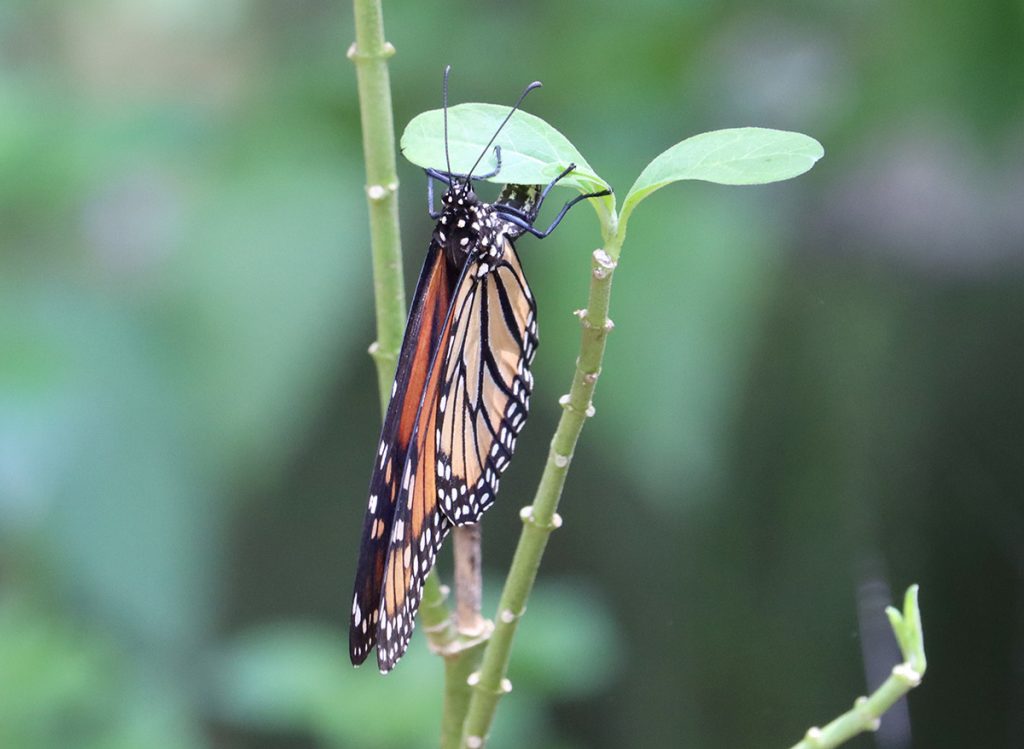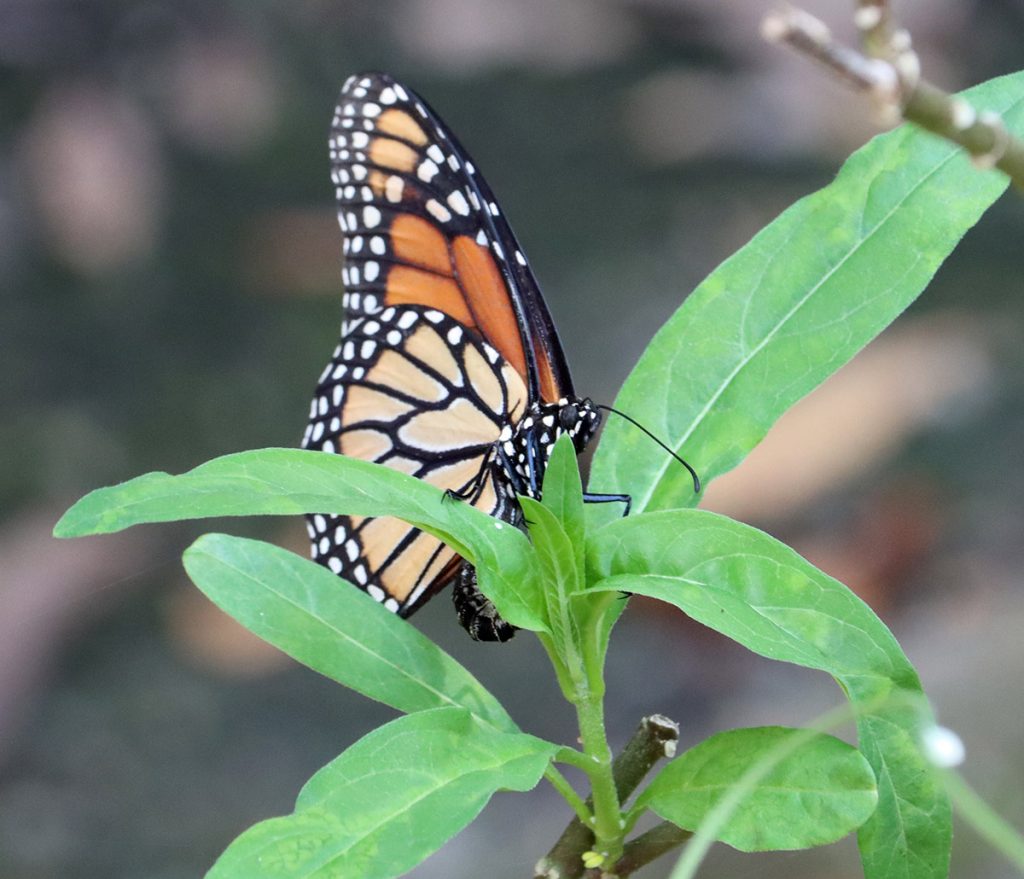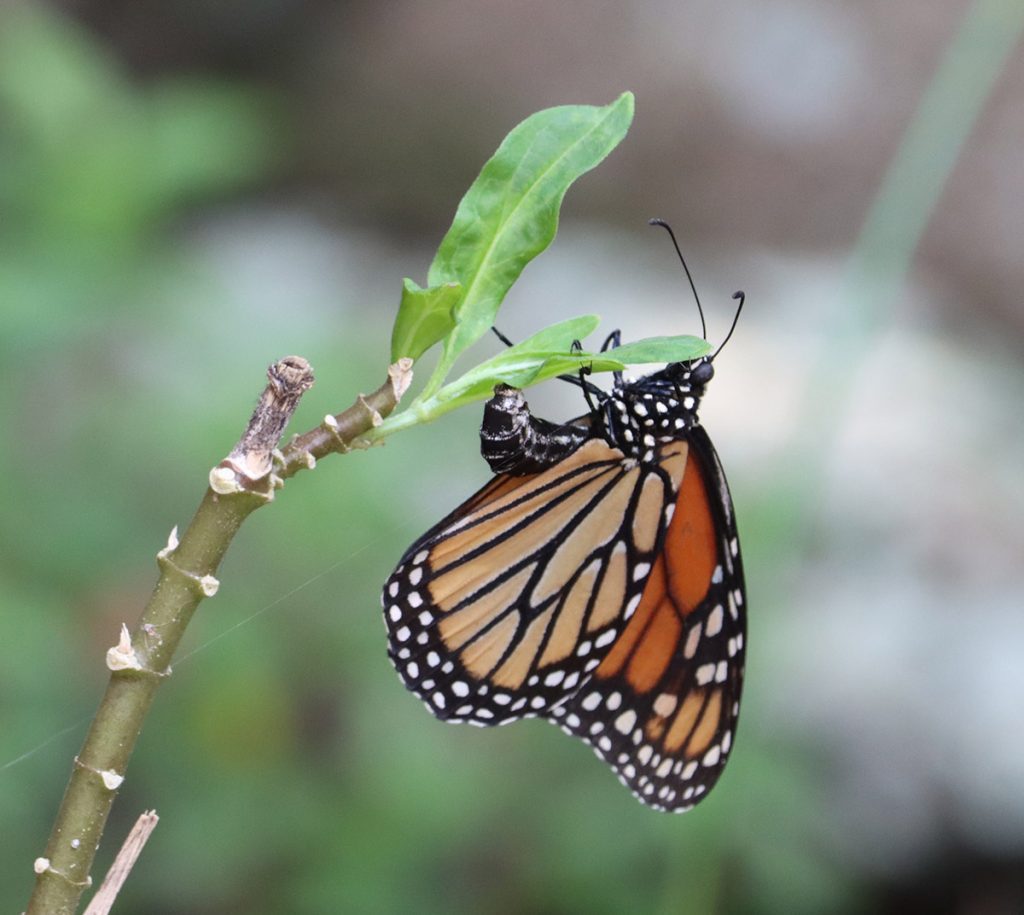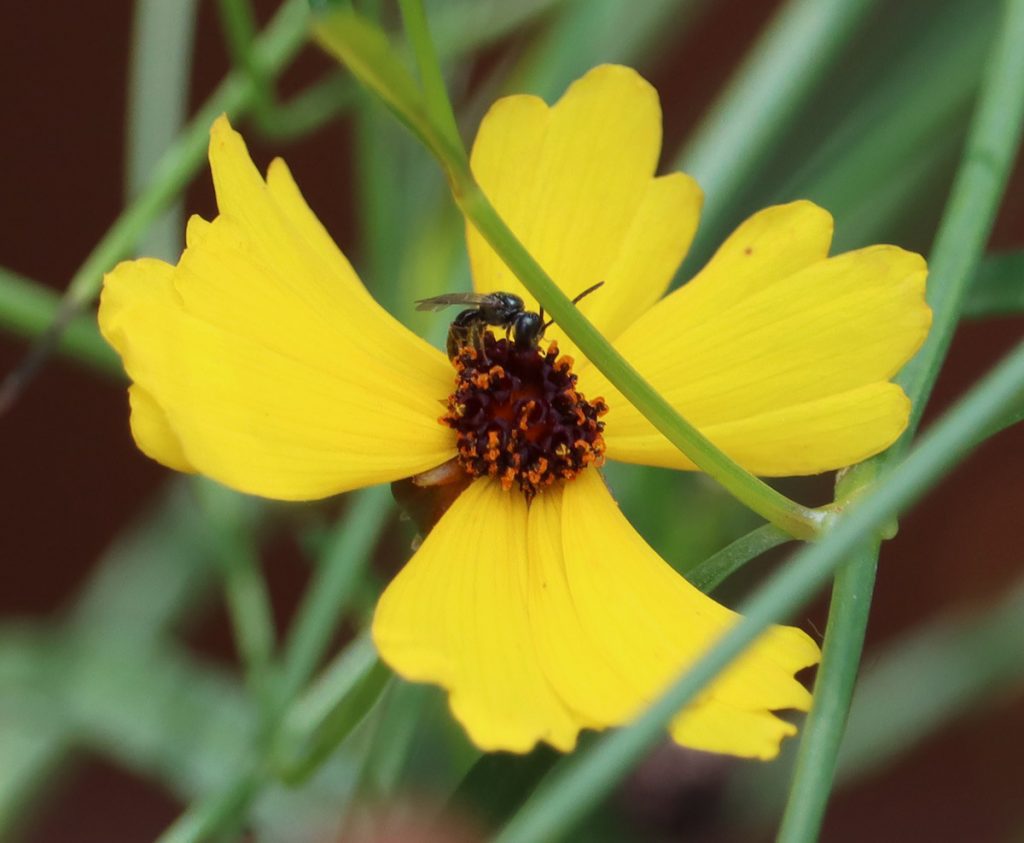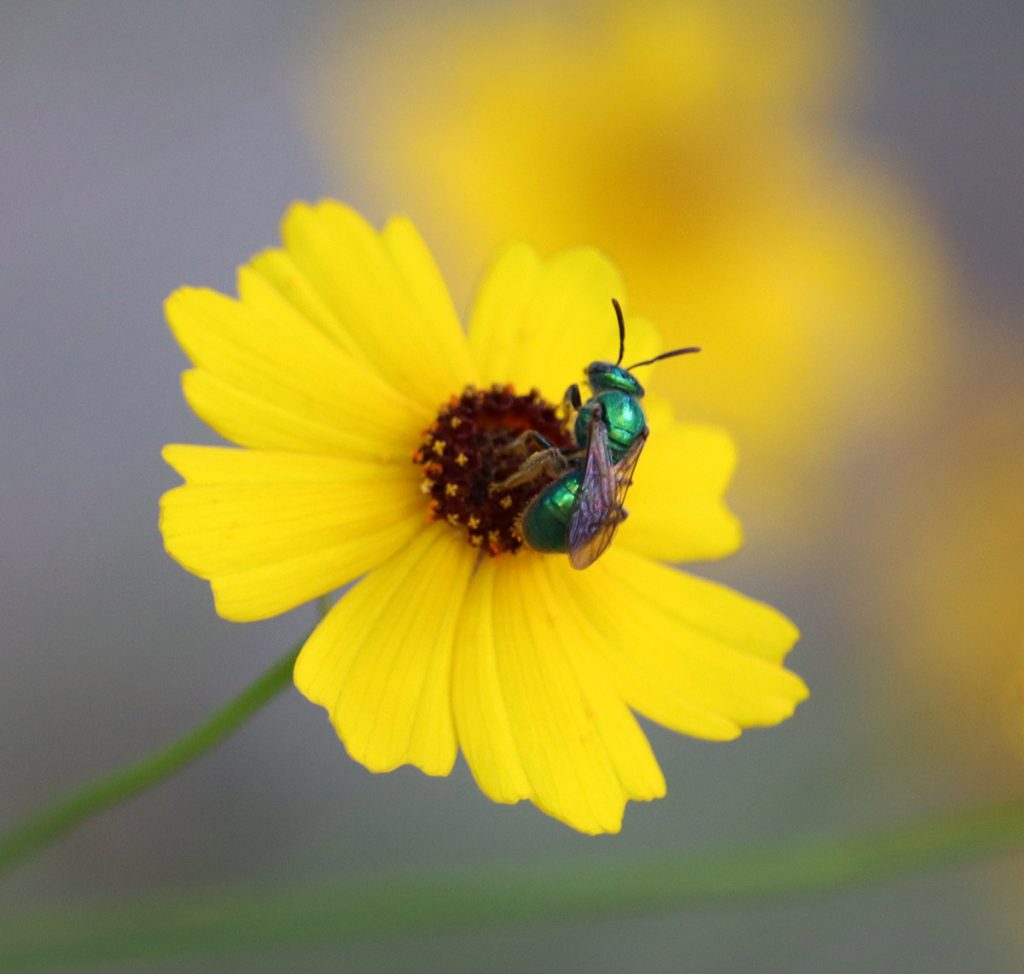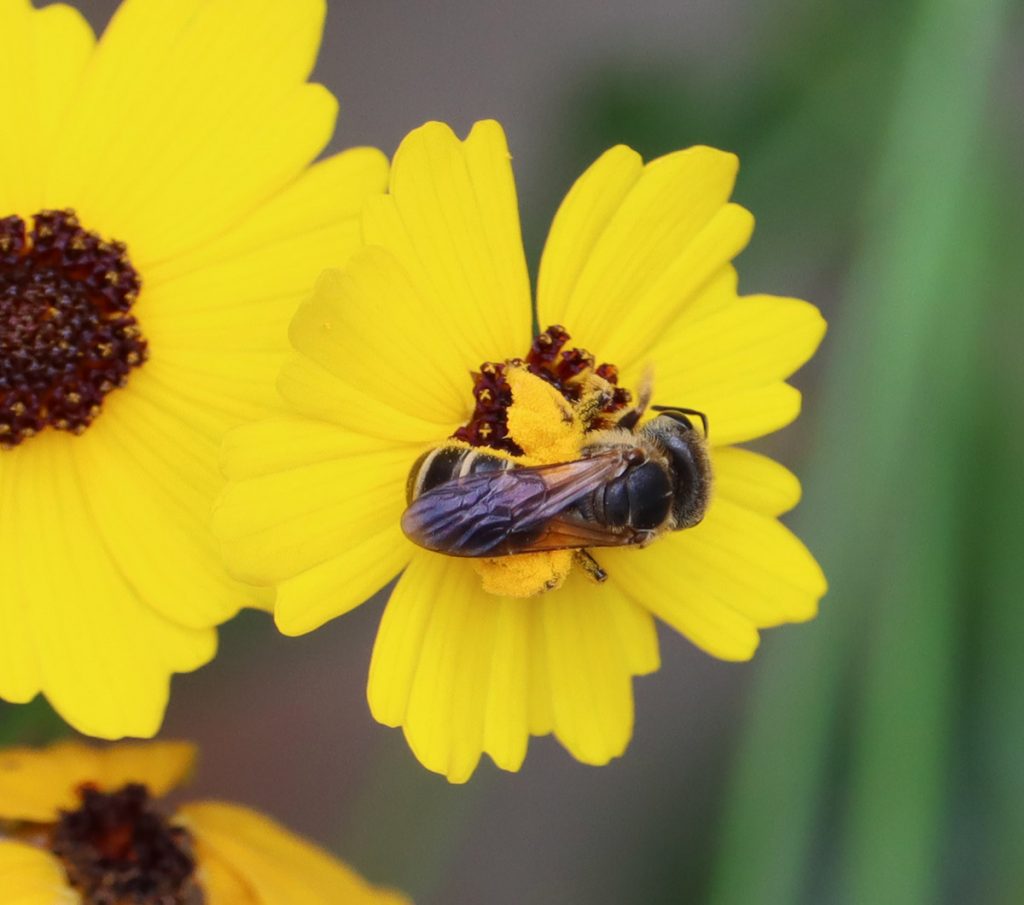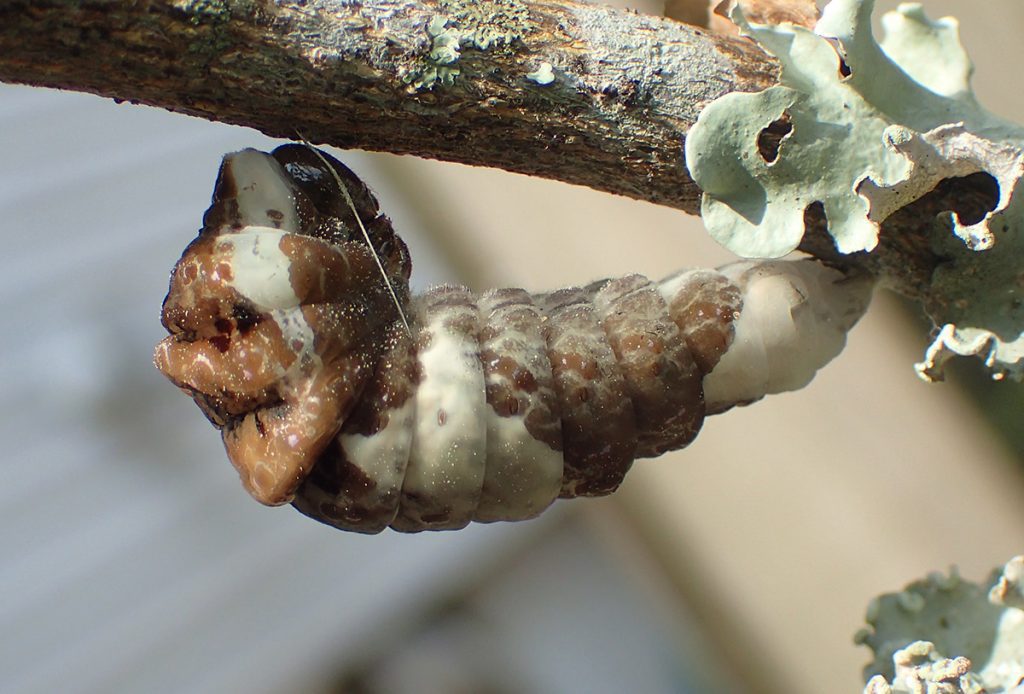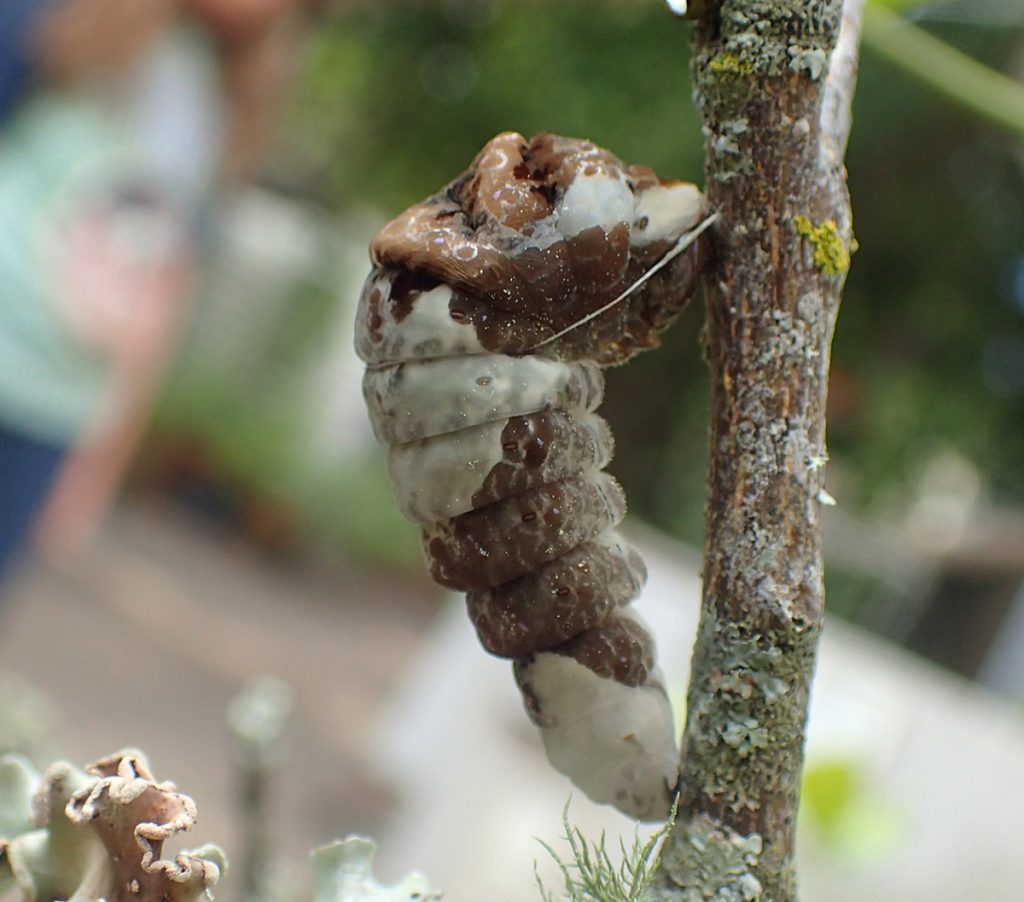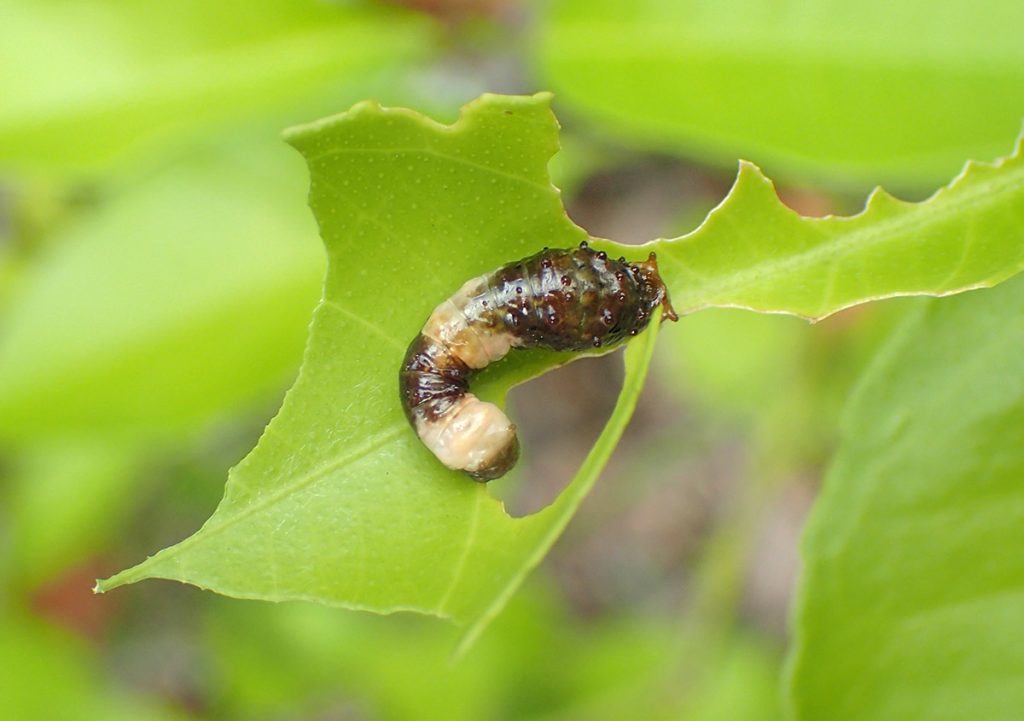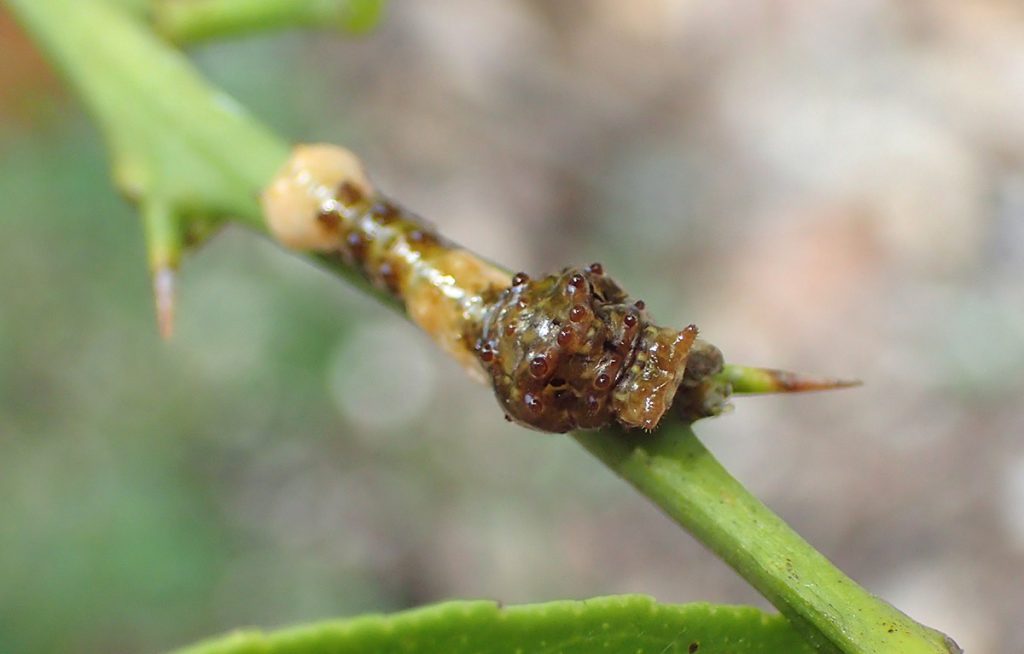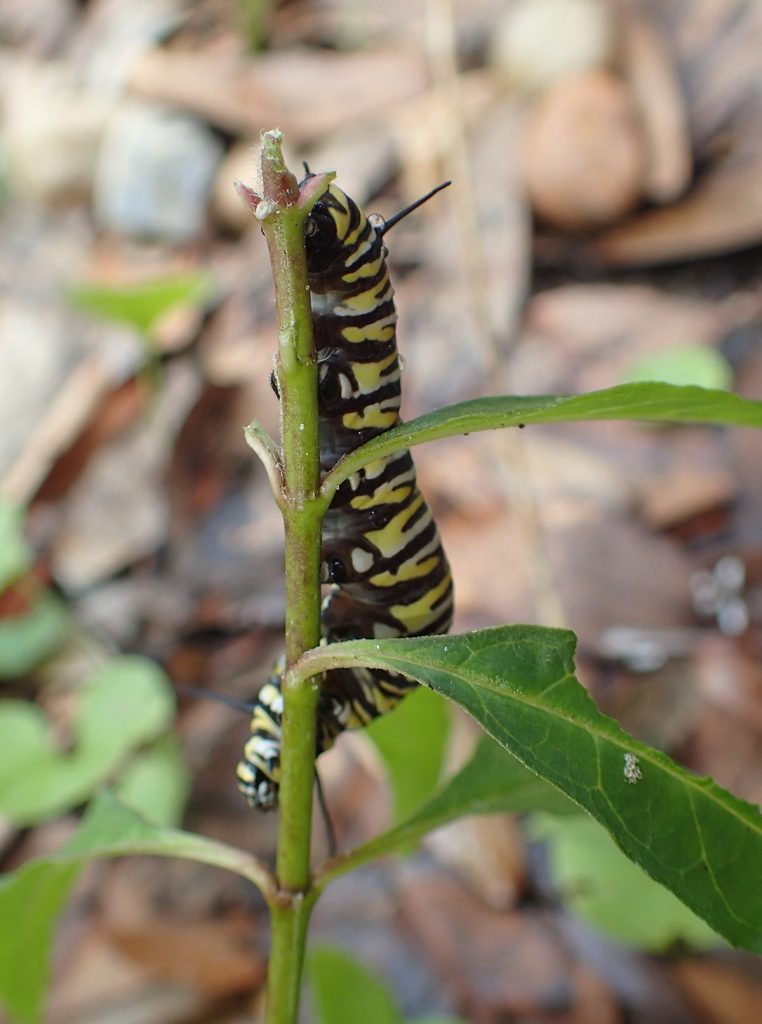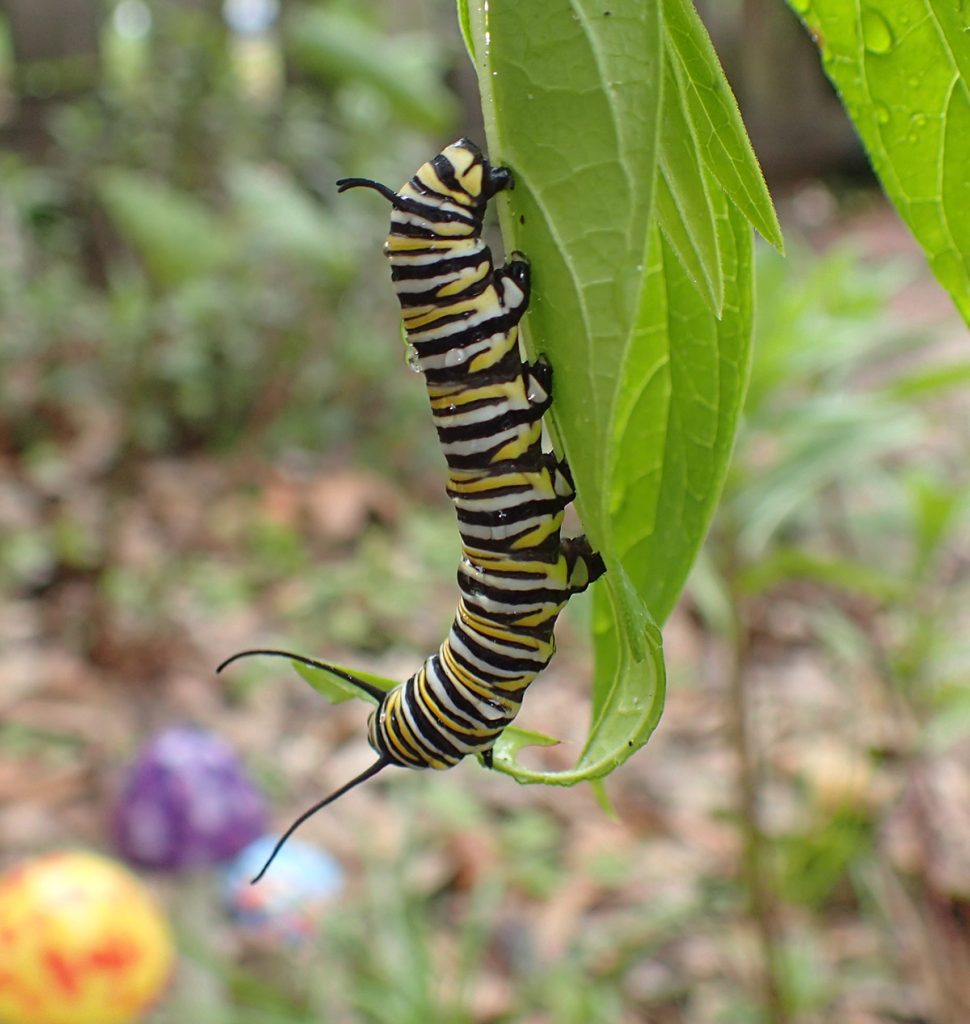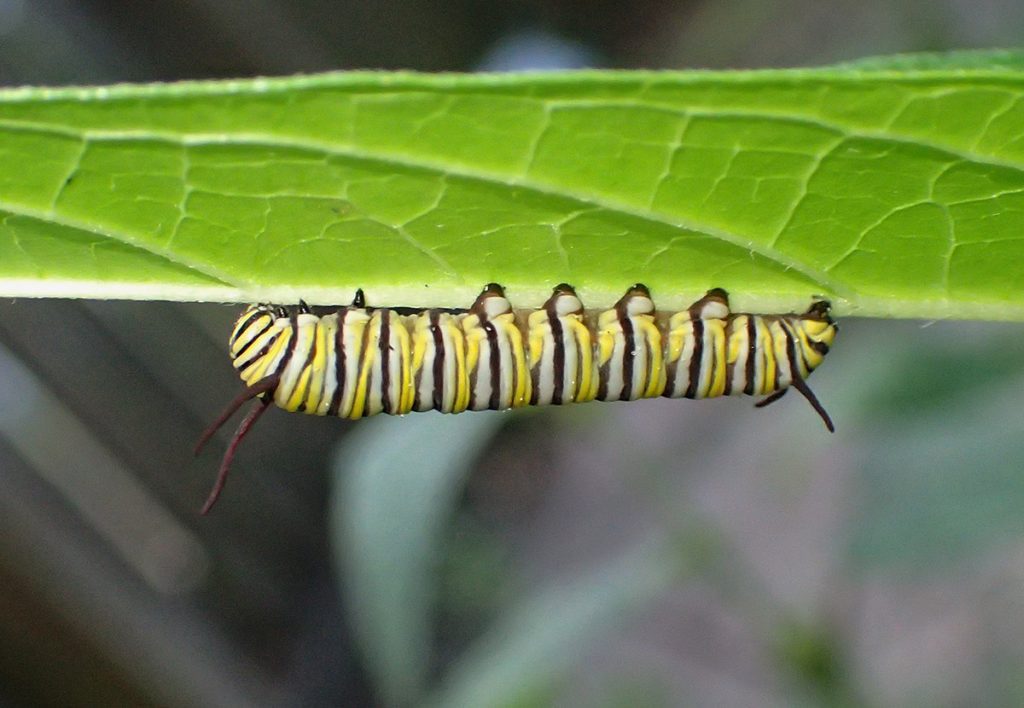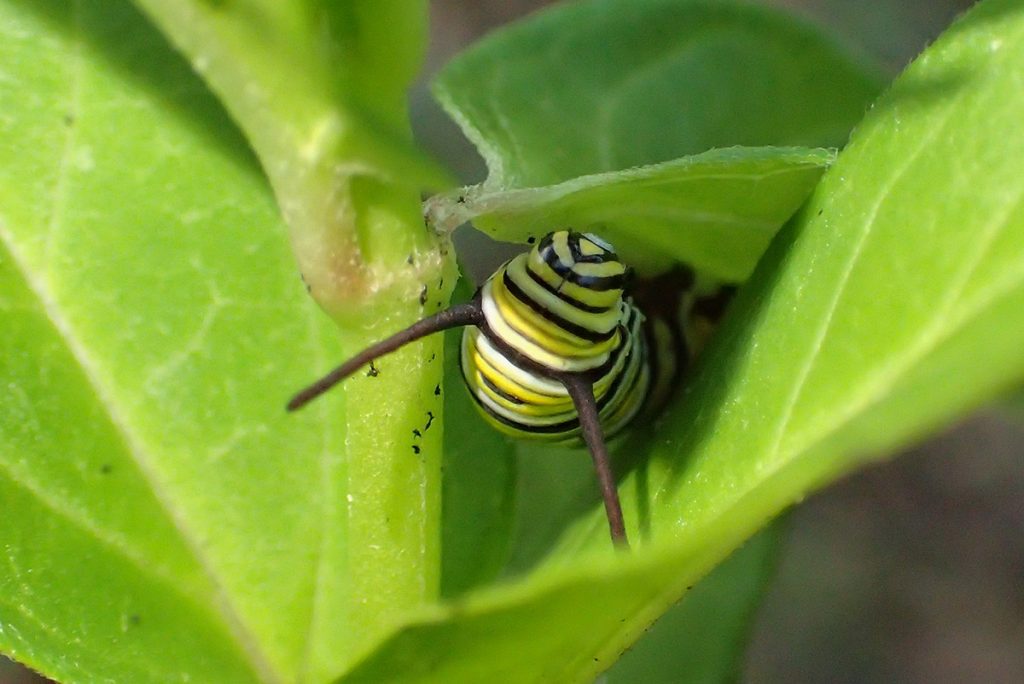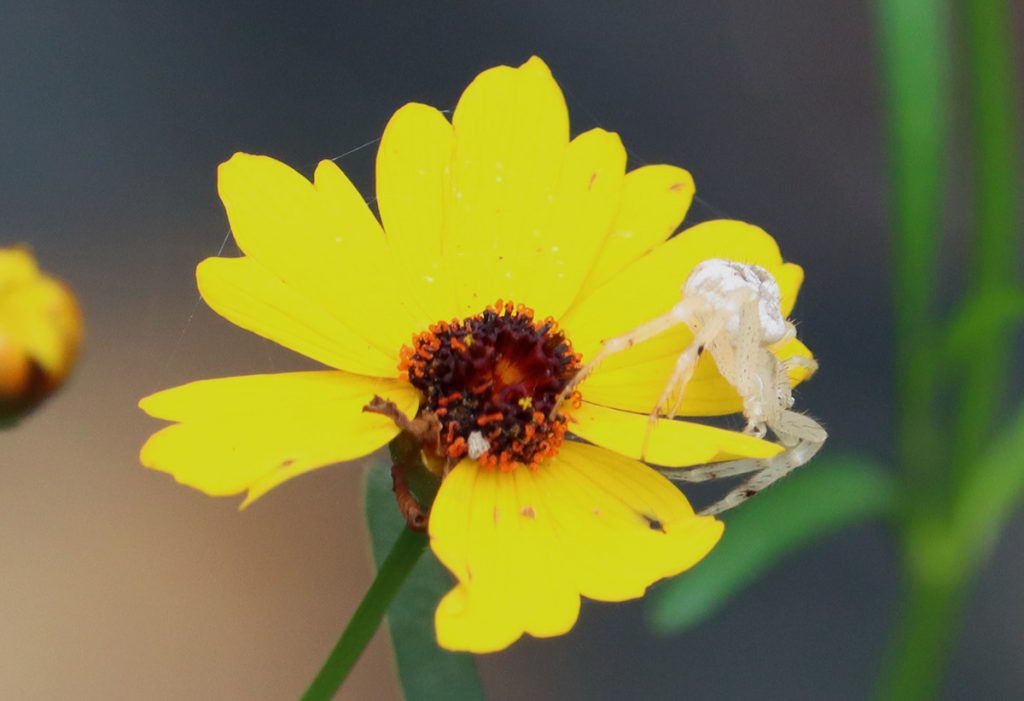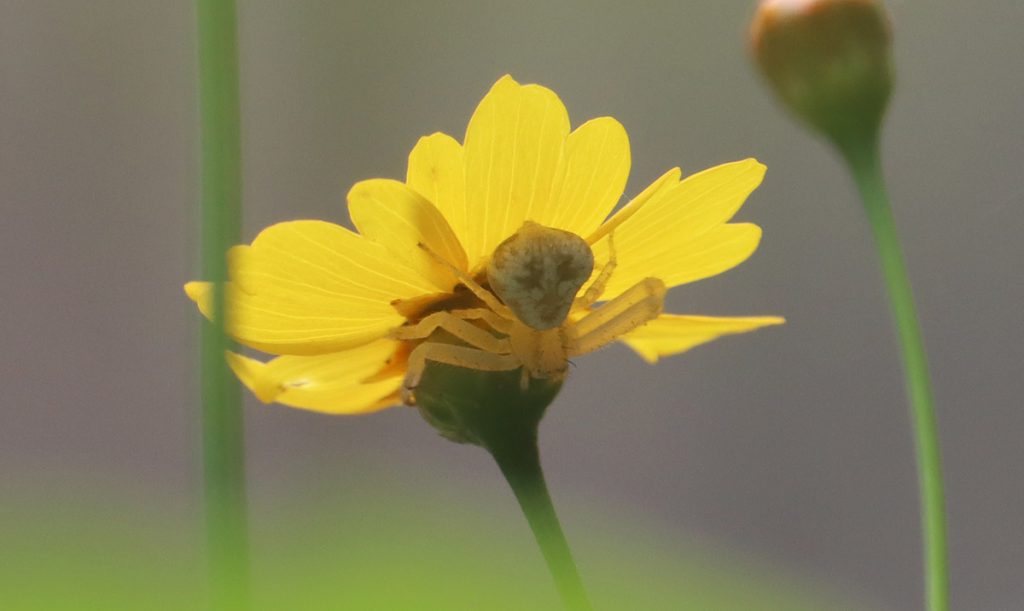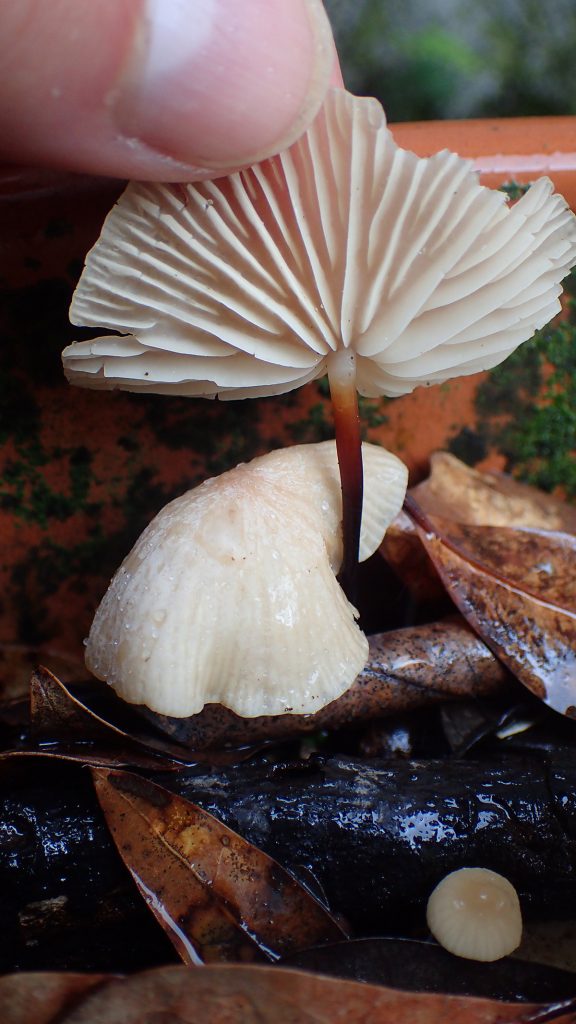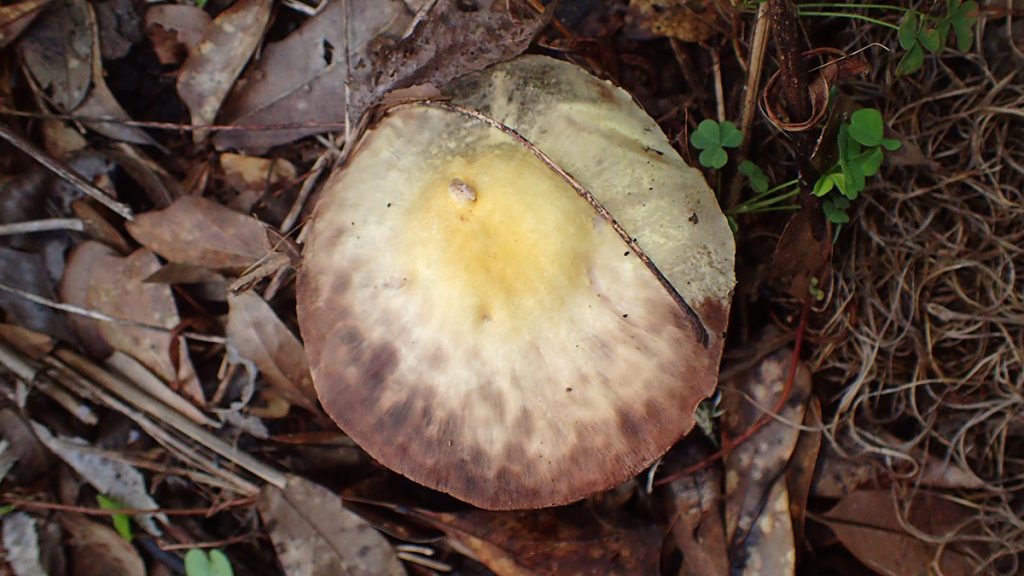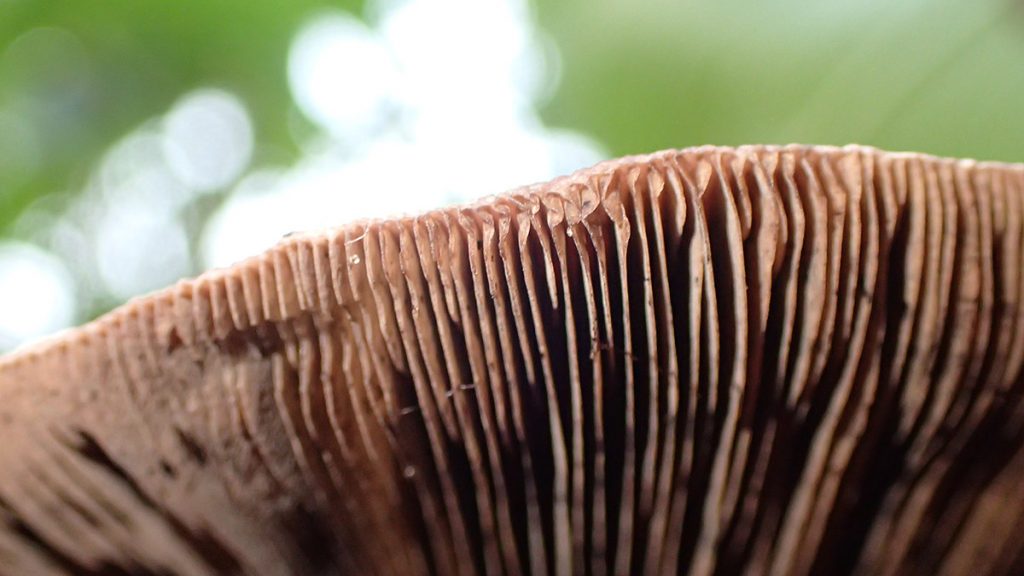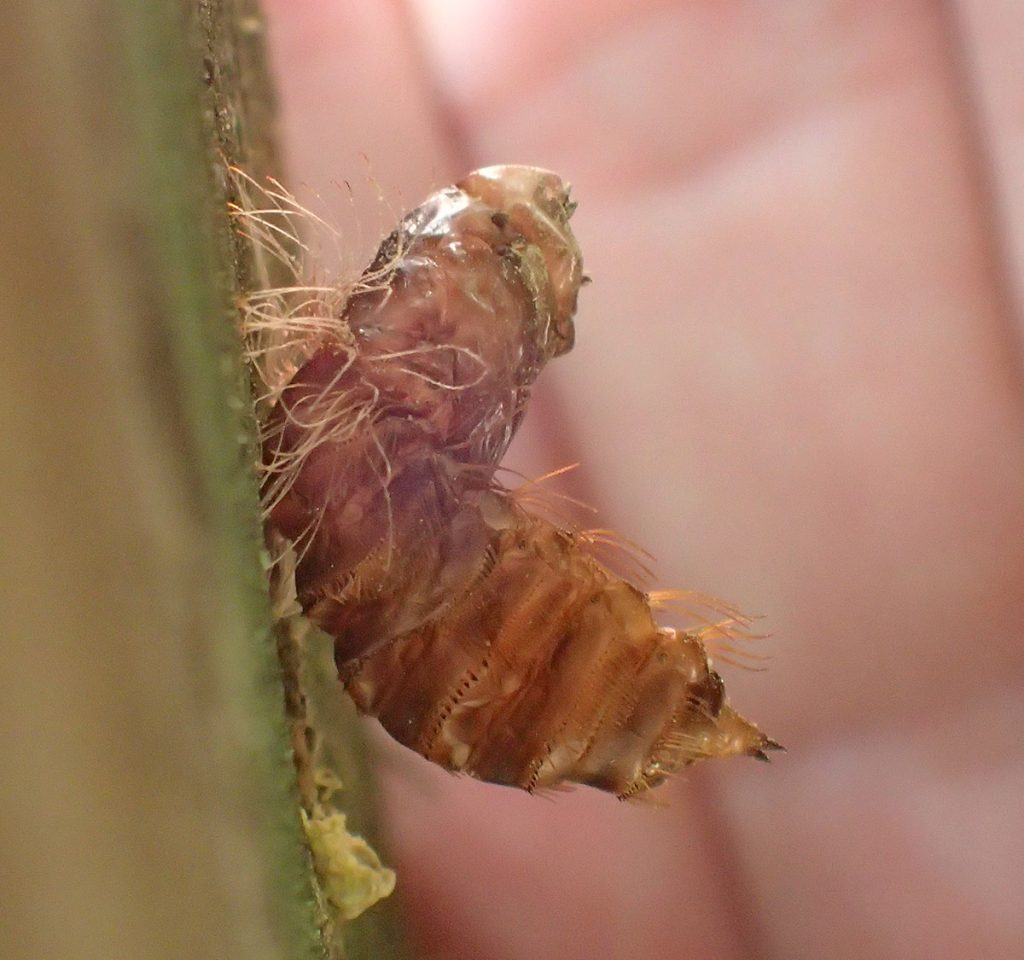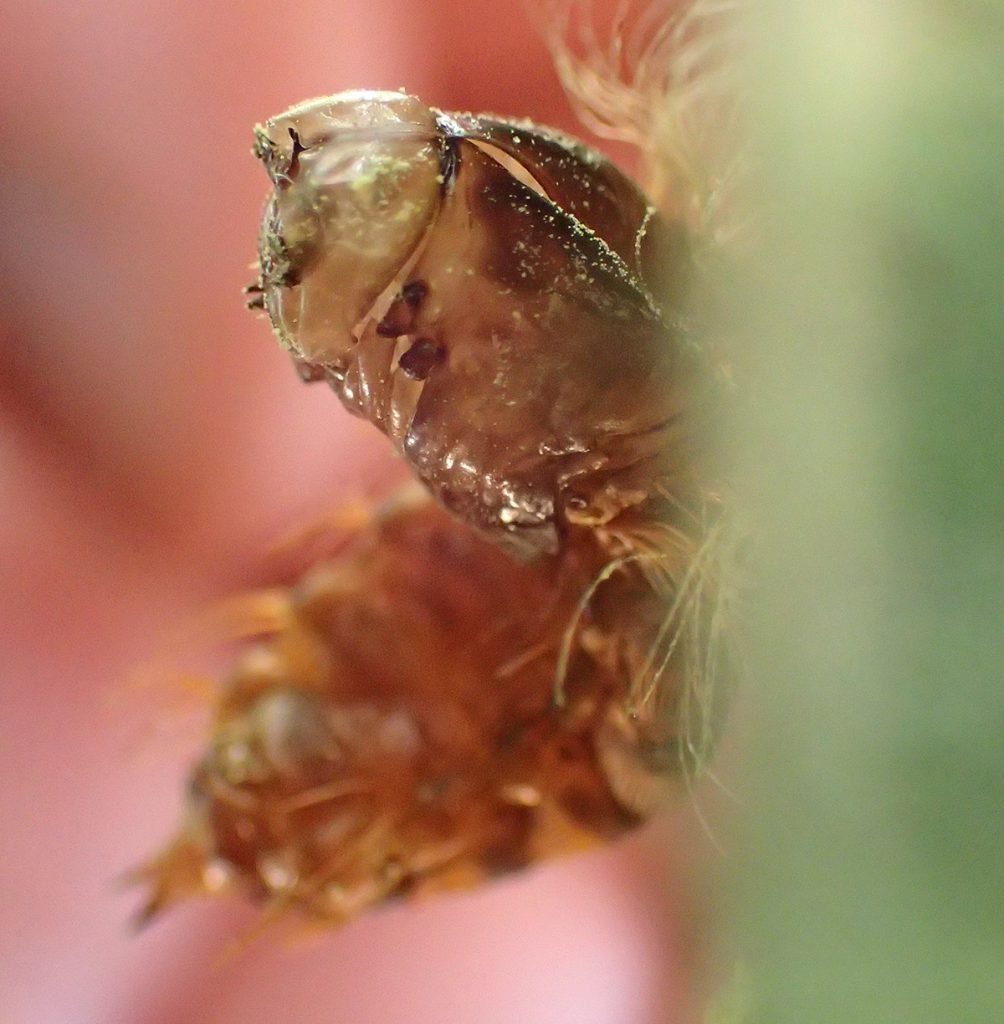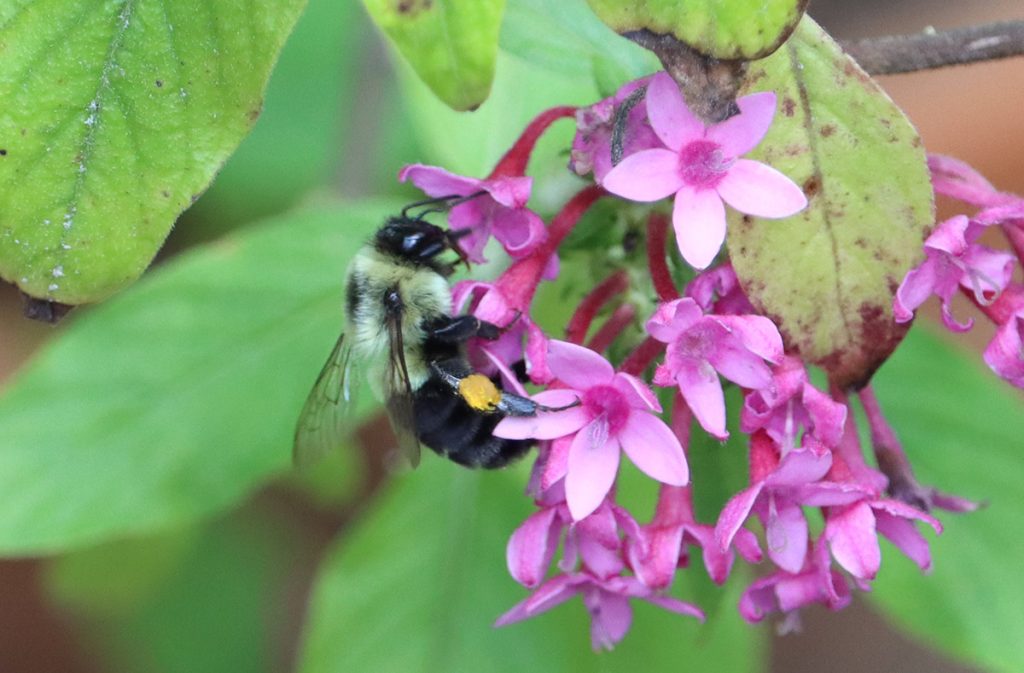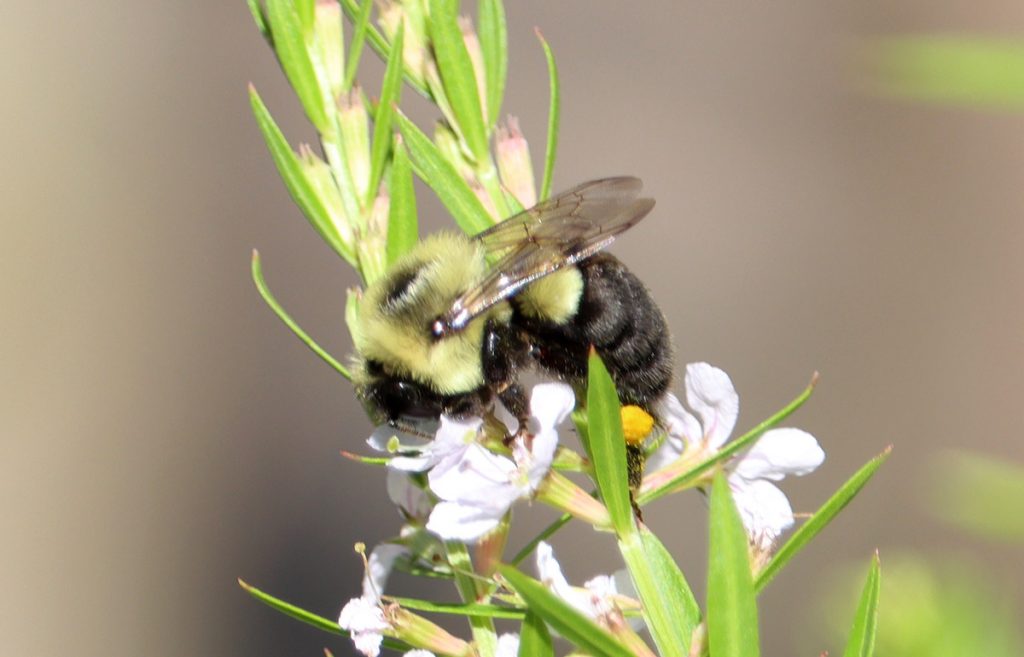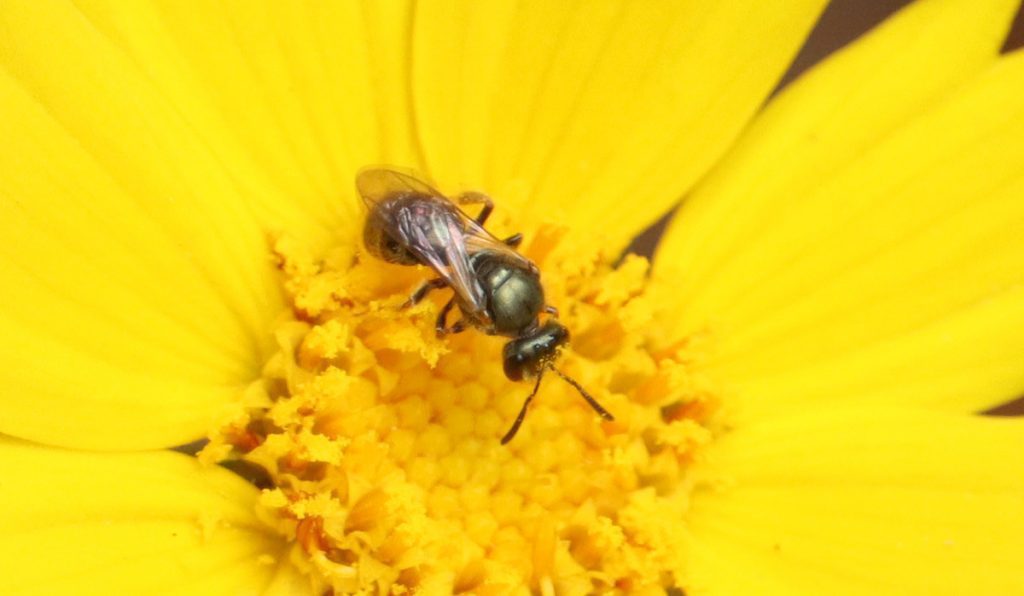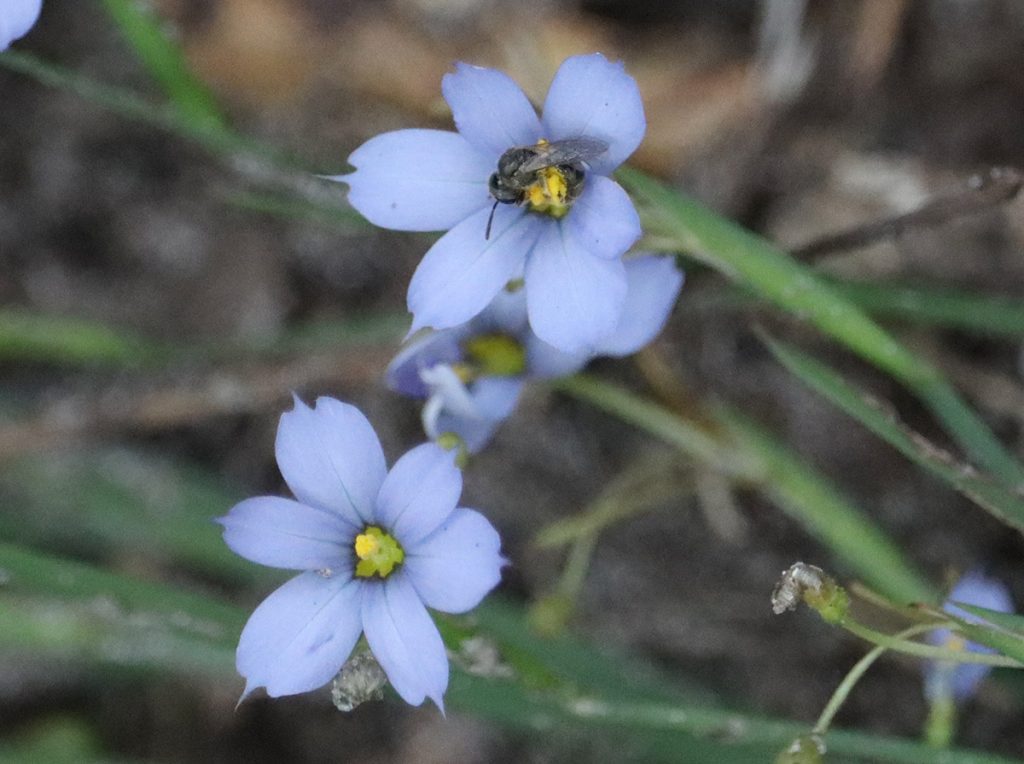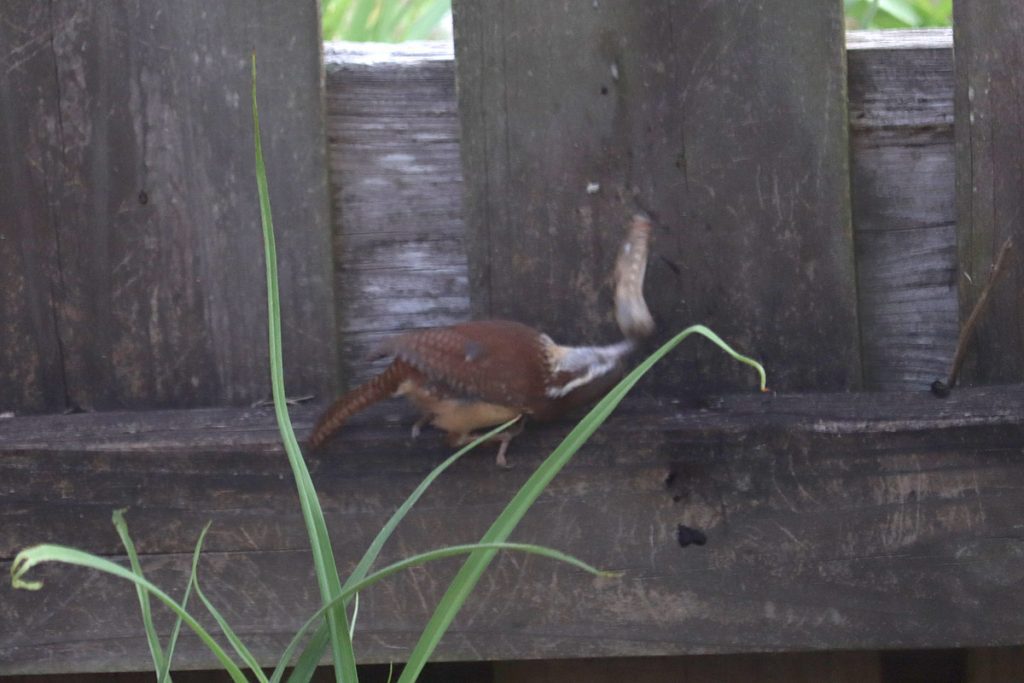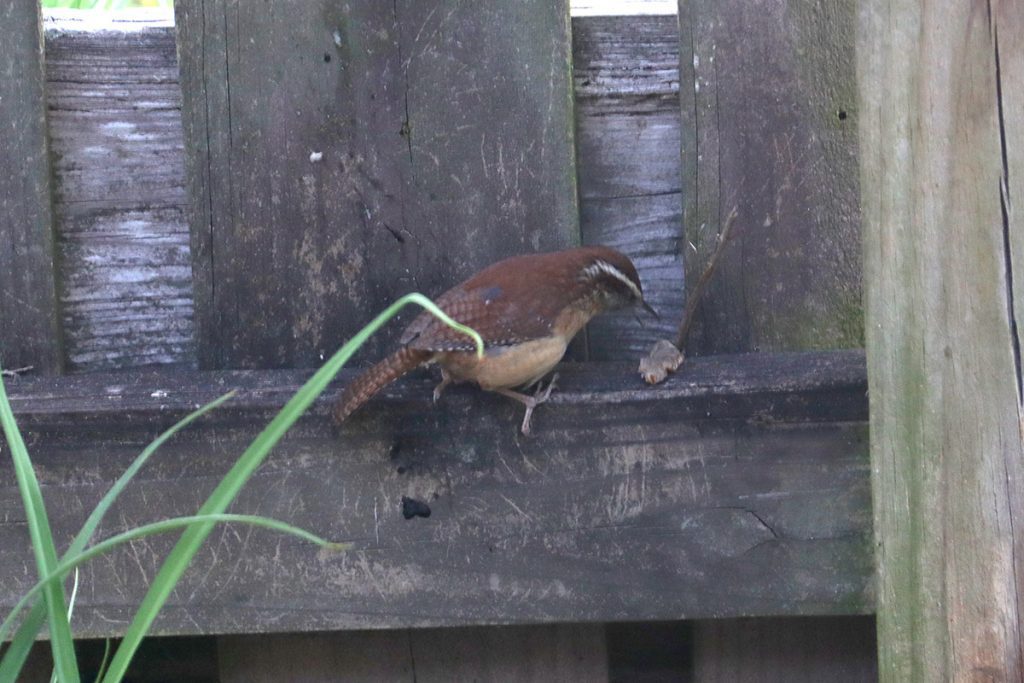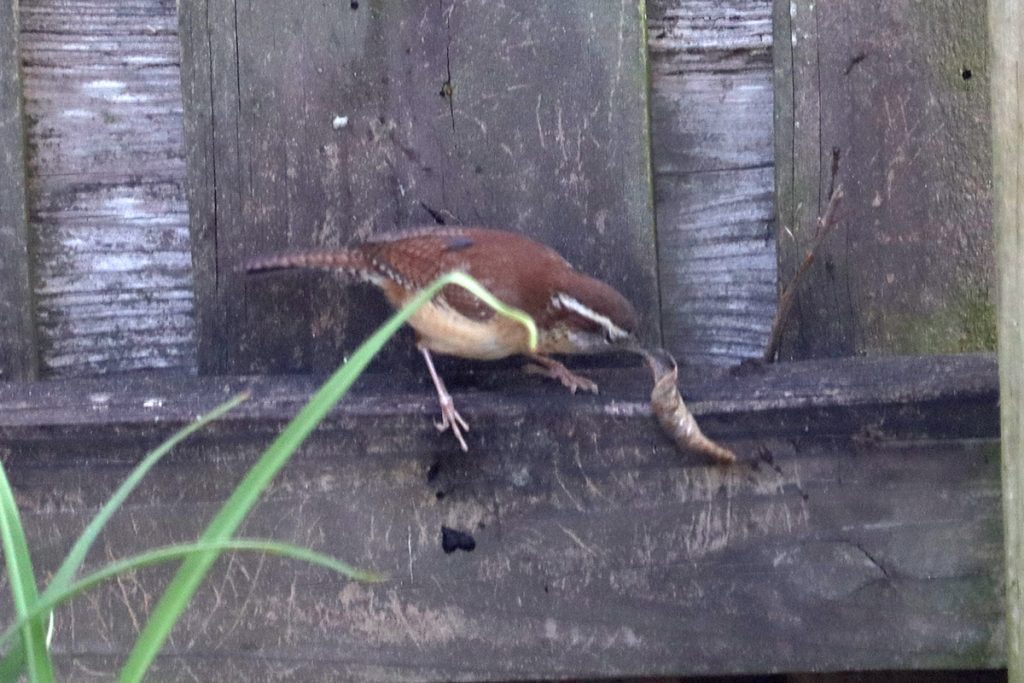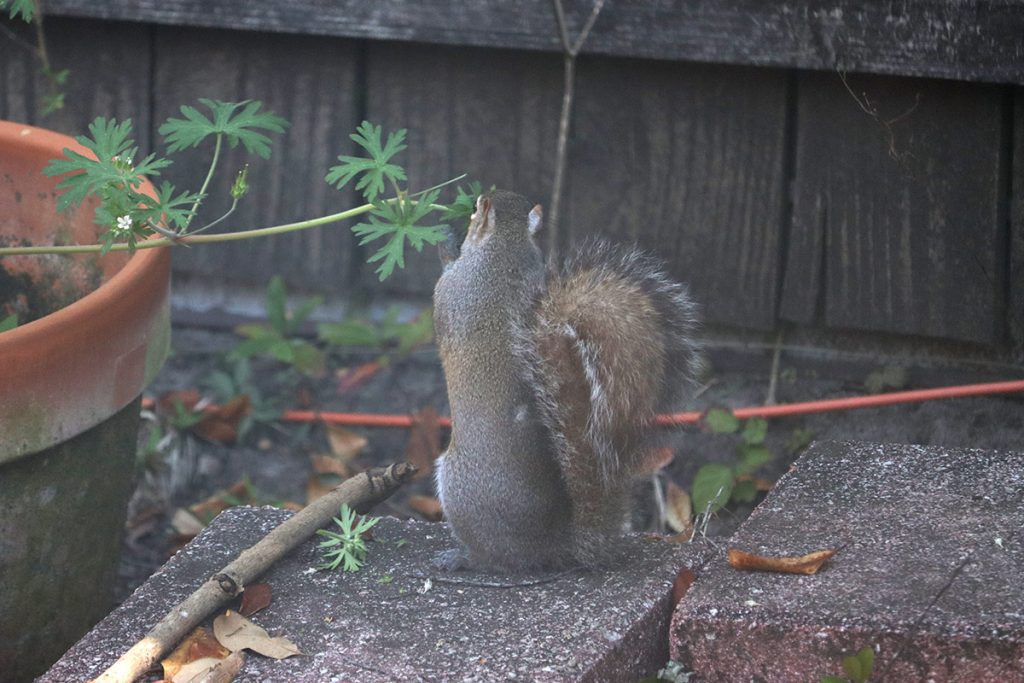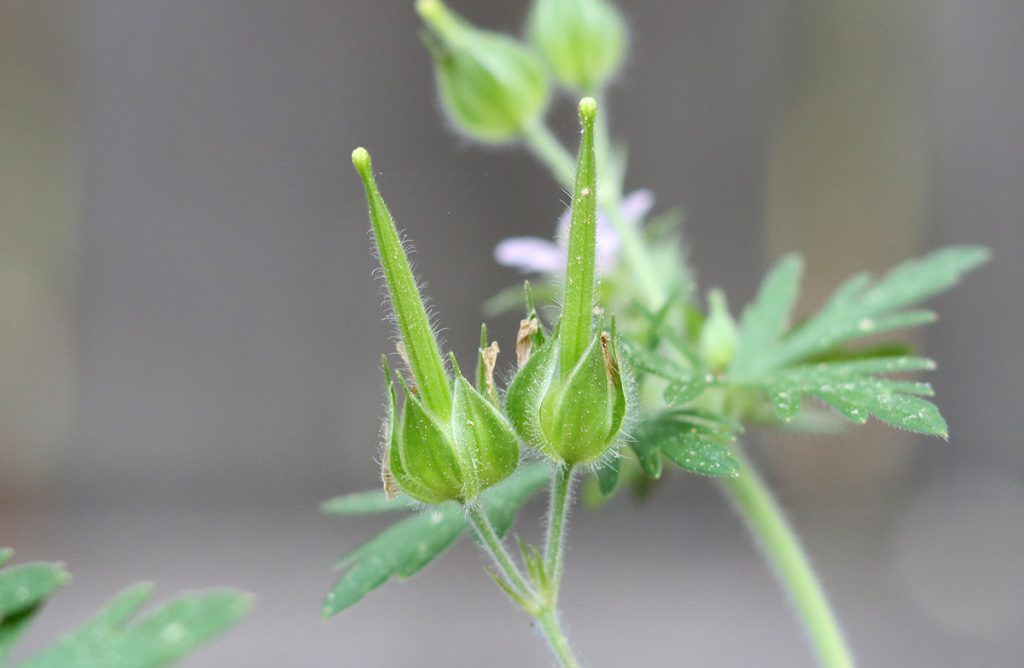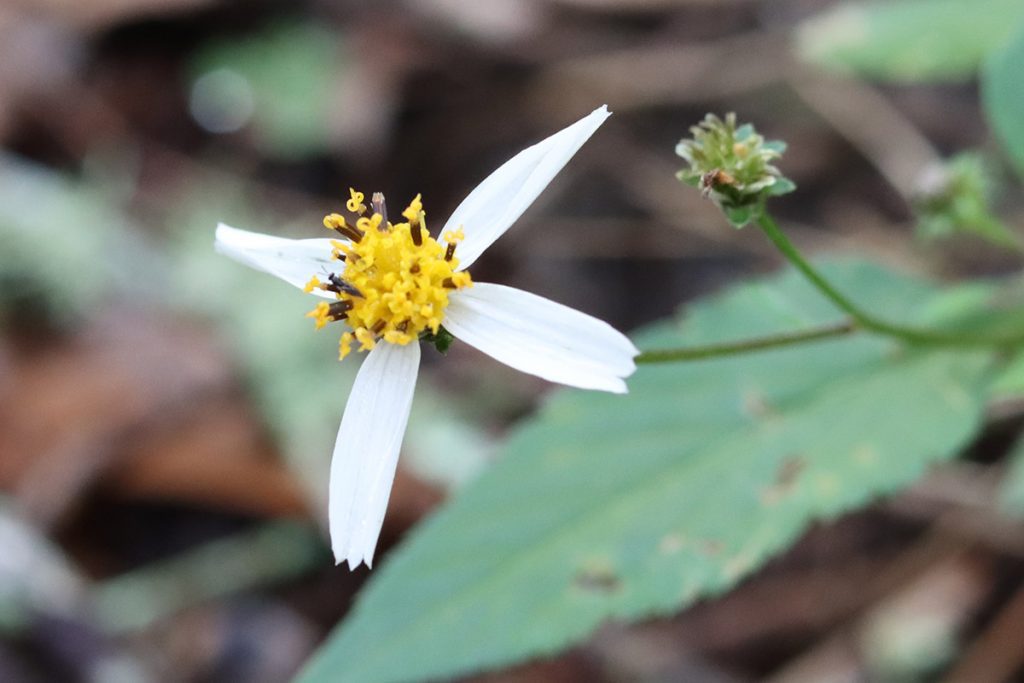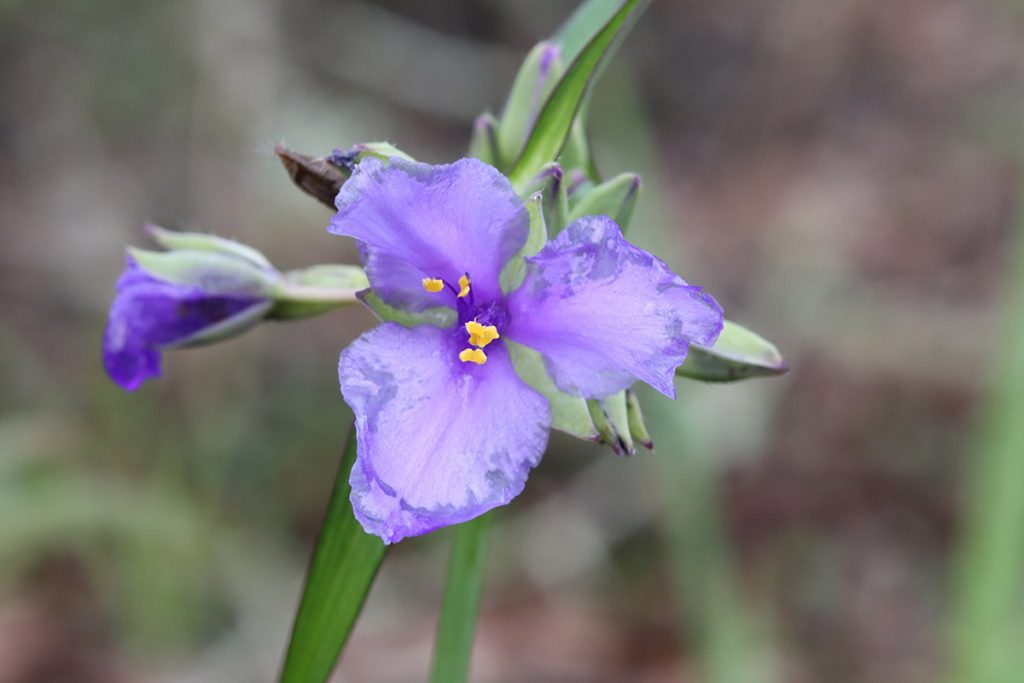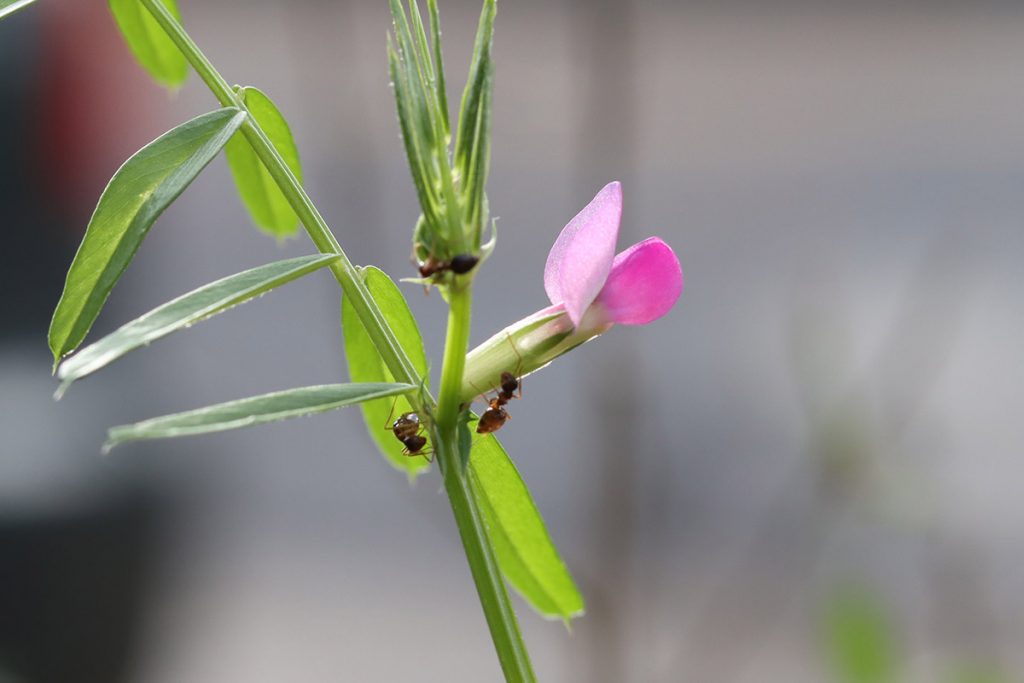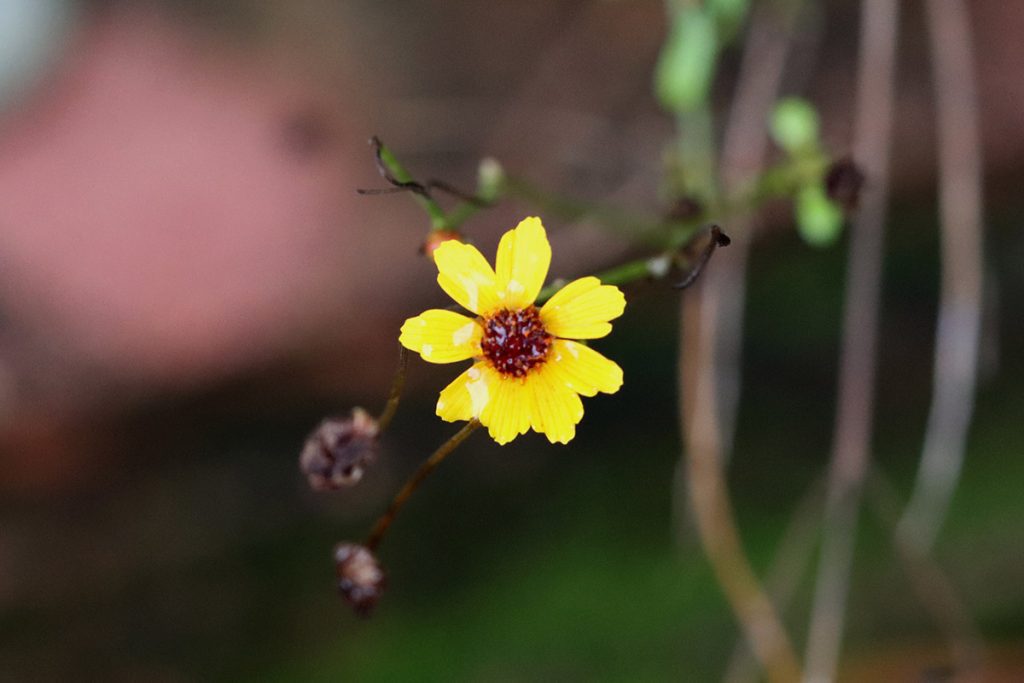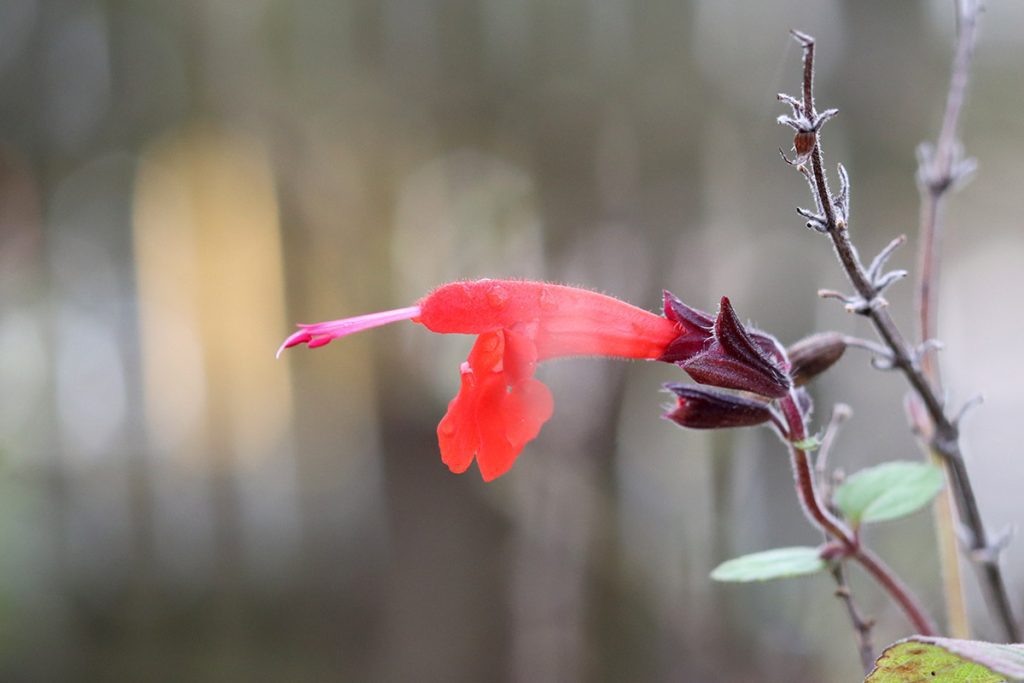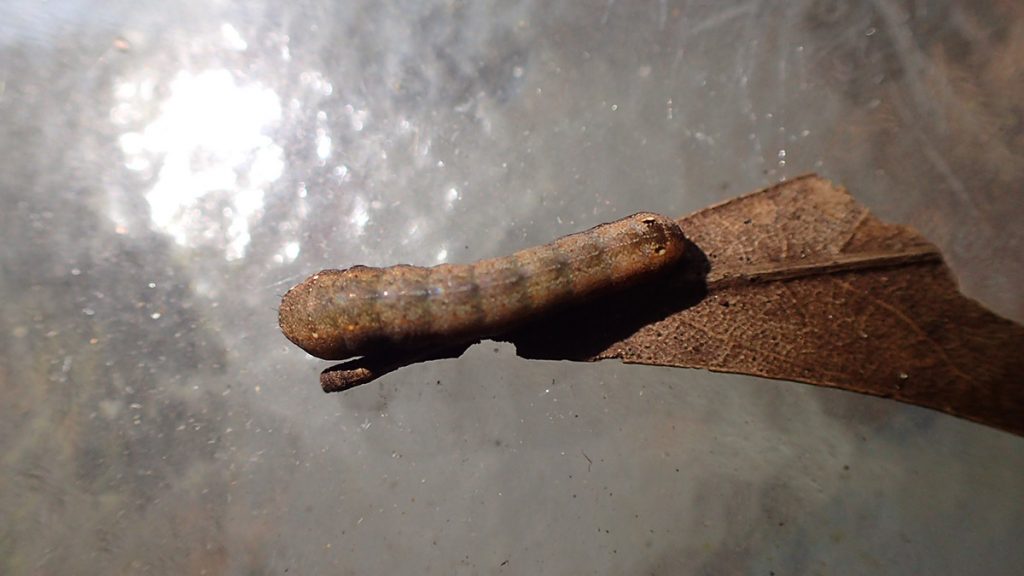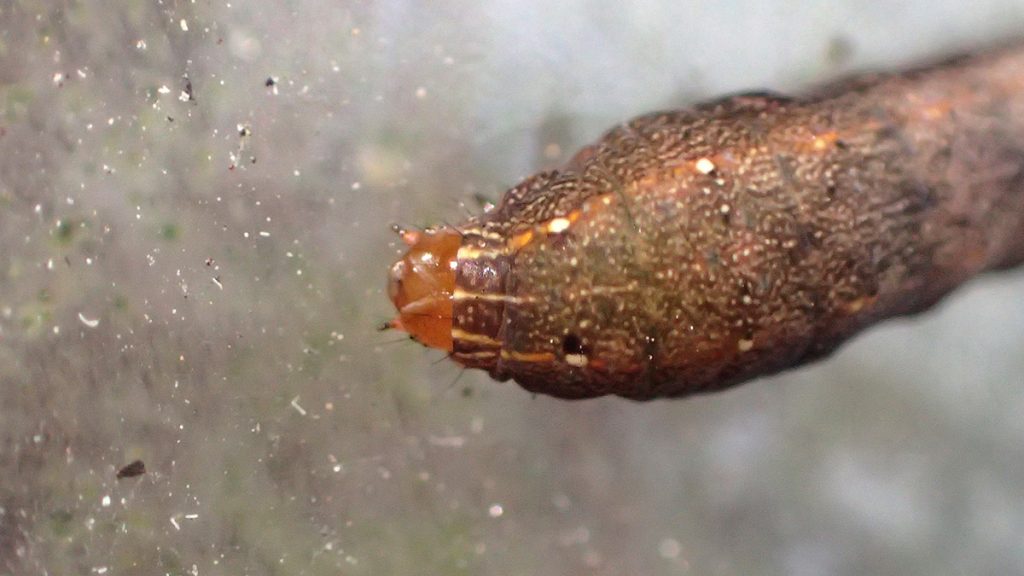Welcome to our fourth year of Backyard Blogging! At the start of 2018, I started posting photos of all the insects I was seeing in my yard. It’s a small space, and yet there was a lot of action. All I had to do was look. Insects eating plants, and each other. Caterpillars growing and making chrysalides, and pollinators on flowers. And on and on.
Over time, I started paying attention to the plants in the yard. I plant native to attract these insects, but also, a variety of weeds pop up. I started identifying them- the natives, a few naturalized nonnatives with some wildlife value, and of course the ones I had to pull. And then of course, insects are the foundation of the food web. They take the energy that plants take from the sun, and make it available to other animals- birds, reptiles, and amphibians.
What we’ll see on this page is that, for one thing, the insects in your yard are a surprisingly diverse lot. And even more when you plant to attract them. We’ll also see the seasonality of a yard, and the many interactions between plants and animals. It’s as busy an ecosystem as any I cover for the Ecology Blog
The 2021 Backyard Blog will work the same was as in 2018. I’ll add new posts over time to the top of the page, so that the days will appear in reverse order.
Wow did I get behind! — DONE!
A few months ago, we started on our My Garden of a Thousand Bees project. If you like backyard bugs, you surely like bees, right? Anyhow, I got behind on the Backyard Blog, but, writing this in early 2022, I’m finally finishing it off. I’m thinking this is the last year for this specific kind of chronicle of our backyard.
Having said that, I’m still thinking about a place on the Ecology Blog for cool backyard discoveries, and those from my travels around the area. The things that probably don’t need a full blog post. I’m still thinking of a format. Suggestions are welcome.
December 23, 2021
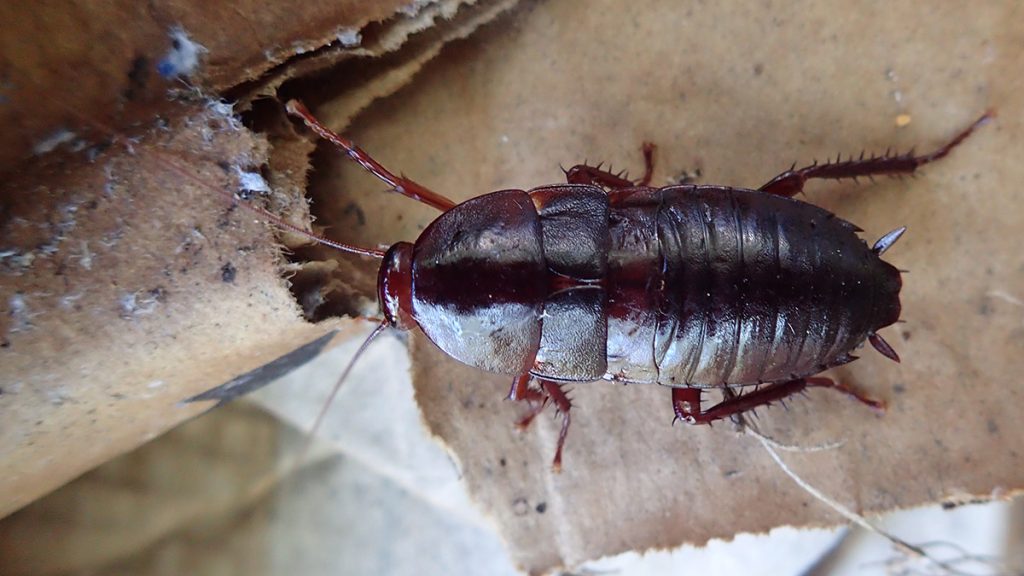
At least this is a Florida native cockroach? In other words, not a pest, but a glorious representation of biodiversity in our area. And a fitting way to end this year’s Backyard Blog.
In July of 2020, I spotted another native, kind of fancy looking cockroach- the pale-bordered field cockroach.
December 11, 2021
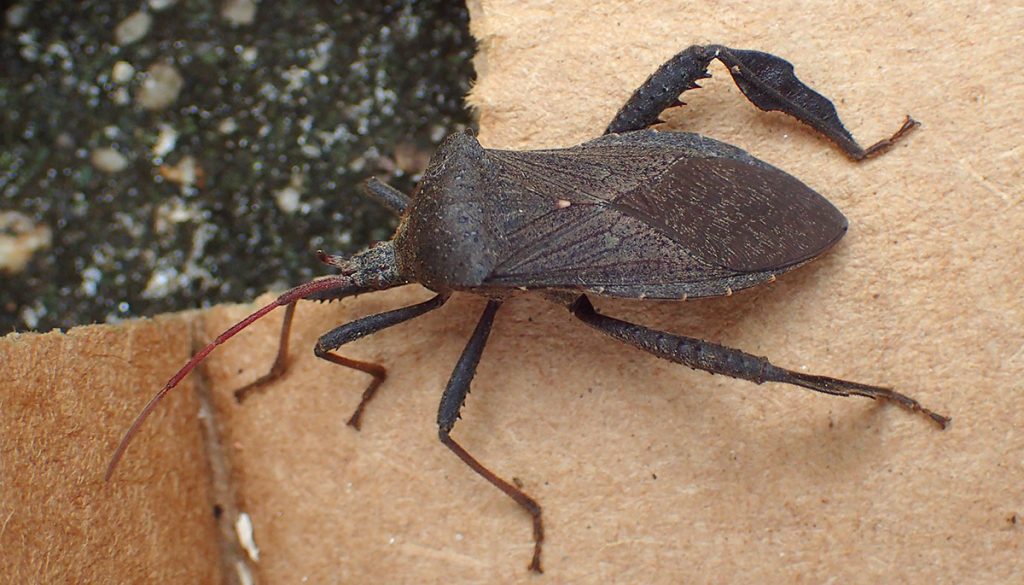
I’m going to try and do this without iNaturalist. Of the four species of Leptoglossus I’ve identified in the yard, this looks very much like Leptoglossus fulvicornis.
December 6, 2021
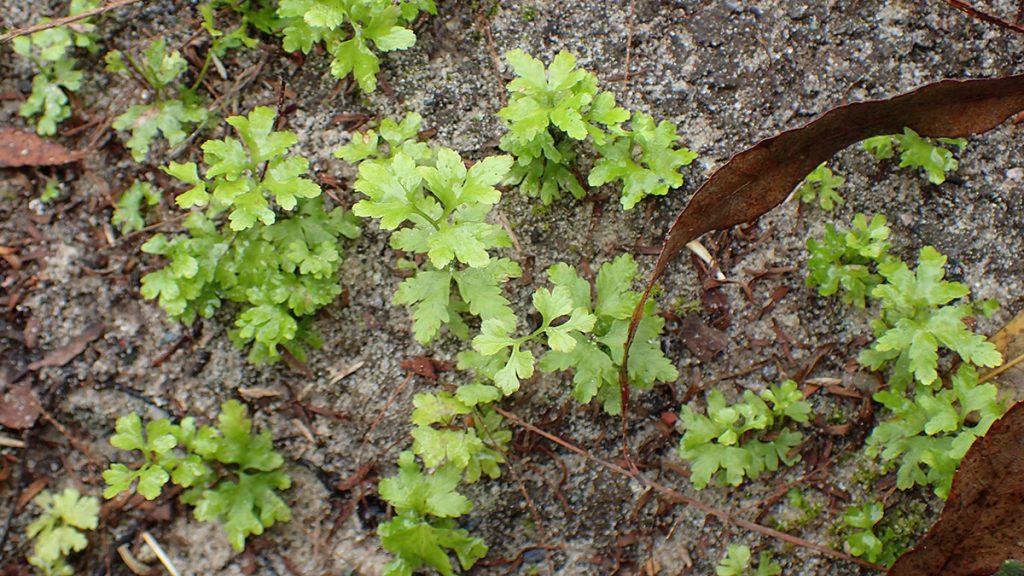
Here I caught an invasive species just starting to sprout. It was a small patch in a flower bed, and after carefully pulling out each sprout, it has not (as of February 2022) grown back.
November 23, 2021
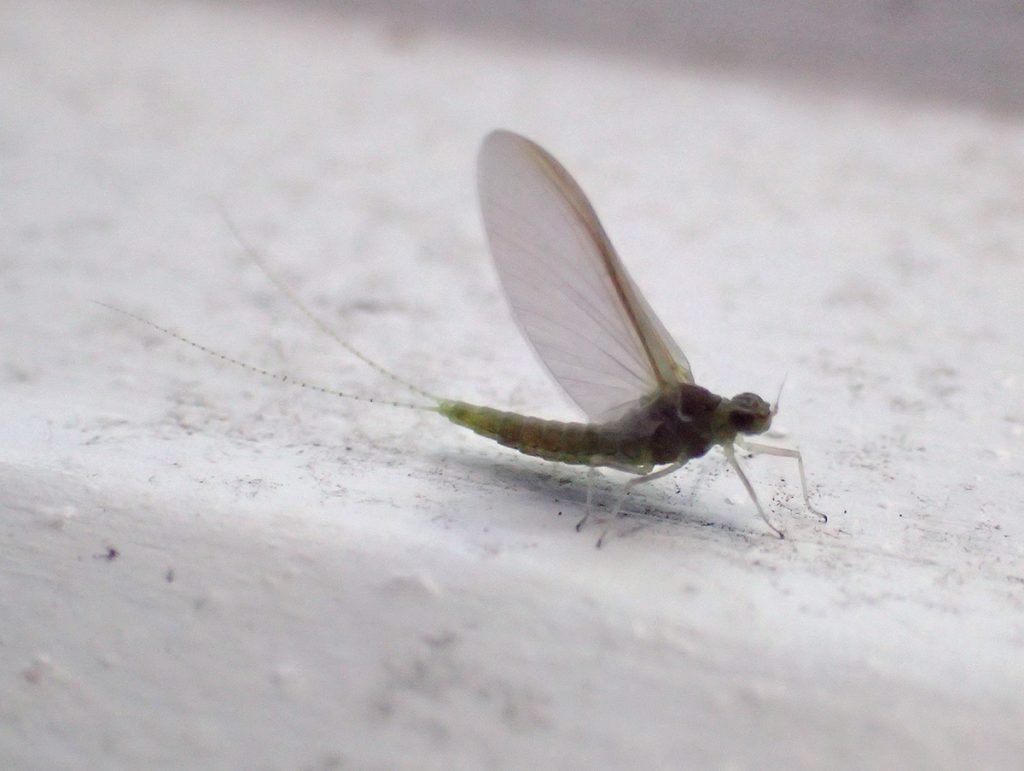
This is a small mayfly. Mayflies have short adult live, a few days in which to mate and lay eggs. For most of its life, this insect was a nymph living in a body of water, feeding on algae.
November 22, 2021
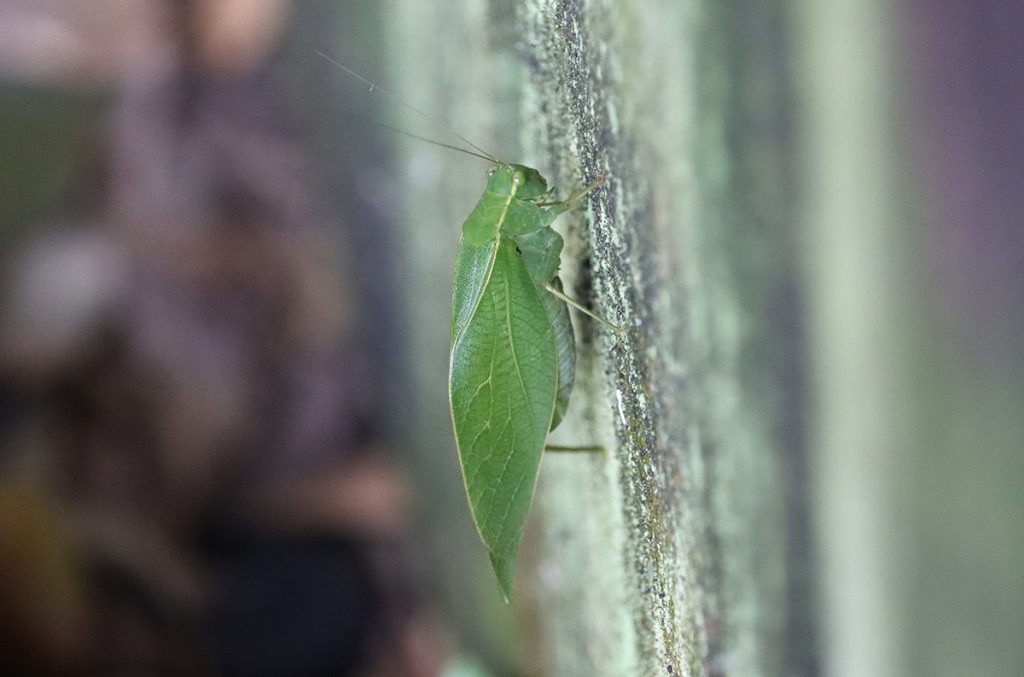
This is the same species of katydid I saw in the yard a couple of months ago. An iNaturalist user (an entomology graduate student) has since identified it as a narrow-beaked katydid.
November 7, 2021
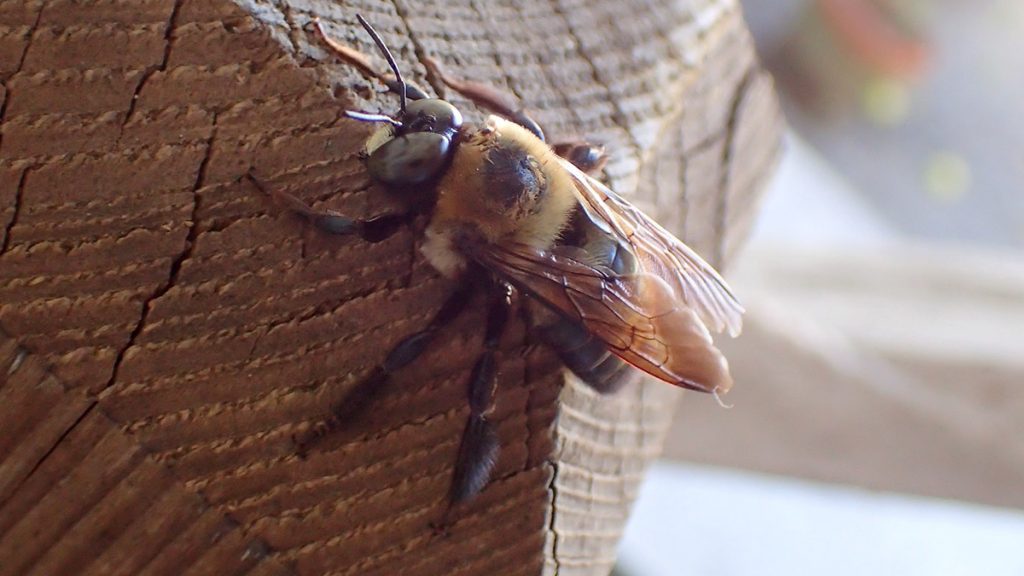
Every year around this time, I see carpenter bees that are either moving slowly or not at all, right by nests. The white mark on the face tells us this is a male. As fall transitions to winter, adult bees start to die off. For many bee species, this is when a female mates with a male, and then finds a place to rest until spring.
November 3, 2021
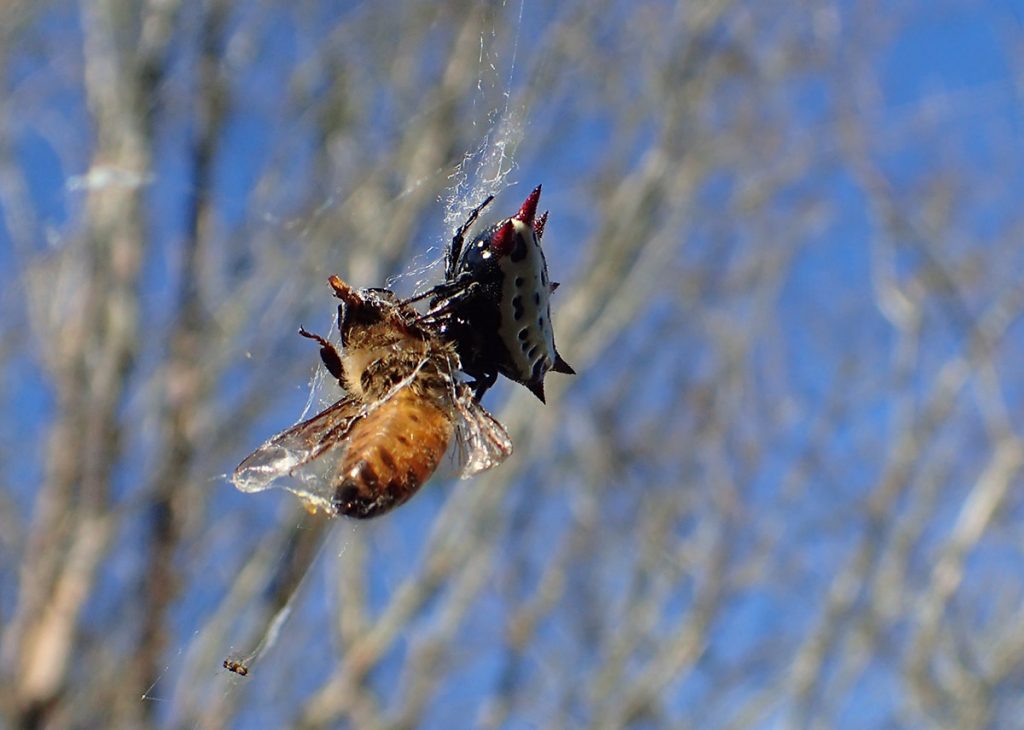
I saw this floating over my head between a flower bed and crepe myrtle tree.
October 31, 2021
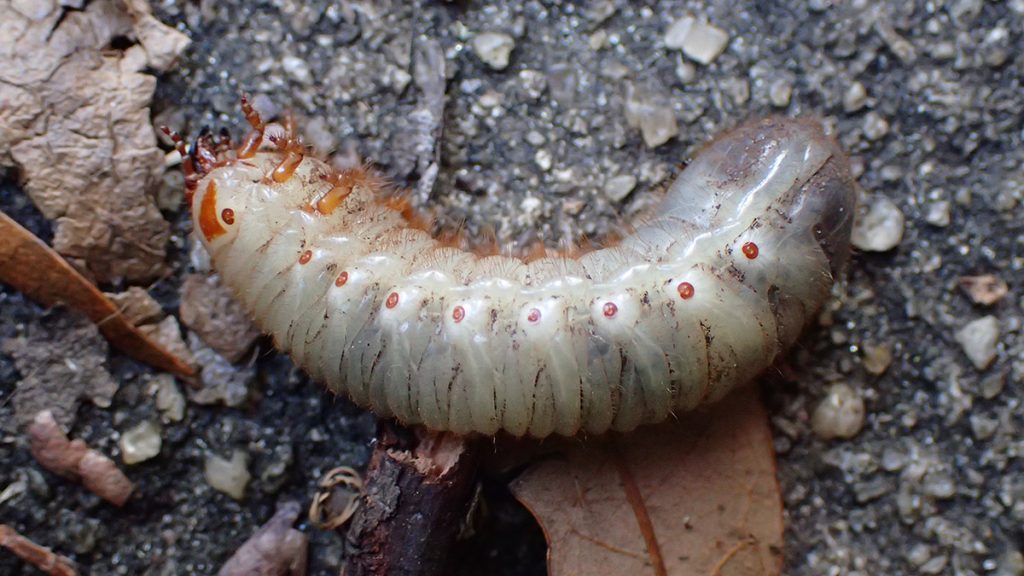
I’m not sure I’ve ever tried to iNaturalize a beetle larva before, but I thought I’d give this one a try. Beetle larvae tend to all look like big white grubs, to me anyway. Another user recommended Cetoniinae, and clicking to read more, I see that this includes green June beetles and delta flower scarabs. No too long ago I saw a green June beetle just a couple of feet from here, so this makes sense to me.
October 21, 2021
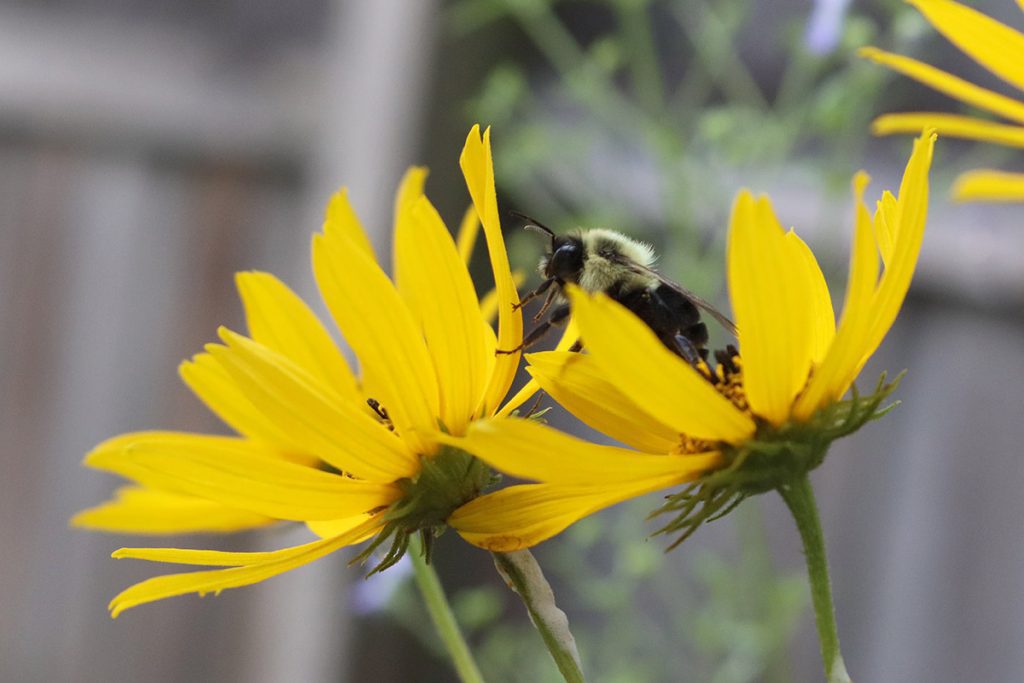
More of this bee on this flower. What I want to point out here, having identified a spittlebug in the yard, is spittle on the flowers’ stems.
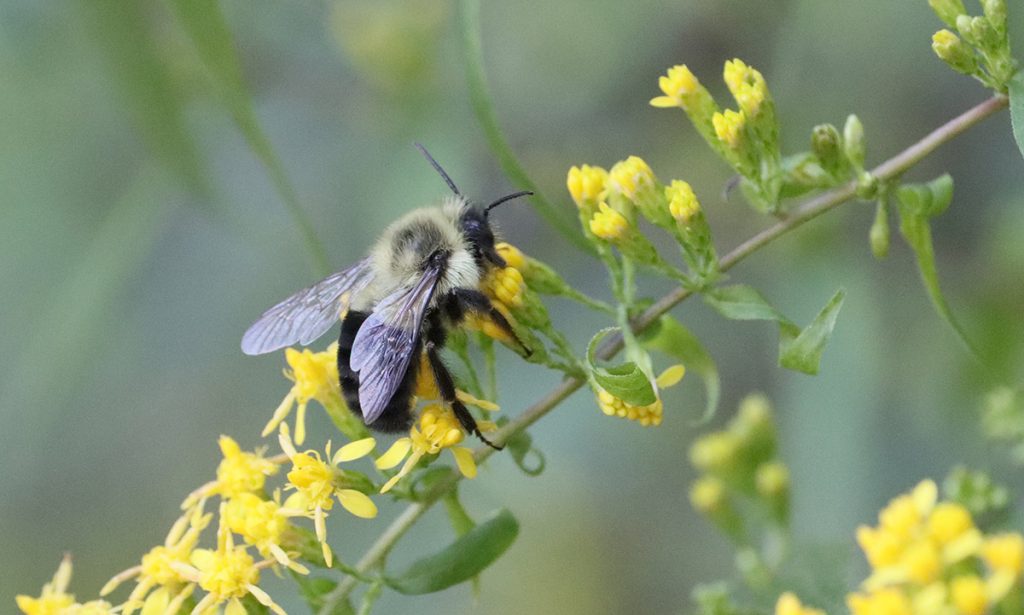
The bees having also been loving this plant lately.
October 17, 2021
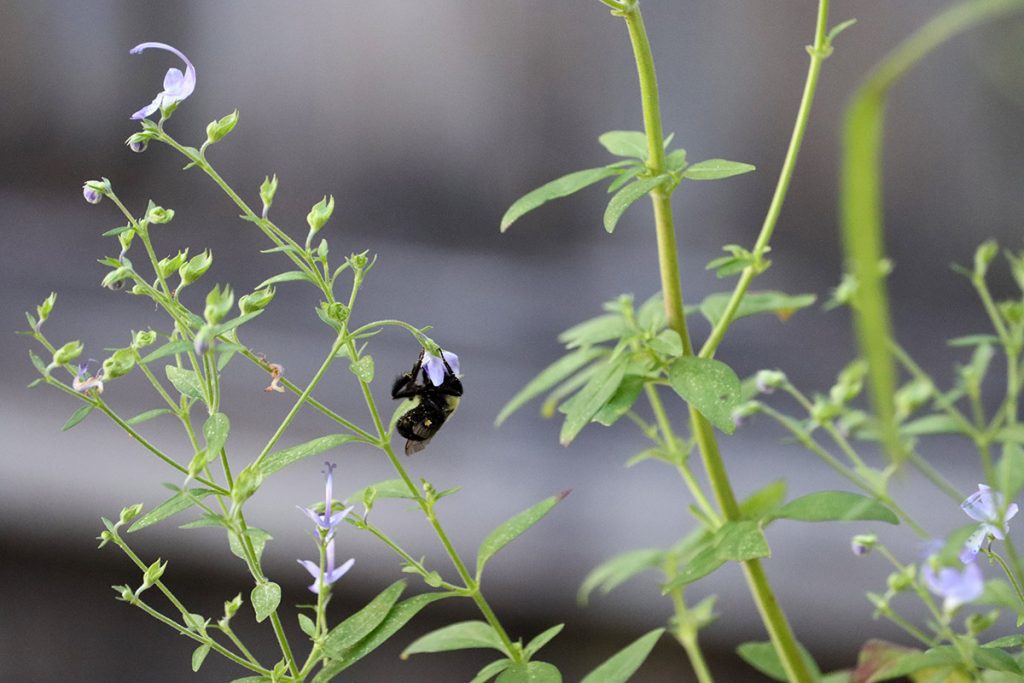
I don’t think bluecurls are a favorite plant of bumblebees, but once a day, one or two moves from flower to flower, hanging on and drinking in nectar before hopping to the next.
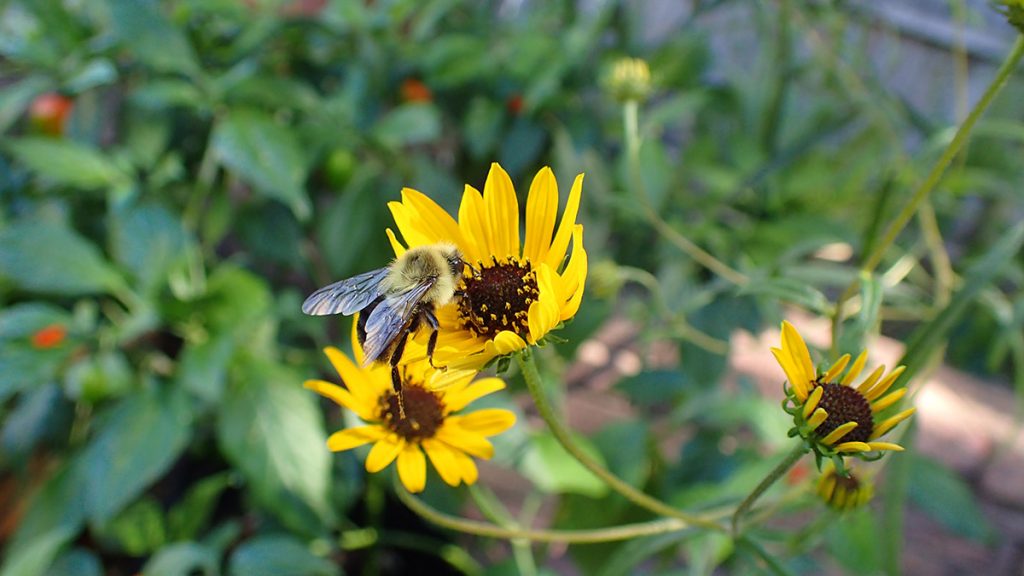
The bumblebees spend much more time on the narrowleaf, or swamp sunflowers. Either way, we have a variety of fall bloomers for all of the pollinators flying in the fall.
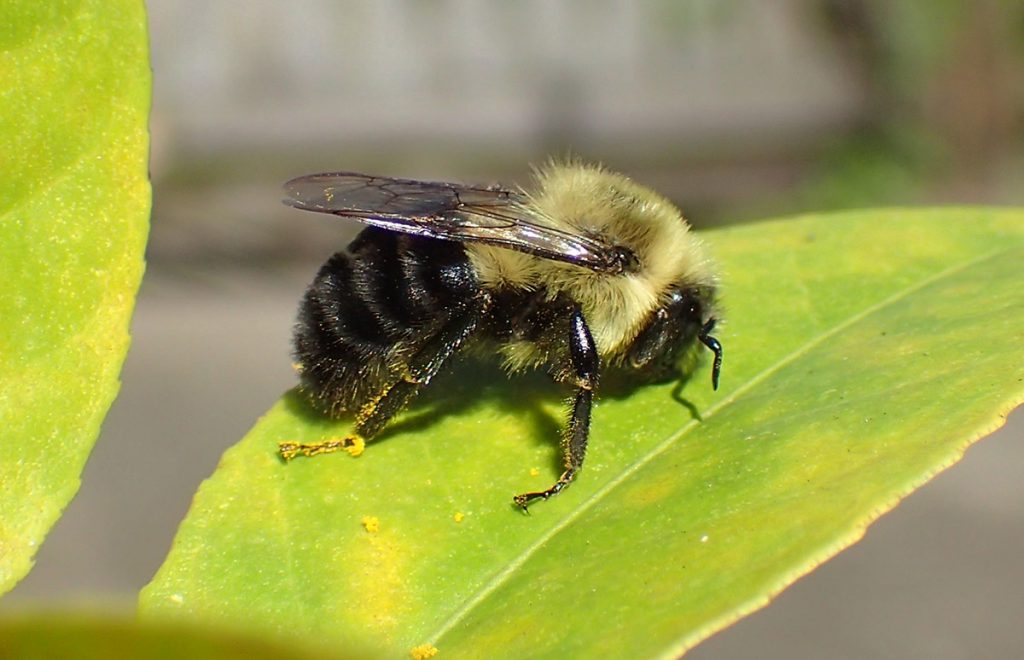
Here, a pollen dusted bumblebee rests after a day of flower hopping. Around now, bumblebee colonies will start to die off, leaving only new, freshly mated queens to find a spot to spend the winter. This is the time of year to let leaves lie on the ground, make sure there are bare patches of soil, and to allow dead flower stalks to stand. This, along with soft decomposing wood, are the main nesting habitat for bees.
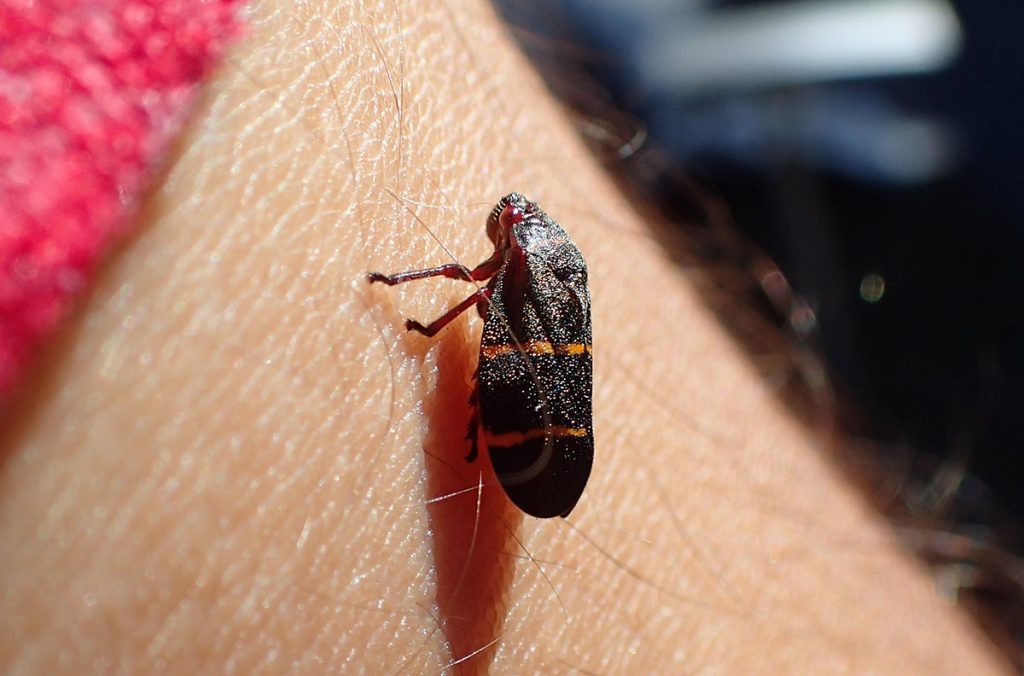
I’ve been seeing these all over the yard, and one finally landed on my arm so that I might iNaturalize it.
October 16, 2021
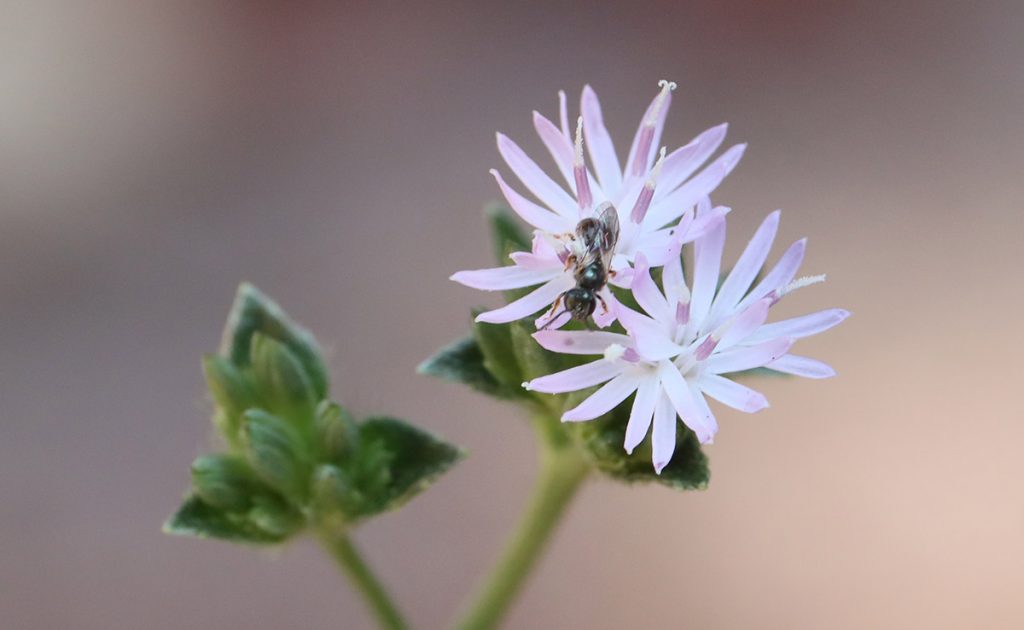
Another fall flower visited by a bee. Bumblebees and the small sweat bees in the Lasioglossum genus (subgenus Dialictus) come out early in the year and fly for most of the year. It stresses the importance of having nectar for them in the form of numerous species of flowers with overlapping bloom times throughout the year. For them and for the many other bee species who only fly for a few weeks or a couple of months of the year.
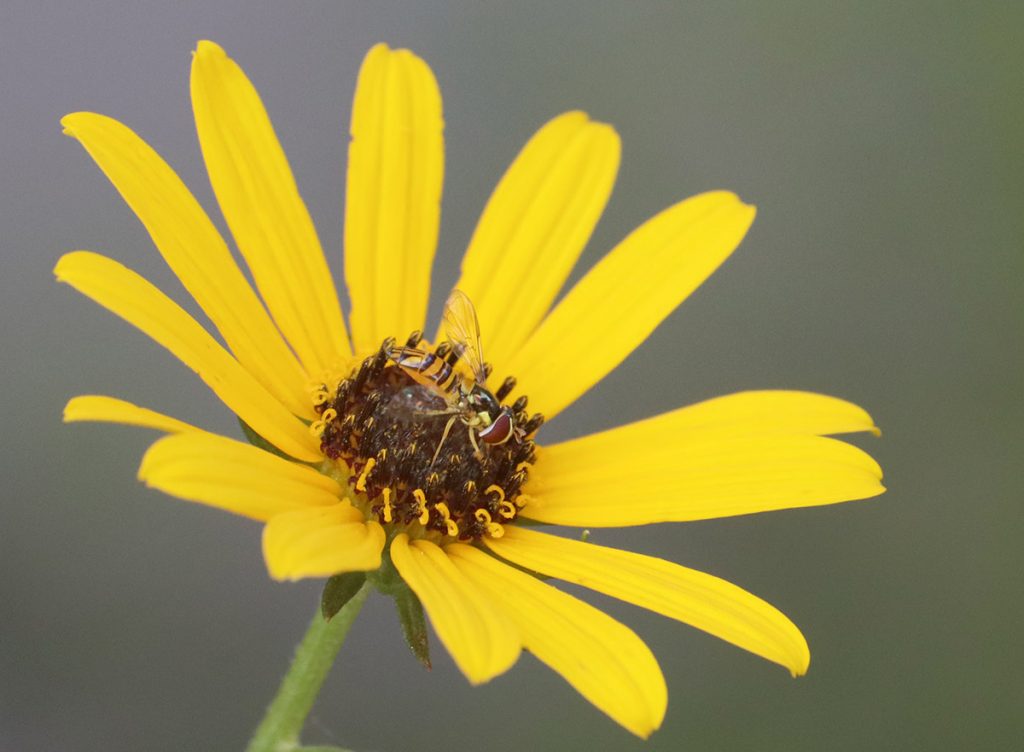
I notice that hoverflies fly longer than many bee species, so the fall and early spring flowers serve them as well.
October 14, 2021
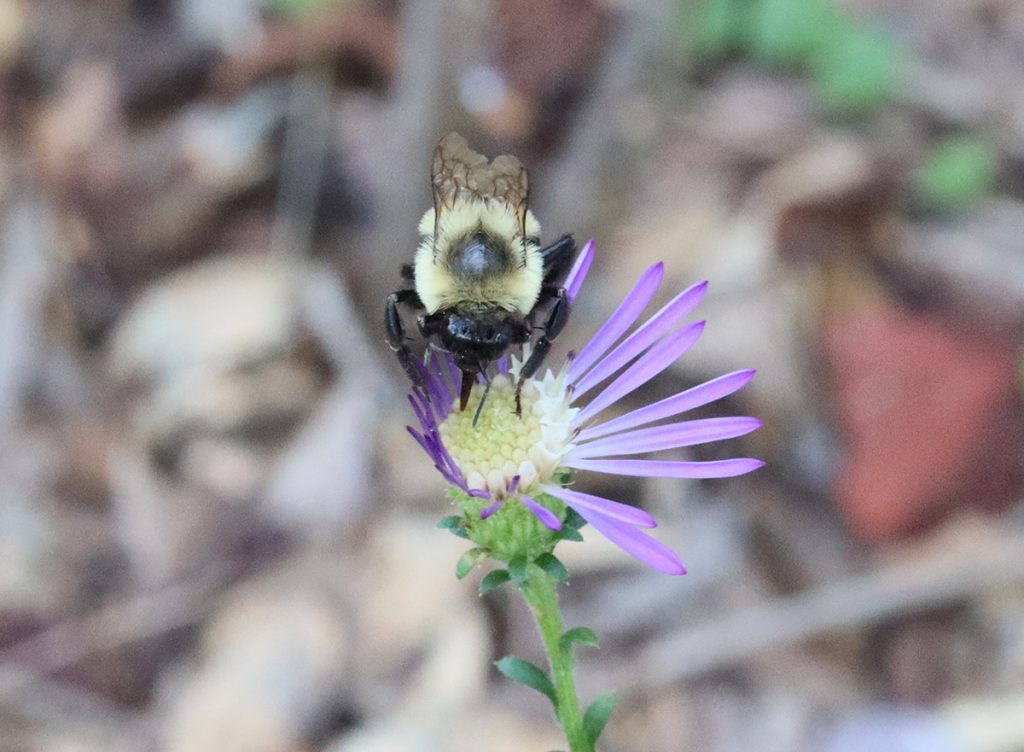
The fall flowers are starting to bloom, and bees are finding them.
October 13, 2021
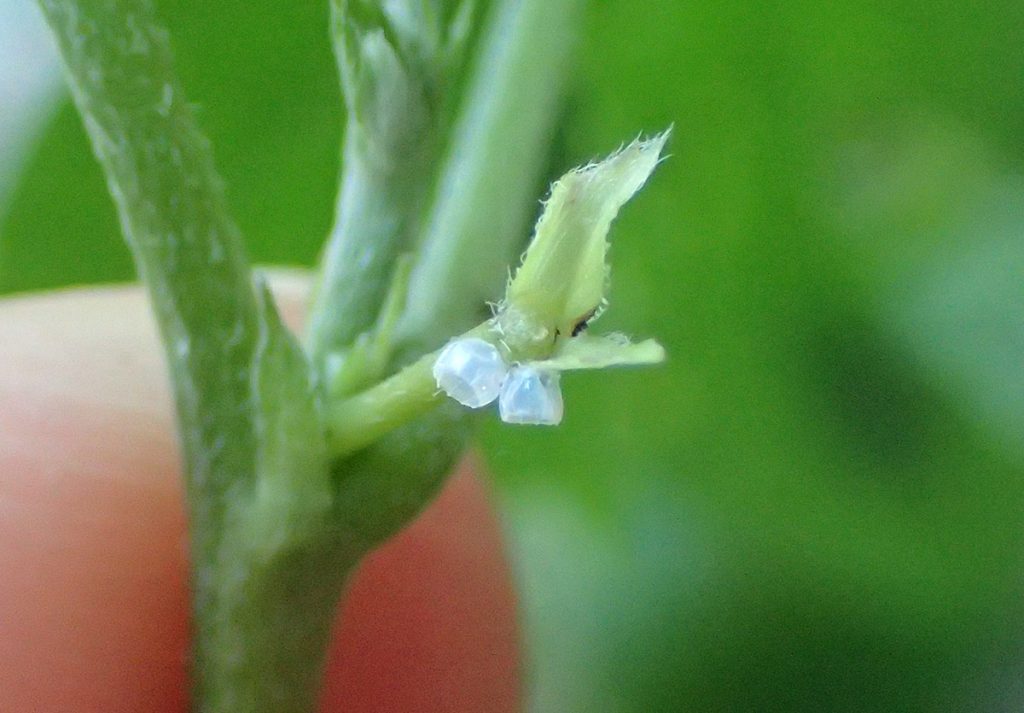
I have not seen a single bean-roller caterpillar this year, but now I’m seeing quite a lot of eggs. The last couple of years, I’ve been seeing the butterfly later and later in the year, even though we’ve had bean and pea plants throughout the year for their caterpillars. I wonder why.
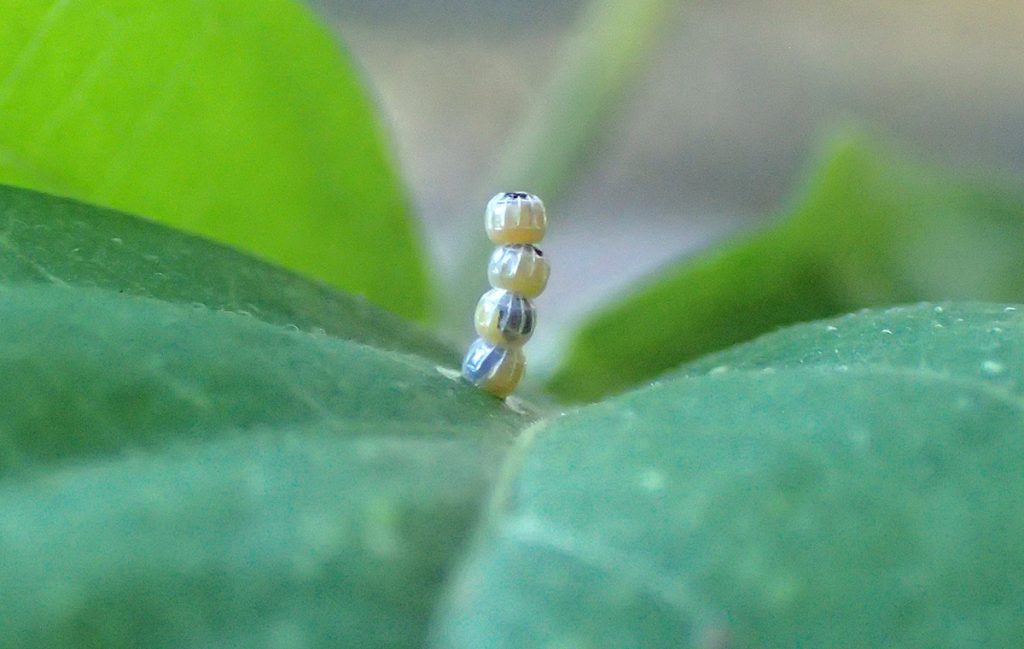
Here you can see he eggs laid two days ago, with dark masses inside them. These are the caterpillars ready to eat their way out.
October 11, 2021
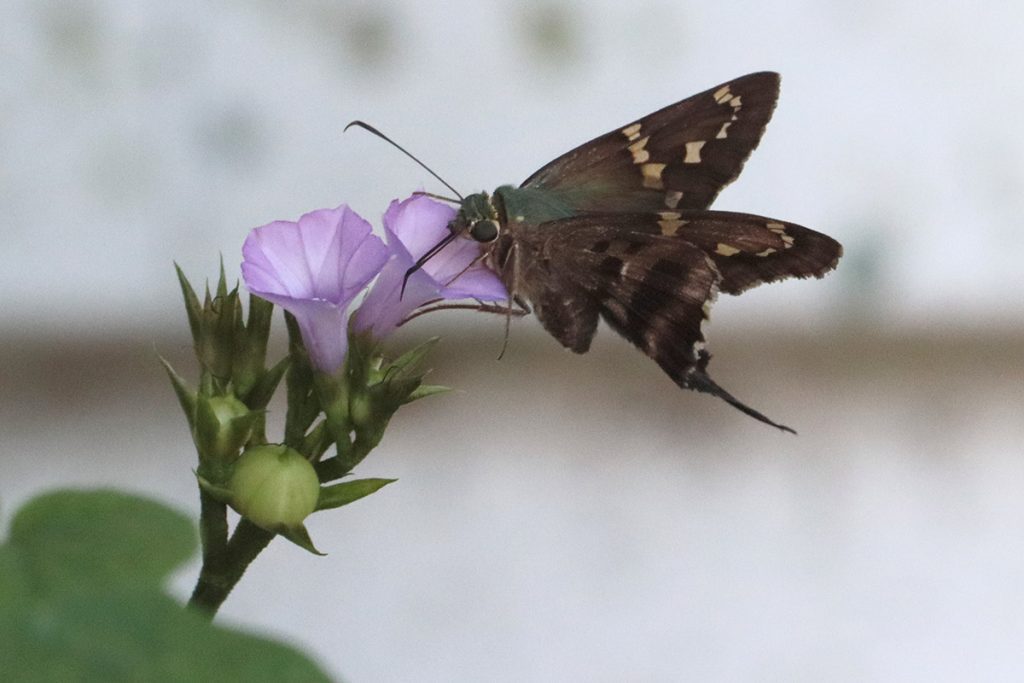
The same day I discovered our bluecurls, I saw we had morning glory flowers as well. They found their way next to peas and cucumbers we’d been trellising in a couple of different places in the yard, and so I hadn’t noticed their vines until they produced flowers. This vine is near our butterfly pea vine, which is a plant it uses as larval food.
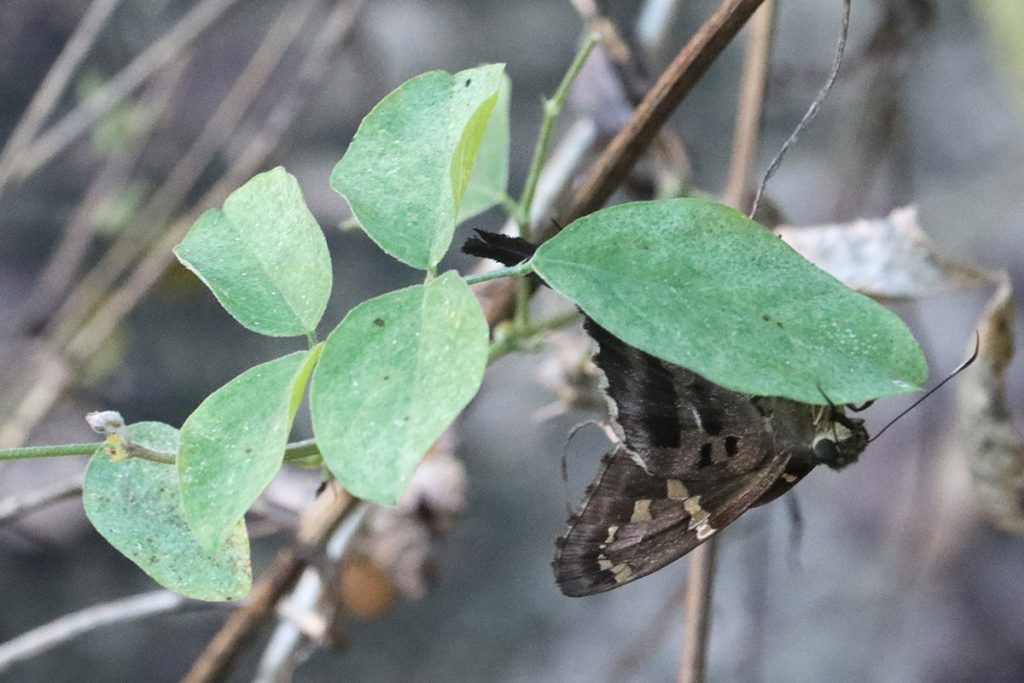
And here she is laying eggs on butterfly pea.
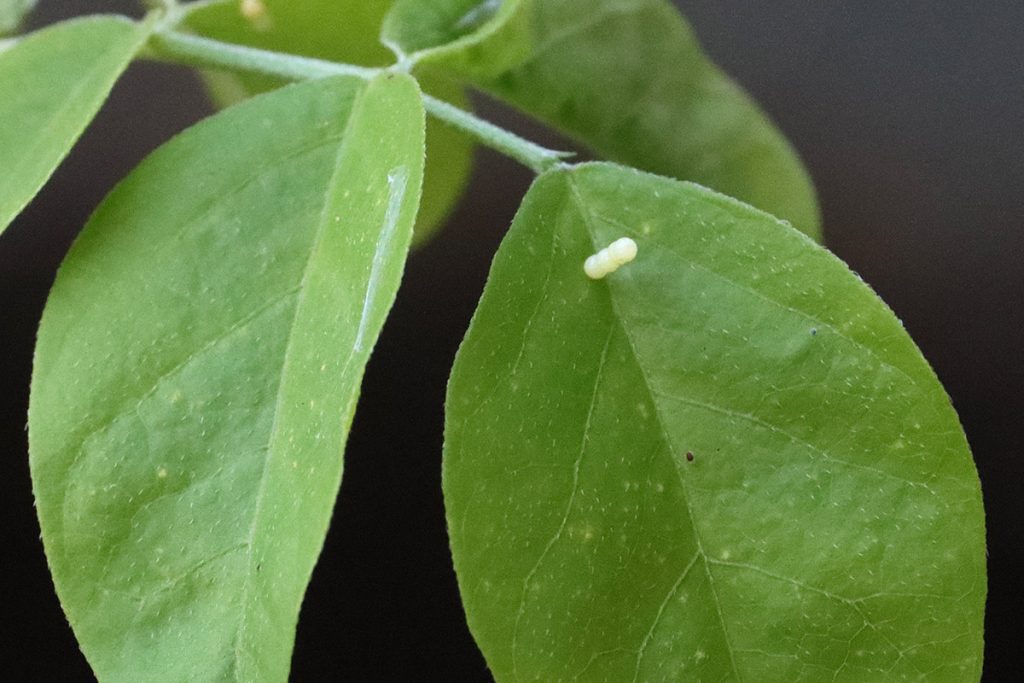
Last year I learned that this butterfly will migrate away from colder temperatures rather than overwinter. This will likely be the last brood of the year for long-tailed skippers in our yard.
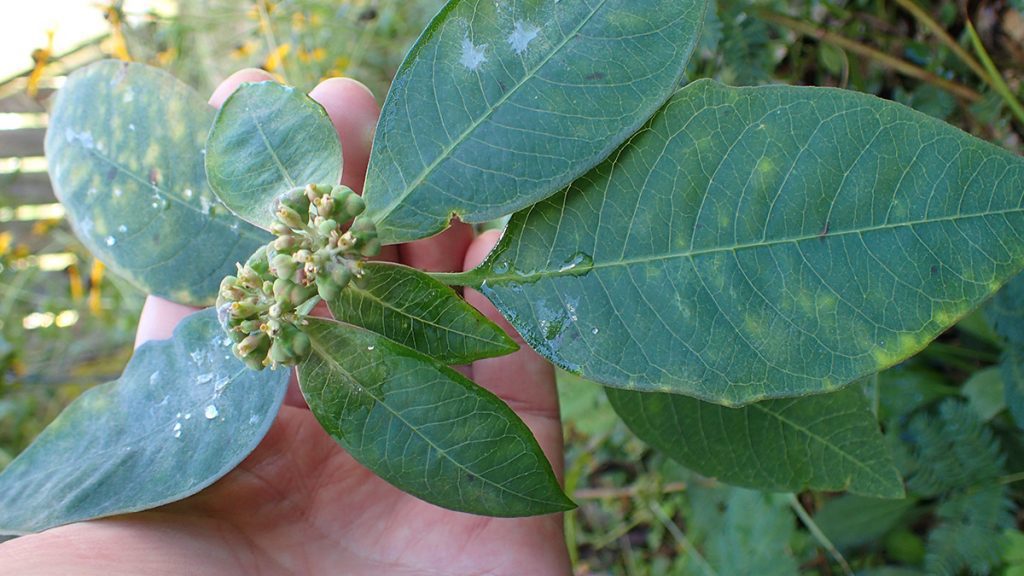
Here is a weed I hadn’t noticed growing in a densely vegetated area of a flower bed. It’s listed as native in the Alabama and Florida plant atlases, but its native range also includes Central and South America. It’s unknown where its more precise native range is within that. It has been introduced in Asia, where it has become invasive. It’s also something of a pest in its “native” range, where it is difficult to control as a weed.
Florida lists it as a noxious weed, as does South Carolina. It is intriguing, but I’ll pull it while it’s a single plant.
October 6, 2021
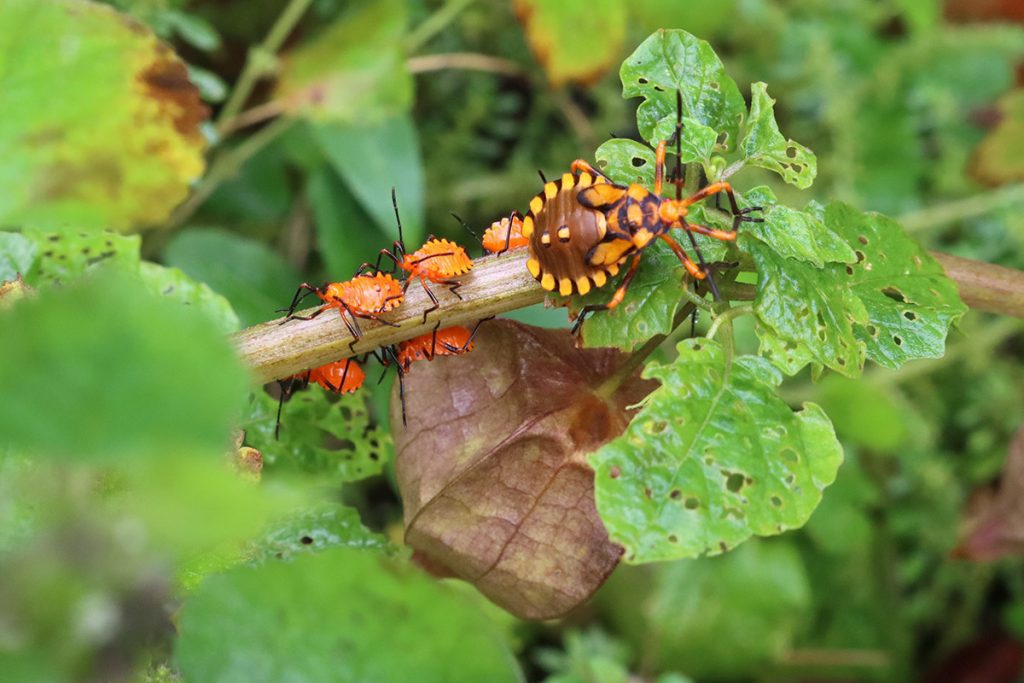
These bright insects caught my eye as I was heading out to drop the kids at school. I thought maybe the larger one was an exotic stinkbug mother, and the smaller ones its nymphs. It turns out they’re all leaf footed bug nymphs belonging to a species we see in the yard regularly- Spartocera fusca.
Once iNaturalist presented this option, I was curious about the insect’s many forms, so I Googled “leaf footed bug life cycle.” I learned that, much like butterfly caterpillars have five instar phases, so do leaf footed bug nymphs. We’re looking at sub-adult insects at various stages of development.
People consider these leaf footed bugs pests. In our yard, I always see Spartocera fusca on native weeds I let grow, like this ground cherry (Physalis).
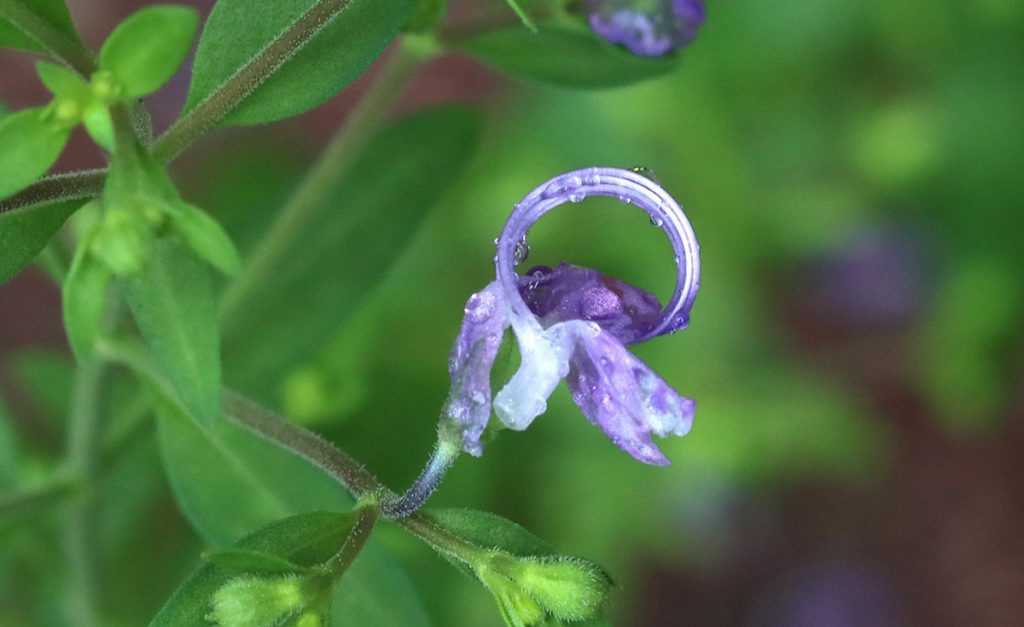
Today, my plants are telling me that fall is imminent. The single bluecurls plant I bought last year didn’t grow back in its pot, but instead seems to have spread its seed across the yard. I was letting these “weeds” grow because I thought they were something else, when today I was surprised by this flower. It turns out I have several of these fall bloomers. Nice surprise!
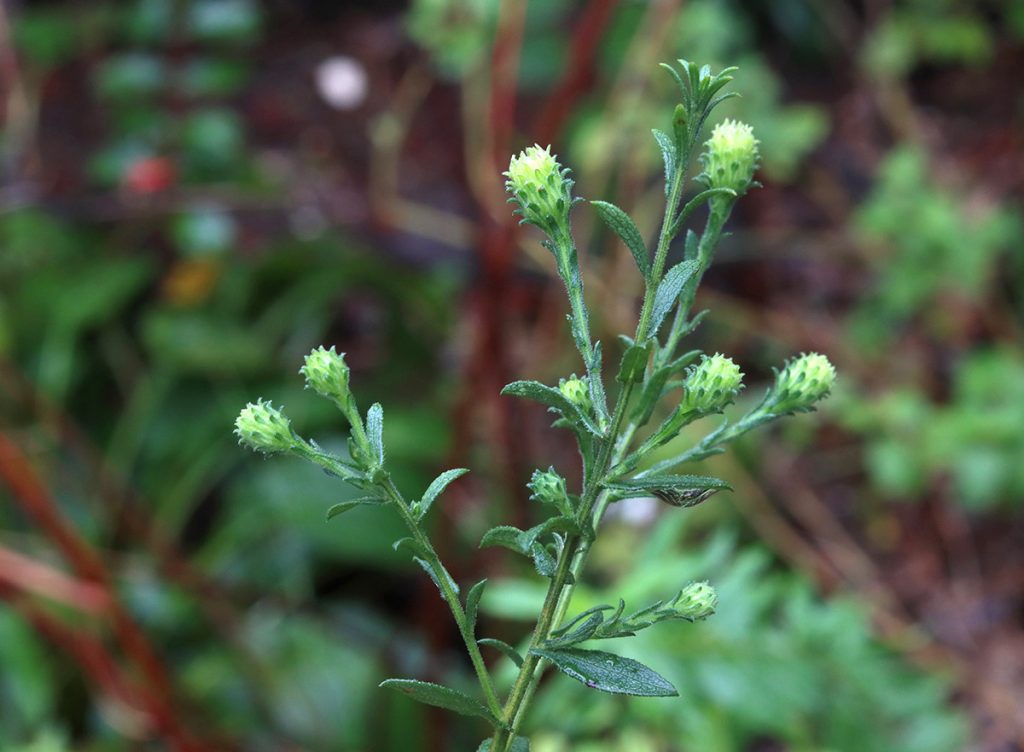
Here’s a Georgia aster (Symphyotrichum georgianum) that’s been getting nice and big over the last couple of months, finally making flowers. I’ve made an effort to grow more fall blooming plants to feed pollinators a little longer than we had been. This is an endangered aster I bought.
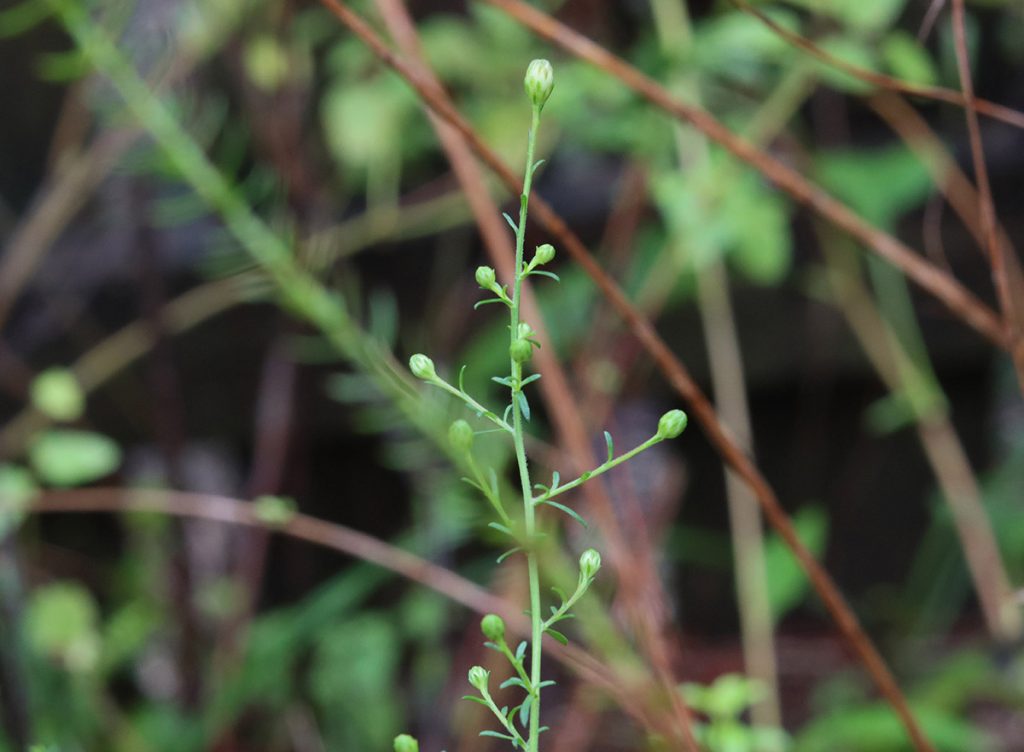
And here’s rice button aster (Symphyotrichum dumosum), which is common and is growing as weed here. They’ve been in the yard for years, though we only had one or two in 2020. This year, again, we have several, I think due to aggressively weeding of catclaw vine and other nonnatives that had encroached on the flower beds.
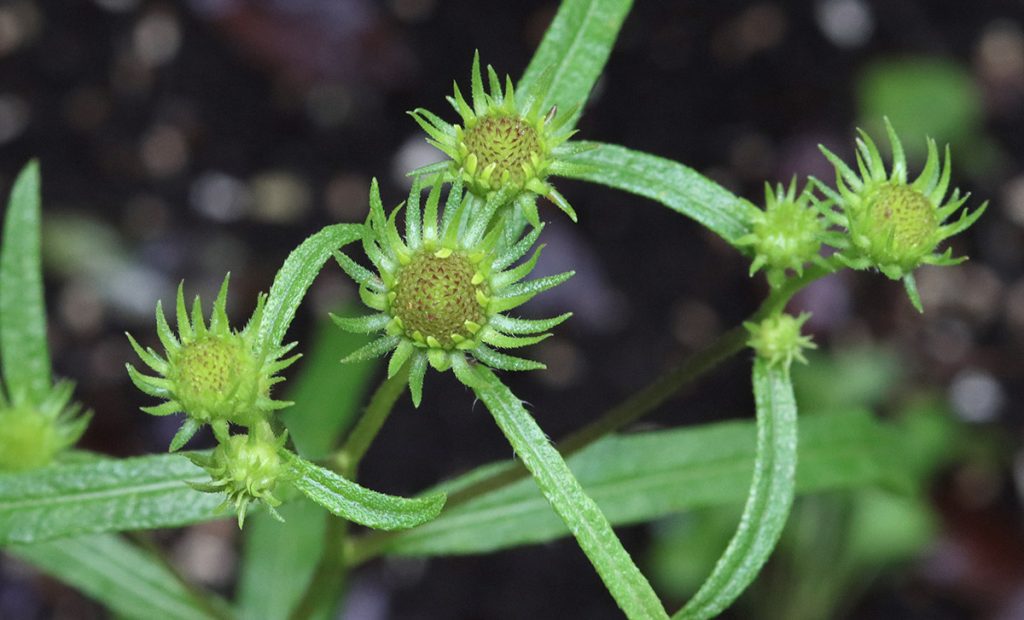
A friend gave me a bunch of narrowleaf, or swamp sunflower seeds. They were, as he told me, easy to grow, and now I have several. Another fall bloomer.
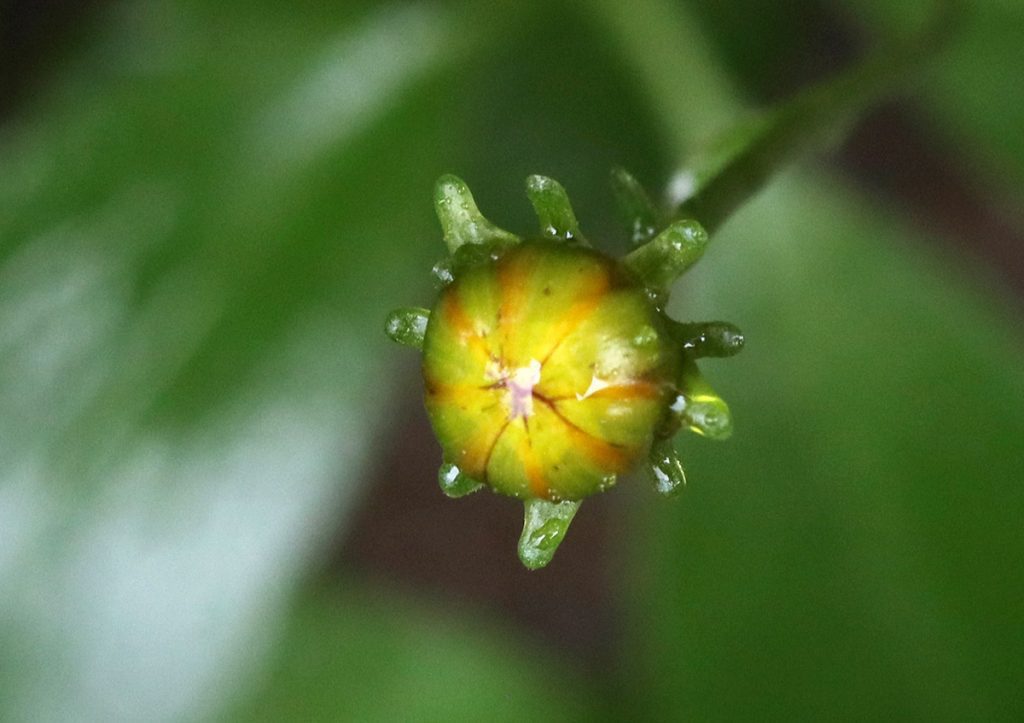
Another fall wildflower I bought…
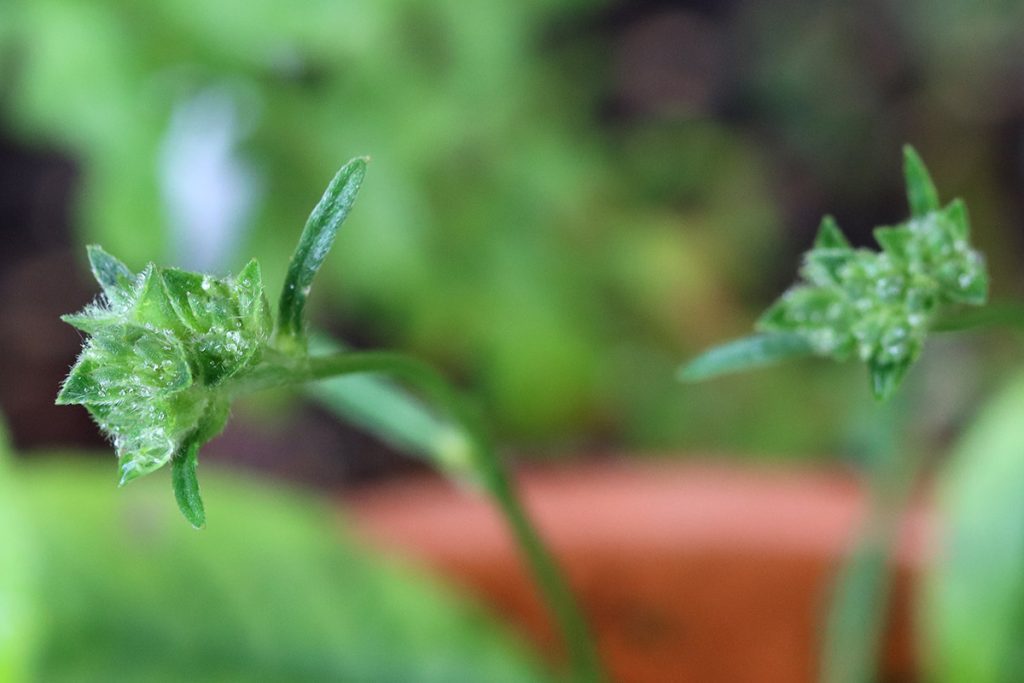
…and another weed. I’ve had one Elephant’s foot flower growing along the fence for years, and it finally dropped seed and spread a little this year.
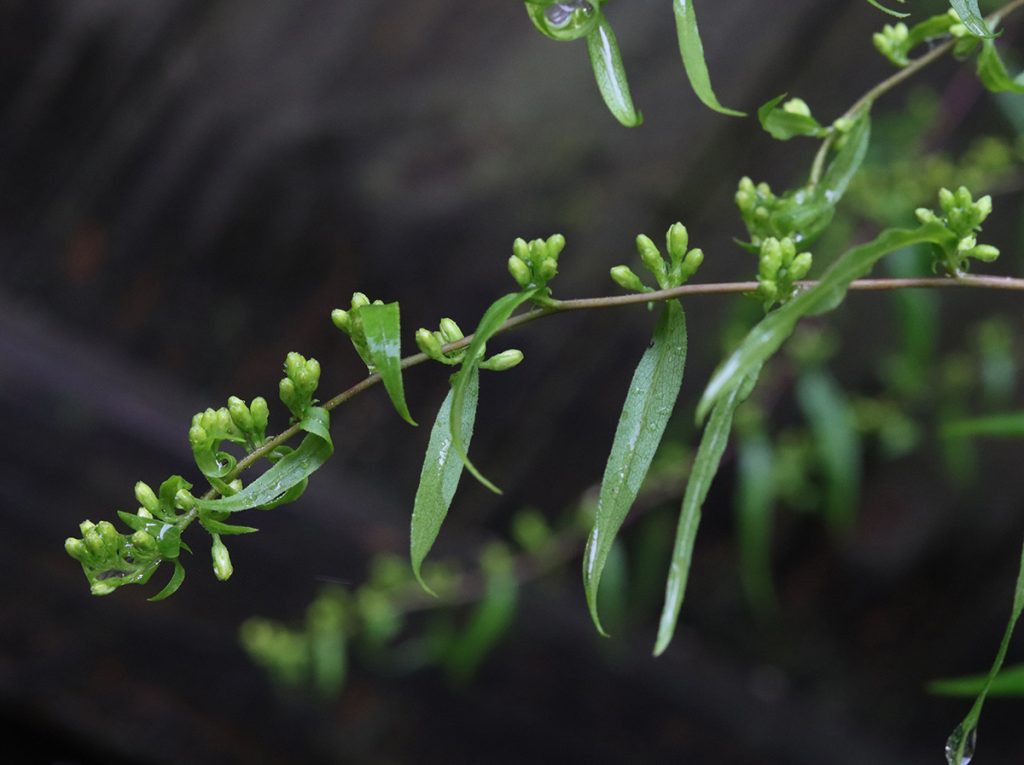
Another plant I’ve had for years. In 2021, it will bloom alongside several late-season wildflowers.
September 25, 2021
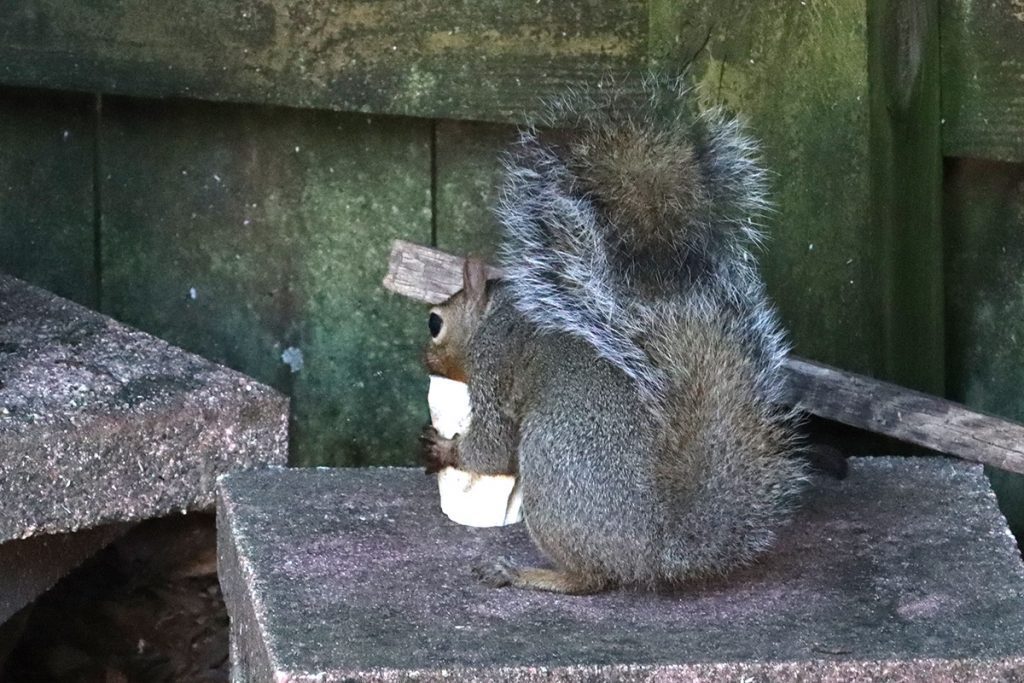
One day this soup bone showed up in our yard. The bone is a cow vertebrae, which you can use to make stock, and then when you’re done, you can give to a dog to chew on. It’s good for their teeth. We haven’t had a dog for a couple of years, though, so where did this come from?
Today, I may have found an answer. It’s unsettling to see an herbivore gnaw on a bone, but interesting nonetheless to see a squirrel take care of its teeth (I’m guessing).
September 19, 2021
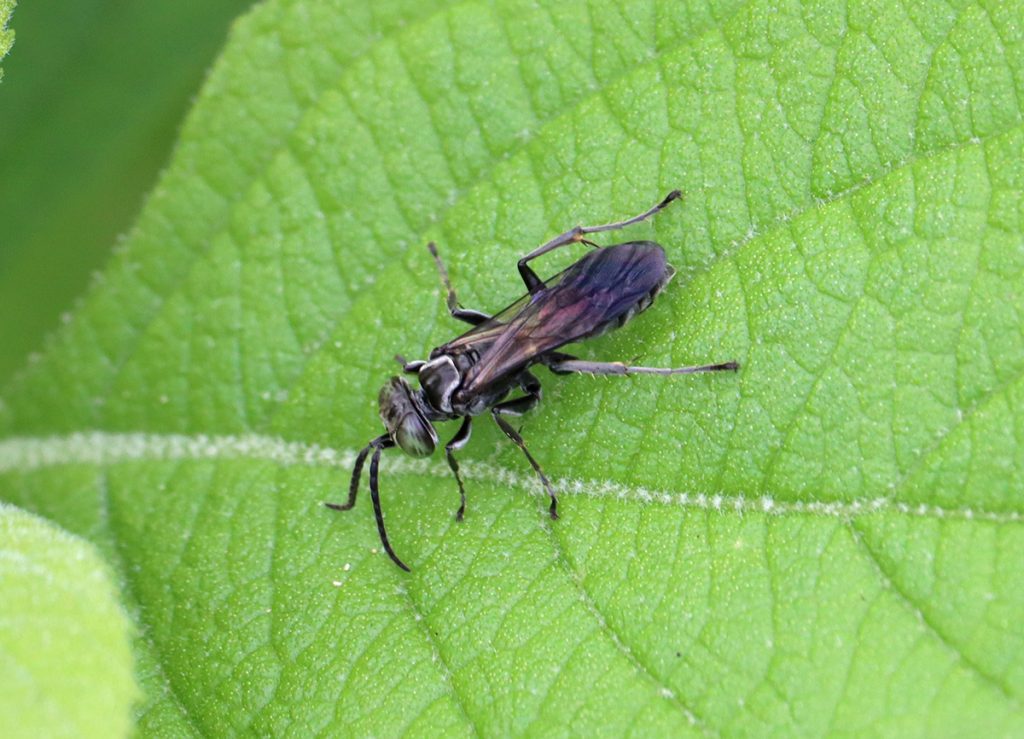
Here’s a black soldier fly hanging out, and I’m happy to see them still active in the yard. I miss these guys over the winter, when their larvae aren’t eating veggies and pooping out compost in the compost pile.
September 9, 2021
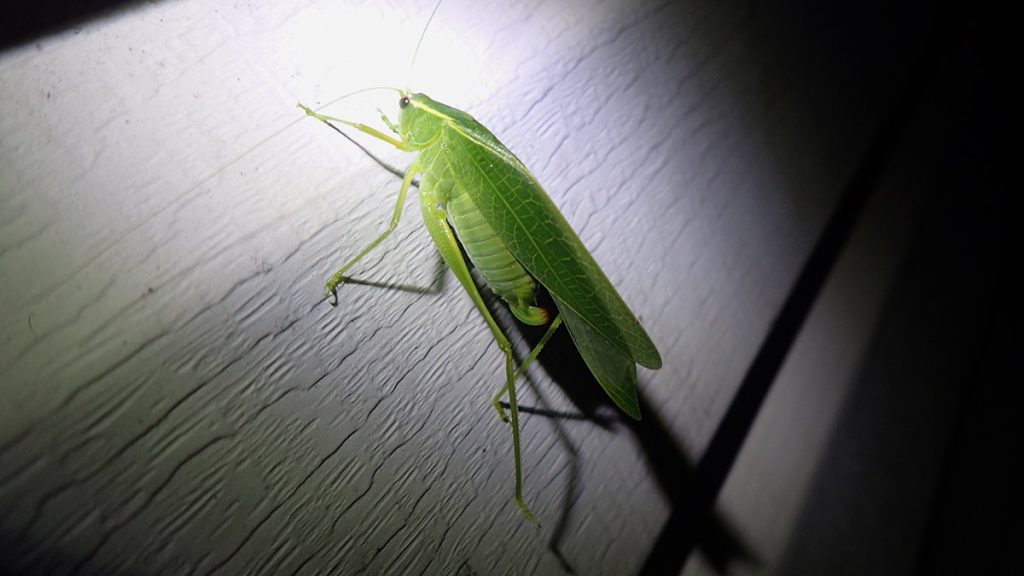
I saw this katydid on my house tonight. We hear them more than we see them, but I always love seeing them. EDIT- November 16, 2022— iNaturalist users sometimes take a while before getting around to observations, but I’ve recently had two IDs for this insect- Narrow-beaked katydid (Turpilia rostrata).
September 6, 2021
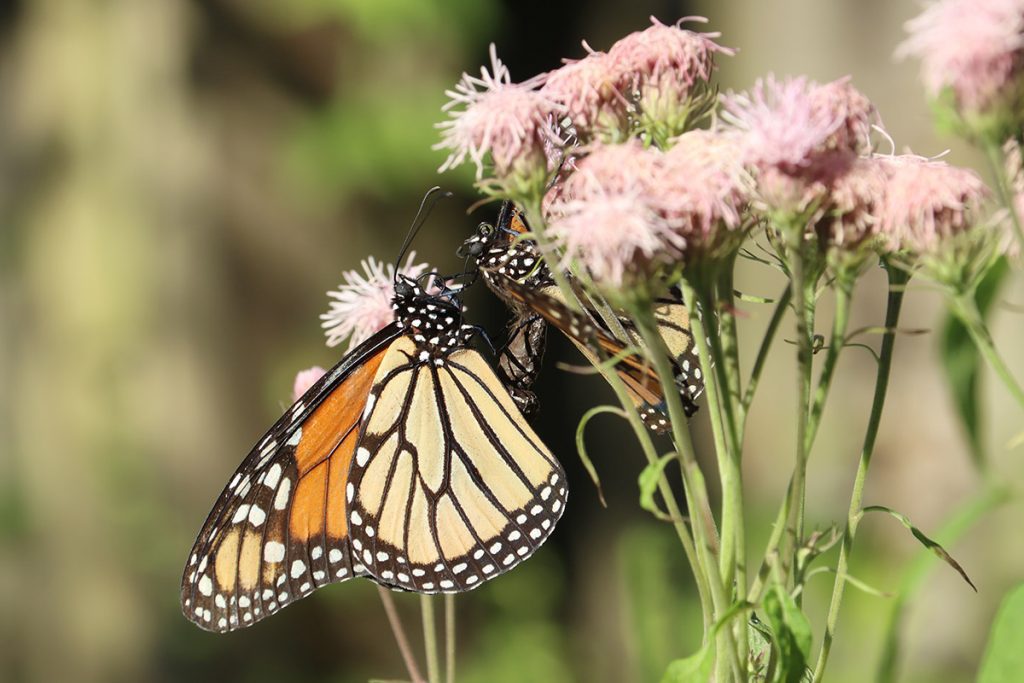
Here you can see a monarch male curling his abdomen towards the female. There was chasing, and coupling while in the air. They perched high up in the cherry laurel tree next door, and as I tried to get a good photo from a distance, while worrying that a neighbor would see me pointing a camera towards their home, they took off again.
Finally, they land on a crepe myrtle in our yard.
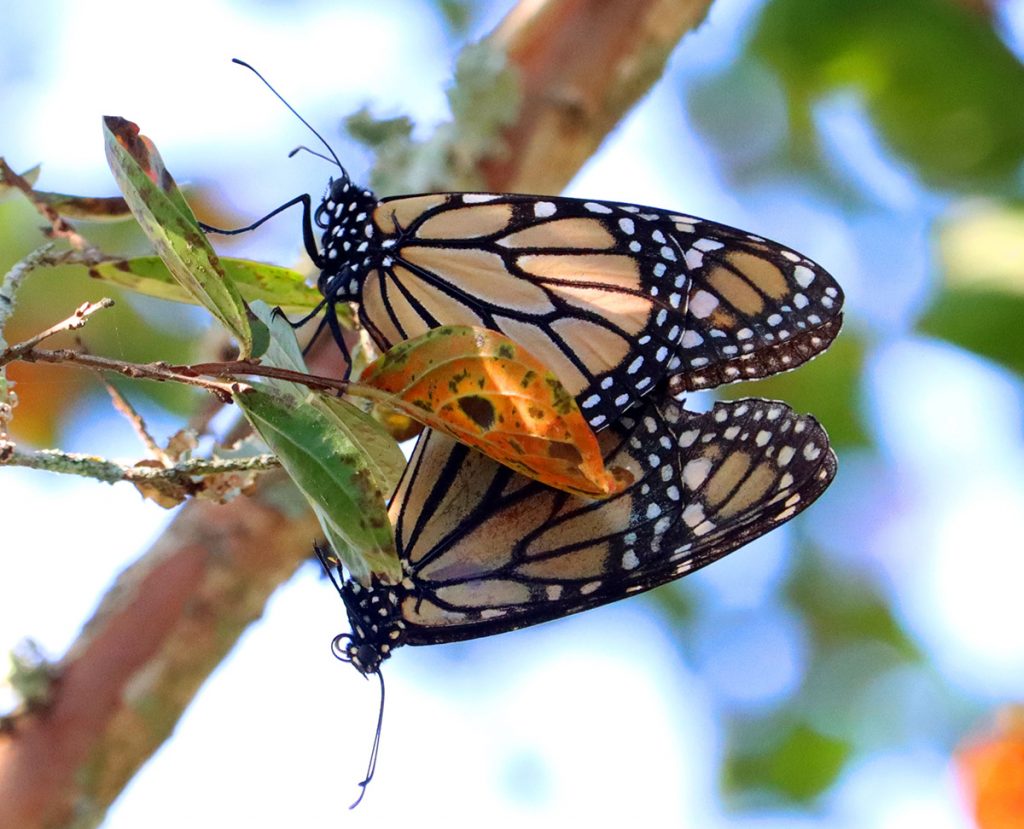
You cans see how one butterfly’s wings are more worn than the other’s. I do wonder whether monarchs migrating north are finding those who are newly hatched. If so, do the newly hatched butterflies migrate before laying eggs? If they don’t, do migrations stall?
It’s not exactly what keeps me up at night, but so much of what I see in the yard, or in nature at large, fills me with questions.
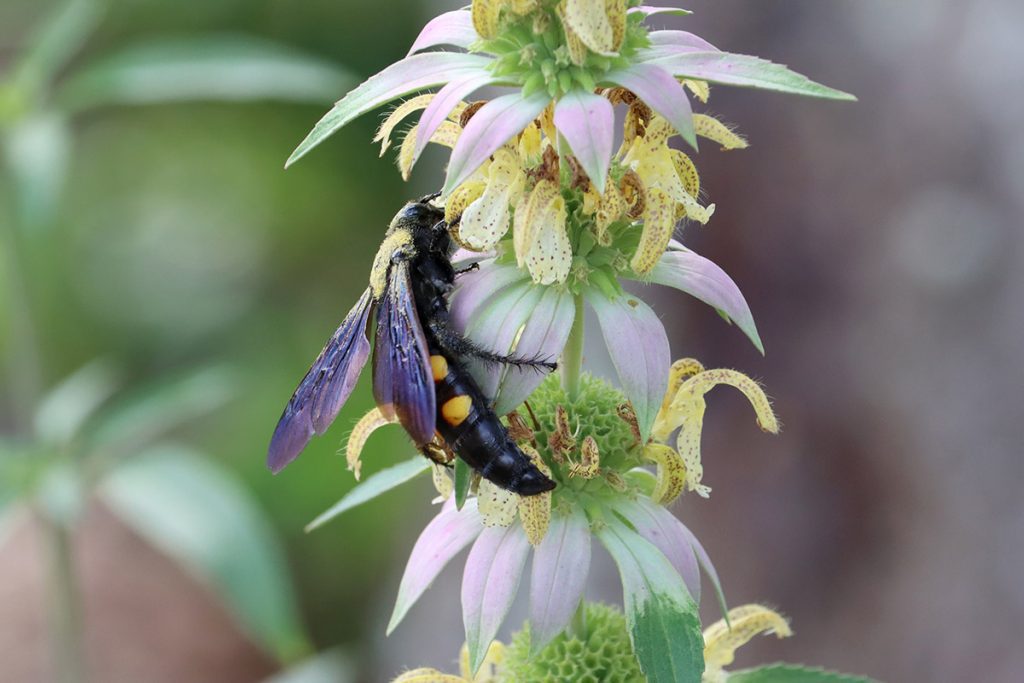
Late summer blooms are the best time for pollinator watching in our yard. Over on the horsemint, I spot a wasp I’ve never seen in the yard before. I recognize the species as a scoliid wasp, so I check my iNaturalist and find that this is a large four-spotted scoliid, and that I’ve seen it at the Fred George Basin Greenway and at the Apalachicola Bluffs and Ravines Preserve. Cool to see it here.
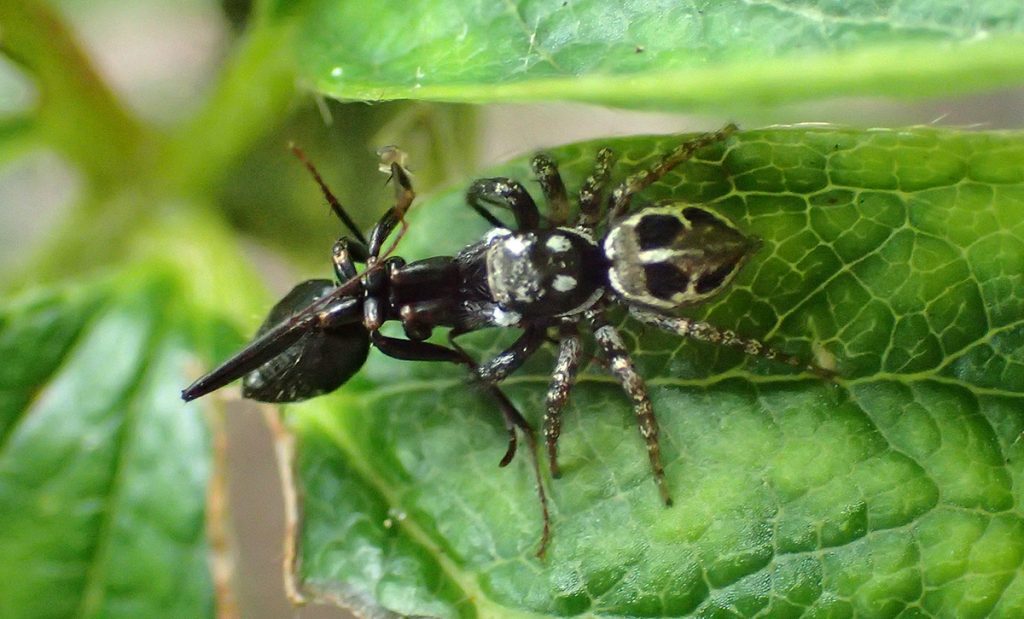
Here’s a neat site, and one that occurred at two different locations in the yard. Here’s a twin-flagged jumping spider grabbing what looks like a large ant.
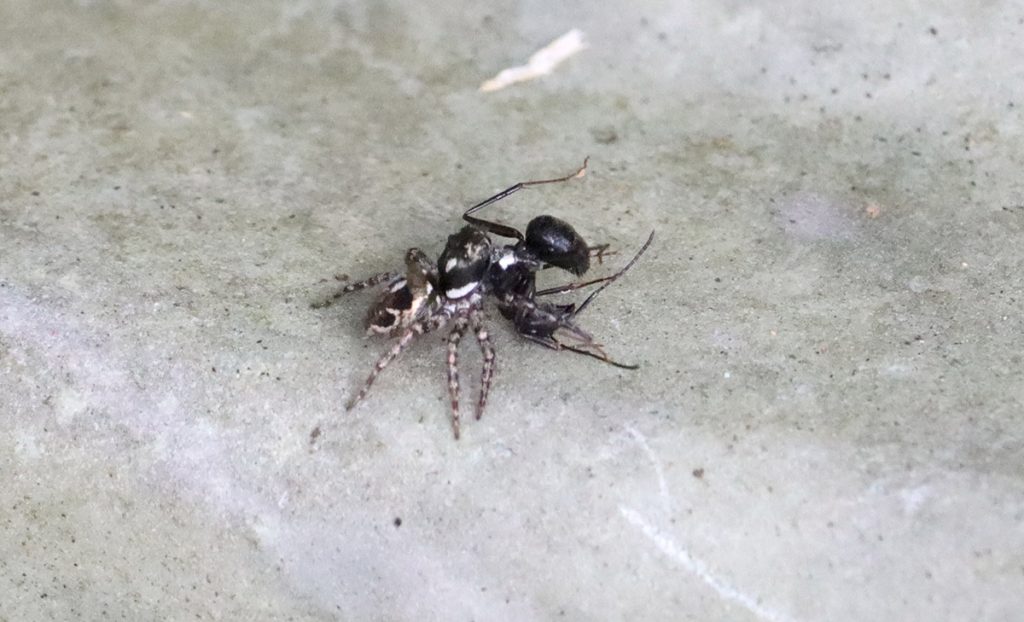
And then a few feet away, I see this. Some time has passed, so maybe it’s the same one and it has dragged its catch across the yard?
September 5, 2021
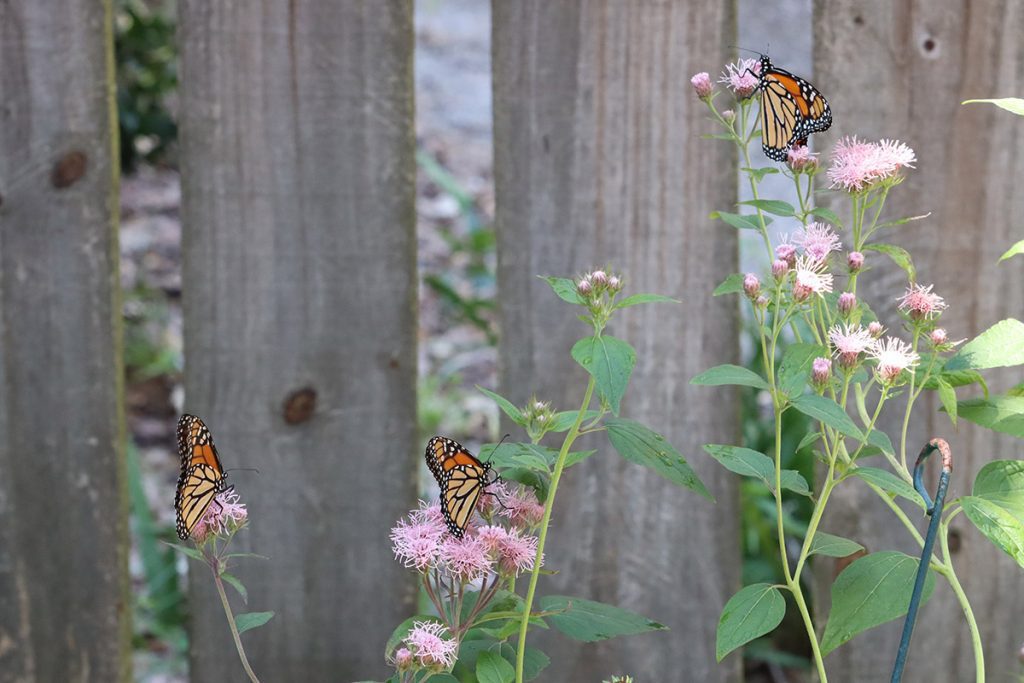
We keep getting multiple monarchs on the Brickellia, and I keep standing by with a camera to catch mating behavior. Most of the time, as happens today, it ends in rejection.
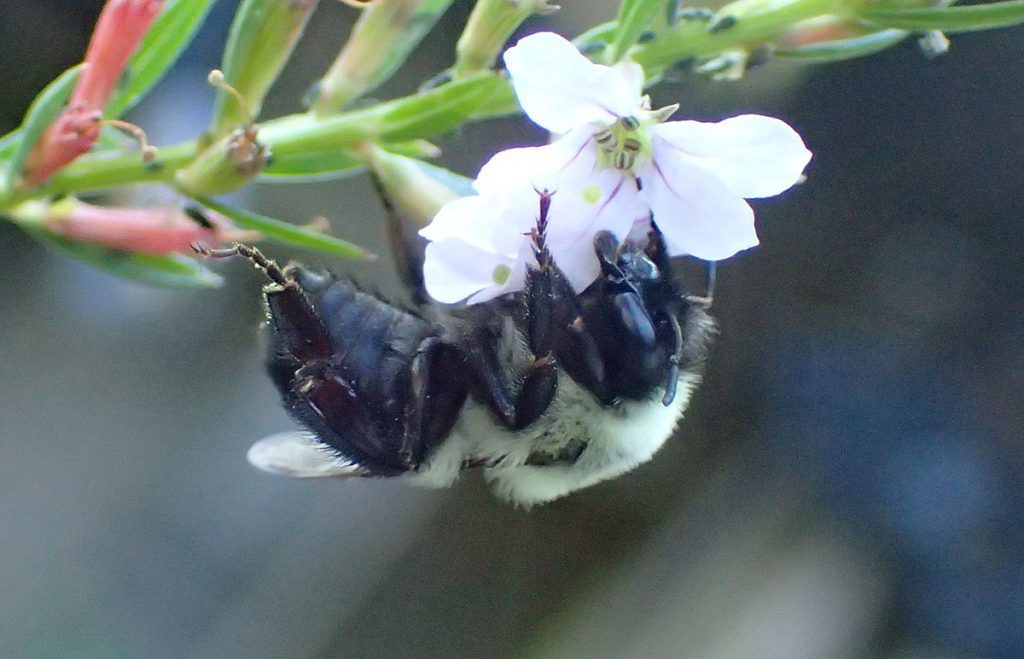
This bumblebee was so much smaller than the others I’ve been seeing, and I wondered if it might have been a species other than common eastern bumblebee. According to a reputable researcher, though, that’s what this is. I then wondered whether this might be a male, which are usually smaller than queens- in this case males are as small as 12 mm, queens 17 mm. Both are larger than non-fertile female workers (as small as 8.5 mm). Winged loosestrife flowers are about 1 cm (10 mm for the metrically challenged). Also, males have a yellow face; this is just a smaller worker bee than I’ve been seeing.
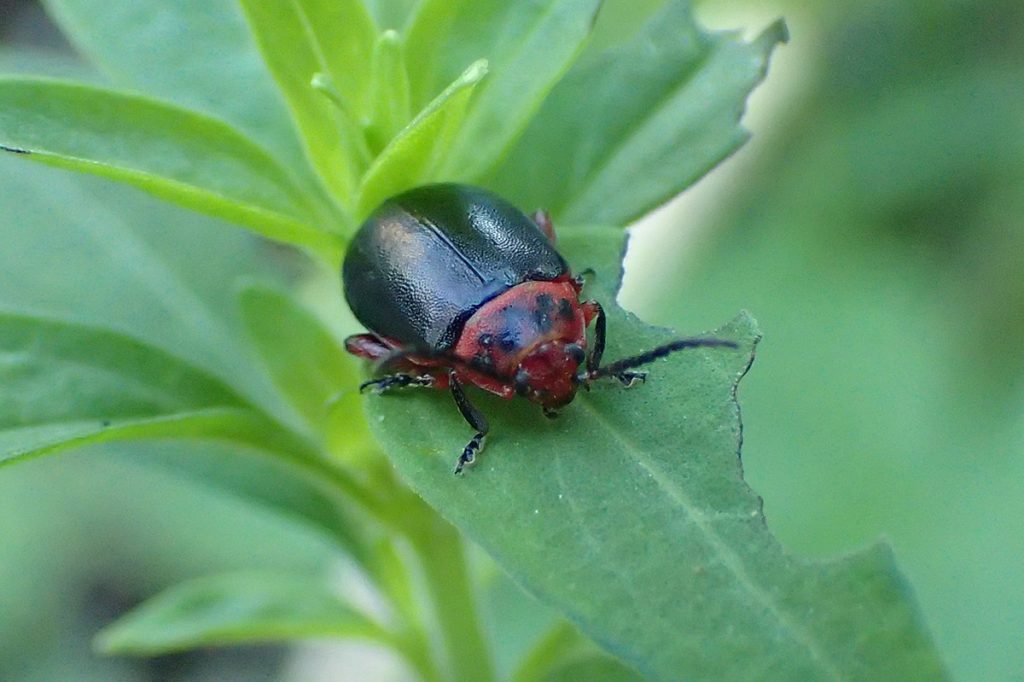
Flea beetles are plant eaters. iNaturalist users have identified two species of Kuschelina in Leon County, both of which are too similar for me to distinguish. So far, no other users have chimed in with a species-level suggestion.
September 4, 2021
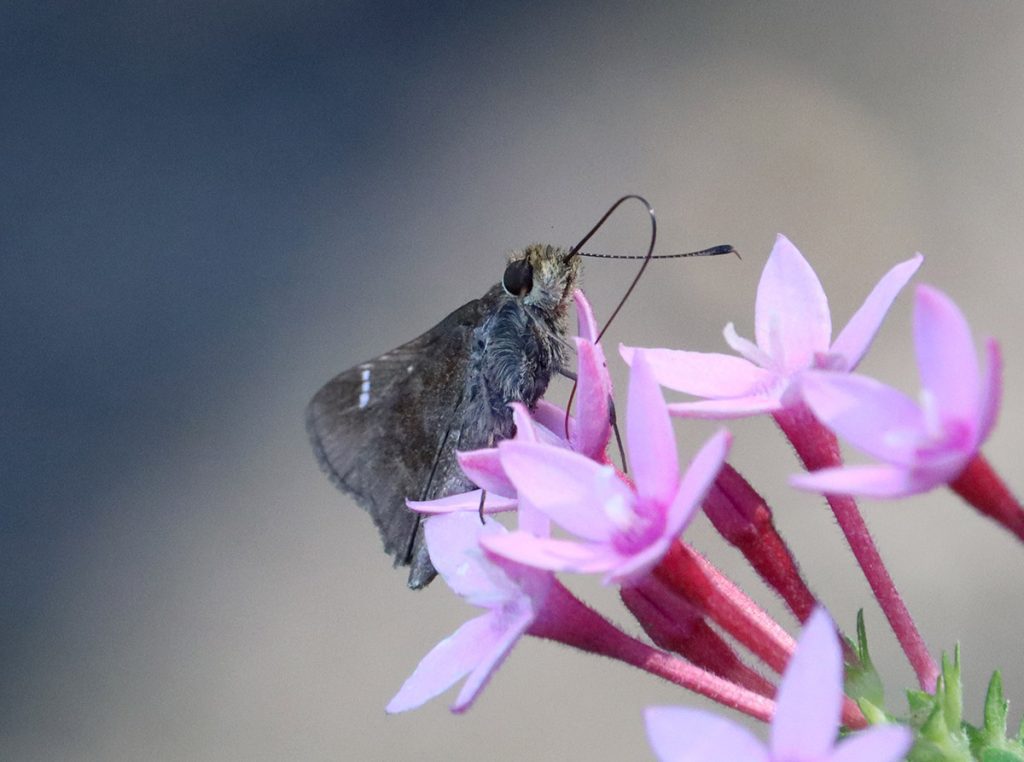
This is the first time I’ve photographed a southern cloudywing in 2021. Looking at the seasonality chart on iNaturalist (gathered from all of a species’ observations), this butterfly reaches its peak in July and is starting to ramp down for the year.
September 3, 2021
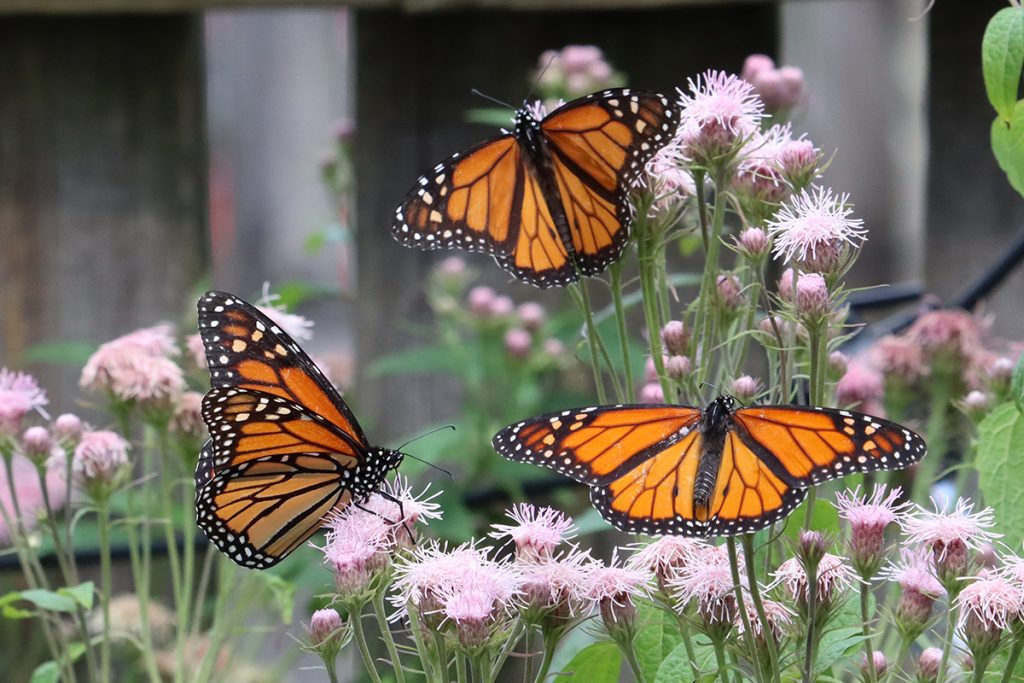
Every day, we’ve been seeing more and more monarchs on the Brickellia plants, and never fewer than two at a time.
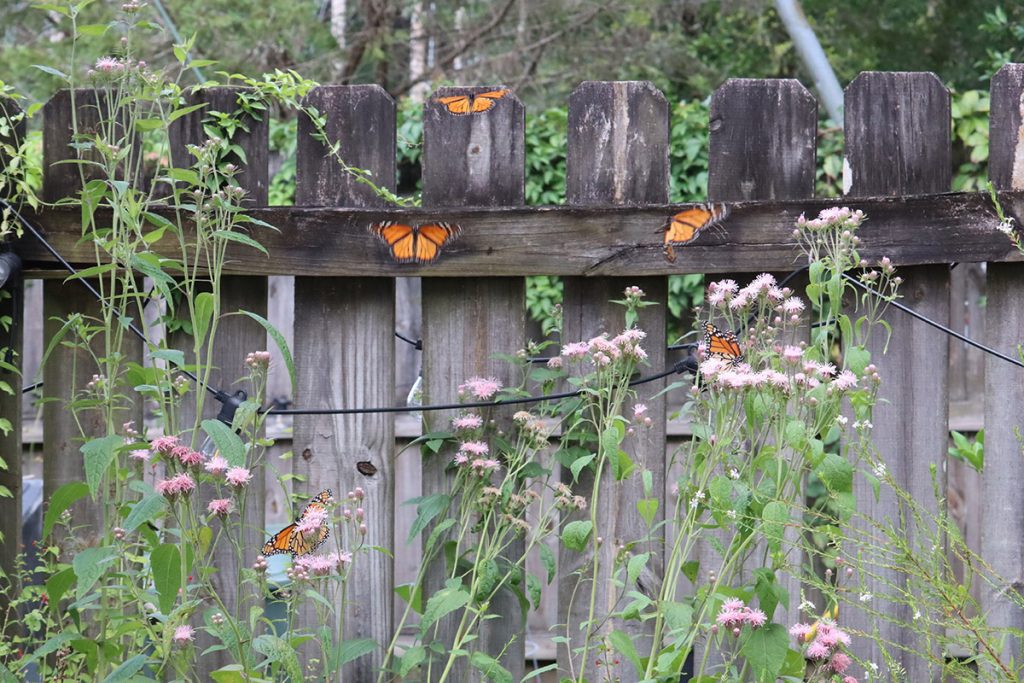
Here’s a nectar plant close to milkweed plants. Inevitably, when one monarch lands on the Brickellia (probably the female), another comes to pester it (likely the male). A chase ensues, and either the one evades the other and returns tot he plant, or they chase each other, ending up coupled in a tree.
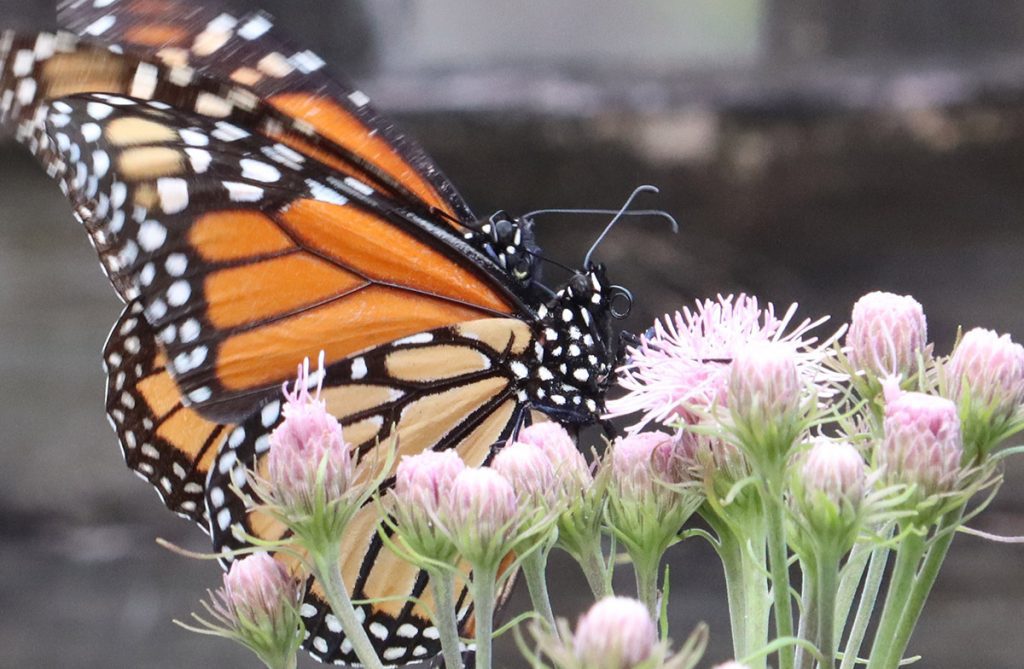
September 1, 2021
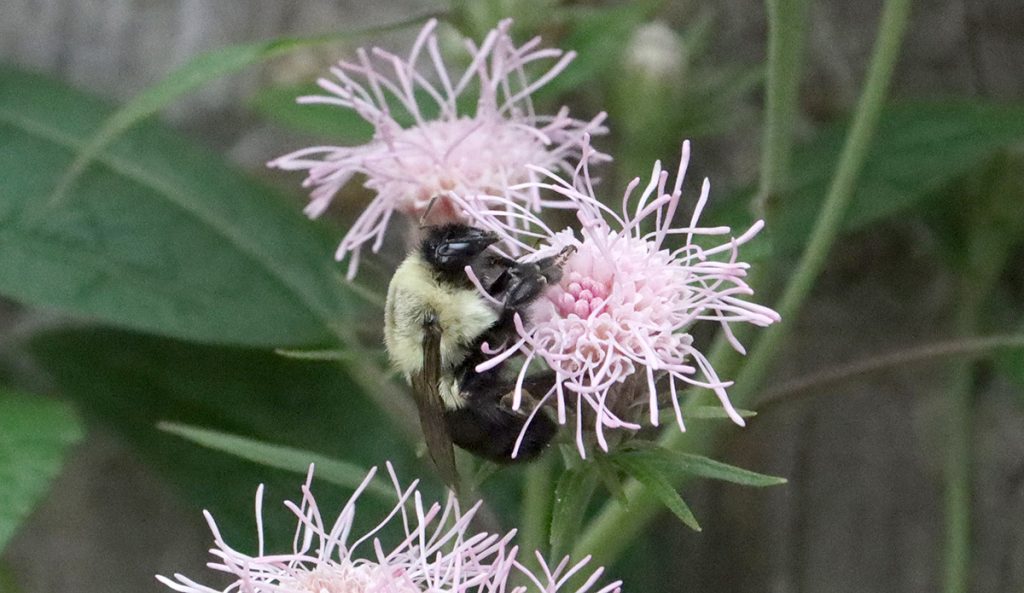
The Brickellia is in full swing, attracting a nice variety of larger pollinators. I always associate this plant with butterflies and moths, but now, working on our bee project, I’m starting to notice how bees like it as well. Elizabeth Georges at Native Nurseries recommended it as a composite flower bees love, and I included it in our list of 30+ plants for bees.
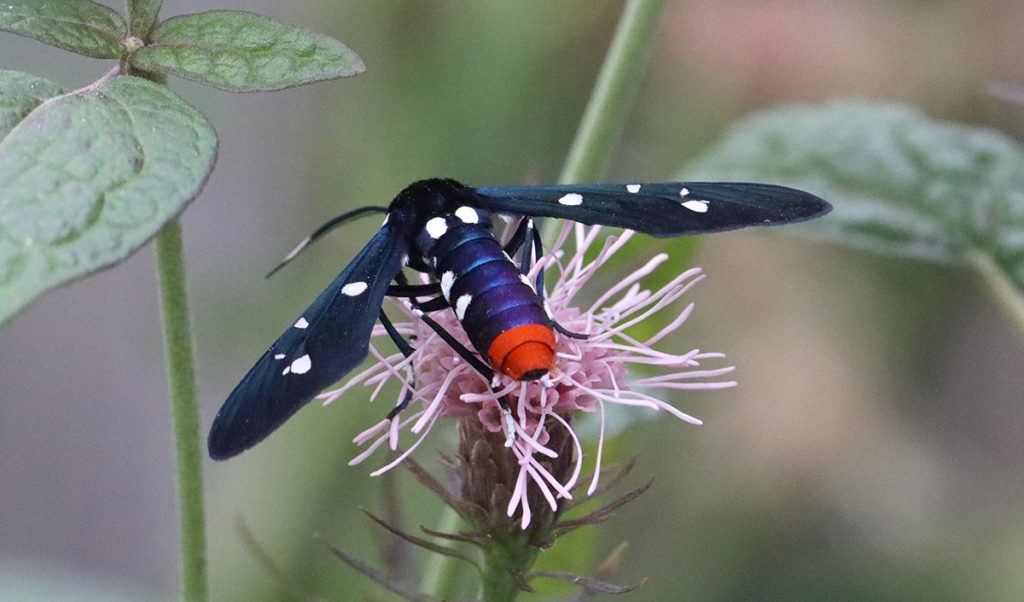
Every year now, like clockwork, we have polka-dotted wasp moths visit our Brickellia in the late summer. Here’s one, and I imagine we’ll soon be seeing two on the plant.
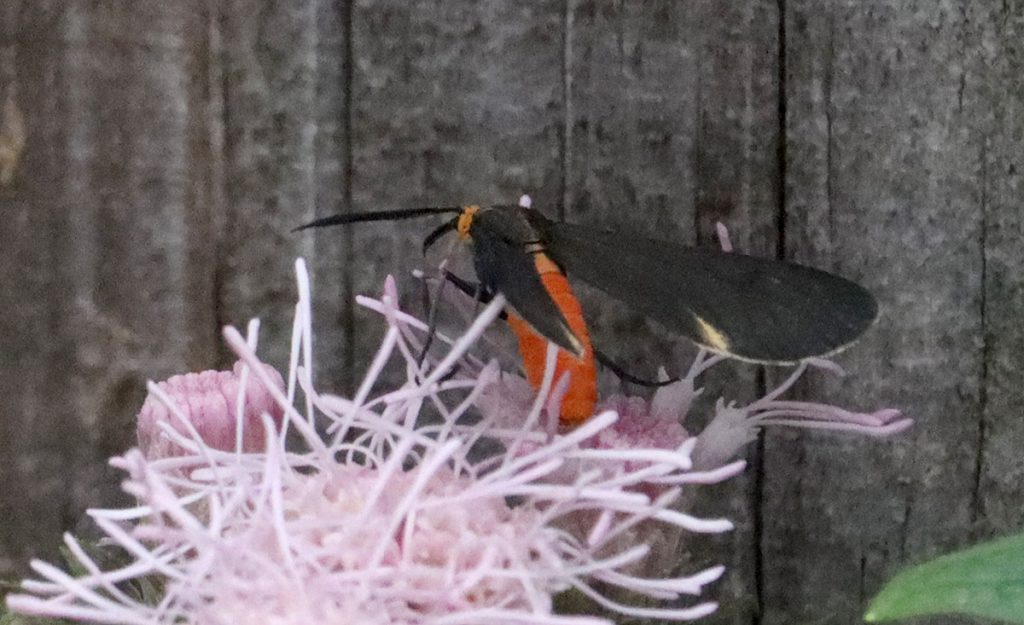
Here’s a moth I saw on the horsemint a couple of days ago on another late-summer blooming flower.
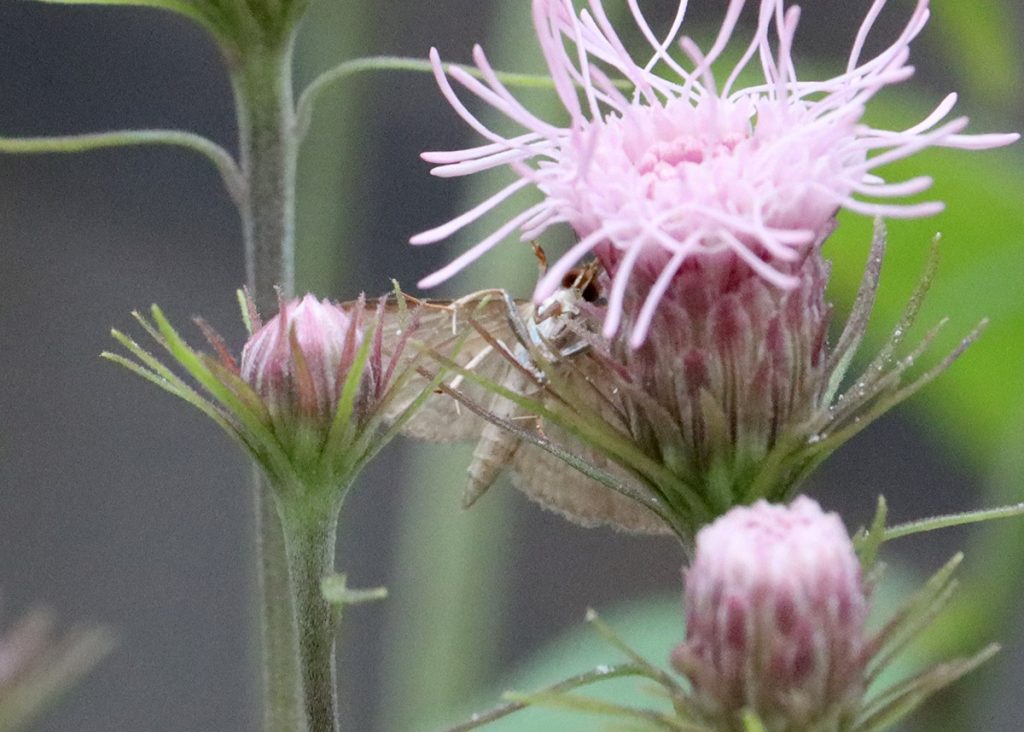
I didn’t get a better photo of this moth and so I don’t have an ID. But it was a busy day for moths on these flowers. You can see how many of the flowers have yet to fully bloom.
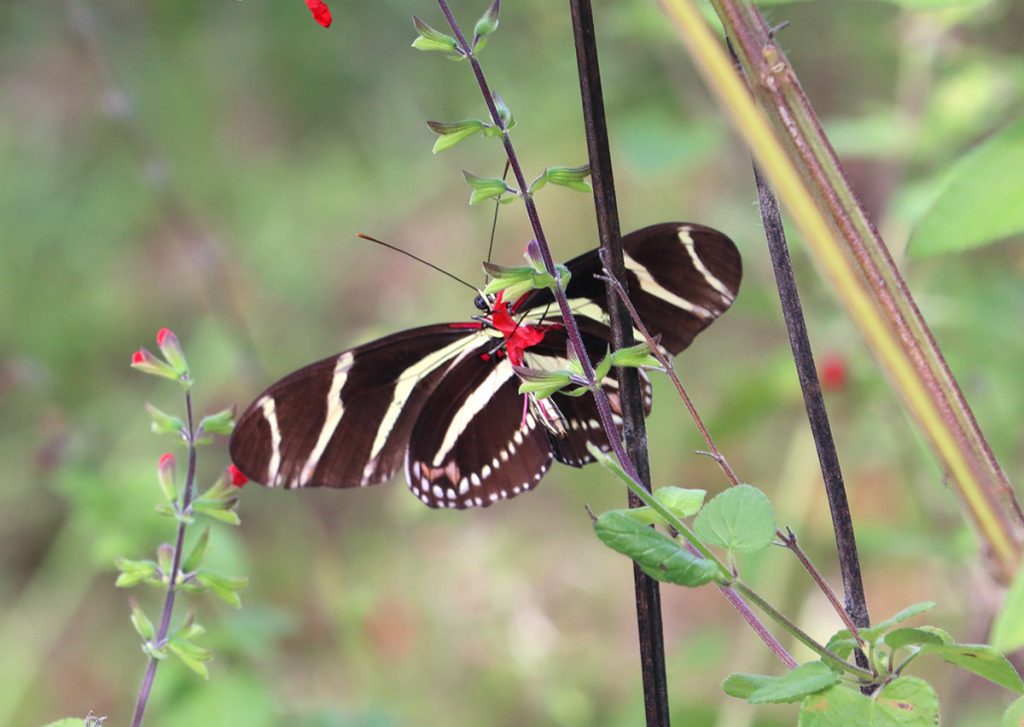
Lastly, I appreciate that zebra longwings have become a regular site in our yard in the summer after being absent most of the year.
August 30, 2021
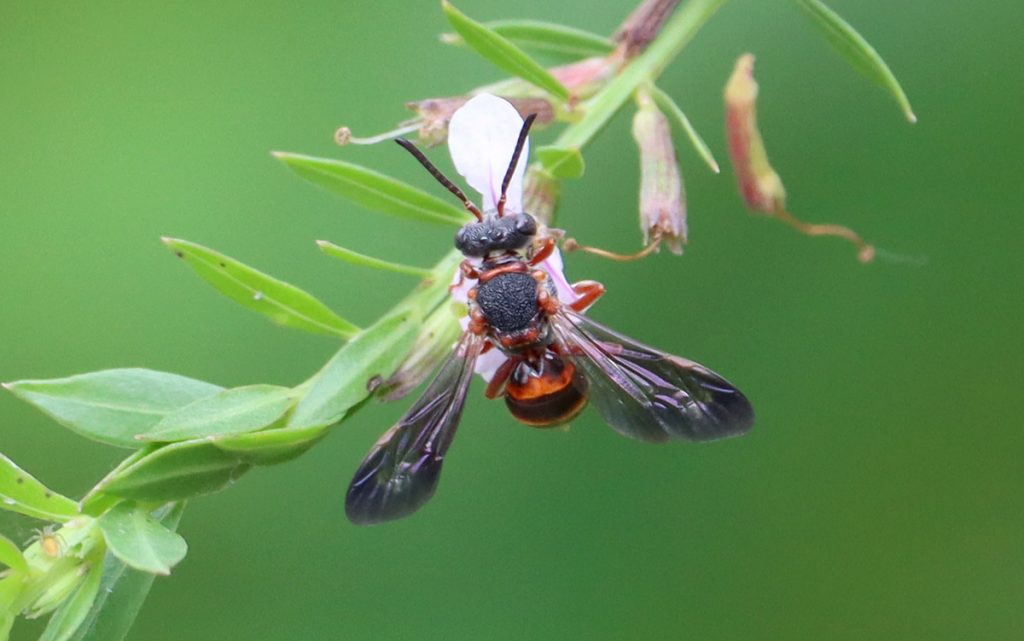
Here’s a bee I’ve only ever seen one other time- August 25, 2020. Looking at its seasonal chart in iNaturalist, it has four peak times people observe it throughout the year, the biggest being late August.
Since we’ve started the bee project, I’ve been reading a lot more about bees. I already knew this to be a cuckoo bee, which is a kleptoparasite. This means it lays its eggs with those of other insects, in this case bees, and those eggs hatch and devour the the other bee’s larvae.
What I’ve learned is that cuckoo bees host on specific bee species or genera. This bee hosts on the Agapostemon genus- which in our yard means brown-winged striped sweat bees (Agapostemon splendens). The reason I always see fervid nomad bees in late August is because it hatched with the Agapostemon broods that swarm our yard every August.
August 29, 2021
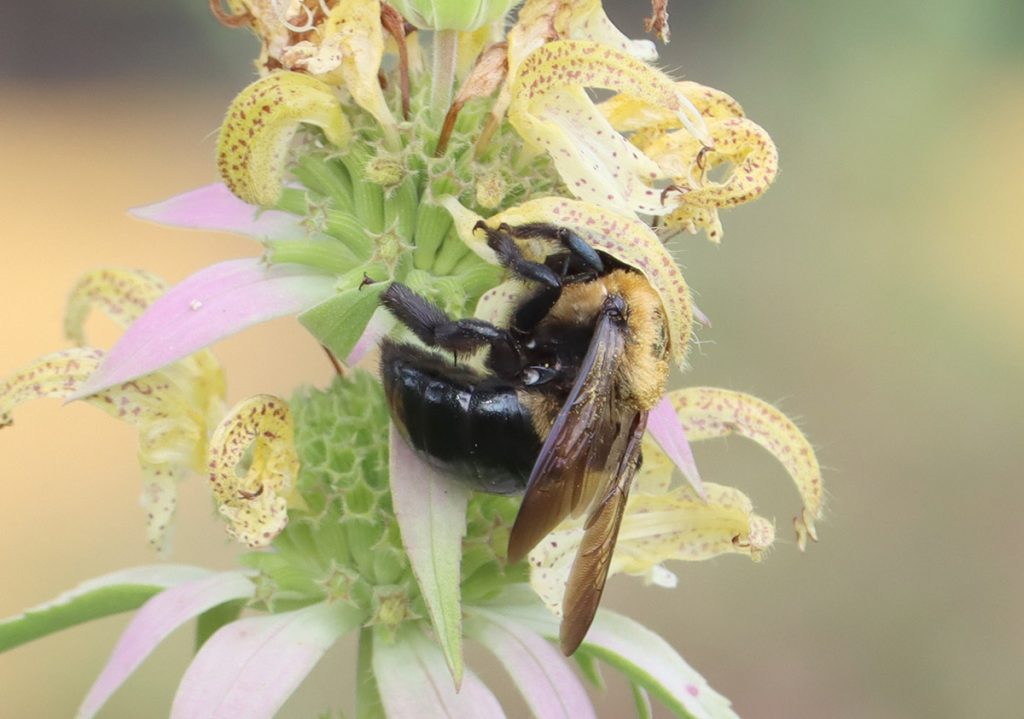
Carpenter bees nest all over out fences and railings, and yet they rarely stick around to feed off of our flowers. This of course changes in the late summer when the bee balm blooms.
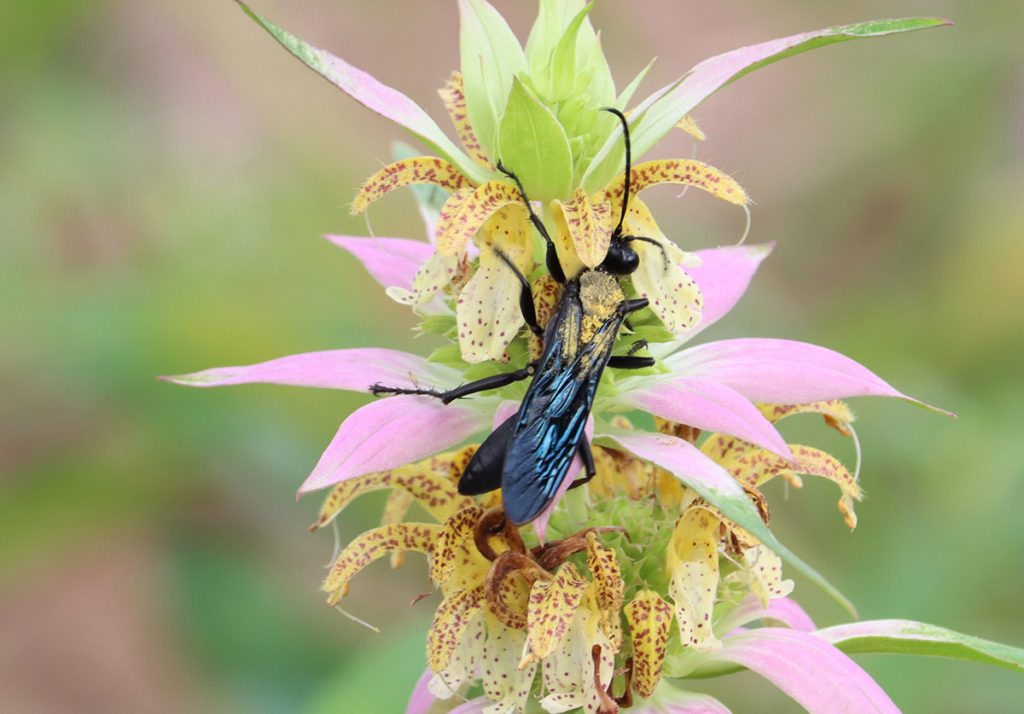
In our yard, I only ever see digger wasps on these flowers, and on cherry laurel flowers earlier in the year. If I had space for devil’s walkingstick and some of the other plants with heavy blooms that only last a few weeks, I bet I’d see them more.
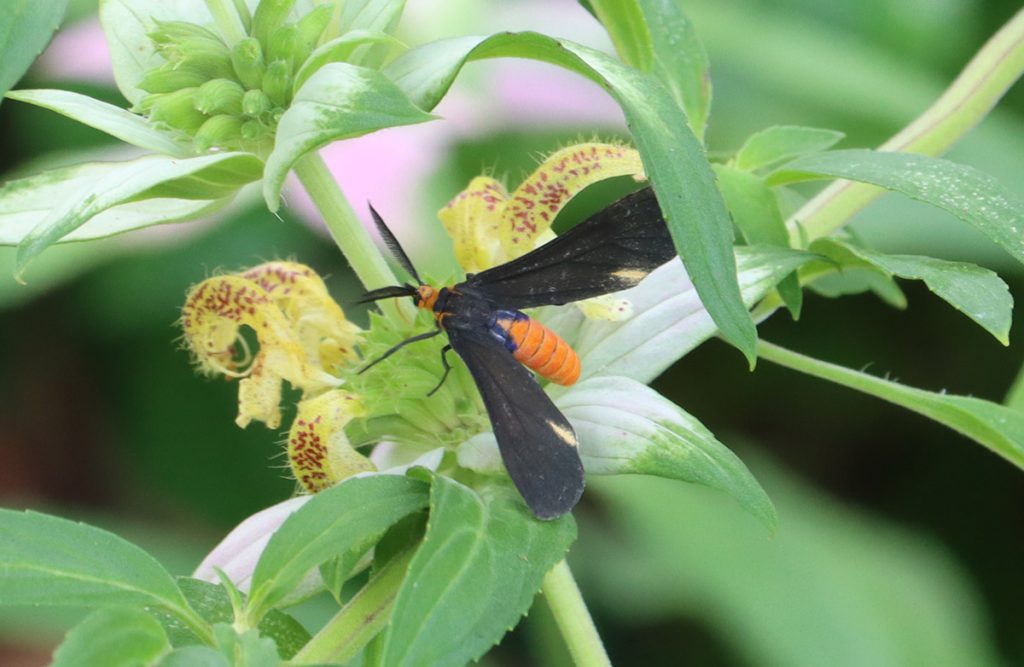
That makes a bee, a wasp, and a moth on the bee balm today. Well, that I photographed. I see monarchs occasionally try the flowers, but like I noticed on devil’s walkingstick, larger butterflies don’t always like flowers heavily trafficked by bees and wasps.
Anyhow, here’s a moth that hosts on Spanish moss. Every plant really does host some insect.
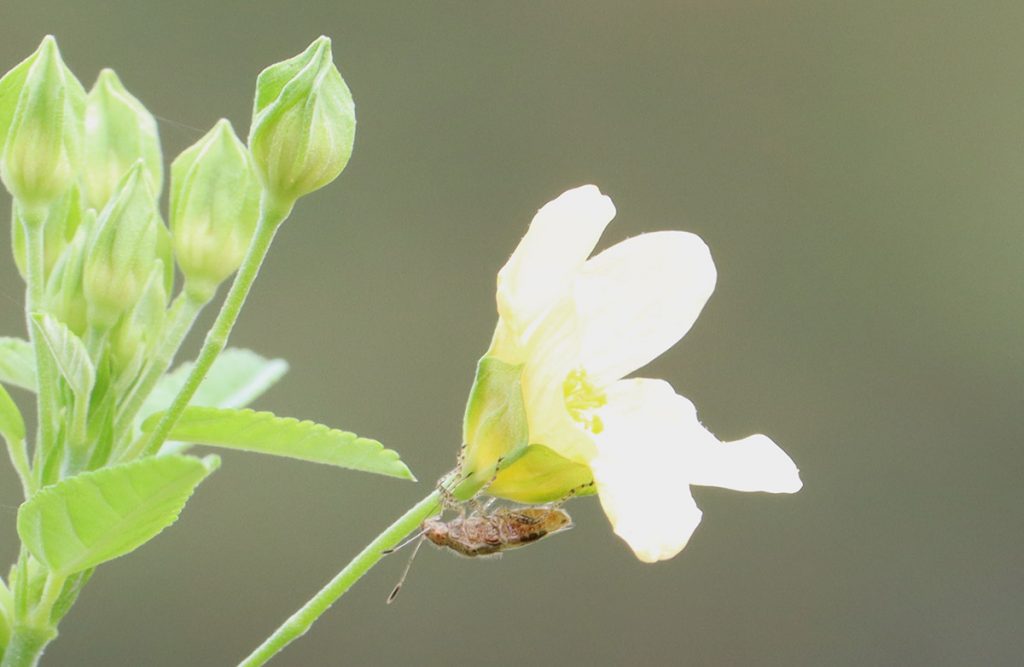
These plant eaters visit our fanpetals every year. When I went to look up the name in my previous iNaturalist observations of it, I saw that this insect finally got itself a common name. Congratulations!
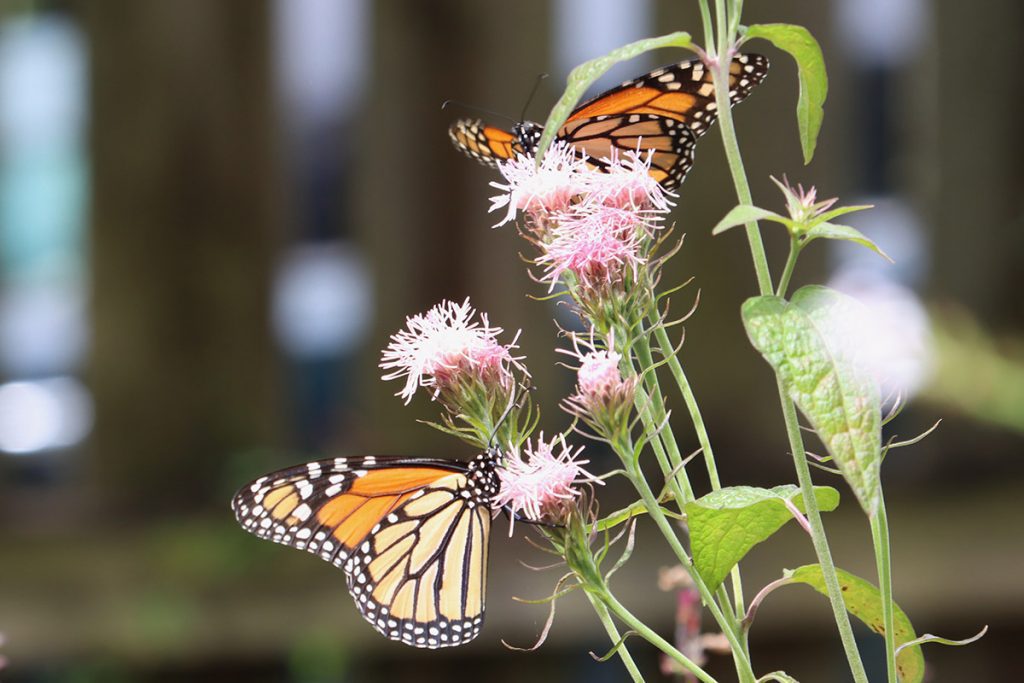
As the Brickellia really starts to bloom in full, we will start to see a minimum of two monarchs on them daily. They will pester each other and try to mate, sometimes successfully. Today is just the beginning. It’s going to get freaky on these late summer blooming flowers.
August 28, 2021
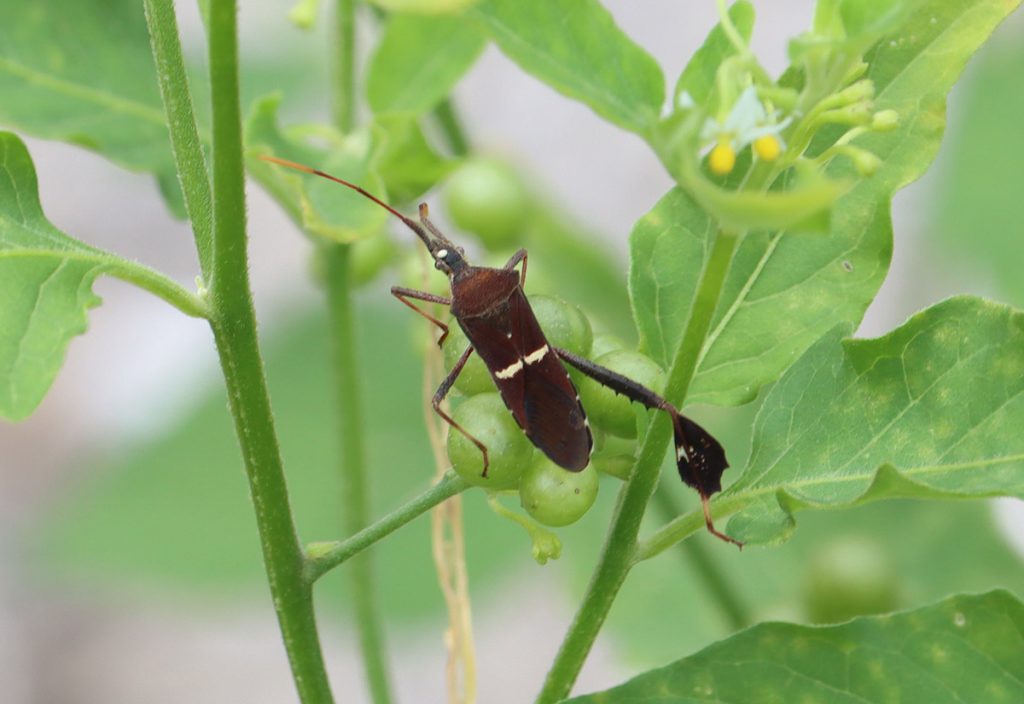
WFSU has started our My Garden of a Thousand Bees project, so I’m out front shooting video of our spotted bee balm. I find myself distracted by the weed patch where our oak had been- it’s full of insects. Here is a leaf footed bug, one of several species I’ve identified in our yard with iNaturalist over the last couple of years.
This is in the Leptoglossus genus- the fourth different species in this genus that I’ve identified in our small yard. How do you say biodiversity? Like many of those, this is on a native “weed” I’ve let grow. Not always, but often enough, insects that people consider pests favor native weeds like this one.
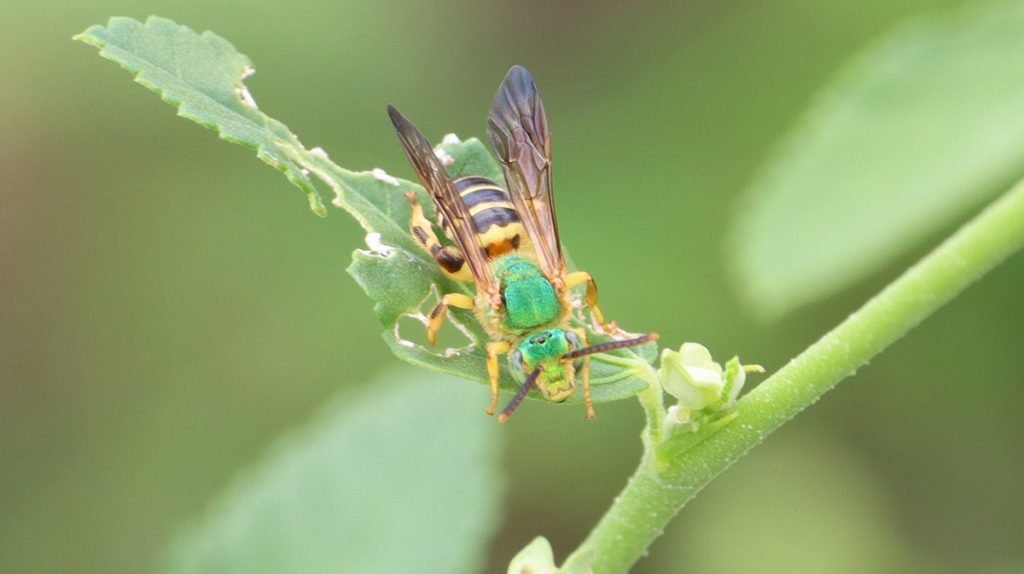
I’m seeing more and more brown-winged striped sweat bees. They gravitate towards the bee balm, but also seem to like the nearby fanpetal flowers. It’s on a leaf with some grazing damage, perhaps from a checkered-skipper butterfly caterpillar.
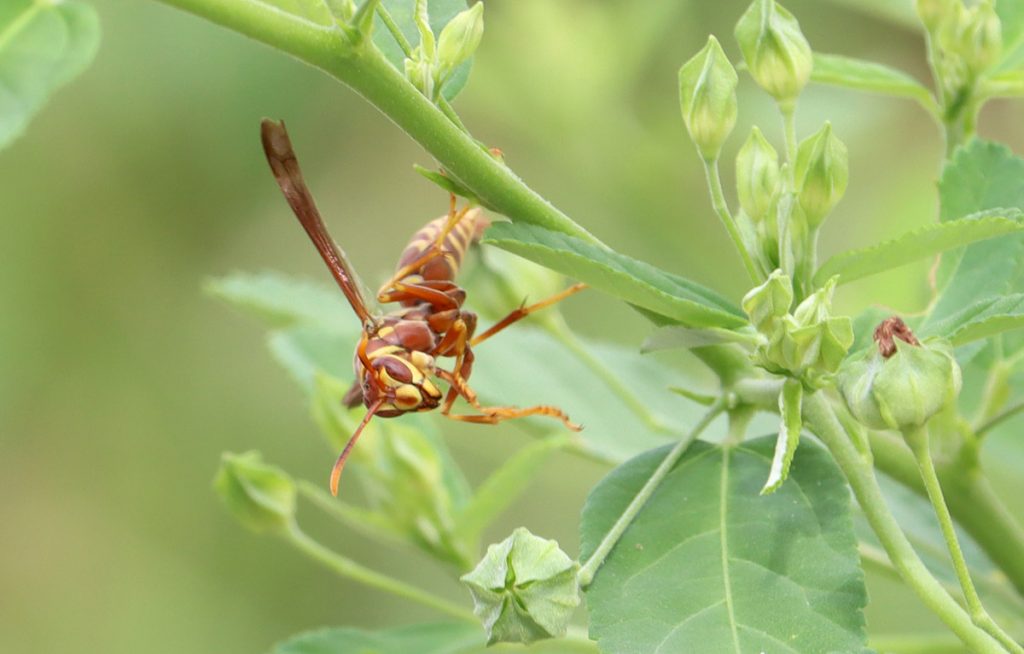
And speaking of caterpillars on fanpetals… this paper wasp isn’t here to pollinate. A couple of years ago at Thomasville’s Cherokee Lake Pollinator Garden, I filmed a paper wasp open up a fanpetal flower bud like those in the photo above, and pull out some kind of insect larva. Checkered-skipper caterpillars host on the plant, as well as numerous other insects. You can see how fanpetals contribute to the backyard food web.
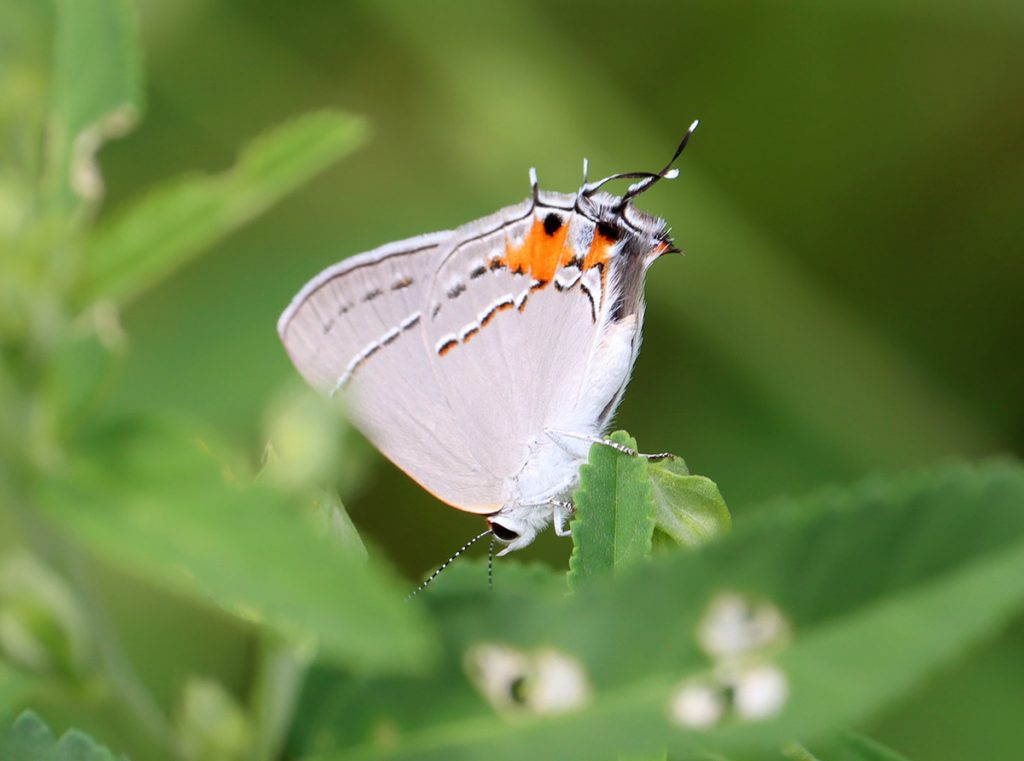
Fanpetal flowers are small (about 1 cm) and only open for about an hour at midday. They attract various bees as well as smaller butterflies like checkered-skippers and hairstreaks.
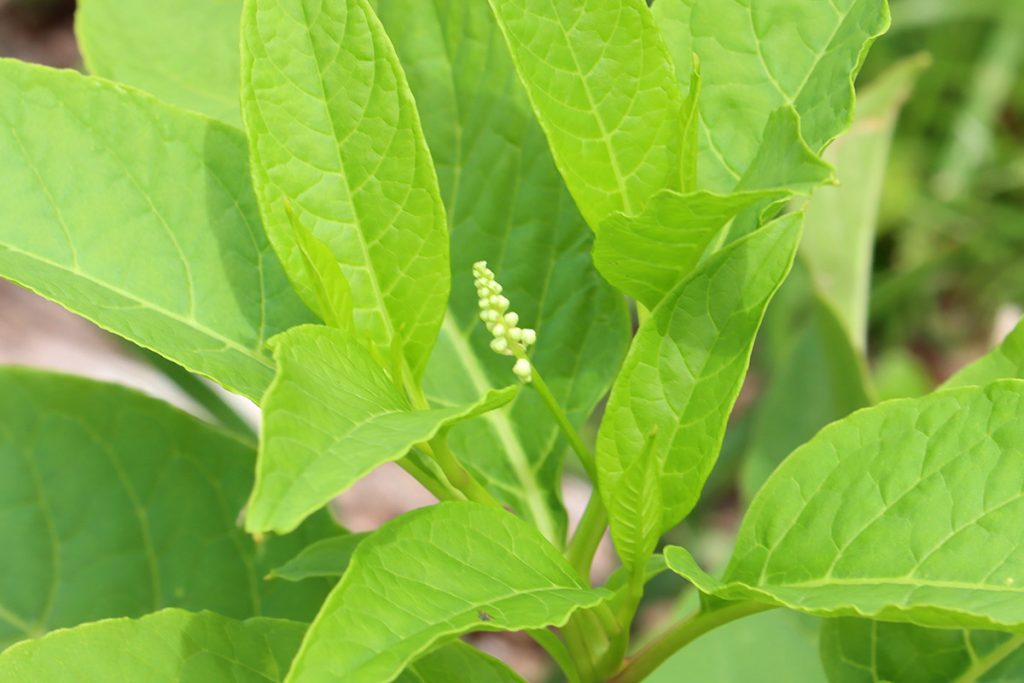
I think it’s amazing that when this plant was just a few low lying leaves, I was able to identify it on iNaturalist. To me that’s a great value for a free tool, to identify weeds and decide what to keep and what to pull. This is just near the fanpetals in the front weed patch.
August 26, 2021
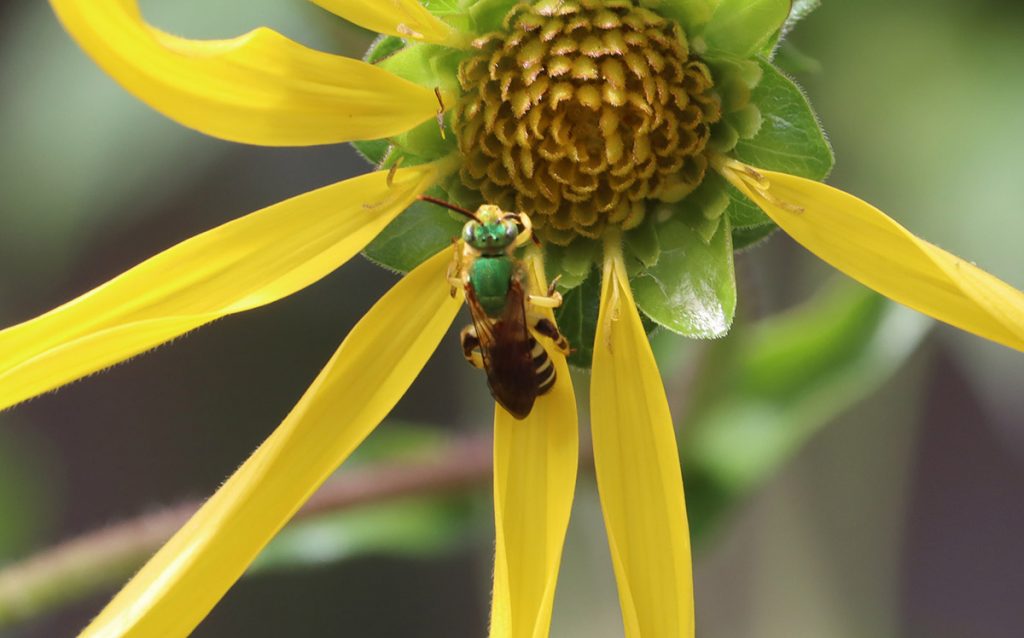
The past two years, male brown-winged striped sweat bees have appeared right at the beginning of August and almost entirely disappeared right at the start of September. Twenty-six days into August, and here we finally see our first male. Typically, we’ll start seeing more and more until they’re swarming flowers throughout the yard. I wonder if we’ll see quite as many as we have the past two years.
August 21, 2021
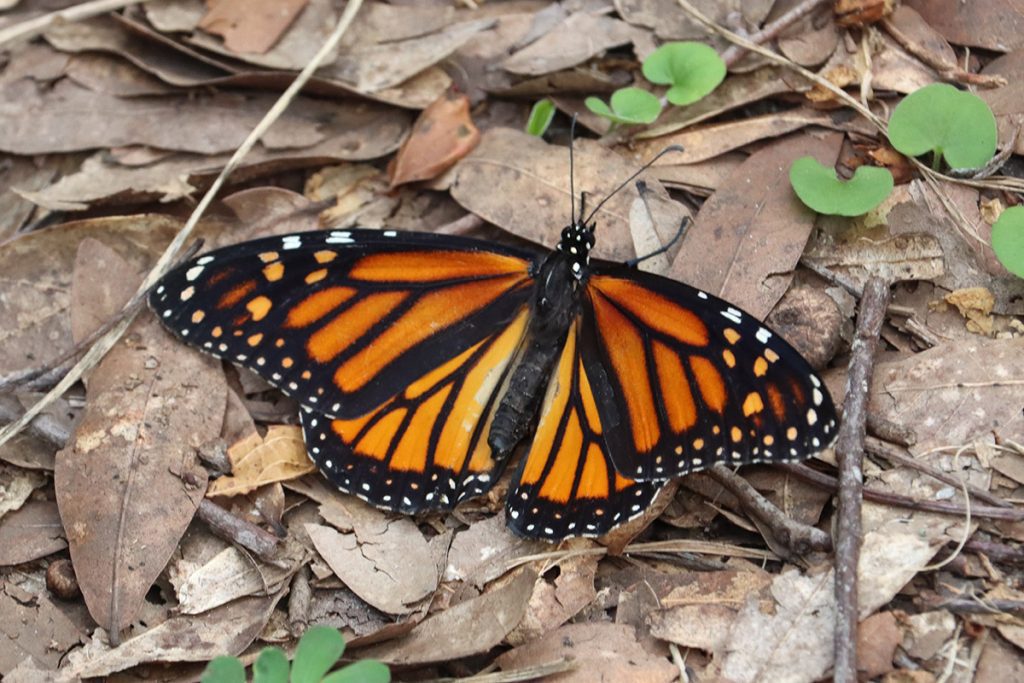
Not far from where that newly emerged butterfly took its long rest yesterday, I see a monarch butterfly walking on the ground. It’s not deformed like butterflies afflicted with OE, but perhaps it was injured somehow?
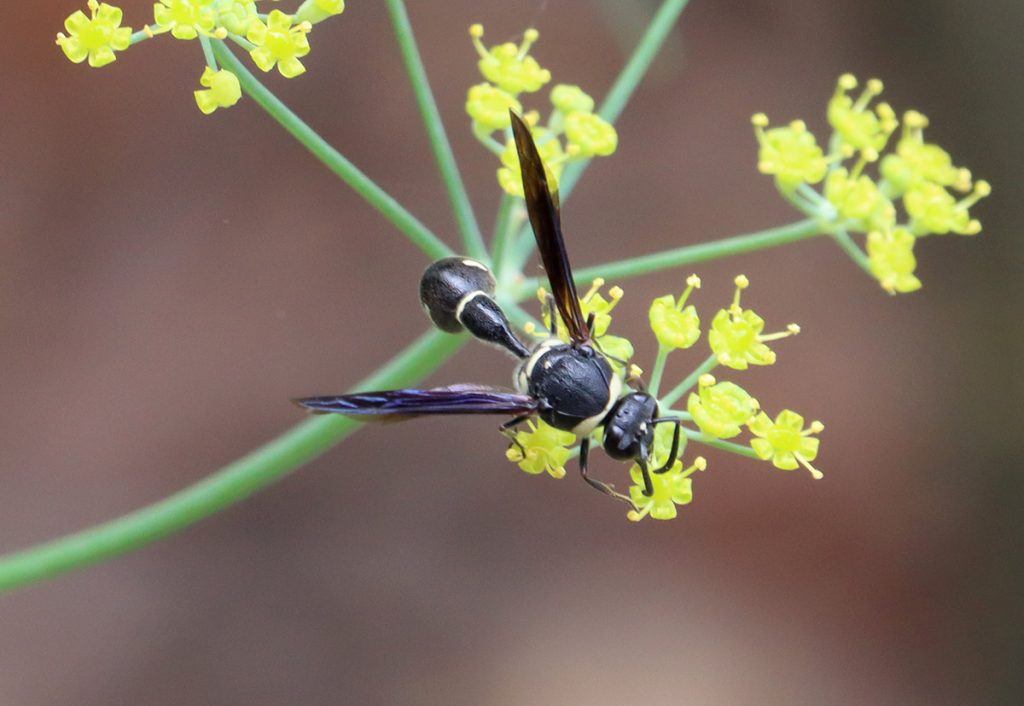
The fennel, golden Alexander, and meadow parsnip are all in the garden to black swallowtail caterpillars, which we haven’t seen in two years. I like when they flower, as they offer a different kind of flower for wasps and small bees. And sometimes we see pollinators we don’t otherwise often see.
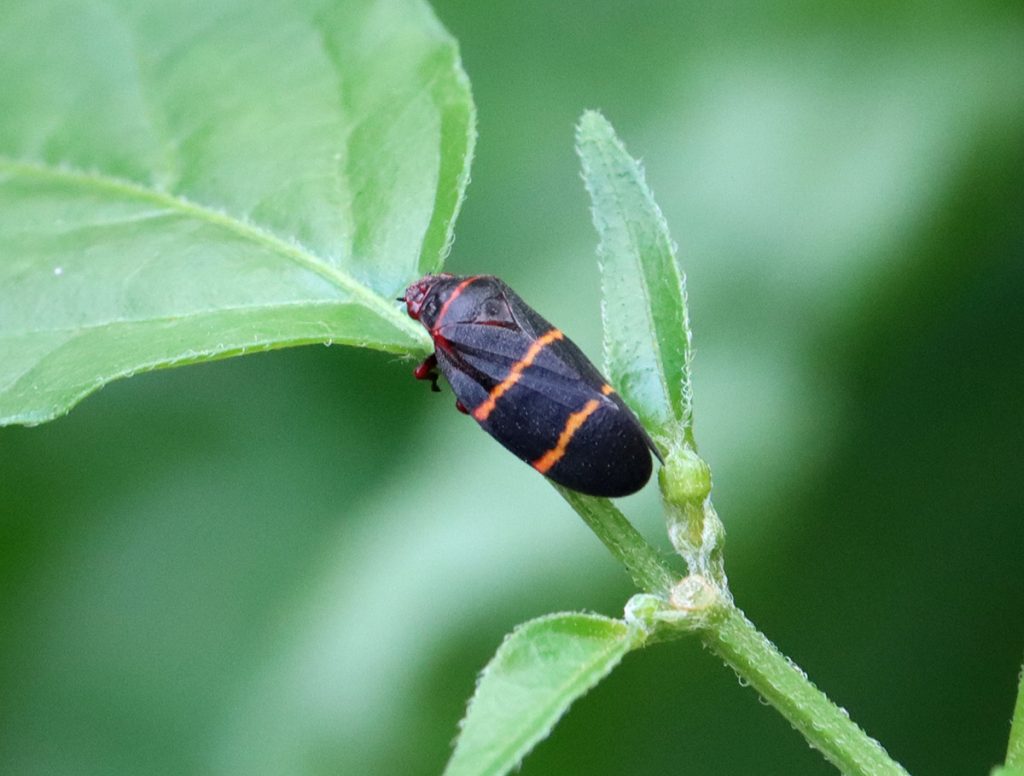
I’ve been seeing these a lot, especially in the front area where the oak had been. I’ve let it get weedy there, encouraging natives like fanpetals, pokeweed, ground cherries, and beautyberry, and clearing out nonnatives like chamberbitter and catclaw vine. It’s become a haven for pollinators and plant eating insects alike. It’s quickly becoming a favorite spot.
August 20, 2021
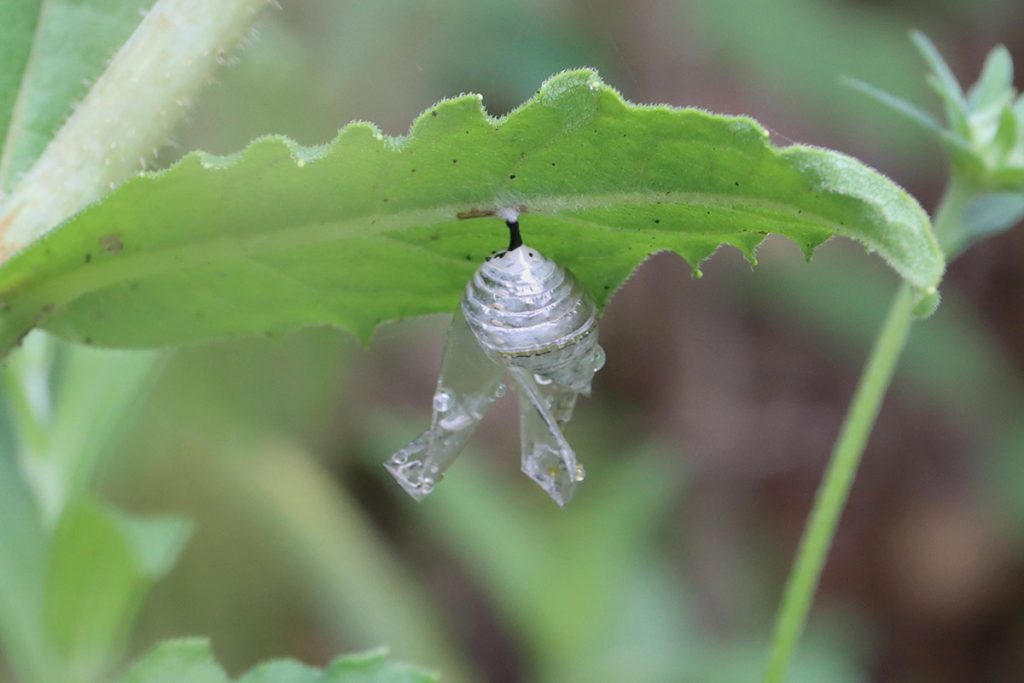
Now where could you be?
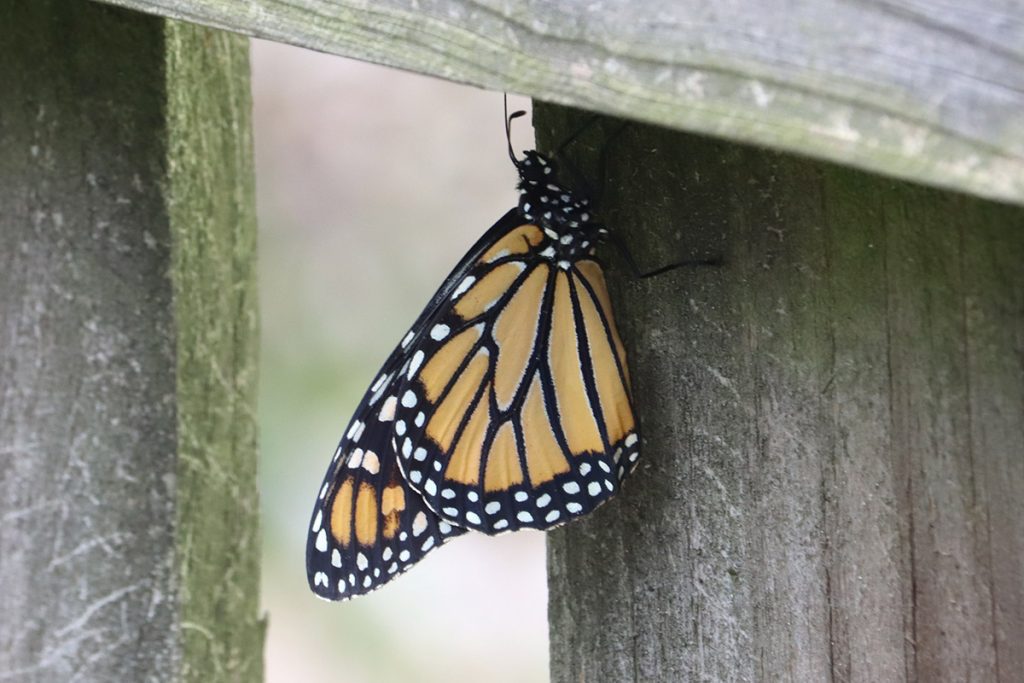
It has left the chrysalis but maybe is not yet ready to fly.
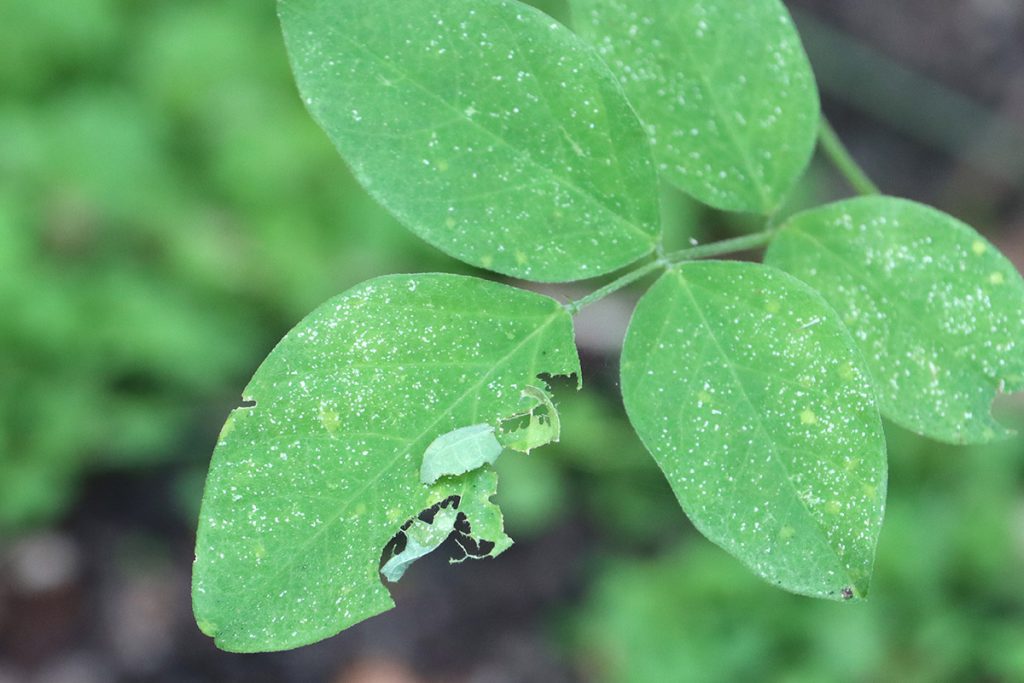
We’ve had so many pea plants in the yard this year, and I’ve barely seen long-tailed skippers. I always provide larval food for their caterpillars, and they’ve been a mainstay for years. Here, later than usual, we’re seeing leaf rolls on our pea plants- shelter for bean roller caterpillars.
August 19, 2021
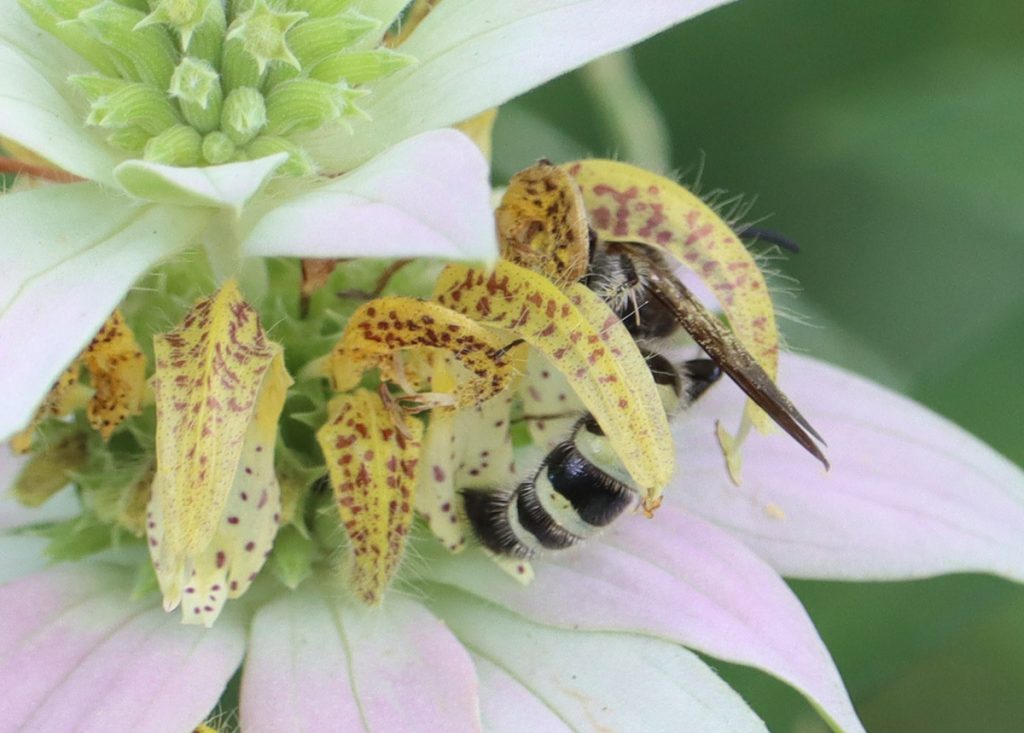
The horsemint has been kicking lately. Here’s a wasp I’d seen throughout last year, but not at all until now. Bee balm is always a major attraction in our yard.
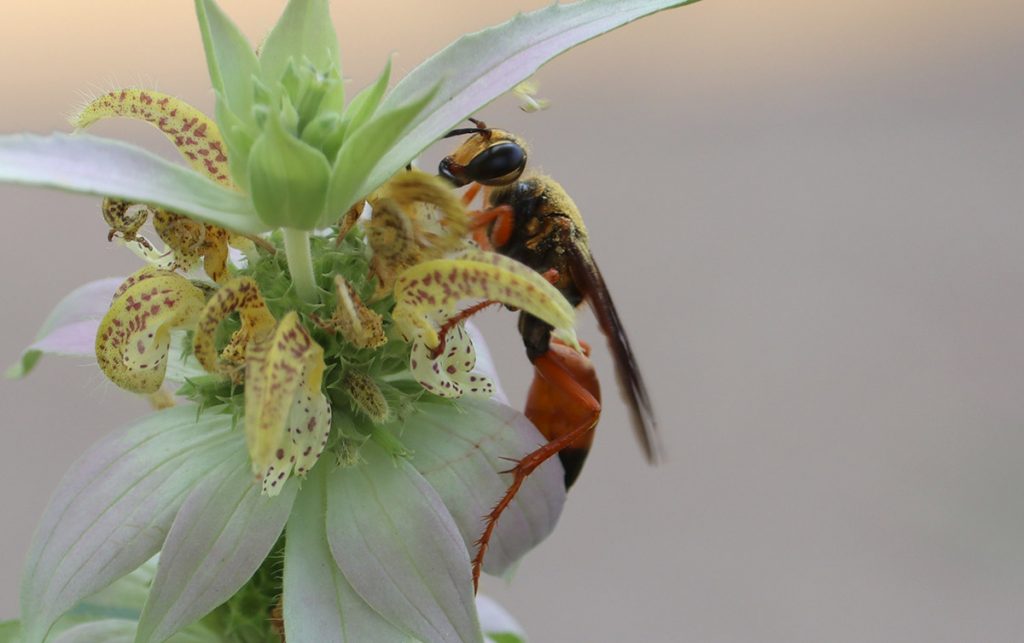
Here’s a wasp I only ever see earlier on the year when our Carolina laurel cherry trees bloom, and then in the late summer during the few weeks bee balm flowers. I also saw it when I shot footage of devil’s walkingstick during the few weeks it’s in bloom in the mid-summer. Golden diggers seem to like those plants that have intense blooms for just a few weeks.
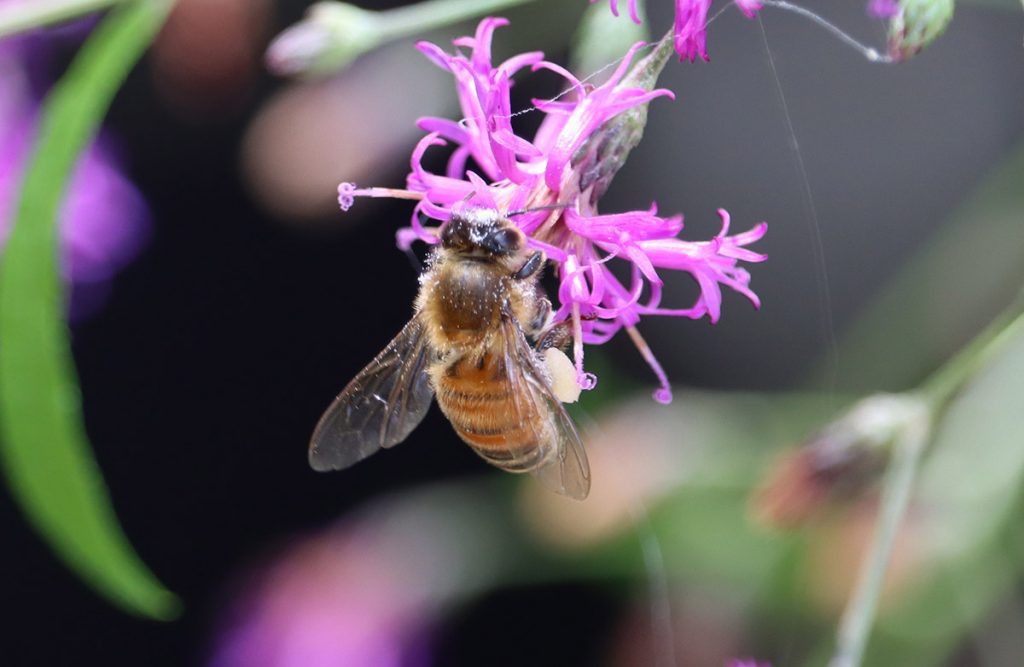
In our yard, I see honey bees early and late in the year, but not as much when we have a lot of native bees on our flowers. So here’s a rare summer sighting.
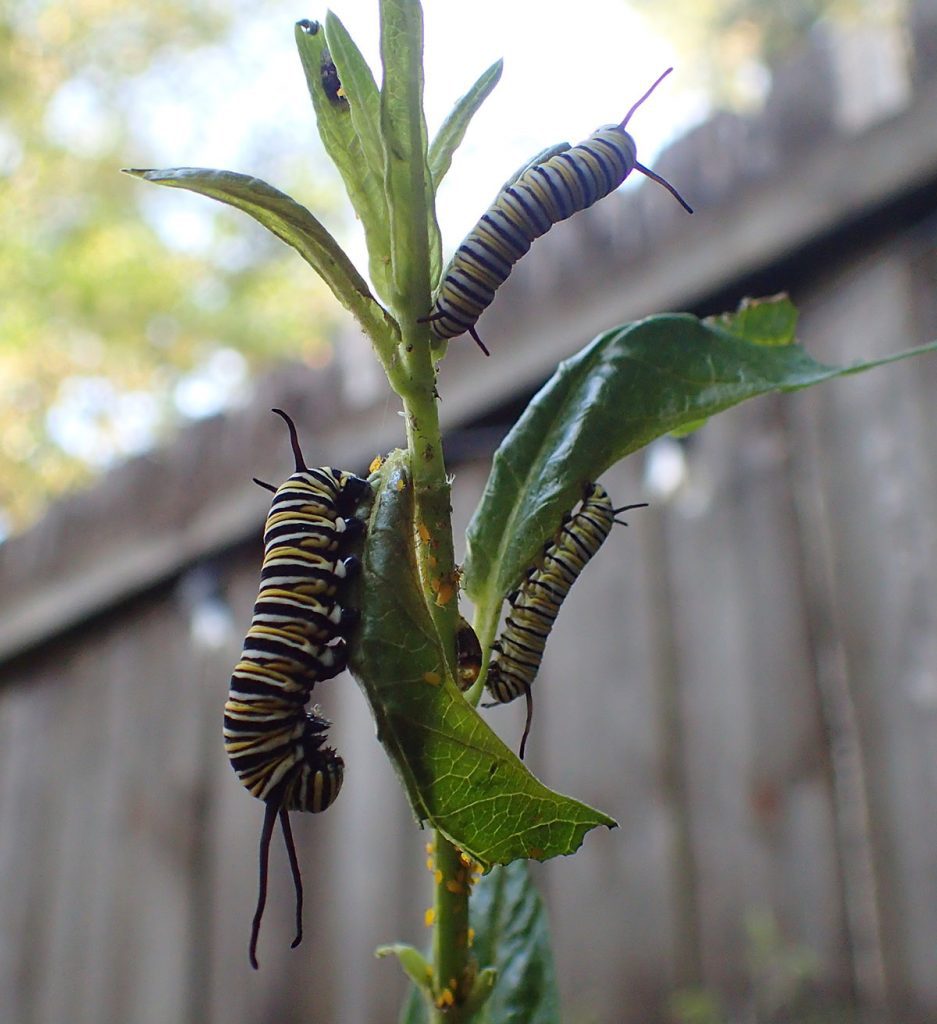
Within a couple of days, all of our milkweed plants will be leafless. Almost. For some reason, they left one single leaf on this pink swamp milkweed. It had seemed like a slow year for monarchs, and it’s still slower than it had been up until a couple of years ago. Some years, we have had several such “de-leafings.”
The orange insects are milkweed aphids, and the little brown lumps on the leaves are hoverfly larvae, which eat the aphids. I recently wrote a post on monarch caterpillars and their predators, in which I cite a study that found monarchs survive at a higher rate when they share a plant with other insects. Specifically, other insects that won’t eat them. It turns out that it’s better that we leave those aphids alone.
Lastly, I think this caterpillar is looking for a place to make its chrysalis.
August 18, 2021
This year, monarchs have largely been laying low until they reach the fourth or fifth instar. Until now. Maybe because we have so many large caterpillars all of a sudden, the smaller ones seem to be conspicuous during the day as well. I think it’s starting to get competitive for our limited milkweed resources.
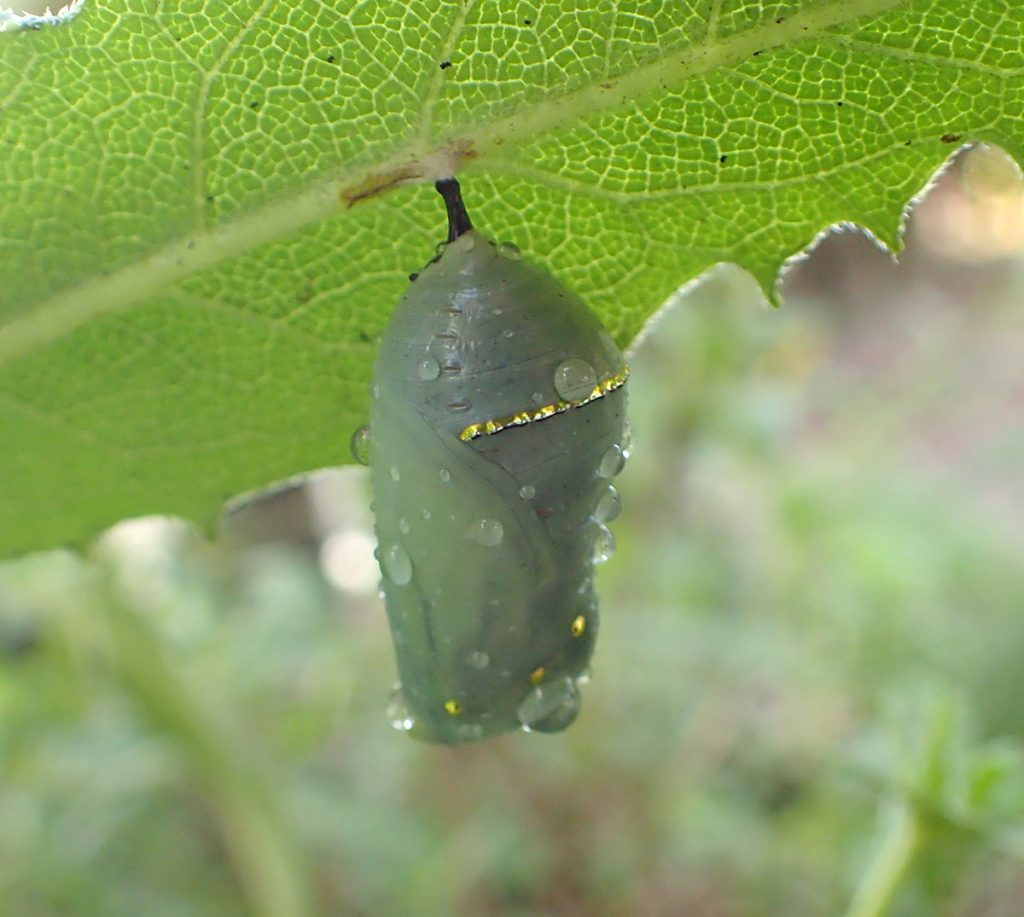
This chrysalis has now been under this leaf for a week. We should see a new butterfly soon.
August 17, 2021
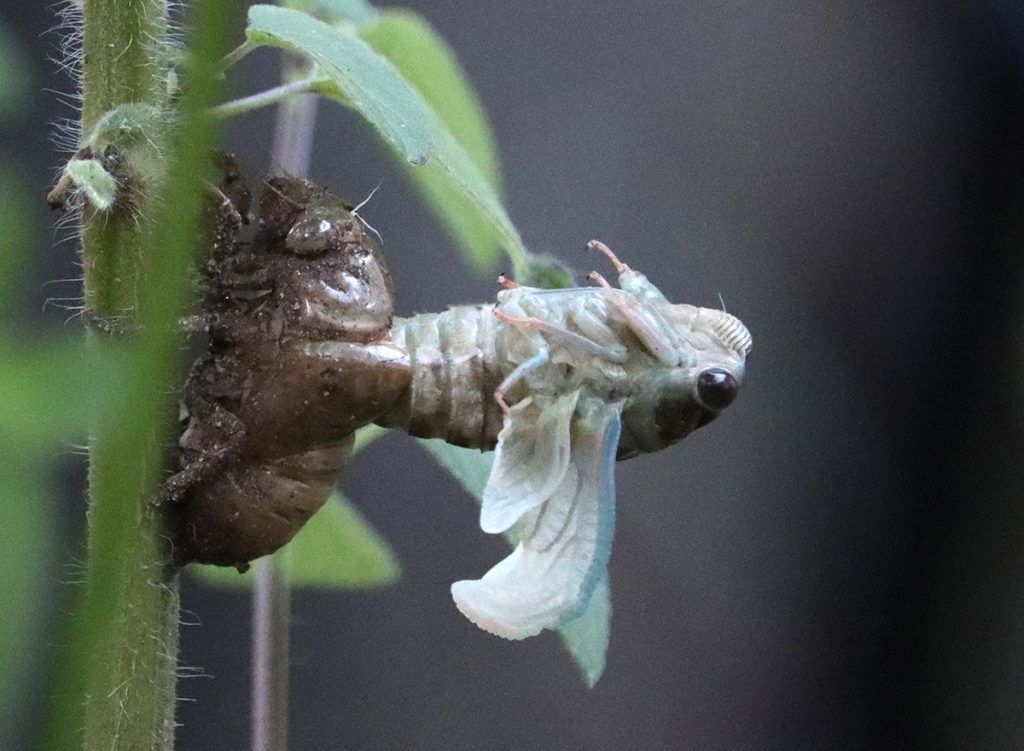
Last night after dinner, I spotted something odd looking an a salvia plant. I’ve never seen a cicada eclose from its exuvia. It comes out horizontal!
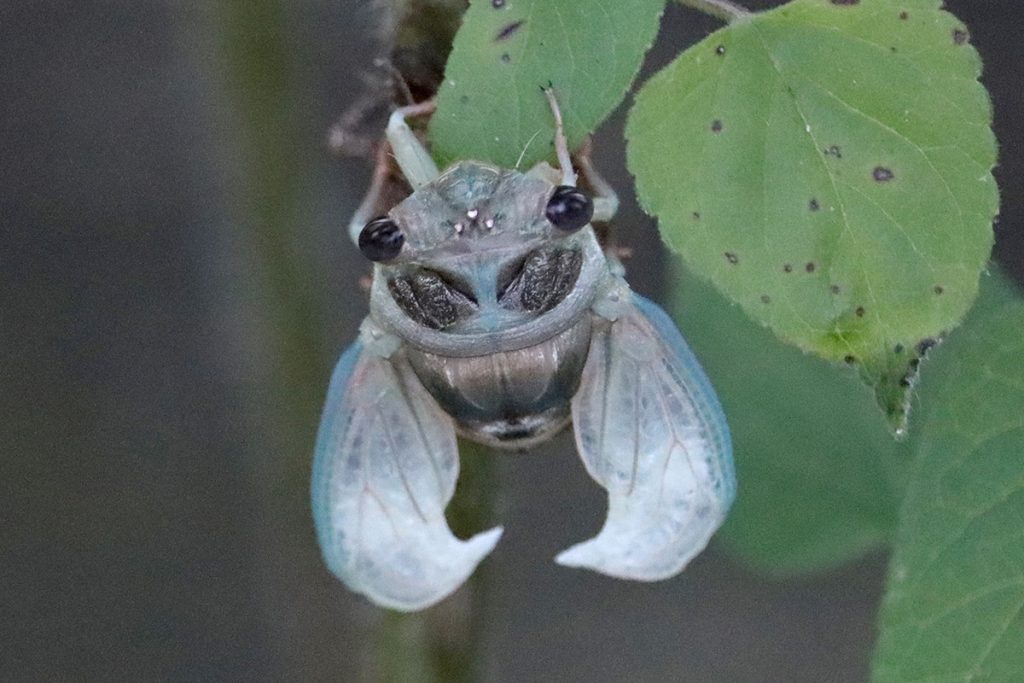
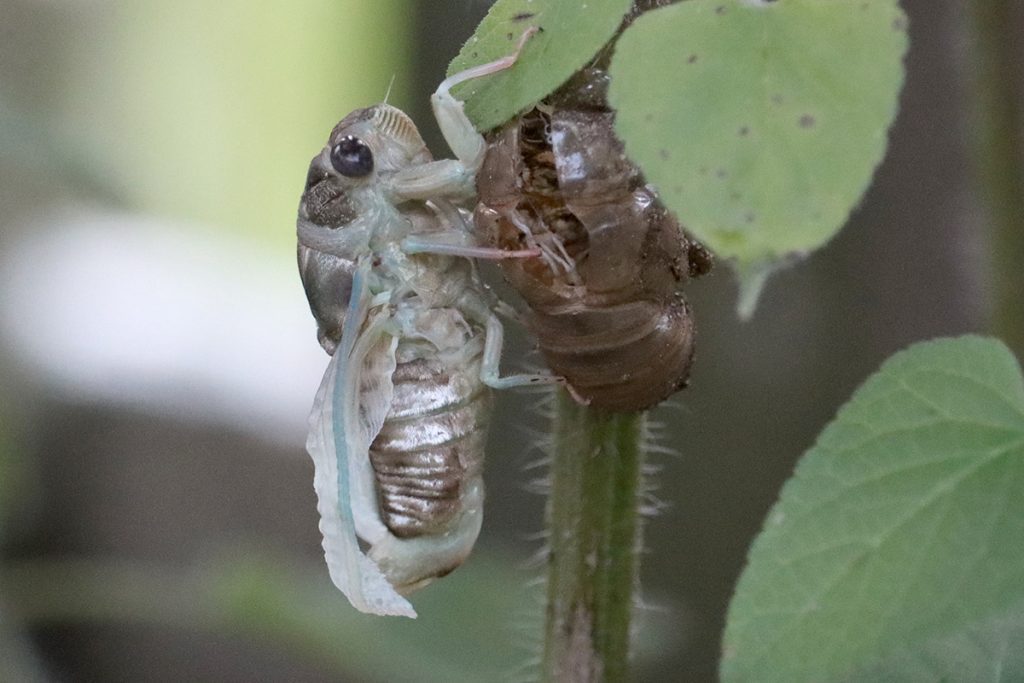
It’ll darken over the next few hours. I’ve spotted two different cicada species in the yard over the last month or so.
Again, we had two monarchs in the yard. The one on the left, on the Brickellia, has those new, flat wings. I see these a lot, and I figure these are those caterpillars that sneak off to make chrysalides. On the right, one with a torn wing feeding on ironweed. This has been common over the last few days- one newly eclosed monarch butterfly and another older one, usually laying eggs. I’ve stopped photographing the egg laying, but it’s happening almost daily.
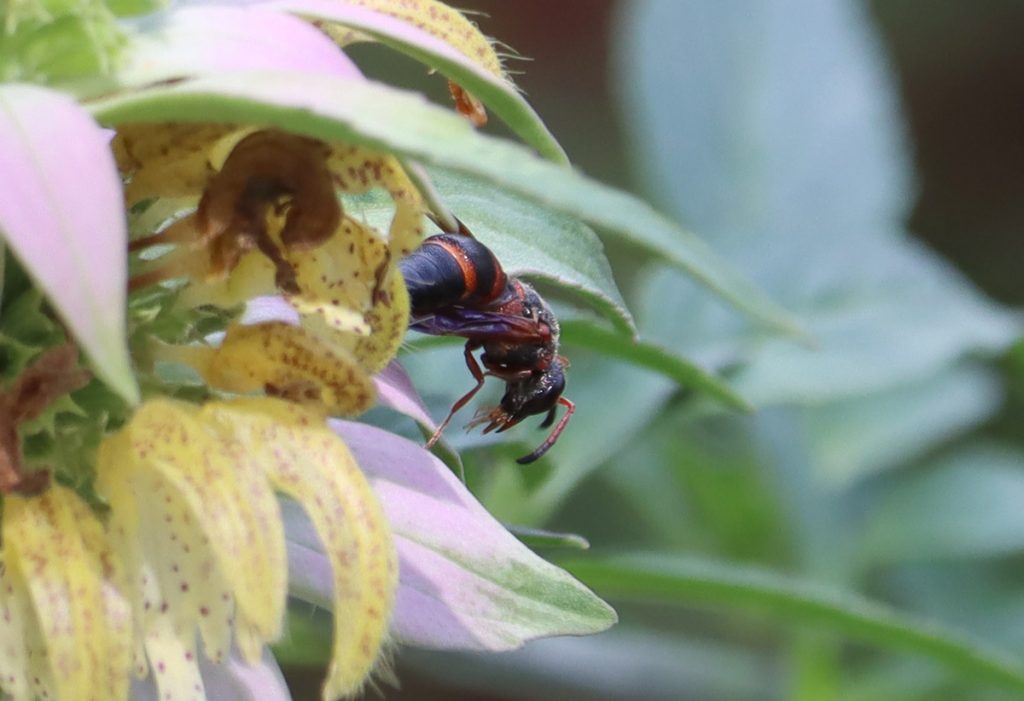
And here’s another red-marked pachodynerus wasp sighting. They may no longer be nesting in the yard, but I’m glad we still have some in the area.
August 15, 2021
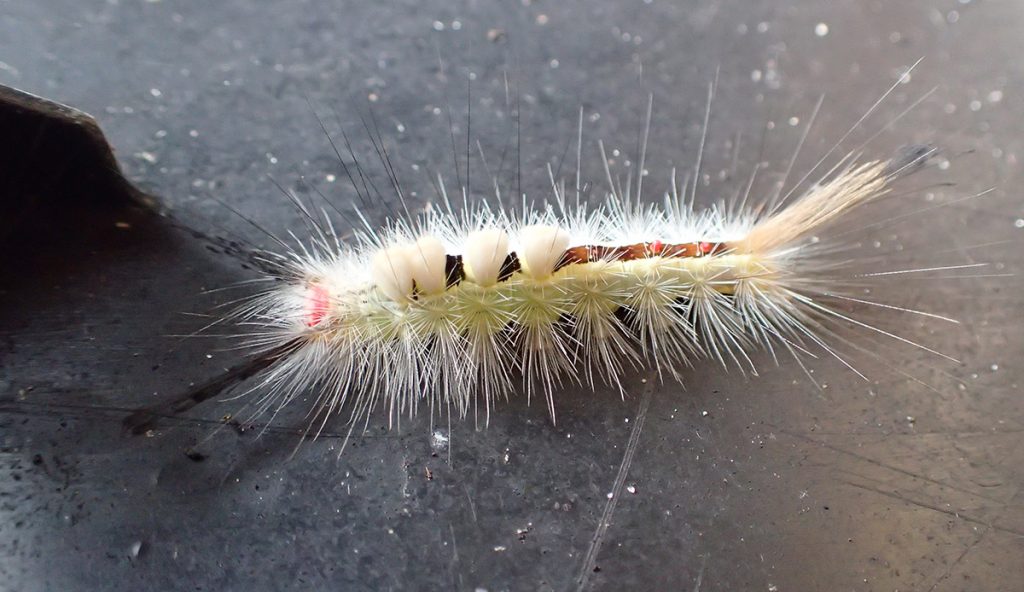
I found this in our compost bin. Another moth caterpillar that hosts on a number of different tree species. Maybe it fell from the Carolina laurel cherry tree whose branches hang over the bin.
August 14, 2021
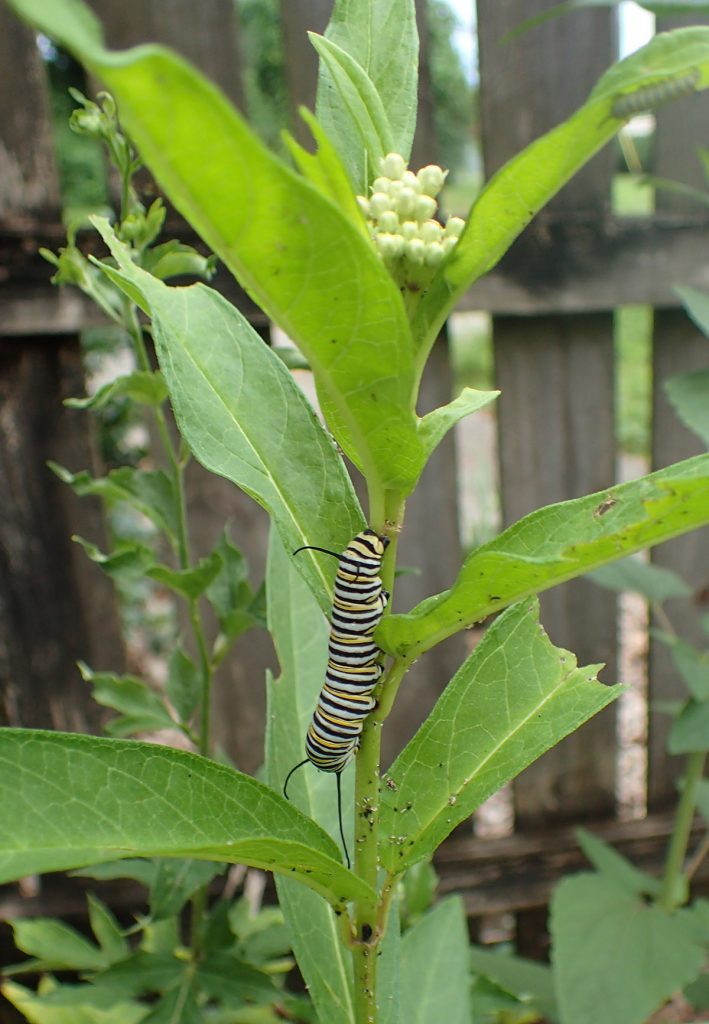
I’m noticing more and more caterpillars of late, which means moths and butterflies are breeding more now. A lot of these insects have two or three broods a year, and so we may be in a late summer surge.
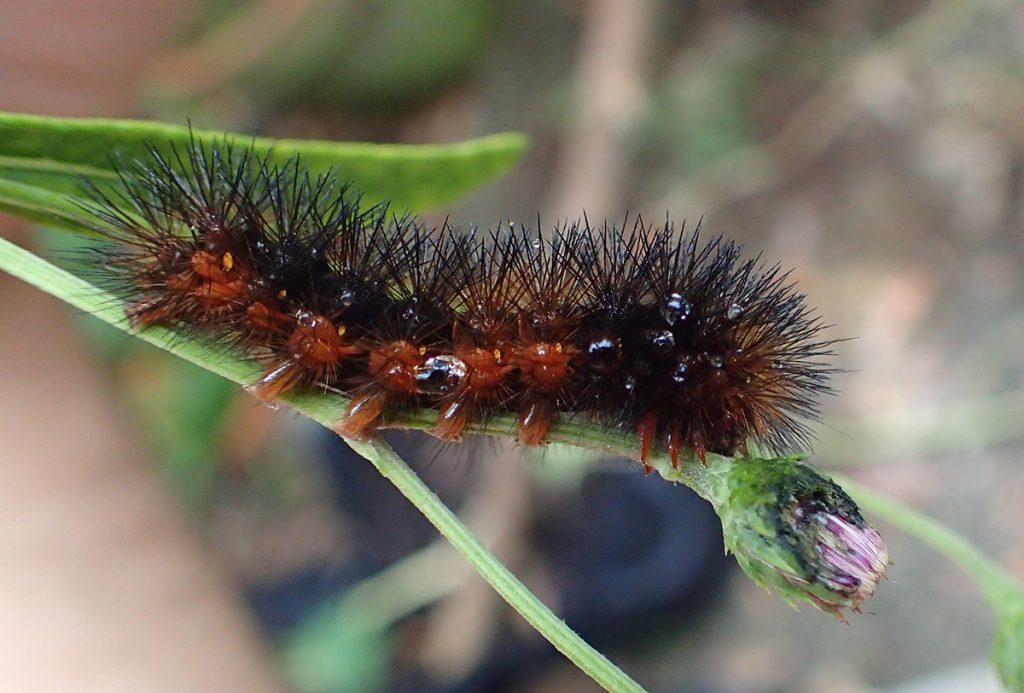
Back in May, we had a giant leopard moth caterpillar host on our ironweed plants. Maybe this is a descendant of that moth. This is an insect that hosts on a few dozen different plants species in different families, so when I see two or more on the same plant over time, I figure that moths and butterflies return to their host plants, or the areas where they hosted.
August 12, 2021
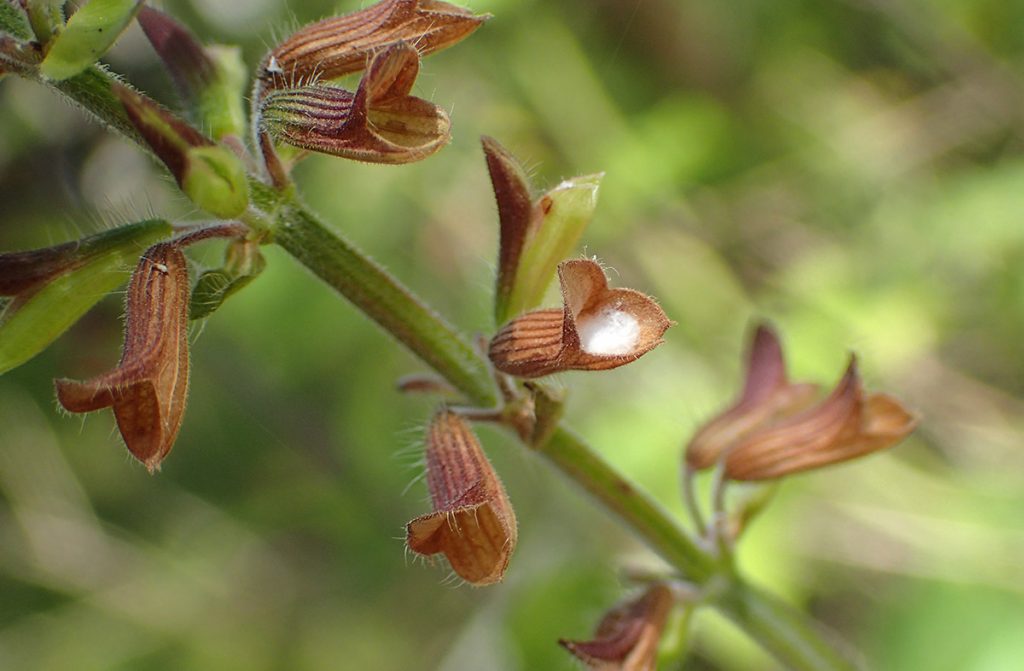
Ecologically, there are reasons to leave wildflowers in place after they’ve died back and/ or gone to seed. Seeds of course feed birds, especially in the winter when insects are less readily available. Some bees and other insects nest in wildflower stalks. I like to leave things messy for parts of the year, and I don’t always deadhead them right away.
Above you can see one reason for this. I’ve been noticing these white fuzzy things in our red salvia (aka scarlet sage) seeds. These will drop, and indeed, scarlet sage is sprouting up all over the yard. It’s a plant that takes care of itself, and is continually growing new flowers. Anyhow, I was curious about what was in these seeds, and I picked a few off of a plant. Some very small insects crawled out and jumped off my hand.
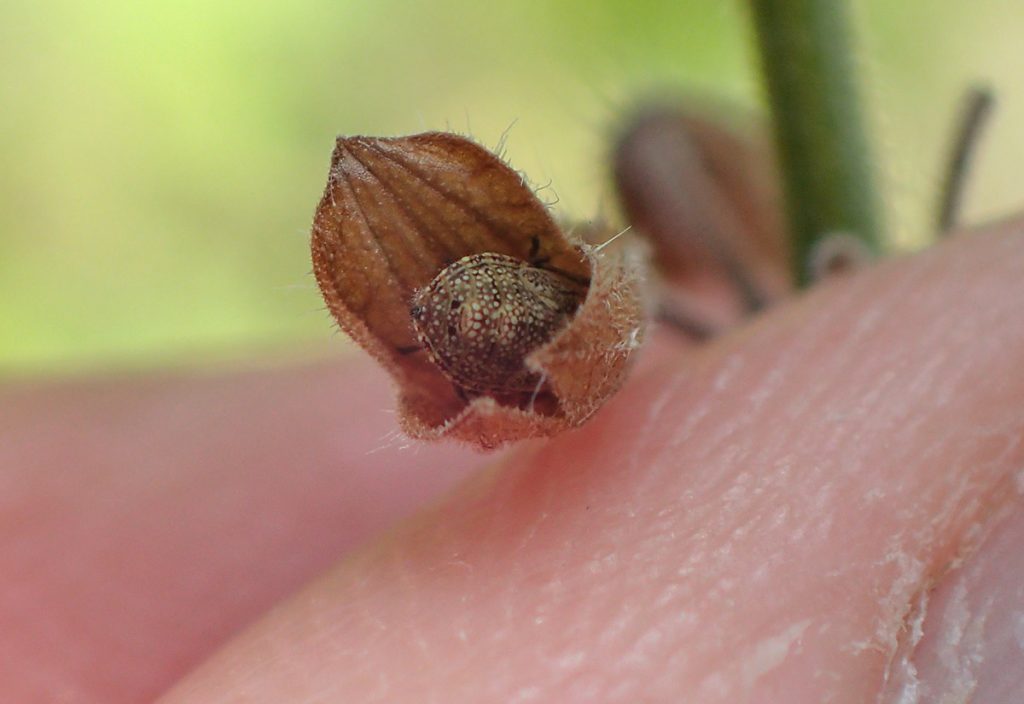
I picked a few more and put them in a pyrex bowl to see if I could get a better look:
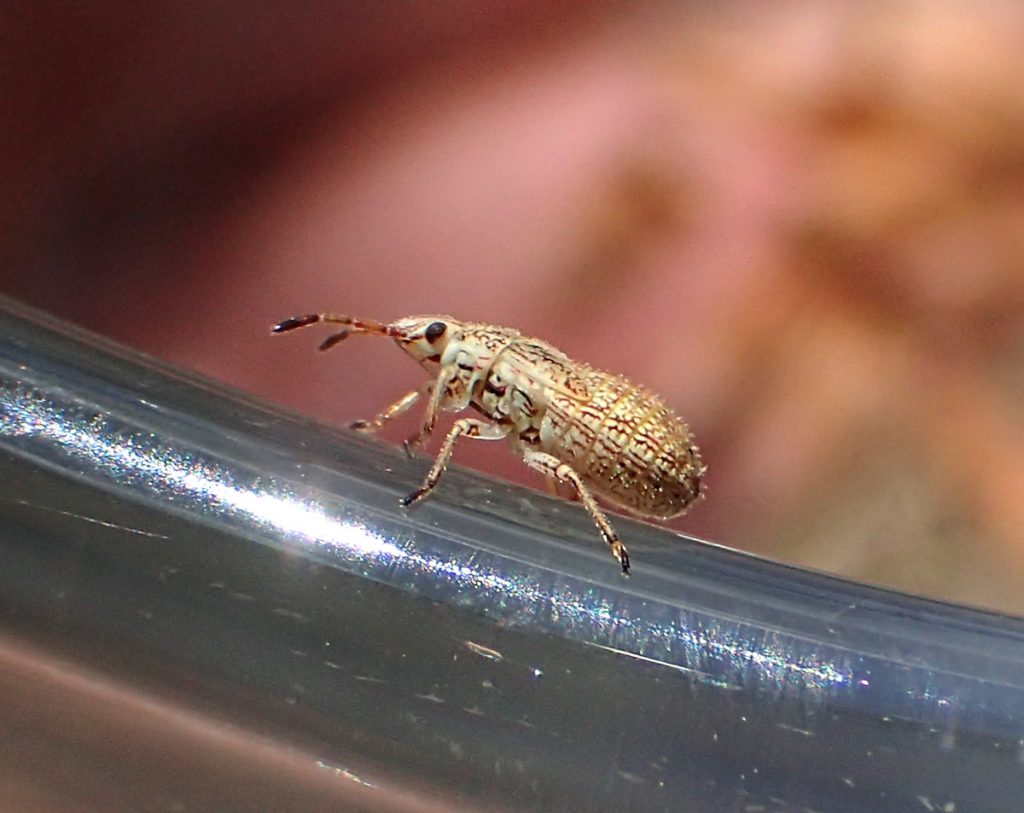
This is a seed bug, which feed on… seeds, yes, seeds! I couldn’t identify it any more closely than that in iNaturalist, and this is a family with over 100 species.
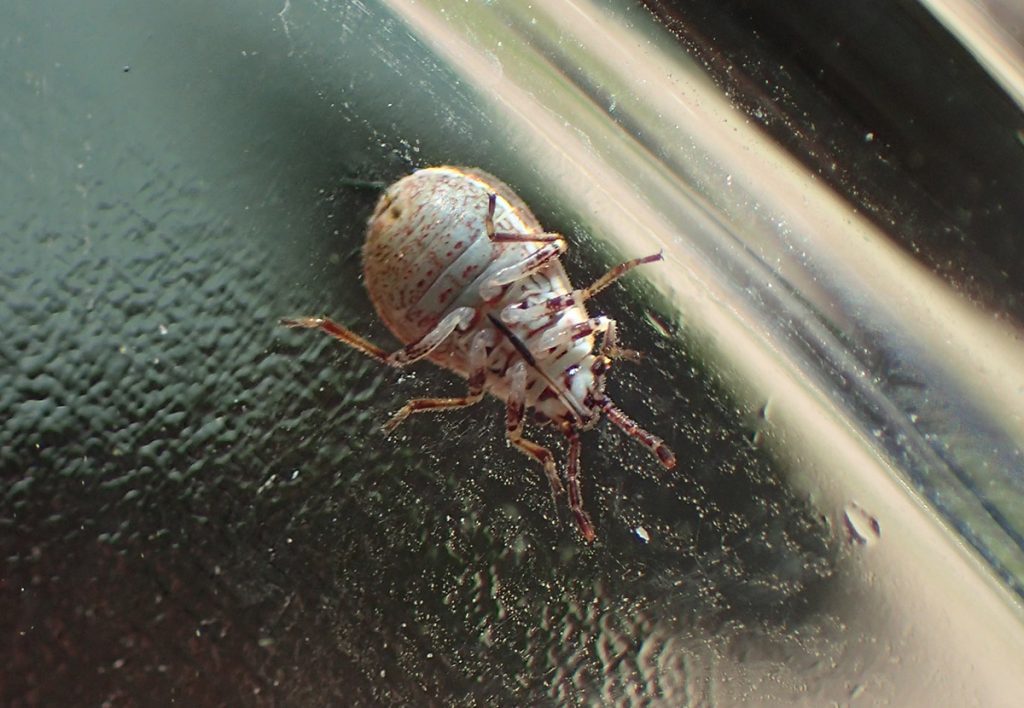
This is why I like putting insects in glass bowls. Here’s a good look at the seed bug’s proboscis, which it uses to eat seeds. So why do I care if we have seed bugs? What do they add to our yard’s ecosystem? Diversity of insect life, which is a diversity of food sources in the backyard food web.
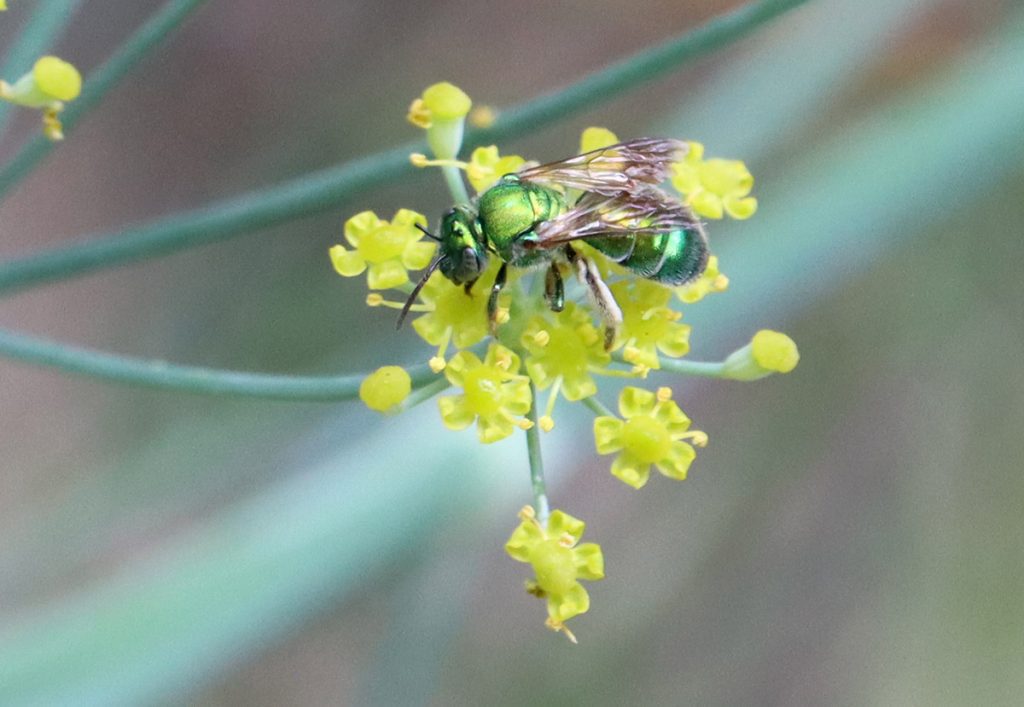
I love when pollinators take an interest in the Apiaceae (carrot family) flowers, which I think look so cool.
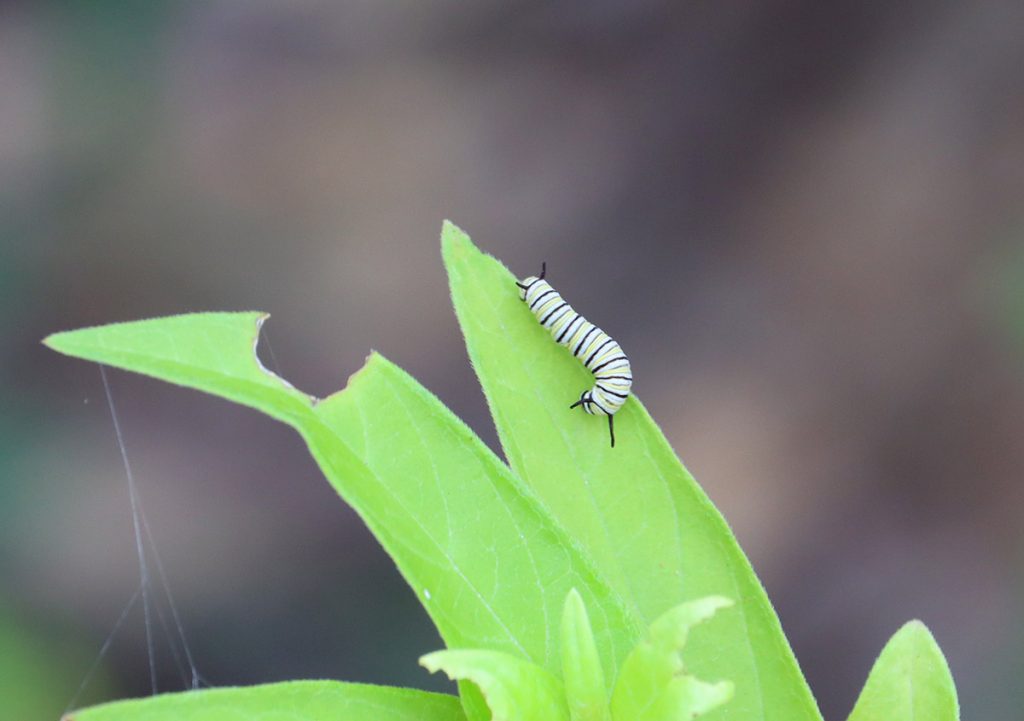
Unsurprisingly, after days of monarchs carpet bombing the milkweed, we have caterpillars of various sizes.
August 11, 2021
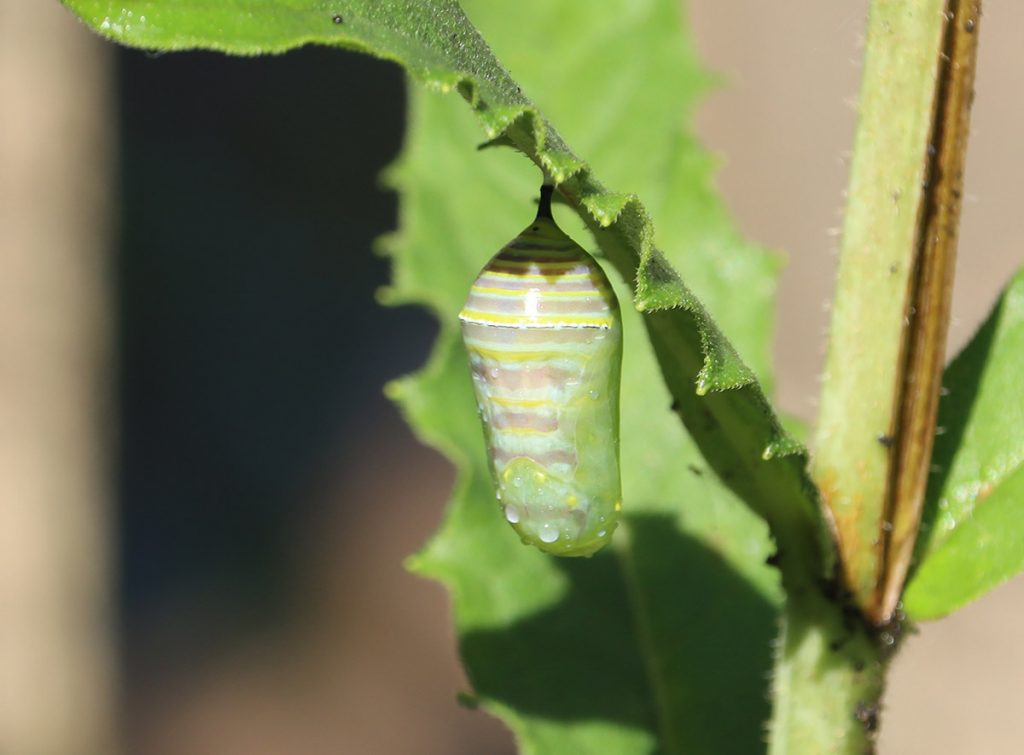
When I went out to water the plants this morning, this chrysalis was still bouncing around. I must just have missed it. I’ve never seen the stripes show on a chrysalis like this. Maybe because it’s in full sunlight? It did eventually turn a solid green.
August 10, 2021
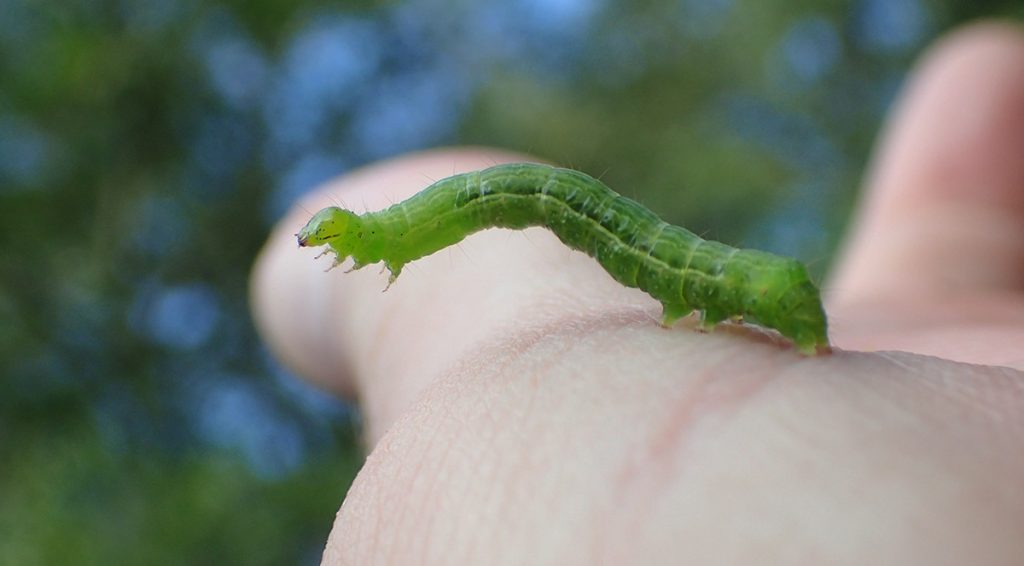
I was clipping cilantro from the garden, when I noticed one of the plants looked a little chewed up. While separating the leaves from the stalk, this nicely camouflaged caterpillar fell out. This looks like a cabbage looper, which, despite its common name, feeds on many plants. I found a spot outside to leave it, out in the open and far from the cilantro. There are plenty of wasps looking to feed hungry larvae this time of year.
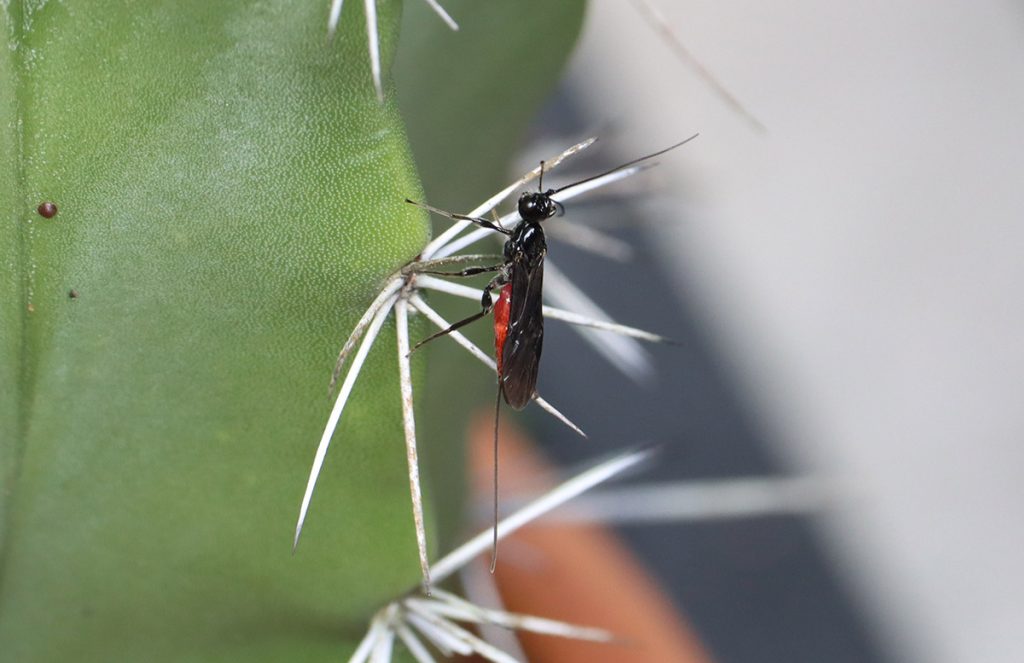
I’ve been seeing this species flying around the yard lately. Brachonids are parasitoid breeders, most typically of Lepidoptera (butterflies and moths) or beetles.
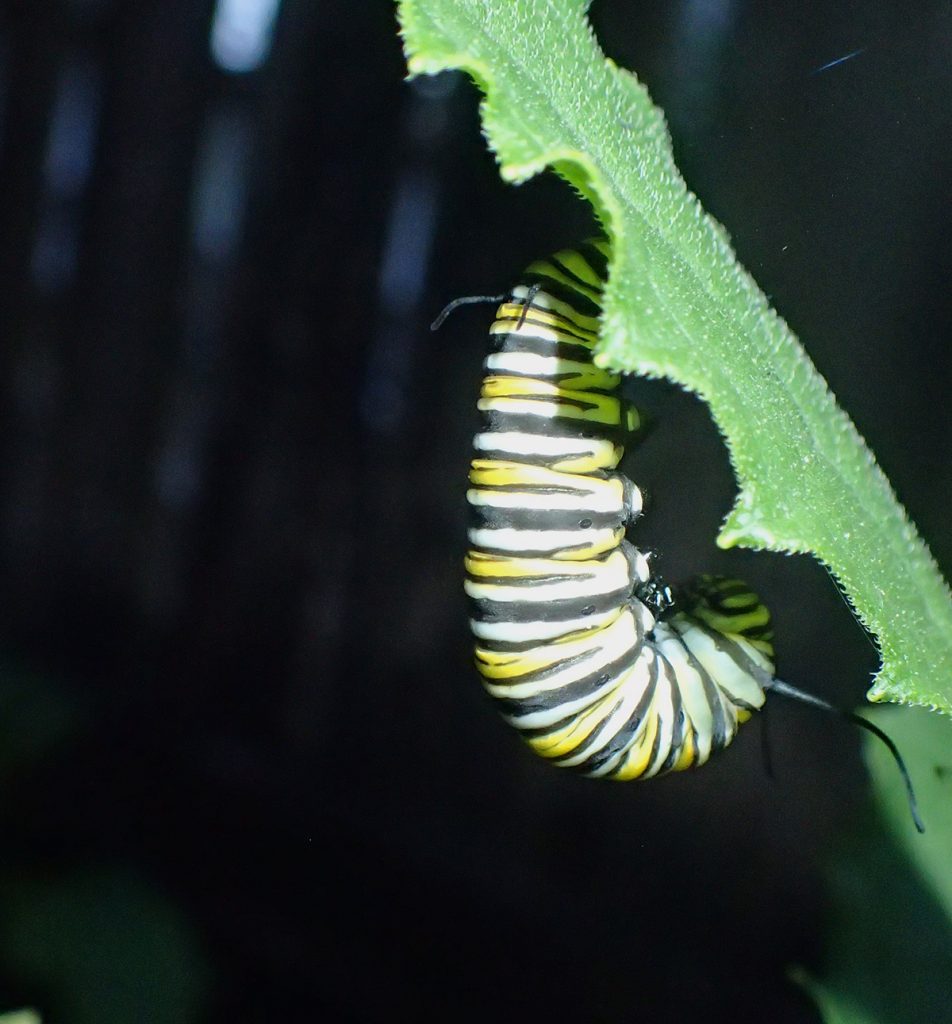
We often eat a popsicle desert outside after dinner. Tonight, we spotted this monarch getting ready to make its chrysalis. This has become a rare sight in the yard, as monarchs have been crawling off and hiding their chrysalides.
August 9, 2021
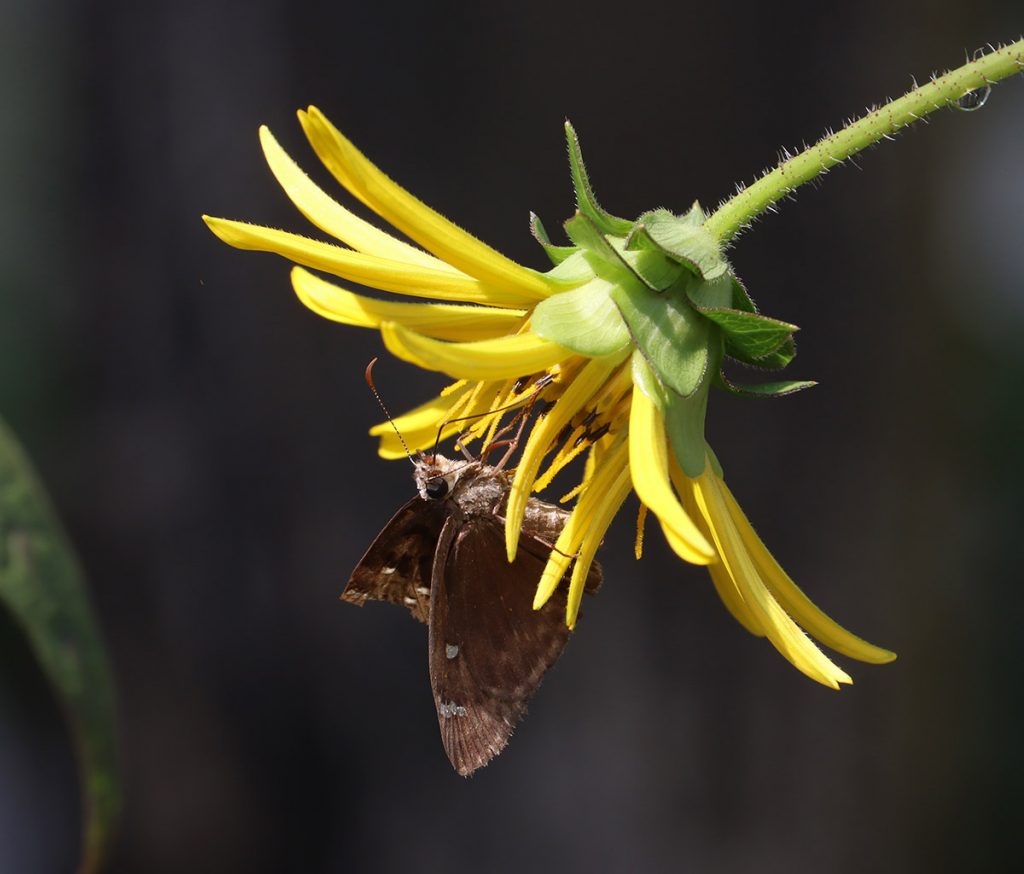
Some flowers in our yard seem to grow more slowly than where I see them elsewhere. Over the course of the year, I’ve watched this rosinweed leaf out, grow tall, and now, finally bloom. I’ve seen brown-winged striped sweat bees on here, and now this duskywing.
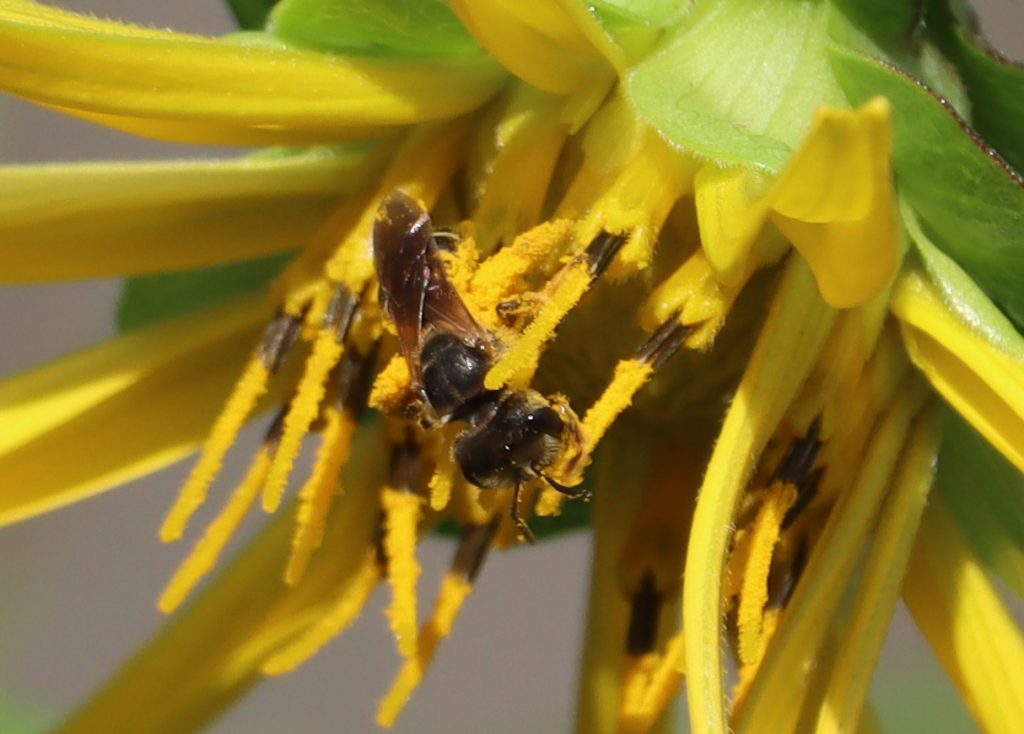
Look at how pollen-covered this furrow bee is.
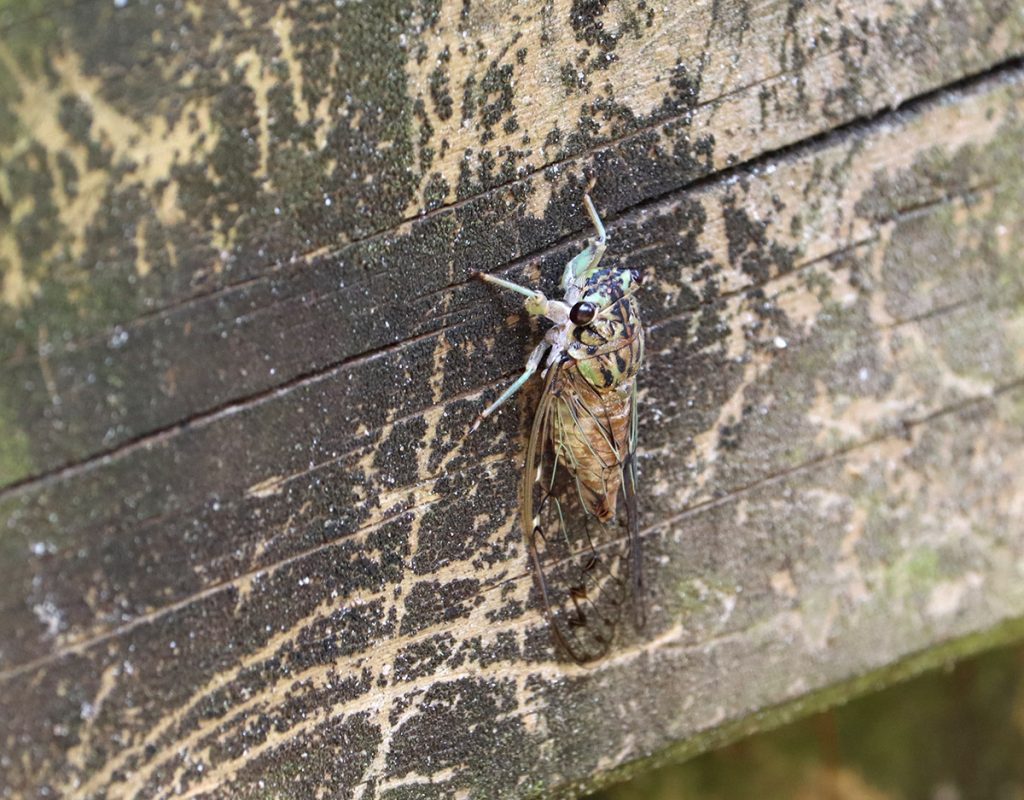
This is the second cicada species I’ve seen in the yard over the last couple of weeks. It’s not far from where I saw a cicada exuvia (molted shell) a month or so ago.
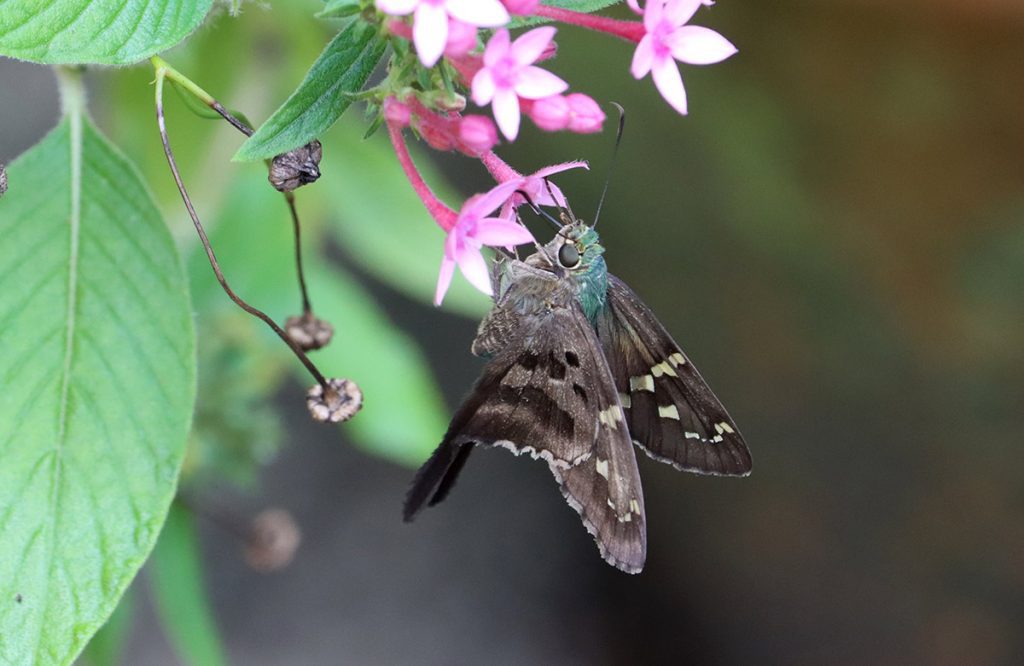
Another common species for our yard in other years, that hasn’t been so common this year. I’ve started seeing the butterfly consistently in the yard now, but still haven’t seen any signs of its caterpillars on our pea plants.
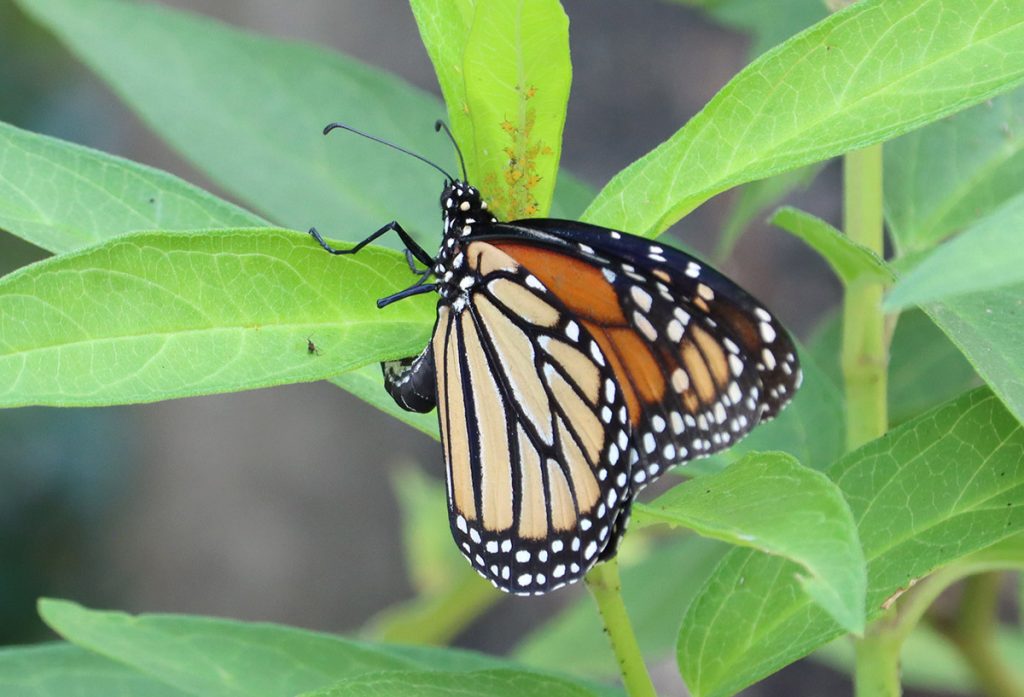
I don’t know if this is a different monarch, or just the same one from yesterday laying eggs. It won’t be the last to lay eggs in our yard in August.
August 8, 2021
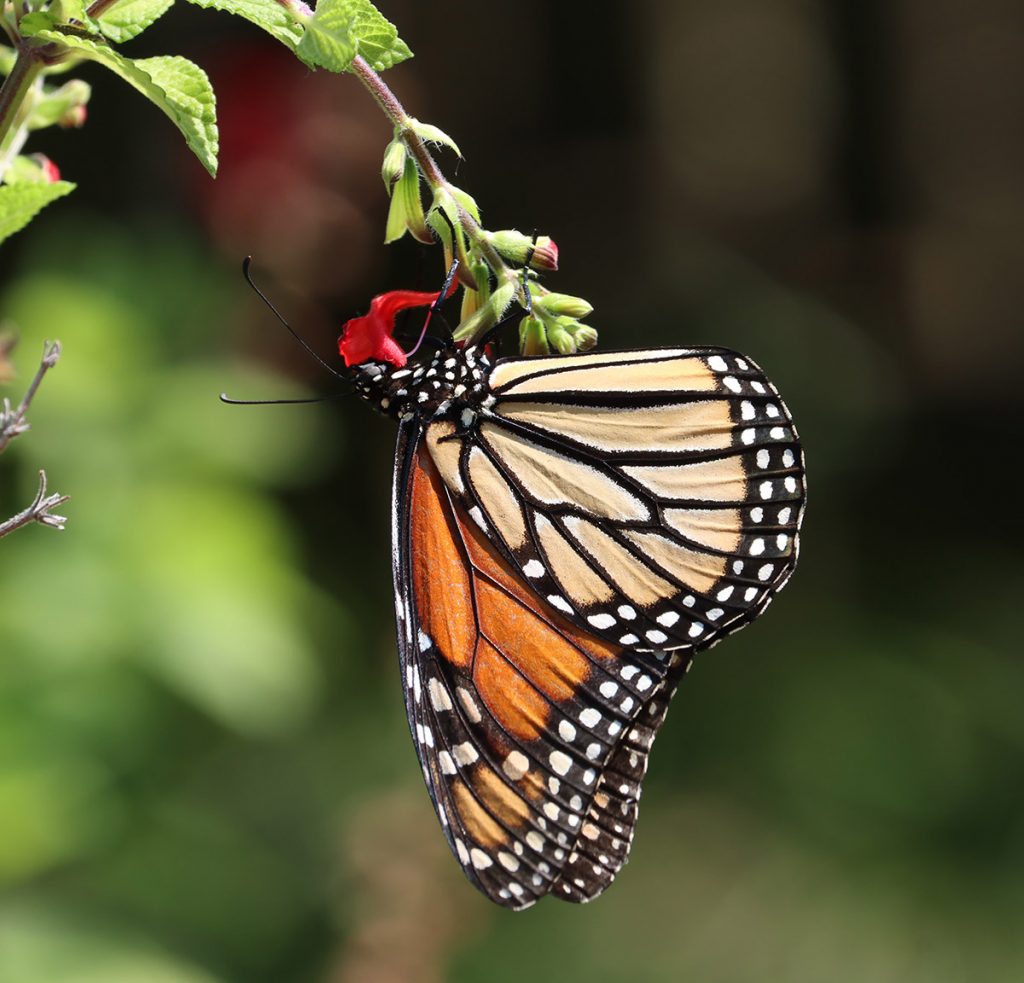
This monarch visited several flowers over the course of the day. Notice the perfect flatness of the wings. I think this is a new butterfly gathering nectar before migrating north. A second, more worn butterfly also visited the yard:
I’m not sure I’ve witnessed a monarch lay so many eggs. I spent a little while following it, and then it met up with the other one:
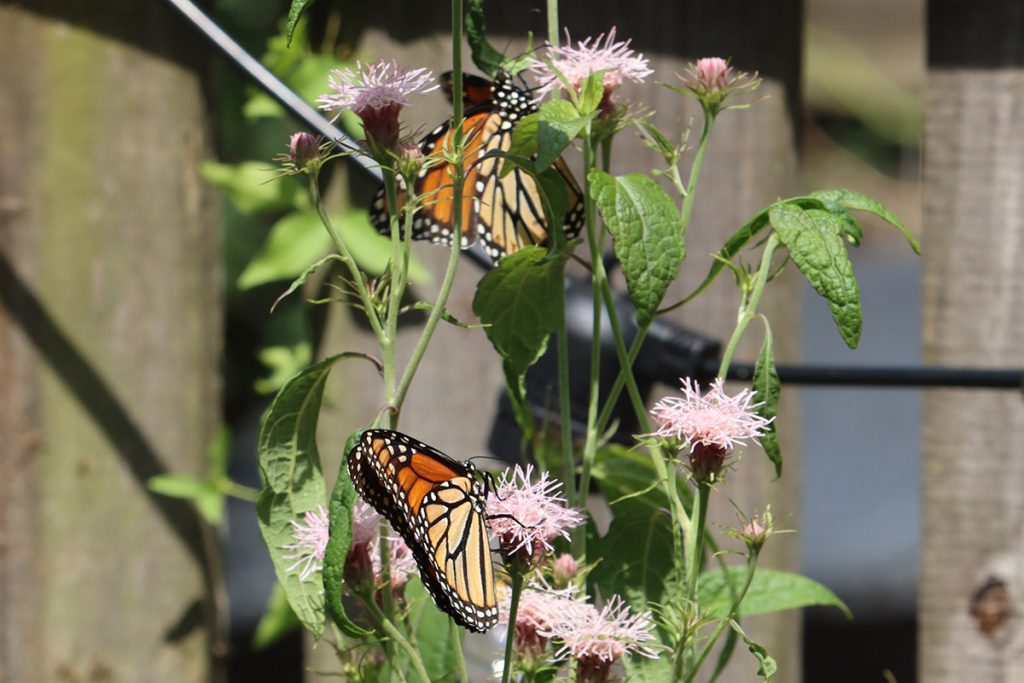
The egg laying mother seemed to be trying to get the attention of the other. Would it be trying to mate even while carrying eggs? The other butterfly wasn’t interested, and momma went back to its ovipositing.
Brickellia is one of our late summer blooming plants, as is this one:
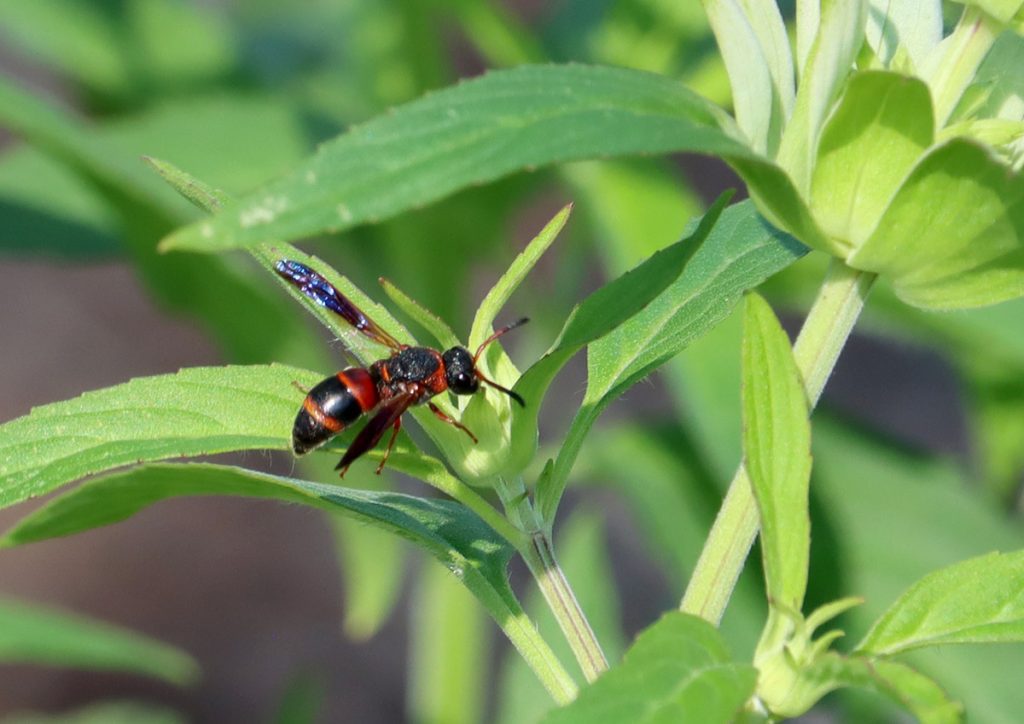
The beebalm, aka dotted horsemint, is starting to bloom. It’s usually popular with wasp species. This wasp species had once been about the most common in our yard. They were numerous, and had nests in our bee nesting box as well as a couple of other locations. I saw one by the nesting box in January and then- they were gone. What changed in our yard?
Needless to say, I was happy to see this one.
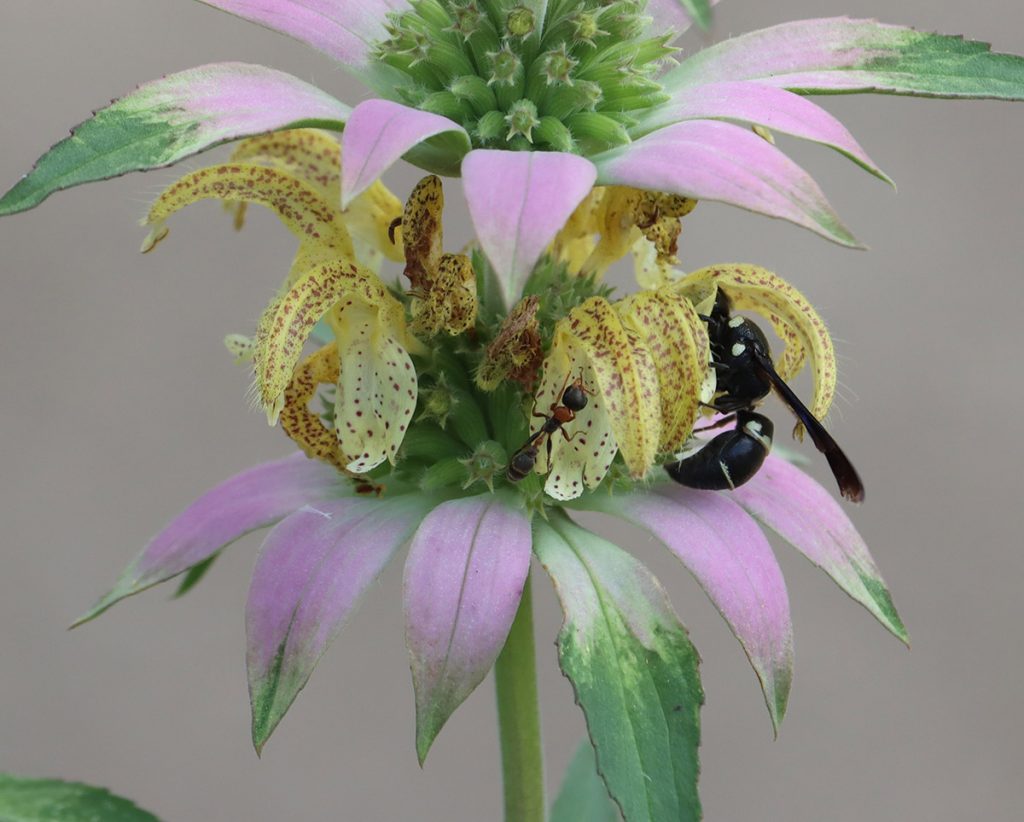
Here’s another mason wasp species, along with an ant. I think this is one is in the Euodynerus genus, which includes several species in our area.
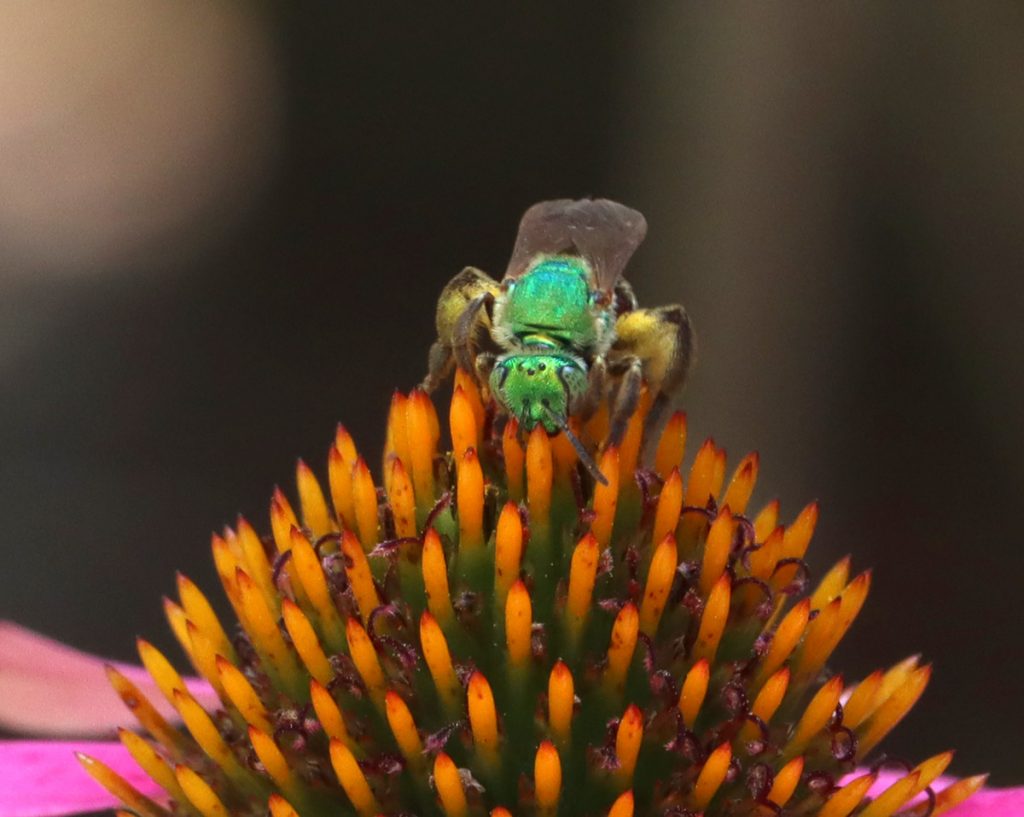
Still seeing a handful of these females, and no males. It has been a different kind of year this year, so maybe they’re on a different schedule?
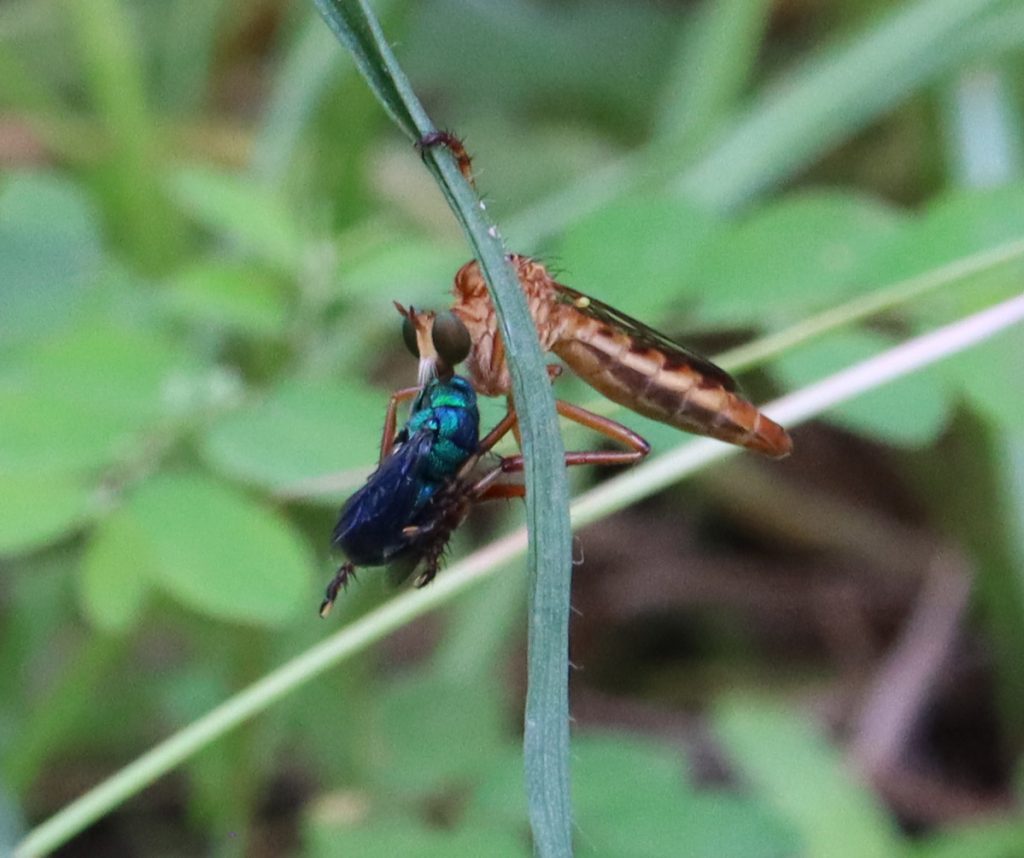
This is next to that flower patch, but the blueness of the wings makes me think maybe it’s a cuckoo wasp? It flew off before I could get another photo. Notice the hanging thief’s leg holding on to the leaf above it.
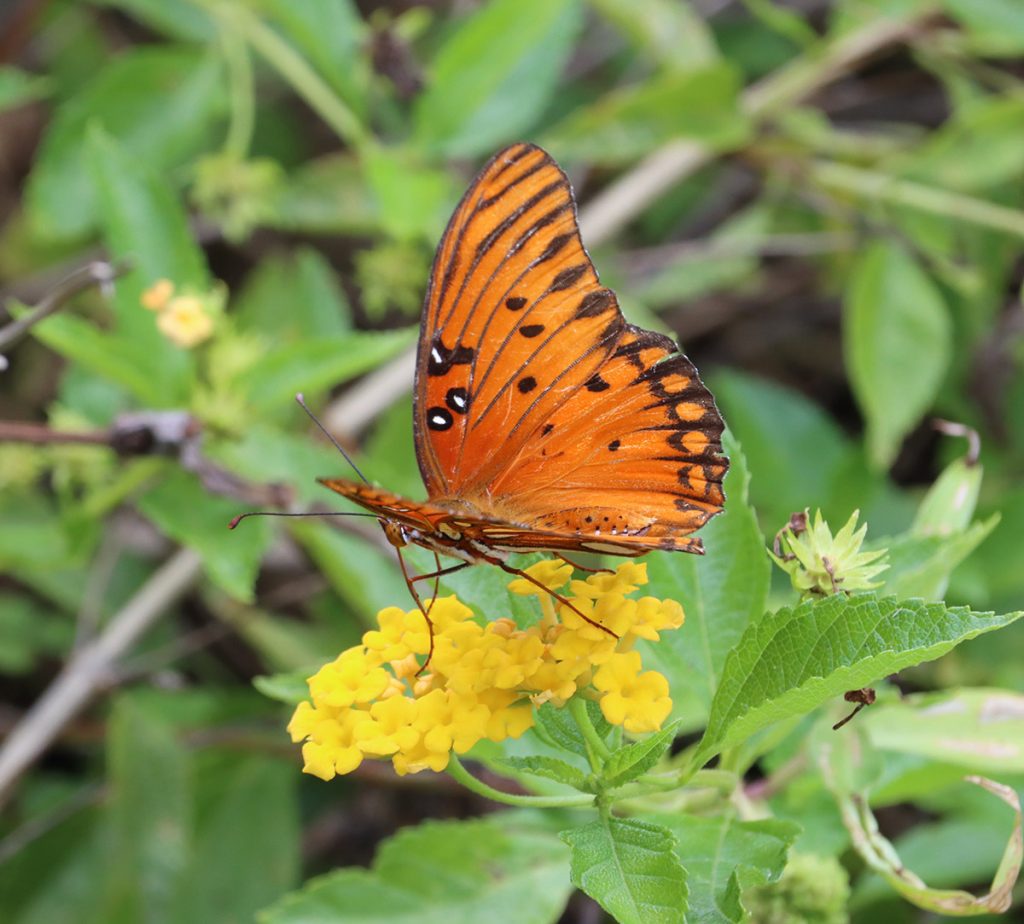
The lantana lost its blooms when it got rainy earlier in the summer. Despite its many flowers previously, we hadn’t seen nearly as many butterflies as in other years. Now it’s blooming again, and we’re seeing butterflies as well.
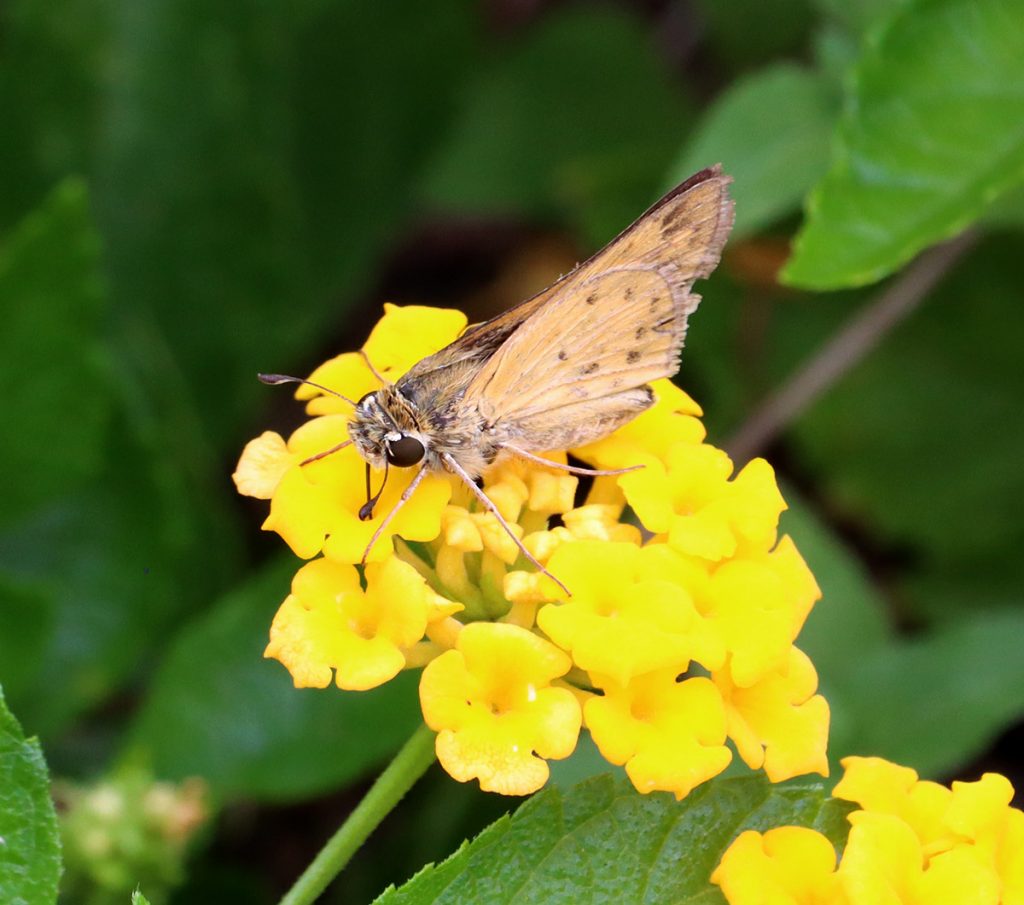
August 6, 2021
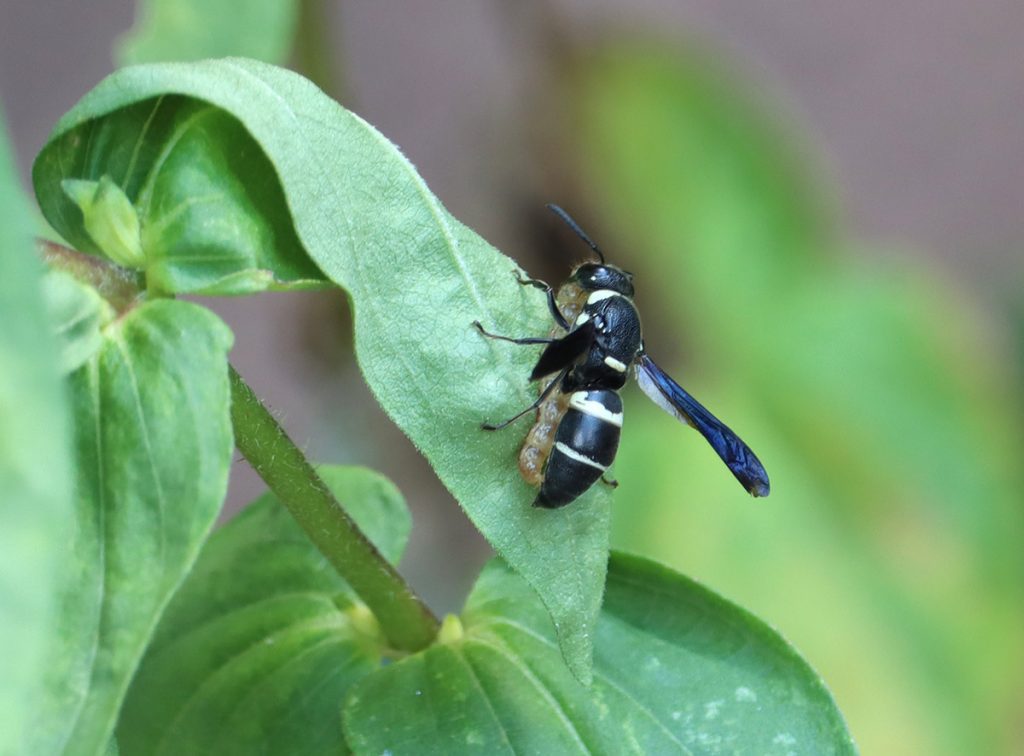
Whenever I see wasps fly under leaves to take a look, working their way plant by plant, I figure there’s a brood of hungry larvae home waiting for a meal. This is a pollinating wasp that feeds insects to its larvae. I’ve been seeing four-tooth masons inspecting my pepper and tomato plants, and here, it has caught something. Nice work!
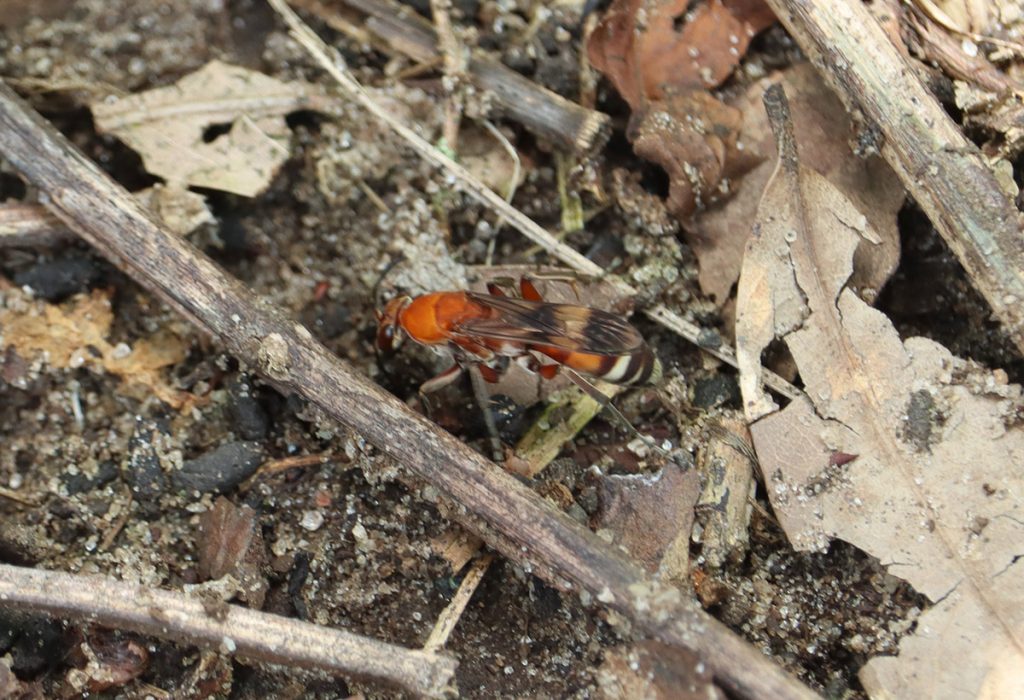
I saw something orange running on the ground, which turned out to be this wasp. Whenever wasps are running instead of flying, it’s worth paying attention. I thought it might be a digger wasp looking to make a nest. Instead, this is a spider wasp, likely hunting spiders.
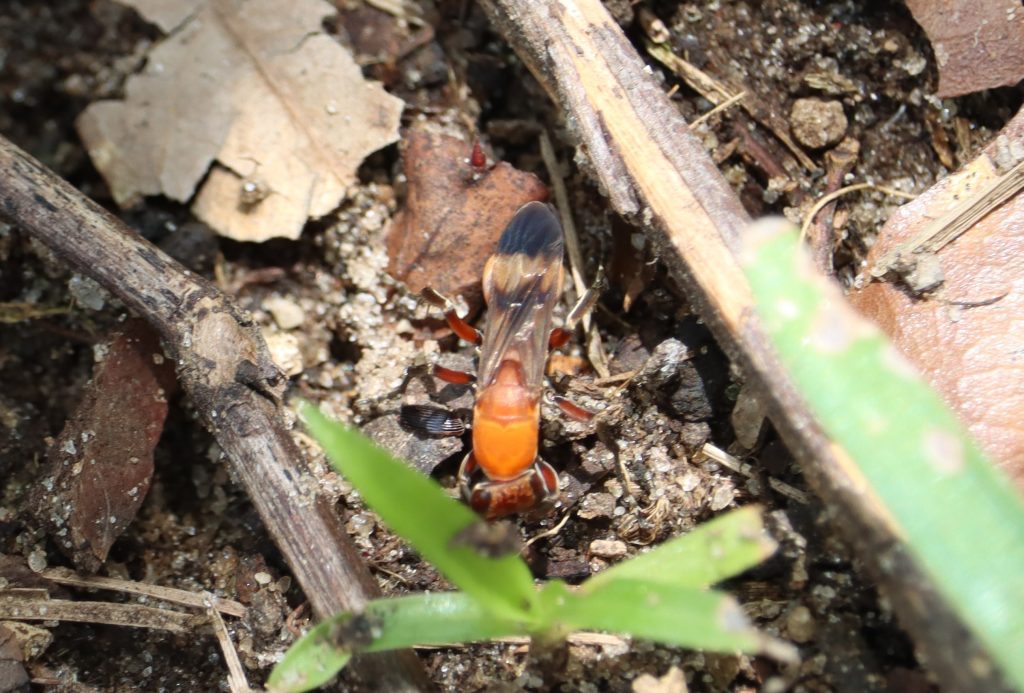
This was one of four photos I included in my iNaturalist observation for this wasp. Another user sent me a message about this photo because of that small black insect part on the left side of its body, below its legs. He said this was a beetle wing, and that trapdoor spiders trap insects near the “retreat entrance” of their abode, eating them and then tossing the remains out of their “trapdoor entrance.” He was asking if I saw the wasp dig in and enter, the trapdoor spider being one of its hosts.
Spider wasps paralyze and lay eggs in the spider. Its larvae then consume the spider. In this case, the wasp ran off and continued to seek its host. I had never heard of spider wasps before identifying three species while shooting video of devil’s walkingstick. This is a fourth, different species.
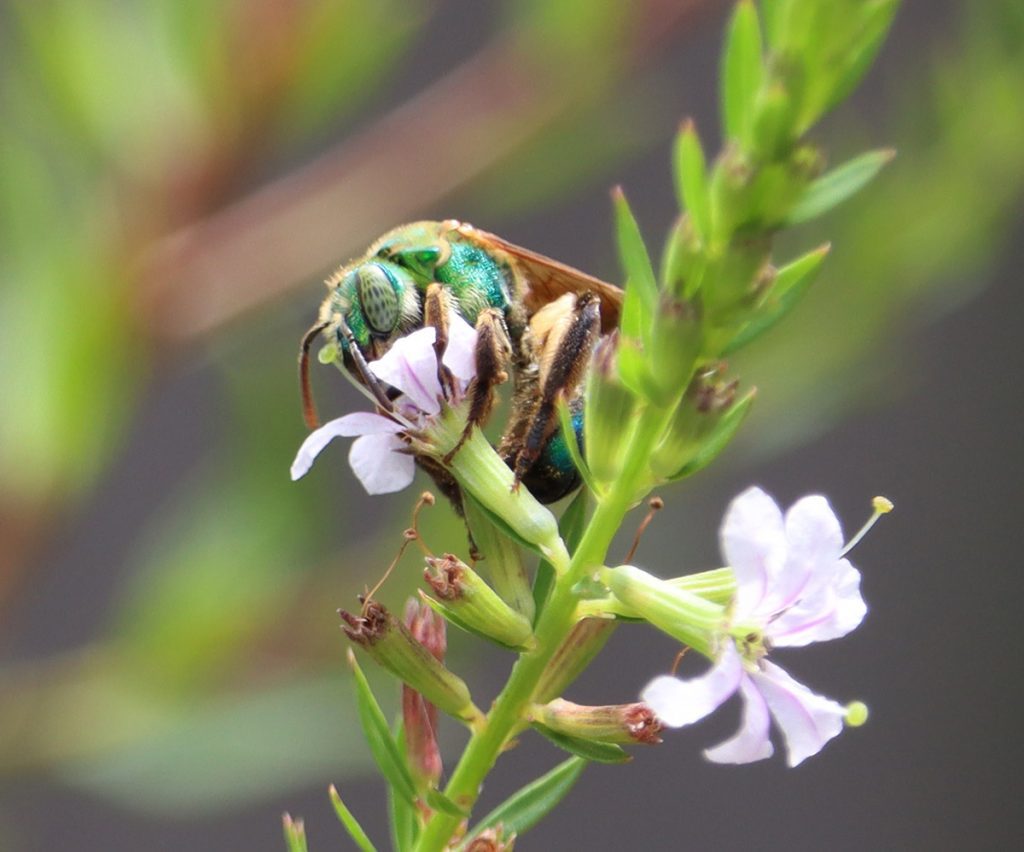
I had been seeing one female brown-winged striped sweat bee female in this patch, and lately we’ve had two or three at a time. Still no males though, which usually explode in our yard in August.
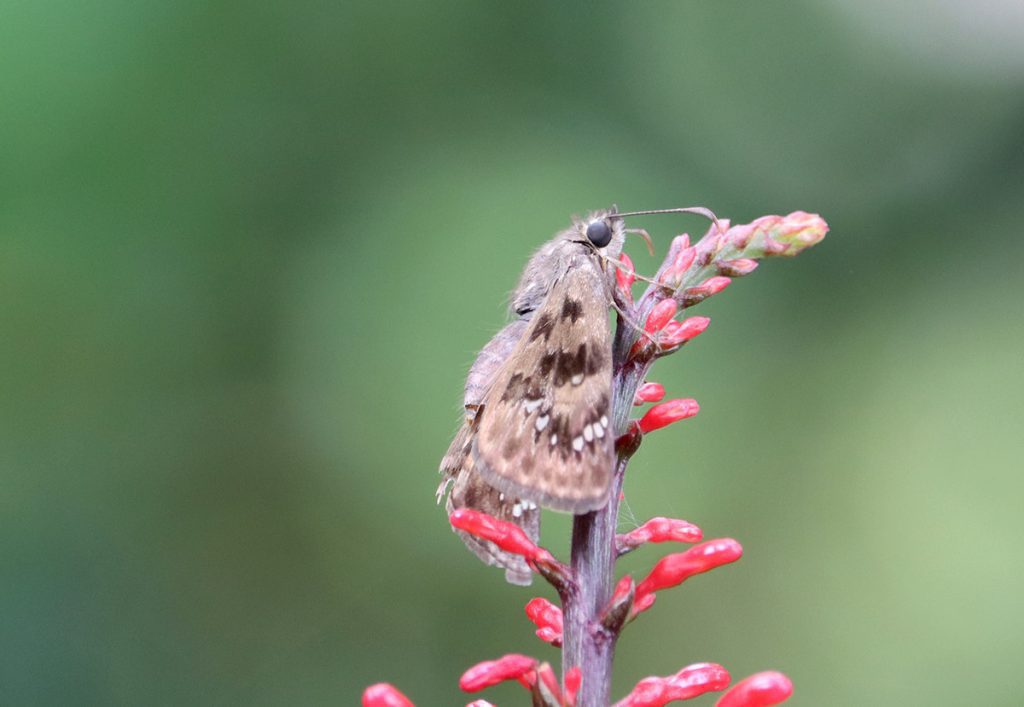
Here’s a common visitor in our yard, which hung out on this flower for over a day. Cardinal guard blooms from late summer through early fall, and in our yard is popular with hummingbirds and zebra longwing butterflies.
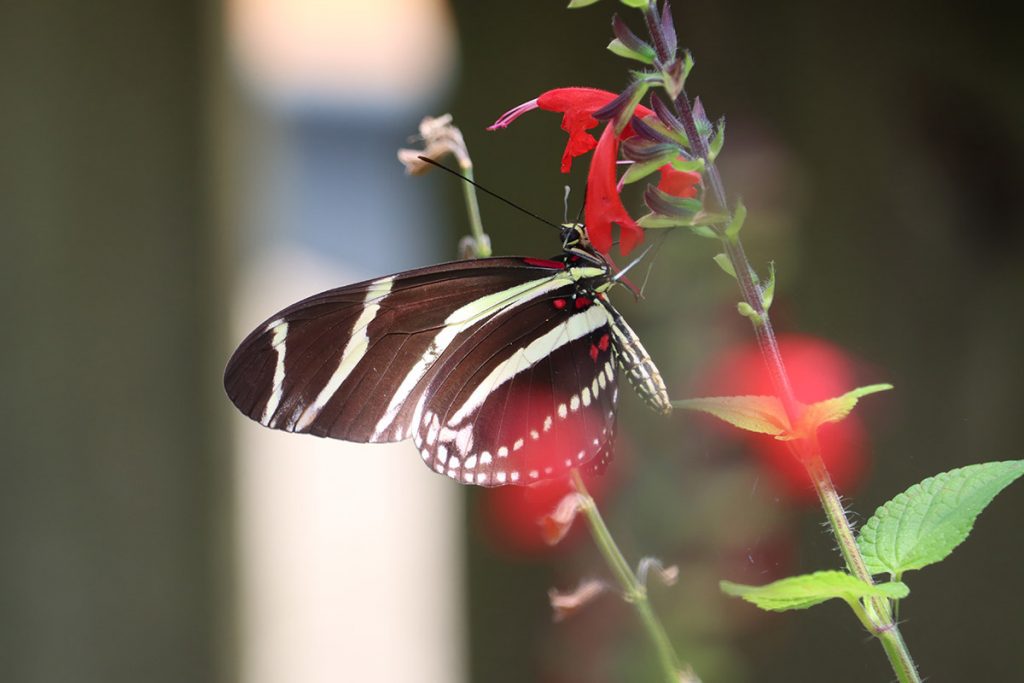
Zebra longwings have become a regular sight in the yard after having been absent much of the year. Perhaps it’s the cardinal guard blooming. Maybe their numbers were low after the winter and now they’ve had a brood or two to get numbers up.
Some of our flowers go through cycles where a plant has abundant blooms which either get worn out by pollinators, or by a combination of long hot dry spells followed by heavy rains. After a week or two of sparse blooms, these plants have rebounded and have been visited by a variety of native sweat bees.
August 5, 2021
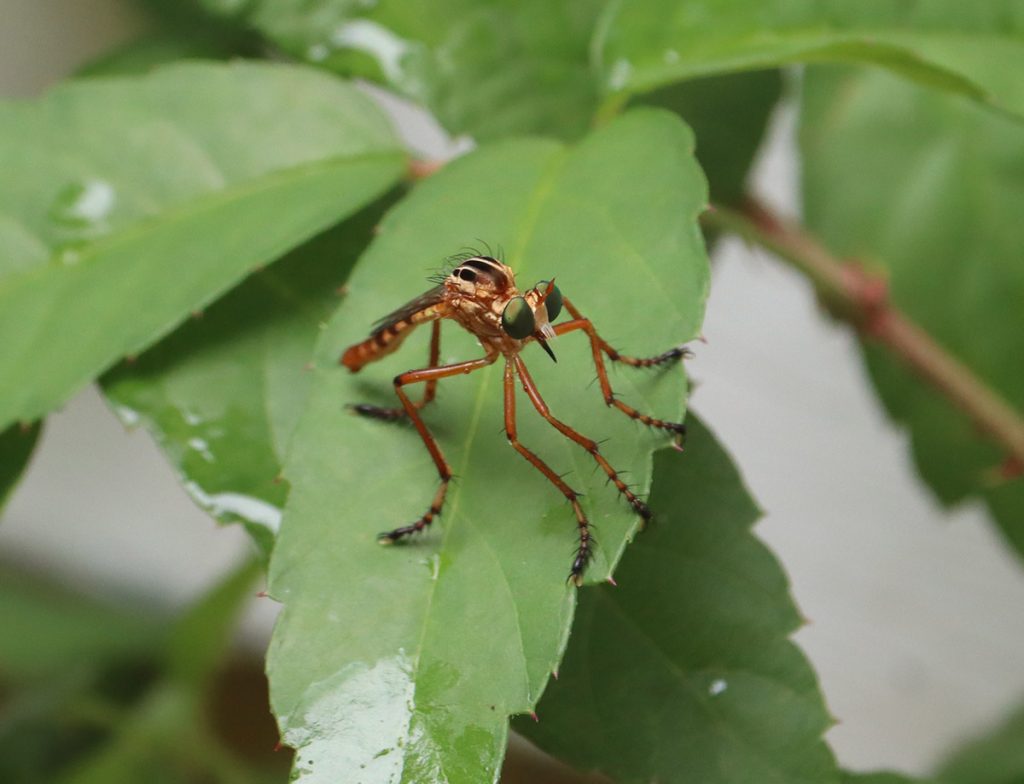
This is the robber fly I’ve seen in the yard over the last couple of years, the hanging thief. I had seen a second species a month or two ago, so we have a little diversity, which I like.
August 4, 2021
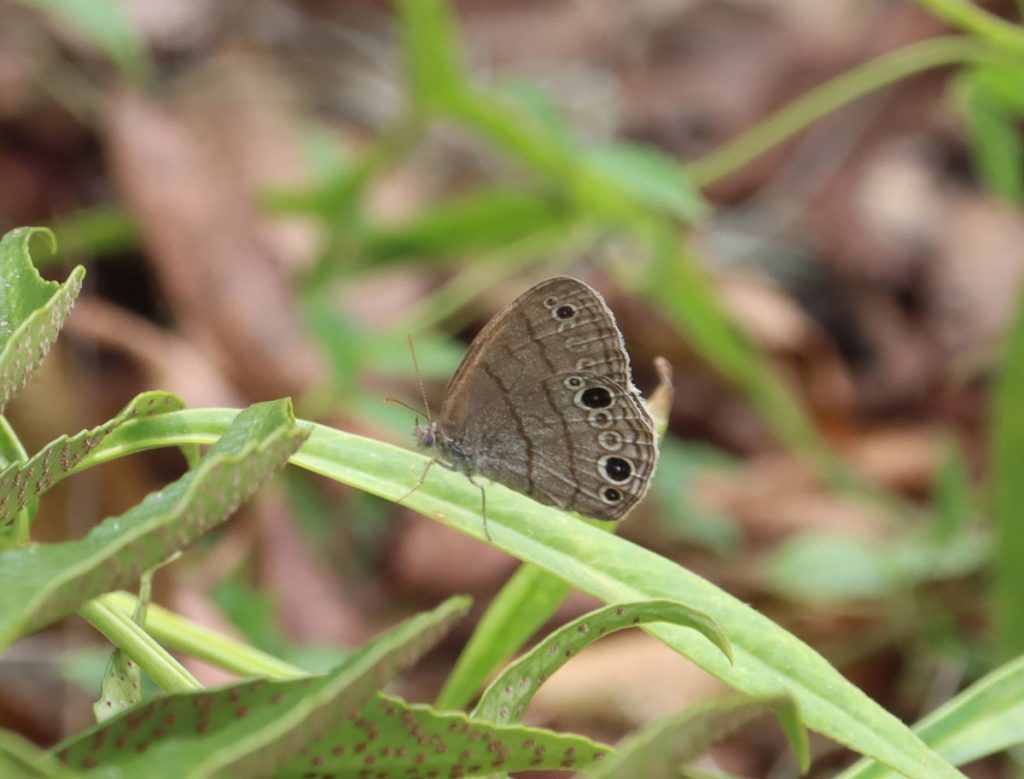
I’ve been seeing this little butterfly in the undergrowth of our flower beds. I feel like I often see it in shadier spots. Looking at the seasonality graph on iNaturalist, the Carolina satyr’s two peak times are in April and August, so this might be our area’s second brood of the year.
August 2, 2021
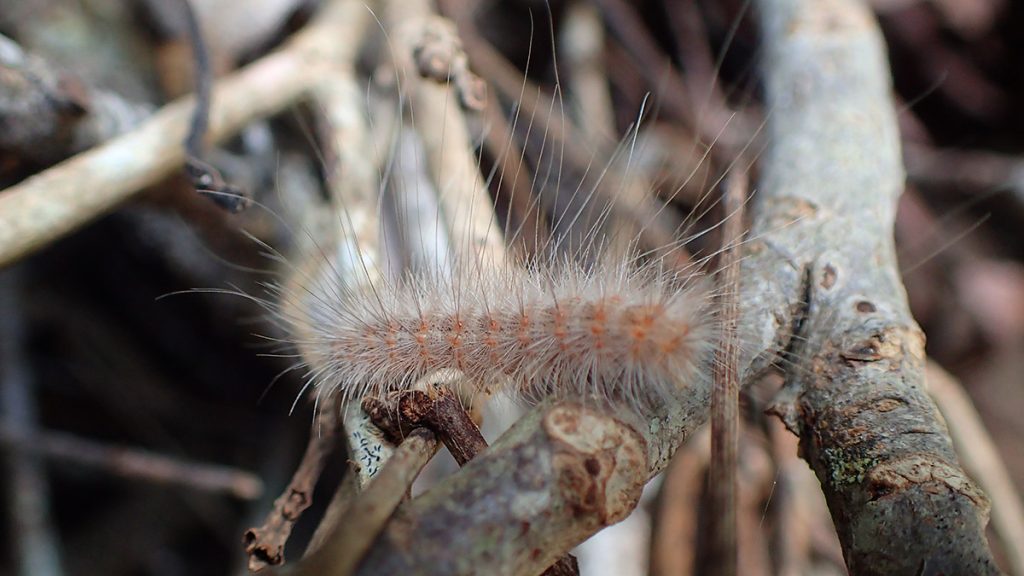
This caterpillar was roaming the brush pile. Webworms spend their early instars together in a cluster, enclosed by a web. When they’re larger, they break out and do a little more eating before finding a place to metamorphose.
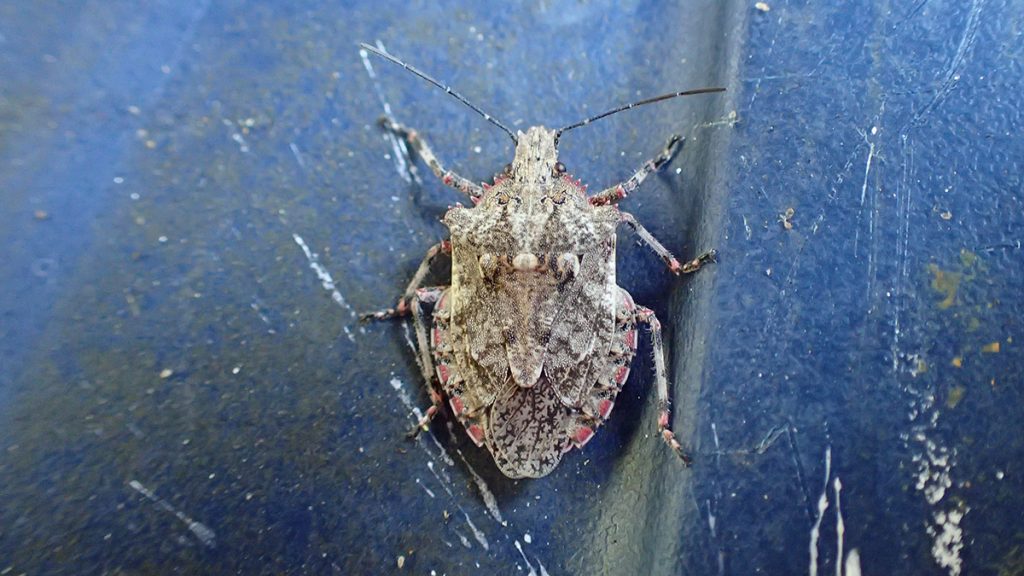
Here’s a good look at a stinkbug species I’ve see in the yard over the years. I know stinkbugs are hard to love for a number of reasons, but I think this one looks cool.
July 31, 2021
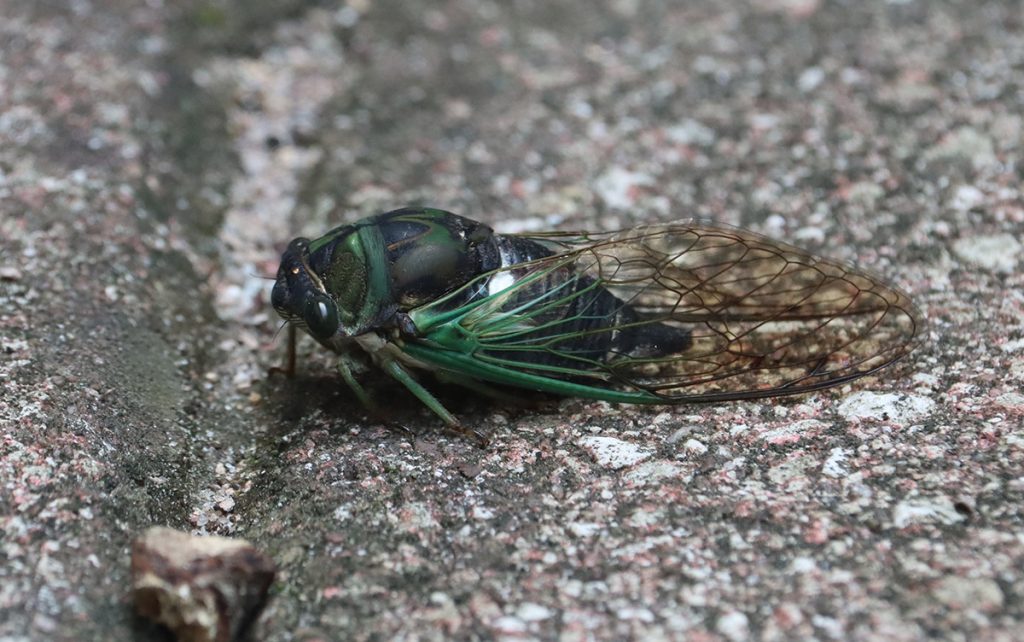
I walked into the side yard and a skink hurried away, and there was another sound that drew my ear. This cicada kept taking off and landing, finally coming to a rest so that I may photograph it. I brought the photos into iNaturalist and this is in the Neotibicen genus, though several of its species found locally look too much alike for me to make a more specific ID.
July 29, 2021
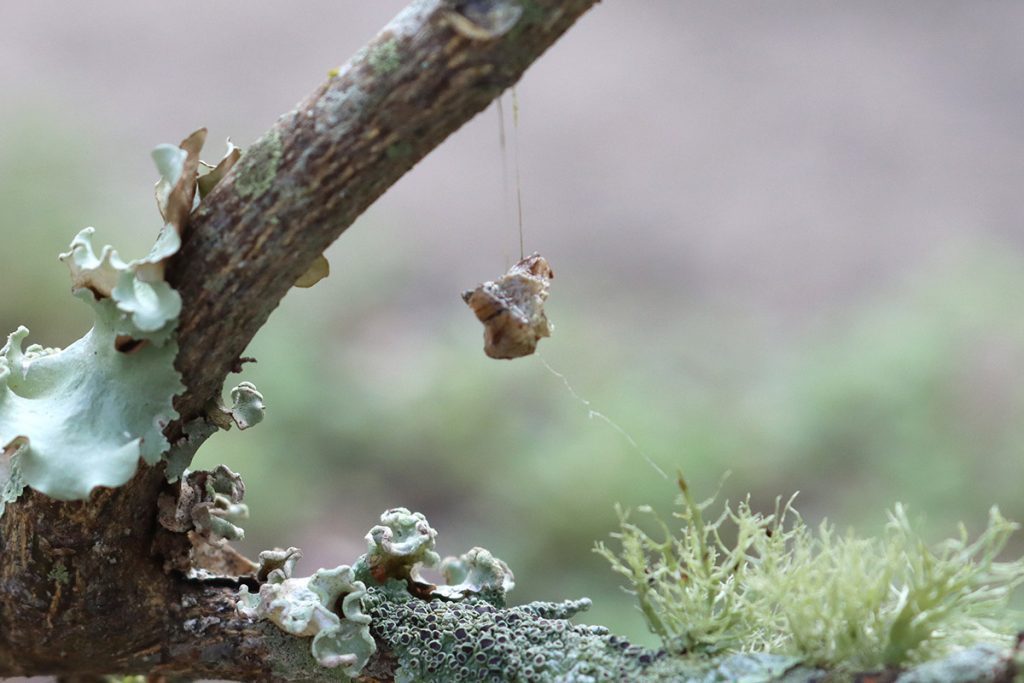
I went out early, with camera in hand, hoping to see the giant swallowtails make chrysalises in the early morning, like monarchs often do. This- this was difficult to see. This is a caterpillar that doesn’t often get eaten in the yard. They have multiple defenses and can handle themselves.
But at some point they have to stop moving, and leave themselves vulnerable long enough to make a chrysalis. The chrysalis has a papery, wooden kind of texture. In the past, I’ve had difficulty finding them day after day on this plant; they blend in.
I think about a lot of things I write on the Backyard Blog. We have many insect predators , which is a sign of ecological health. July has been a banner months for them. I’ve written about letting caterpillars do their own thing, and that those best at surviving pass on their genes. That it’s good in the long run, though right now I feel like I’d rather have put them in the enclosure.
I also think about how previous giant swallowtails, and monarchs, have left to make chrysalises I’ve never seen. Is this the positive trait these butterflies pass on, to hide themselves while vulnerable this way?
That’s the way it is. These caterpillars became a part of the food web; sometimes we lose the ones we like. Every heartbreak in the yard is followed by a new creature visiting, or an amazing new behavioral observation. That’s the story nature’s writing, that I’m transcribing for you here.
July 28, 2021
After noticing our two giant swallowtails have made their “J”s, I keep popping out with a camera and tripod to get footage of the chrysalis making. Then I looked it up on Google- they could be like this for days. Still, I keep checking.
It’s been a few years since I’ve seen a chrysalis on the tree. Like our monarchs, they’ve gotten good at hiding. At least I think they are. I have no idea whether they’ve successfully found a spot and survived the journey there. But I keep seeing the adults, so it’s a possibility.
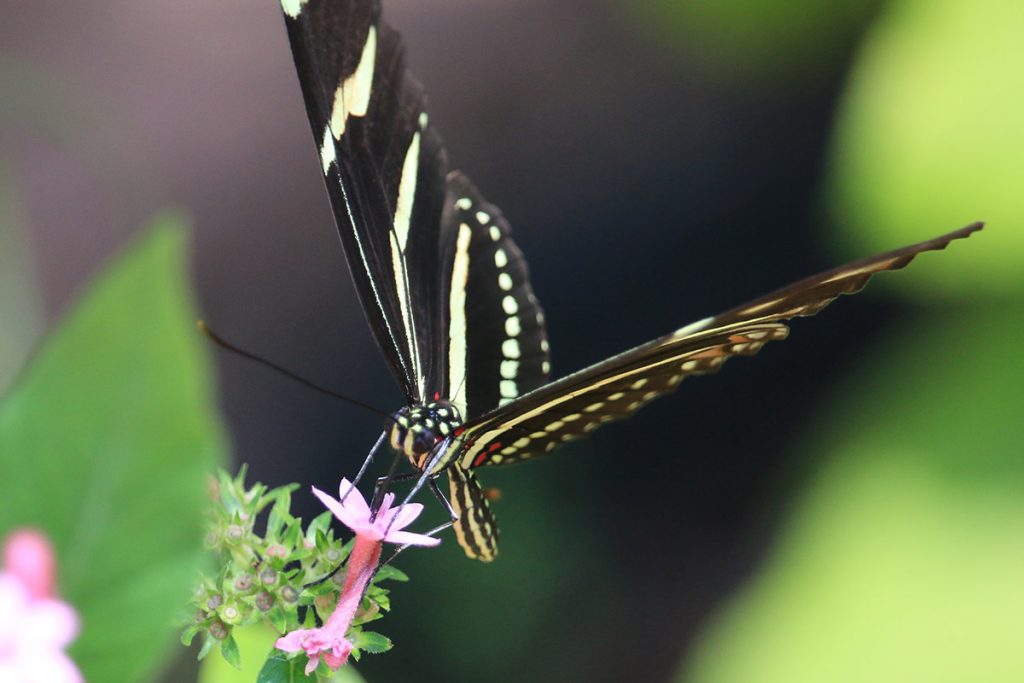
I’ve seen zebra longwings pass through the yard a time or two in 2021, and one other time on a flower. But this is the first I’ve been able to photograph of one. Like I said a few days ago when talking about gulf fritillaries- passionvine (larval food for both species) is in my future.
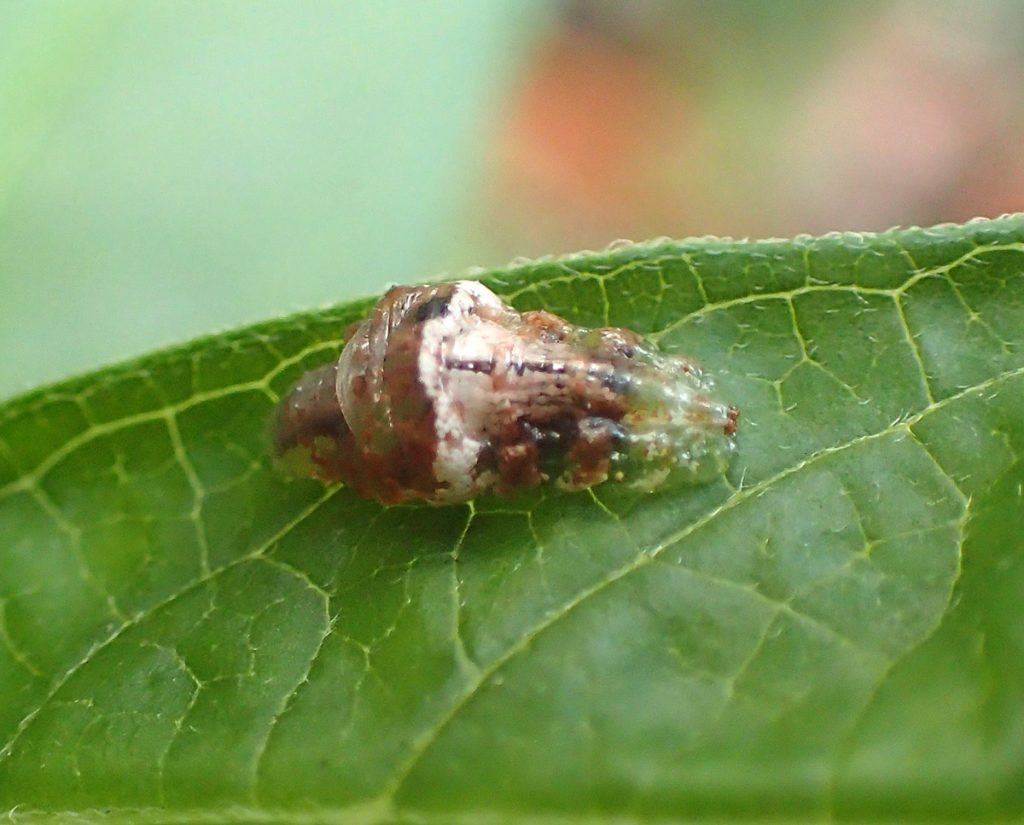
These are common in the yard, and have been active throughout 2021 as in every other year. But this one is in good light, so here, again, is the hoverfly- aka syrphid- larva, on milkweed. They eat aphids, and the adults are pollinators. Double thumbs-up insect.
July 26, 2021
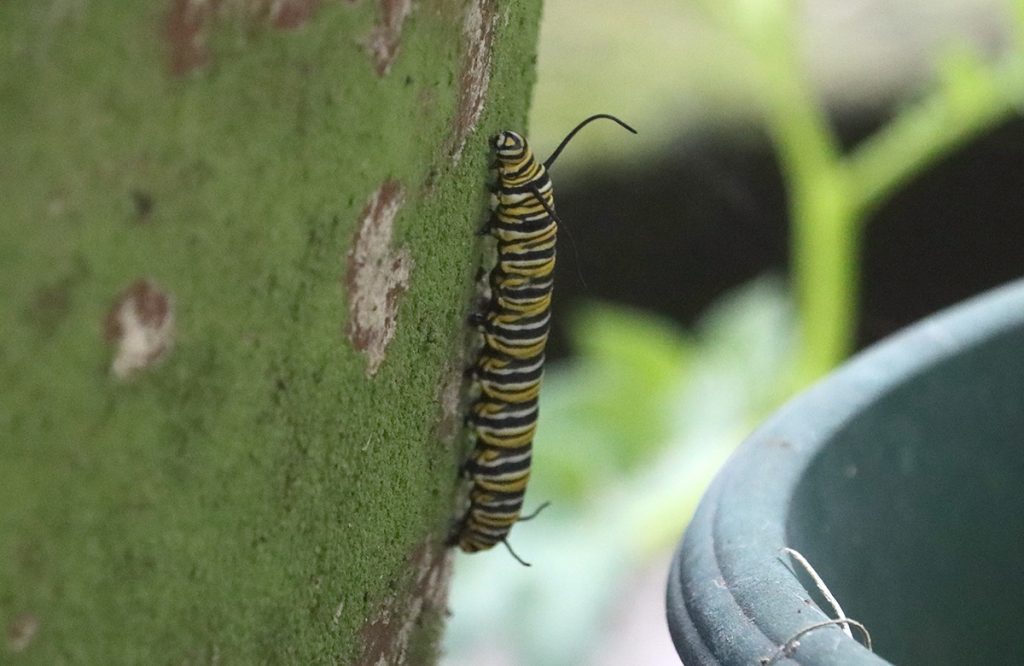
The milkweed plants are bare, and the other caterpillar is gone. This one has stretched itself onto the pot next to one of the milkweed pots. I tried to follow a monarch once as it found its chrysalis-making place. They can travel aways. In recent years, we’ve had way fewer monarch caterpillars, and they go to greater lengths to hide their chrysalids. It’s a good survival trait, but I wish I could check on them as pupae, when they’re vulnerable.
I stopped taking them into the enclosure after reading about the benefits of letting them be vulnerable. Captive raised caterpillars have a higher survival rate, but we’re getting in the way of natural selection. Research has shown that the higher survival rates now don’t get passed to the next generations, as certain traits get passed on that would otherwise have been eliminated.
Our current monarchs have been hiding their chrysalids well compared to those in previous years, and those genes get passed on. They are breeding better survivors.
July 25, 2021
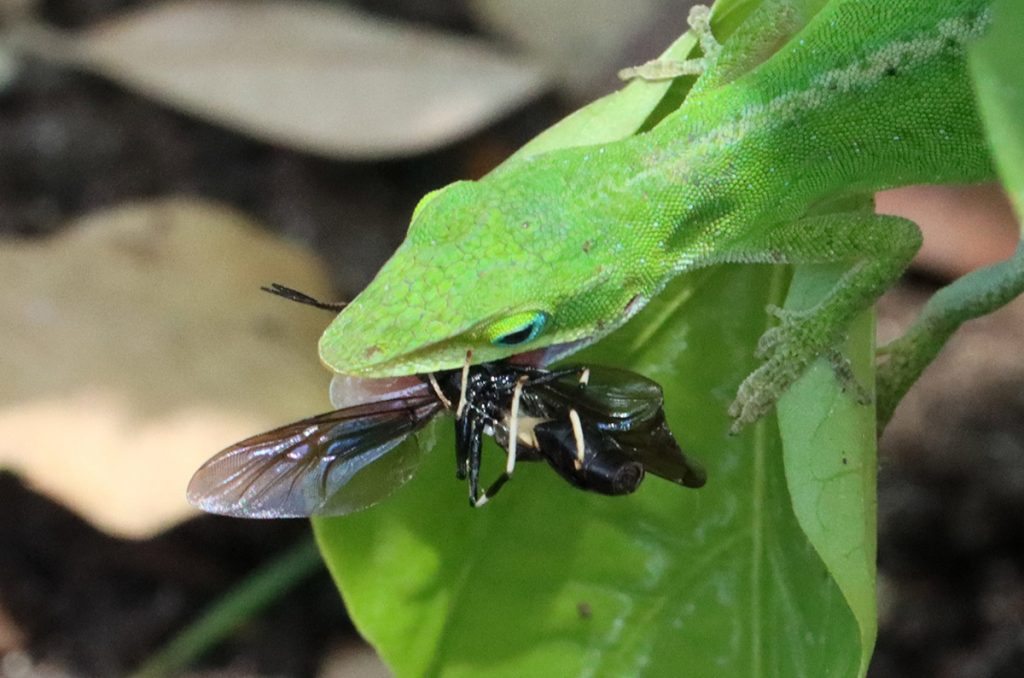
I see a large fly, bee, or wasp fly full speed into a pepper plant. I look to see what it is, and it seems to be pollinating a pink flower. On a pepper plant? Or is it with a second insect?
Oh, I see.
This insect flew right into the anole’s mouth. The green blends so well with the leaves, but did the pink of its mouth draw in the insect somehow?
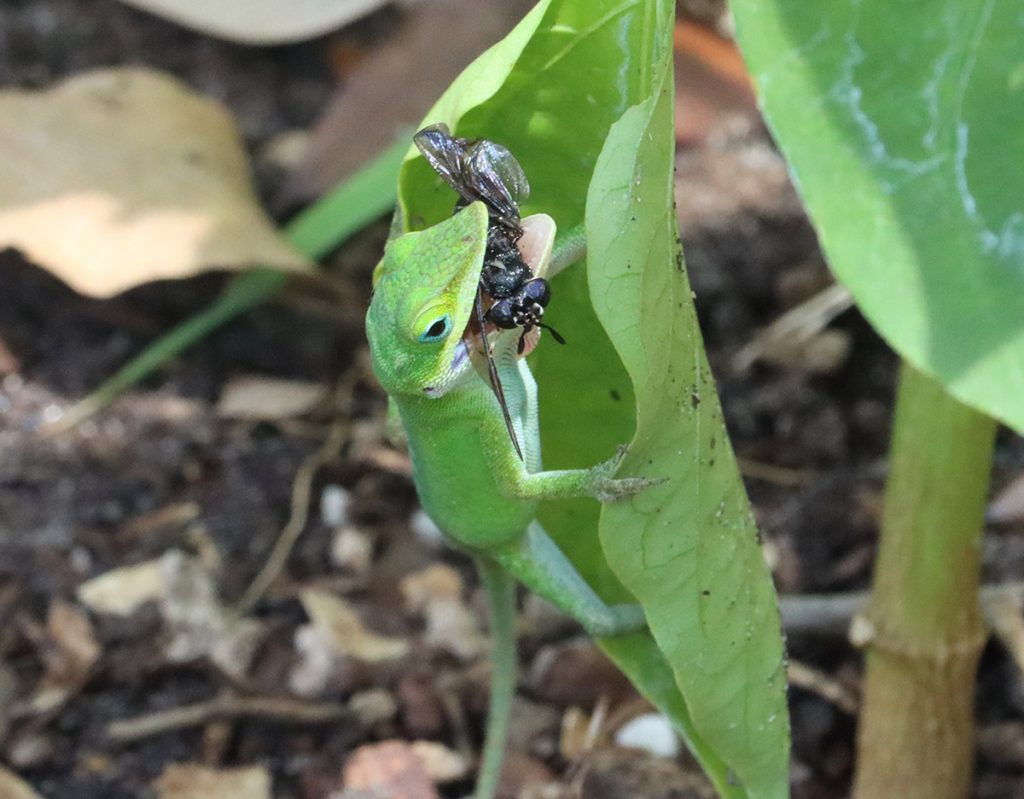
When I have more time, I want to identify the insect in the lizard’s mouth.
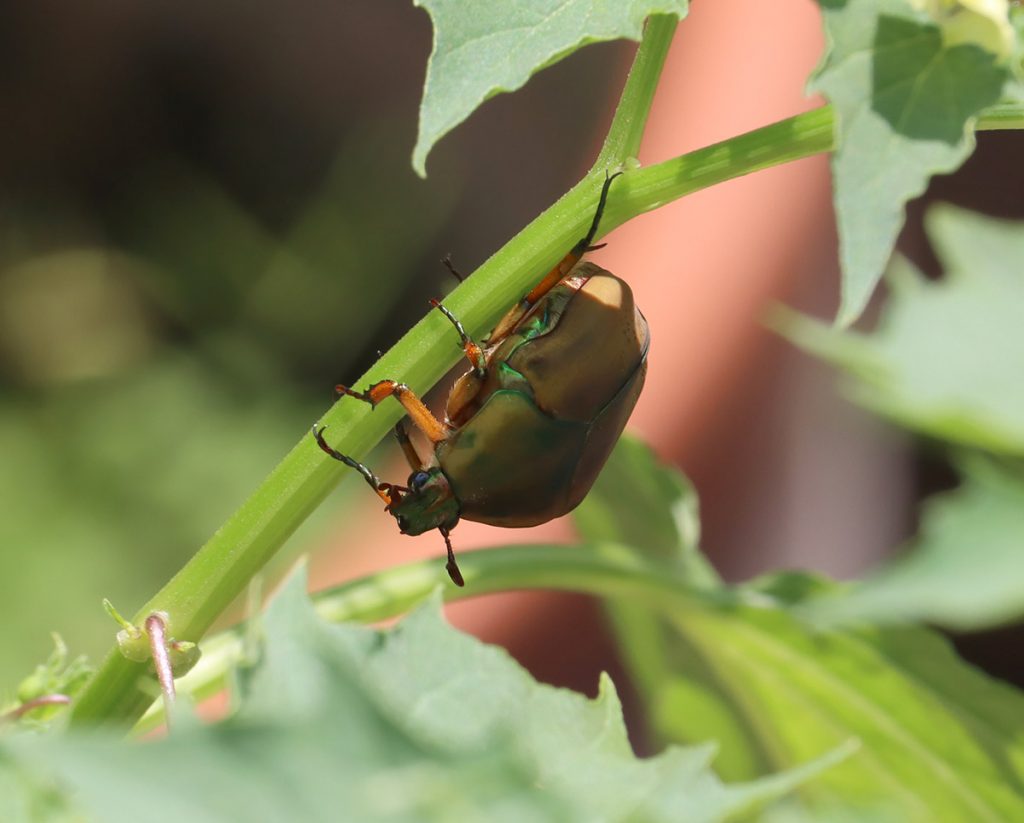
I’ve been seeing something large and shiny flying through the yard over the last few days. Today I saw where it landed, and took a camera. I usually see a common green June beetle in our yard sometime in mid-summer. I imagine I see their larvae when planting new plants in the spring. Many beetles are ground nesters, with creepy white larvae I encounter when I take a trowel to the ground.
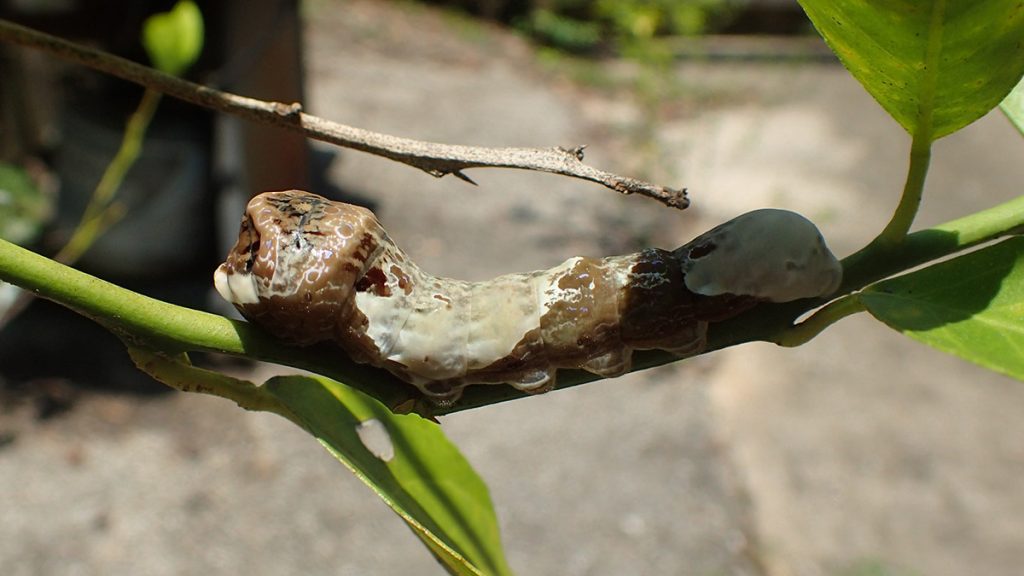
We should have a couple of chrysalids soon. Both of giant swallowtails and of monarchs:
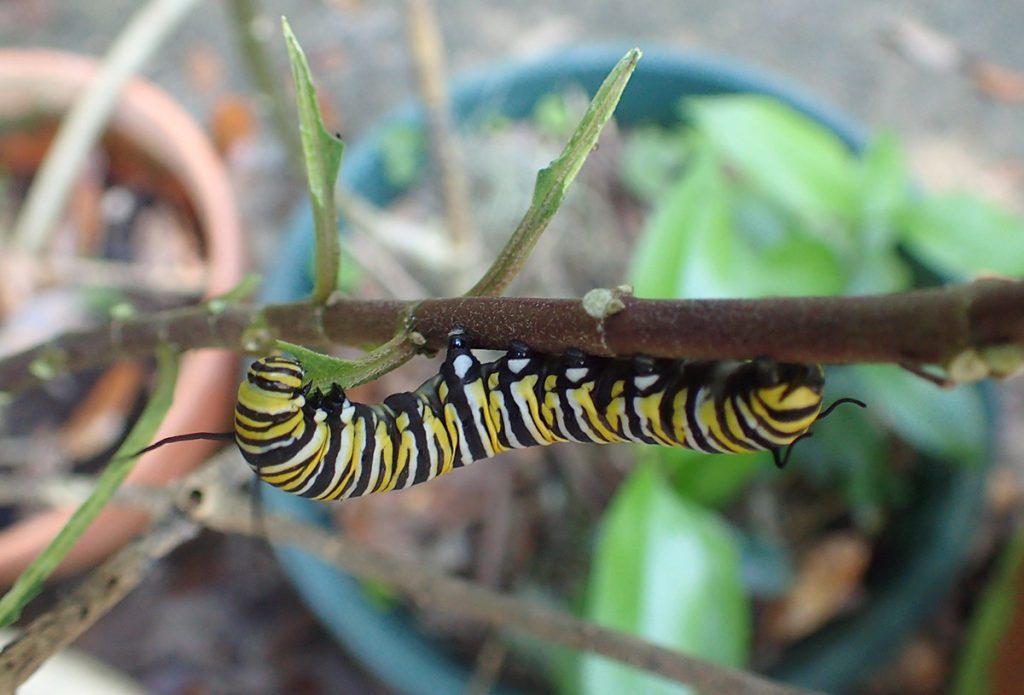
The two monarch caterpillars have finished off a handful of milkweed plants.
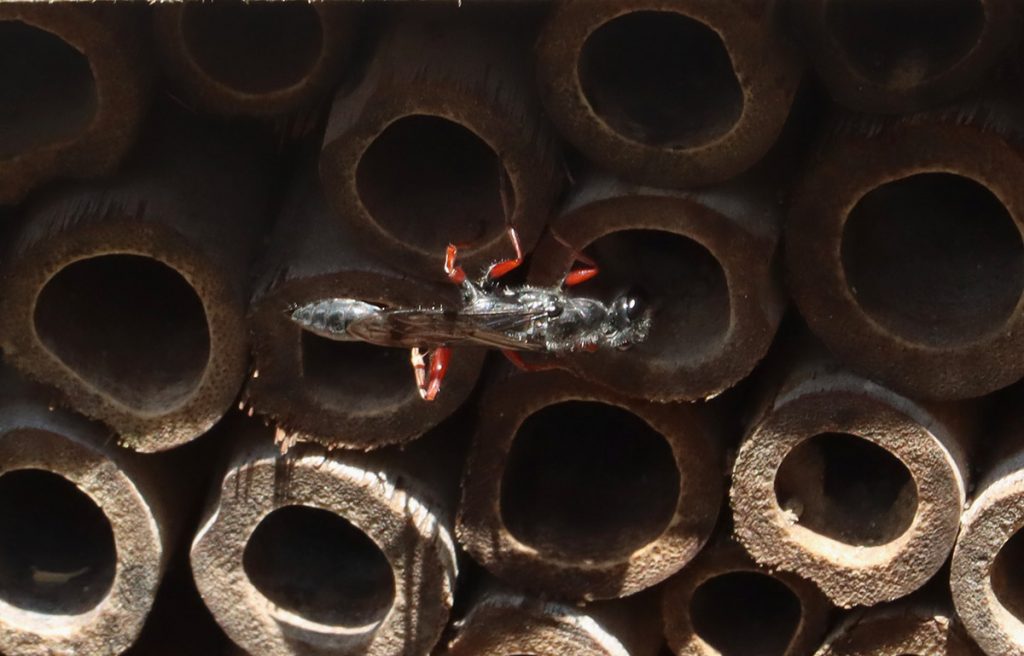
I last noticed this wasp a couple of months ago. Either I failed to pay attention, or we’re entering a new nesting period.
July 22, 2021
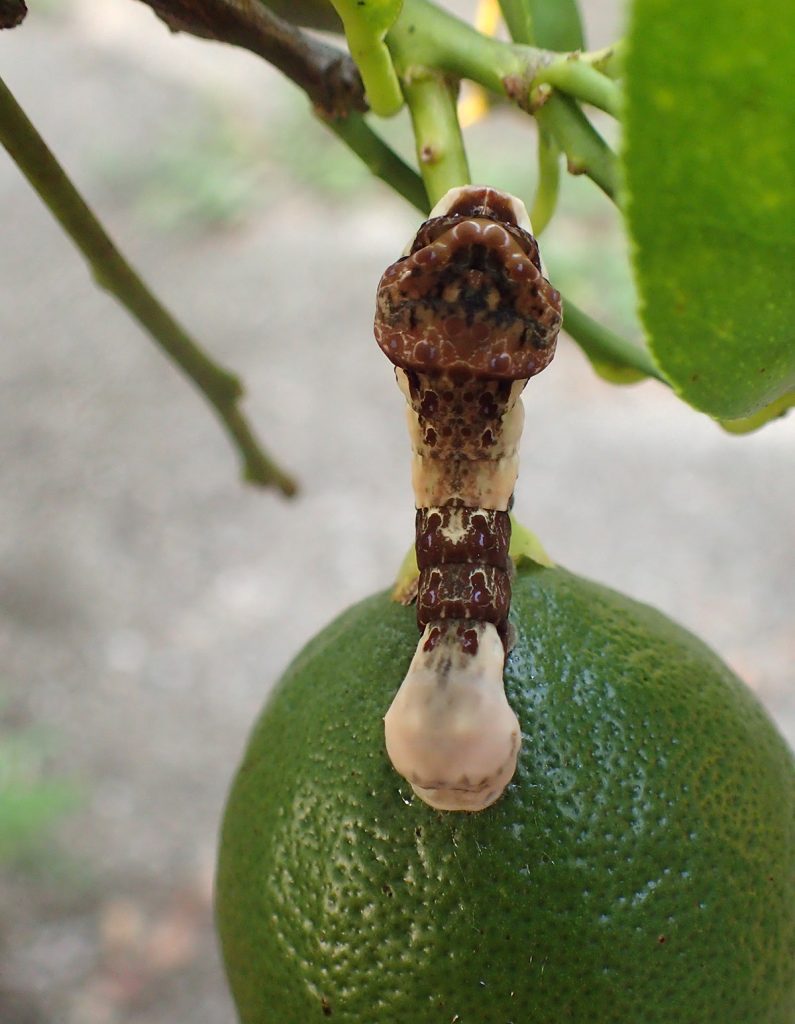
Here’s the image we use when explaining that giant swallowtail butterfly caterpillars host on citrus plants.
July 21, 2021
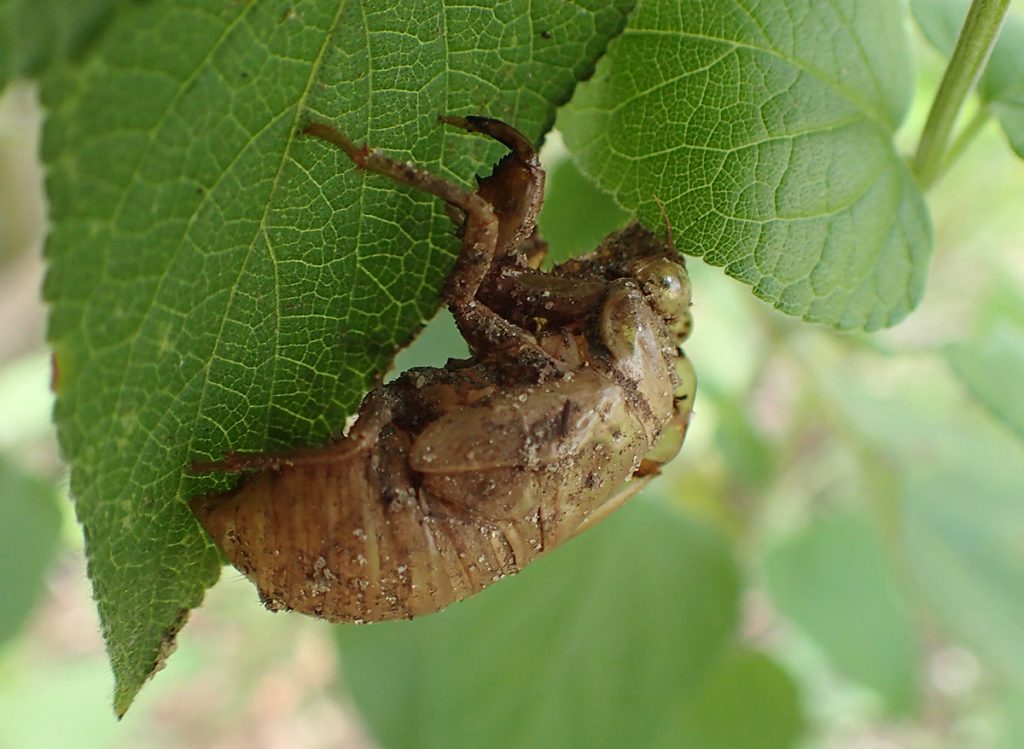
Thanks to Max’s second grade teacher for bringing the word exuvia into our lives. She collects these cicada moltings.
July 20, 2021
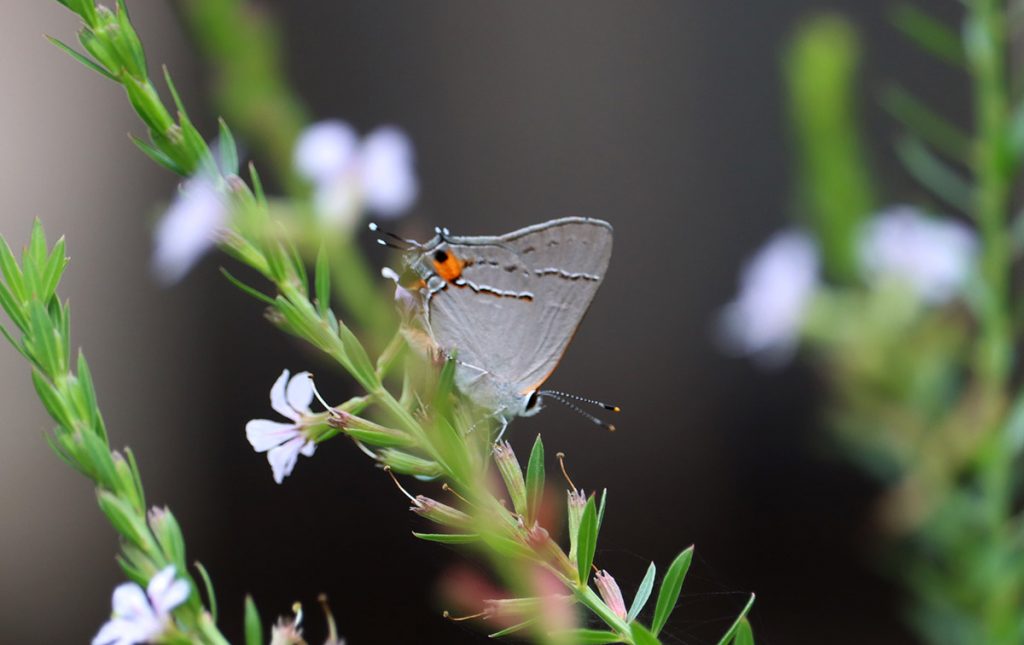
I took a quick photo of this hairstreak before it flew off. It’s been a summer for small butterflies, with intermittent visits from larger species.
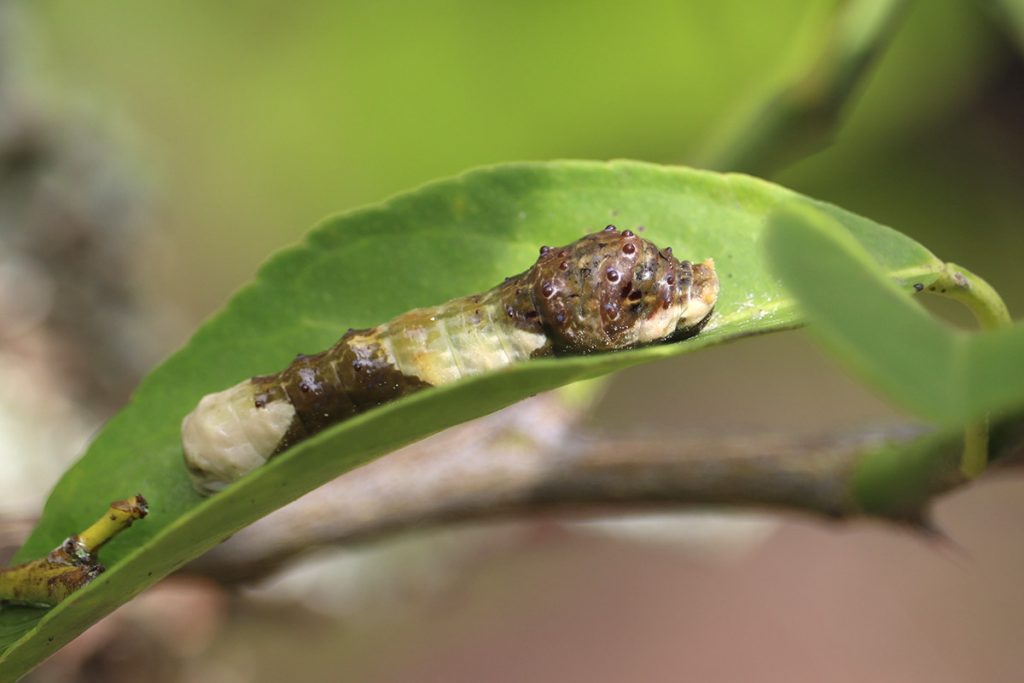
I believe this is its final instar. Caterpillars have their binging and resting patterns. There are caterpillars I never see eat, only laying on stems or leaves for a day or two at a time. This one has been comfortable here for a couple of days. Right out in the open. They have so many defenses- they look unappetizing, they have large, imposing heads, and they also do this:
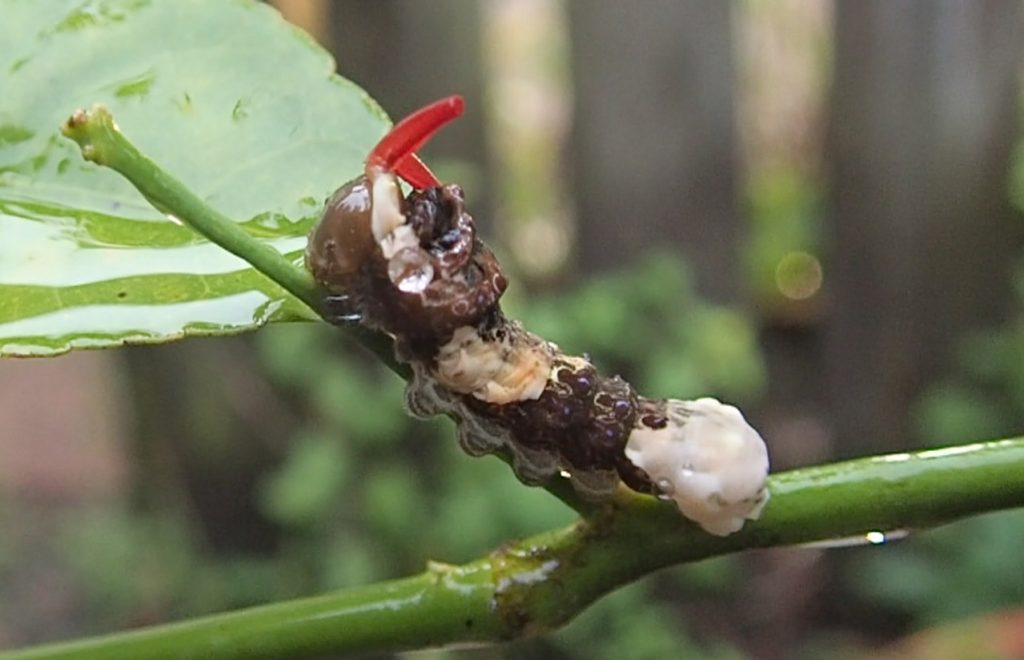
It’s a little bit of snake mimicry, with foul smelling chemicals to boot. This happened as I watered the plant. Okay, I gave a watering can to my son Max and stood by with a camera, and he only watered this part of the plant. We get a kick out of swallowtail tongues, but we don’t do this often.
July 18, 2021
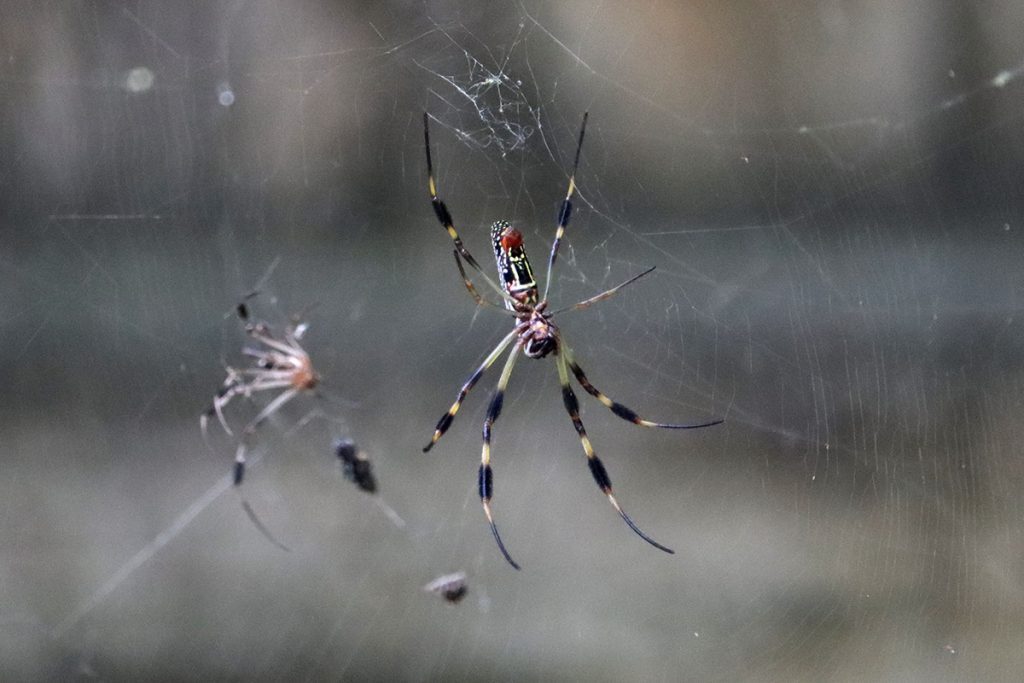
This spider has a large web in a corner by one of our milkweed patches, and by several herbs. Behind it are the remnants of another spider. Wonder what happened there.
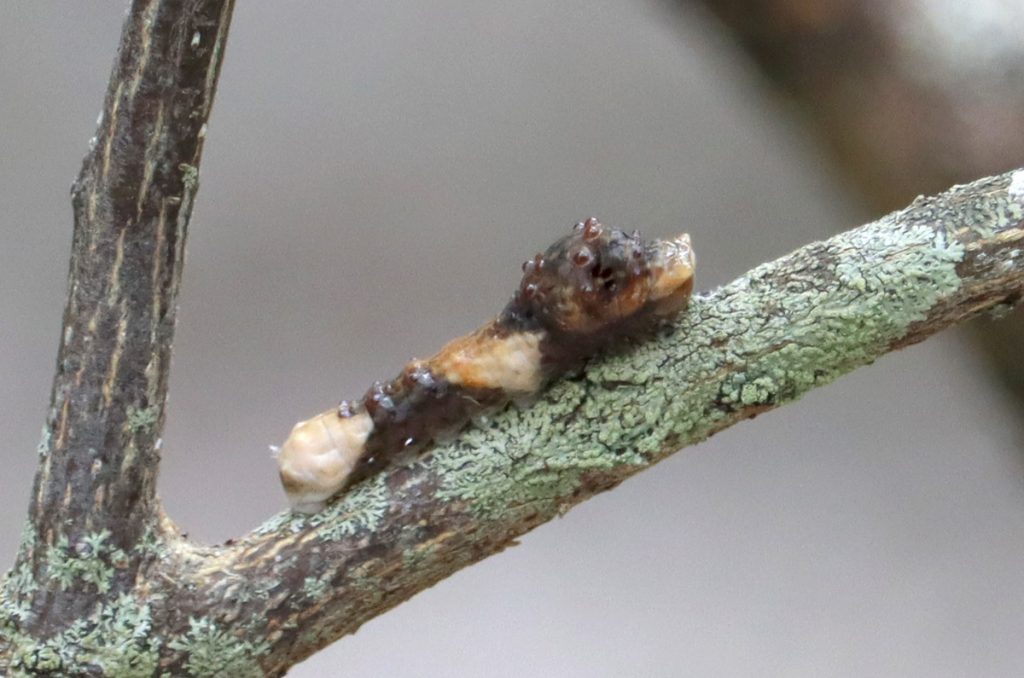
They’re not as big as they’re going to get. The final instar looks like this, but larger. We’re getting closer.
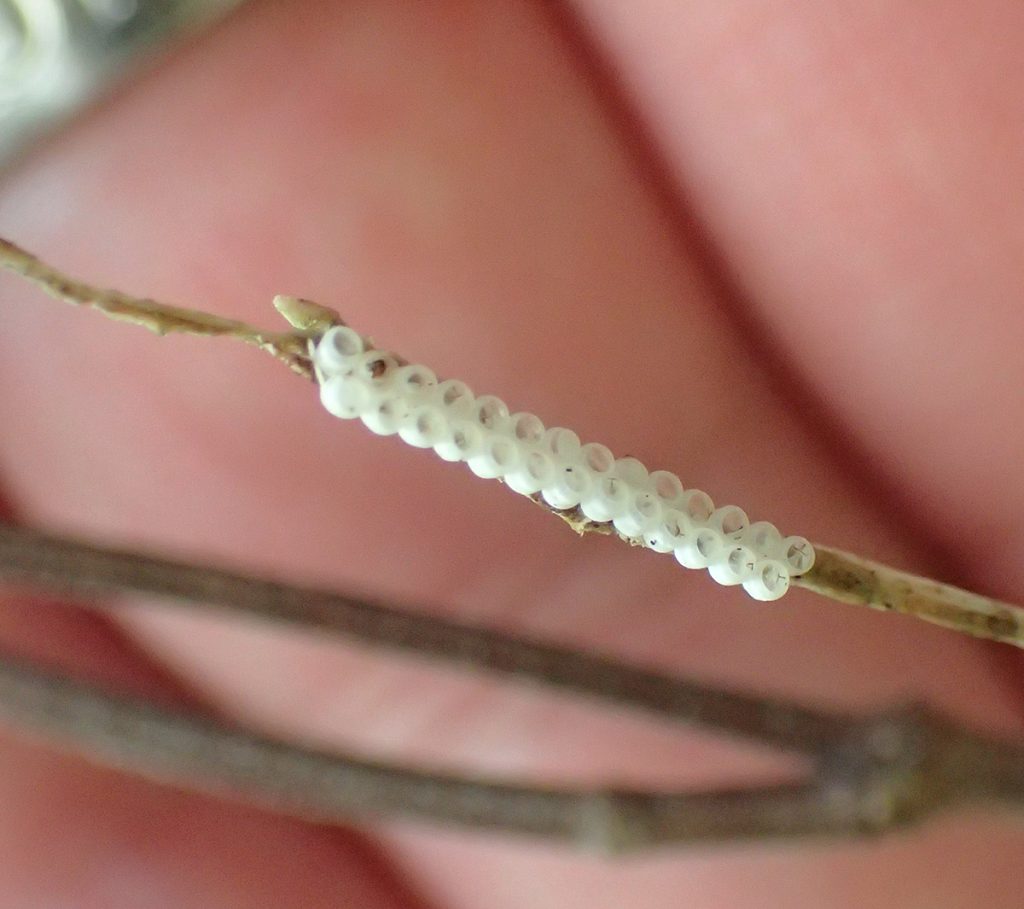
Sometimes I try my luck with eggs on iNaturalist. And I’m not usually one to post photos in Facebook groups, but I do see people post egg photos in entomology groups and get answers. I’m content for now to have this remain a mystery.
July 17, 2021
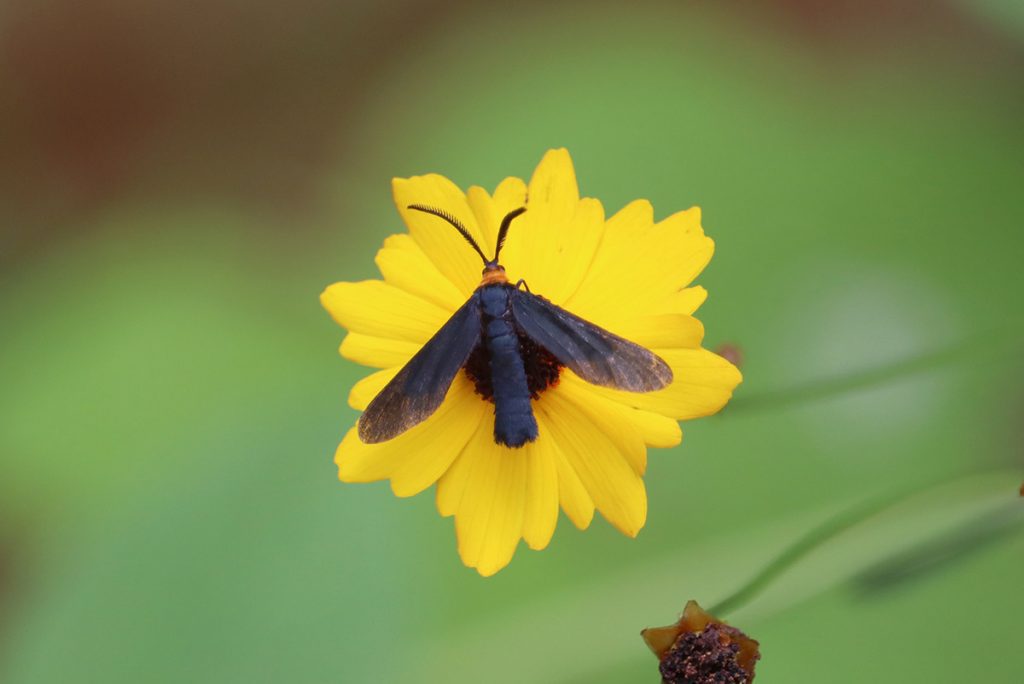
I saw two of these mating a few days ago. I’ve seen grapeleaf skeletonizers perched on leaves in our yard, but never pollinating.
July 16, 2021
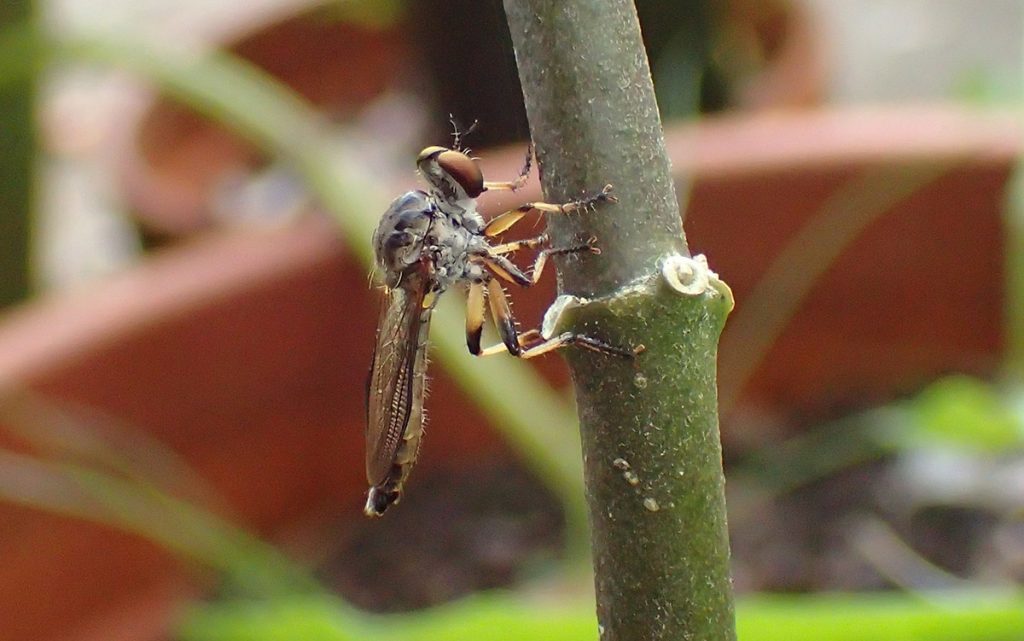
Another predatory insect in the yard. Previously, I’ve seen another type of robber fly, the hanging thief (genus Diogmites). We continue to see a diversity of insects, both predator and prey.

Giant swallowtail caterpillar 
Giant swallowtail caterpillar
Our giant swallowtails continue to grow, moving into the next instar phase. We seem to be down to two.
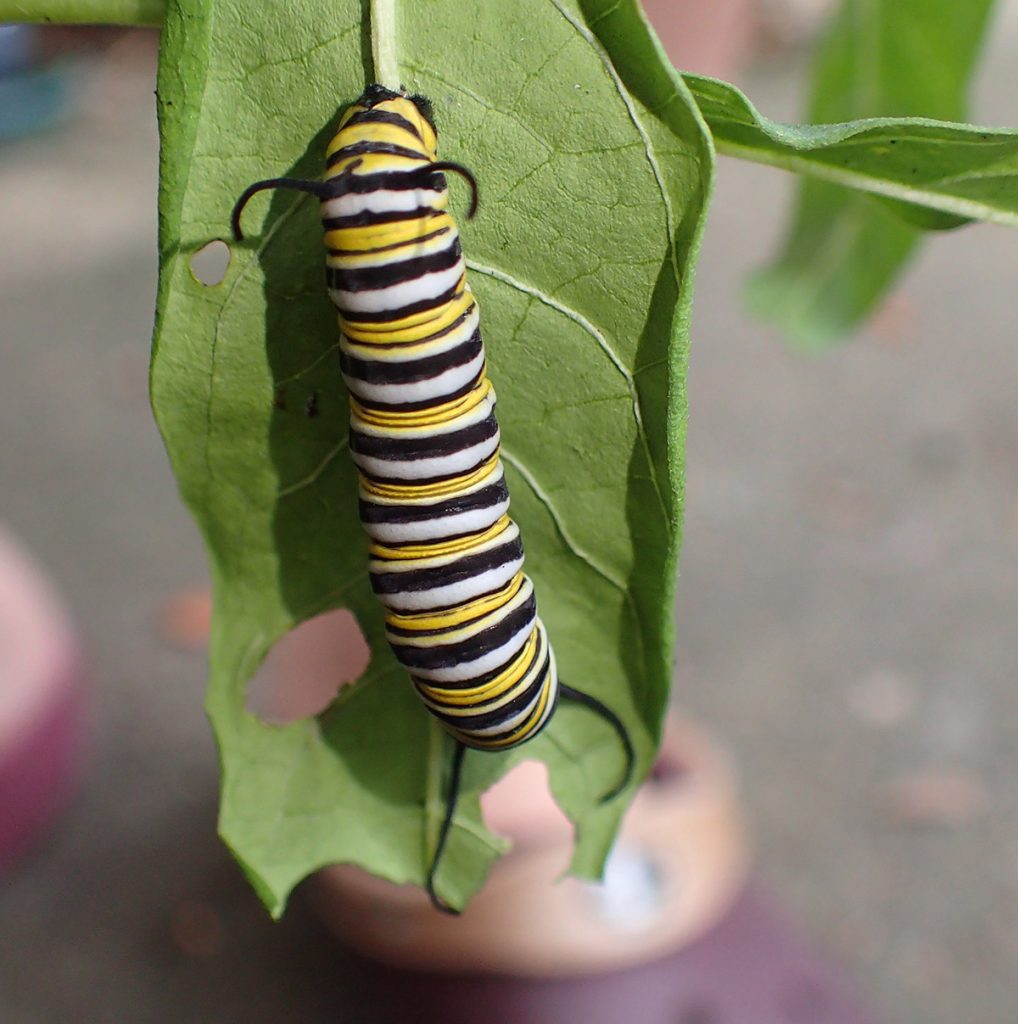
Our two monarchs continue to grow as well.
July 14, 2021
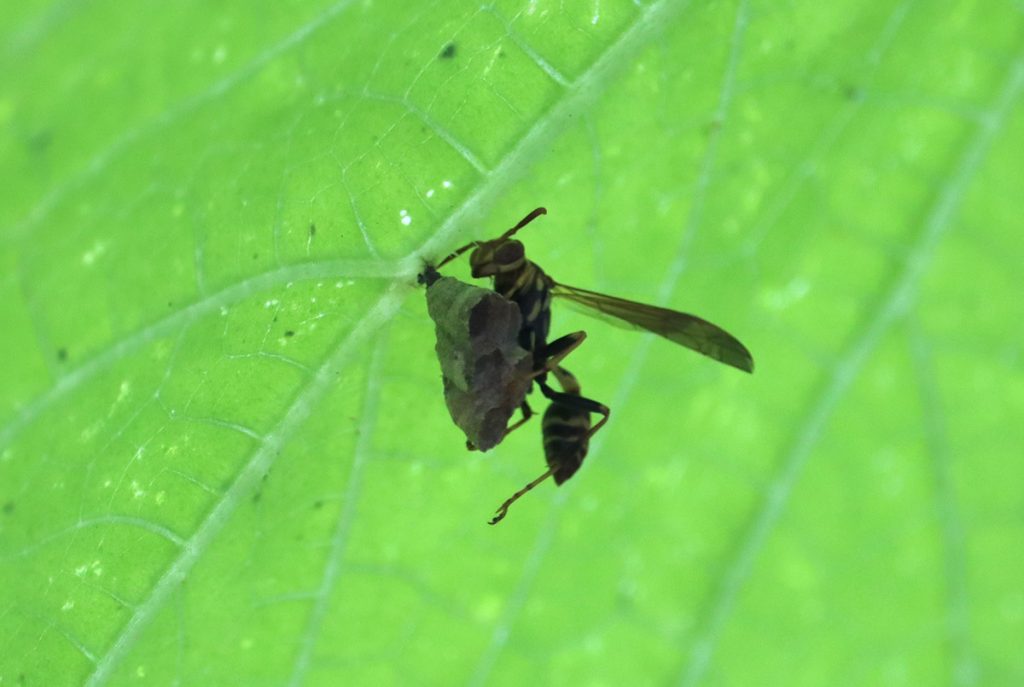
I’m not sure what species of paper wasp this is, but I thought it was an interesting place to make a nest. Paper wasps are always patrolling plants on the lookout for caterpillars. I’ve twice photographed them taking monarch caterpillars. The flip side to their taking “preferred” caterpillars is that they also patrol our food plants for the “non-prefered” plant eaters.
July 13, 2021
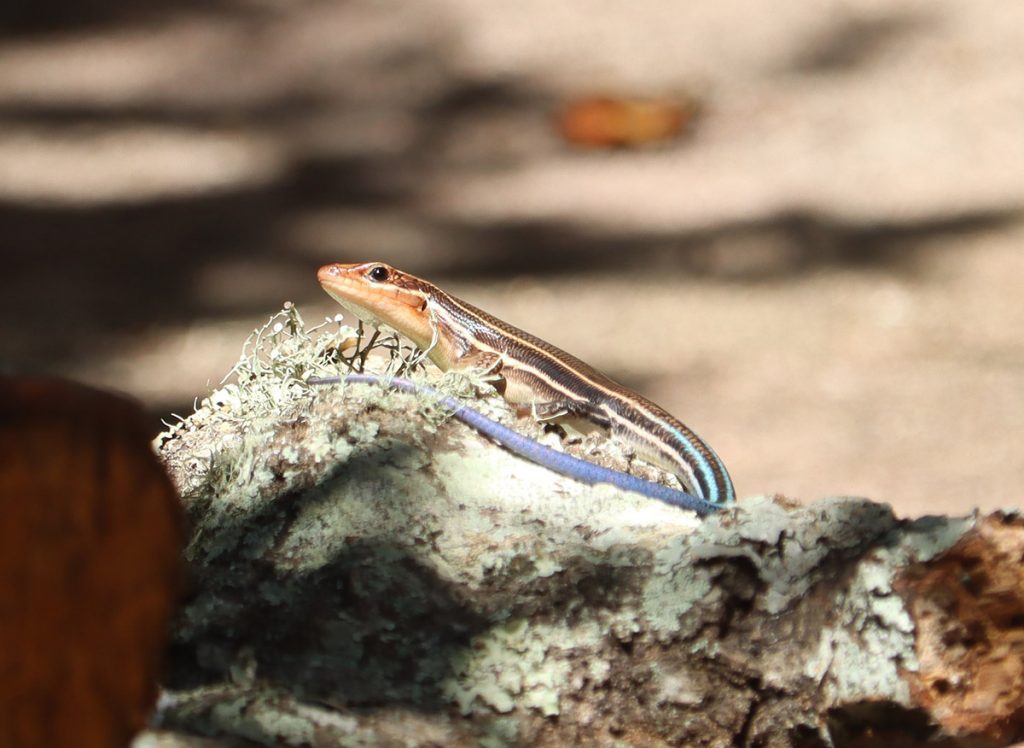
This is the last I saw of the skink perching on the brush pile. Since this, I’ve seen plenty of skinks scurrying away in the yard. Was this a nest? Are there smaller skinks running around our yard? Last year, the nest appeared to be under our back steps, and we saw the small skinks not far from there. This pile is on the side of the house, in a place where we spend less time.
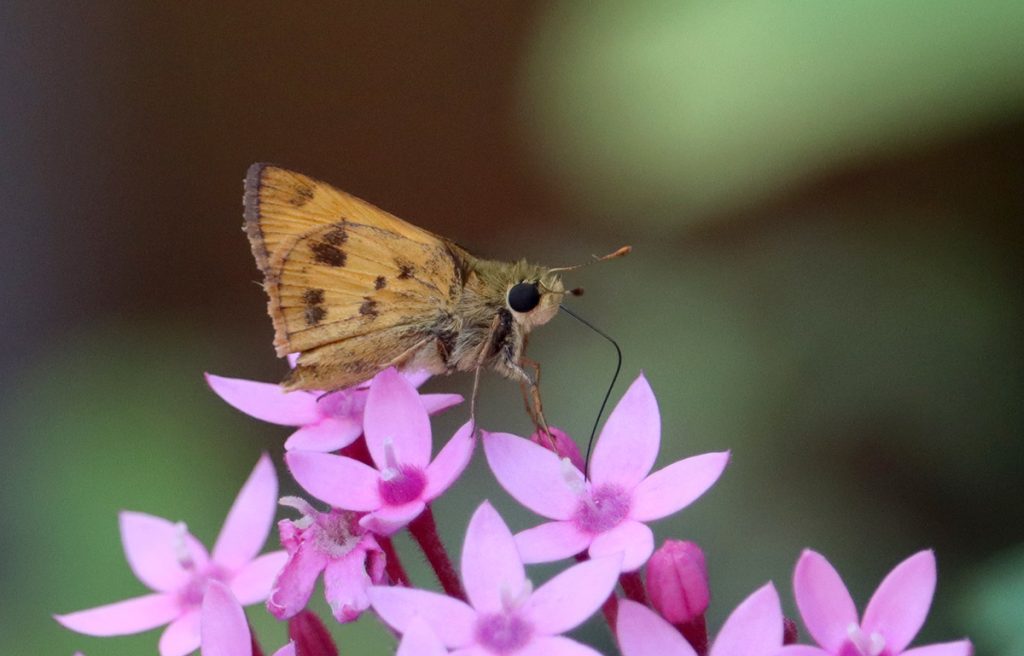
This is posed in the same position as the grass skippers in my butterfly guide. Based on that wing pattern, I’m saying whirlabout. We’ve had a few different grass skippers in 2021. In the past I’d mostly seen fiery skippers, so I wonder if I’ve been lumping them all in together.
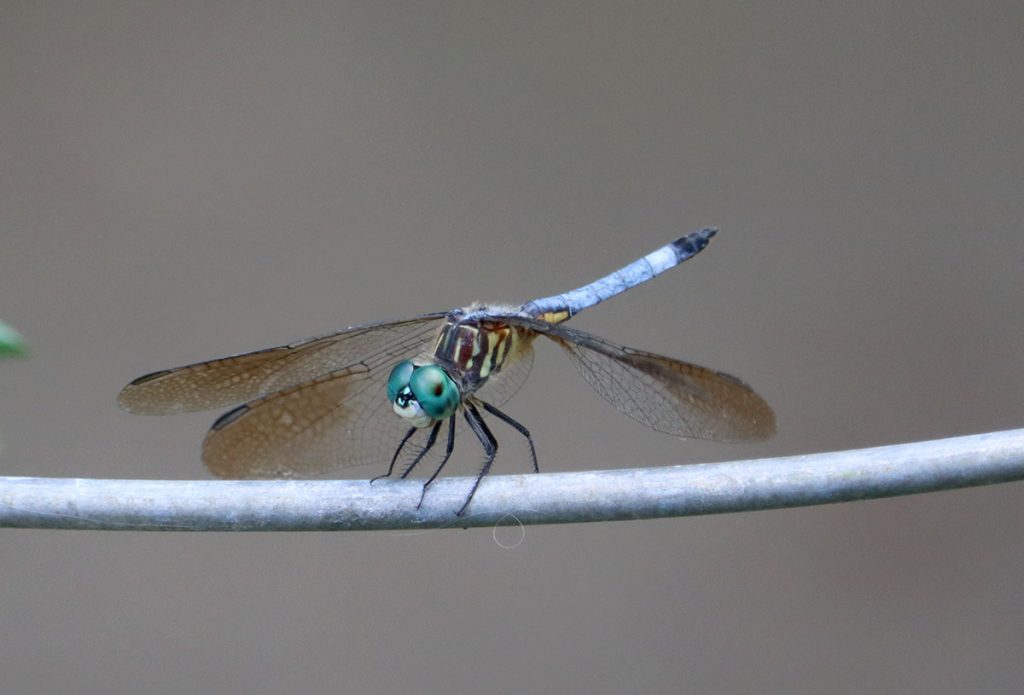
I’ve been seeing dragonflies in the yard. This one’s a blue dasher.
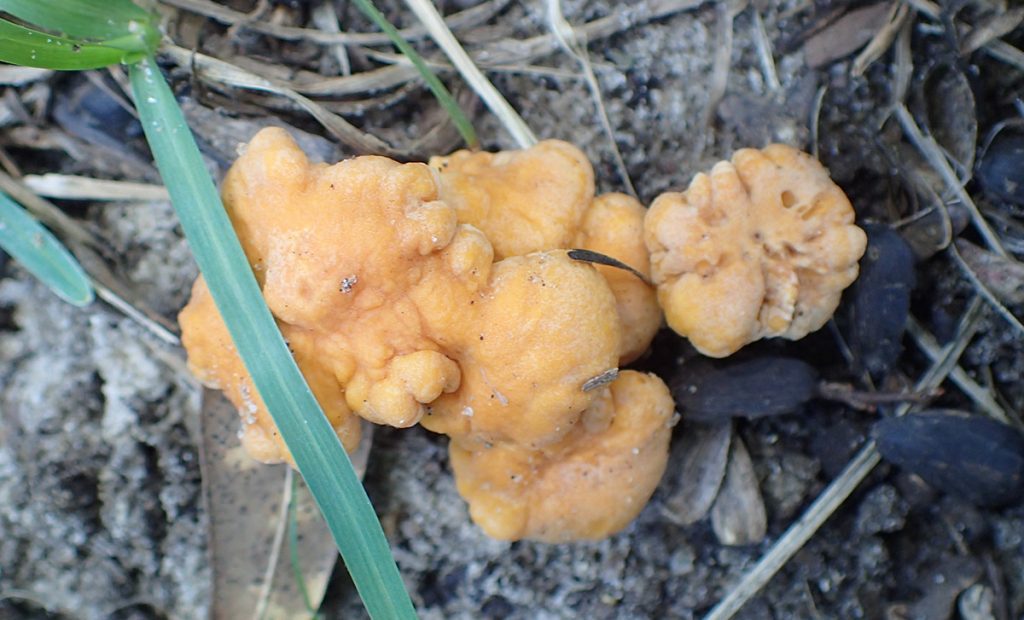
Last year was our peak year for chanterelles- I harvested enough to top a single pizza. Today, after a few weeks of rain, I found four. Our oak tree is gone, but its roots remain. I wonder for how long we can expect to find chanterelles?
I found a bunch in a park, and combined them with these to make a mushroom fried rice. It was tasty, but next time I’ll find a recipe that better highlight’s the mushroom’s flavor.
July 12, 2021
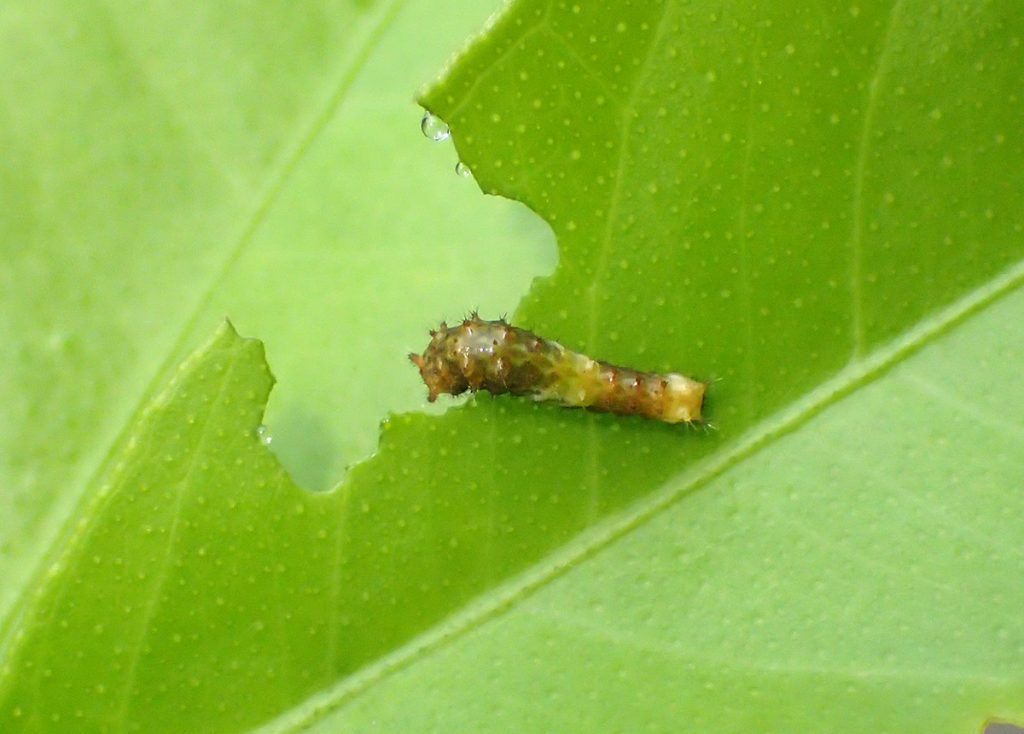
Well, finally! This is my favorite caterpillar. About a month ago or more, a guest in our yard spotted a giant swallowtail around this plant, but I never found caterpillars. Today, I spotted three.
Yesterday, I saw monarchs by our milkweed and a checkered-skipper on our fanpetals, but I didn’t have a camera on me. So we may have more caterpillars on the way.
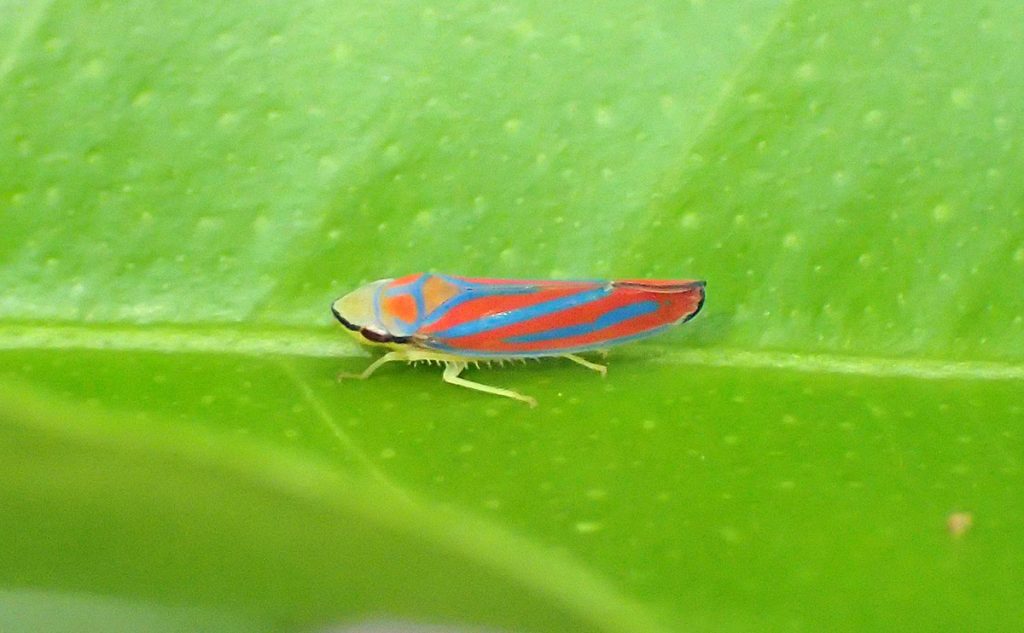
A pretty insect, but one known to carry a bacteria known as Pierce’s Disease to grapevines.
July 10, 2021
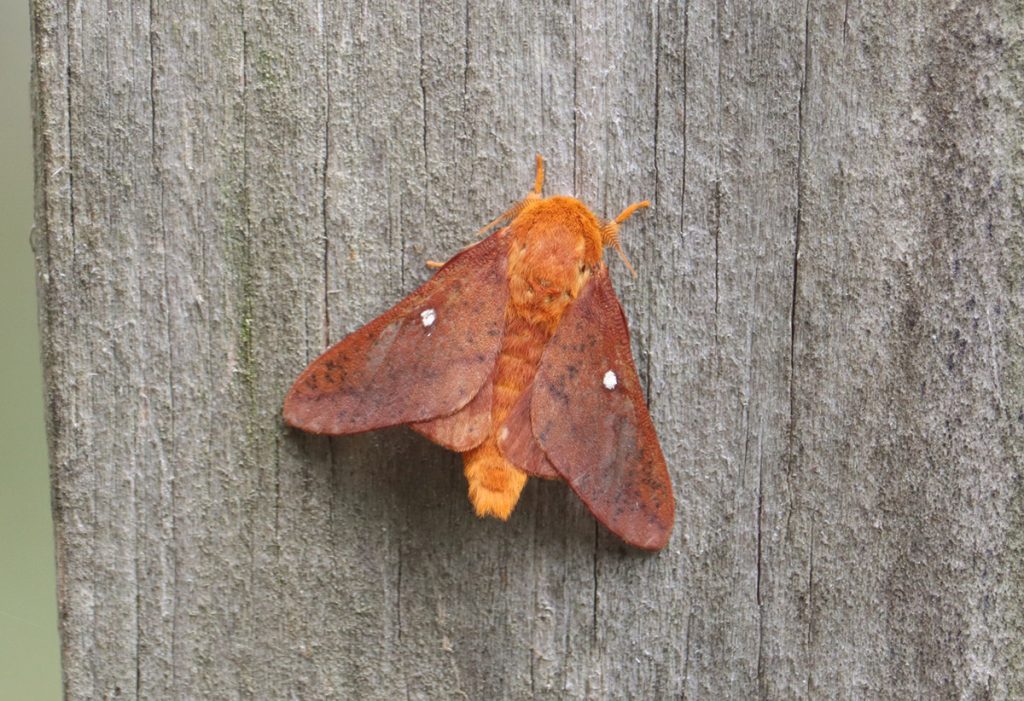
It’s a yard work Saturday during the summer, which means there will be plenty to see. One of the first insects to catch my eye is this oakworm moth. There are three species of the Anisota genus identified in Leon County on the iNaturalist app. Two have black speckles on their wings. My guess here is spiny oakworm moth.
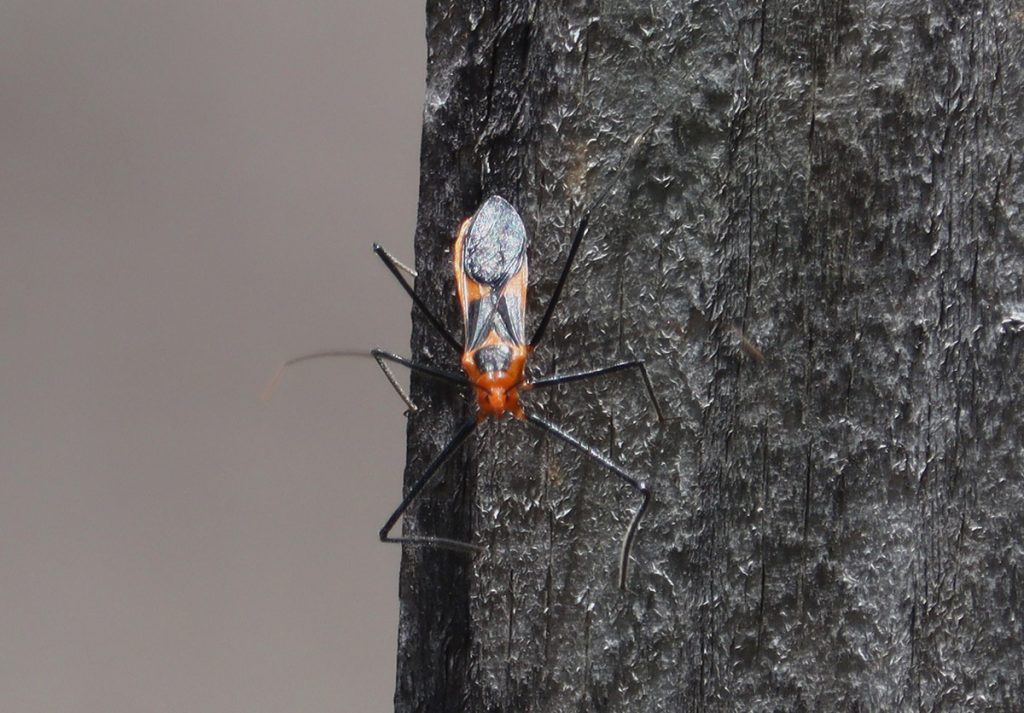
I saw a milkweed assassin bug nymph earlier in the year, and here is the adult. I found a UF Entomology article on this species, as I wondered whether it could be eating monarch caterpillars. The name comes from its resemblance to the milkweed bug, which eats milkweed (and sometimes monarch eggs on milkweed).
And while this is a predator of insects capable of eating a monarch caterpillar, it is considered a generalist. Some time ago I went from a goal of making a pollinator garden to one of creating a habitat. Yes, this includes pollinators, but also plant consumers and detritivores, the creatures that eat them, and all the way up the food chain. Seeing predators is a good sign that I’m accomplishing this goal.
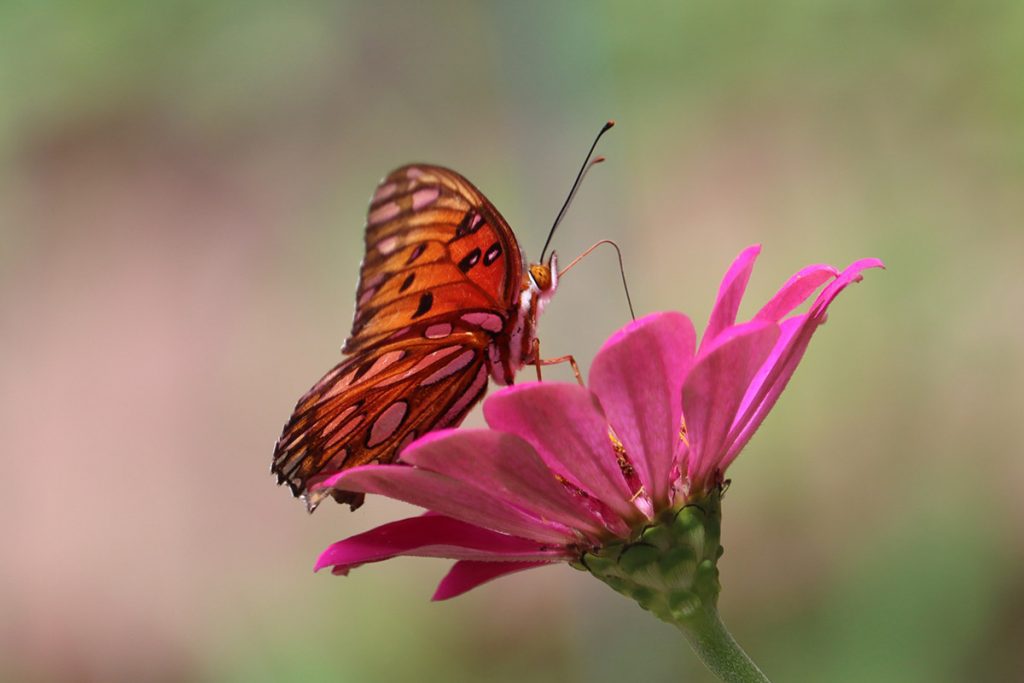
Here’s a pollinator I’d not seen much of in 2021. We have up and down years for gulf fritillaries and zebra longwings in our yard. One of my plans for the space where the oak fell is to plant passionvine, which these butterflies host on as caterpillars. Hopefully that provides a more permanent presence in the yard.
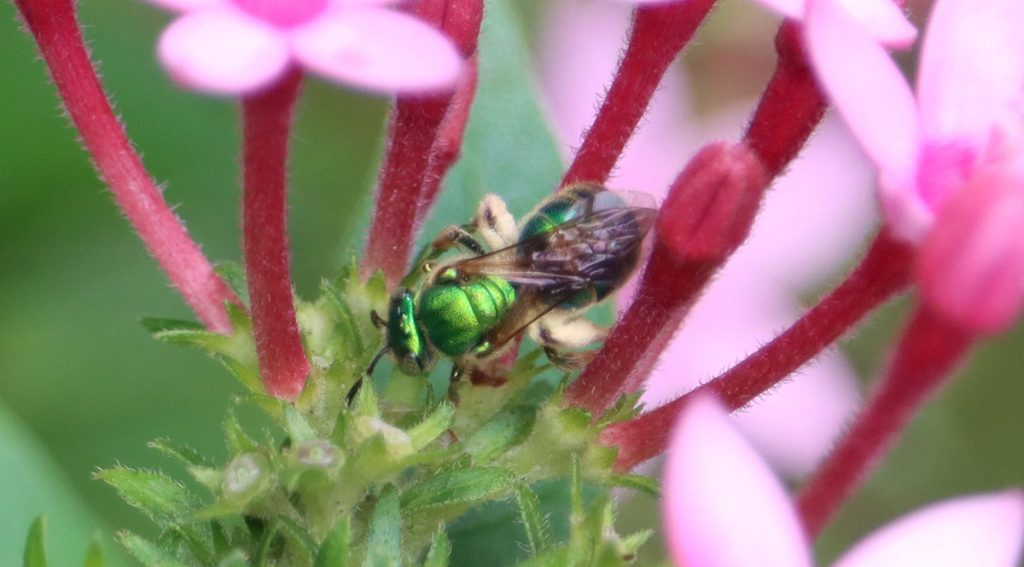
Like clockwork in 2019 and 2020, female brown-winged striped sweat bees are in our yard through out the summer. In August, the males show up as well, and by the end of the month, we have swarms of males and females. I’ve only been seeing one female this July.
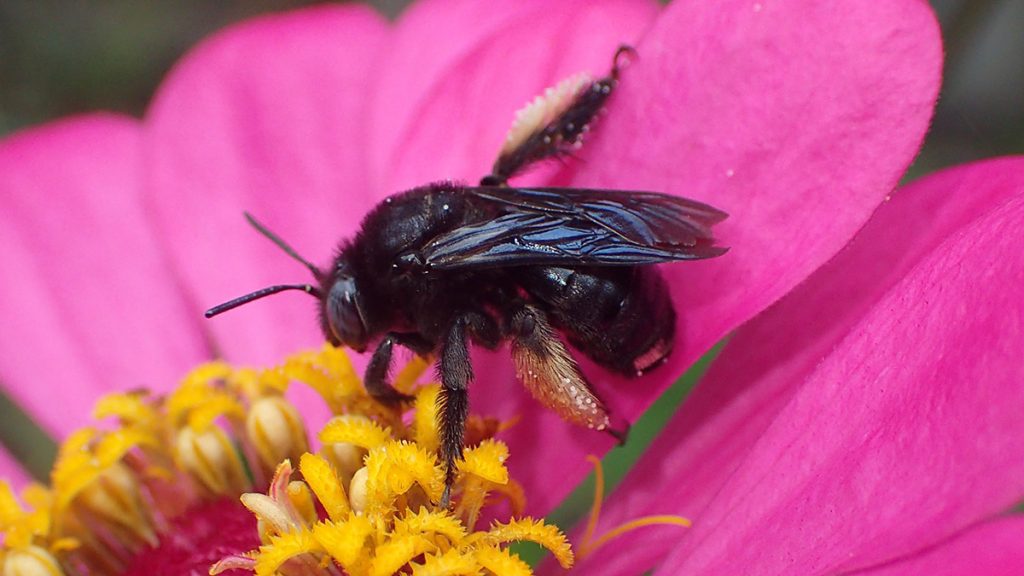
I had my Olympus point and shoot camera in hand when this longhorn bee was taking its time on a zinnia flower, so I took a shot or two in macro mode. Check out its pollen sac:
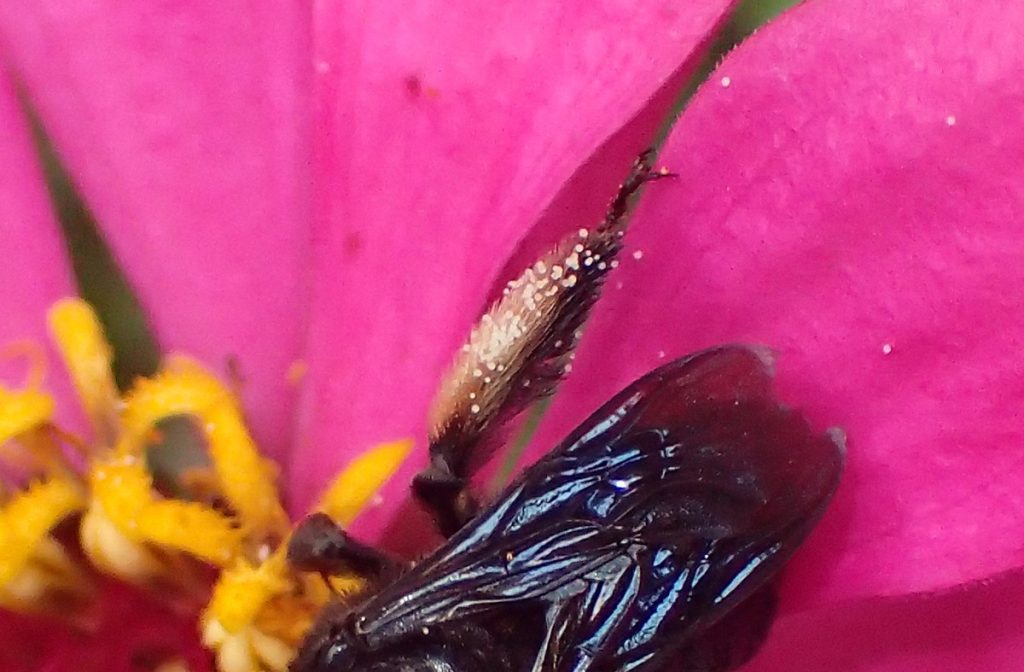
Yummy, yummy pollen.
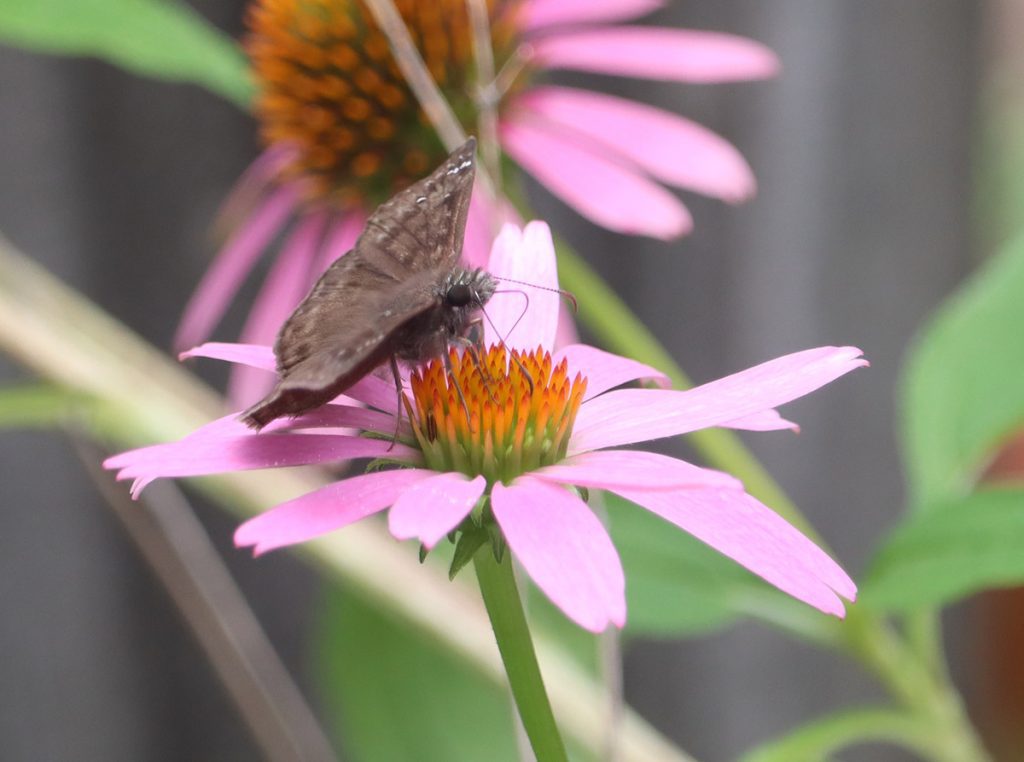
I haven’t seen one of these in a couple months. From what I read on iNaturalist, they have three generations in the southern states. Insects usually live for a few weeks, so when we see them disappear and reappear, we’re seeing multiple generations throughout their flying season.
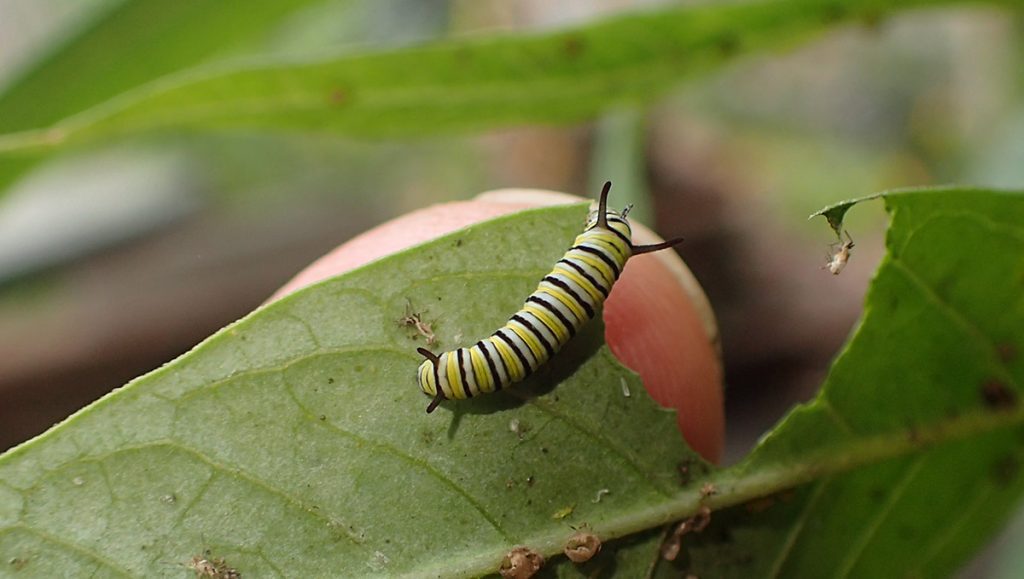
Lastly, monarch caterpillars continue to host on our milkweed in small numbers. It’s been a couple of years since we had a big outbreak.
July 8, 2021
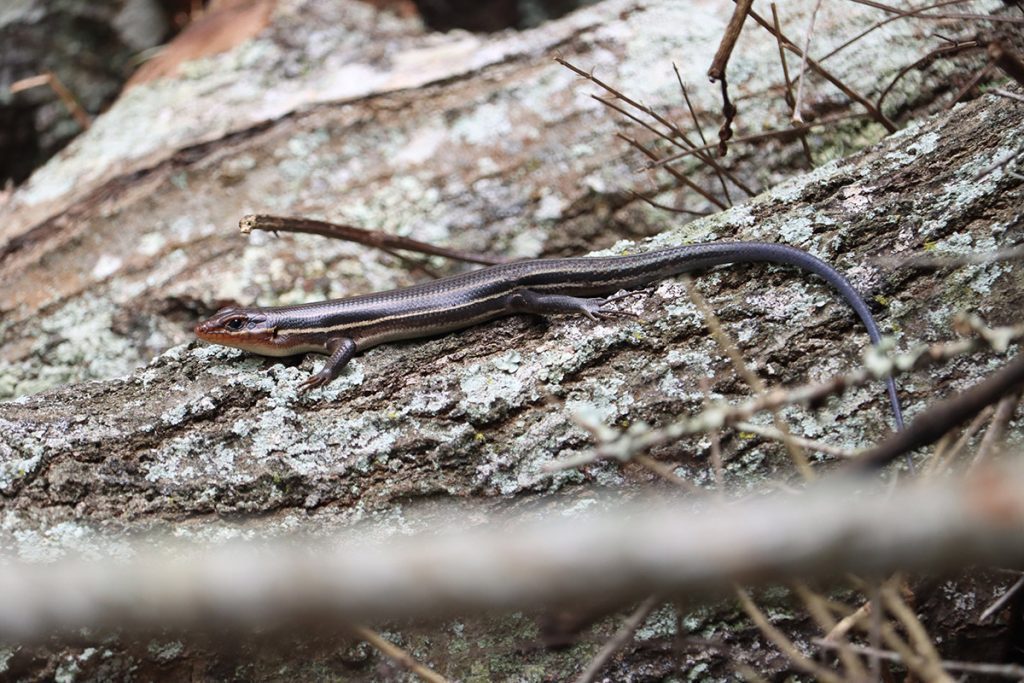
I get home from shooting video for a segment on devil’s walkingstick, and the skink is waiting for me.
July 5, 2021
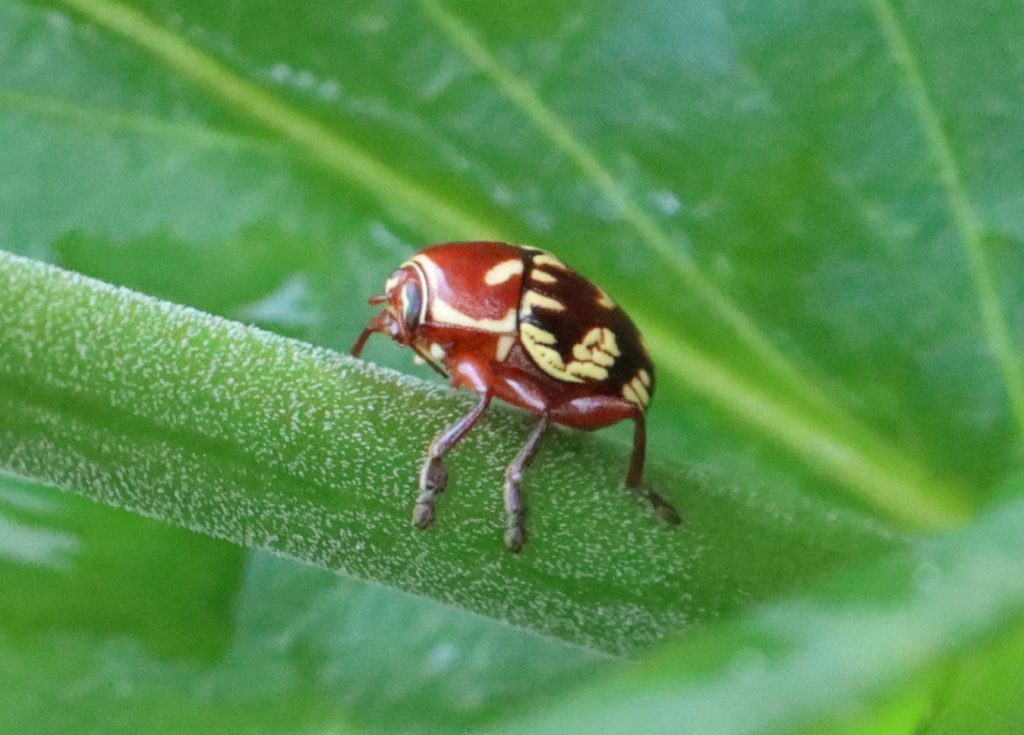
EDIT July 27, 2021- Blog reader Fran Cutrell Rotkovsky sent me an entry on bugguide.net for Bassareus brunnipes, a case-bearing leaf beetle. The option I had selected on iNaturalist was a different genus of case-bearing beetle, but this particular species had not been observed in Tallahassee. Broadening the filters to include all of Florida, I did see that it has been iNaturalized in our state.
Aside from the fact that this insect seems to have lost its antennae, it looks like a solid match.
Especially when it comes to a small insect like this, there are some plants and animals that iNaturalist users either don’t notice or just aren’t interested in investigating further. The BugGuide entry, however, was from Tallahassee. The lesson here is to diversify the places you seek your information.
ORIGINAL: This one stumped iNaturalist, which gave me a “We’re not confident about this ID” message. It’s about the size and shape of a ladybug, and many of the options were beetles. A couple of the other options were stinkbug nymphs, which this doesn’t quite fit. It could be another immature insect, or possibly an exotic insect not yet observed in our area. I’ll update if anyone weighs in, or if I find new information on it.
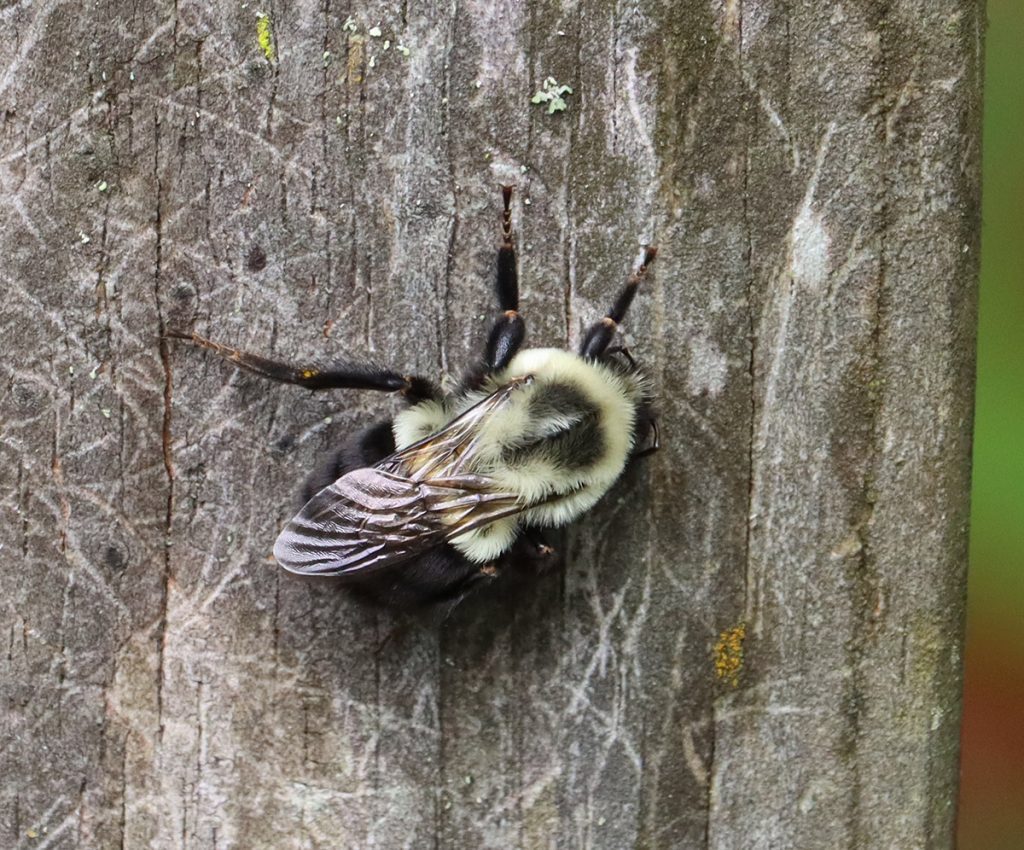
Over the last few days, we’ve gone from one to two to three bumblebees in the yard. I kept finding one taking short rests.
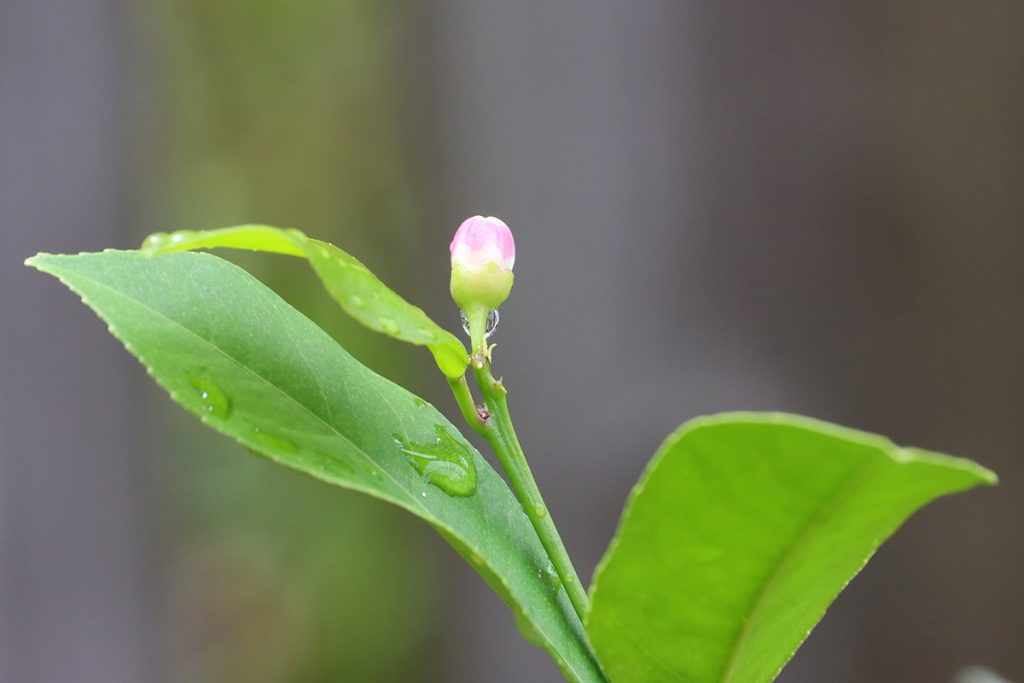
It’s been a year for this and our other plants. After a cool winter, this one produced multiple flowers, as they do earlier in the year. We had multiple small lemons at the start of spring, but after weeks of drought, many of them turned yellow and fell off, leaving us with two. Those have gotten nice and big since the rains started. And now, we have multiple out-of-season new flowers on our plant. A friend told me his lemon plant is doing the same thing.
July 4, 2021
Once monarchs make it to a certain size, they usually make it. As of the morning of July 6, these two are still polishing off our milkweed plants. They seem to be eating more slowly than most large caterpillars, which usually decimate plants and then go off to make chrysalides.
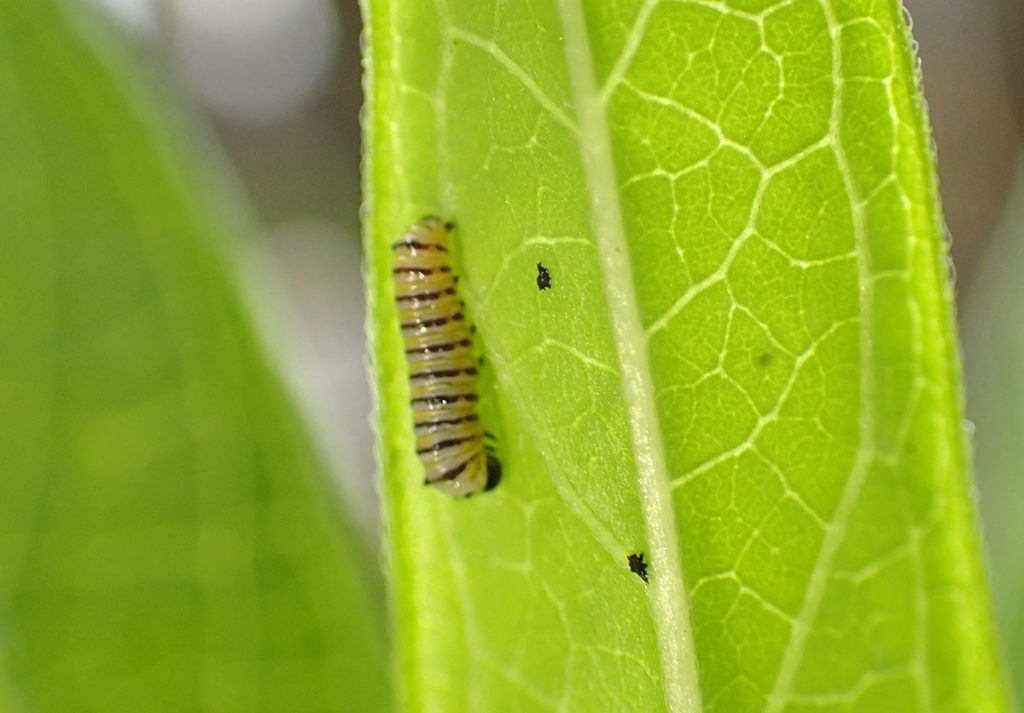
Meanwhile, back in the other milkweed patch, we have more young caterpillars. None of the caterpillars here have made it to the later stages of development.
July 1, 2021
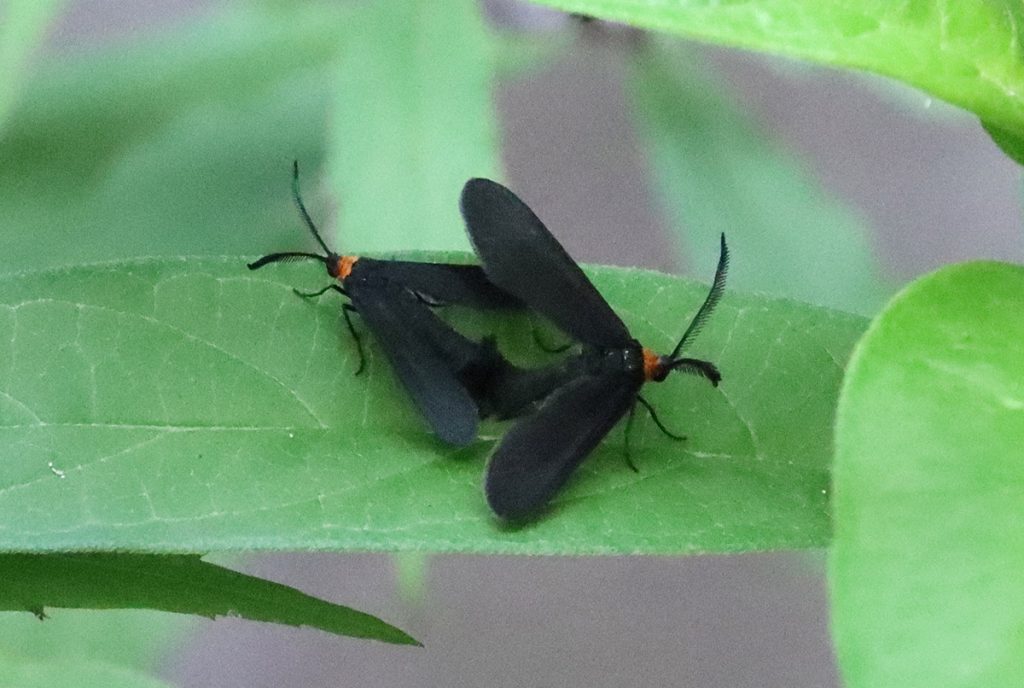
I saw these two early in the morning, mating not far from the Virginia creeper their caterpillars eat.
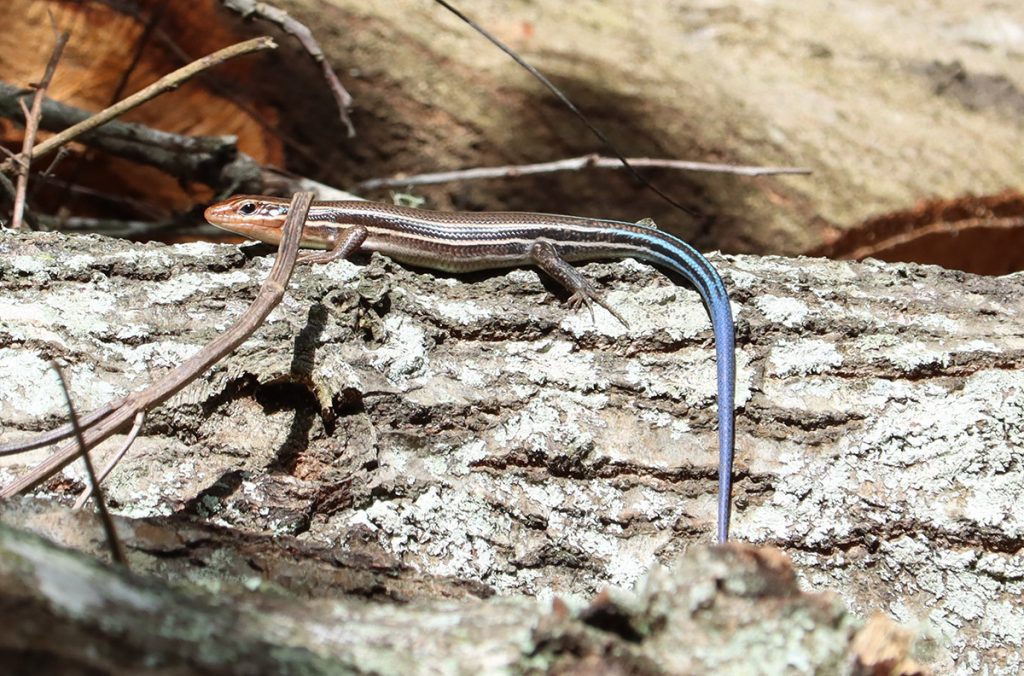
And here, for the third time in four days, this skink is atop the same log. The only other time I’d seen them stand their ground like this, we saw baby skinks a few days later. Not that I got too close- I’m not trying to scare her off. But I normally snap a photo from a certain distance and then slowly walk a little closer, which is usually more than enough to send a skink running off.
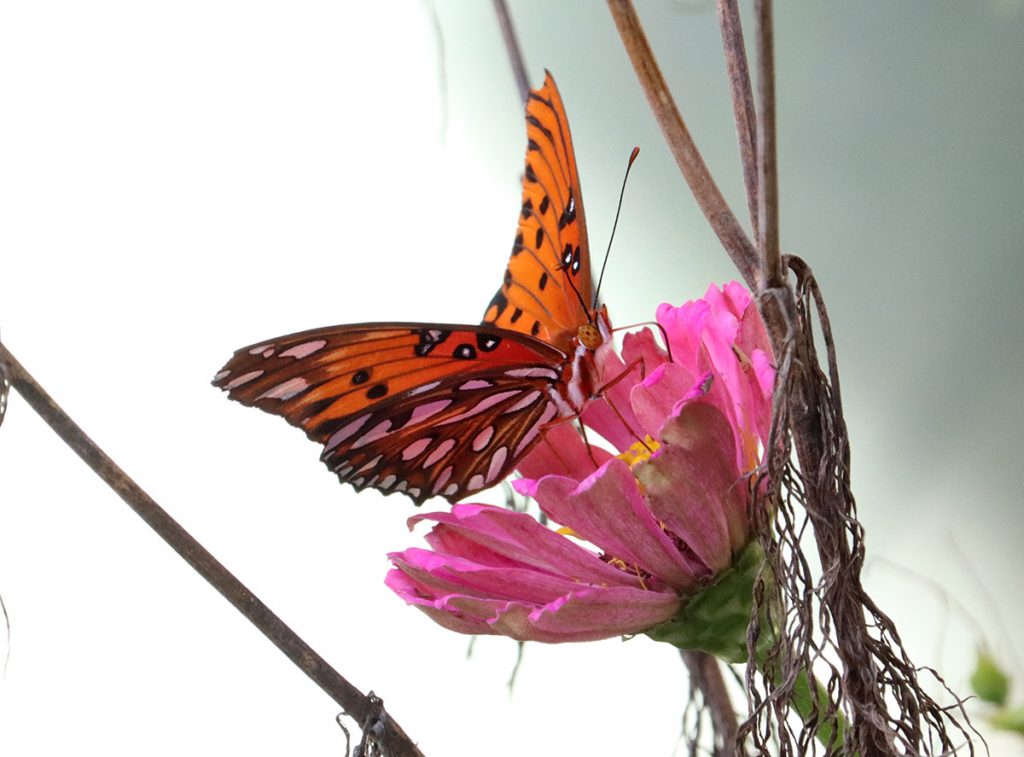
It has been a slow year for butterflies in the yard. I spotted this gulf fritillary in the yard a couple of days straight, which is the first and last I’ve seen of this common species here this year.
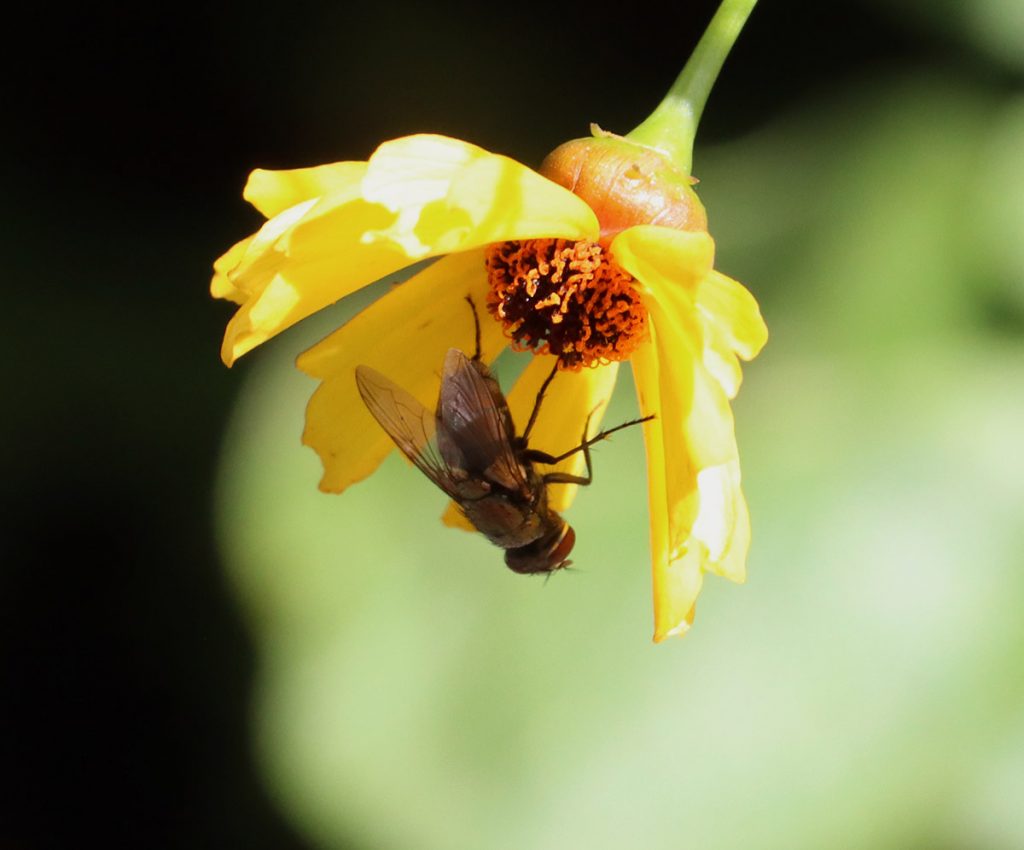
Of course, bees and butterflies aren’t the only pollinators.
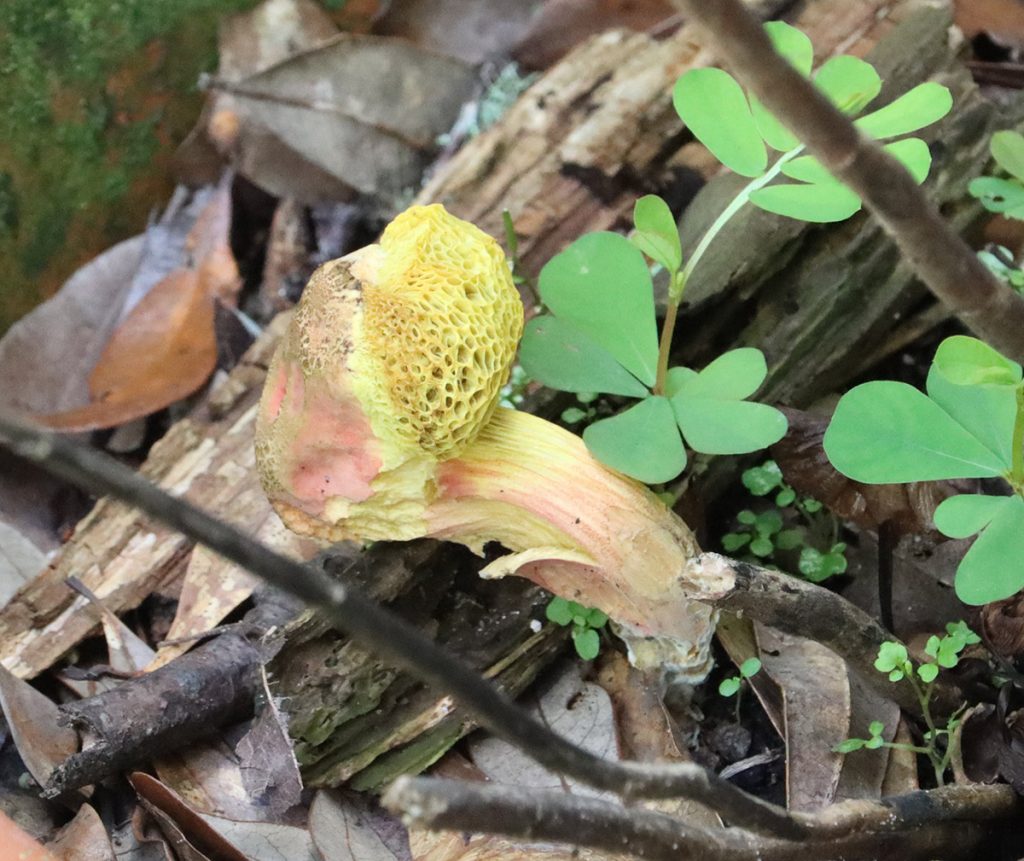
I don’t think this mushroom fully formed, or perhaps it was partially eaten. There does seem to be some tearing. But the spongey undersurface and the colors look like a bolete, which are edible, and so it may have provided a snack for an animal before I saw it.
Four days ago, I saw second instar caterpillars on these plants. I didn’t notice them in the mean time, but two of them have gotten nice and big. The first instar caterpillars I saw in the other patch have disappeared, though. Twice now, this patch has proven more successful than the other. But those are potted plants, and so I might try moving them around.
June 29, 2021
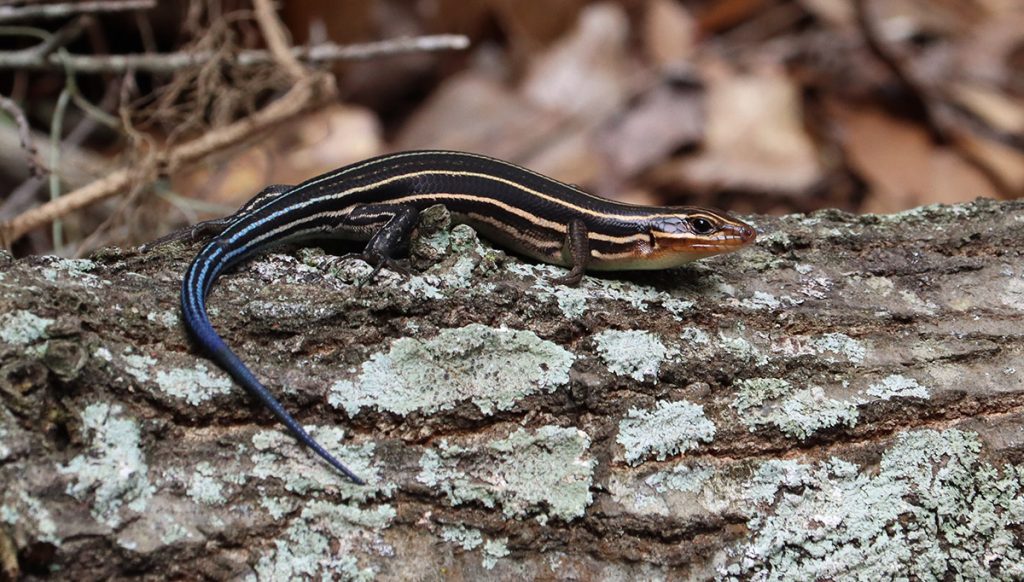
The skink was perched atop her log again. That’s twice in three days that she’s seen me looking at her and hasn’t run off.
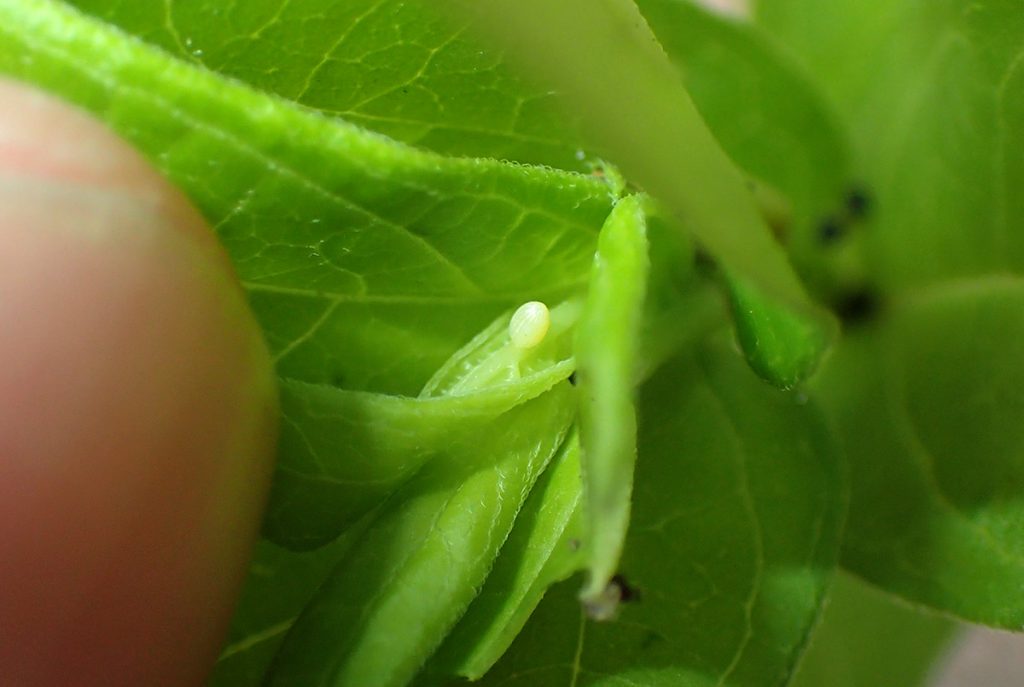
I was looking for the monarch caterpillars I saw a couple of days ago when I spotted this egg. I didn’t see the caterpillars, so I wonder- are they hiding, or have they been eaten? The last couple of years, I’ve noticed smaller caterpillars that seem to disappear, and when I next see them they’re fourth or fifth instar. Staying inconspicuous is a good survival trait for an animal lacking other defenses.
June 28, 2021
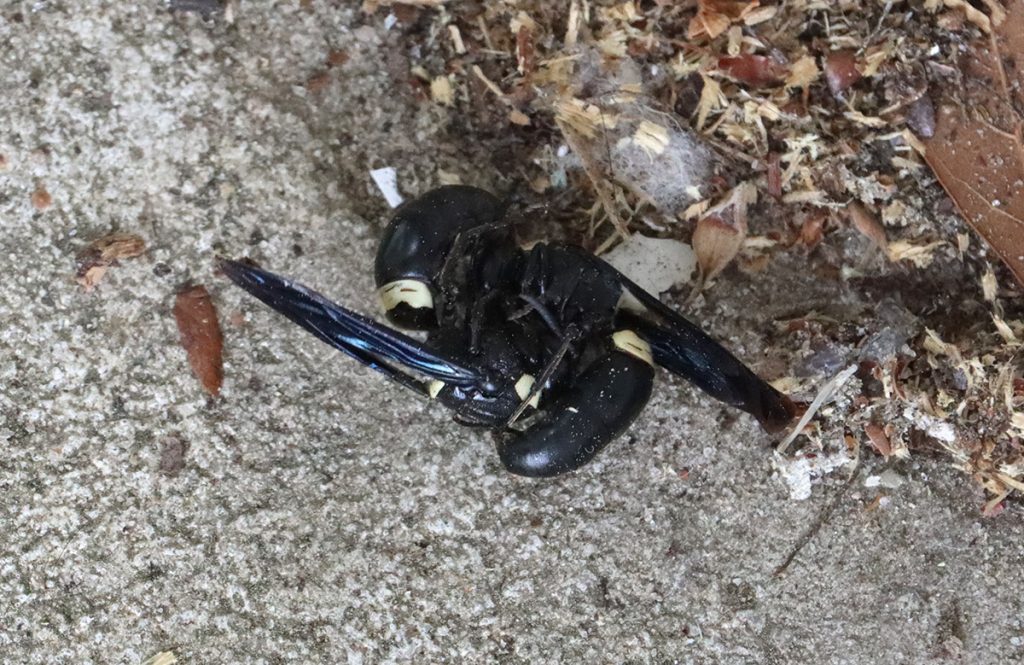
I saw this skirmish under a long time four-tooth mason wasp nest on our back railing. This doesn’t look like mating to me, so perhaps a couple of wasps for fighting for control of the burrow. They don’t make their own, instead using abandoned carpenter bee nests. So I can see where an unoccupied nest might be valuable real estate.
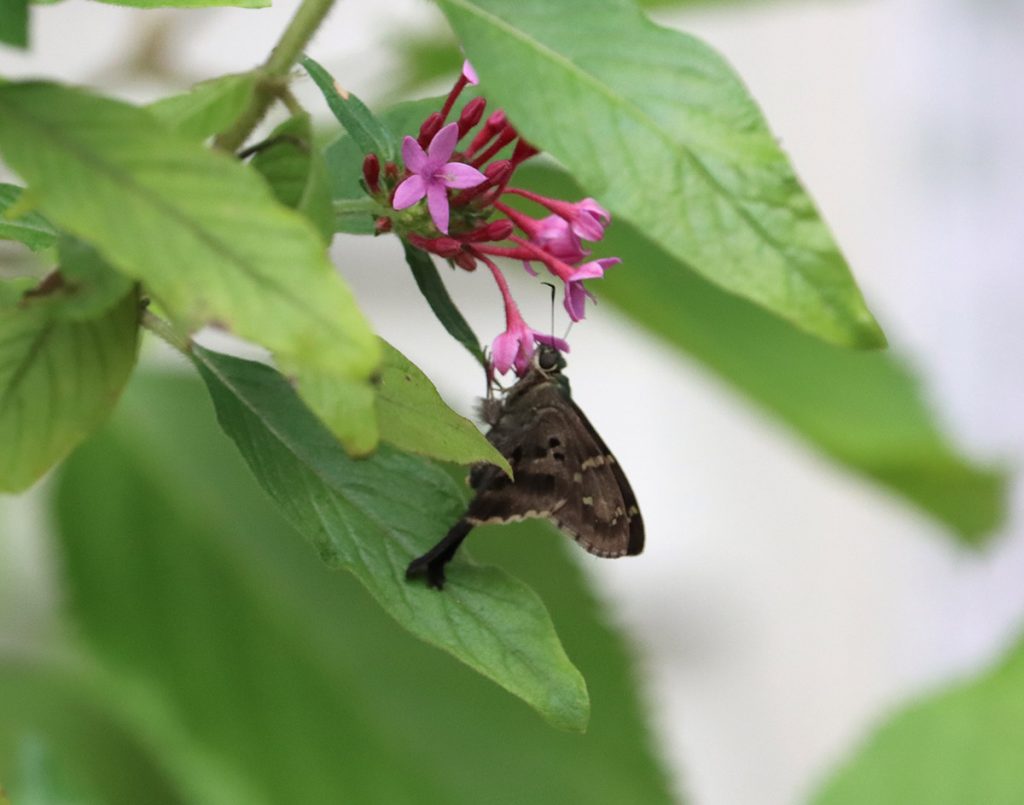
This is the second time I’ve seen a long-tailed skipper in the last week. Looking over the May 2020 Backyard Blog, we had both adult and larval long-tailed skippers much earlier last year. But that’s consistent with the way this year has been unfolding regarding butterflies. I’ll keep an eye on our bean plants for the folds their caterpillars make.
June 27, 2021
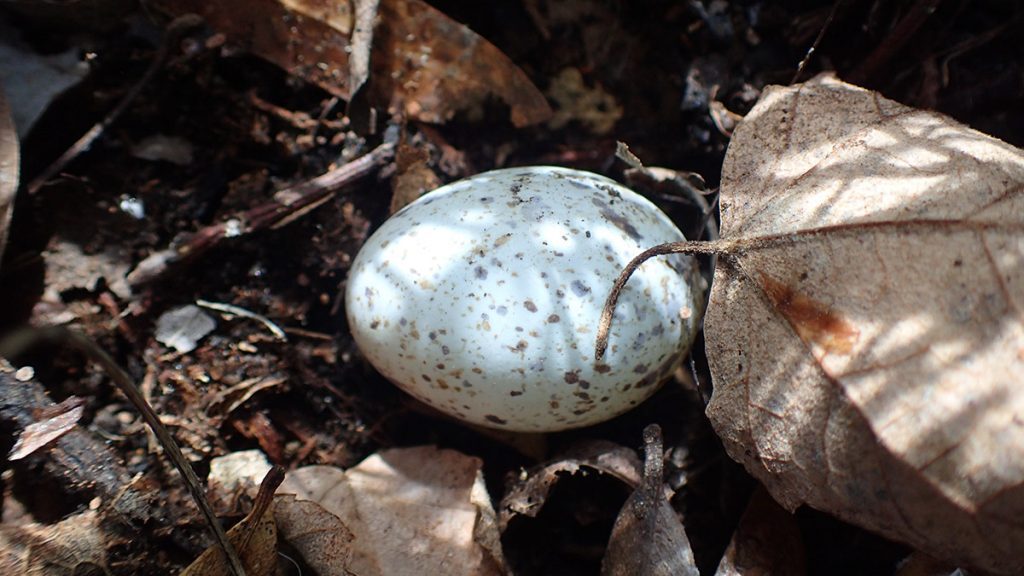
I was weeding in an area with a thick layer of leaf litter when I found this egg. I puzzled over it until I remembered weeding this bed yesterday, and seeing a broadhead skink here. Did I find a partial nest? reading up on skinks, I see photos of larger clutches of eggs. I wonder if there are more eggs nearby, and move my weeding away from this part of the bed.
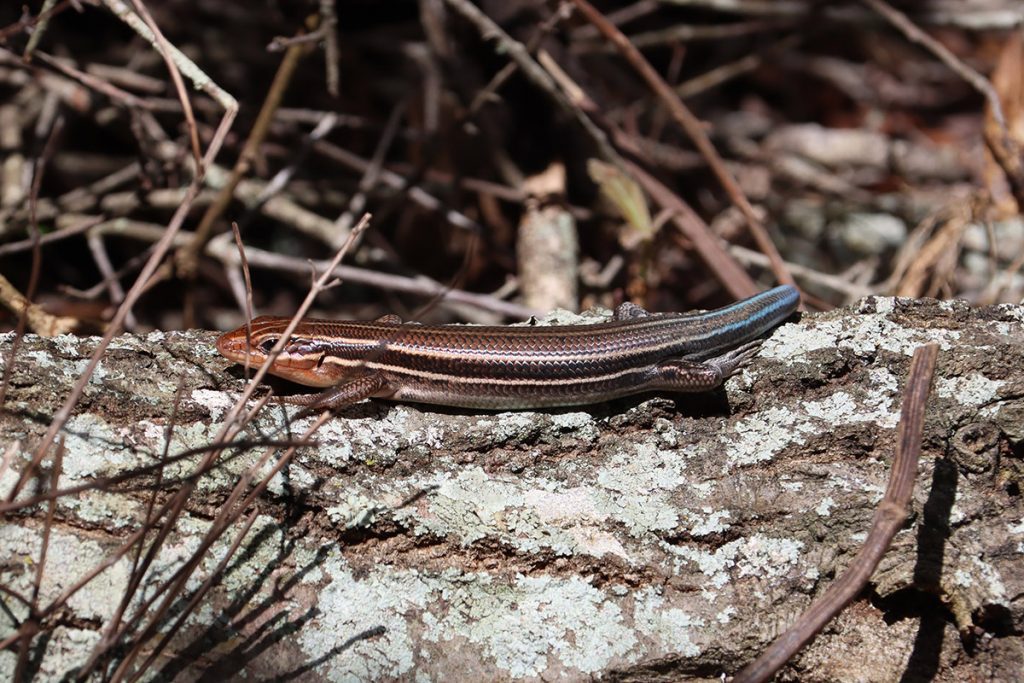
Later on, I see this skink perched on a branch from our fallen oak. I put a few of the branches on a brush pile, and this seems like a likely nesting spot. Skinks in our yard are typically shy, except, like last year, around that time when we’ve seen young (last year, it was in July). Just before we saw young, a female skink perched on a back step and I took my best ever photos of a skink. This won’t be the last time I see this skink perched here.
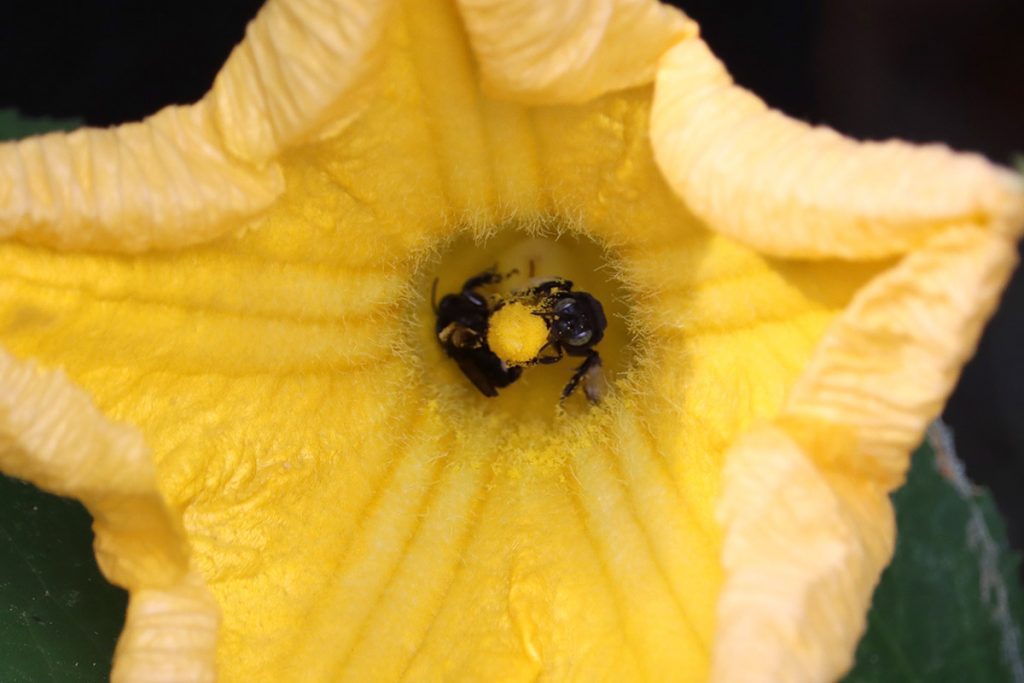
I was trying to get a shot of a longhorn bee in a Seminole pumpkin flower, when a second one flew in. Until then, I’d only seen one of these bees in our yard. Since then, I often see two. We peaked at four last June.
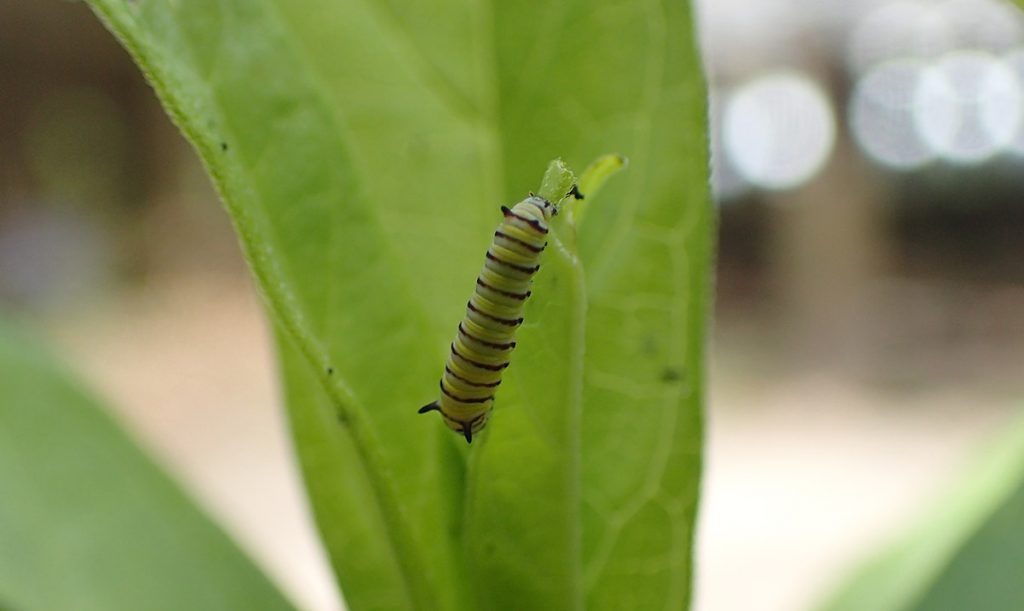
We have two milkweed patches in the yard, and I’ve now seen caterpillars in both over the last couple of days. As far as I can tell, we only had one survivor from our first wave of monarchs a few weeks ago.
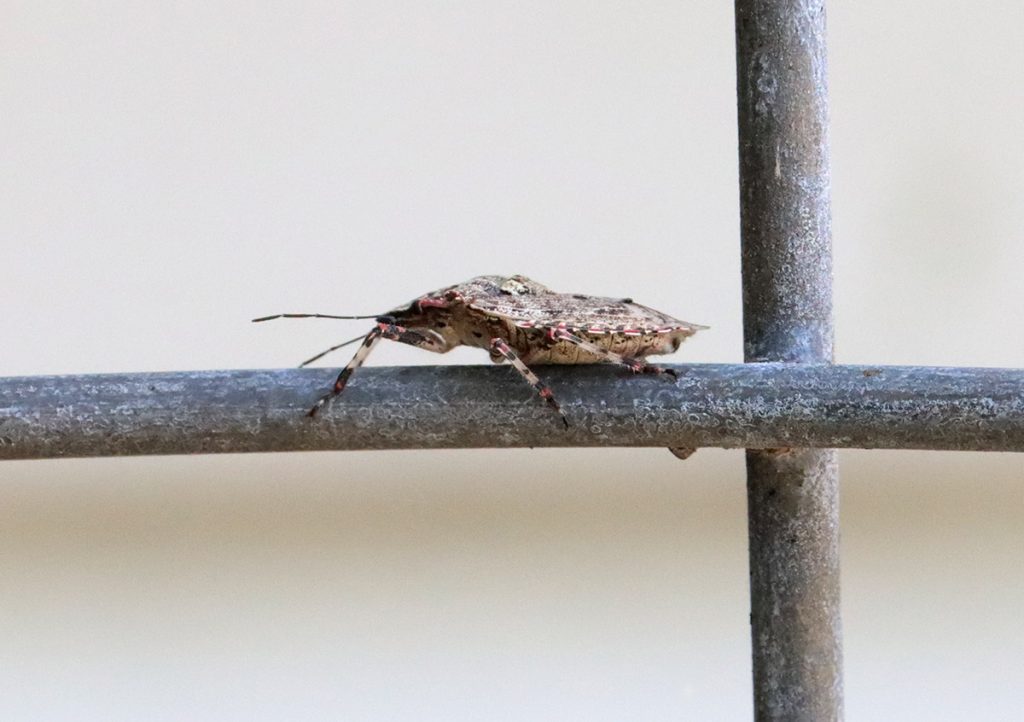
Here’s a stink bug species I see in our year year after year. I had never had a specific iNaturalist identification on one of this stink bug’s observations. I went back to one of those and clicked compare, and I now see Brochymean arborea as a rough stinkbug that has been identified in our area. Maybe that’s what this is?
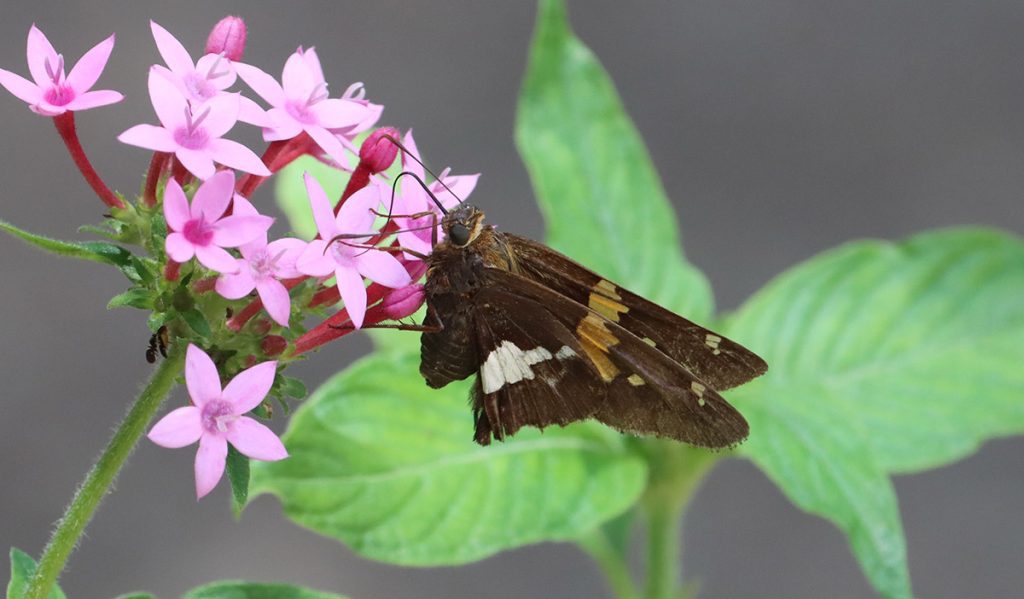
We haven’t had a ton of butterflies in our yard this year, which I’m seeing people say in north Florida/ south Georgia Facebook groups I’m in. This one has been a regular for us here in June.
June 26, 2021
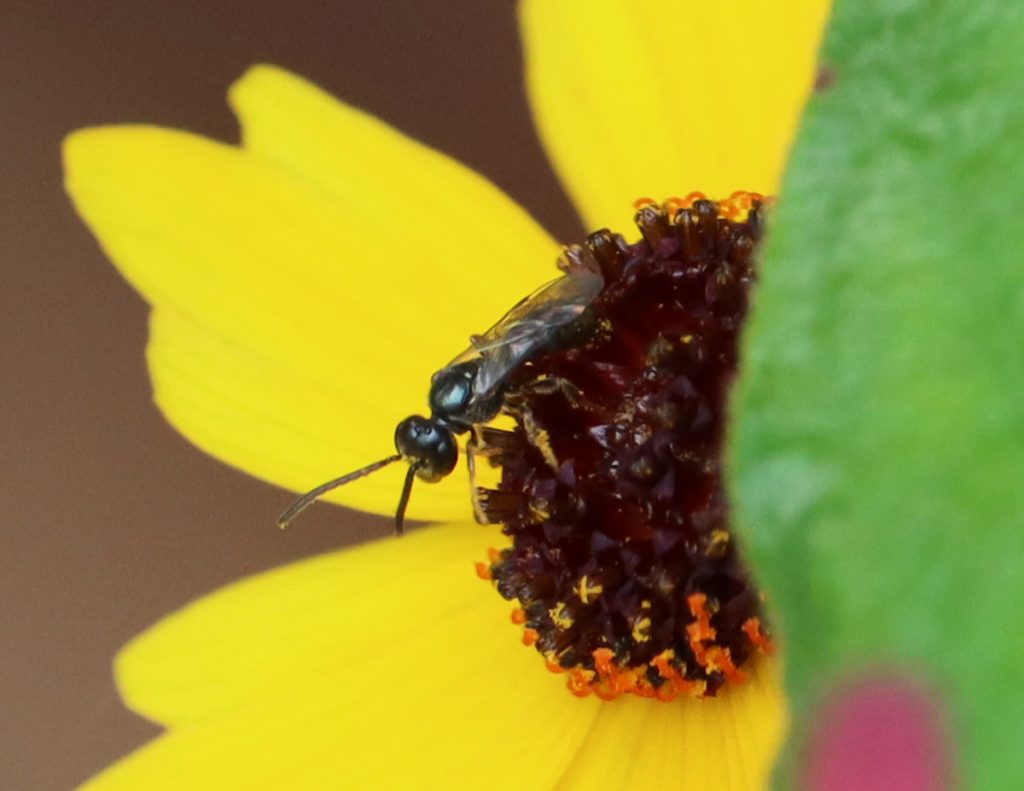
This is the Coreopsis plant I bought one year, and which reproduced in a few different spots in the yard. It’s a favorite of sweat bees, as we see here. The plants had been blooming nicely until a few weeks into dry conditions. Now, they’re flowering again.
Also on one of this plant’s flowers is a predator that looks more than capable of making a meal of small sweat bee.
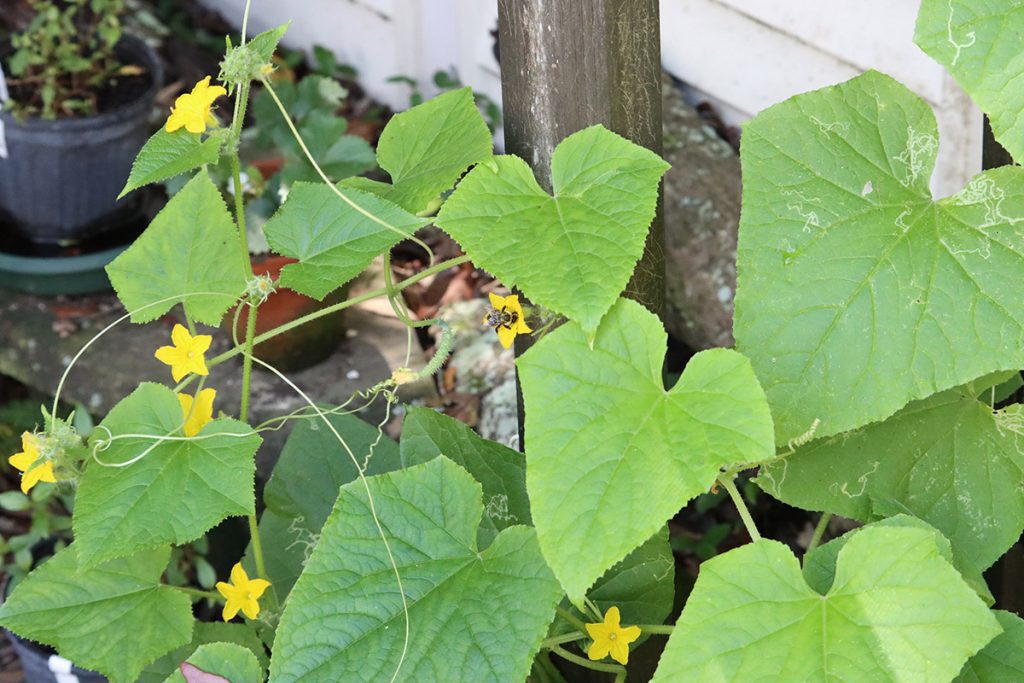
Despite the harsh conditions for much of the spring, it has been a good year for tomatoes and cucumbers. One reason is this bumblebee visiting cucumber flowers daily.
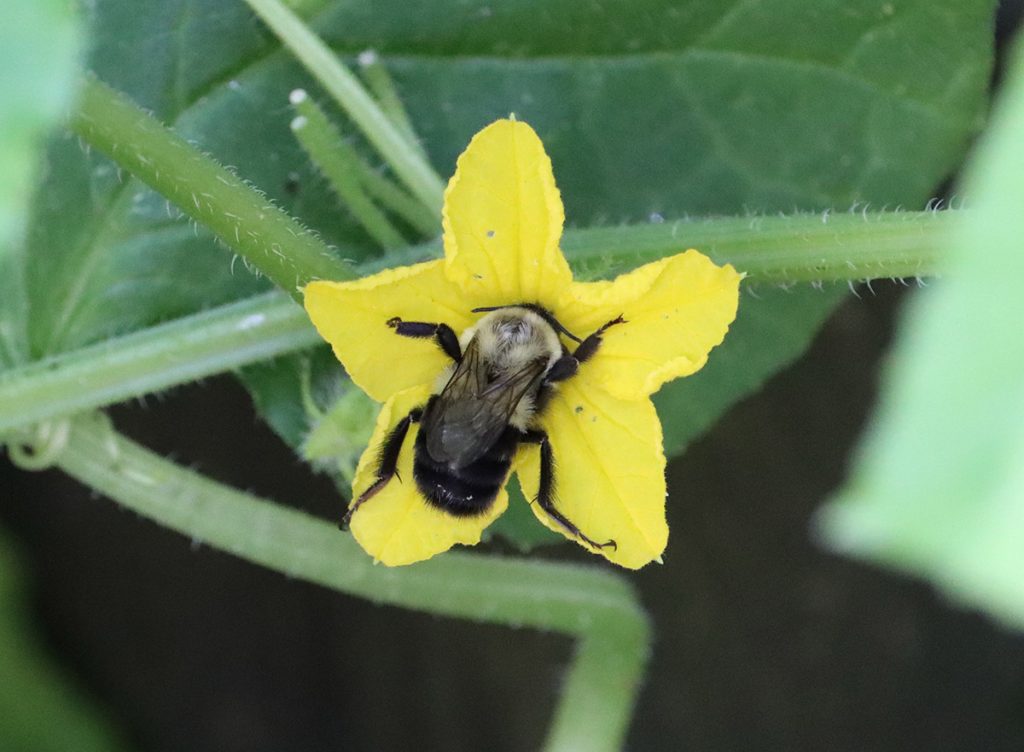
This variety seems to have had no problem making flowers in the dry, hot times. Our pepper plants, on the other hand, are getting big and leafy, but mostly didn’t make flowers until we started gettin rain. I need to write down what varieties of what fruits and veggies do well in dry conditions.
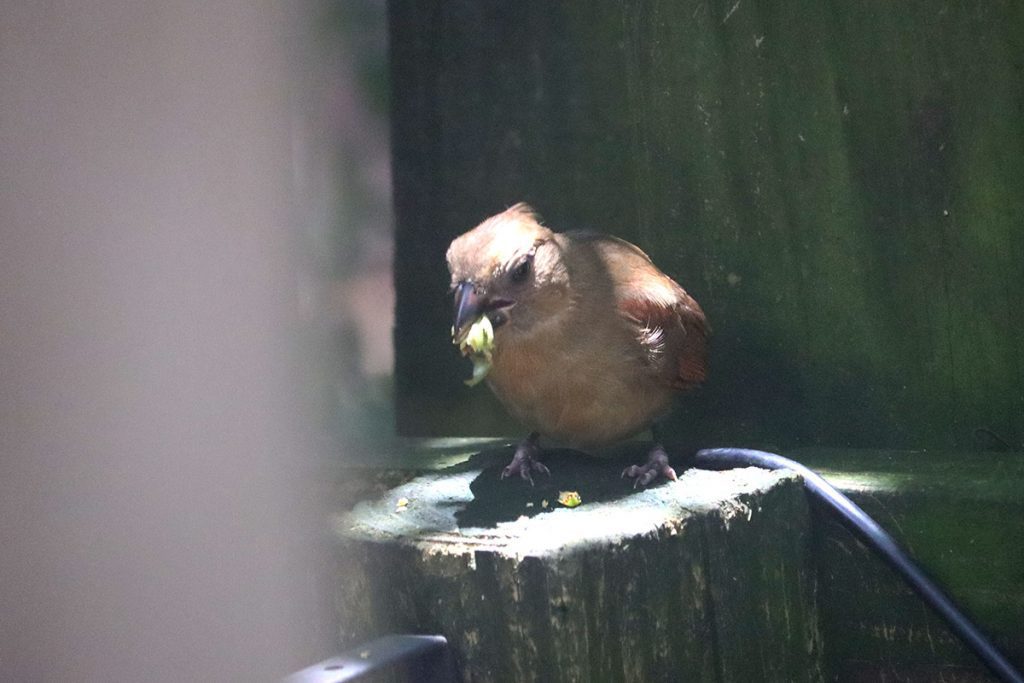
I’ve been seeing cardinals with recent fledgelings around the yard. There’s a way that fledgelings quiver, and their parents still feed them beak to beak. Here, I watched a fledgeling out the kitchen window, attacking this green something. I thought maybe it was a caterpillar.
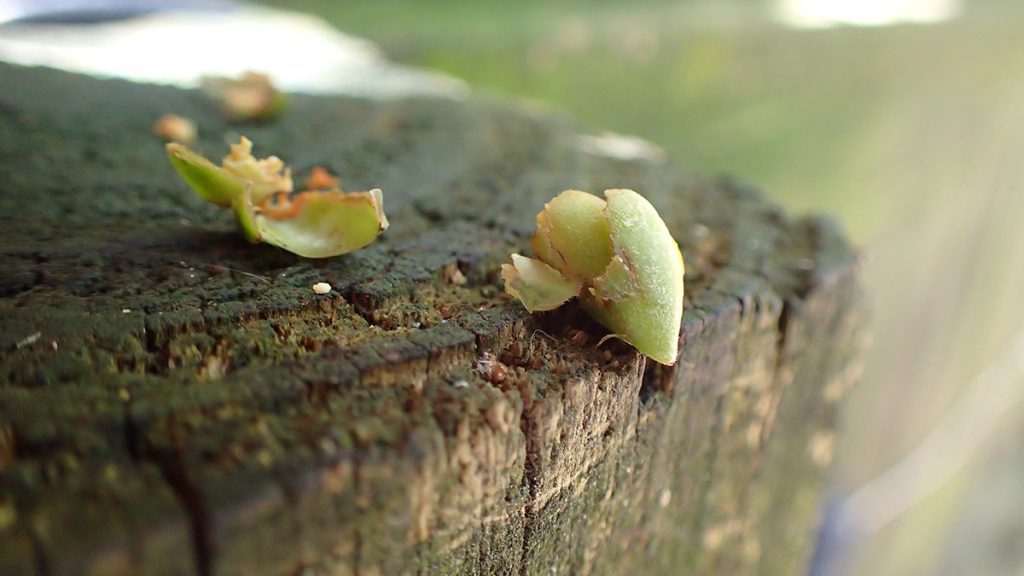
It flew off, and I went out to get a closer look. Baby songbirds eat insects almost exclusively, because they’re soft and easy to eat. As they grow older, they incorporate seeds and berries into their diets. The fledgeling tried out this not-yet-ripe fruit, and really worked at it.
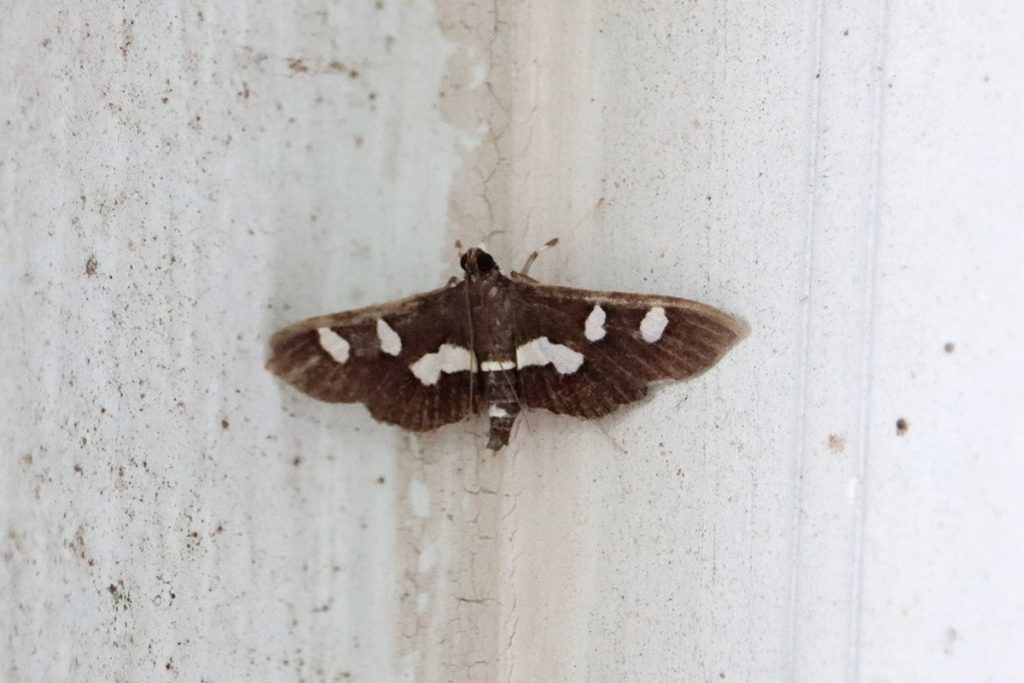
I saw this moth on the porch. Their larvae host on grapevines, redbud trees, and evening primrose.
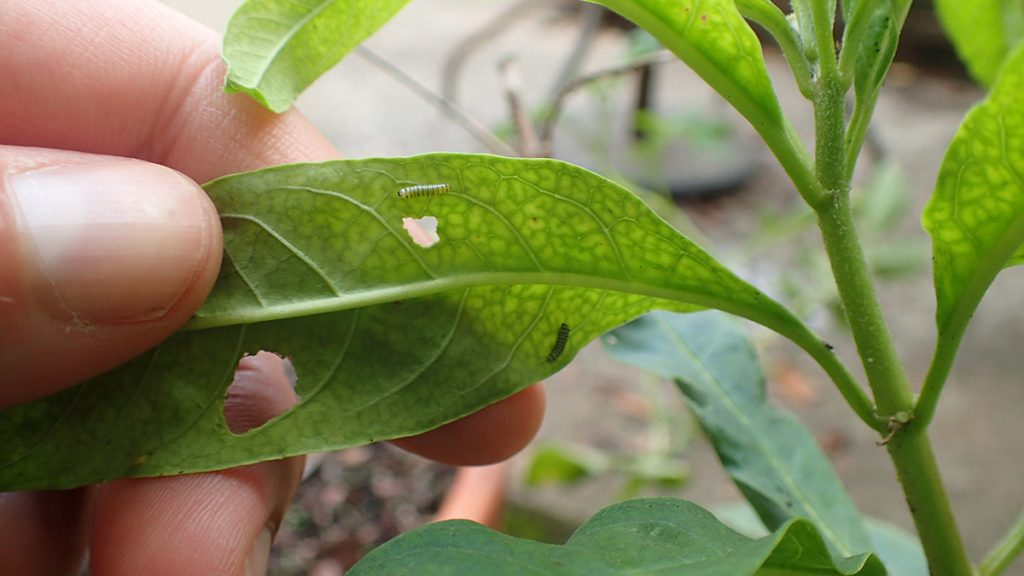
And, lastly, a couple of first instar monarch caterpillars under a milkweed leaf. In the coming days, I’ll see paper wasps patrolling these plants.
June 25, 2021

I sometimes let milkweed aphids get out of control on our plants. That may be why we see so many of one of my favorite types of insect, the hoverfly. I’ve seen a few species of syrphid fly in our yard, either pollinating flowers or, as one is doing here, hovering where aphids have gathered. It flew closer, right up to the pods, and then back again. I didn’t see it curl its abdomen this time, but she was likely looking for a spot to lay eggs.
A few days later, I see syrphid larvae feasting on these aphids.
June 24, 2021
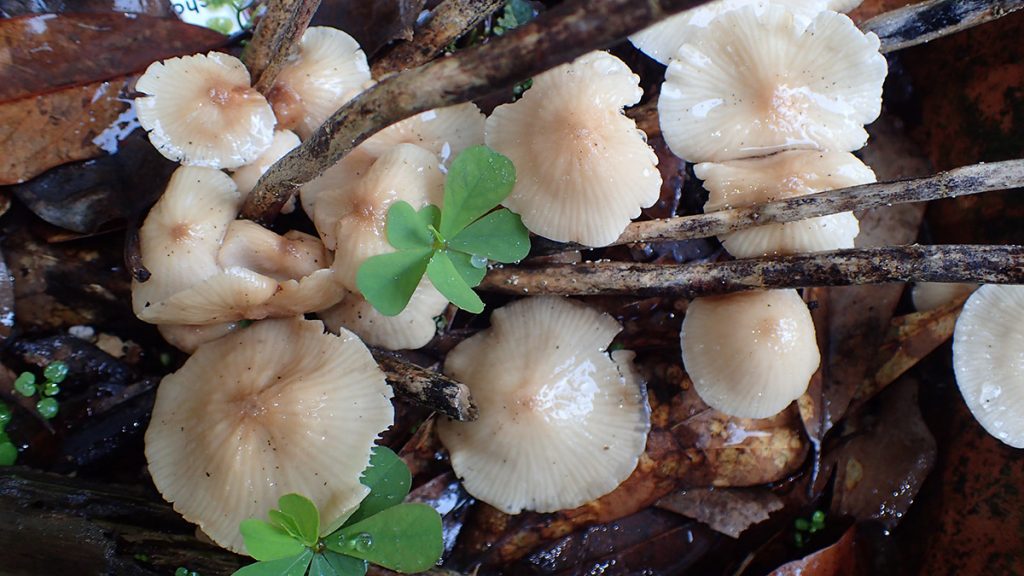
More rain, more mushrooms. I’m pretty sure that this is in the Gymnopus genus. These are growing at the base of blue curls stalks. The plant died back last winter and still hasn’t resprouted, unlike the other wildflowers that grow back from their roots. Have this plants’ roots rotted, consumed by these mushrooms?
The mushroom I tried to identify a couple of days ago was also growing where a plant was regrowing from its roots, and then died during the drought.
Here’s a look at its gills.
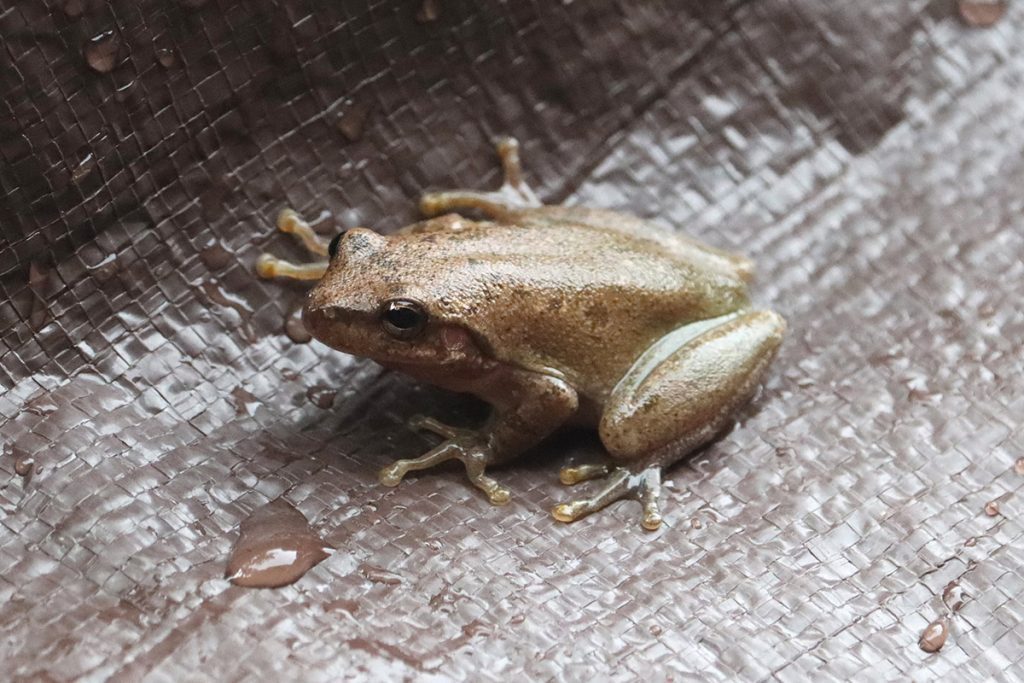
This tarp covered one of our cars as it awaited a rear window replacement. Squirrel tree frog can be green or brown, and this brown frog found a nice place to sit where it could blend in. My first thought was that this was a Cuban tree frog, an invasive. Luckily, it’s not that.
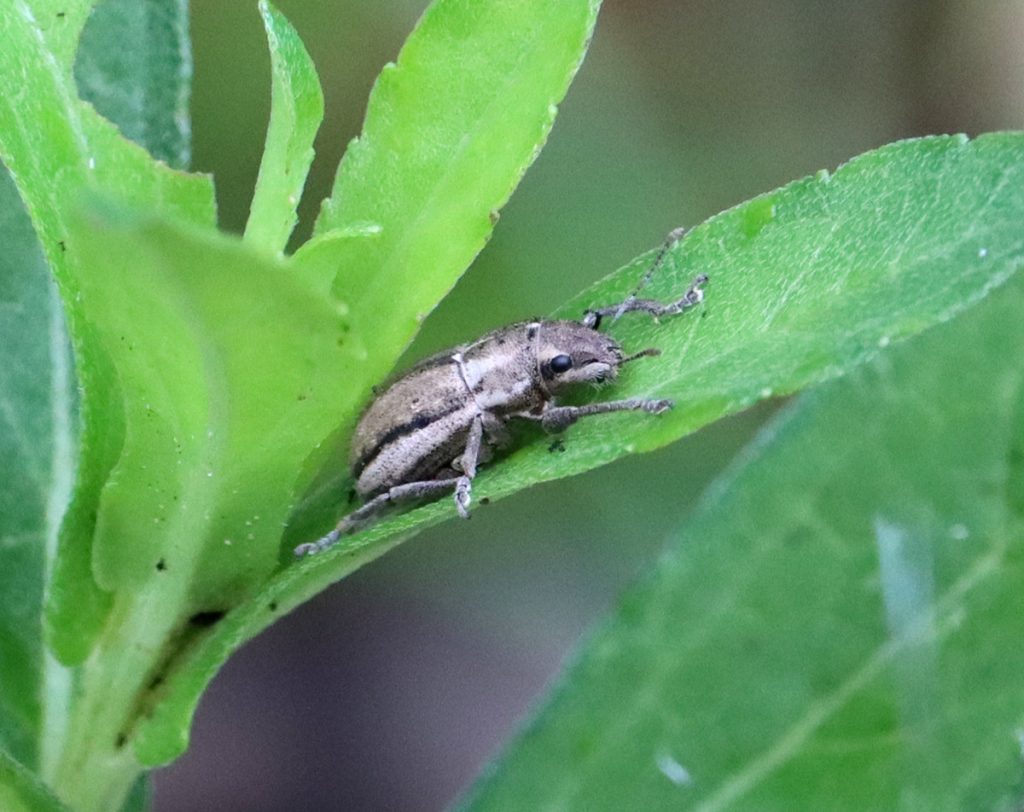
This was resting on a Silphium leaf. Weevils can become serious agricultural pests, but this is a single occurrence of a native plant eater.
June 22, 2021
After several dry weeks, we’re seeing rain. And with rain come mushrooms. I was intrigued by this one growing in our flower patch. It looked kind of like a fried egg with a purplish discoloration at its edges. I consulted the Mushrooms of the Gulf Coast States field guide, and I wasn’t confident with my selection. I haven’t had a ton of luck with mushrooms on iNaturalist, but it’s always worth a try, even if just to give me new options to look up in the book.
Its top recommendation was a surprise, to say the least- Psilocybe cubensis, common name Magic Mushroom. Yes, that mushroom. I don’t think it’s that either, and no one has confirmed it yet. The biggest reason I don’t think it’s a magic mushroom is that, per the guide, they grow in herbivore dung, especially cow dung. I mean, maybe a squirrel pooped there. And I’m nowhere near a cow pasture.
June 19, 2021
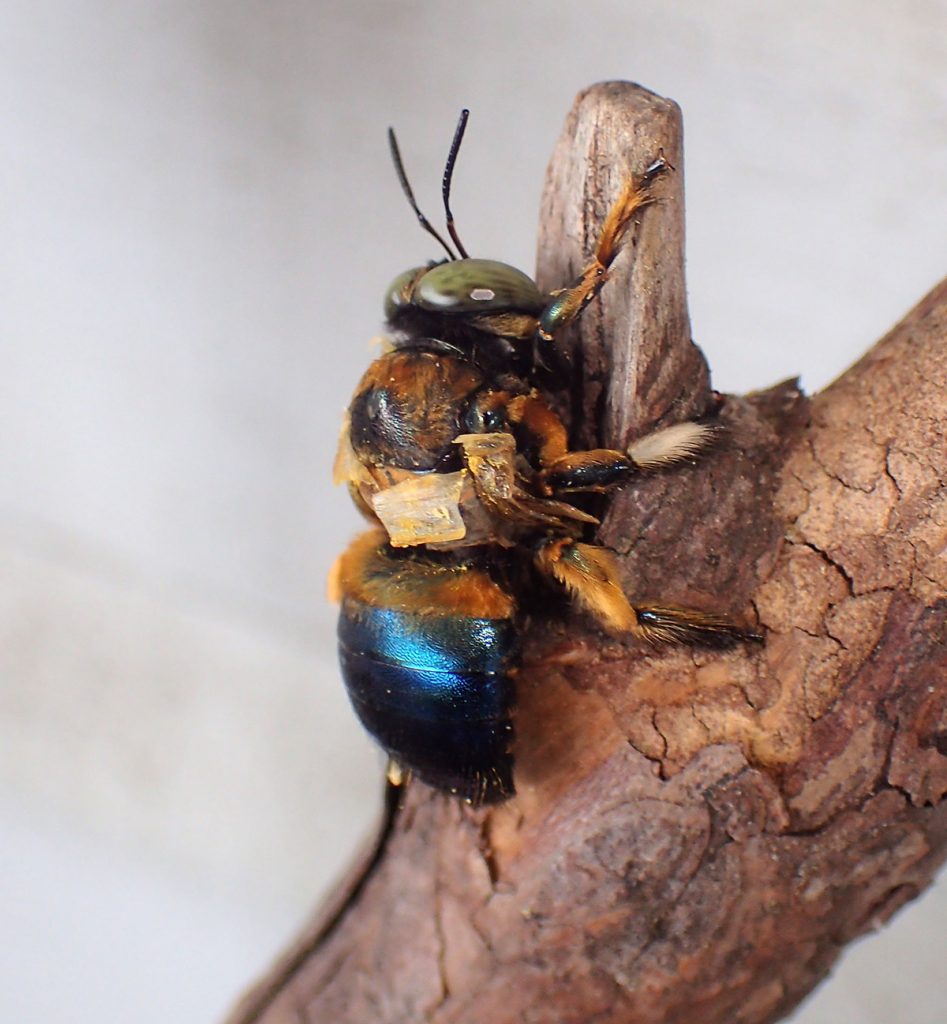
A few months back (February 27), I found that a southern carpenter bee had made a nest in a stick on our porch. This was one of my sons’ special sticks, collected in nature, that I arranged with other found objects of theirs, such as dried flowers, rocks, and oyster shells.
Today, we sat and ate on the porch as my father-in-law visited us, and saw this dying carpenter bee. Its wings were torn up, and it crawled up and down the stick. Another bee was moving in and out of the nest. I wonder if we were witnessing the transition from one generation to the next.
June 14, 2021
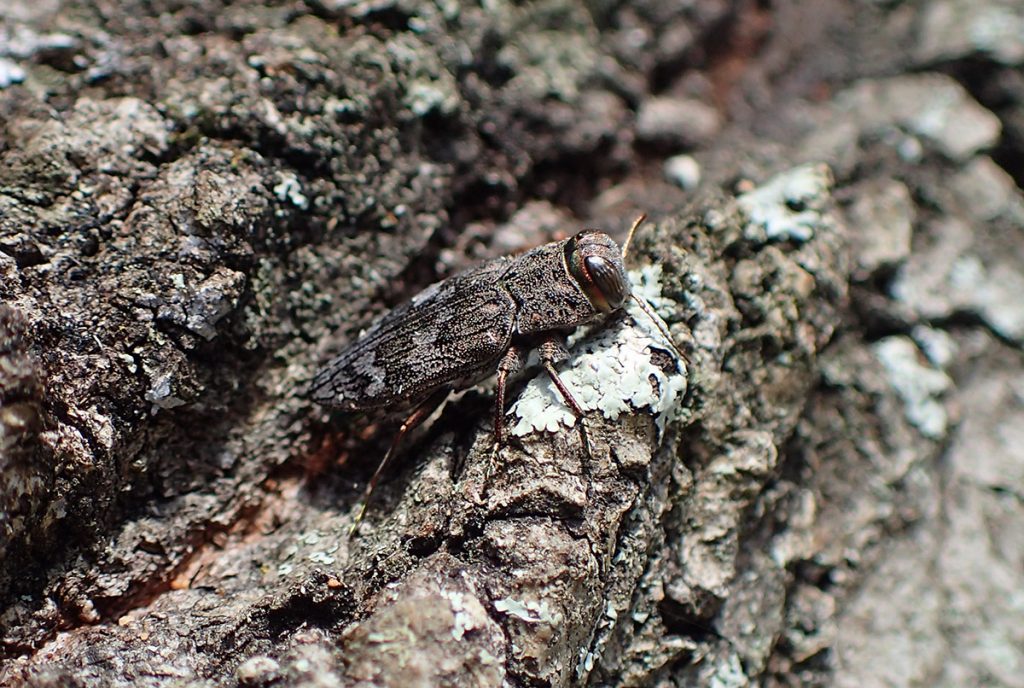
Continuing the cleanup of our fallen oak, I find this guy. Wood boring beetle larvae often eat rotting wood, and judging by the smell of the wood, the trunk had been rotting. I can see a wet discoloration at the center of some of the trunk segments. This insect is not a cause, but a symptom of the tree’s failure.
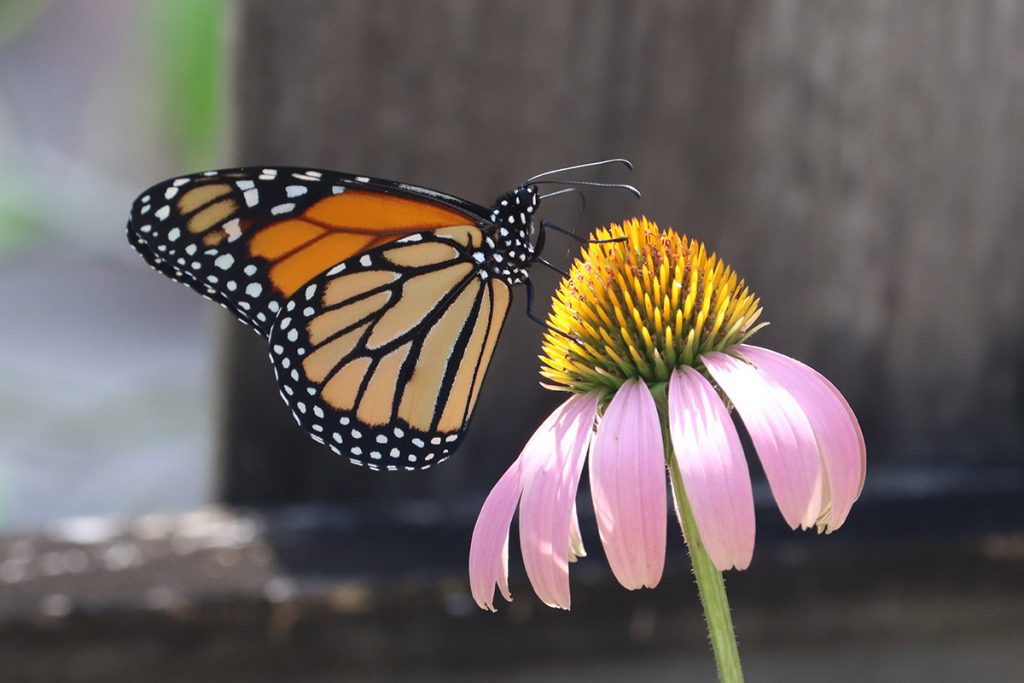
Before yesterday’s rains, I had noticed that the coneflower petals were starting to wilt. Today, all of our plants (except that oak) are looking happier than they have these last few weeks. Here we have a fresh looking monarch. It has been a couple of weeks since that large monarch caterpillar snuck off to make its chrysalis. Is it that individual, or a mother come to lay eggs? I’ll keep an eye on our milkweed.
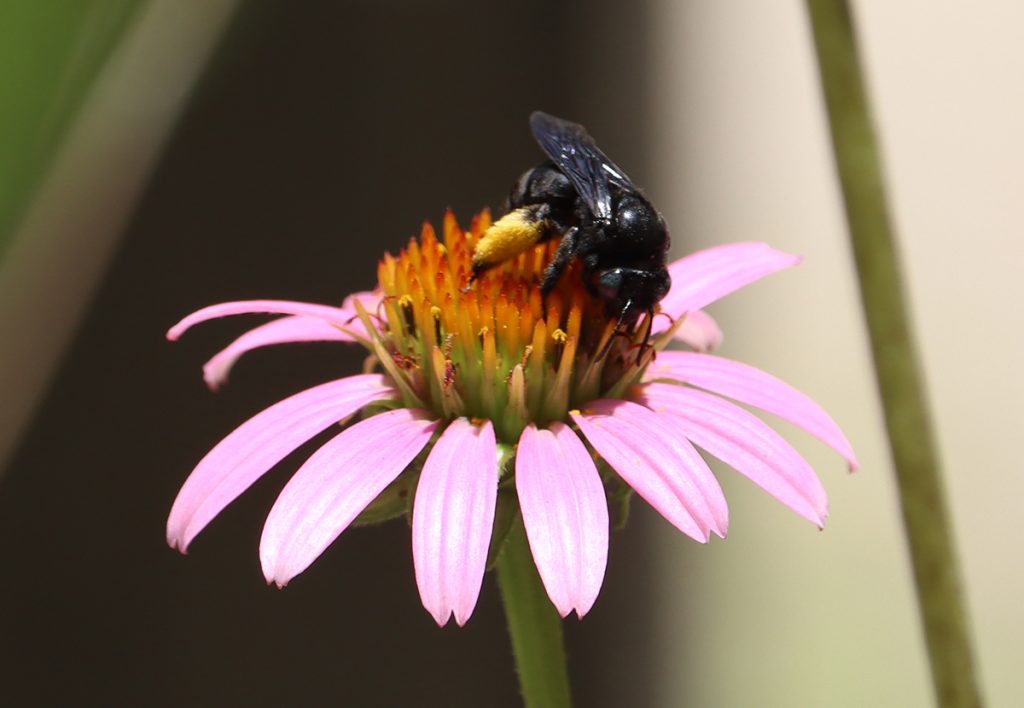
Last year in June, we had three or four of these in the yard at a time. I’m hoping an increase in rain spurs our plants to flower more than they have been, and that we start seeing more pollinators. Today has been busier than what we’ve seen over the last month or so. I also spotted a bumble bee, the small Dialictus sweat bees, and a Poey’s furrow bee.
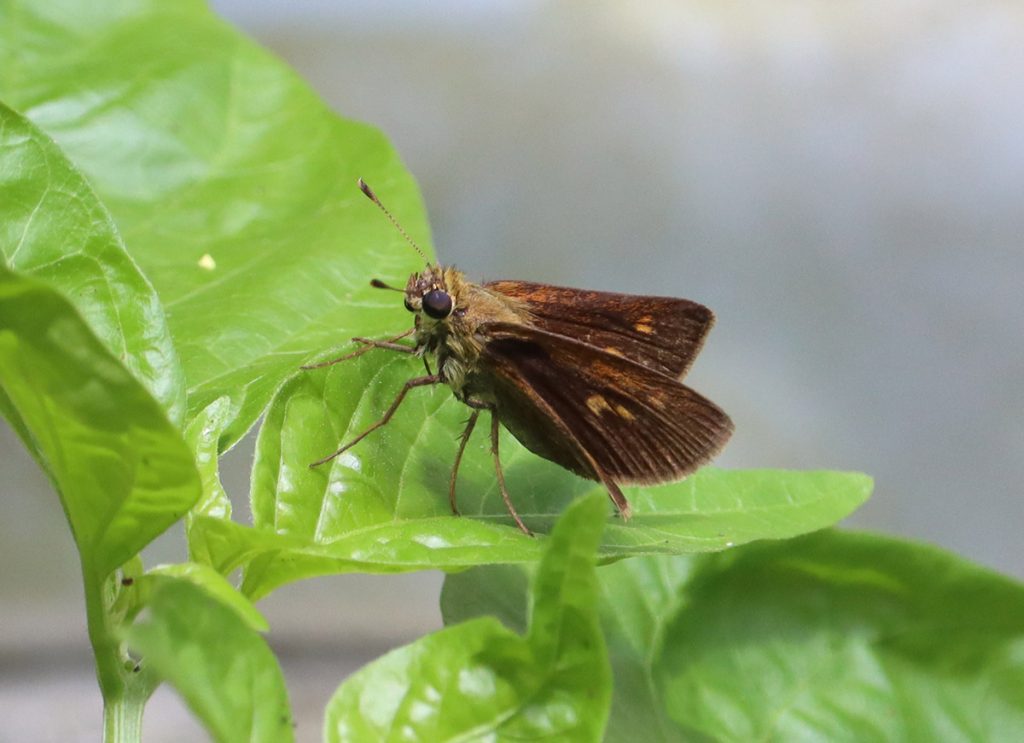
This might be either a southern or a northern broken dash. Fiery skippers, which look similar, are common in our yard. I don’t remember seeing broken dashes in our yard, but I could have easily confused them. I also saw a zebra longwing passing through, and what looked like an American lady moving along our fence. A day after a thorough rain, pollinators are out and about.
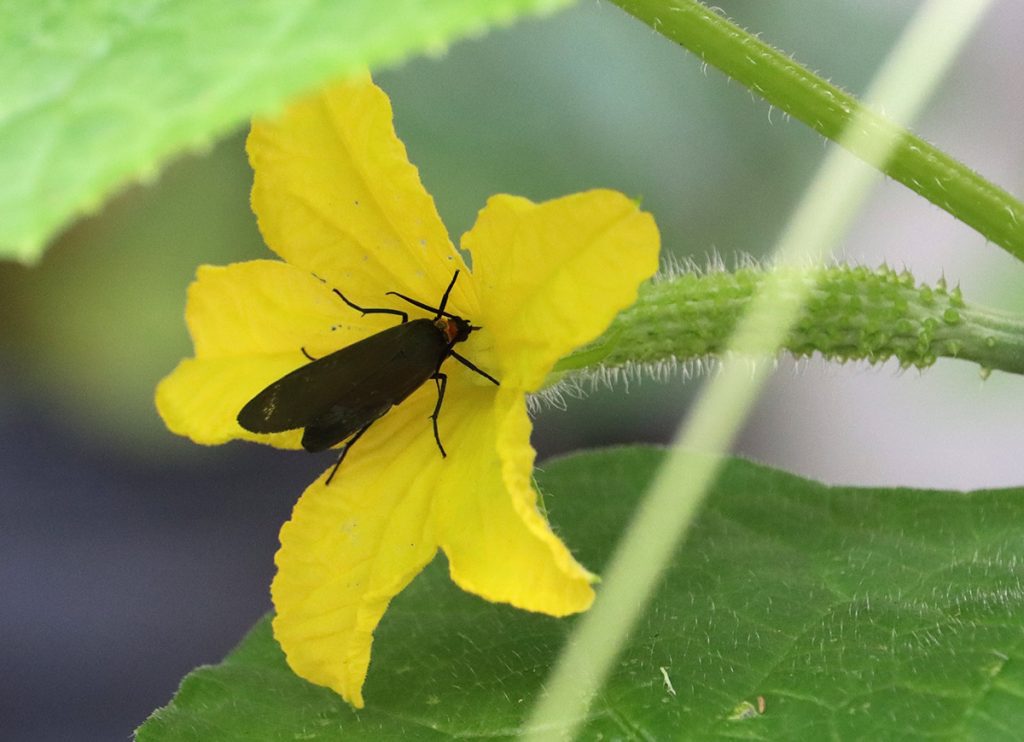
EDIT November 16, 2022– iNaturalist users have recently identified this as Yellow-collared scape moth (Cisseps fulvicollis). This is visually similar to my original guess, grapeleaf skeletonizer. This moth hosts on grasses and sedges.
Here’s the problem- I have two research grade grapeleaf skeletonizer IDs, but looking at a couple of features, I think those are this same species. This was ID’d by a researcher, but were those others? It’s a pitfall of citizen science, but I’m a firm believer that learning is an ongoing process. I’ll review those other observations and update this blog as necessary.
Original text: Here’s a moth I’ve seen in the yard over the years. Its caterpillars host on Virginia Creeper, which I let grow on our fences. I almost didn’t see this one, on a flower sheltered by those large cucumber leaves.
June 13, 2021
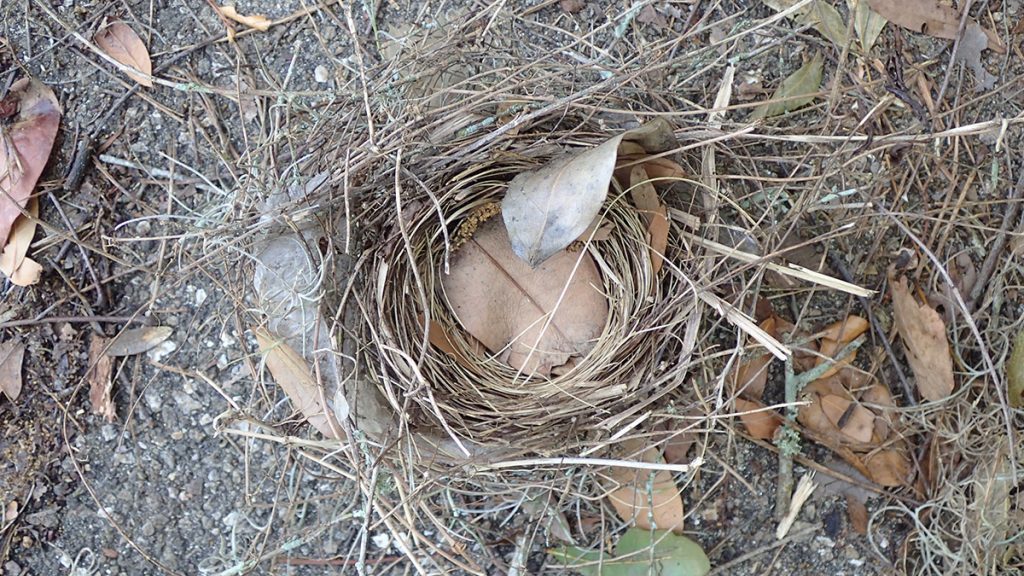
After weeks of hoping for rain, I lay contentedly in bed listening to distant thunder and the gentle pelting of our windows earlier in the morning. Then the ground shook. The largest trunk from our front yard oak came crashing down, and I spent a lot of the day removing debris.
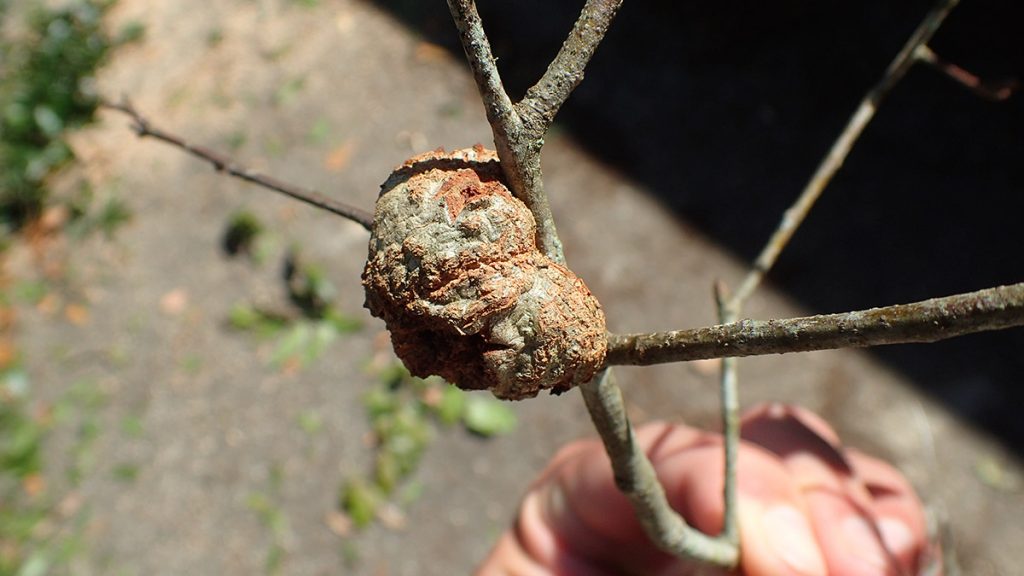
The house was fine, though we had a couple of smashed windshields. Insurance and cleanup headaches aside, I am who I am. I wanted to see if there was anything cool high up in the oak that I wouldn’t normally see from the ground.
I didn’t see anything extraordinary, but there were a few things. A couple of bird’s nests, with no eggs or chicks in them. Plenty of oak galls. If I hadn’t been so busy, I would have taken more photos. I photographed this one because of its size and shape.
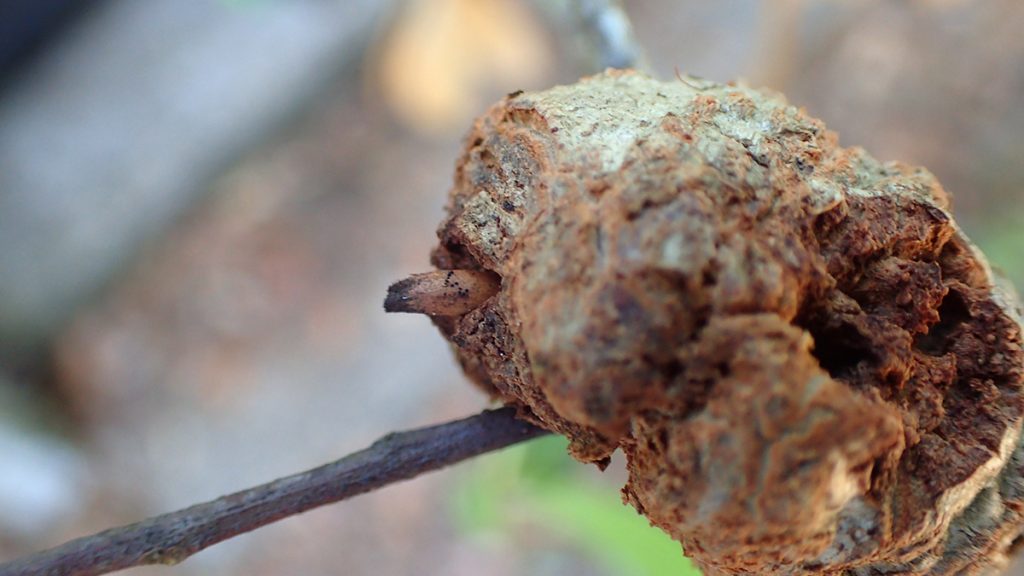
Here’s a closer look.
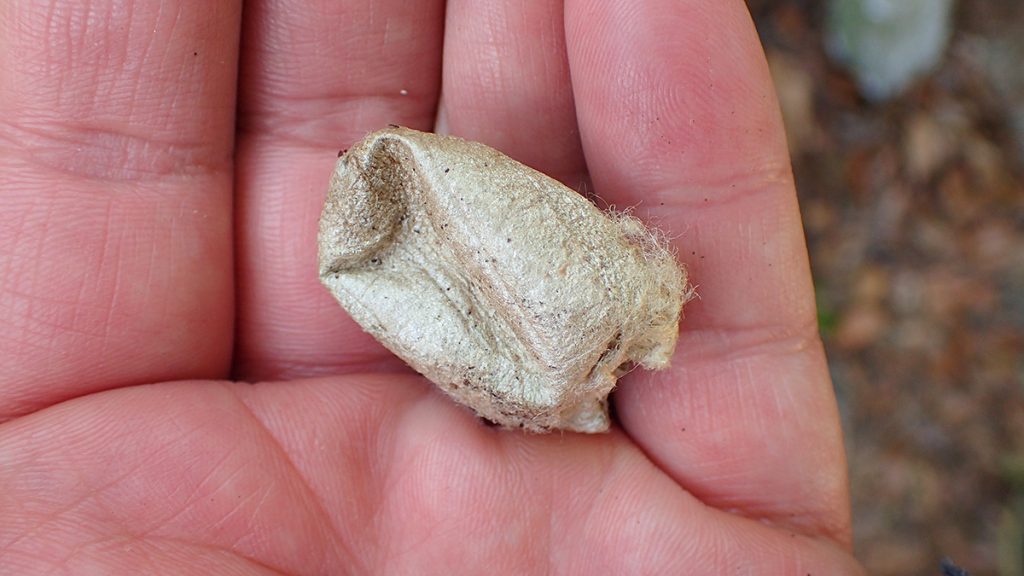
I could spend a lifetime learning what every moth and butterfly chrysalis looks like, every insect and spider pupa or nest structure. Googling “white chrysalis,” I found one that looks like this- a polyphemus moth chrysalis. I did find a polyphemus moth wing in the yard earlier this year, in the shade of that oak tree, actually. Their caterpillars host on oaks, as well as numerous other trees.
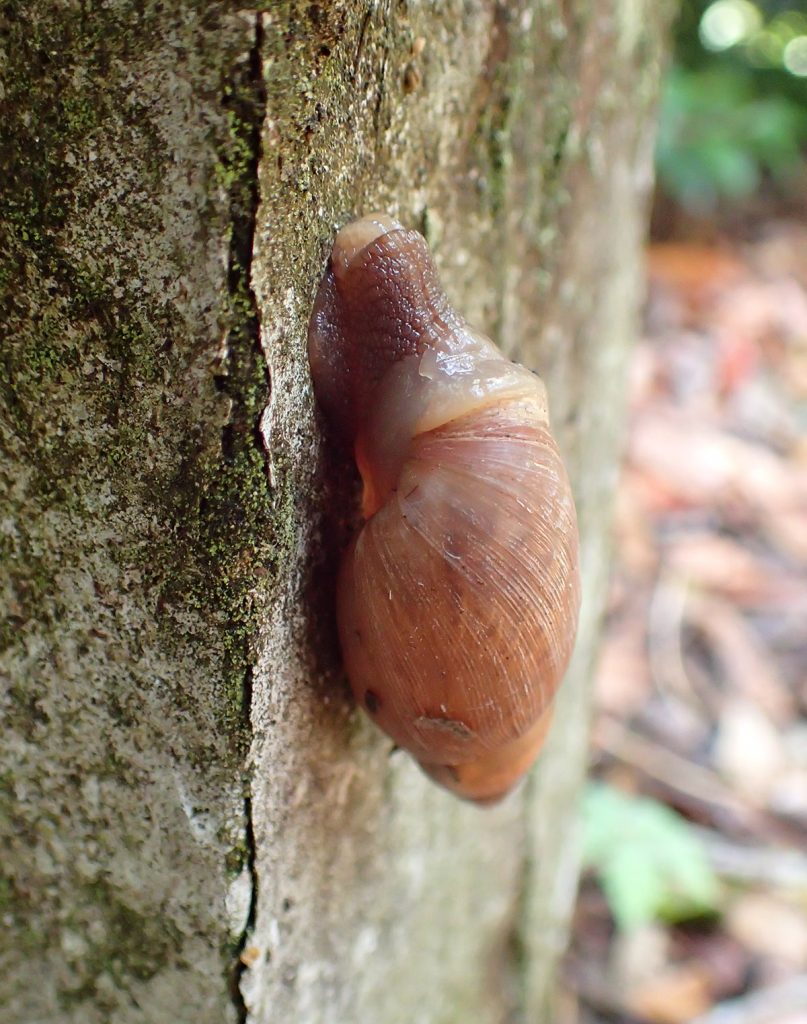
I found this near the tree wreckage, though I’m not sure it crawled out of there. This is a predatory land snail, which hunts slugs and snails. I welcome the rosy wolfsnail to our yard, where snails and slugs like to eat seedlings. I’ve seen them in parks, but never at home before.
June 12, 2021
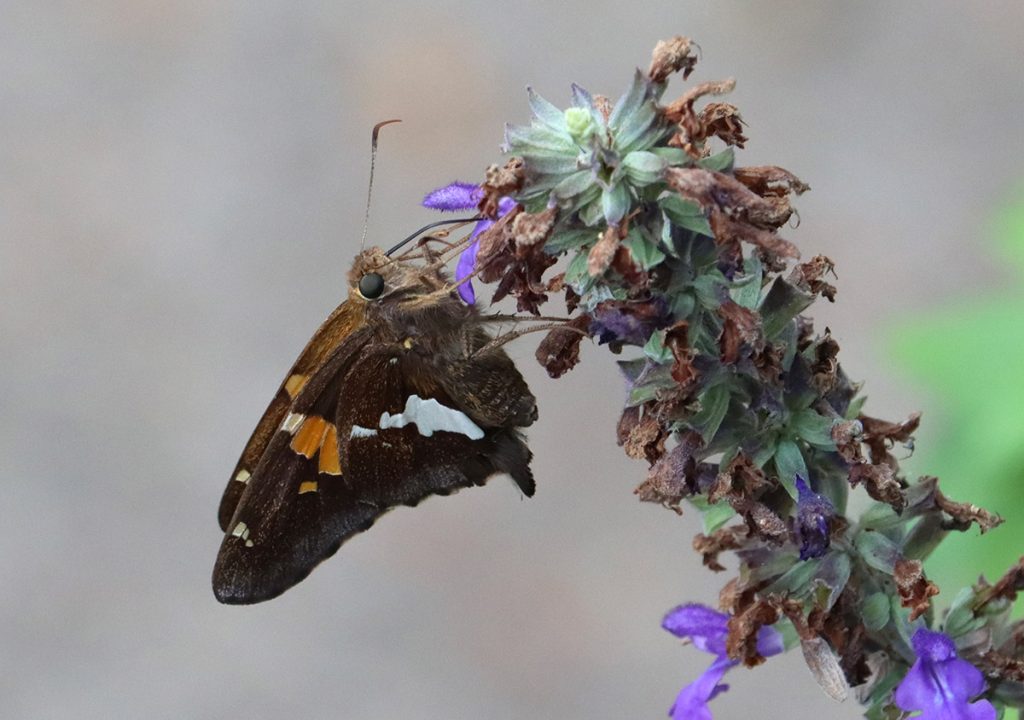
That first spring explosion of wildflowers has faded, and now we haven’t had rain in weeks. The plants have been stressed and I’m not seeing the kinds of blooms I’ve seen in other years. Plants are conserving energy to deal with the hot, dry conditions.
As a result, we’re not seeing the high number of pollinators we saw in June 2020. I was wondering if I saw more last year because I was working from home, or whether our work to make the yard hospitable to wildlife was paying off. Maybe it was both. Anyhow, I was happy to see this silver-spotted skipper hopping around a few of our plants today.
June 8, 2021
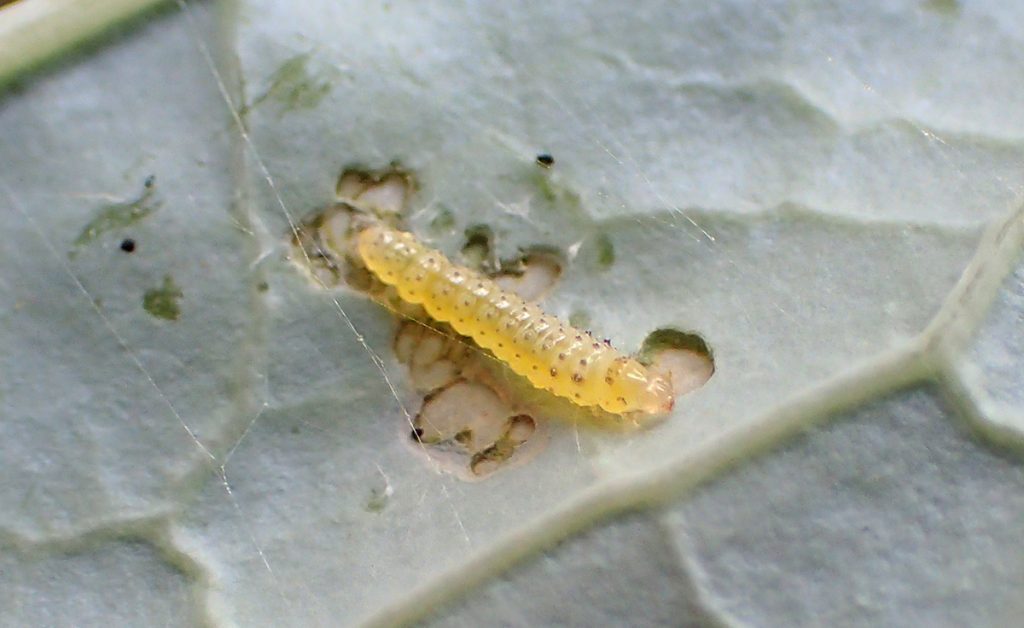
It’s been a couple of weeks since I saw a cabbage white butterfly lay eggs on this cauliflower plant. We’d already eaten the cauliflower from this plant, and I thought I’d leave its huge leaves as an enticement to the butterfly. When one did come and lay eggs, I thought it was a perfect opportunity to document its life cycle.
But then I didn’t see caterpillars on the leaves. Until today. I’m pretty sure, though, that this is a cross-striped cabbage worm caterpillar. This is a moth, and hey, I try not to place more value on butterflies than moths. These particular moths have been more numerous on plants than when we had cabbage white caterpillars, and they did ruin a cauliflower and go after our kale and bok choy. I’m forgiving when it comes to caterpillars, but these are pests (from my human point of view).
June 1, 2021
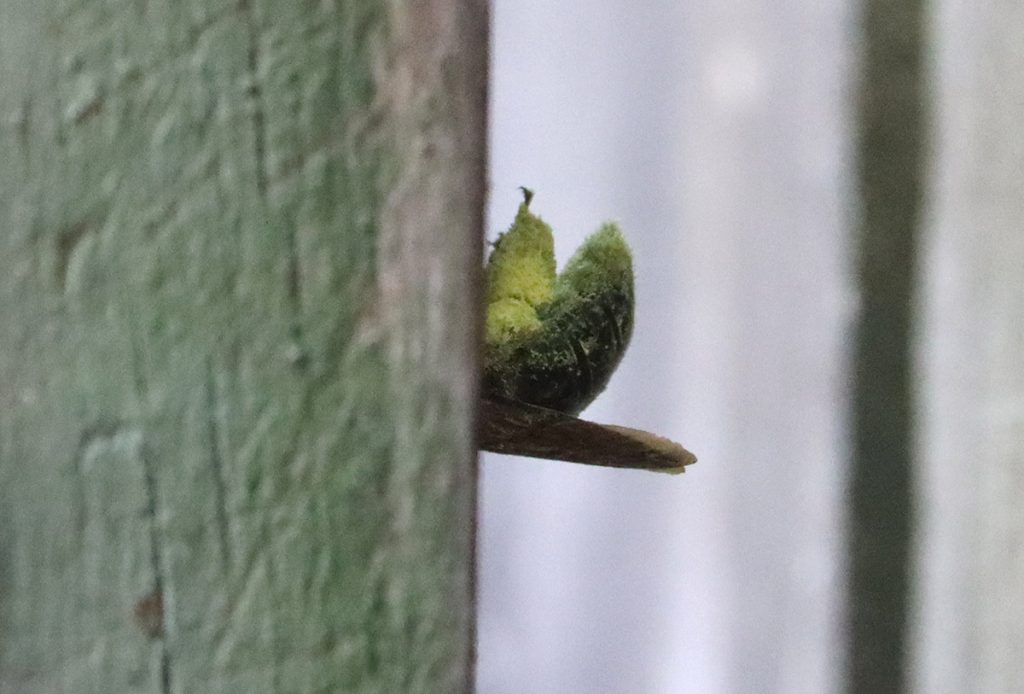
I saw this large, yellow looking insect fly behind the fence post. This carpenter bee appears to be bringing home copious amounts of pollen and nectar to feed its offspring. It does so by leaving pollen and nectar by its eggs, who hatch and eat it.
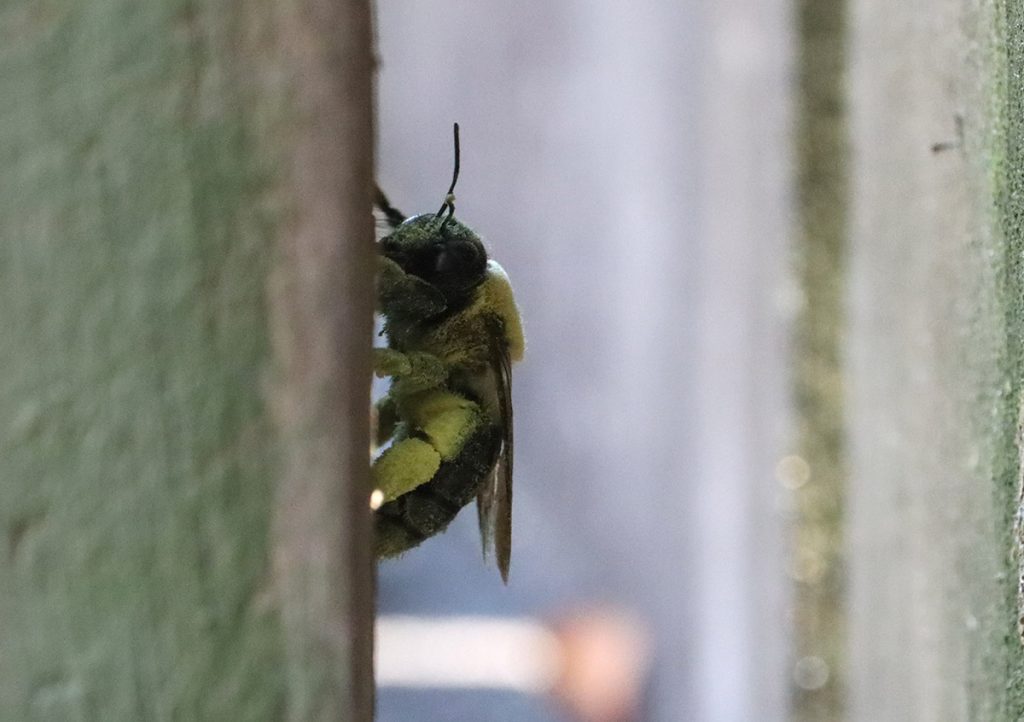
Here’s the bee when she was finished in her cavity. So dusty!
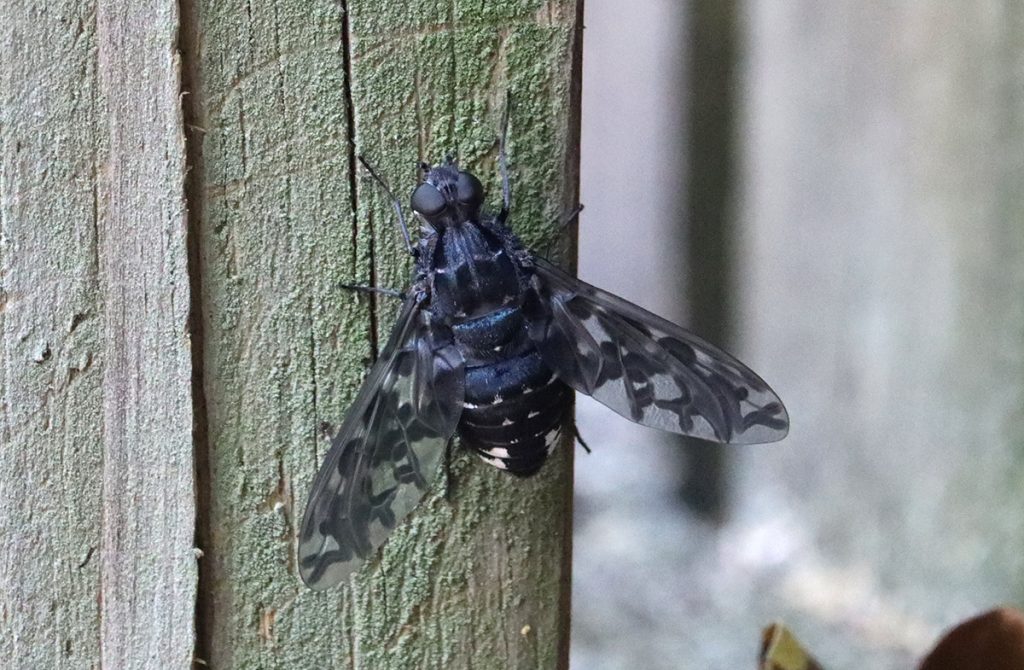
As the carpenter bee was returning with more food for its eggs, we spotted this tiger bee fly lingering nearby. This insect lays eggs near carpenter bee nests, and when its larvae hatch, they crawl into the cavity and eat the carpenter bee larvae.
I think about whether or not to chase off this kind of insect. But it is a part of our biodiversity, and a healthy food web many layers deep.
After I initially posted the pics above these, I came back to see the bee fly buzzing around the post containing the cavity. And I noticed something new sticking out from behind the post. A new adult bee had just broken out of its pupal shell. All of this happened within an hour or two.
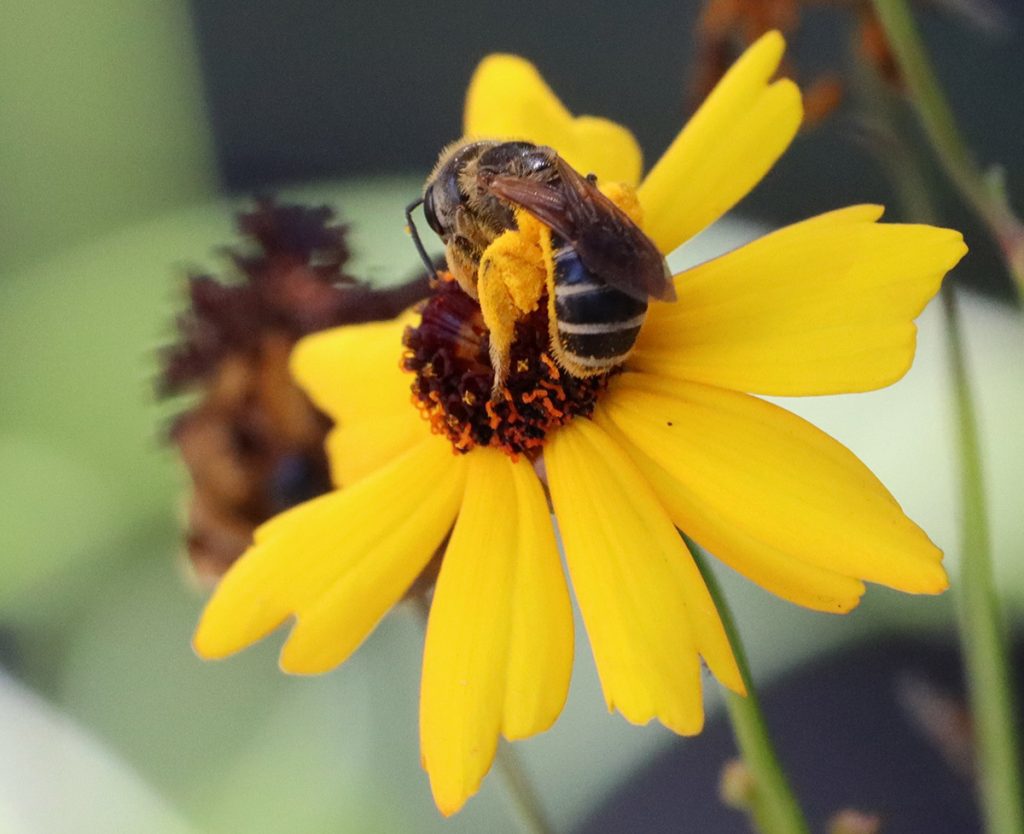
As you can see on this page, Poey’s furrow bees have been active this year, as they usually are in our yard. The cosmos they had favored, which I grew from a seed packets, have mostly withered and died in the heat and dryness of the last few weeks. The furrow bees have transitioned to the many coreopsis flowers blooming in the yard. In addition to the seed-grown lance-leaved coreopsis we have growing here and there, we have a few of this species.
I bought one Leavenworth’s coreopsis plant a couple of years back, and it seems to have happily spread its seed in the yard. We now have four blooming plants, and I wouldn’t be unhappy if we had a few more next year. When the flowers start going to seed, I’ll collect some and pick some spots where I think they might do well.
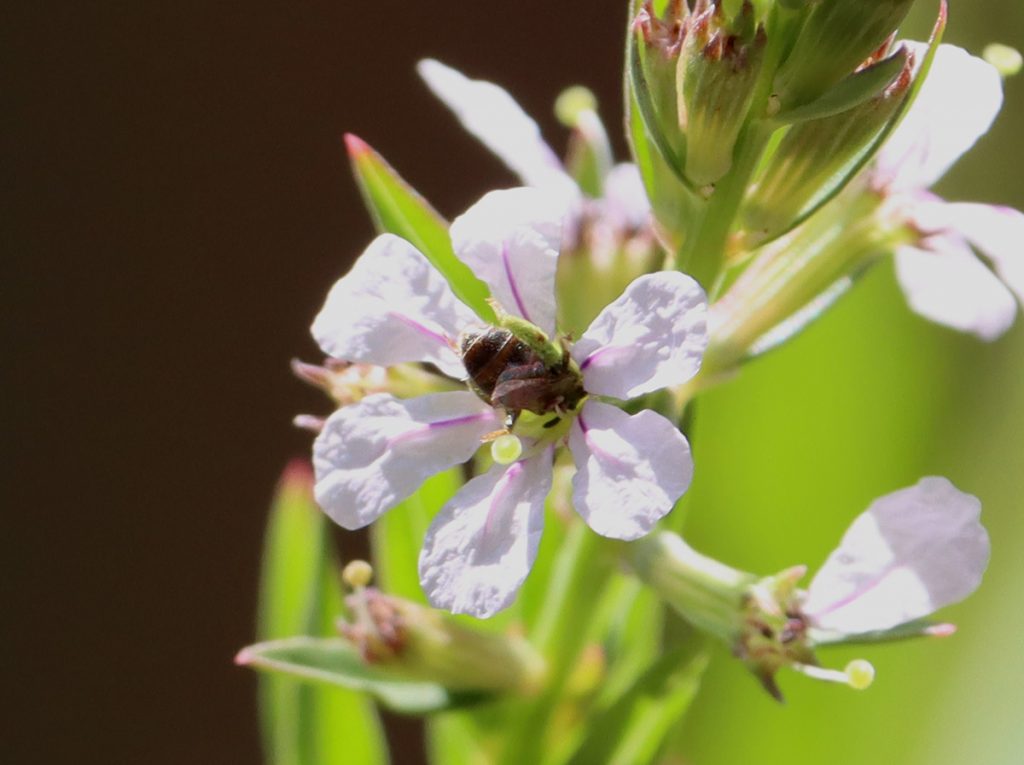
The smaller sweat bees were busy visiting smaller flowers today. The loosestryfe is starting to take off, and it’s usually one of our more popular pollinator plants. Today I also saw Dialictus in a groundcherry flower, on fennel flowers, and on our coreopsis.
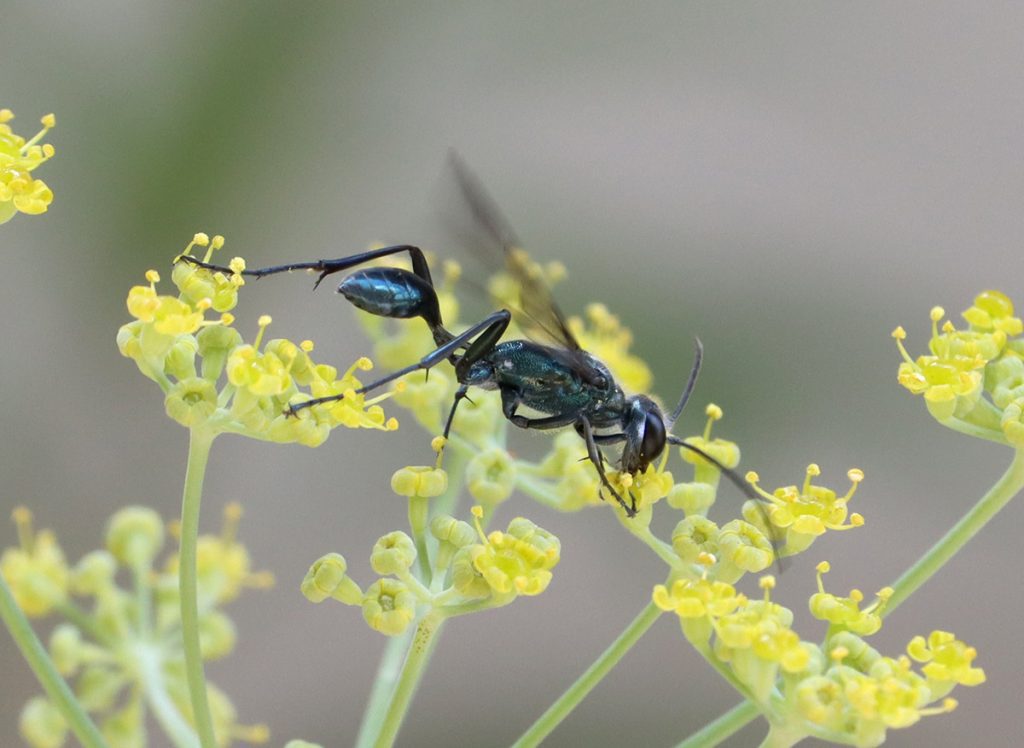
I made an iNaturalist observation for the same species of wasp on June 12 of last year. It’s interesting when I spot a species that makes limited appearances in our yard, and those appearances come within a week or two of each other in different years. It’s not uncommon.
In that iNat observation from last year, my initial guess was common blue mud dauber. The person who made identified it as this species noted they have white hairs, which you can see in the photo above.
May 30, 2021
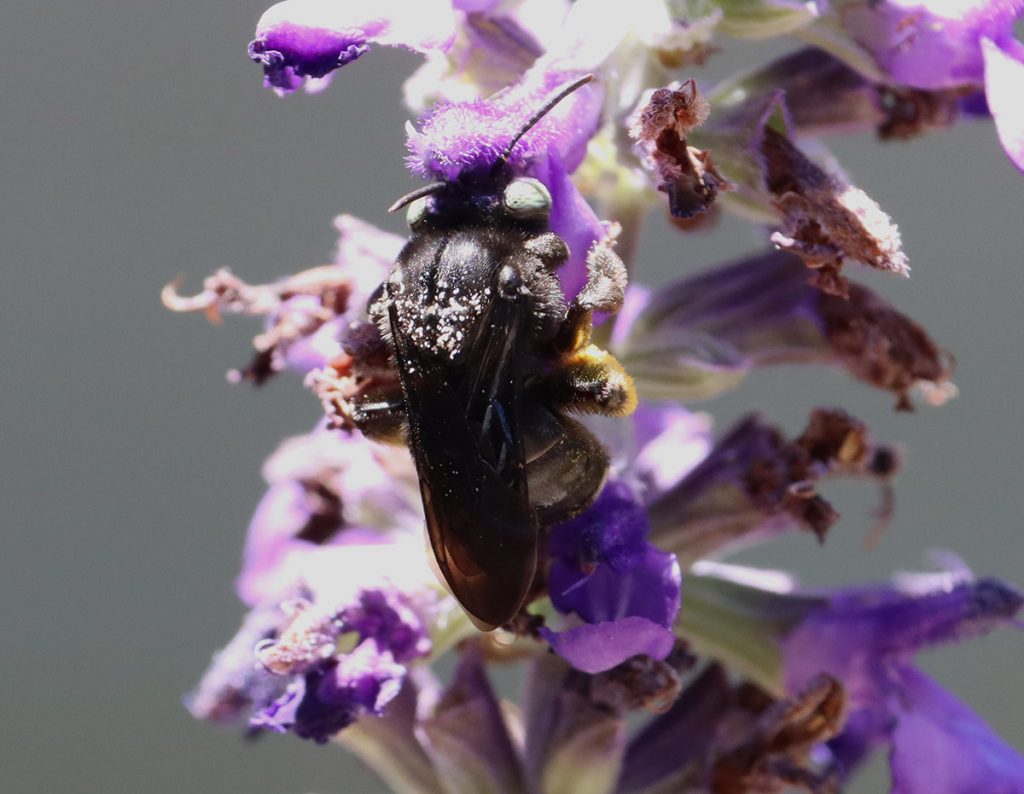
Here’s a regular visitor to the yard, appearing about when it did last year. We peaked at about 4-5 of these at a time in June 2020. I wonder if we’ll get that many this year. This does seem like a slower year in terms of how many pollinators I’m seeing overall, and the hot, dry weather is affecting plants in the yard.
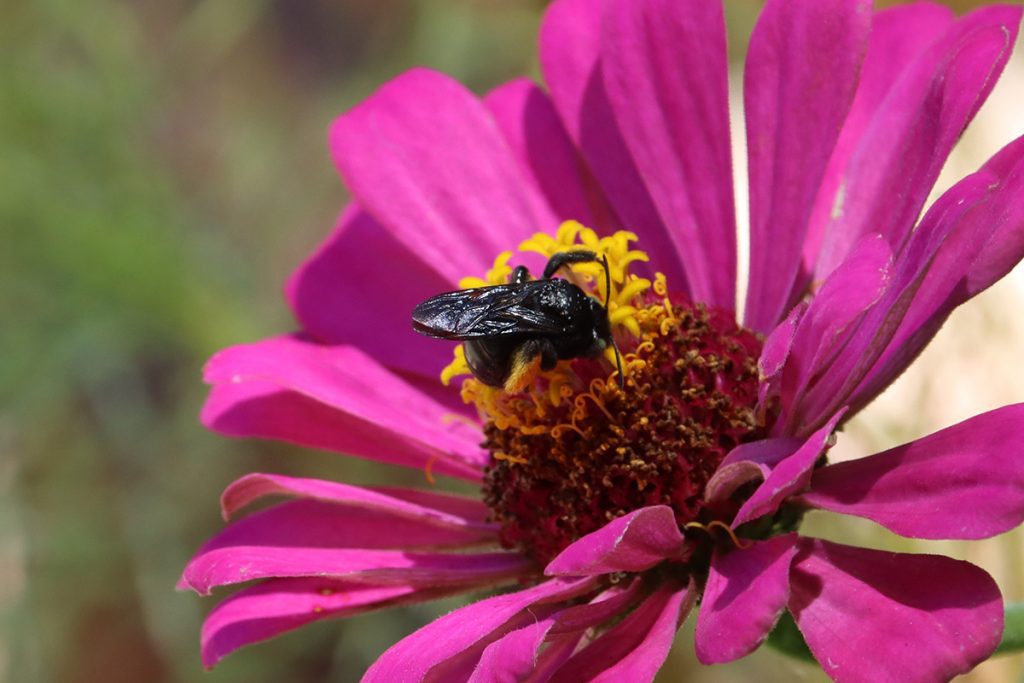
These bees like to visit a wide variety of flowers, where other bee species specialize or seem to prefer flowers of a certain shape or size.
May 29, 2021
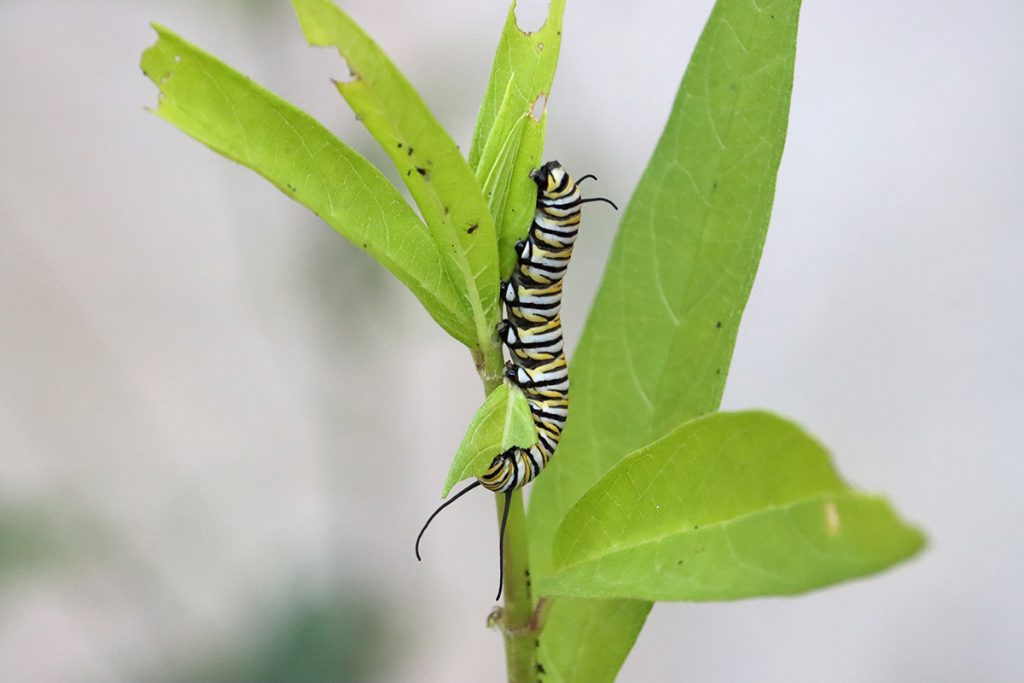
Maybe it was a fourth instar caterpillar two days ago, because it’s a fifth instar today. Tomorrow almost every leaf on this pink swamp milkweed plant will be gone, and by the day after, so will the caterpillar. Looking at date and doing some math, this caterpillar went from egg to chrysalis in somewhere between 8-10 days.
That’s faster than it usually happens in our yard, buy they grow at different rates. Maybe fast growth is a genetic trait that helps a caterpillar survive. With each progression into a new instar, monarch caterpillars ingest more and more toxic milkweed. By the time they’re a certain size, they’re less vulnerable to predators. If you can get bigger and more toxic faster, you’re more likely to survive.
That’s one guess, anyway. That’s the fun of observing, and noticing. But observing and noticing can lead to hypotheses and experiments, which can in turn lead to hard knowledge.
May 27, 2021
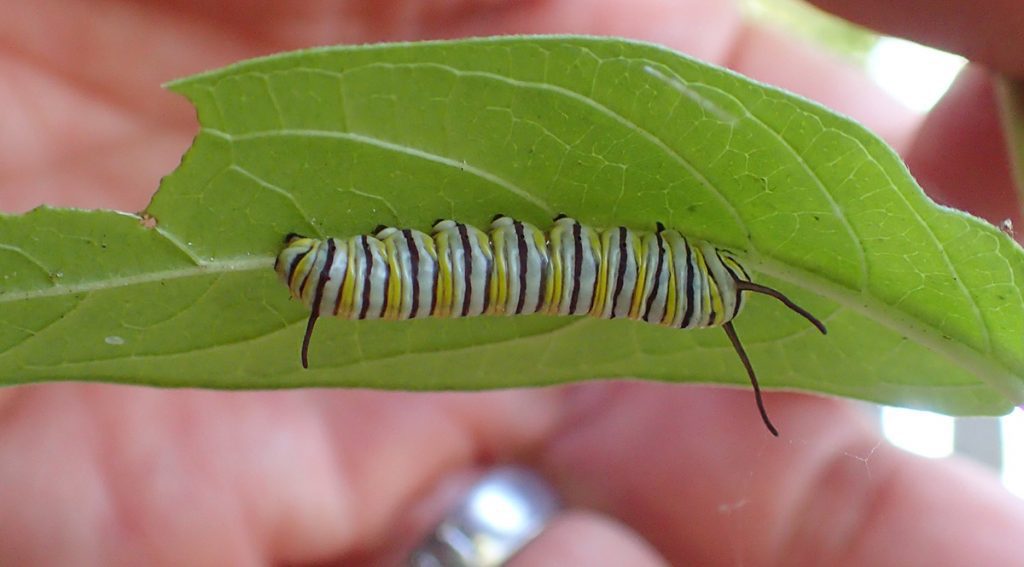
I first spotted several first instar monarch caterpillars in the yard 5 days ago- May 22. During this short time, this one has grown to either third or fourth instar- and as far as I can tell it’s the last one in the yard. This has longer tentacles like a fourth instar, but that can vary. More telling is the striping, which is not as bold as a fourth. I’m pretty sure this is third instar.
May 24, 2021
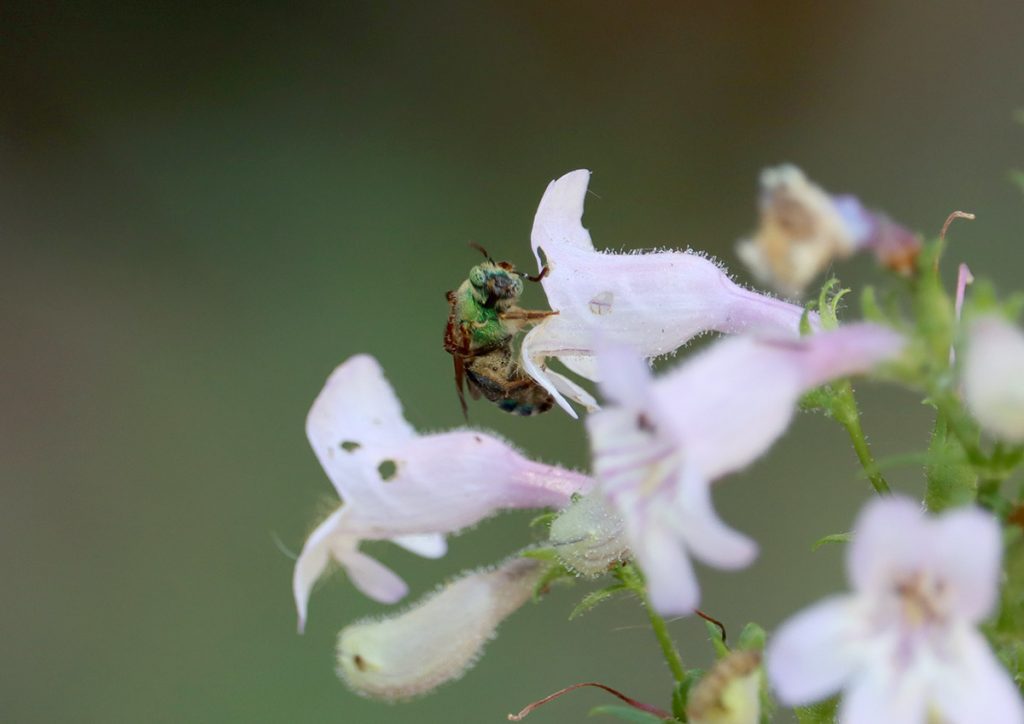
Bees are liking the Pentsemons, so I may pick up a couple more next time I hit up the nursery.
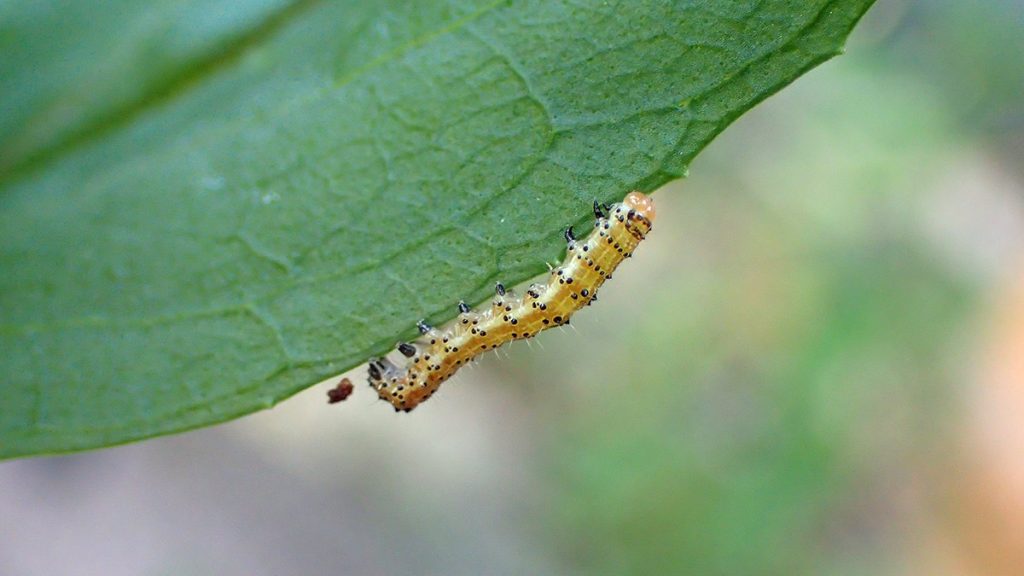
This makes 14-15 caterpillar species I’ve photographed in the yard this year. There are other moths and caterpillars we’ve seen that may have hosted in the yard as well, even if we didn’t see them as larvae. Some have been easier to identify than others, but this does seem like a healthy foundation for a food web.
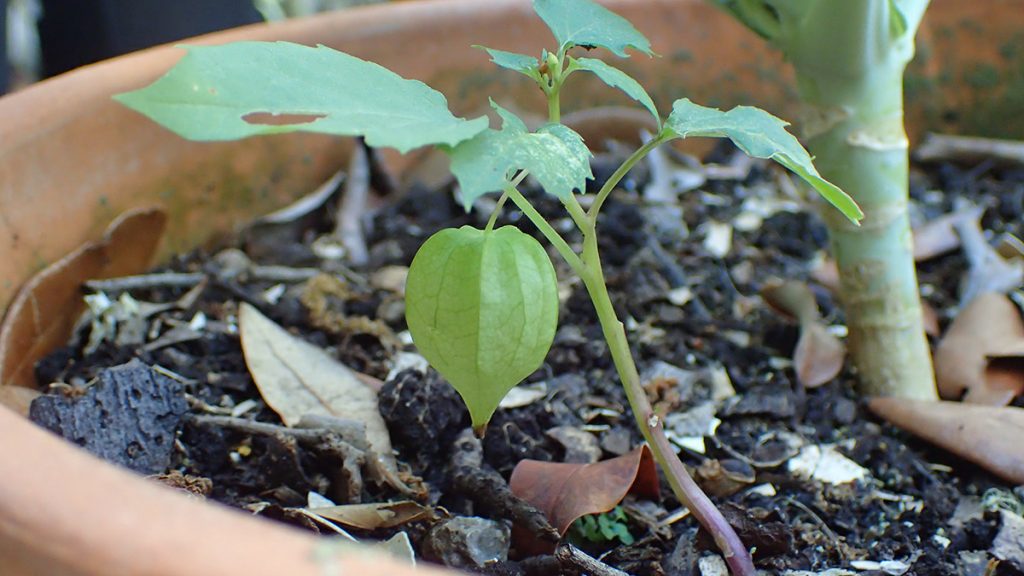
In previous years, groundcherries fruited later in the year. This one is much smaller than those, and here it is producing fruit in May.
May 23, 2021
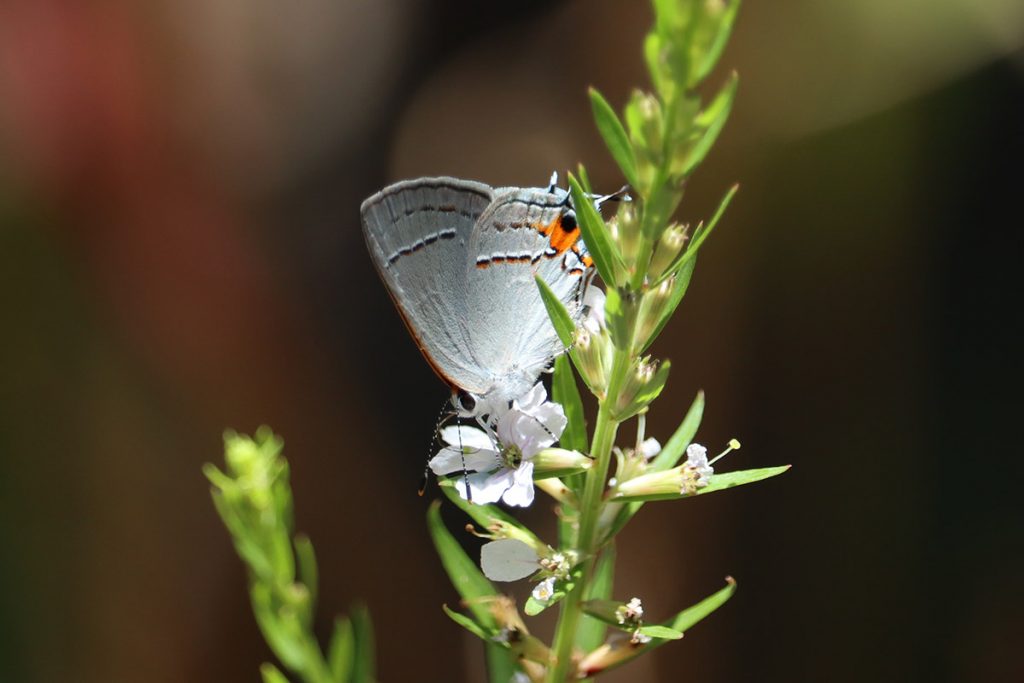
Finally some butterflies are visiting the yard. This is the second hairstreak species I’ve seen this year. Gray hairstreaks host on legumes. I’m growing peas and we had vetch growing everywhere; I wonder if it hosted in our yard. I’d love to see its little green caterpillars.
When the winged loosestryfe is in full bloom, that’s when we start hitting our pollinator stride. You can see the next few flowers getting ready to open.
May 22, 2021
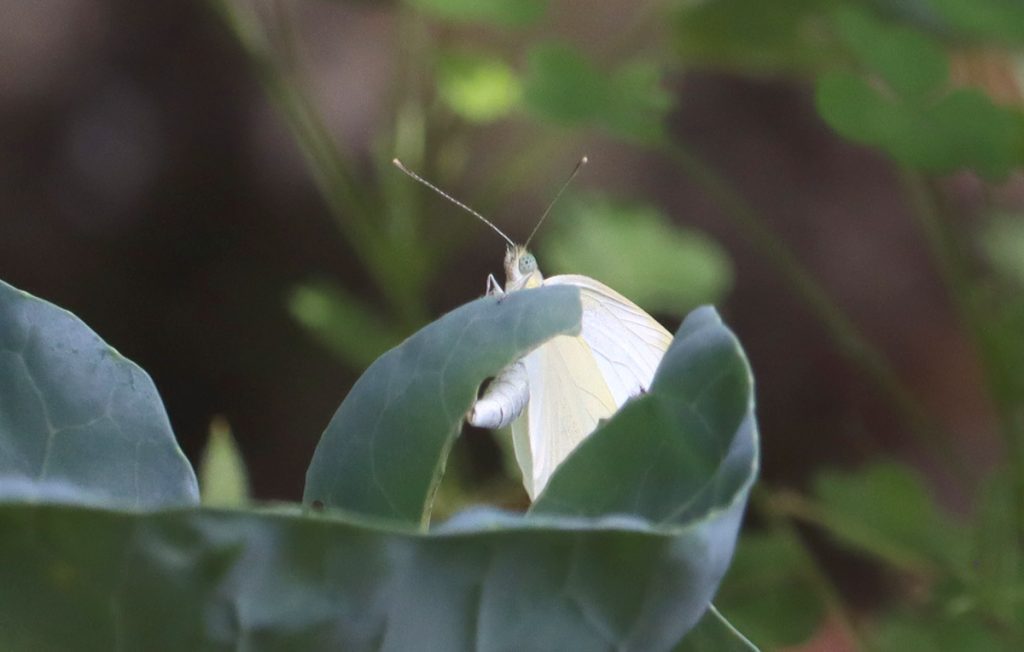
Yes! I’ve seen the later instars of this caterpillar, and a chrysalis. Now here’s a chance to capture the rest of its life cycle.
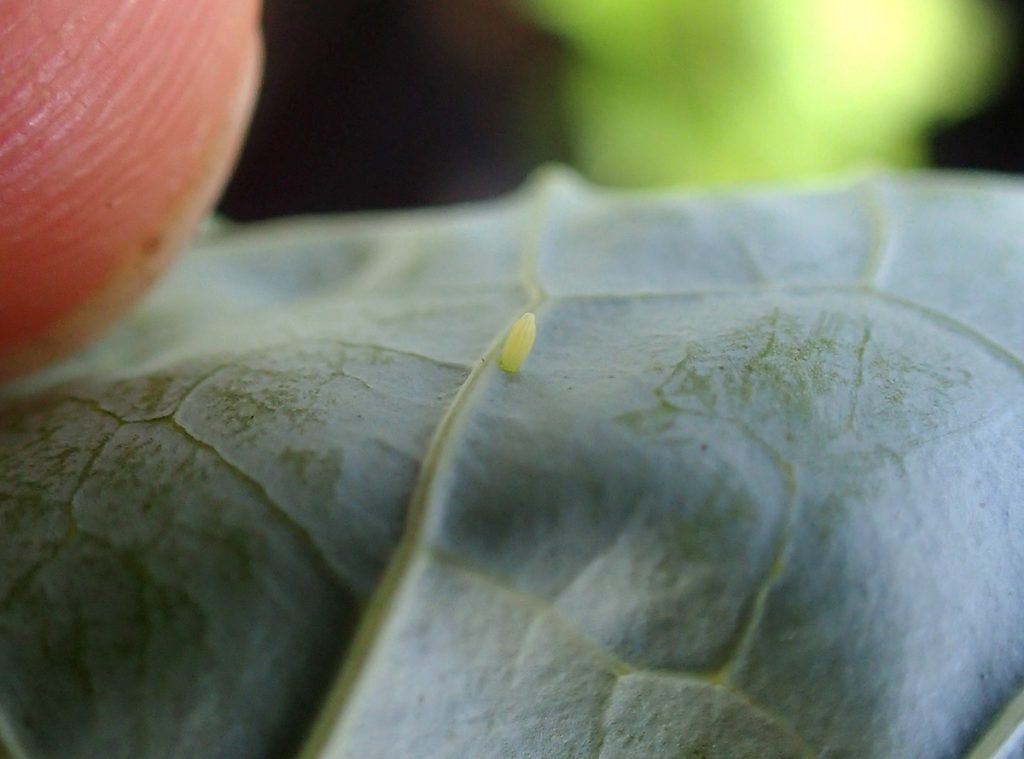
I was able to find two or three eggs, and there may be more. I’ll keep an eye on these plants.
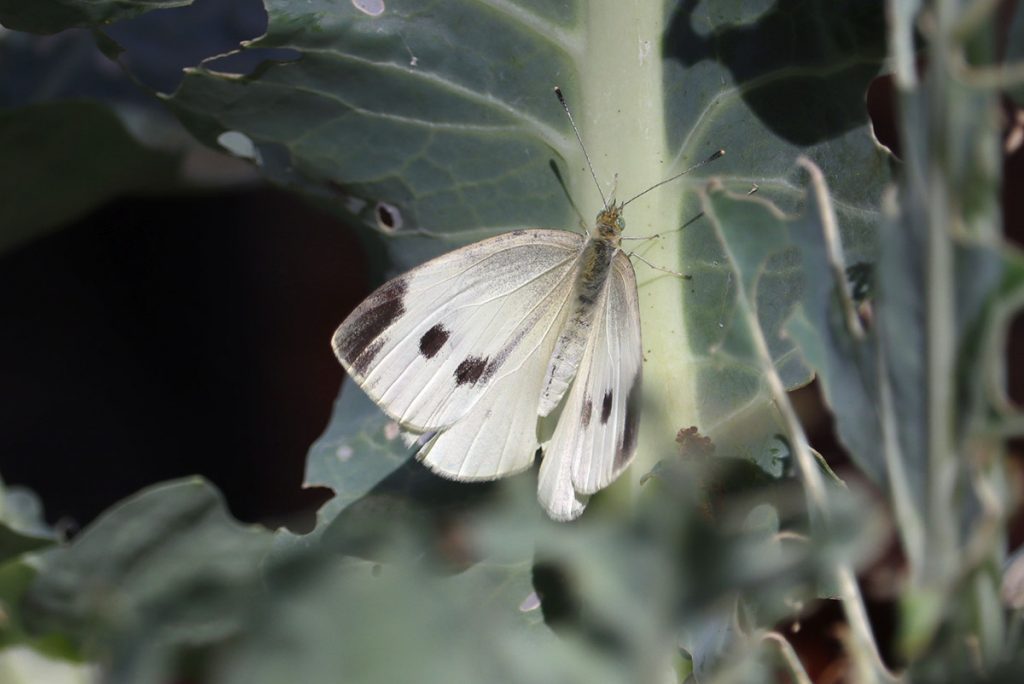
It rested for a few seconds, giving me a chance to see the upper side of its wings.
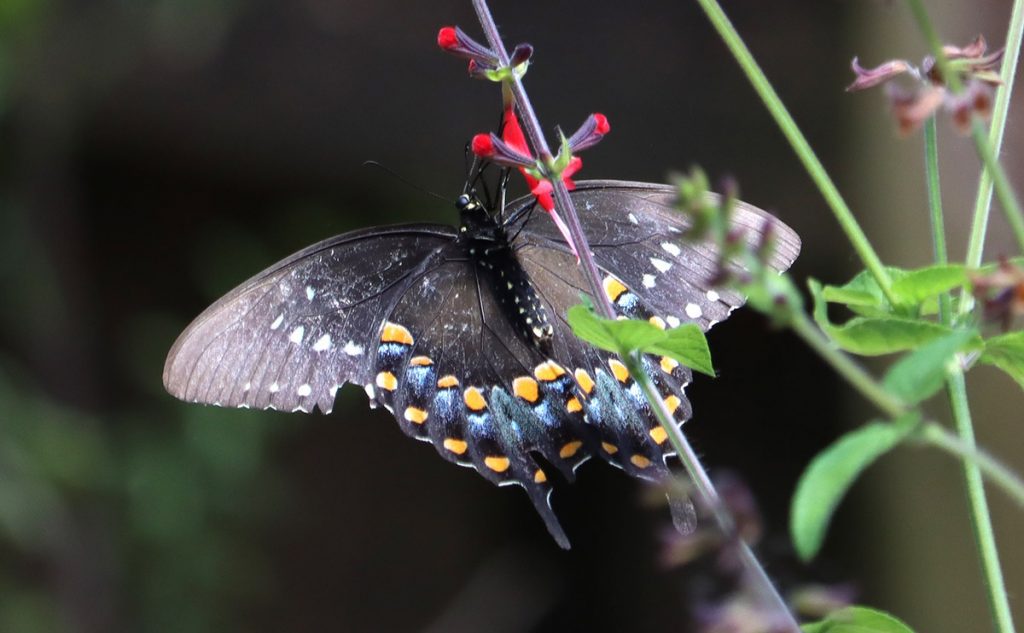
We’re finally starting to see larger butterflies here. The tropical sage has spread itself through the yard, and this plant is growing out of a crack in the pavement.
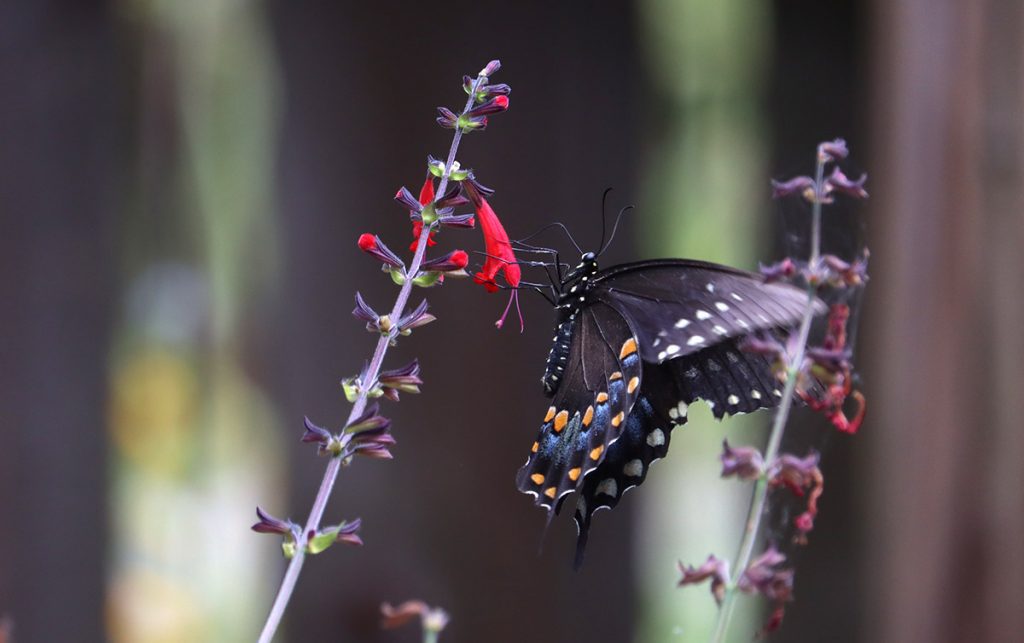
Here’s another look. I think swallowtails are the prettiest of our local butterflies.
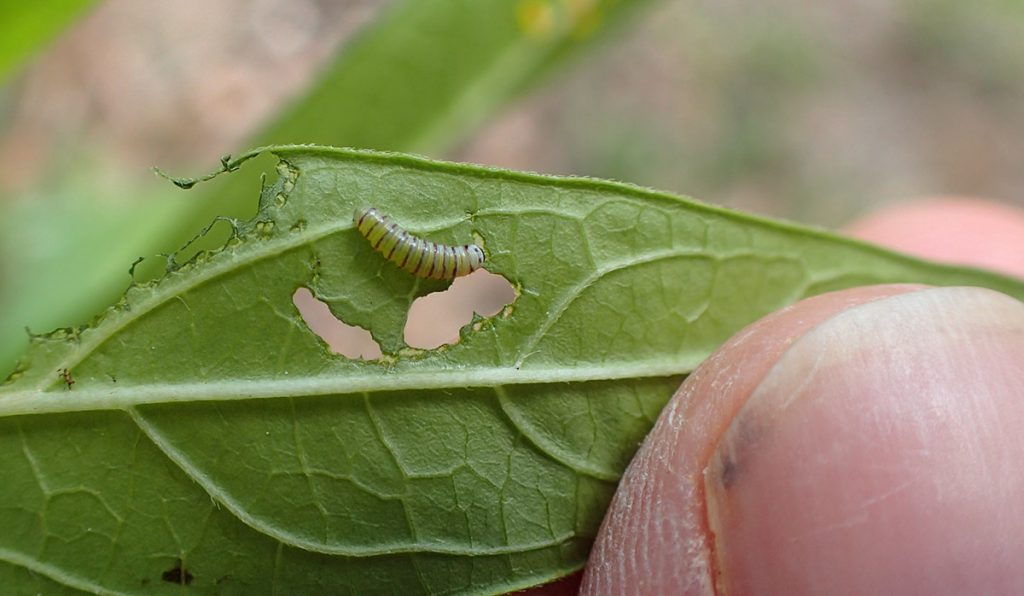
I saw another monarch in the yard, and failed to get a photo of it before it flew off. They’re skittish this year! Anyhow, after it left, I noticed holes on the leaves. It turns out the monarch from the other day did leave a few eggs. We have two patches of milkweed plants, and both have a few caterpillars. We had a light year for monarchs last year, so I’m curious to see how 2021 goes.
May 21, 2021
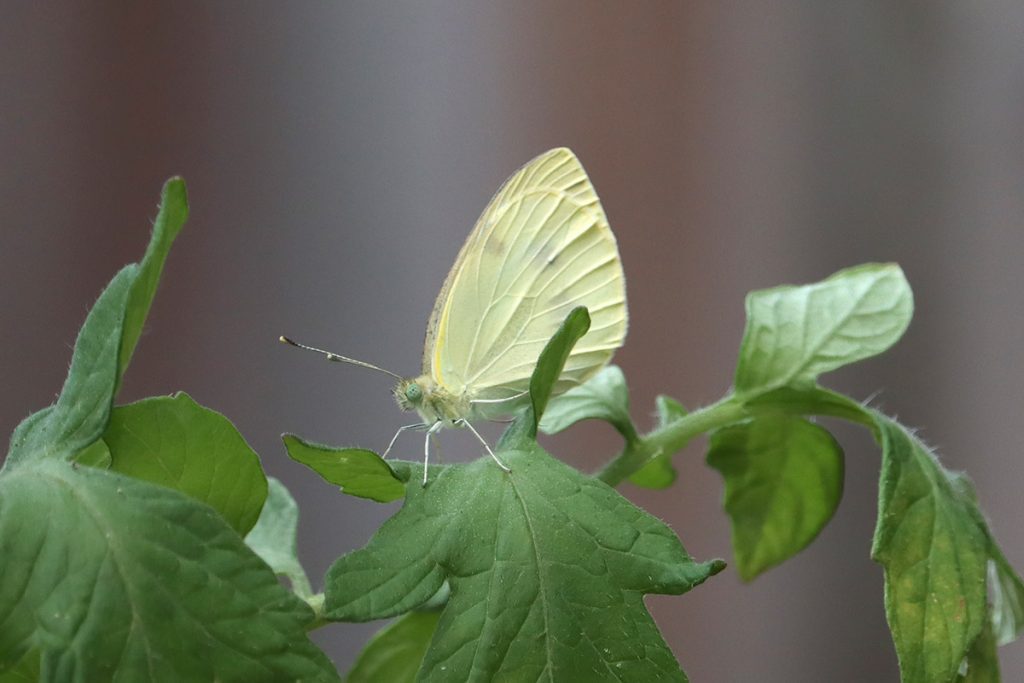
Did this cabbage white butterfly emerge from a chrysalis I missed? Unlikely, as I haven’t seen their caterpillars in several weeks. But I have left leafy cauliflower uncut in the hopes that I’ll see more of their caterpillars. We’ll see.
May 19, 2021
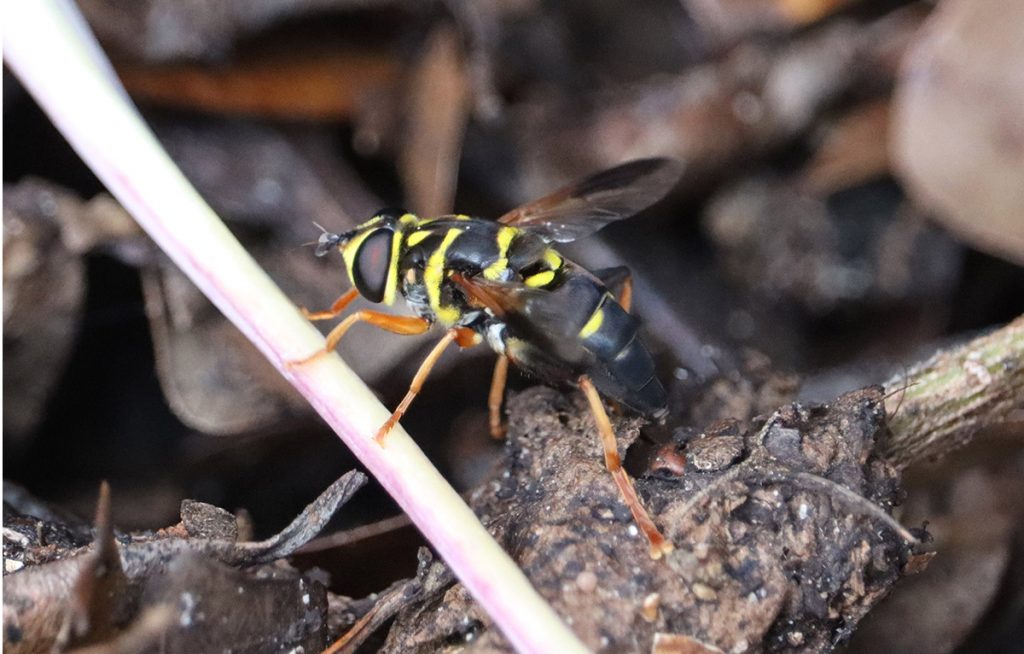
This is a hoverfly species I had not seen previously. It was in the compost, wiggling its abdomen up and down as if to lay eggs. So I looked it up. This species is frequently found in or near compost bins. Many of the observations people made on different websites also mentioned bobbing abdomens, but commenters pointed out the photos were of males. Anyhow, it seems like this might be another fly with compost eating larvae.
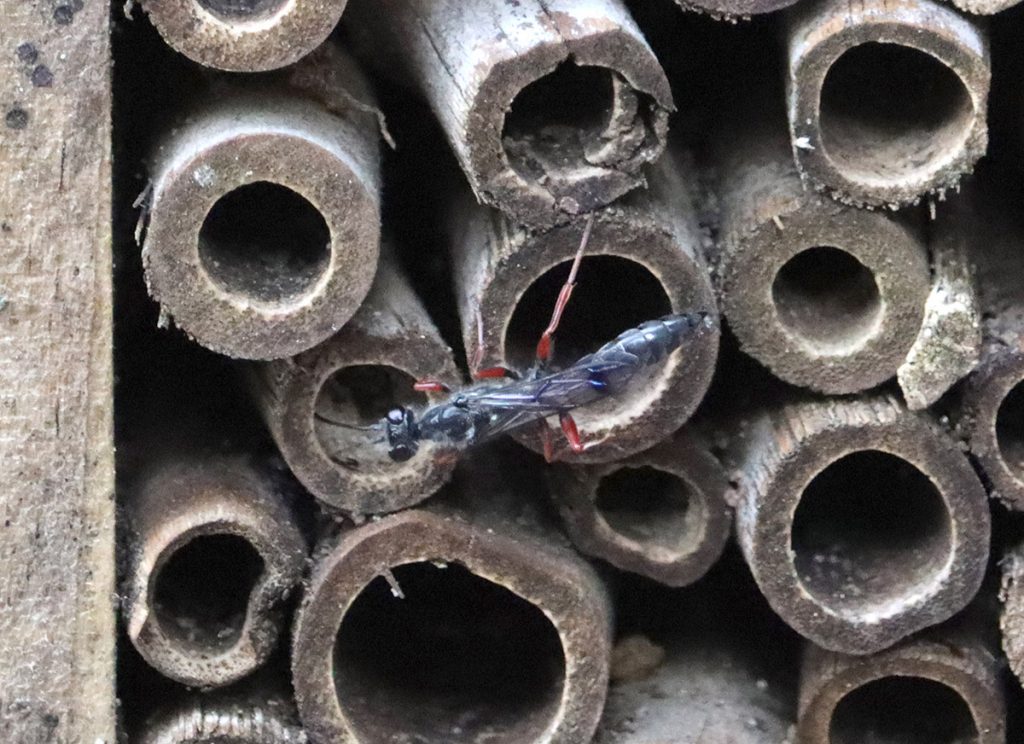
For years, we’ve had red-marked pachodynerus wasps (Pachodynerus erynnis) nesting in this structure. I saw them through the earlier months of the year, but haven’t in a while. Now we have a new wasp here, Podium rufipes, a mud-dauber.
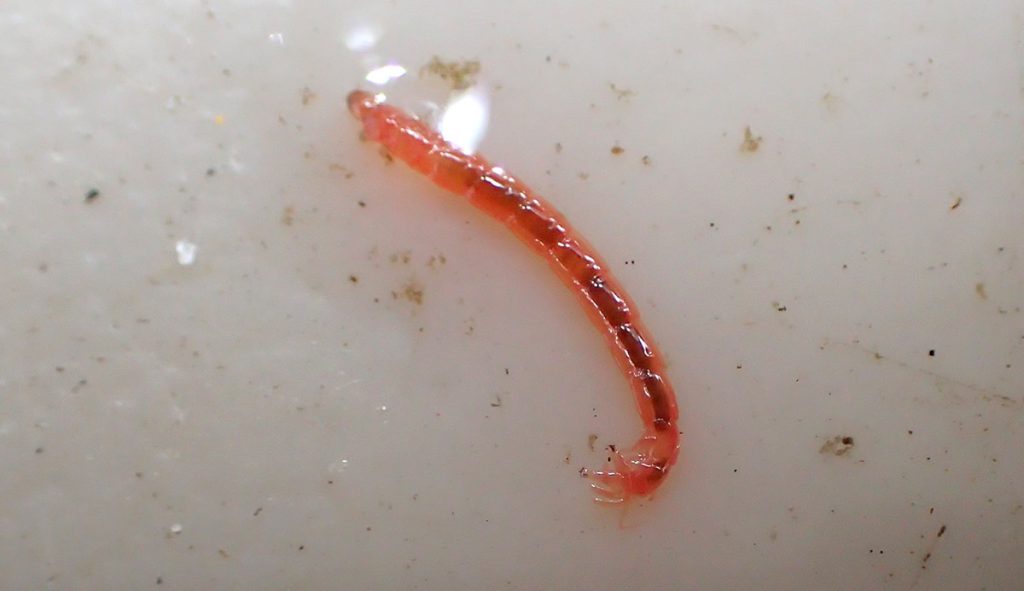
The kids found this while cleaning out the bird bath. I took a wild stab at an ID on iNaturalist, but no one has weighed in yet.
May 18, 2021
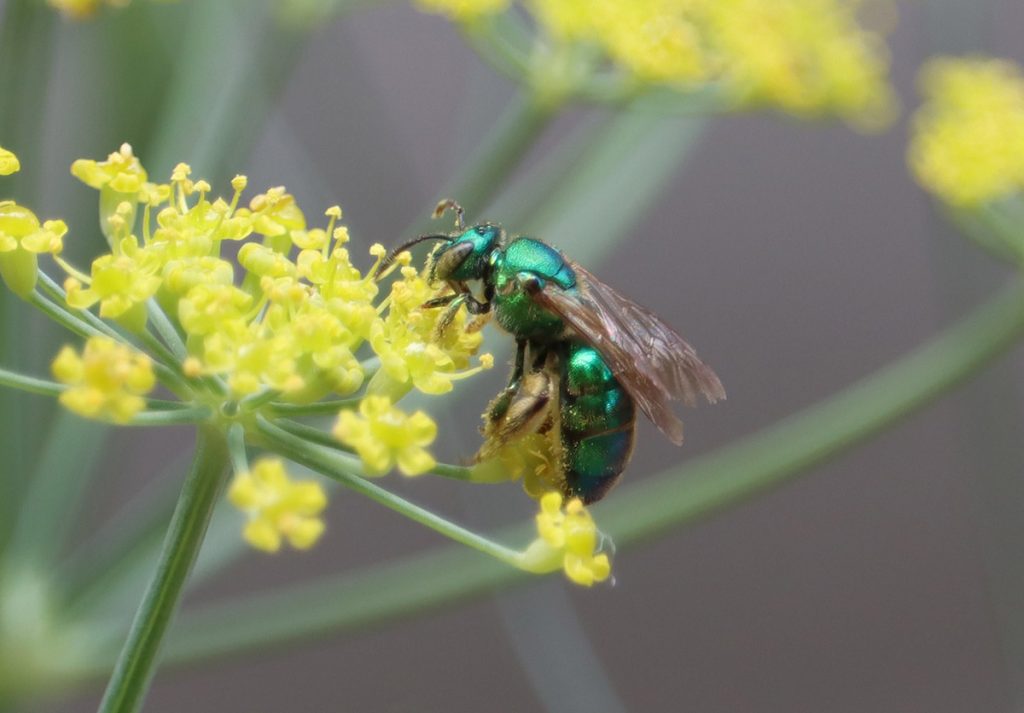
I mentioned earlier the similar appearance of the blue/ green sweat bees in our area. The pronounced stripes, brownish wings, and larger size make me think female brown-winged striped sweat bee. The Apiaceae are popular this year.
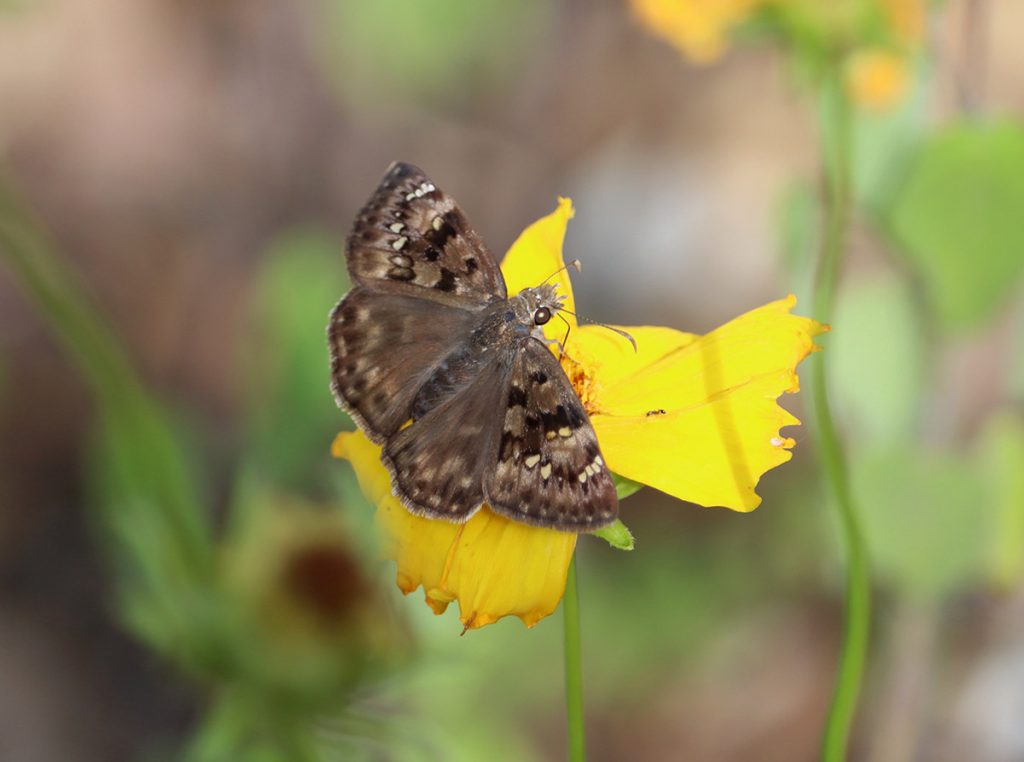
From what I’ve read, cosmos are closely related to coreopsis, and they do attract the same pollinators.
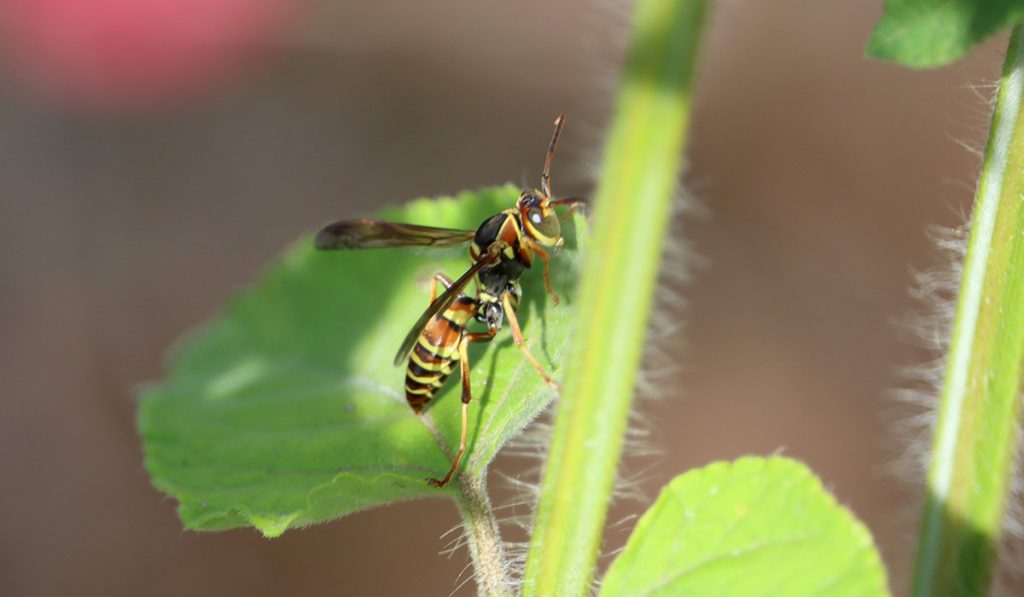
I’ve seen paper wasps inspecting plants, including the milkweed. These are caterpillar hunters, and I often see them flying from leaf to leaf, and looking under leaves.
After days of spending hours bouncing between the same three species of plant, the bumblebees have been branching out. The winged loosestryfe has been a huge attraction to bees and small butterflies over the last few years, and it’s finally blooming- a few weeks later than last year.
May 17, 2021
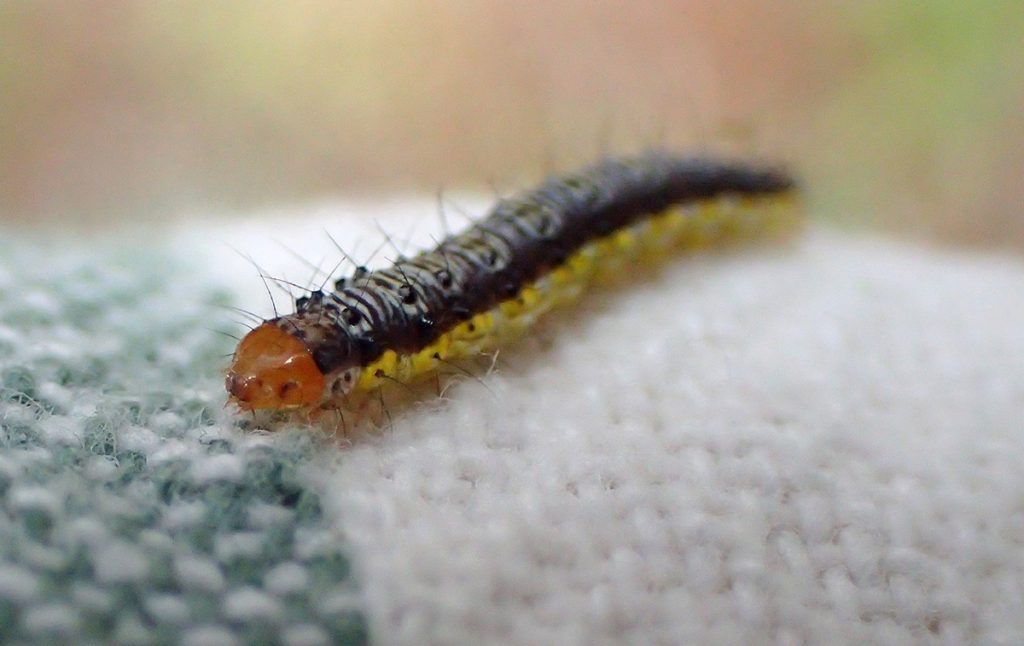
Here’s a cross-striped cabbage worm caterpillar I missed when I cleaned them off the Brassicas in our yard. This is a later instar, less translucent and with a pronounced striped pattern.
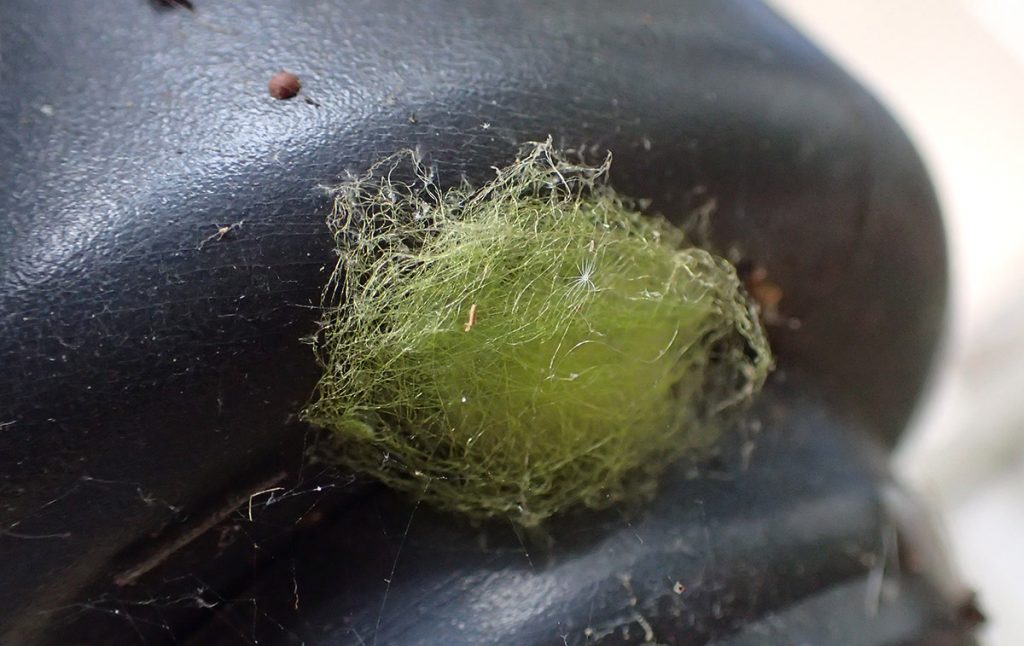
This bright green fuzzy structure looks like it was made by an insect. I’m guessing it’s a moth cocoon.
May 16, 2021
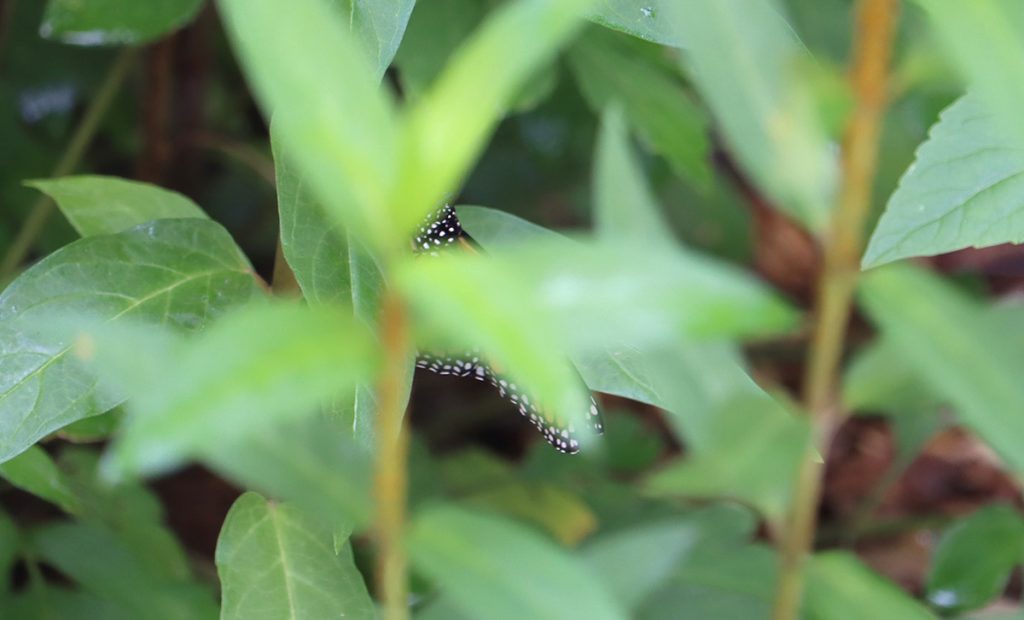
I snapped this photo, and then the monarch flew off when I moved closer for a better vantage point. I took a quick look for eggs, but backed off so as to leave the plant clear for her if she returned. She did, but quickly took of again.
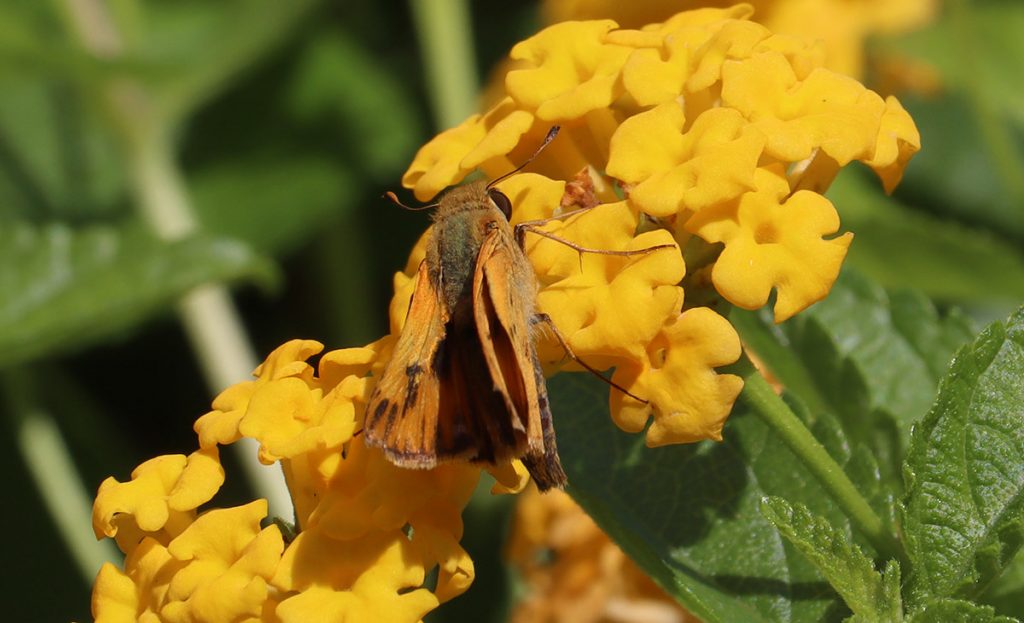
I haven’t noticed as many butterflies on the lantana this year. Today I saw this and a Horace’s duskywing.
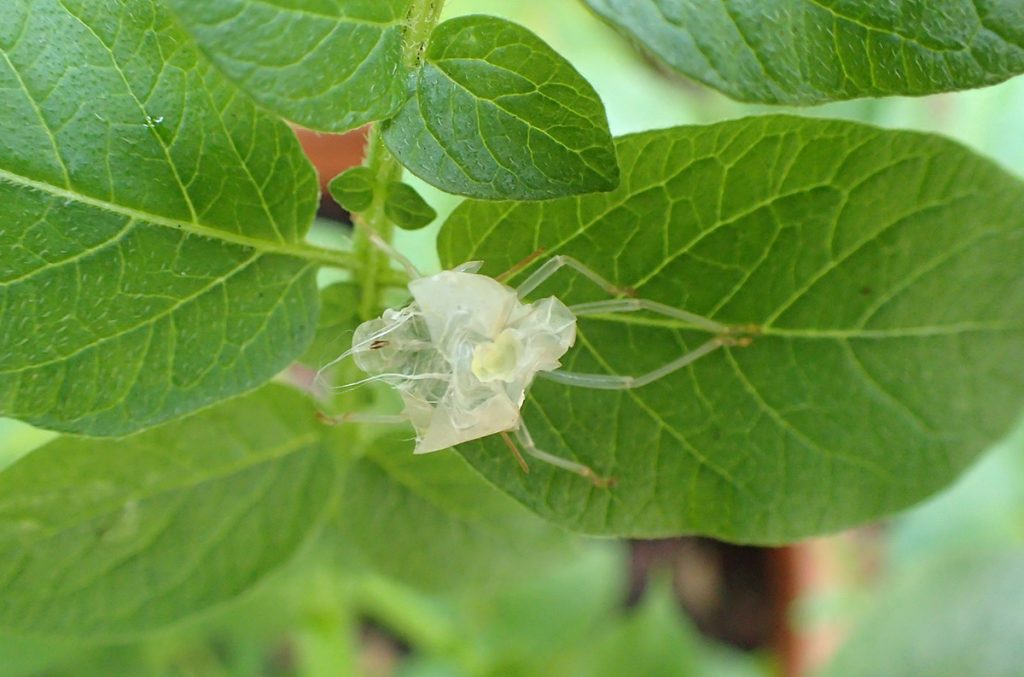
Something molted on out potato leaves.
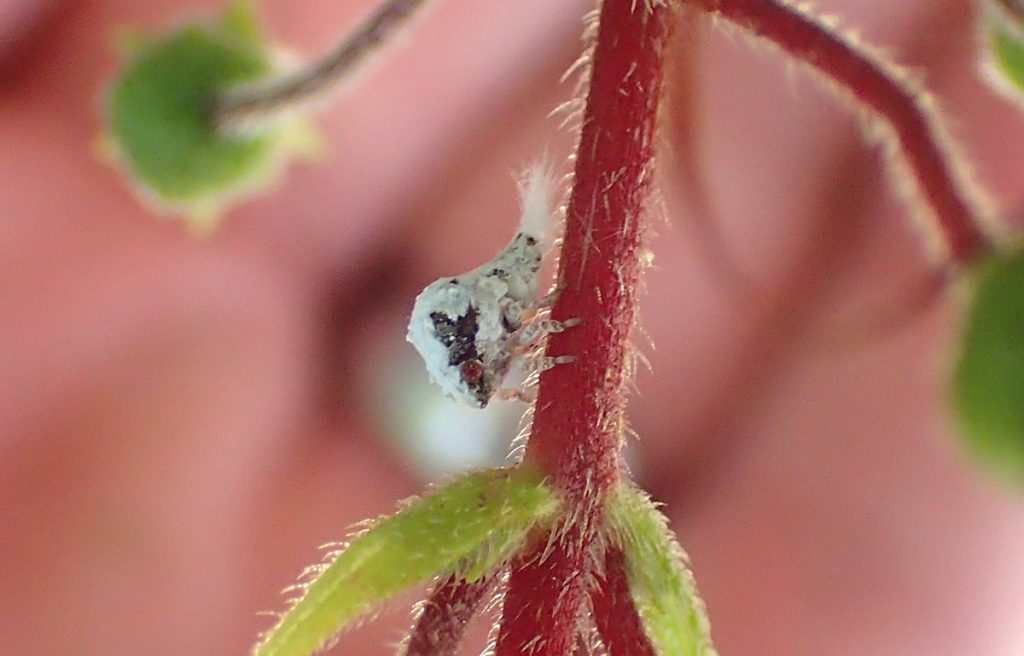
And here’s a common sight in our yard, but one with a look I appreciate.
May 15, 2021
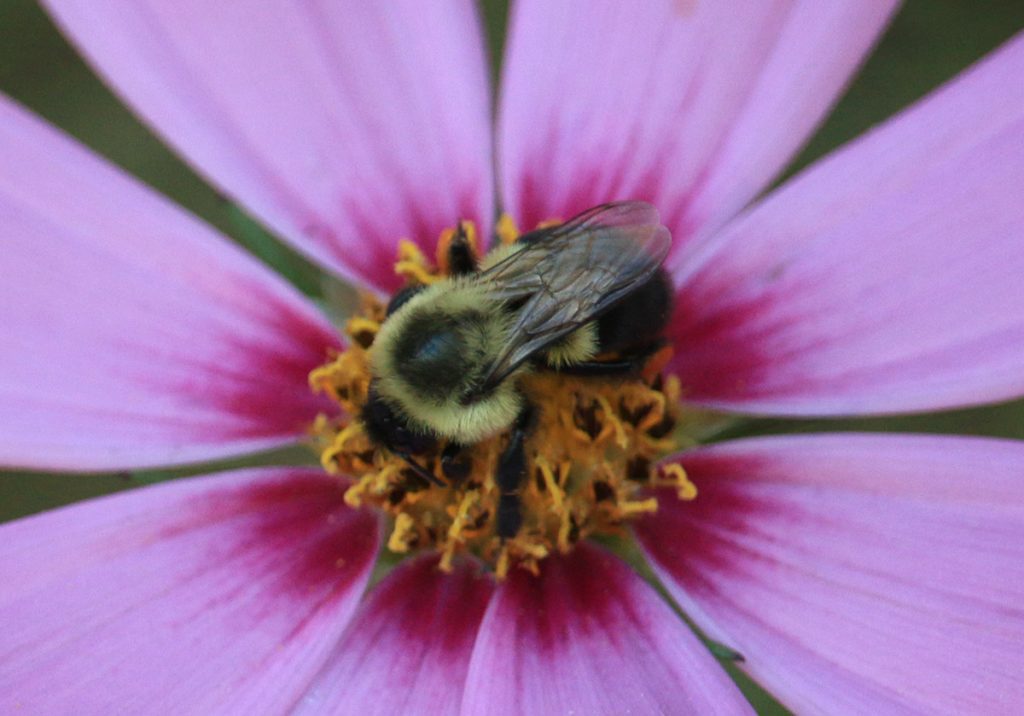
It’s been slow this week aside from the bumblebees. They’ve worn out many of their normal flowers, and now I’m starting to see them try new ones. Typically, I see bumblebees take nectar from flowers by hanging from them, where the smaller sweat bees (Dialictus, furrow bees) like the flowers they can stand on and eat. Different bees like different flower structures, depending on their size and shape.
The bumblebee only tried this cosmo out for about a minute, and I never saw it return to it or try the similarly shaped coreopsis. I’ve noticed in the past how bumblebees try new flowers after their usual favorites die off or have been heavily nectared.
May 11, 2021
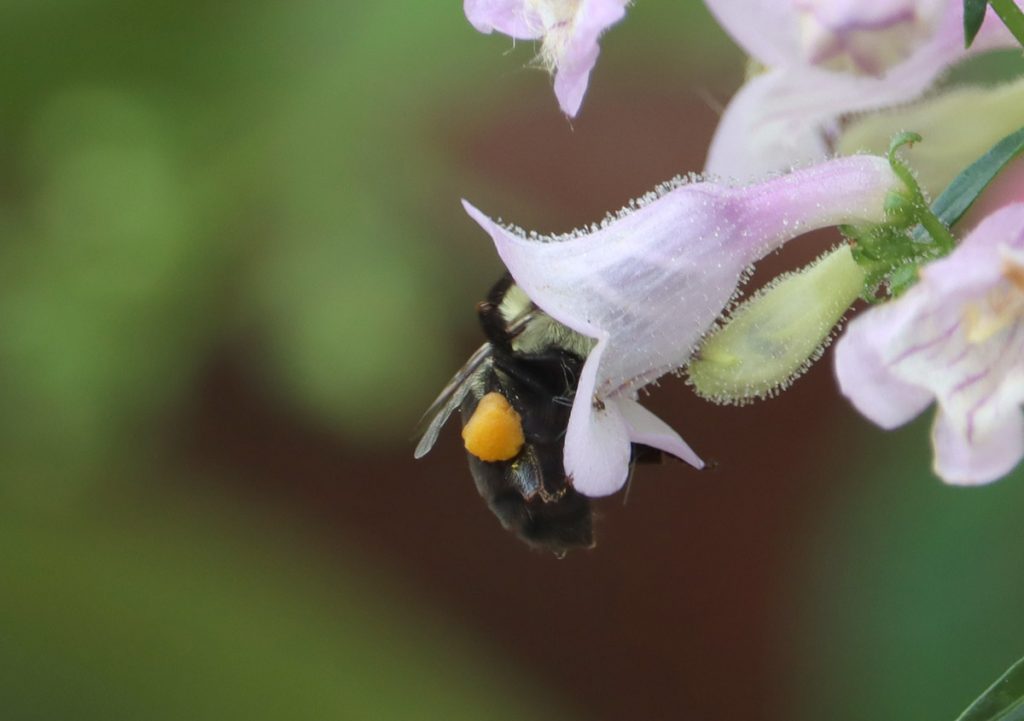
After a year in which this plant didn’t flower, and then was seemingly being killed by a slime mold, it feels good to see a bee feeding from it. The bumblebees now mostly hop between the Sinningia, Pentsemons, and blue Salvia.
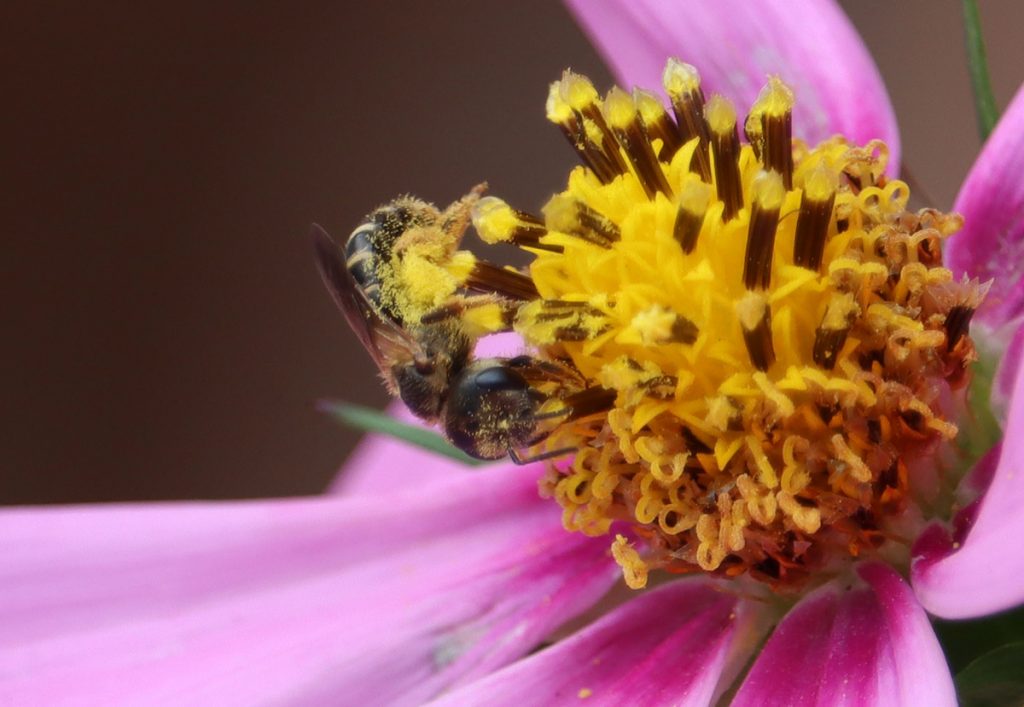
Here’s another photo of a Poey’s furrow bee on a cosmo. Such a cute bee.
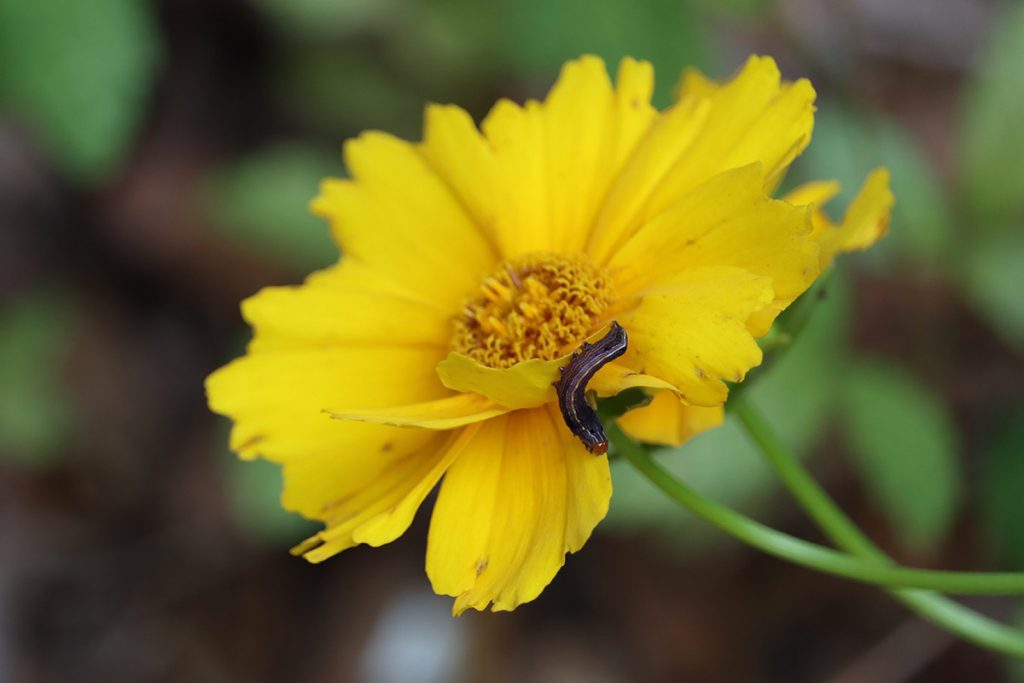
I’ve also seen the furrow and Dialictus bees on our many coreopsis flowers, which today this armyworm is enjoying.
May 10, 2021
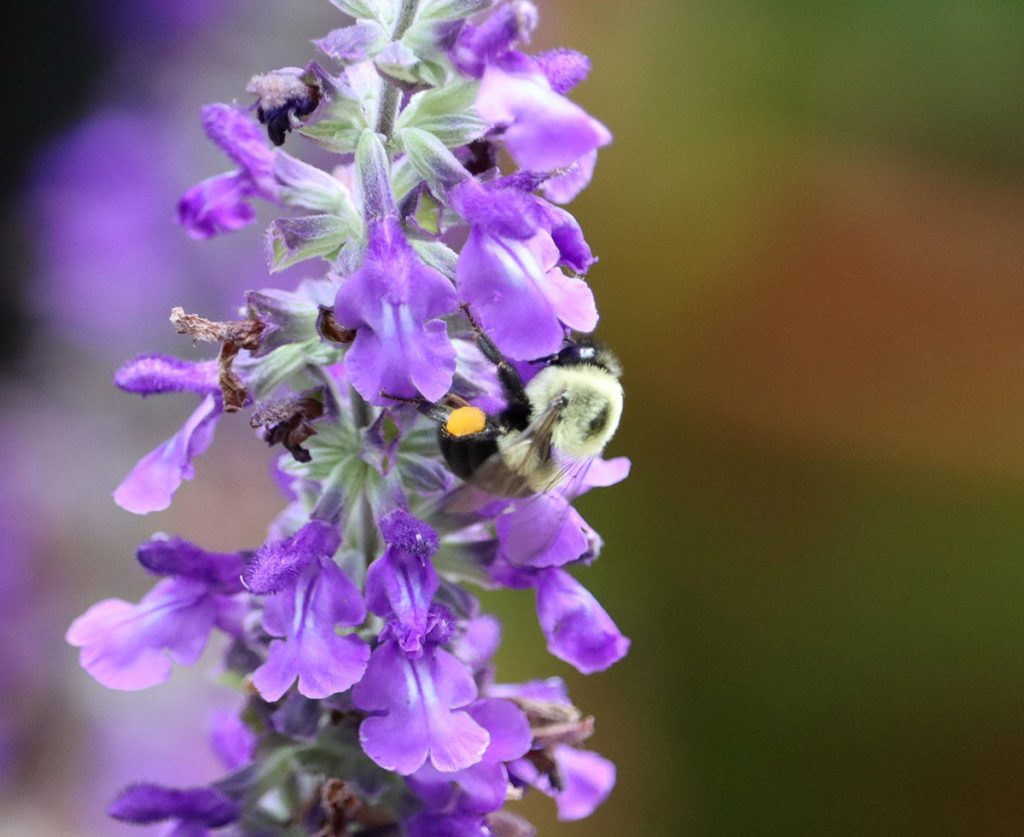
It feels like a quieter May in our yard than last year. Many of our flowers have been slower to bloom, and I’ve seen way less butterflies. But starting today, a couple of bumblebees will go crazy on our flowers for a few days.
May 8, 2021
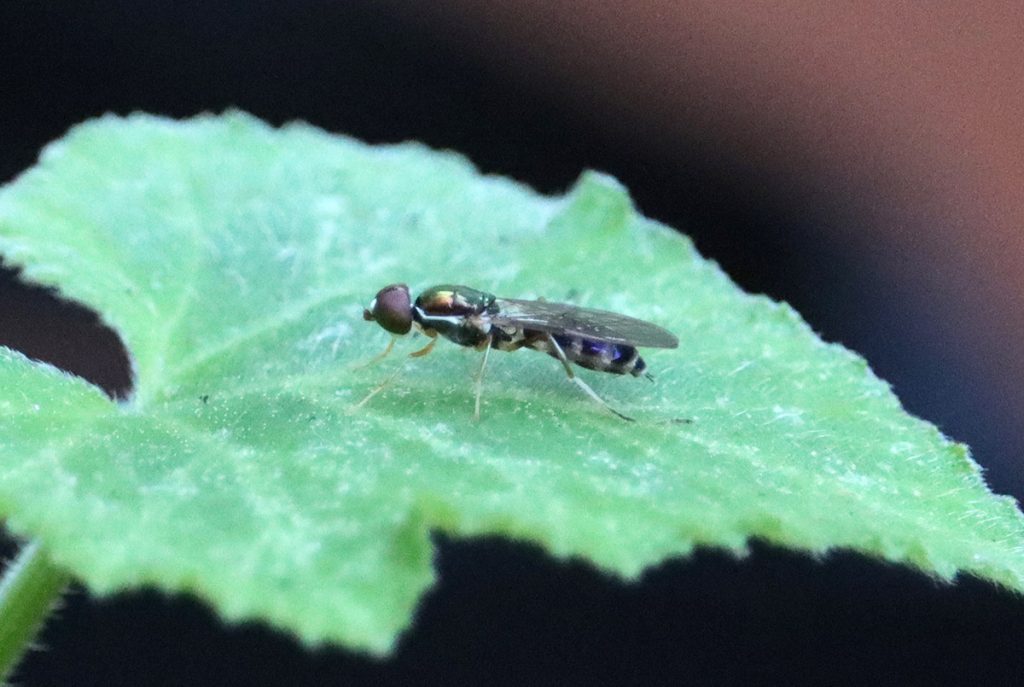
Looking back at my iNaturalist observations for soldier flies, I observed one of this species last year on May 12. I can’t find much information about the species, but it could be that this is the time they reach maturity in our area.
May 5, 2021
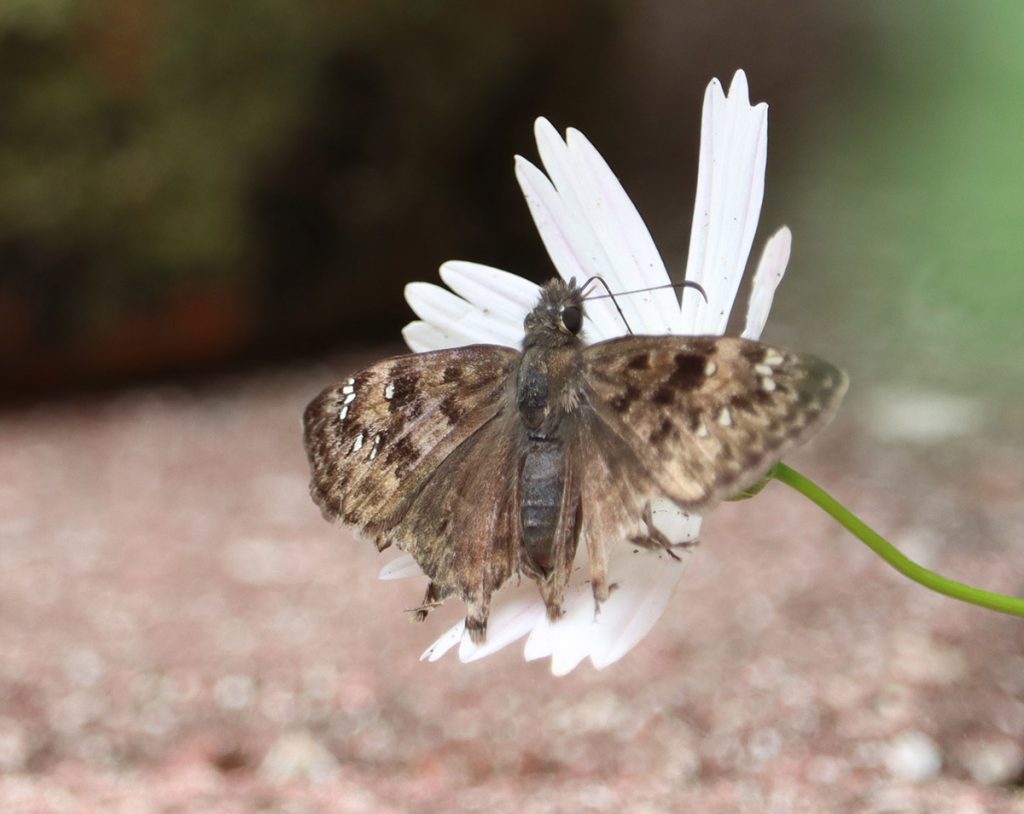
Horace’s duskywings are common in our yard, and this is the first I’ve seen of one this year. The cosmos continue to be the most popular pollinator plant.
May 3, 2021
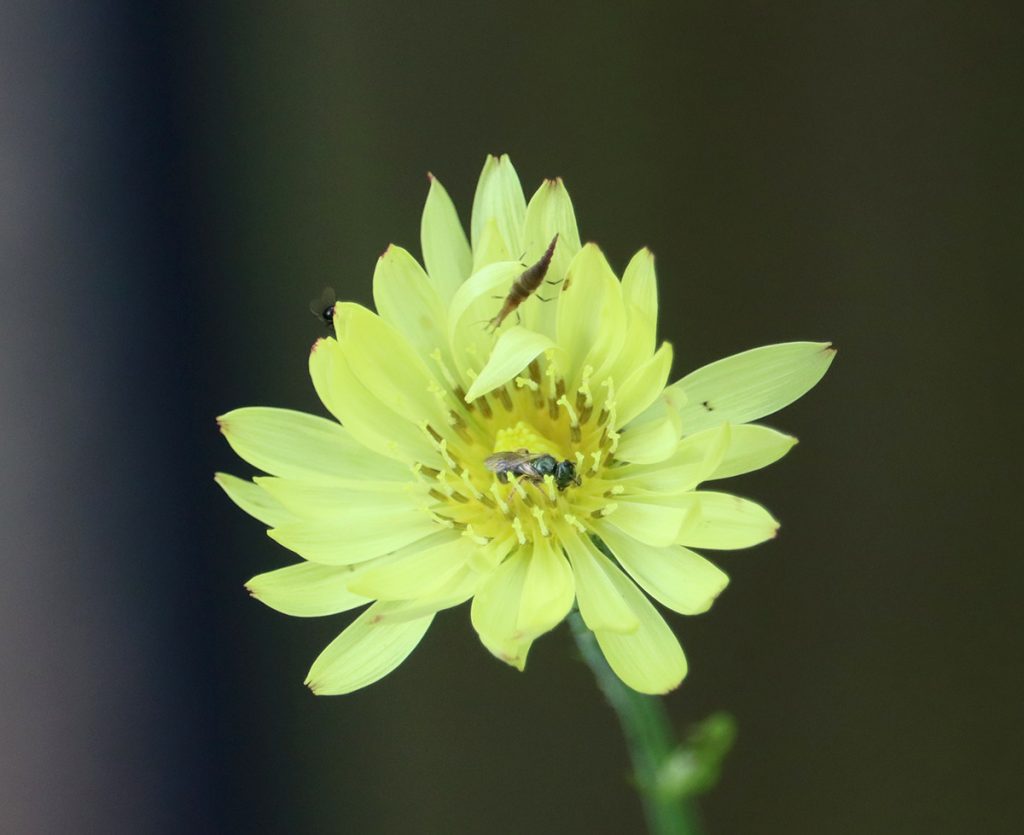
The predatory lacewing larva sits on this flower with two other insects. The small sweat bee either doesn’t notice it or doesn’t consider it a threat. Also, a small fly sits at the tip of a petal. I notice discoloration at the tips of the other petals- was this caused by the fly, or is it eating the flower where it’s starting to wither?
May 2, 2021
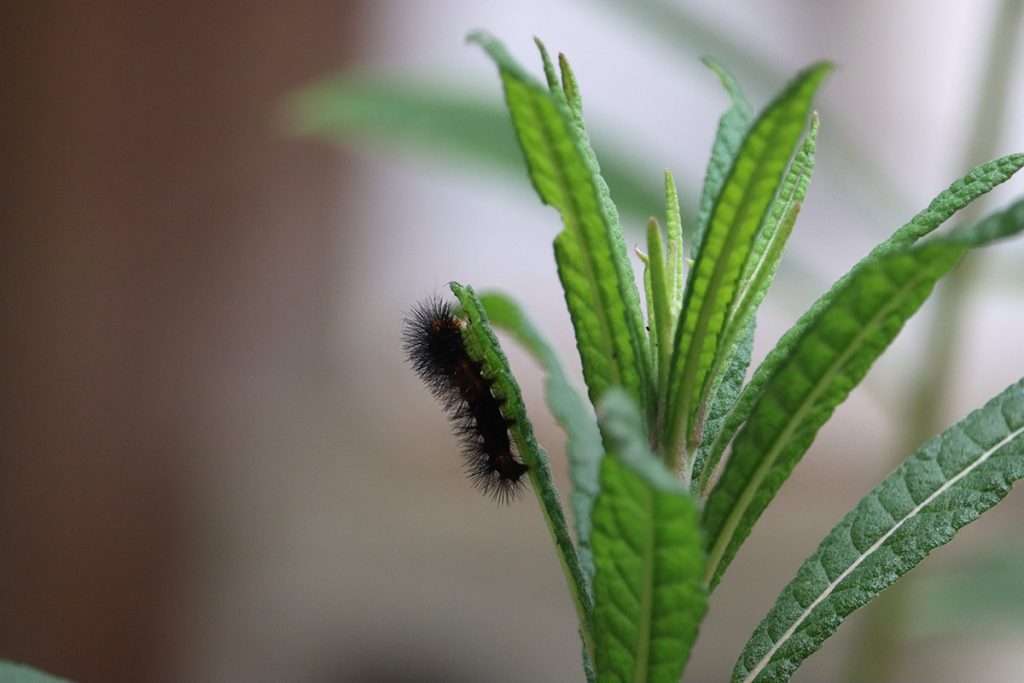
On April 22, I saw what I thought was an earlier instar version of this caterpillar. This one is much fuzzier, but you can still see the orange underneath. Here it’s not quite full size.
April 29, 2021
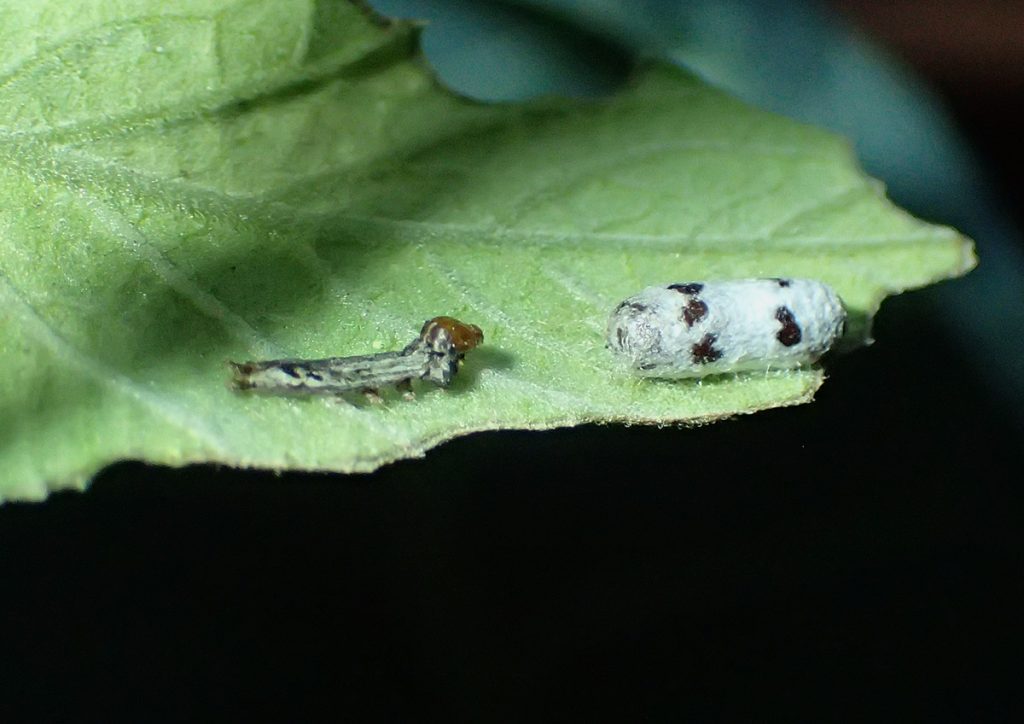
Here’s what looks like a caterpillar and a moth chrysalis at the edge of a leaf. I may still iNaturalize this.
April 27, 2021
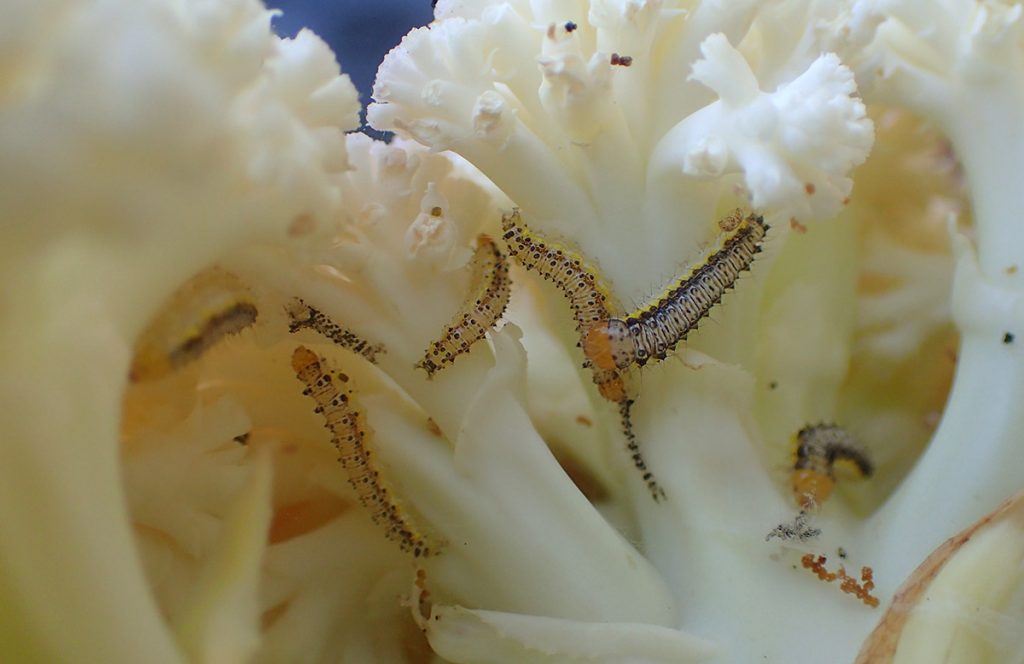
Here is where I finally went and figured out the identity of this caterpillar. The cabbage white caterpillars never went after the part of the plant that we eat. These cross-striped cabbage worm caterpillar pretty much ruined this cauliflower.
They were well hidden when I harvested the cauliflower, making ingenious use of the spaces beneath the florets. I picked these and their brethren from our Brassicas. Many of the plants have produced what they were going to for the season, but I’m still leaving in hopes of seeing more cabbage white butterfly caterpillars.
April 24, 2021
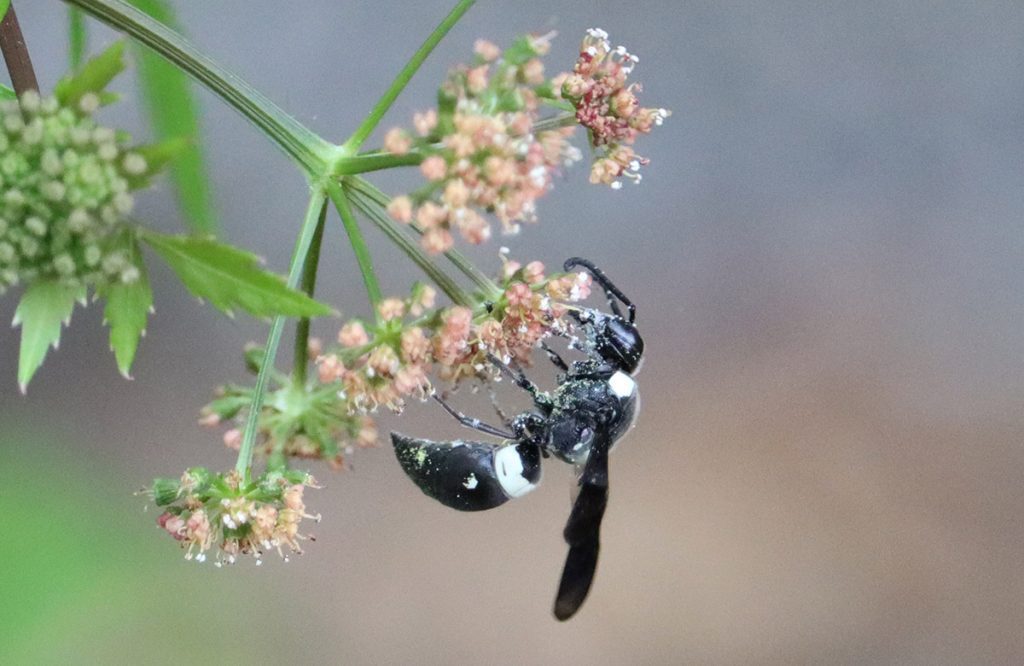
Four-toothed mason wasps nest all over our yard, and yet, other than the late summer bee balm, I never see them on our flowers. I have seen this one on the Apiaceae flowers lately. I have three species of these carrot relatives in the yard to attract black swallowtail caterpillars. Meadow parsnip and golden Alexander are the native species, but the imported food plant fennel is the only plant I’ve had that’s hosted the caterpillars.
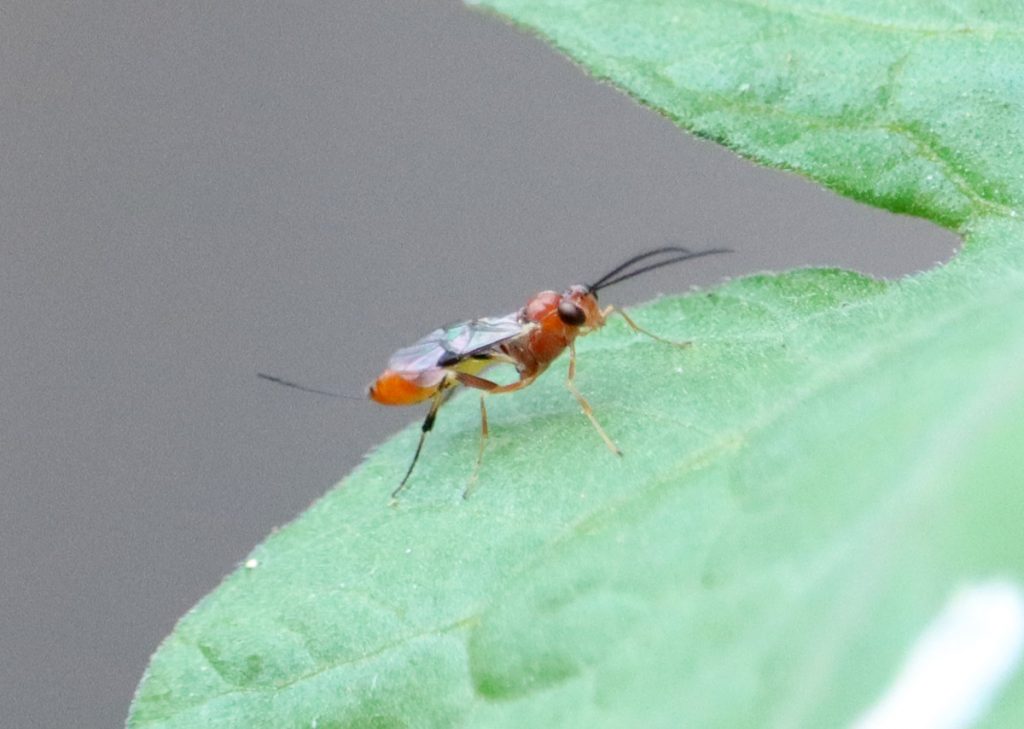
Sometimes I don’t get a species-specific identification on iNaturalist, so all I know about this wasp is that it is a parasitoid breeder. Hopefully the species it parasitizes is something that gives me trouble and not one of the insects I like. But I don’t get to choose that.
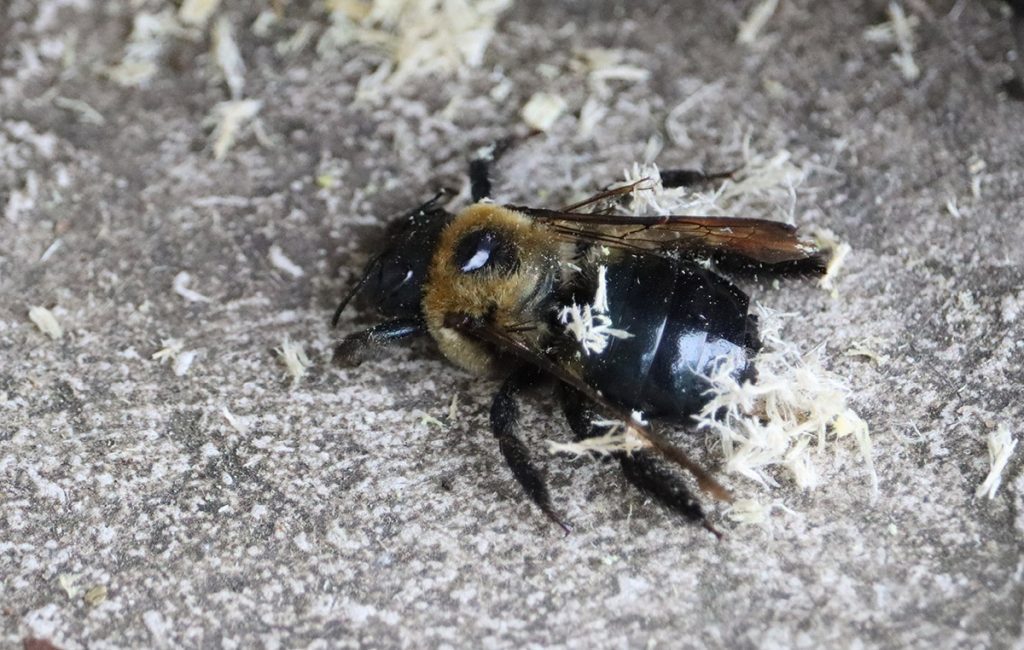
This carpenter bee lies under a carpenter be nest, in wood shavings likely created while the nest was excavated. I have seen another carpenter entering this nest. Was there a conflict? Out with the old, in with the new? Strangely enough, this isn’t the first dead or near dead carpenter I’ve seen on the top back step over the years.
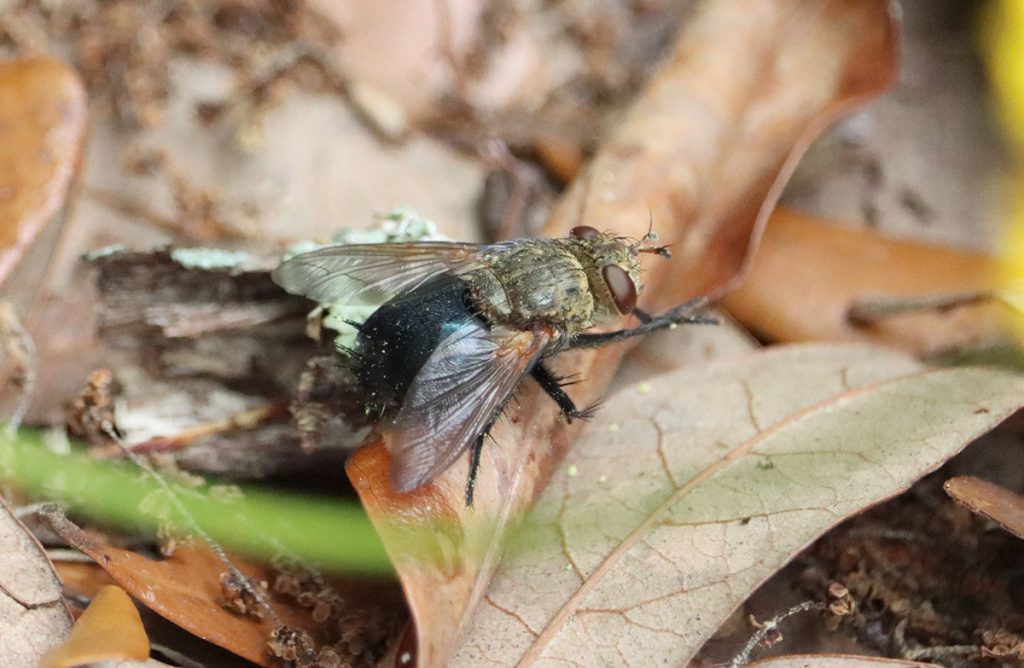
Archytas is the best iNaturalist guess I have right now. I couldn’t find a lot of information about the genus of flies, though many of their photos have them on flowers. This is a tachinid fly, many of which are parasitoid breeders.
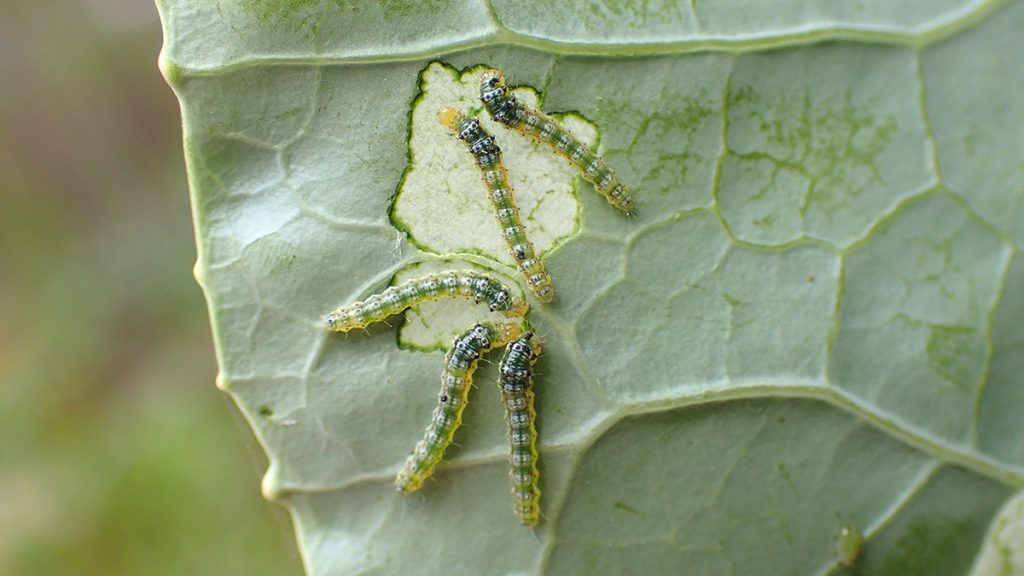
Caterpillars can change a lot while growing from instar to instar, but I was starting to think these weren’t the solid green cabbage whites. I took a fair amount of photos during this busier time, but I didn’t update this blog page for over a month. And that’s when I start looking into the backyard critters and weeds.
April 23, 2021
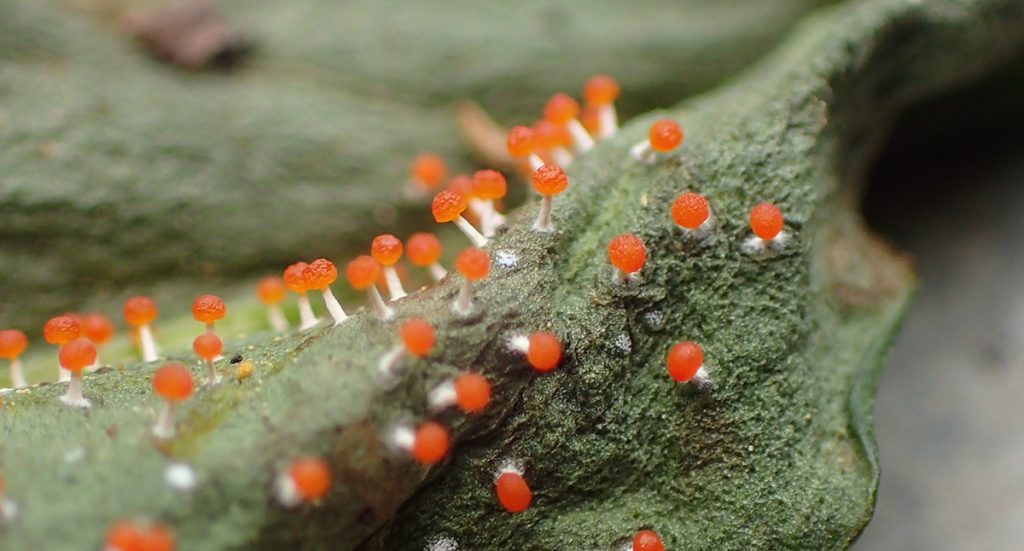
I did see pollinators today, but I want to start with this out-of-the-ordinary find. I have this Pentsemon plant I bought last year, that became leafy without ever flowering. Recently, stalks have emerged from the leaf mass, so it should flower soon. But at the same time it started shooting up, its leaves started curling up and shriveling, slowly moving from one edge of the pot towards the center.
Finally, I went to remove the dead leaves and see if there might have been something killing it. This is what I saw when I pulled the top layer of dead leaves away.
To my naked eye, these looked like insect eggs. Maybe I had an infestation? Taking a photo with a macro lens, they started looking like minuscule mushrooms. Finally, on iNaturalist, I learned that this is in fact a slime mold. Anyhow, removing the leaves seems to have helped the plant, and the biodiversity of our yard continues to amaze me.
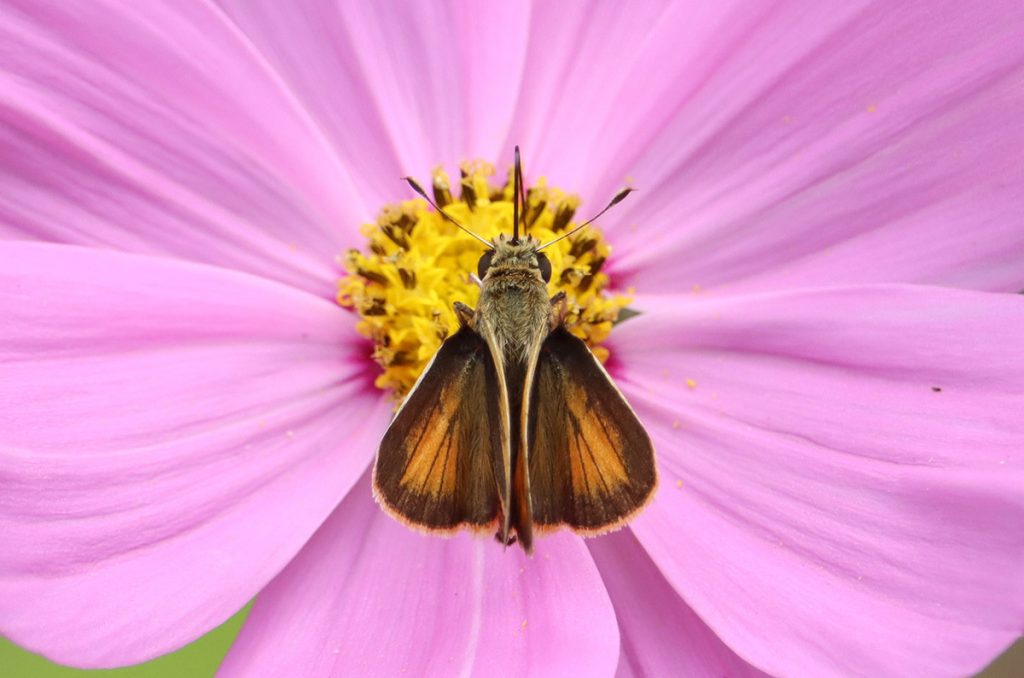
The cosmos have been popular. Comparing photos, many of our flowers are behind where they were last year. Maybe it was that we had a colder winter, or that many of our plants had become overgrown and woody, and I cut them back. So these and the coreopsis have been the main attraction.
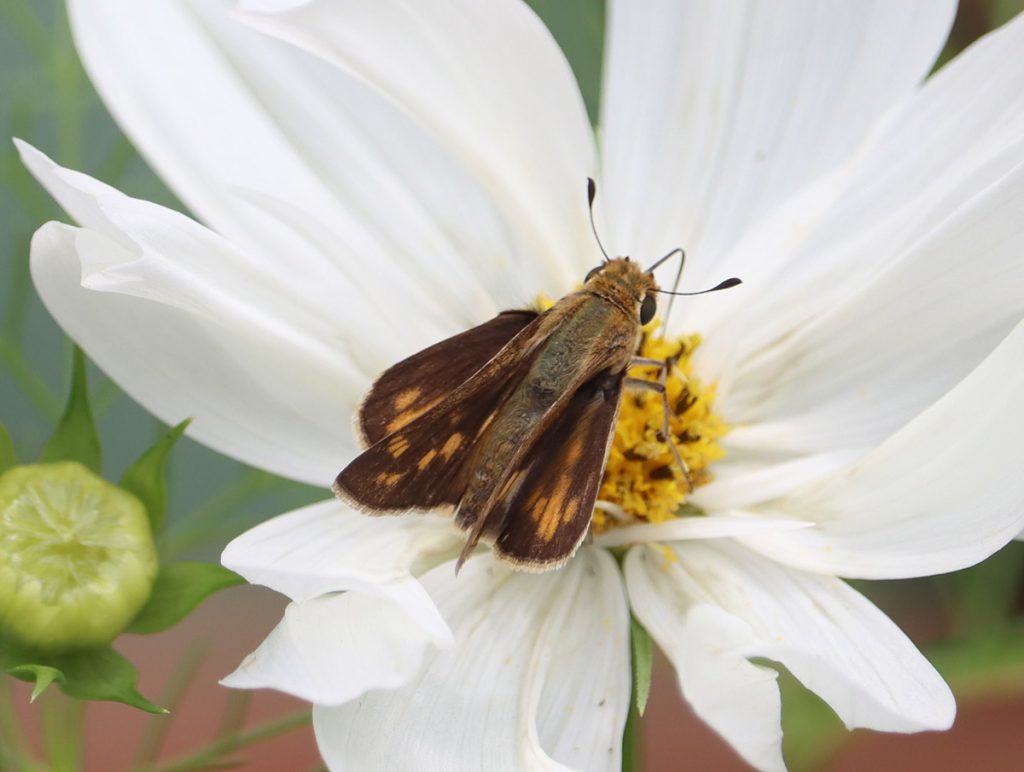
Looking up fiery skippers, I found a handy photo on an IFAS page to help tell males from females. Maybe a breeding pair?
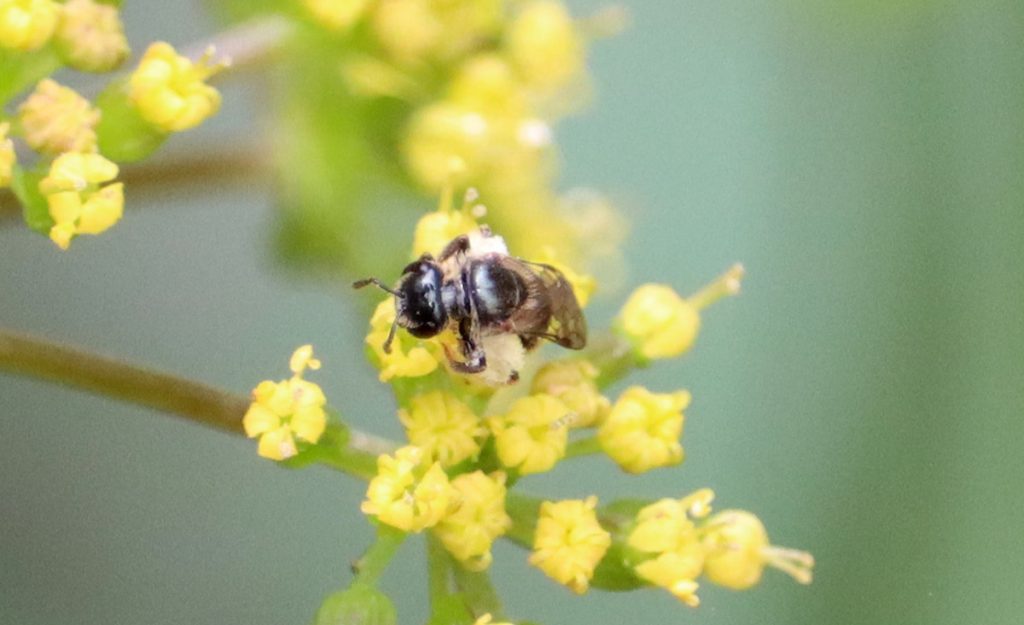
I keep sharing photos of these small sweat bees on different flowers. I enjoy seeing waves of new blooms, and how pollinators move from one to the other. And then, some pollinators only show up for certain flowers. From the beginning of spring to the beginning of fall, our mix of bees, wasp, butterflies, moths, and other insects is always changing.
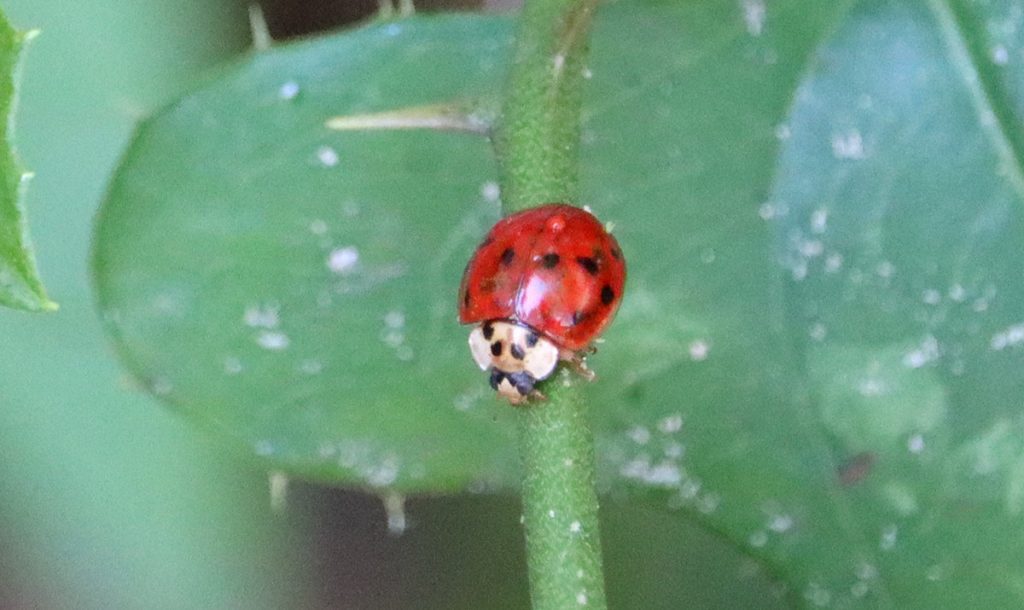
And here’s another Asian lady beetle. This one has the tell tale “white m” on its forehead; in fact it has hardly any black on its head.
April 22, 2021
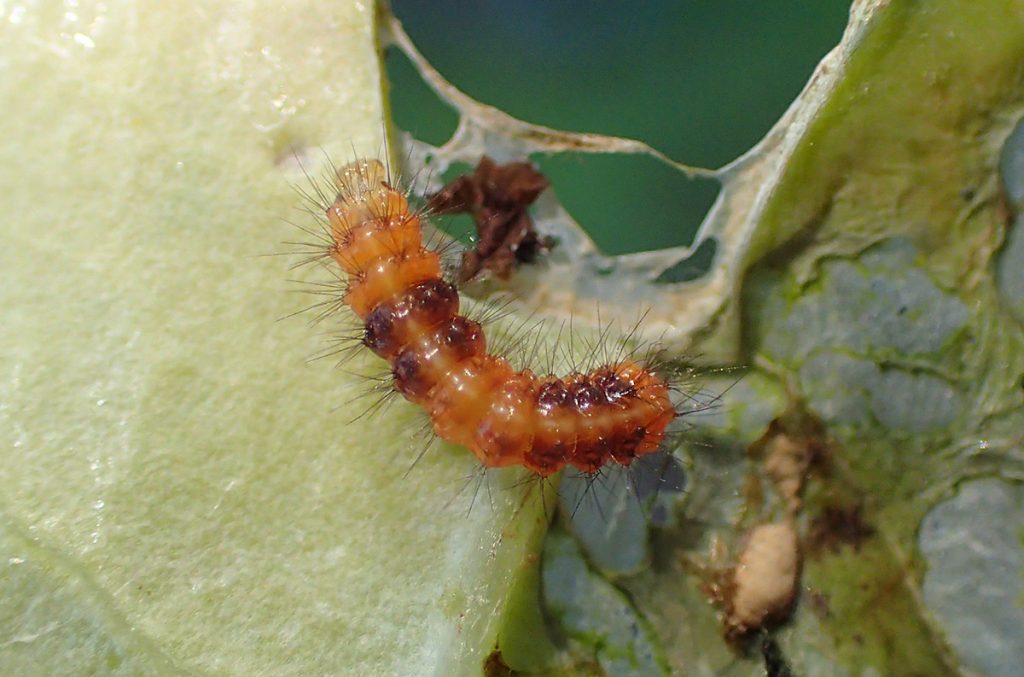
When they’re larger, giant leopard moth caterpillars are black and fuzzy, but at certain angles, you can see the reddish body beneath the bristles. I think this is an early instar of that caterpillar. This has been a productive year for moths and butterflies reproducing.
April 20, 2021
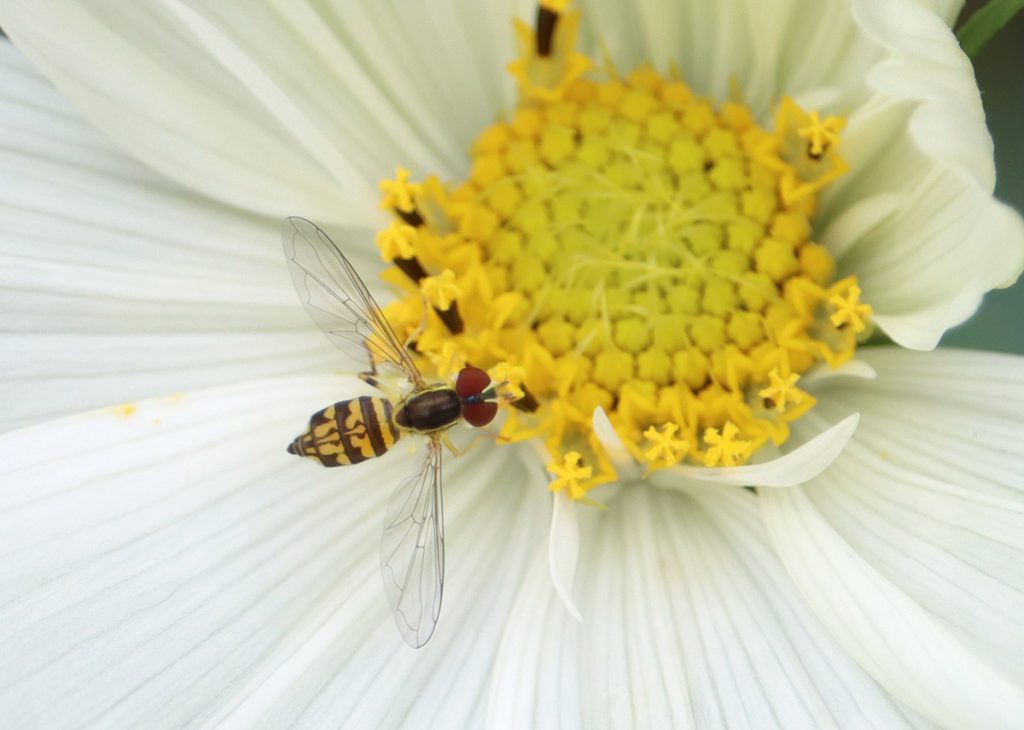
The cosmos are proving popular with a lot of our pollinators, like this tiny hoverfly.
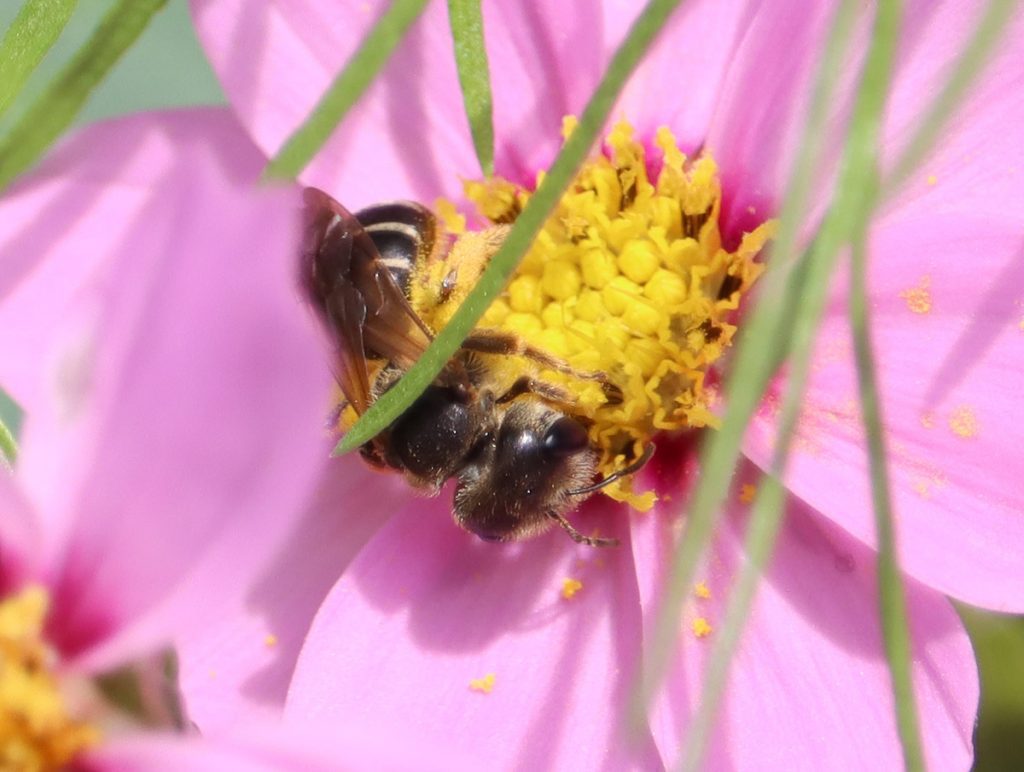
Here’s another Poey’s furrow bee (or the same one?) on a cosmo flower. I’ve seen up to three at a time hopping between flowers in the yard.
We have coreopsis starting to bloom all over the yard, many from plants that sprouted last year but didn’t flower. And I’ve planted more blue and purple-eyed grasses in different spots. Our smallest bees like these and the cosmos.
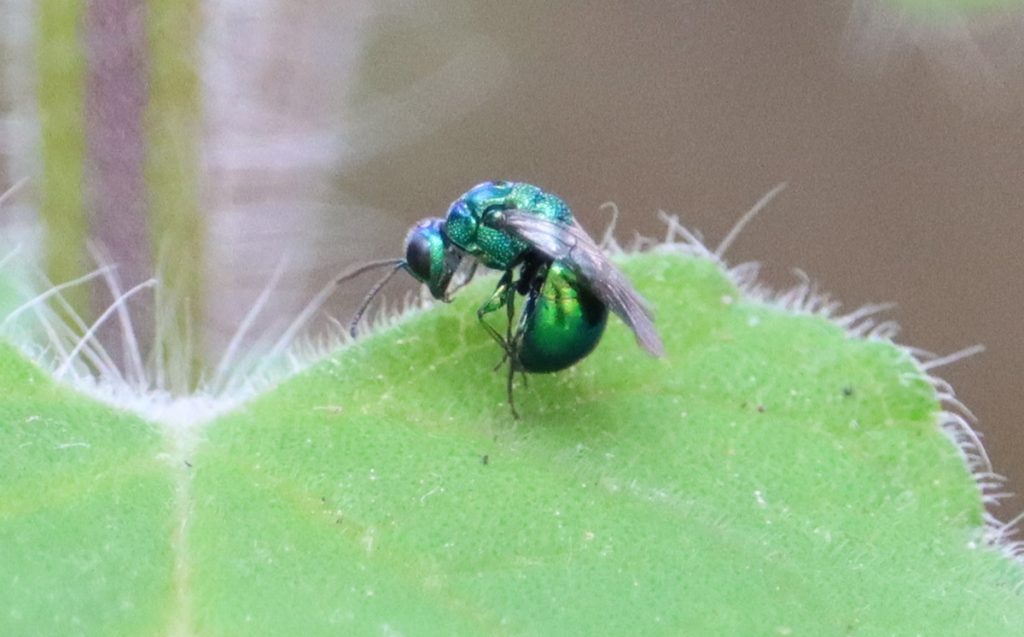
Little blue bees are common in our yard. This is an Augochlorine bee, which looks similar to female brown-winged striped sweat bees. The latter of those have more pronounced stripes and muddier looking wings. I fell *mostly* confident that I can tell the two apart. There are a few different Augochlorine bees in our area, and telling those apart can be a little more difficult for me.
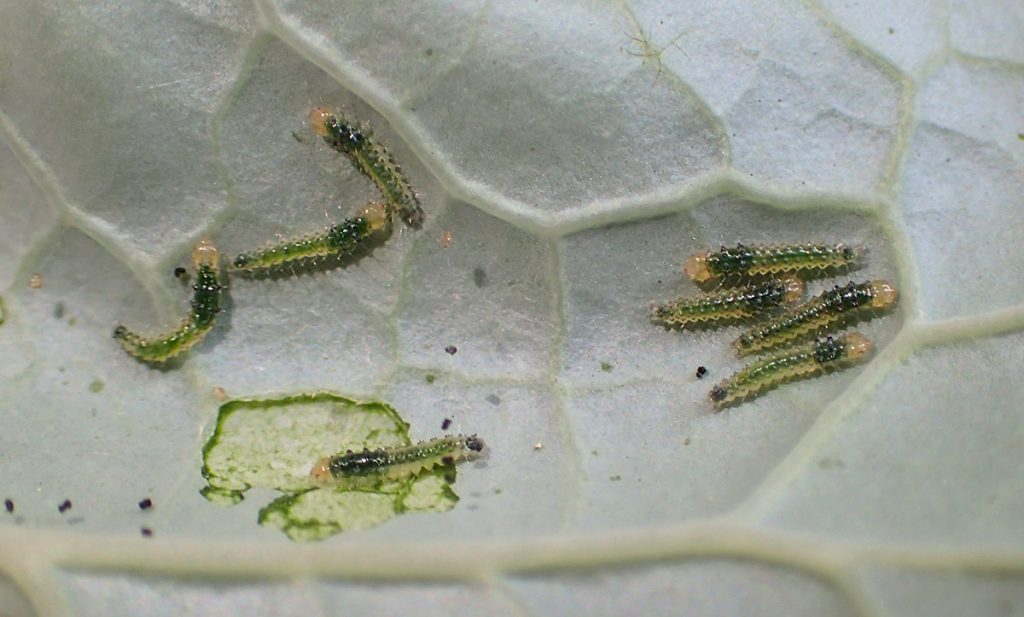
That perfect little green cabbage white chrysalis disappeared one day. I’d like to think it eclosed and flew off, but that would have left a husk. Not long after, I saw a cabbage white in the yard. Did it come rom a hidden chrysalis, or was this a mother here to lay eggs?
When I saw these caterpillars, I figured they were cabbage white butterflies. I should have checked sooner. But late April and into May were busy, and I didn’t pay as close attention as I could have.
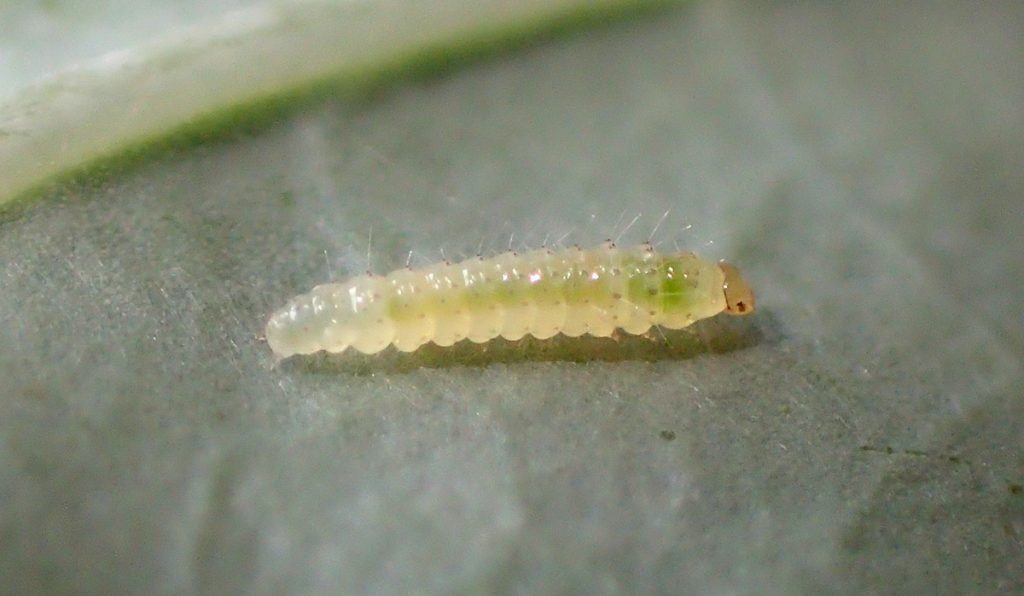
And here’s another cute little caterpillar. I’ve waited too long to update this page, and I can’t remember what kind of leaf we’re seeing here.
April 19, 2021
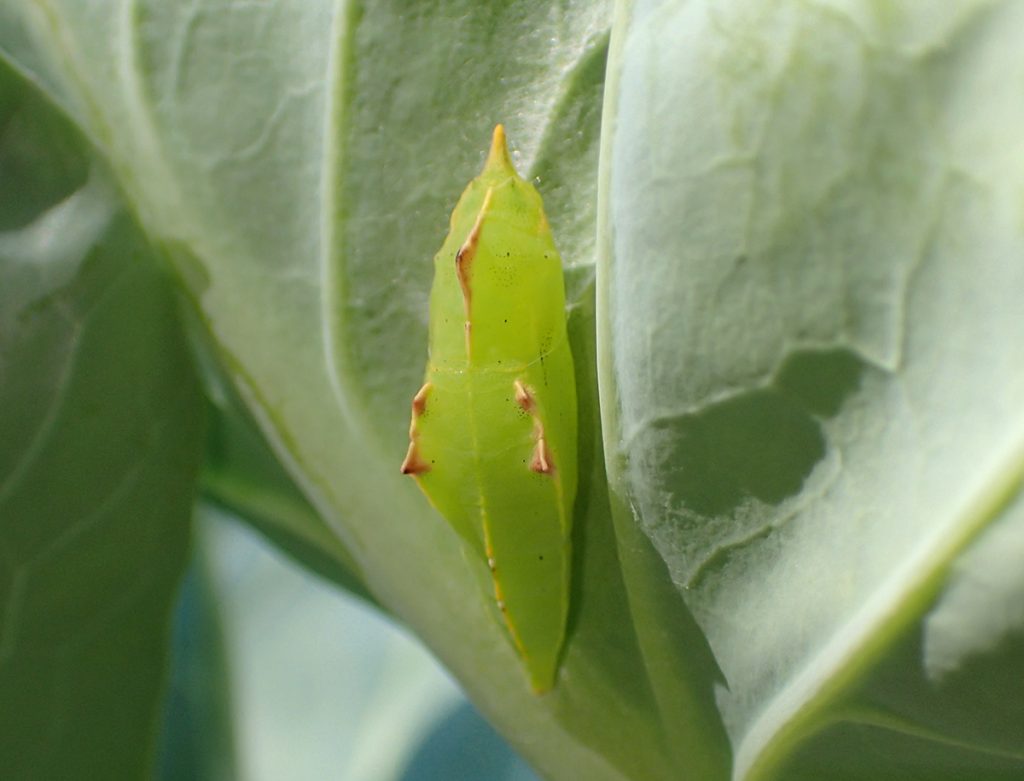
Two cabbage white caterpillars have made chrysalides, though one didn’t quite work out. I don’t know if they always pupate directly on the host plant, so there may be others in the yard.
It’s so perfect and green.
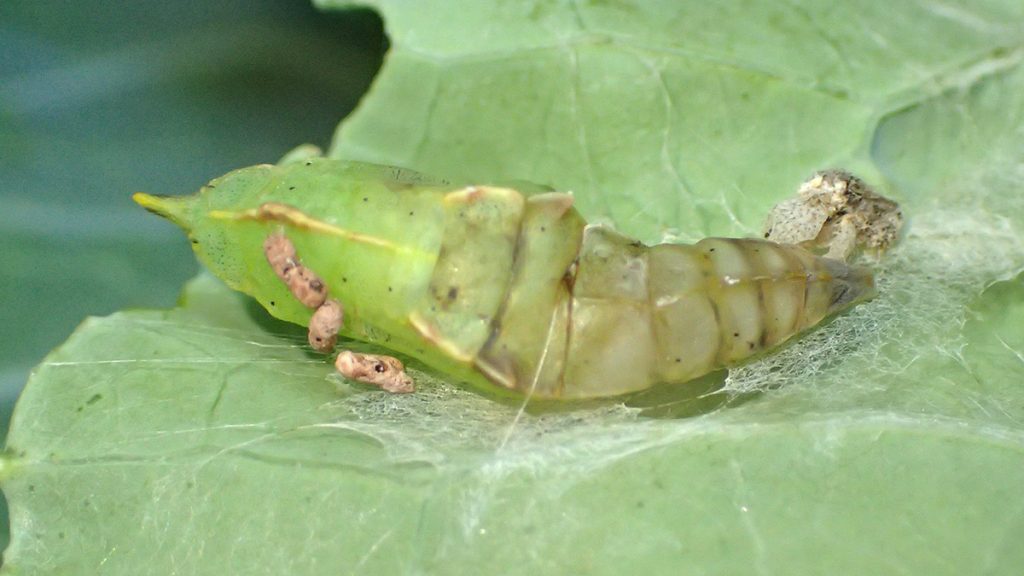
This one didn’t finish the process. I wonder why?
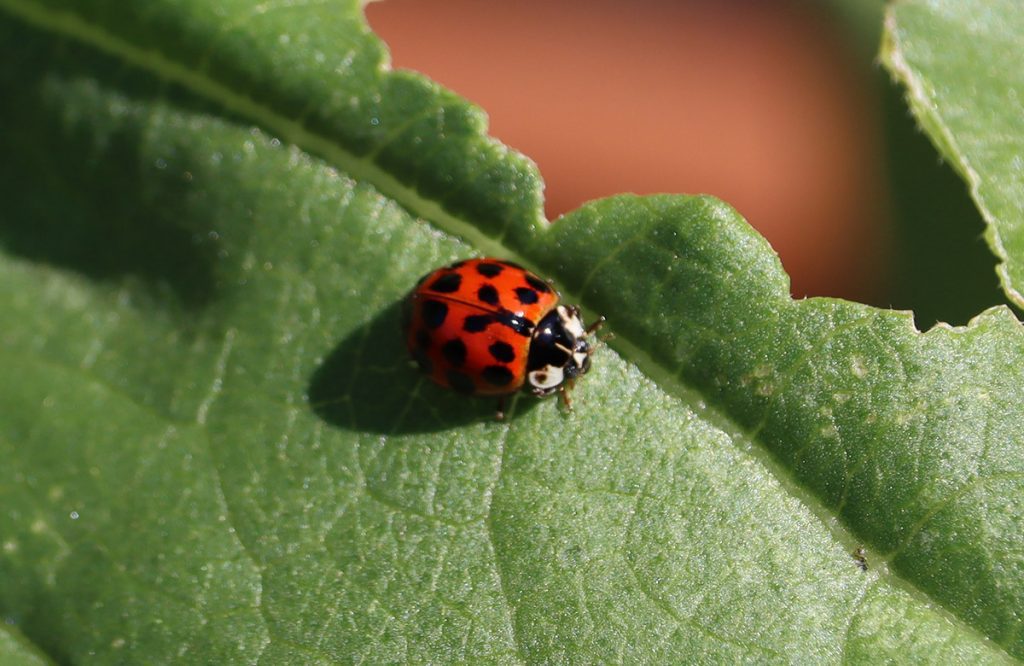
Looking at iNaturalist observations for Leon County, I see that the vast majority are the invasive Asian lady beetle. I’m pretty sure that’s what I have here- they’re consistently in the yard. I have trouble telling them apart, so I looked for info on telling them apart.
Asian lady beetles are supposed to have a white “M” where their wings meet their head. This one doesn’t have that. And yet, that’s iNaturalist’s top suggestion. They do vary in their appearance.
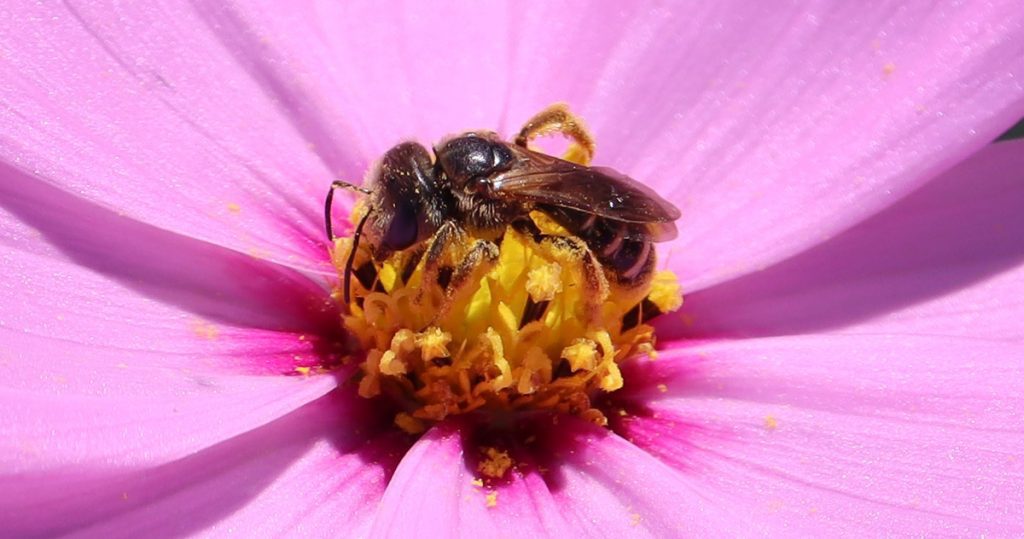
We have a few cosmos and zinnias popping up from seeds we planted, and they’re up before a lot of our other flowers. The Poey’s furrow bees and Dialictus bees seem to like them so far.
April 14, 2021
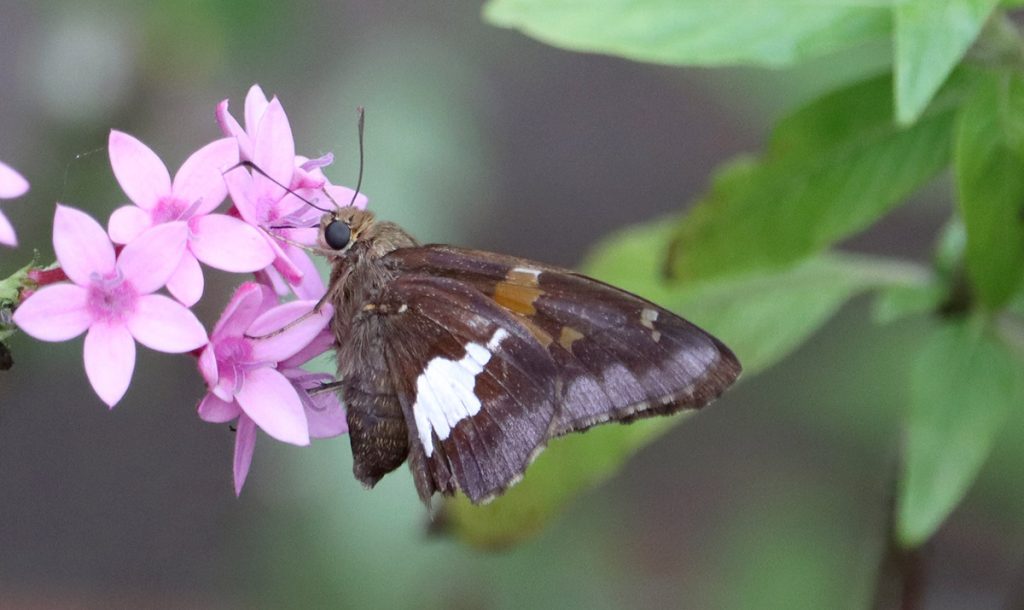
I’ve seen this silver spotted skipper passing through the last couple of days.
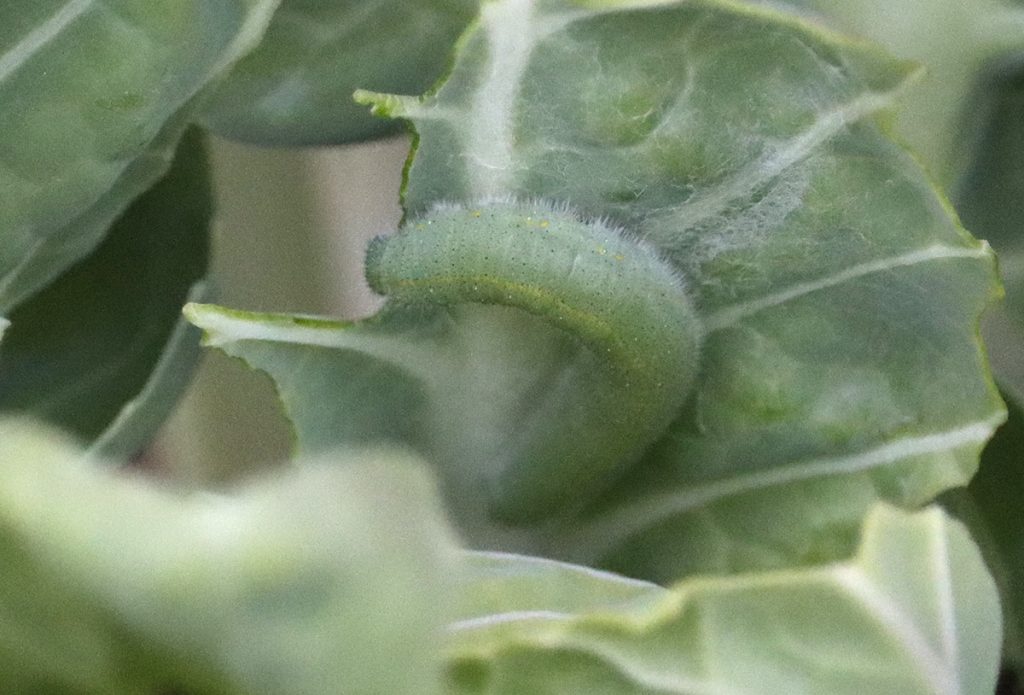
We have a handful of cabbage white caterpillars gently (for now) grazing on our brassicas.
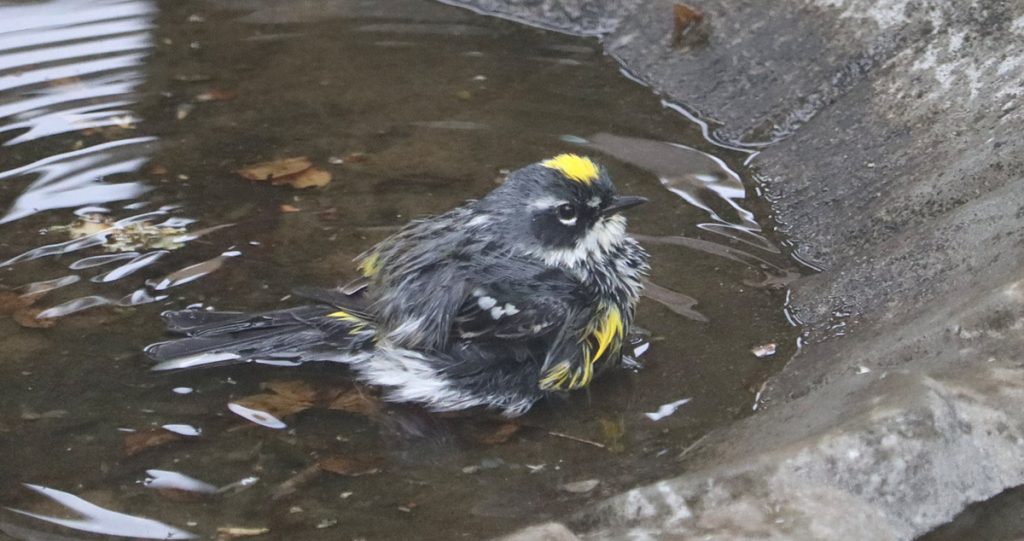
Yellow-rumped warblers are common in our yard throughout the winter. Like many winter migrants visiting north Florida then, they’re mostly gray during their time here. Only their rumps are yellow with that plumage, which I usually notice when they’re in flight or if I see one from a certain angle. Anyhow, here we are, well into the spring, and here’s one in the bird bath. It’s in its summer breeding plumage, likely soon to fly north and find a mate.
April 13, 2021
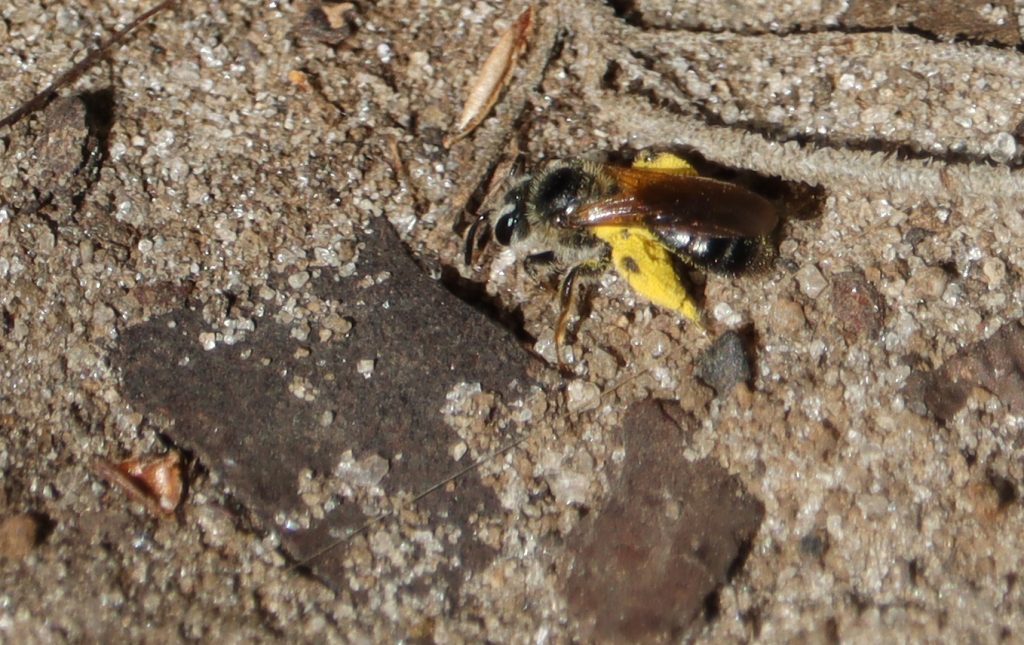
iNaturalist says Poey’s furrow bee for this one, but the yellow abdominal stripes aren’t there, and its head seems too small. Maybe a Dialictus? It soon jumps under that leaf. The sweat bees in the yard seem to be making new nests, and they always seem to pick spots with leaf cover- even if it’s merely a single leaf.
Edit May 24, 2021– iNaturalist’s top bee curator identified this as a mining bee in the genus Andrena. And I had just photographed the bee in the act of mining. I saw another Andrena a month ago on cherry laurel blossoms. Scrolling through this post, I can see how much hairier this bee is than my original Dialictus guess.
Female bees often breed before overwintering, hiding in leaf litter. In the spring, they dig nests and lay eggs. Bees have been busy making nests this week, so within a few weeks, we’ll be seeing many more of them on flowers.
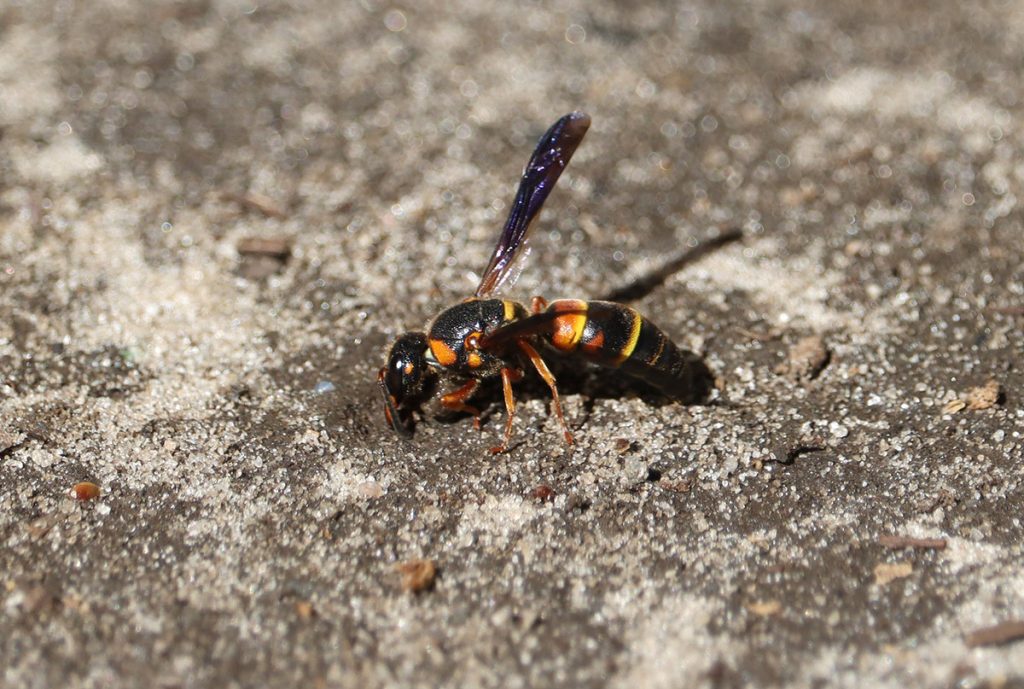
Here’s a mason wasp doing what mason wasps do- gathering soil to cement their nests. This is one of the Euodynerus genus wasps that don’t seem to fit with the other local species of its genus (there are five Euodynerus species in Tallahassee). I’ve been trying to photograph them as much as possible, because the researcher who’s been confounded by these wasps in our yard wanted to see more of it. The more visual data I provide in iNaturalist, the more he has to work with.
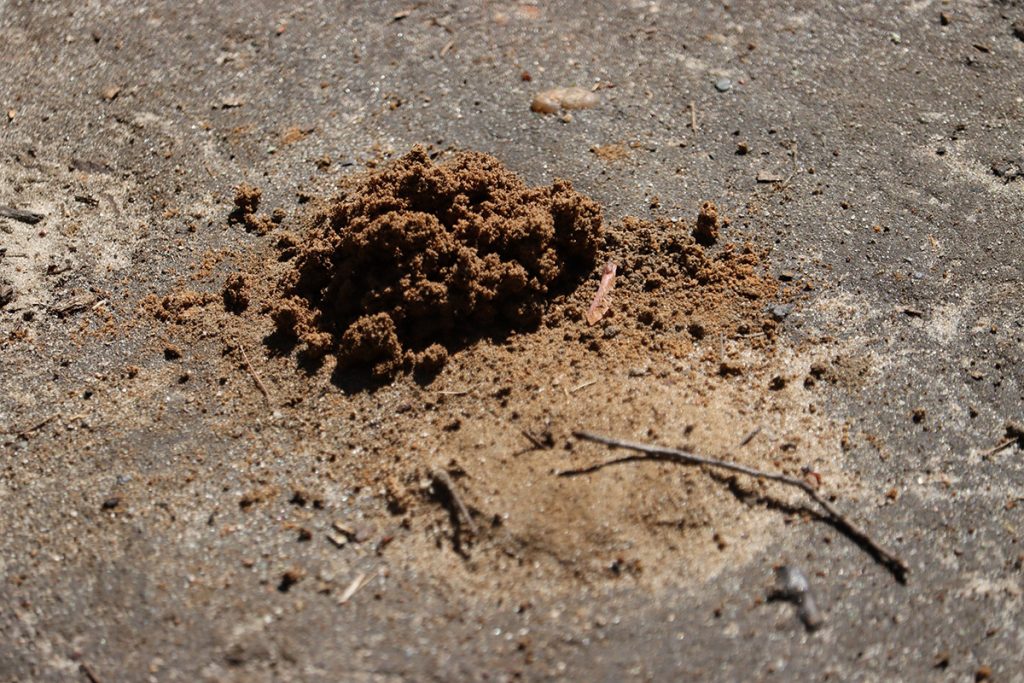
Every day we see more piles of earth, or holes of various sizes in bare patches of soil. And more caterpillars and other larvae. Insects have awoken after winter, and are reproducing. Soon, we’re going to be seeing more insects flying.
April 12, 2021
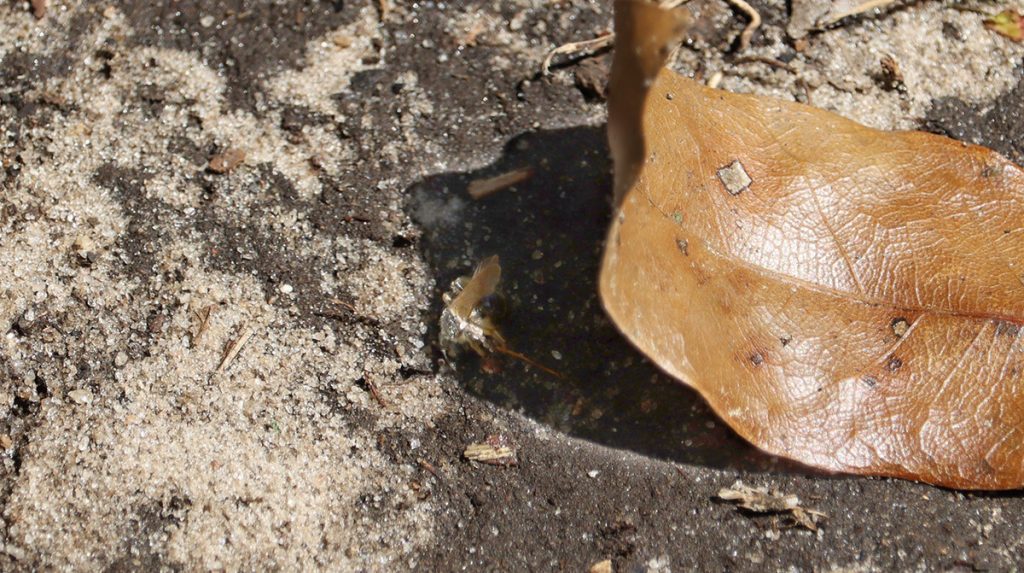
Earlier in the day, I saw a blue sweat bee quickly find an opening in leaf litter, and dive in. And now, I see another bee (perhaps a Poey’s furrow bee?) hover around, finally jumping into the shade of this leaf.
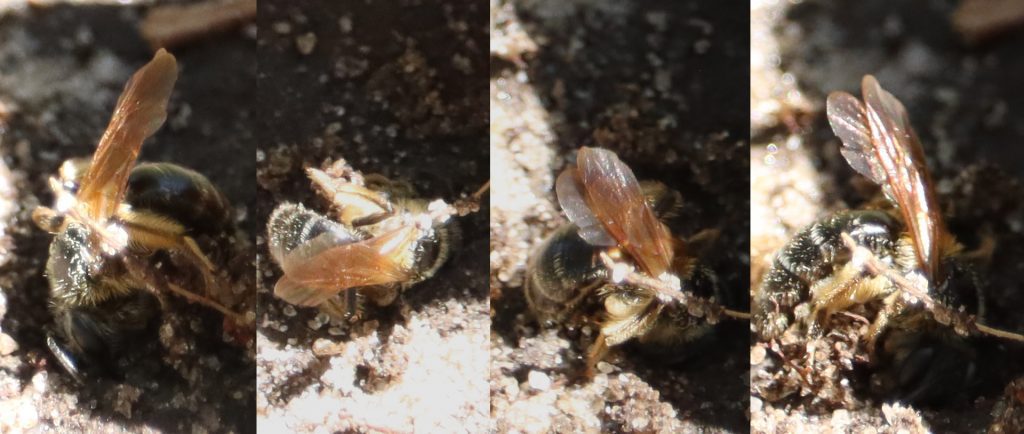
The bee seems to be digging a new nest.
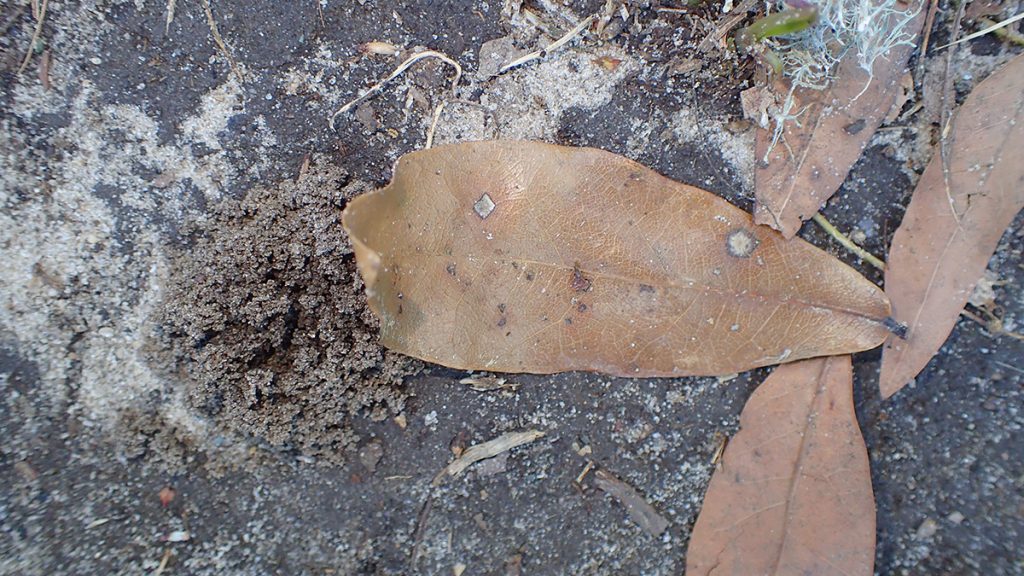
Later, I come out to see this fresh pile of soil.
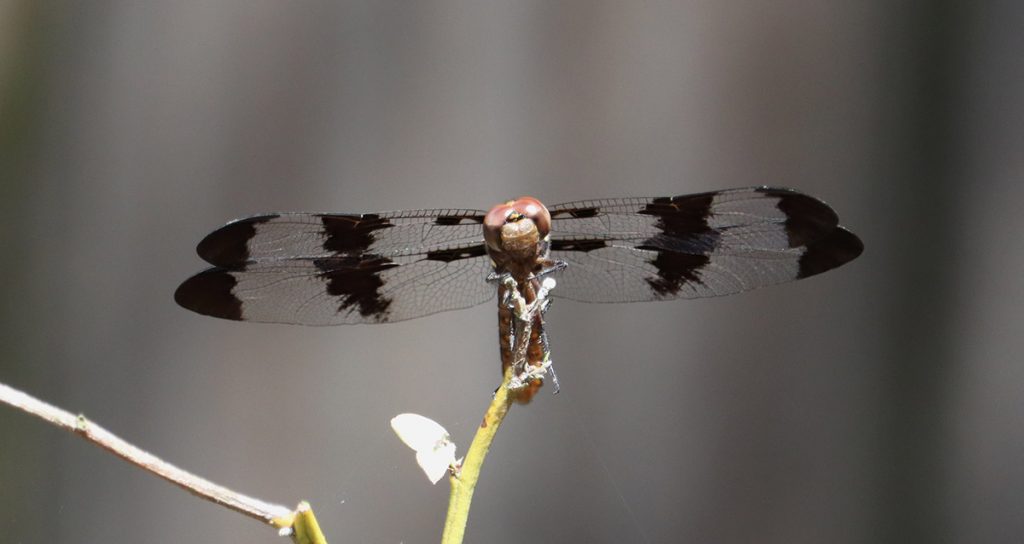
As we see more and more larval and newly emerged insects, it makes sense we’d start to see more predators as well.
April 11, 2021
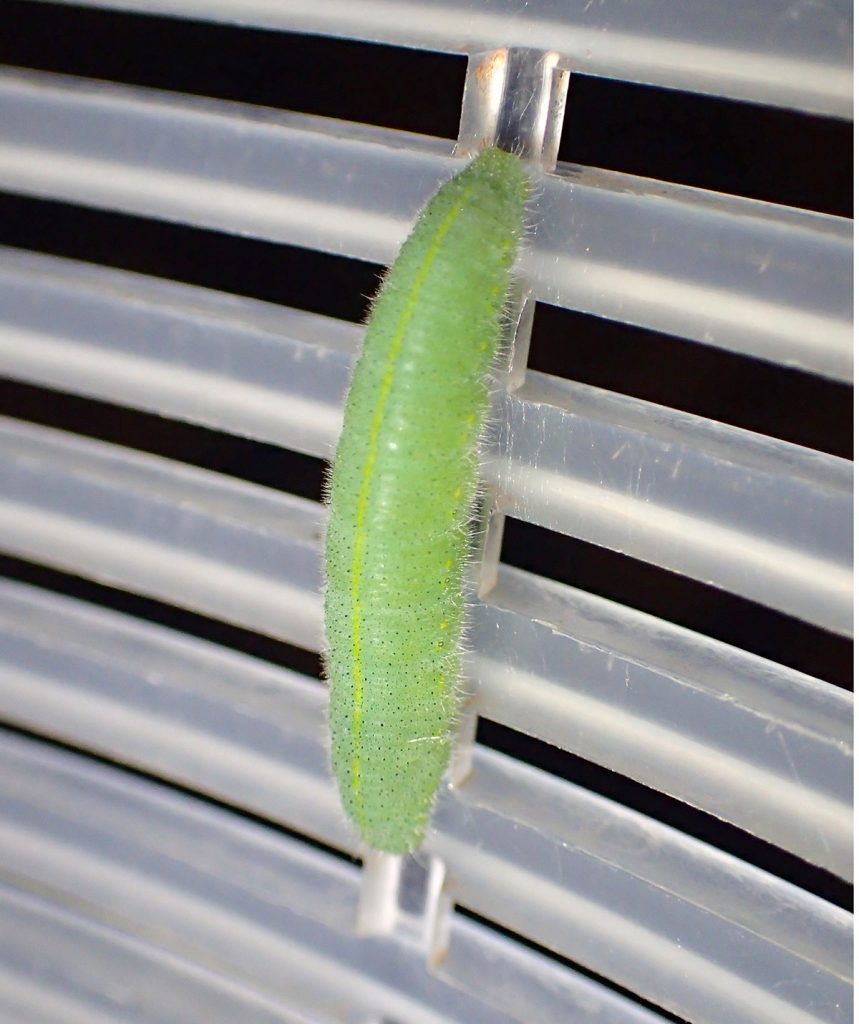
We ate that kale today in a delicious pasta Amy made. When I went to wash the salad spinner after dinner, I found this caterpillar hanging out. It must have been smaller than the others we picked off of the kale, hiding more easily in the leaves. Then it spent a few days in the fridge, nibbling on leaves and growing.
Knowing what it was, and wanting to get photos of a new butterfly’s caterpillars and chrysalides, I placed it on a cauliflower plant outside. They have plenty of large leaves, and unlike slugs, these caterpillars won’t go after the cauliflower itself.
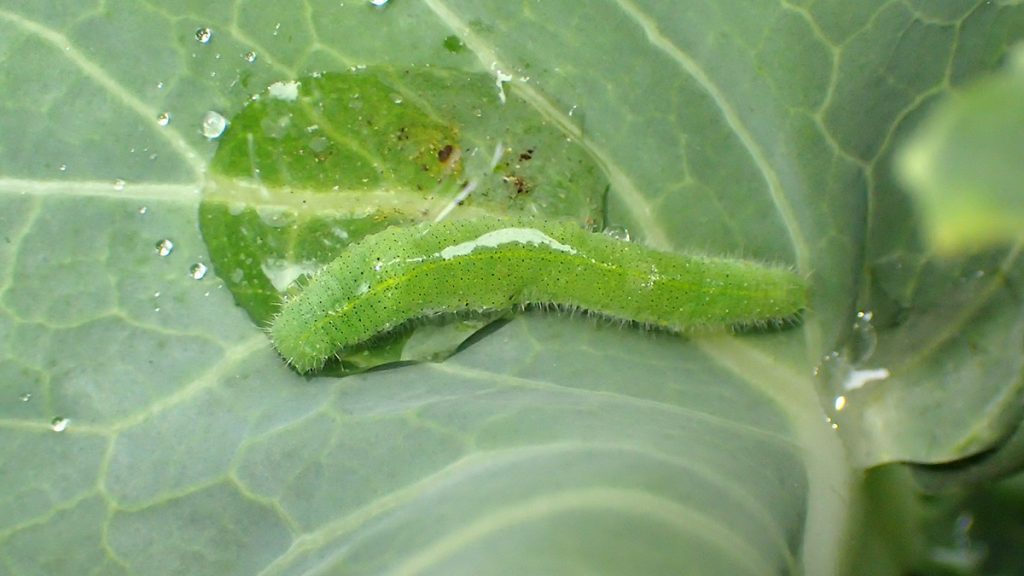
Earlier in the day, I’d found this caterpillar with it’s head in a large drop of water. I shook the water free, afraid it might drown. Then one of the children theorized that it had been drinking. Maybe?
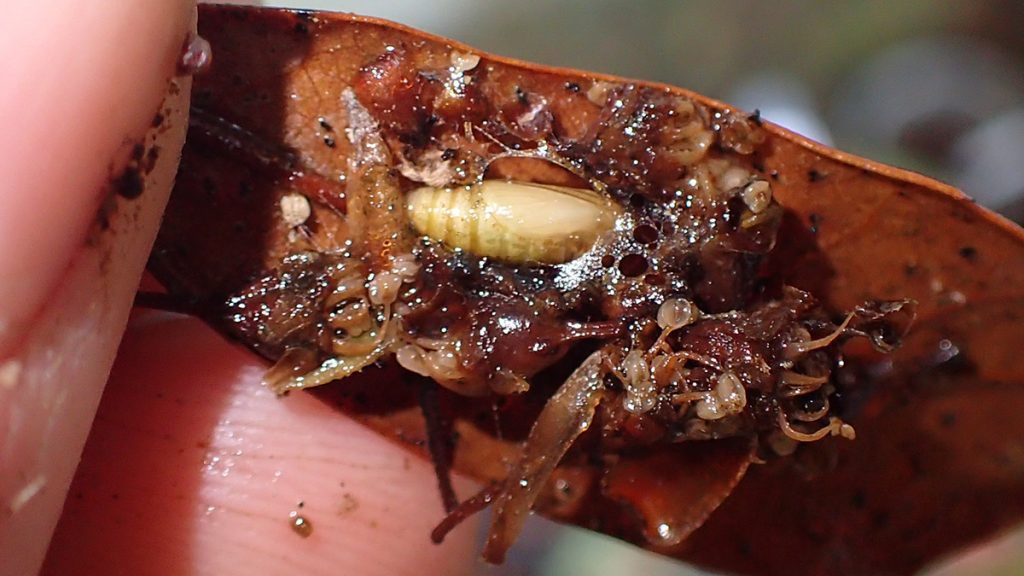
Another wet and wonderful yard work day. I was picking up leaves when I found this chrysalis- I’m guessing a moth of some sort? I love the sludge of decomposed pollen and tiny mushrooms. There’s so much life in a pile of leaves, if you let it sit for a while.
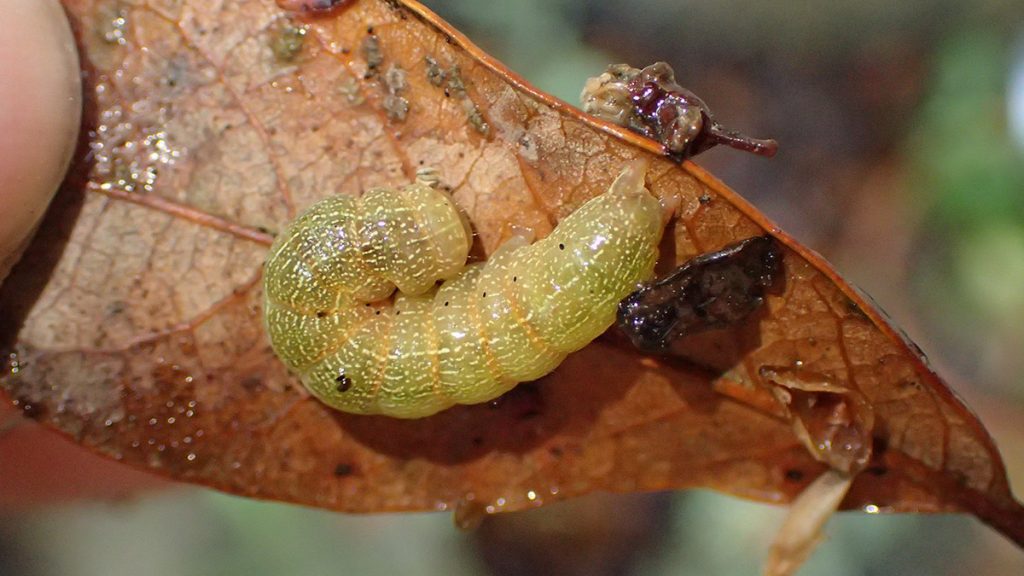
This caterpillar was under a leaf in the same pile. The pile had dumped down from a screen-topped area where we shade some plants. I’m not sure what this caterpillar is, and neither is iNaturalist, which recommends various moths with no clear leader.
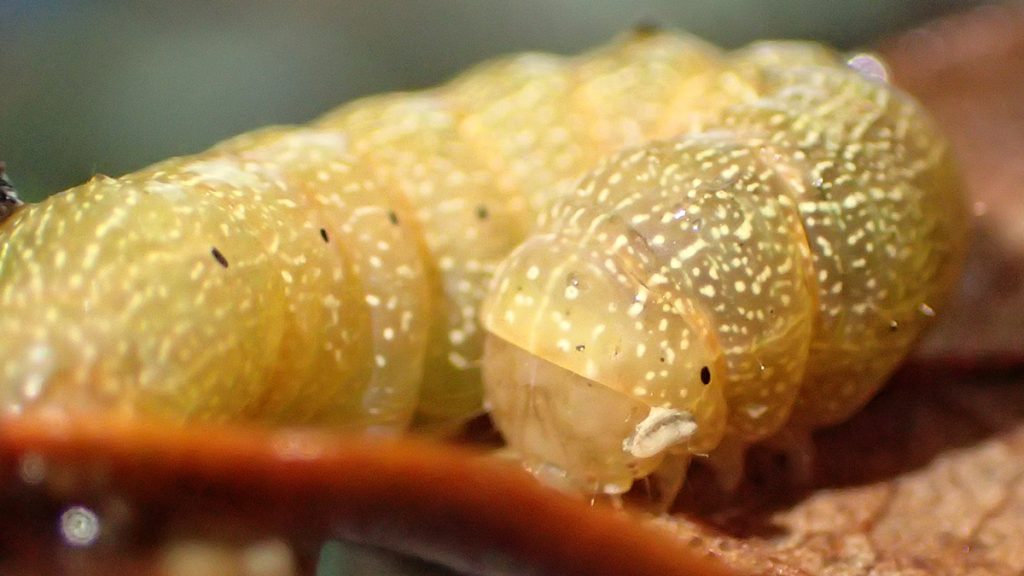
April 9, 2021
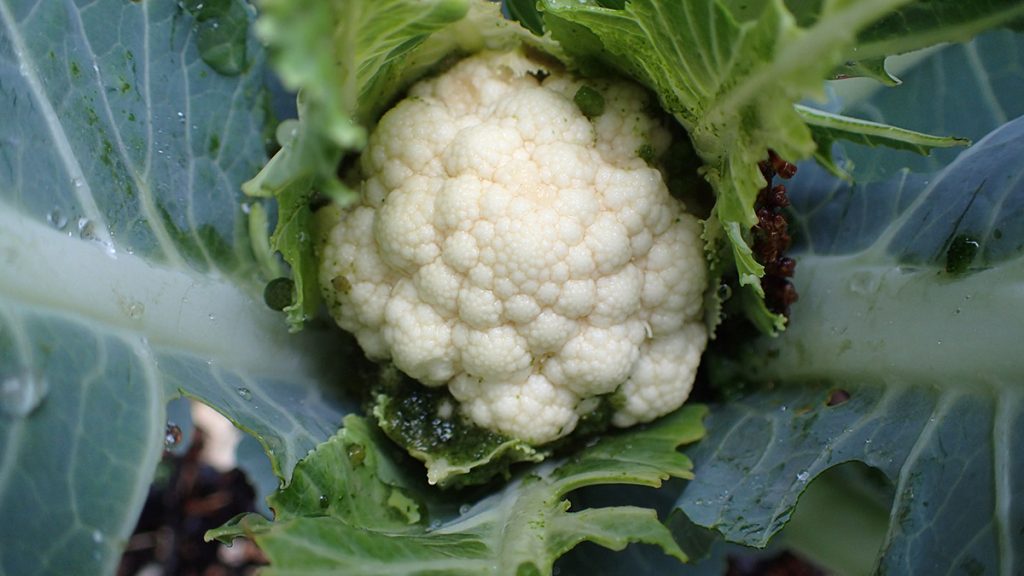
The next day, I found the same caterpillars on a different brassicid- mustard family plants, which include broccoli, chard, kale, Brussels sprouts, and so on. So this caterpillar is a specialist.
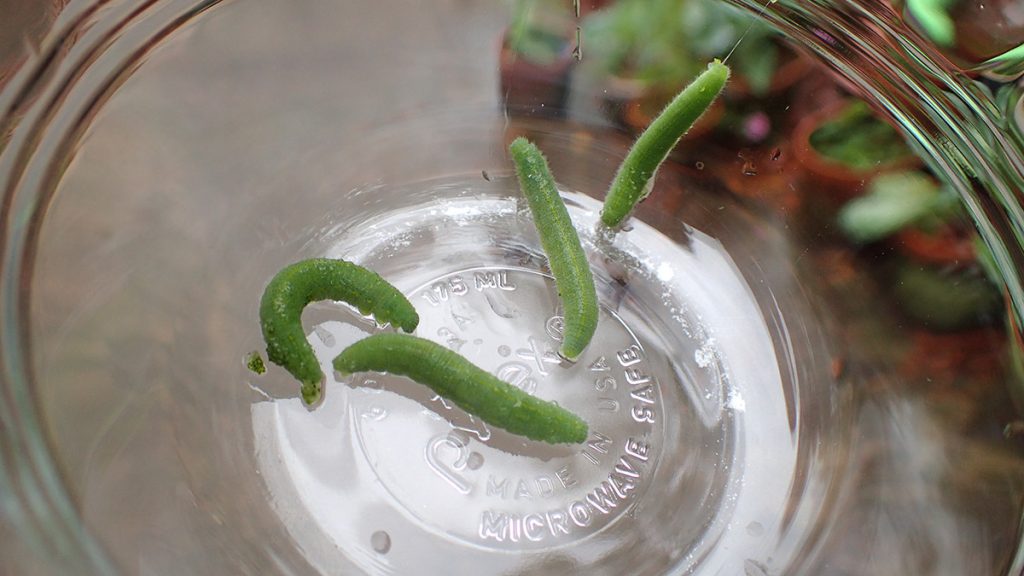
I relocated these, but later I finally took out that butterfly guide and saw that there was a butterfly that hosted on Brassicaceae. And it’s caterpillars looked just like these. I decided to keep any further caterpillars I found.
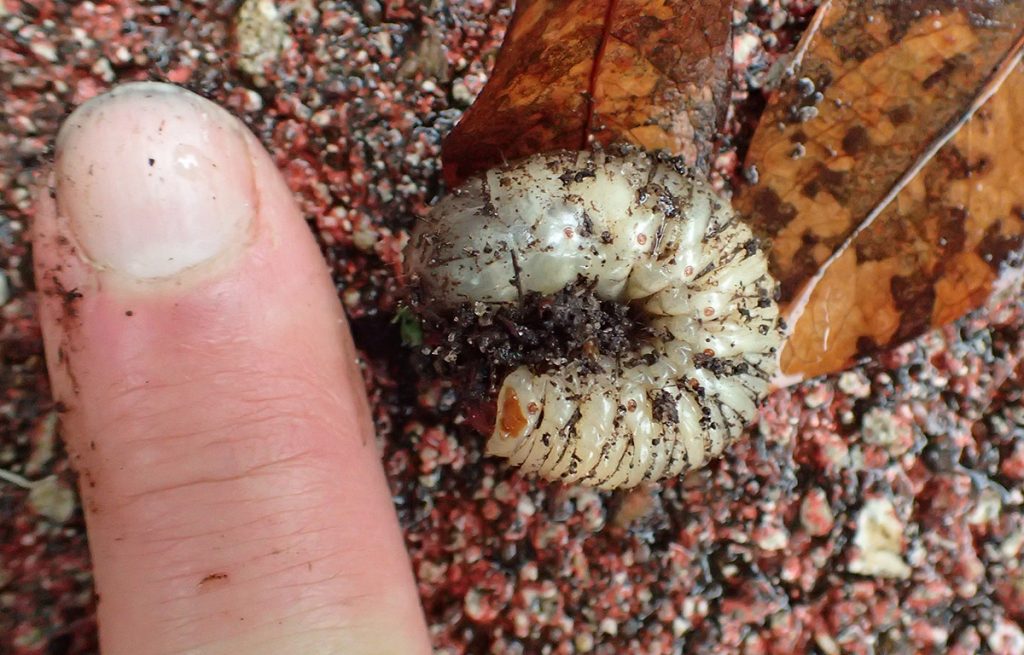
The morning rain and the general wet atmosphere of the day made it an amazing day for replanting seedlings and newly bought plants. Unlike on hotter, drier days, every plant looked immediately happy afterwards. I found many worms and other ground dwelling critters, including this grody looking beetle larva.
April 8, 2021
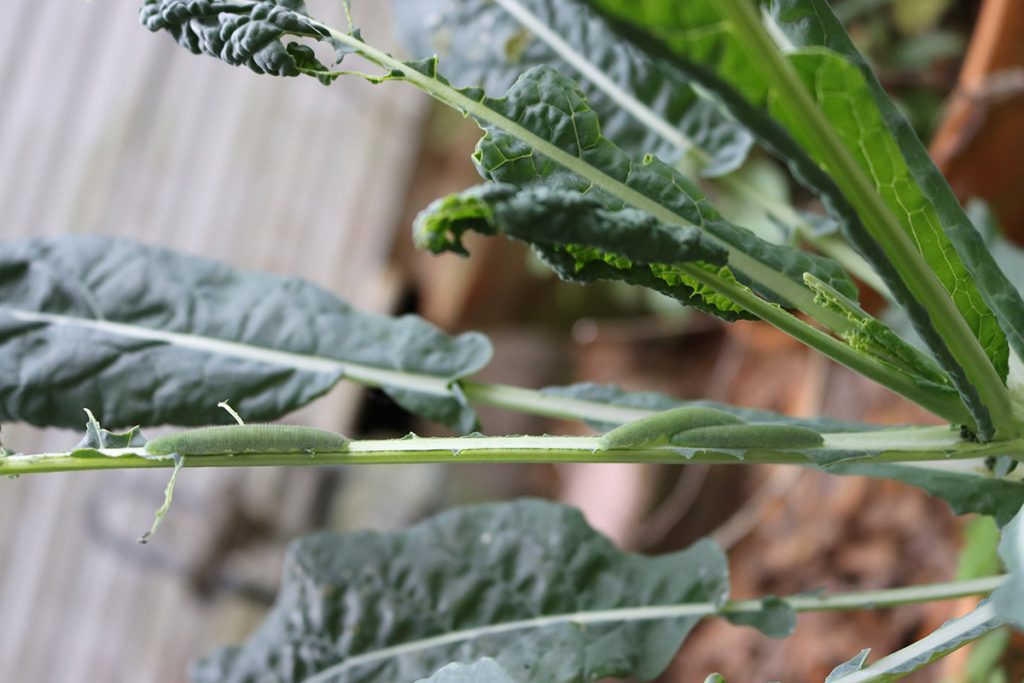
Yesterday, I loved what turned out to be a cutworm, a pest. Today, I’m mad at what turns out to be a butterfly caterpillar. We like butterflies better than moths, and call some animals pests when all they do is eat a host plant the same way a monarch or swallowtail does. But we’re growing this plant for us to eat.
It took me a couple of days to think of looking at my butterfly guide. I relocated them to another part of the yard and harvested the leaves on our kale plants to prevent further consumption. I thought they looked like butterfly caterpillars, but I wasn’t sure. So I treated them like pests and banished them.
April 7, 2021
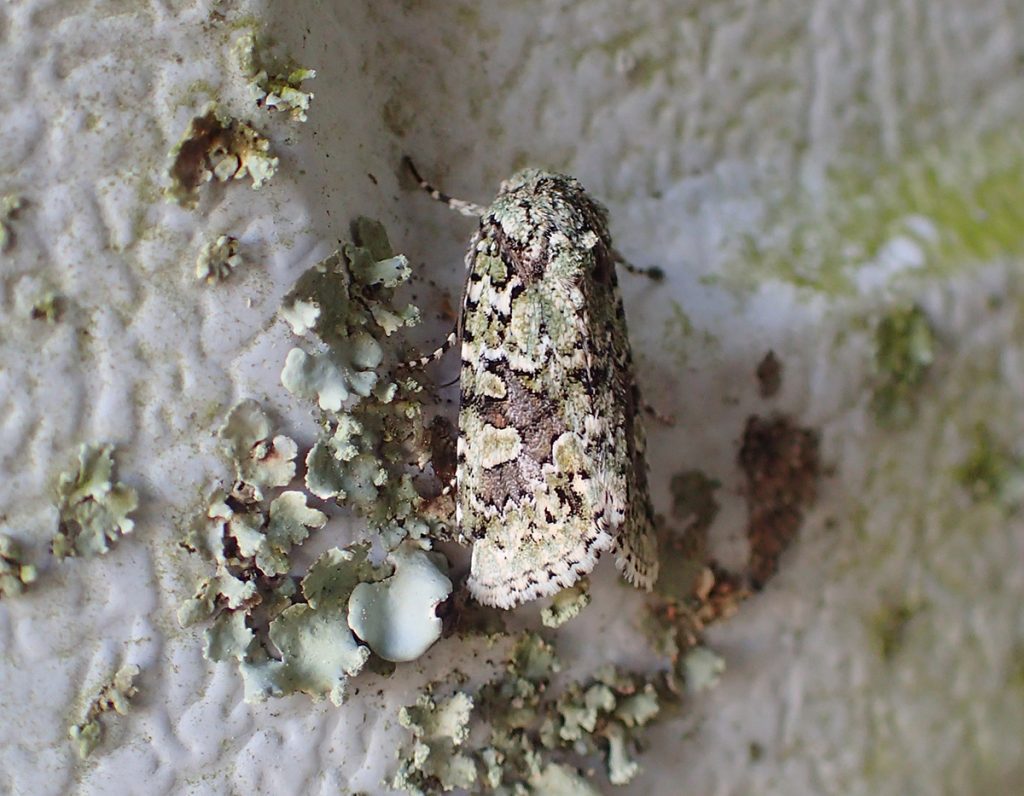
Here’s one I almost didn’t see, except it protruded slightly from the face of the shed. What a cool looking animal I thought. And then this intriguing common name. Reading up on laudable arches, I find that they’re a type of cutworm- a garden pest.
But that’s just how we regard them. Here’s an animal whose caterpillars can survive by eating numerous different hosts- as opposed to moths and butterflies that can only eat a species or genus of plant. And check out the adaptation that allows it to hide in plain sight. It’s a survivor.
April 6, 2021
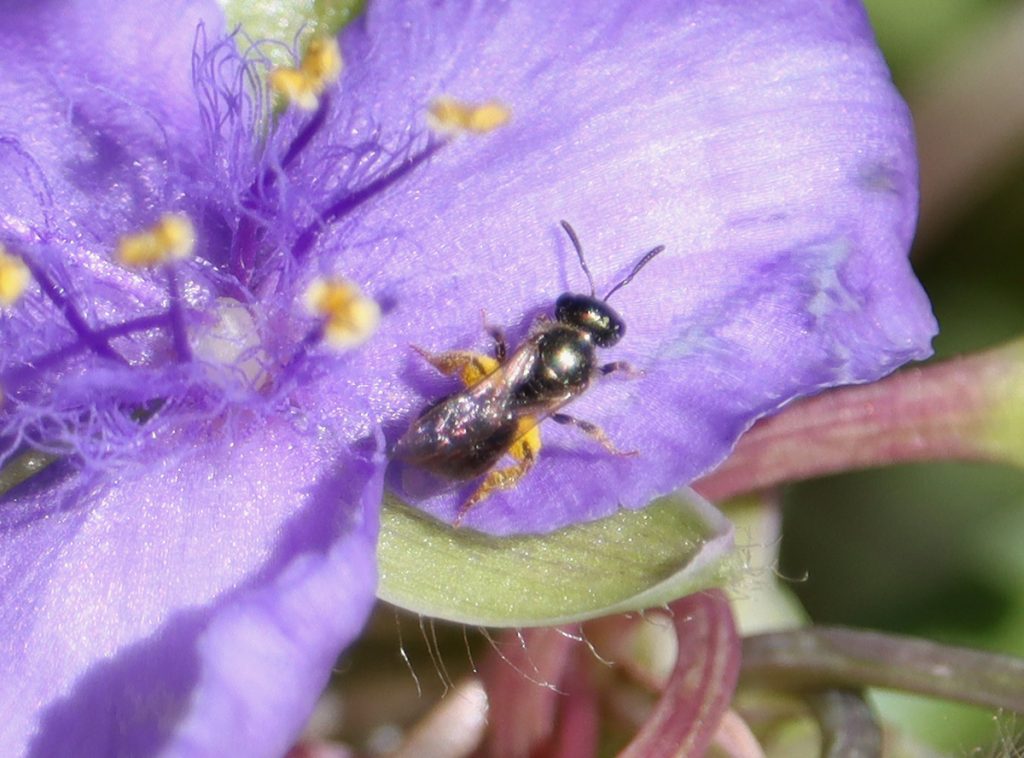
The first bees I see in the yard every year are honeybees, followed by the larger natives- carpenter and bumblebees. Twice over the years, I’ve photographed mining bees earlier in the year, both on cherry laurel blossoms. Here is the first sweat bee of the year. This is one of the tiny fly-sized Dialictus sweat bees. If it hadn’t been for the pollen sacks adding some color to its black frame, I would not have taken a closer look.
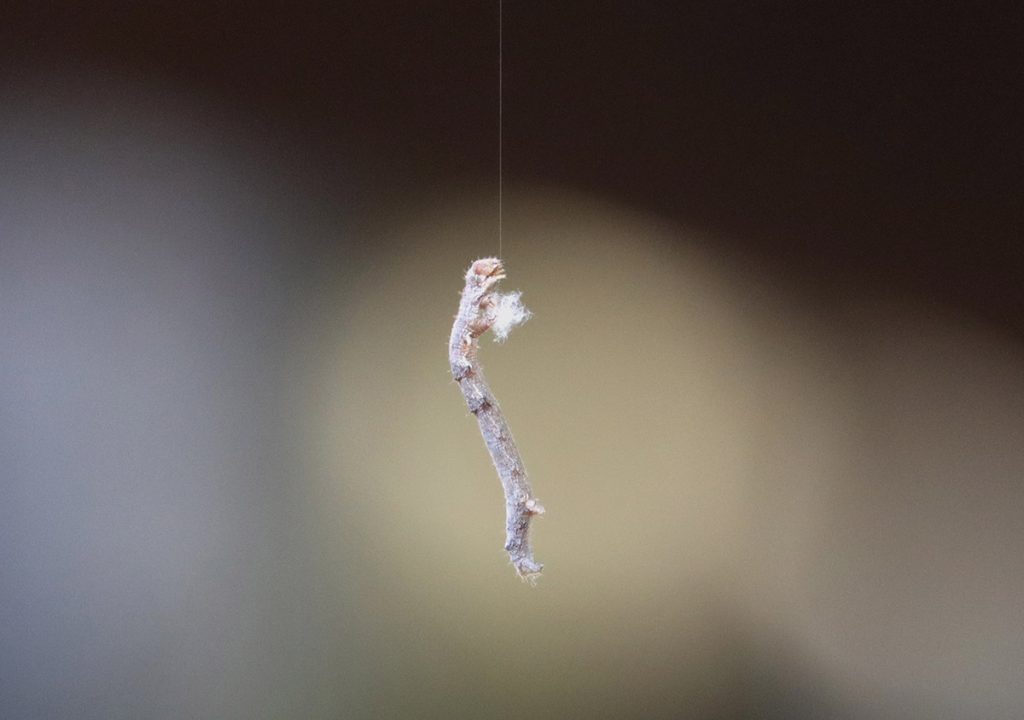
During our outdoor lunch break, this caterpillar floated by the shed. You can see the long silk strand supporting it, and the bunched up silk held in its legs. I’ve seen where a wasp got close to a monarch caterpillar once under a leaf, and the monarch dropped and hung by a short thread. Was this one evading a predator as well?
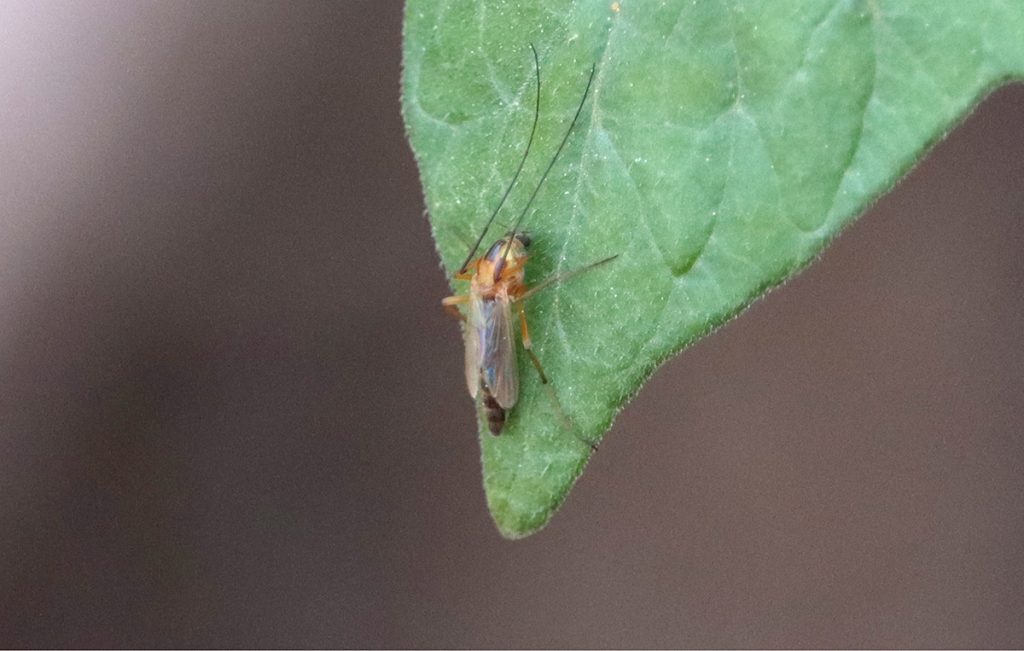
iNaturalist couldn’t help me here. Its top suggestions look nothing like this insect.
April 5, 2021
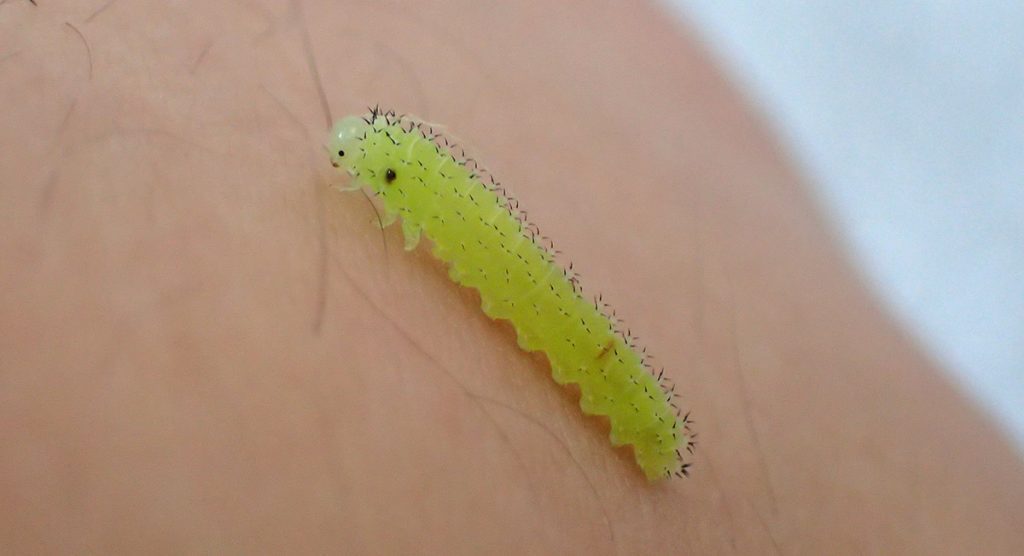
I sat on the hammock to read to my younger son, when I quickly noticed something green on my arm. According to iNaturalist, this is not a caterpillar, but instead, a sawfly larva.
April 4, 2021
Mystery Euodynerous wasp
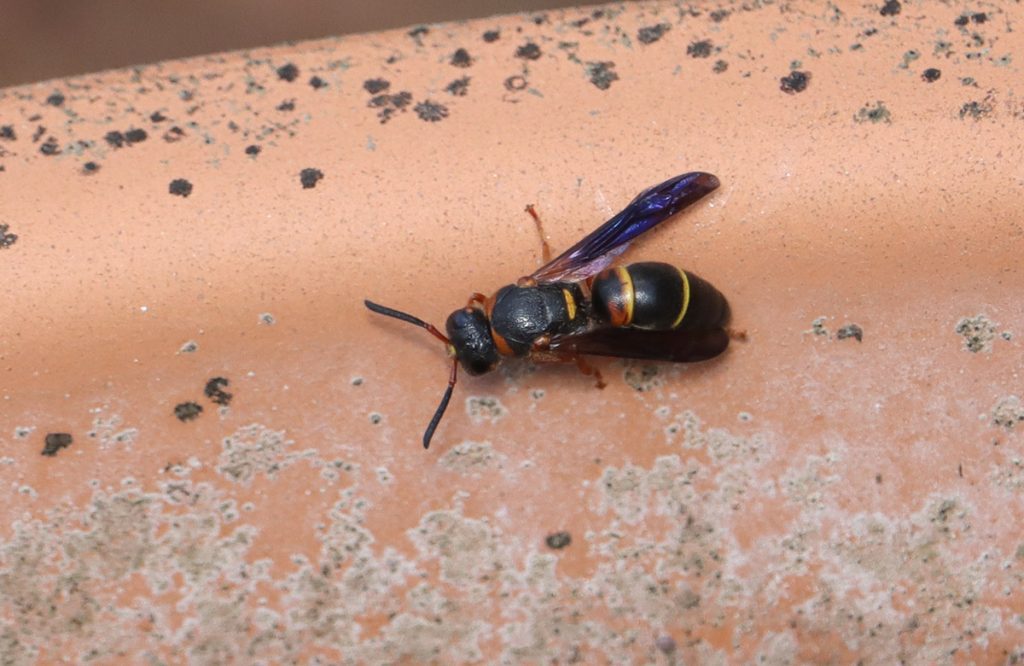
Who exactly are we seeing here? This is one of the mason wasps we first saw swarming a couple of weeks ago. My first stab at an iNaturalist ID was Euodynerous hidalgo. It’s not this. One of iNaturalist’s top wasp curators admitted he was stumped by this wasp, saying looked like another found in peninsular Florida, but not the panhandle.
Interestingly enough, it’s not the first time he was unsure about a Euodynerous wasp found in our yard. That time, in March of 2020, he placed the wasp in the Euodynerus foraminatus-complex. Again, he commented that it looked a little bit like similar wasps from other regions, or that it might be an undescribed species.
I asked him about the previous identification, and he thought that it was likely the same species, even though the previous wasp lacked the red spots on the upper abdomen. He said, “that could well be individual variation.” So we have species of wasp that doesn’t look exactly like anything nearby (there are five other Euodynerous wasp species with research grade observations in Leon County), and that might have a varied enough look to confuse things.
This is the real power of iNaturalist, along with the information it makes widely available to non-scientists. All the photos we take can help researchers more precisely figure out the ranges of plants and animals, track the spread of invasive species, or even notice new species or subspecies.
I’ll keep taking photos of these wasps, from as many angles as possible. Somewhere in that visual information lies an answer to this mystery.
Less mysterious residents of our yard
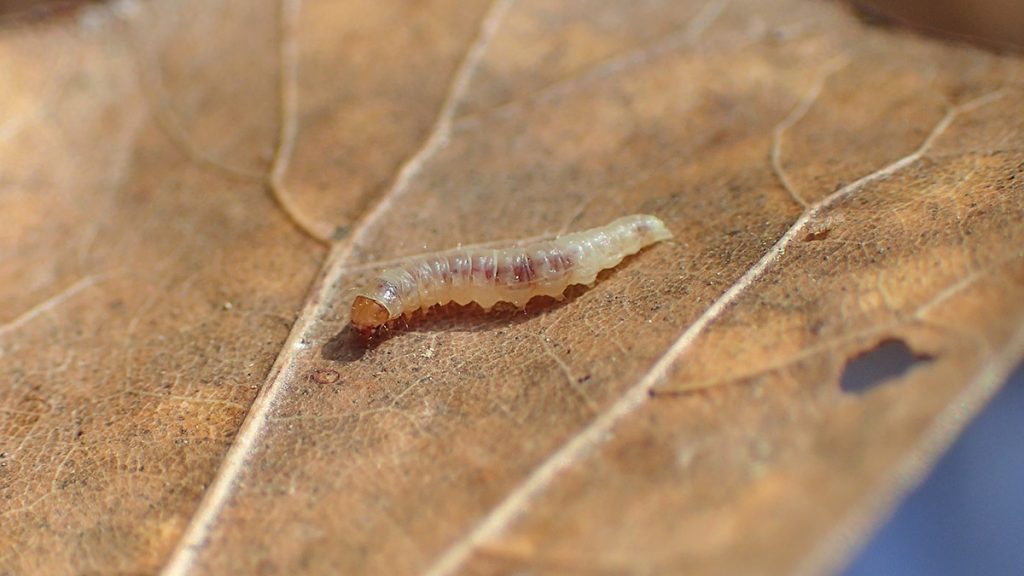
Eating an Easter afternoon snack outside, I found this caterpillar on my leg. I got it to crawl onto a leaf to photograph it.
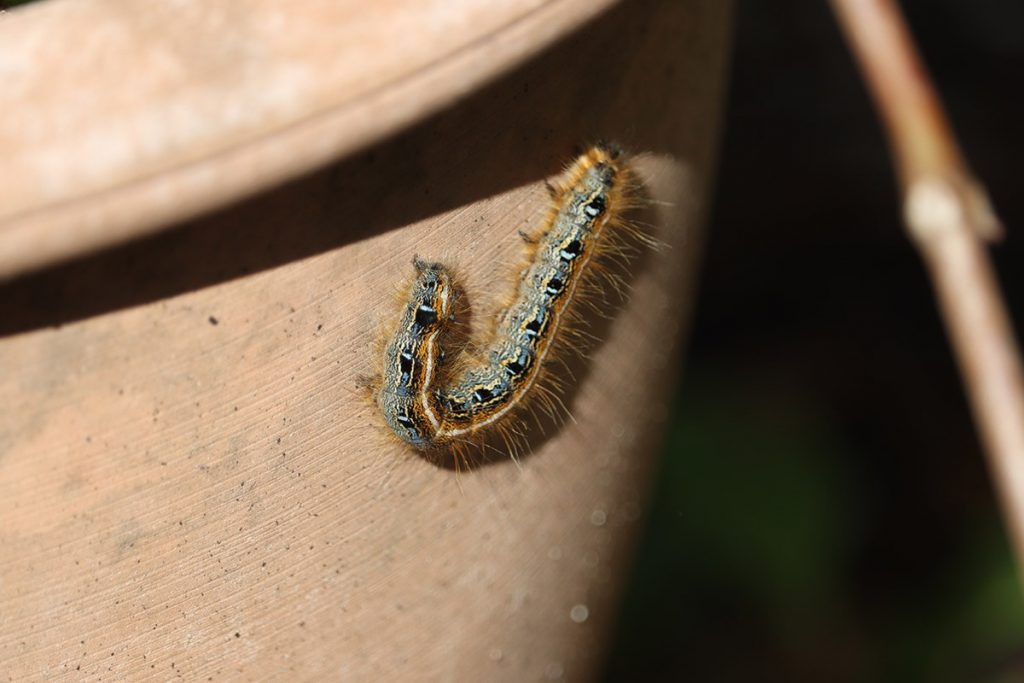
I’ve been seeing on Facebook that we’re in the middle of a tent caterpillar explosion in Tallahassee. And now here’s one in our yard.
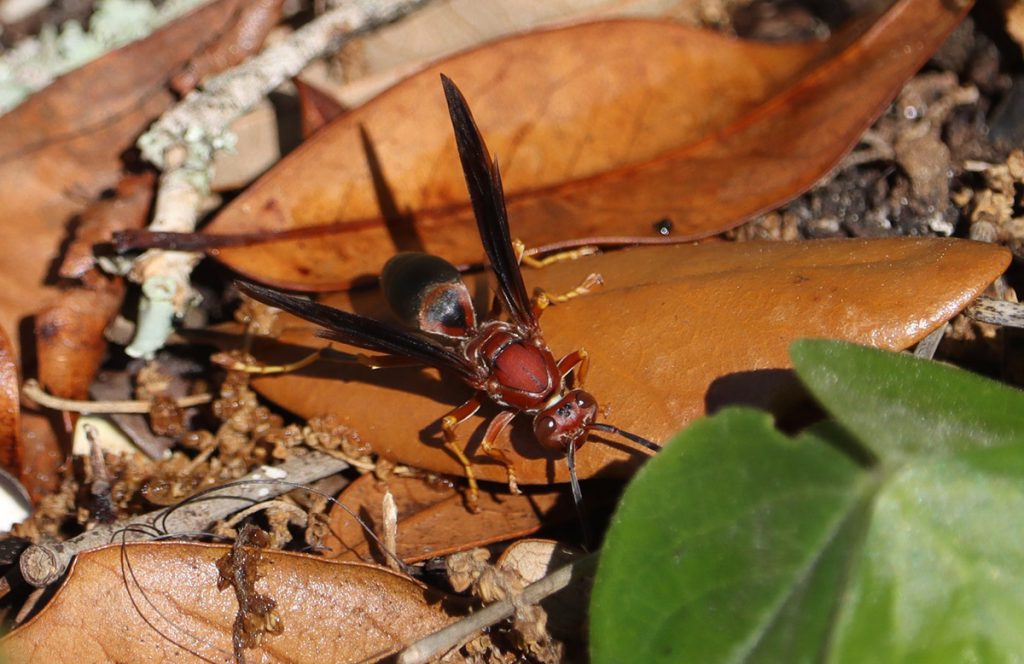
I’ve seen a metric paper wasp skin a black swallowtail caterpillar (you can see it in the video on the linked page). They’re hunters. This one touched down near the tent caterpillar, and two of the mason wasps were buzzing nearby on the same raised bed. The tent caterpillar never seemed in direct danger, but perhaps sensing these potential predators nearby, it made a quick (for a caterpillar) getaway.
Our food web is taking shape for the year.
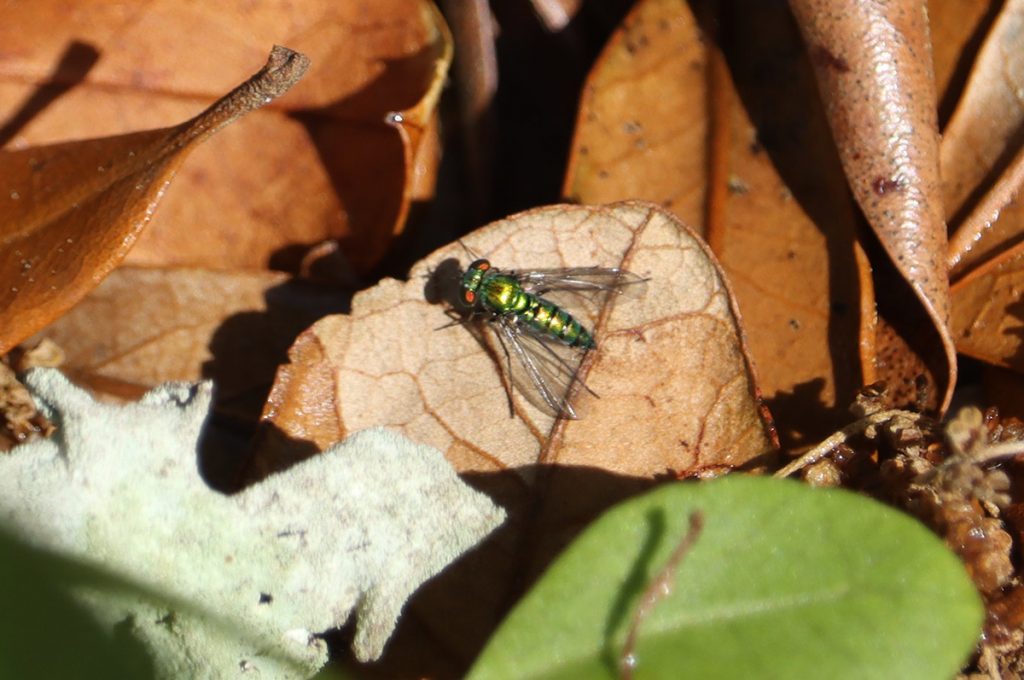
And speaking of predators, I’m starting to see long-legged flies in the yard. These eat aphids and other small invertebrates.
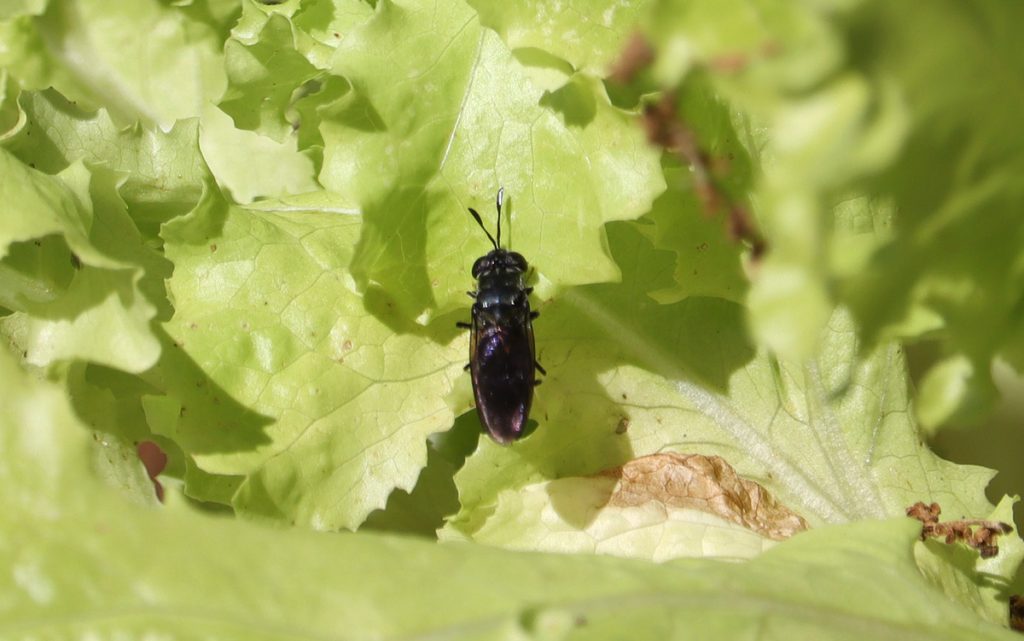
Here’s another helpful fly. It flew off before I could get closer, but this looks a lot like a black soldier fly. Their larvae are valuable in compost piles, breaking down organic material. We had them last year, and I recently saw one next to the compost bin. I’m happy to see this and all of the other helpful insects returning to the yard.
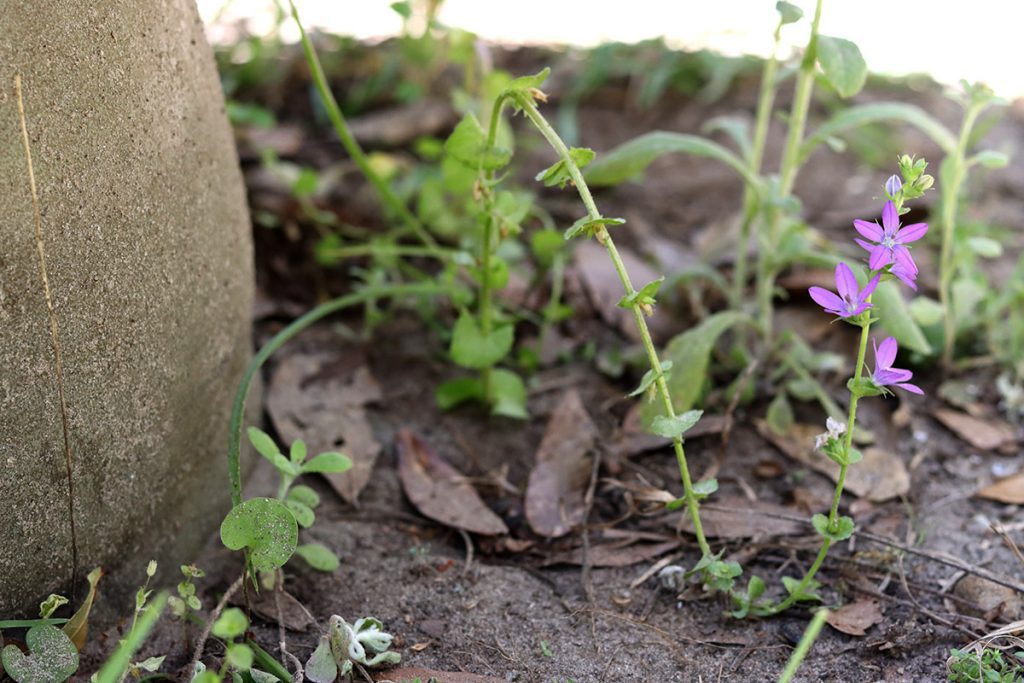
Lastly, here’s one of my favorite early spring “weeds.” This is the only one I saw in the yard this year, growing in the shadow of the bird bath. I think it got a little viney looking for the sun.
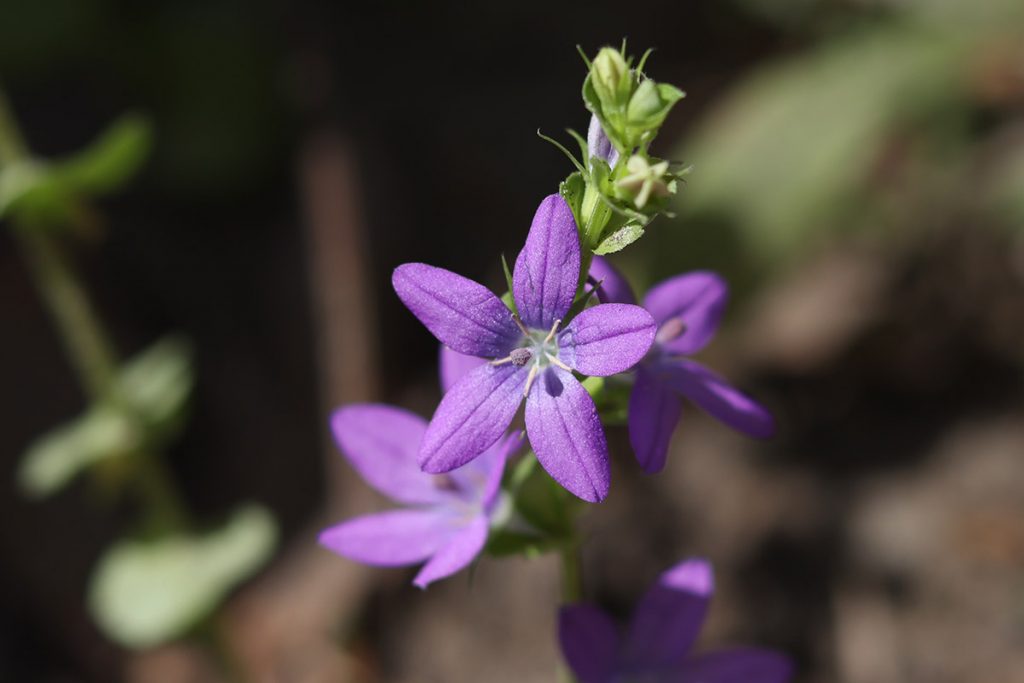
I took the top off the bird bath to get some sun on it for a photo. Another beautiful, tiny native wildflower that grows in our yards for free.
April 3, 2021
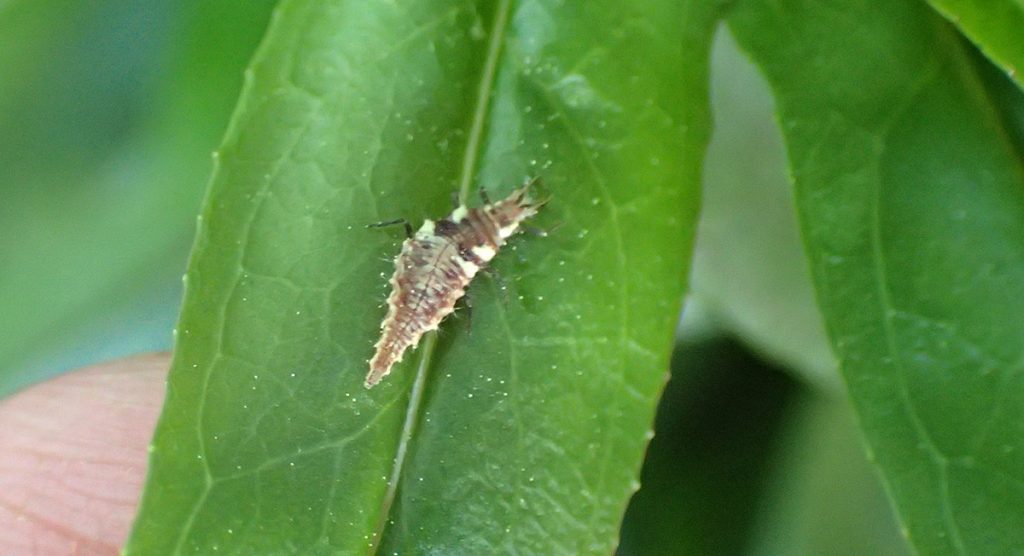
I saw another lacewing larva earlier in March. These are important predators, and their transparent wings make them a cool looking backyard insect. After having seen one in a friend’s yard, I’m looking forward to seeing this turn into an adult in ours.
April 1, 2021
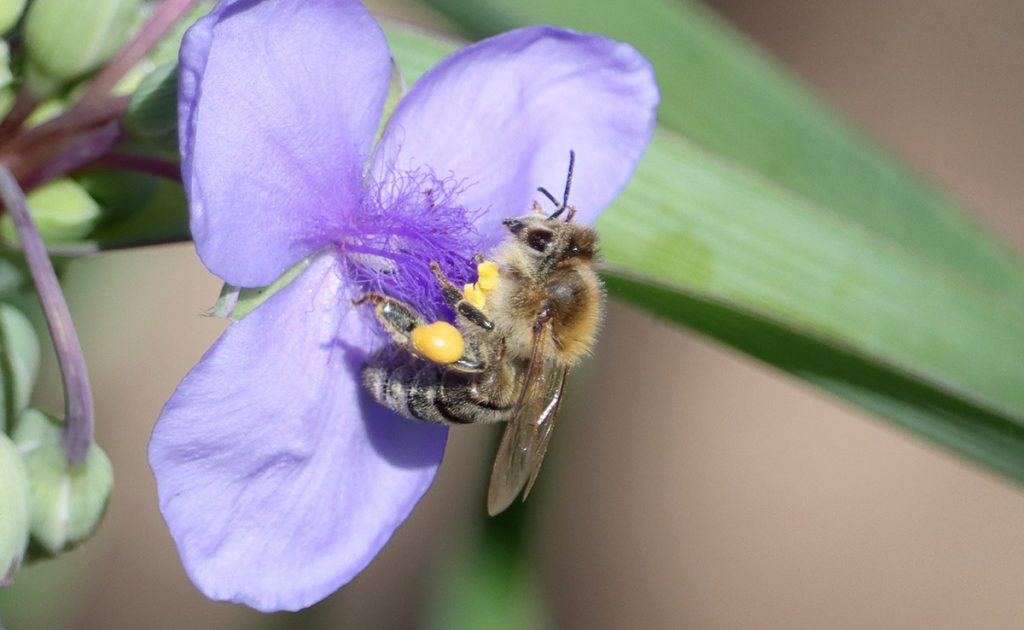
After a few warm days, rains brought a small cold snap. It reached the 60s in the afternoon, which was warm enough for this honeybee. Honeybees are not native to the US, and are a little more cold tolerant than our native bees. That’s why flowers that bloom in the late winter and early spring are a help to this important agricultural species.
March 31, 2001
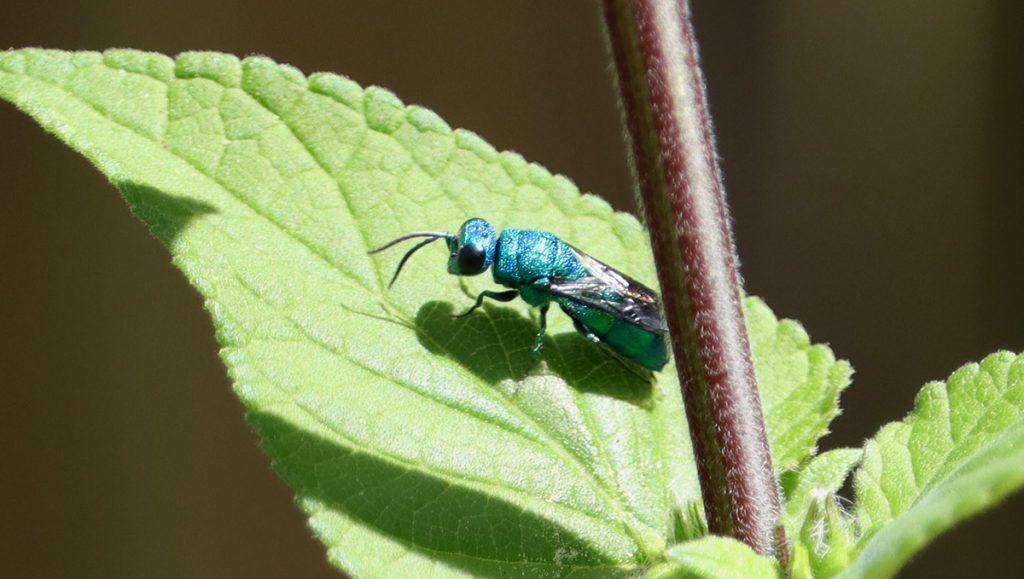
A couple of days ago, I mentioned seeing this without a camera in my hand,. Now, a few days later- a photo. It’s no surprise to see this active at the same time I start to see four-toothed mason wasps in the yard; cuckoo wasps are always crawling out of their nests, mingling their eggs with those of the mason wasp’s.
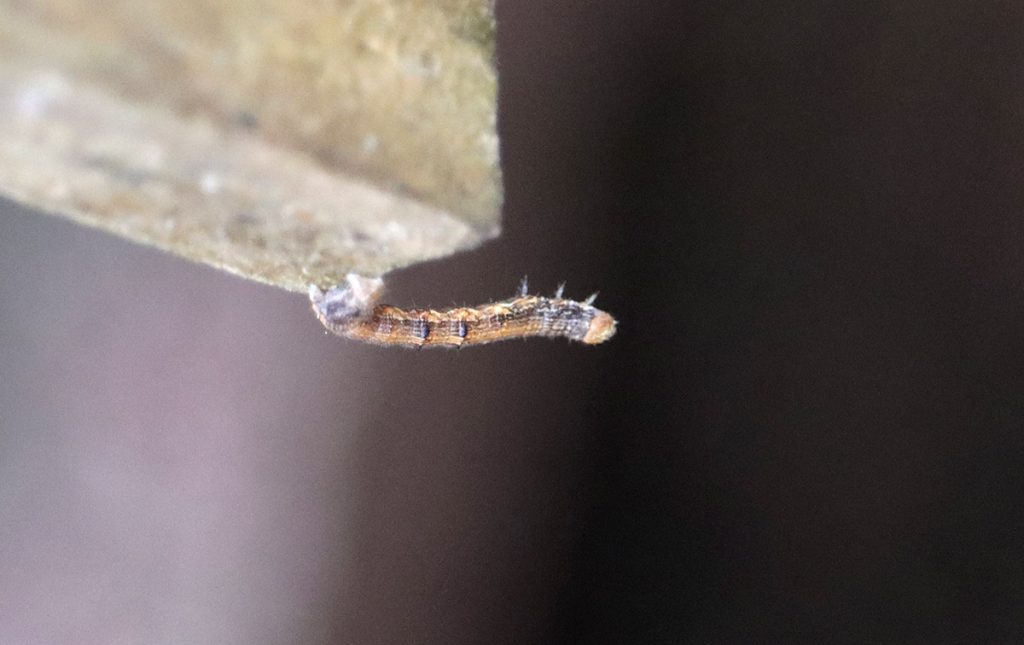
Again while eating lunch outside, we see insect life in action. This small inchworm was inching itself along the edge of our bee nesting box, and then it fell off!
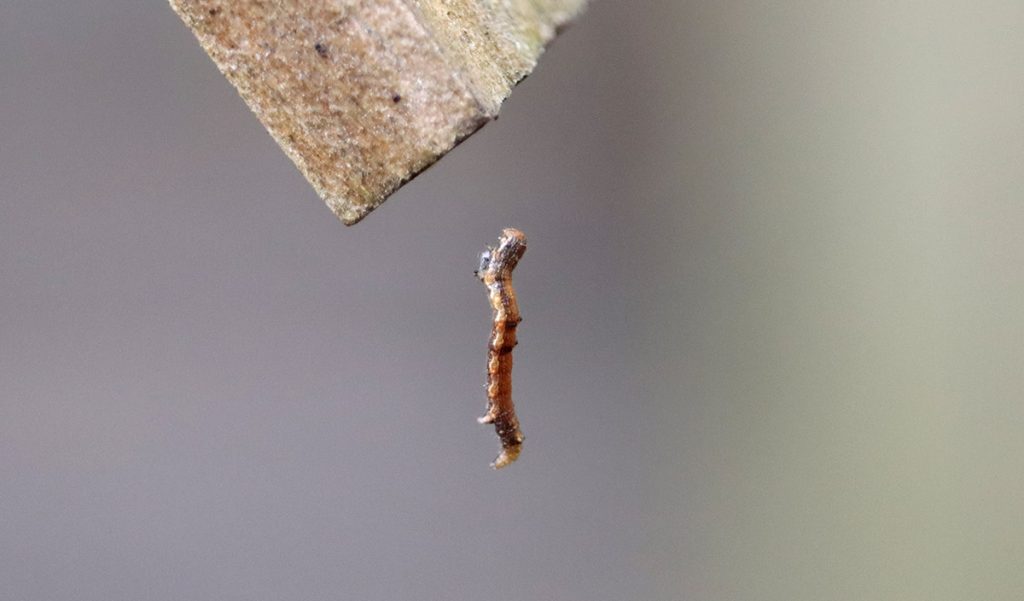
It dangled for a little while on its silky thread before reeling itself back up to the box.
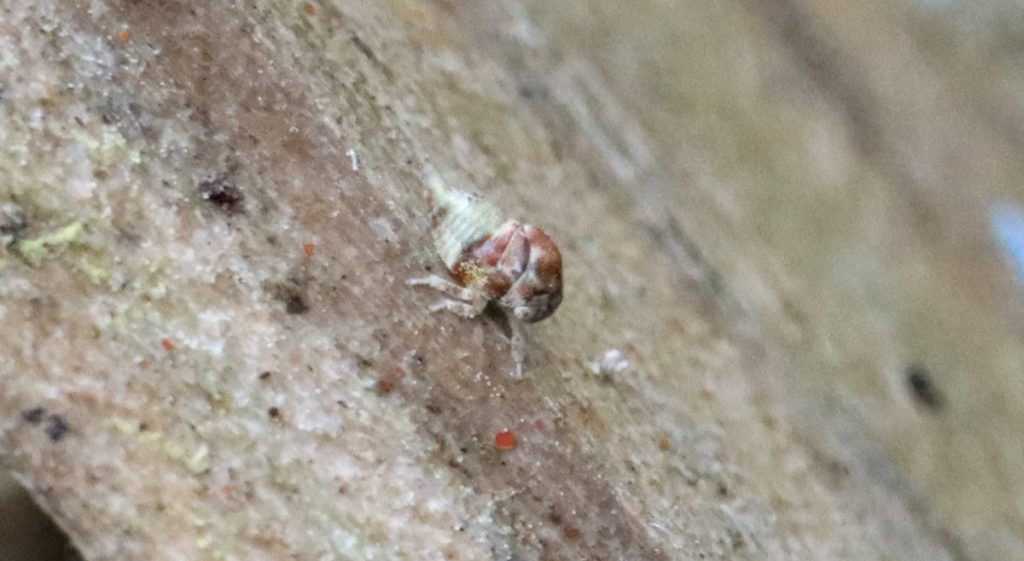
While watching the inchworm, Amy notices another leafhopper nymph. That’s two in two days.
March 30, 2021
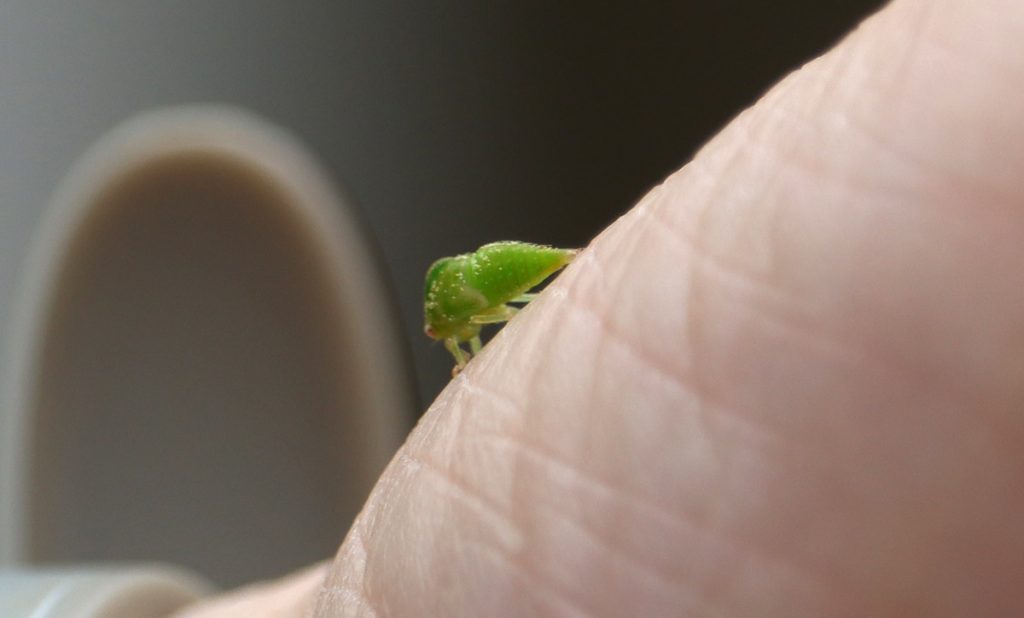
We were eating an outdoor lunch when Amy picked up a hitchhiker. Over the next week we start to see more larval insects, and more predatory insects. So much attention gets paid to pollinators, and rightly so. But I get excited about these other insects as well. Little guys like the one in the photo above, they’re the foundation of the food web. The eat plants, and insects, birds, reptiles, and amphibians eat them.
This little guy by itself isn’t what excites me; rather, it’s the variety of different insects.
March 28, 2021
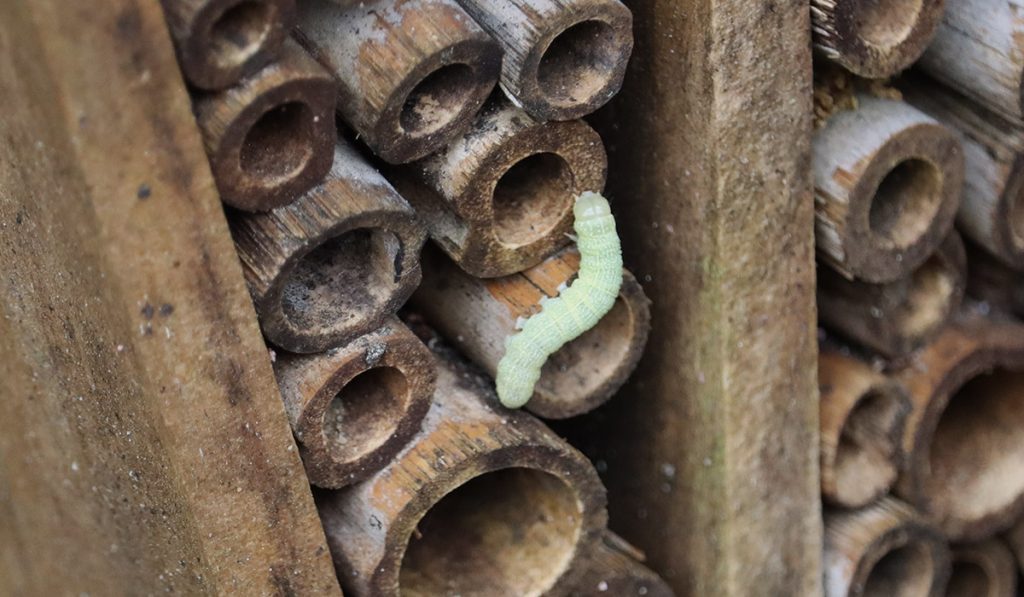
Max had a friend over for a socially distanced playdate, and she noticed this caterpillar. I mentioned that the mason wasps that nest in those tubes might snag it for their larvae, and she relocated it away from the box.
There are so many moth species with small green caterpillars, but I decided to try and ID this one in iNaturalist. For now, I think this is a white-dotted prominent (Nadata gibbosa). It hosts on oaks and cherry trees, both of which overhang this section of the yard, and both of which have recently shed a lot of leaves. I imagine it took a trip down on one of those leaves.
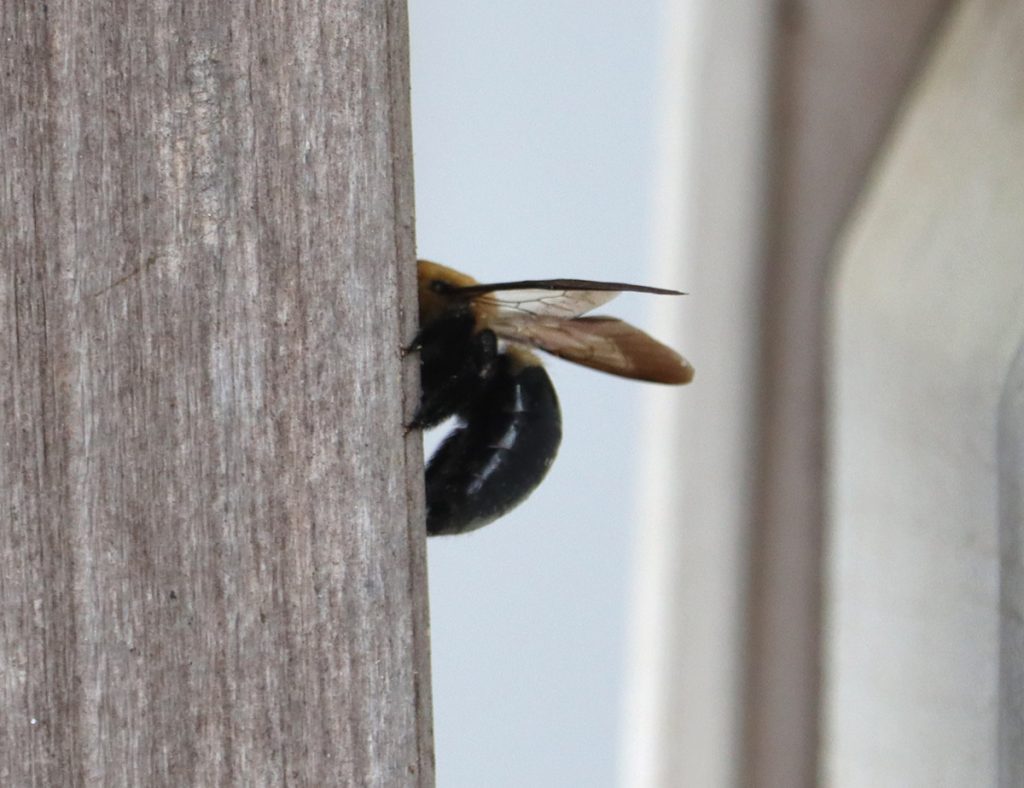
From what I can tell, we may have three or four carpenter bee nests in different spots around the house. I spotted one on one of Max’s sticks, which we have arranged in a display on the porch. I often see carpenter bees buzzing by our side porch, and now I see this one by the back door.
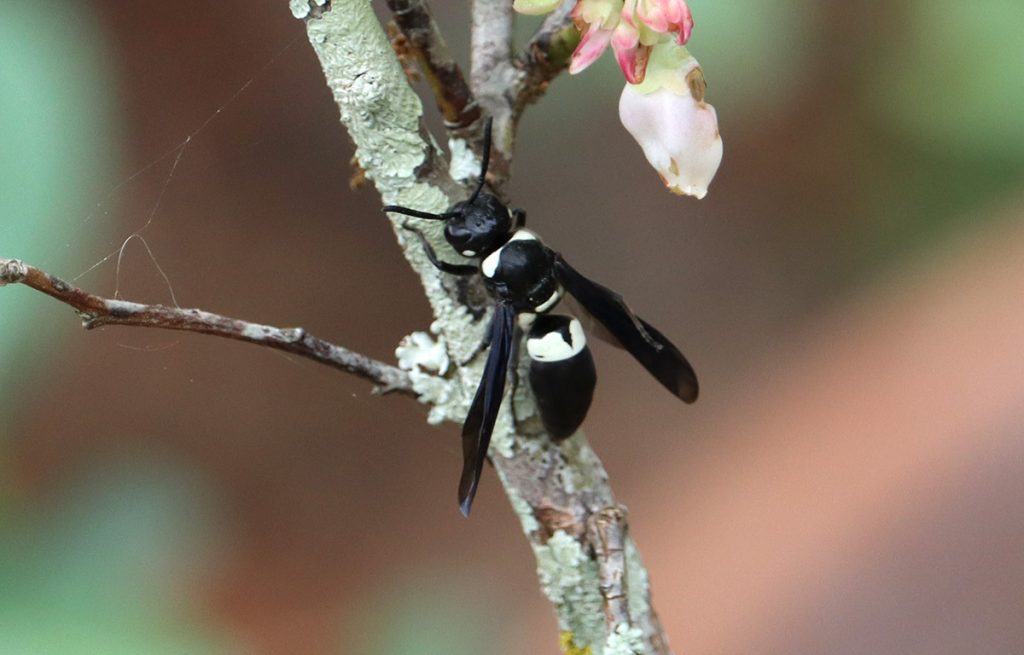
And here’s an insect I see making use of abandoned carpenter bee nests, the four-toothed mason wasp. I spotted it walking its way up a blueberry bush, and visiting flowers.
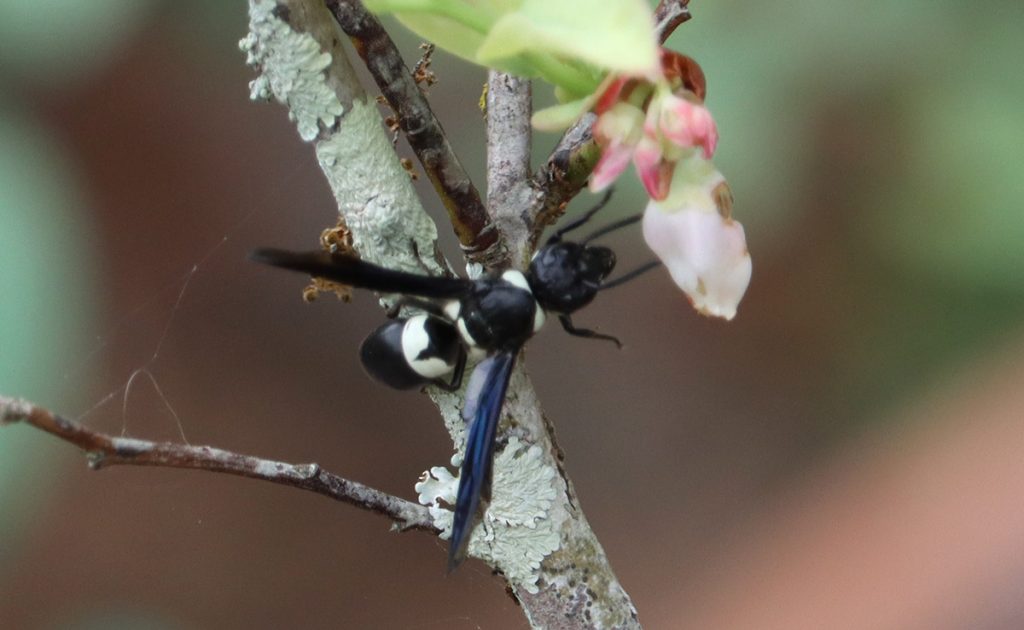
It looked like it was nibbling the side of the flowers, which some wasps do.
While our guest was leaving, I spotted a cuckoo wasp on the back rail. This metallic blue insect has a relationship with the previous two based on their nesting habits. Carpenter bees create cavities, and four-toothed mason wasps make use of them afterwards. Cuckoo wasps lay their eggs with those of the four-toothed mason wasps.
I saw a few butterflies in the yard today, though they were mostly passing through. But it was nice to see a swallowtail flying overhead, or a skipper skipping through the grass. I also noticed a cloudless sulphur nectaring on scarlet sage, and I’m seeing more and more of those these days.
More butterflies means we’ll start seeing caterpillars. There’s a lot to pay attention to this time of year.
March 26, 2021
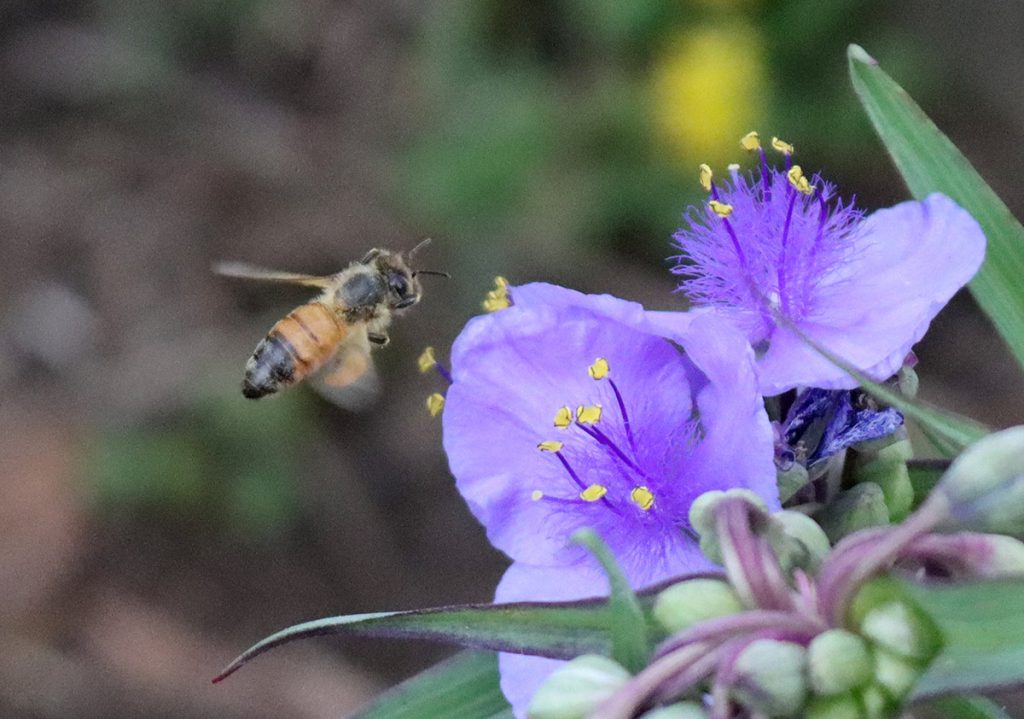
Our flower patch is starting to take on some color as flowers bloom. Scarlet sage is exploding, crowpoison is adding white highlights, wood sorrel adds specks of yellow while the Carolina crane’s-bill’s pale pink flowers are only visible when you’re right on top of them. The brickellia and coneflowers are starting to leaf out, and the newly planted purple-eyed grass (Sisyrinchium) is quickly becoming one of my favorite wildflowers.
Just like last year, the Ohio spiderwort is becoming plentiful, and popular with honeybees.
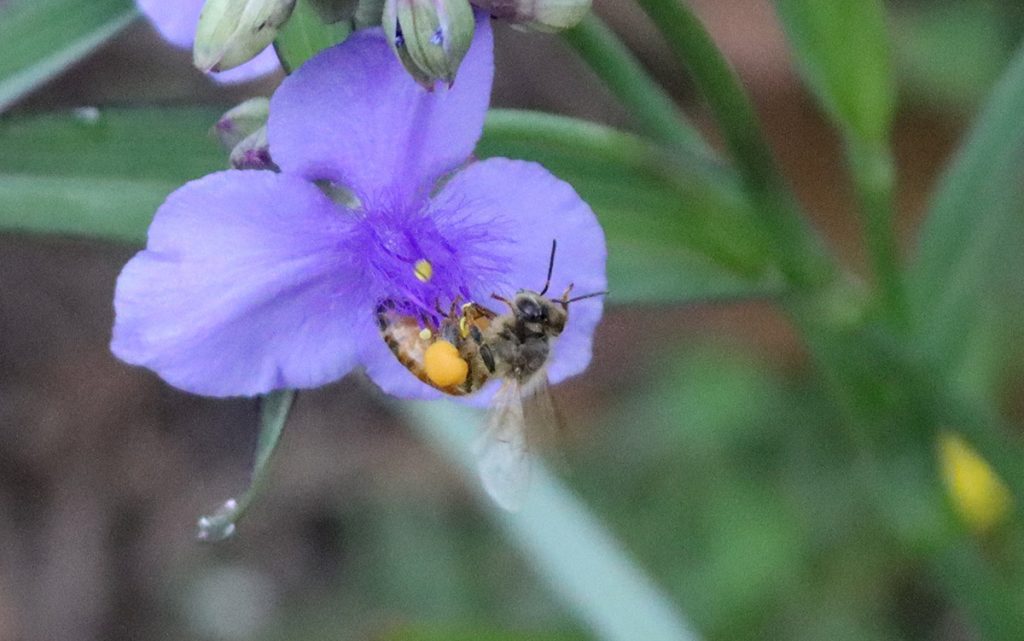
We’re seeing more and more pollinators daily, and more flowers to feed them.
March 25, 2021
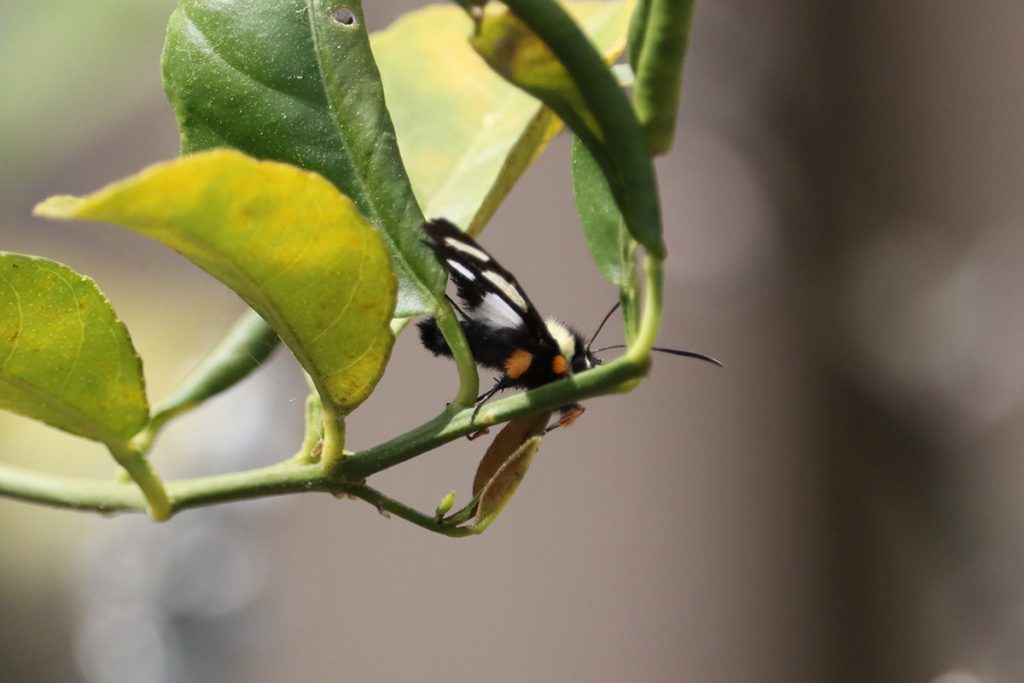
This moth was hiding in the leaves of our Meyer lemon tree. I tried to find a good angle to see more of it, but it was pretty well nestled in those leaves.
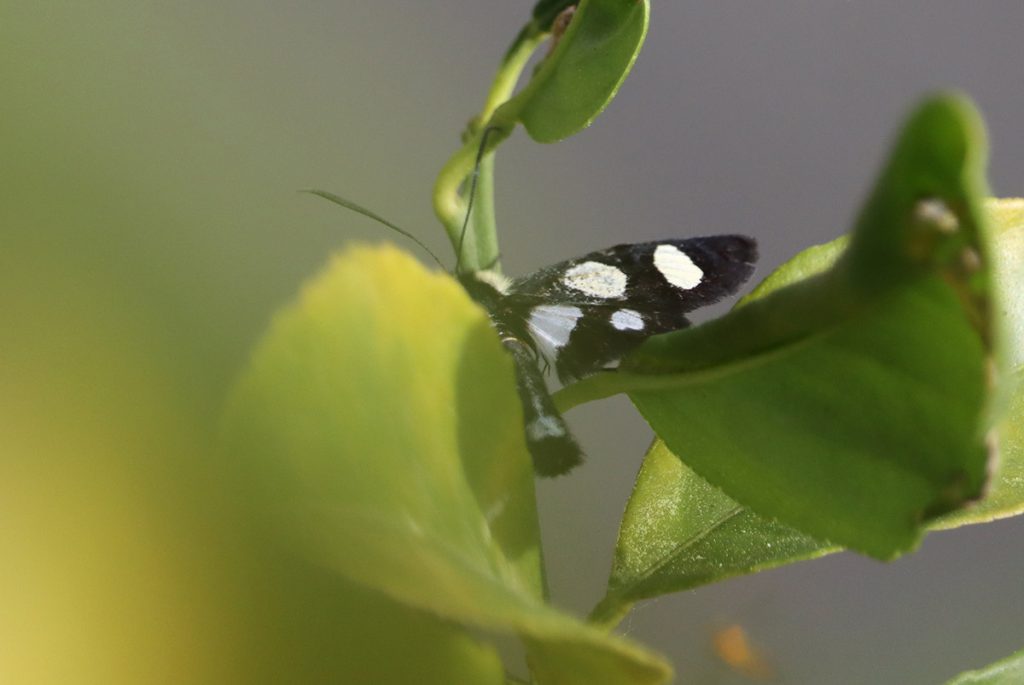
I never got a clear shot before it took off. This is the Eight-spotted forester moth, which hosts on Virginia creeper. Our creeper vines disappeared over the winter, but have been regrowing and spreading. I’m guessing this moth was visiting the new leaf growth to lay eggs.
March 23, 2021
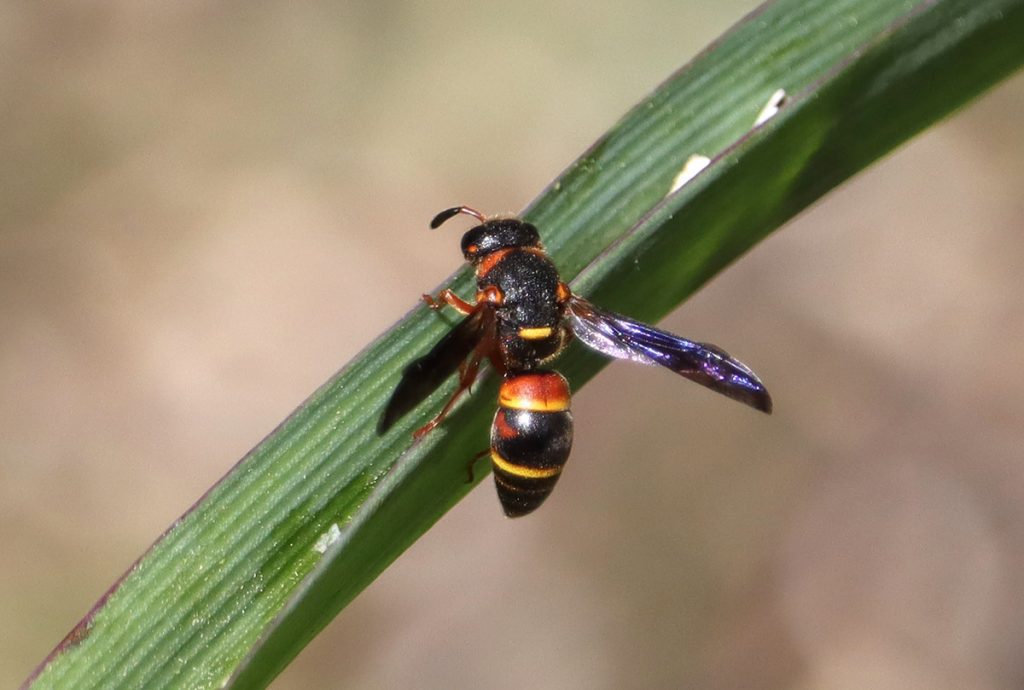
Our combined school/ office lunch hour has been outside the last couple of spring weeks. Today, we saw a swarm over by the fence. Remembering the yellow-jacket queen we saw over the winter, I try to take a closer look. They’re fling fast, but are maybe too dark for yellow-jackets.
One lands on a spiderwort, and I see it’s a mason wasp. We’ve had several species of mason wasp in our yard, not just passing through but nesting. The bare earth in our side yard is a popular spot for them to pick up sediment with which to seal their nests, and I spot one doing so while we eat.
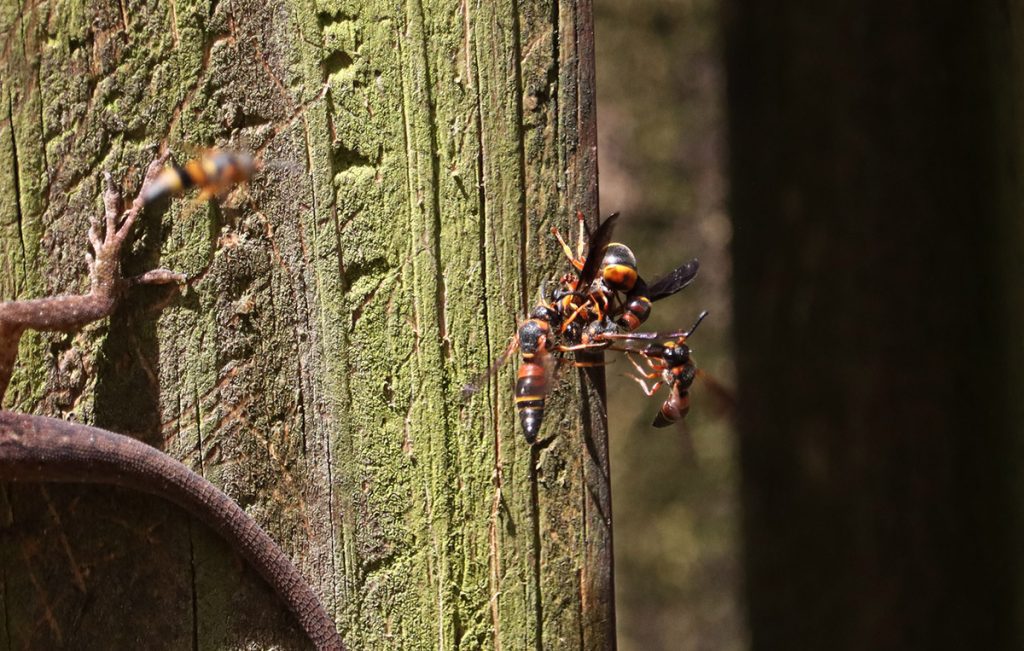
I see one wasp jump on another- are they mating? Soon, more wasps join in and form a ball for a few seconds before breaking apart. The anole in the photo had been hanging out at this spot; I notice them do that on flowers pollinated by bees as well. I always watch these instances with interest. Will the lizard try to grab a bee or wasp? Will the bee or wasp put up a fight?
Mason wasps often make use of existing cavities (like carpenter bee nests) to make their own nests. I wonder if such a cavity exists behind this fence post, where we see the wasps swarm daily.
March 22, 2021
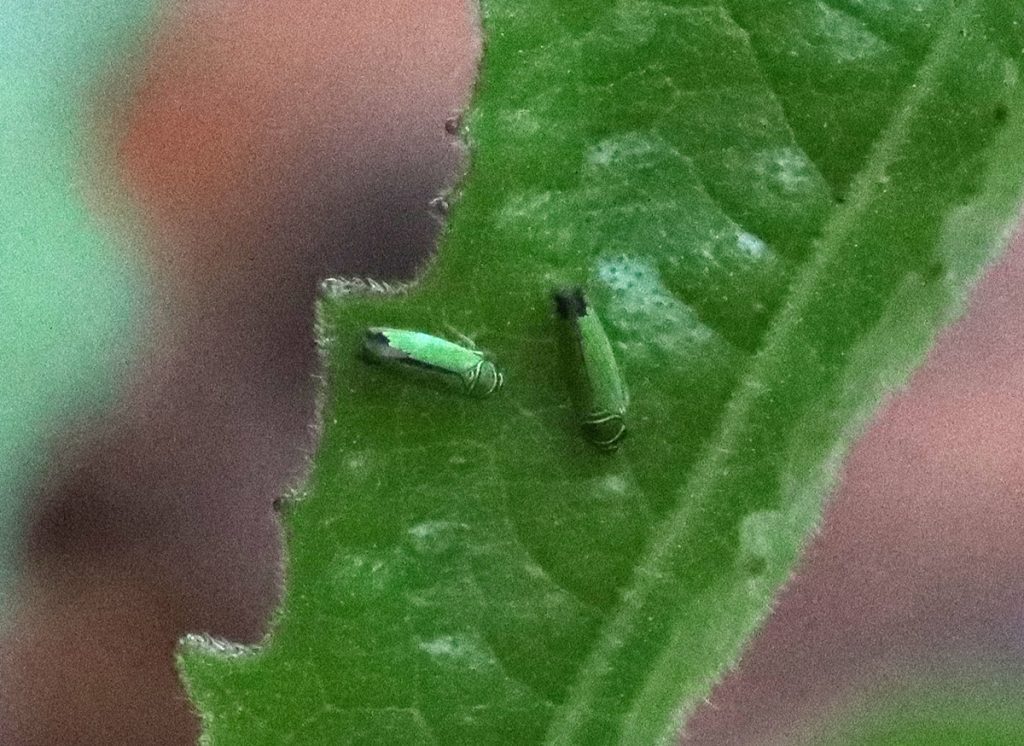
Spending some family time in the yard as the sun set, I noticed these tiny things on a silphium that started resprouting a few weeks ago. One of our diverse assortment of planthoppers, sap sucking insects.
March 19, 2021
Here’s a scene I spotted through a window. I wish I could tell what that Carolina wren is thrashing, but I knew if went outside for a closer look I’d scare it off. Carolina wrens have been active in the yard lately, gathering food and other materials, sometimes in pairs. There’s got to be a nest nearby. At this time last year, we had chicks in a hanging pot.
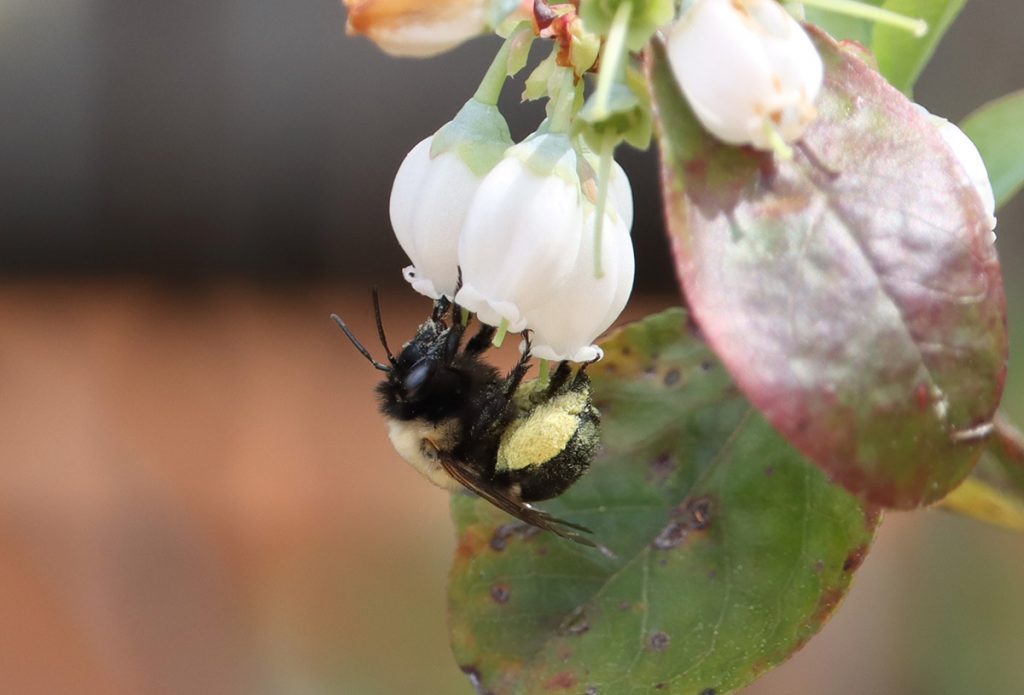
Meanwhile, I’m seeing bees visiting blueberry bushes. Carpenter bees spook easily when I approach with a camera, even though I stay back a few feet. This bumblebee was a little more cooperative.
March 16, 2021
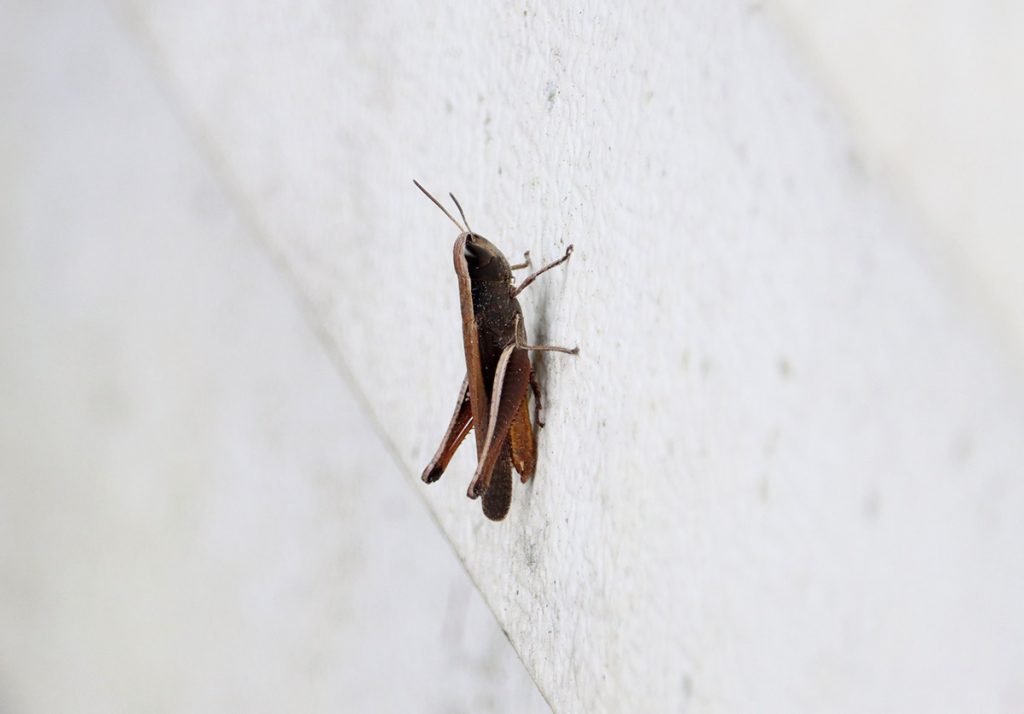
I found this grasshopper on our shed. First iNaturalist guess is (Amblytropidia mysteca). The name is right for the season, though it hasn’t been feeling like winter this past week.
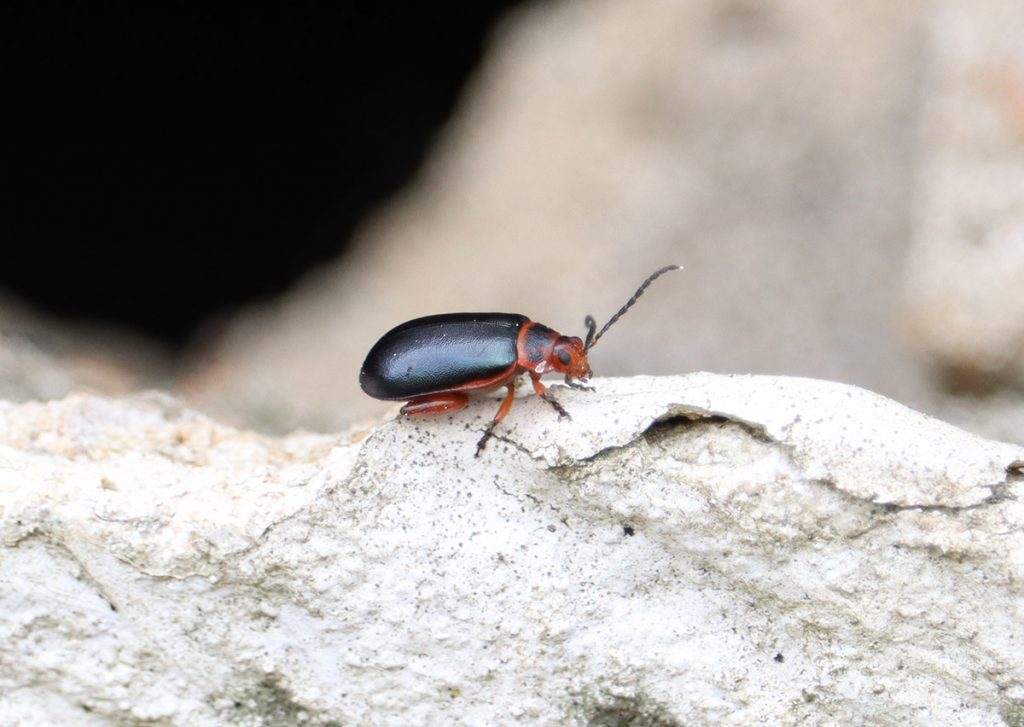
I’m not sure what kind of beetle I’m seeing here. iNaturalist suggested skeletonizing leaf and flea beetles. I clicked compare, though, and none of the species found in Florida looked quite like this one. There’s such a diversity of insects in Florida, and some insects can vary in appearance, or radically change appearance throughout their life cycle.
That’s the fun of it to me- I’ll never run out of things to learn, either about my backyard bugs, or about plants and animals in our forests and waterways. And then some of these observations end up being species that are still being sorted out.
March 14, 2021
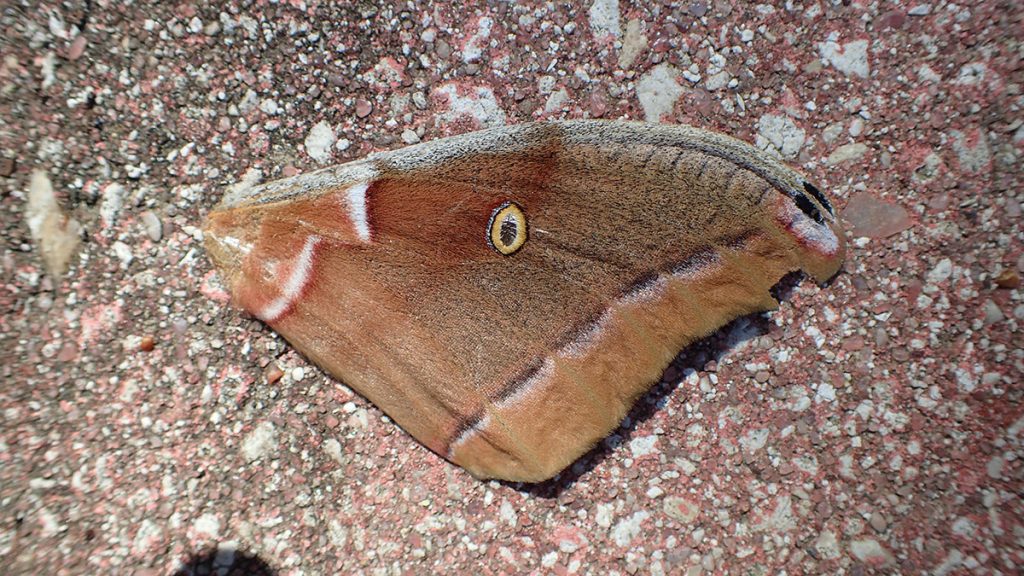
I found this wing in the leaf litter under our oak tree. I’d much rather have found the living moth, which is a large, ornate insect. The fact that I found this one means there may be others about, right? Polyphemus moth caterpillars host on a variety of trees, such as oaks, and cherry trees like those around the house.
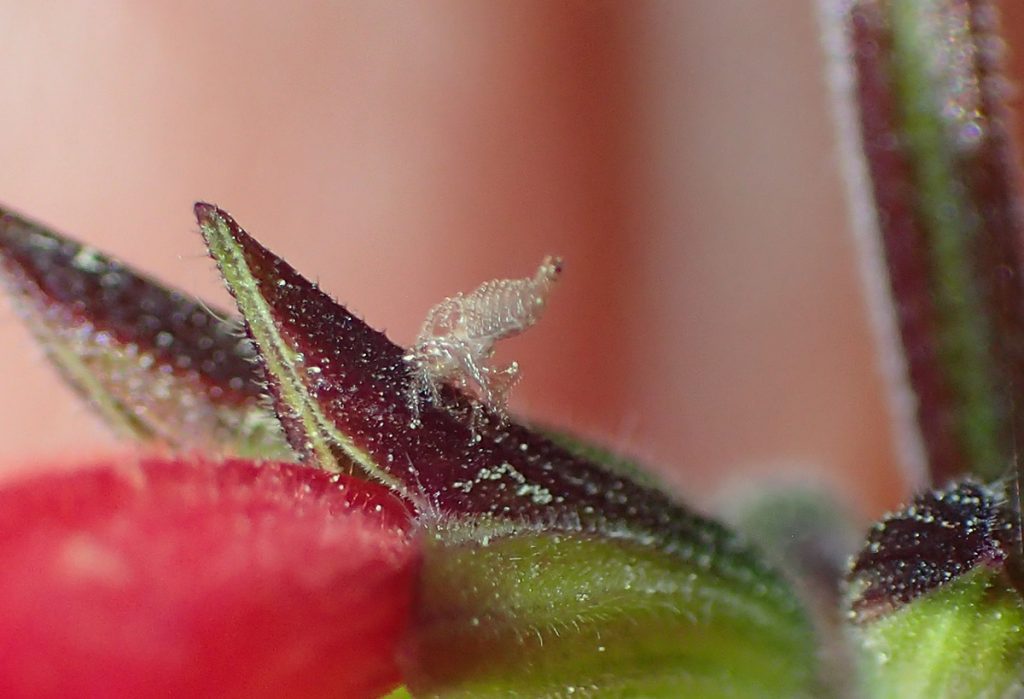
This looks like the husk of a very small insect on our scarlet sage. Was it killed, or does it leave its exoskeleton like a cicada?
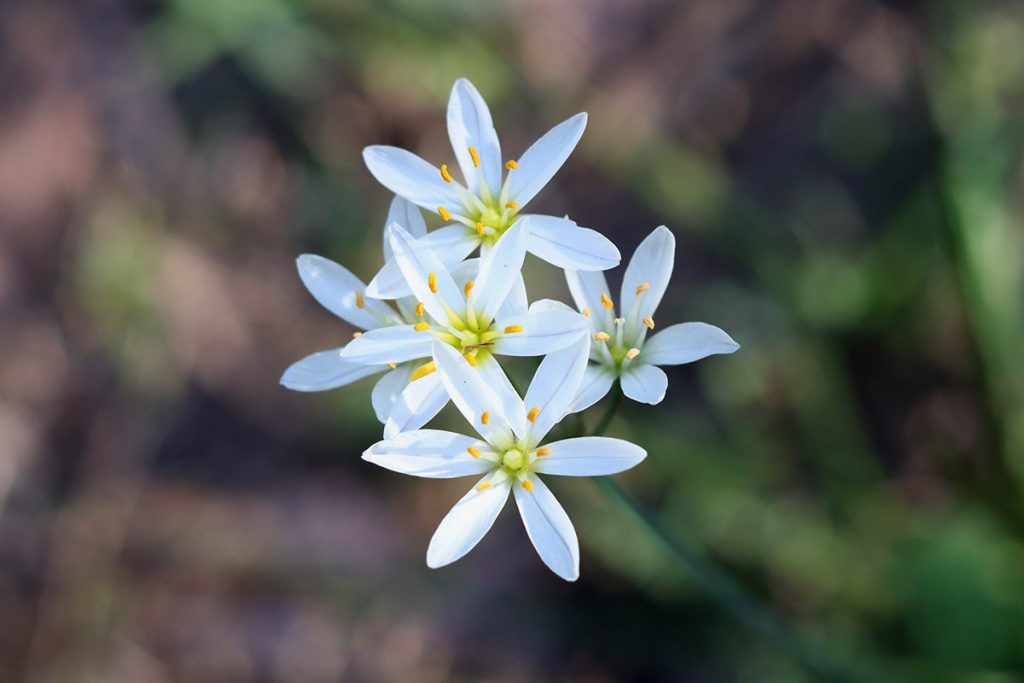
A lot of the earlier blooming weedy flowers in the yard have small flowers. These Nothoscordum flowers are popping up around the yard after a hiatus of a few months. I saw them briefly in November, but this is their best time.
Before a lot of the flowers I buy and plant start to bloom, these late winter bloomers give our yard some color, and offer nectar to pollinators as they slowly return to the yard.
March 13, 2021
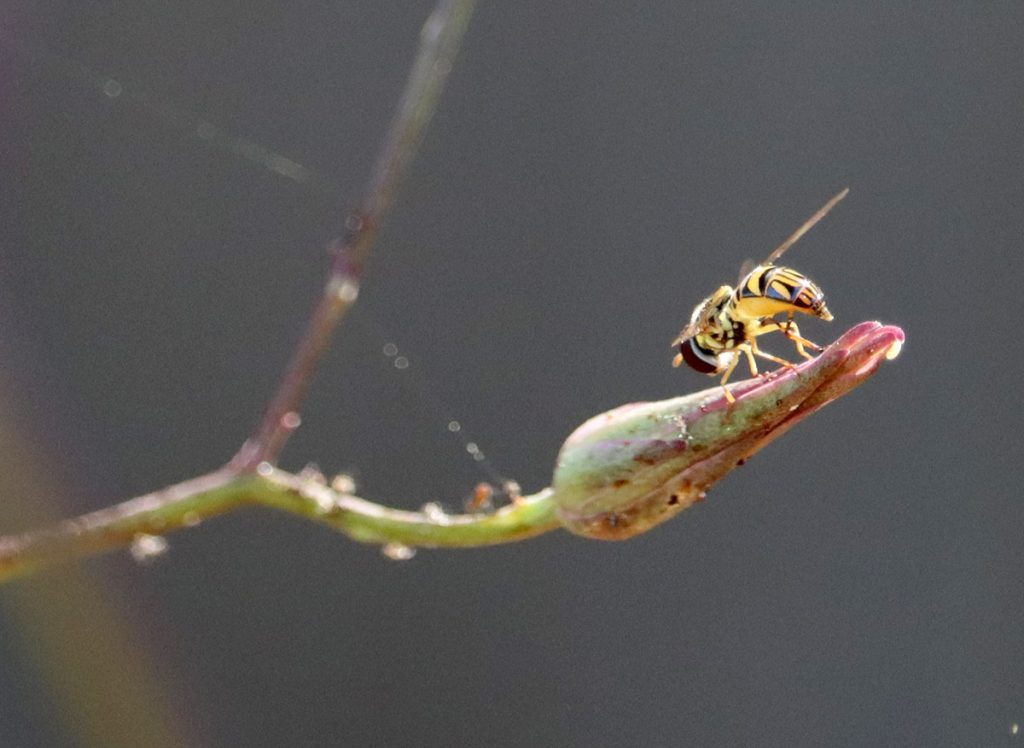
I spent a little time this morning following a hoverfly as it repeatedly curled its abdomen on dandelion flowers and leaves. You can see aphids on the stem of the flower above; hoverfly larvae feed on aphids.
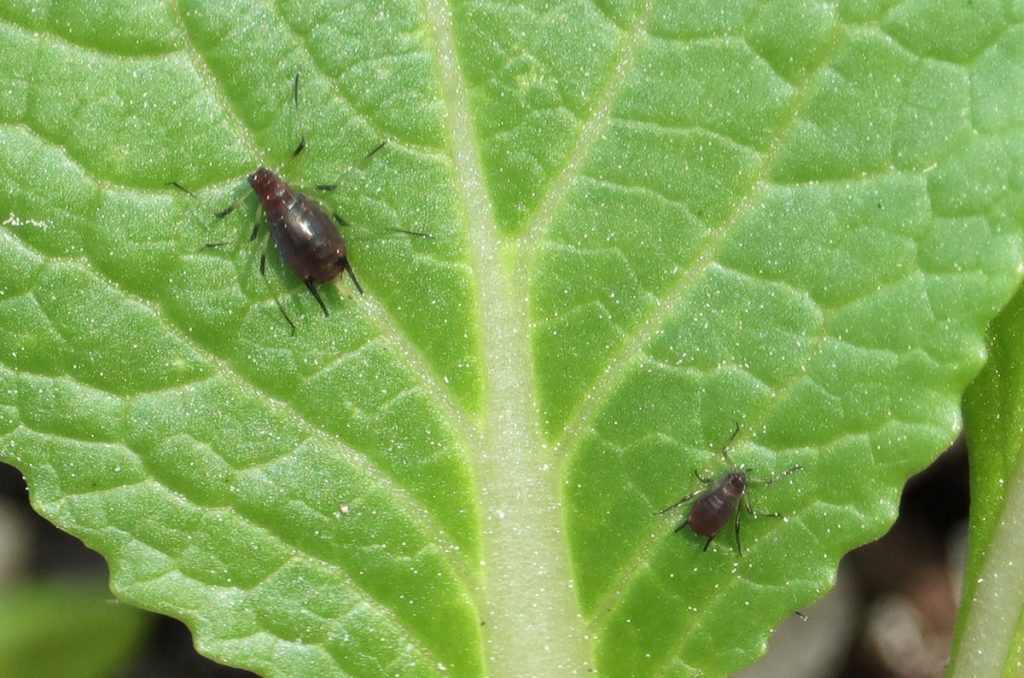
Here are more aphids on a neighboring lettuce plant. My first iNaturalist guess puts these in the Uroleucon genus.
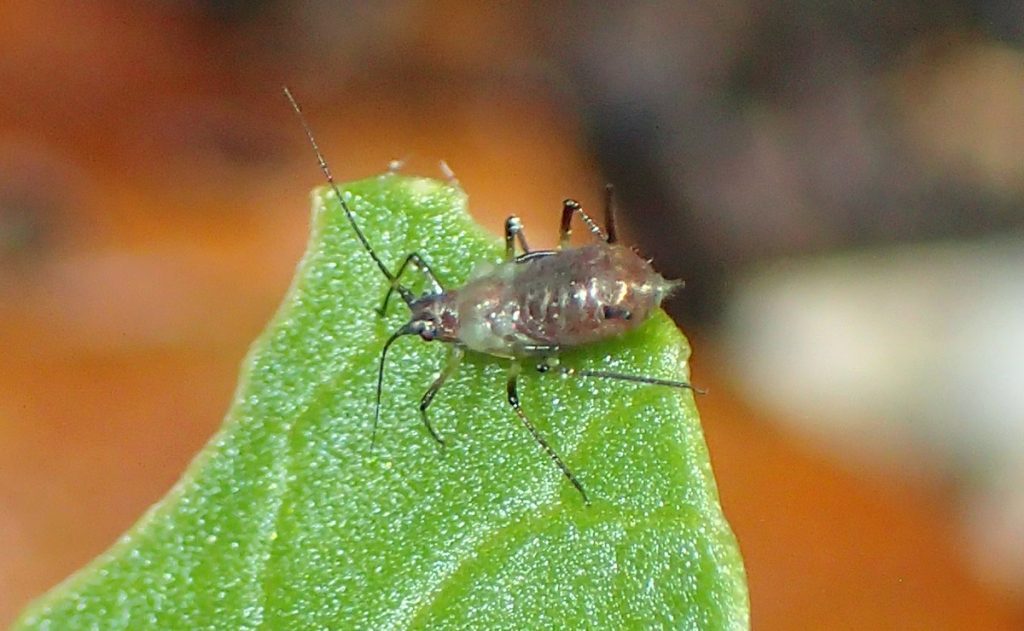
This may be the same species, or one related to it. iNaturalist suggested two different IDs, but the Uroleucon genus is in tribe Macrosiphini.
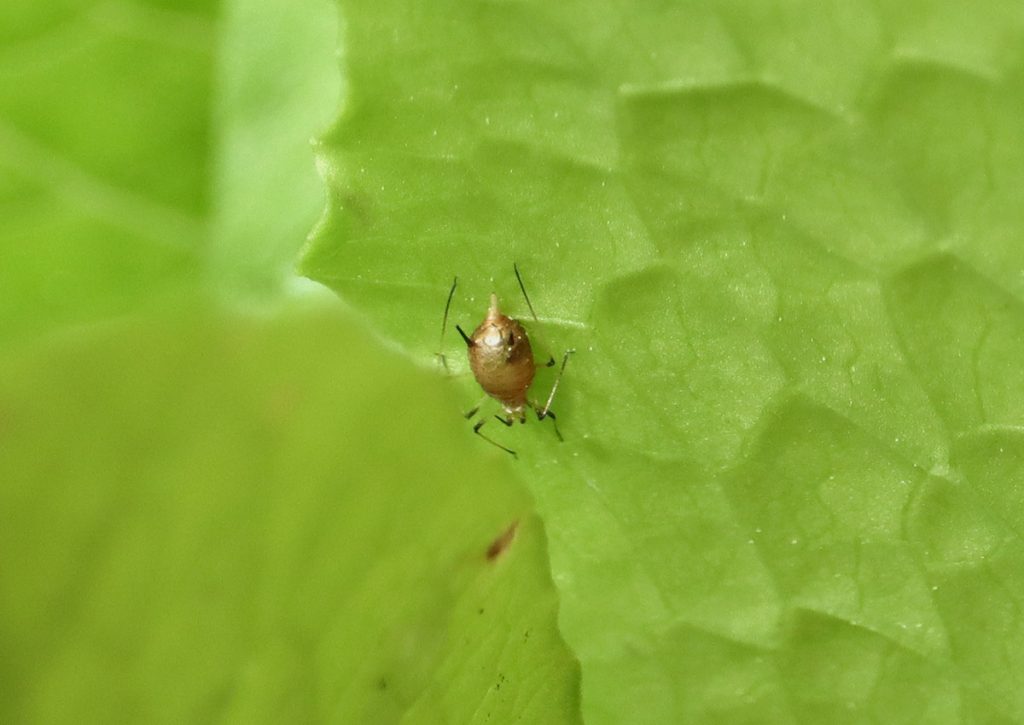
Another aphid, it’s initial ID is also in tribe Macrosiphini. They may all be the same species, in different life stages, or maybe males and females as well. I don’t know much about aphids, other than I like the insects that eat them.
I shared a photo of this last year, but here I am seeing it again. Squirrels like those crane’s-bill seeds.
March 11, 2021
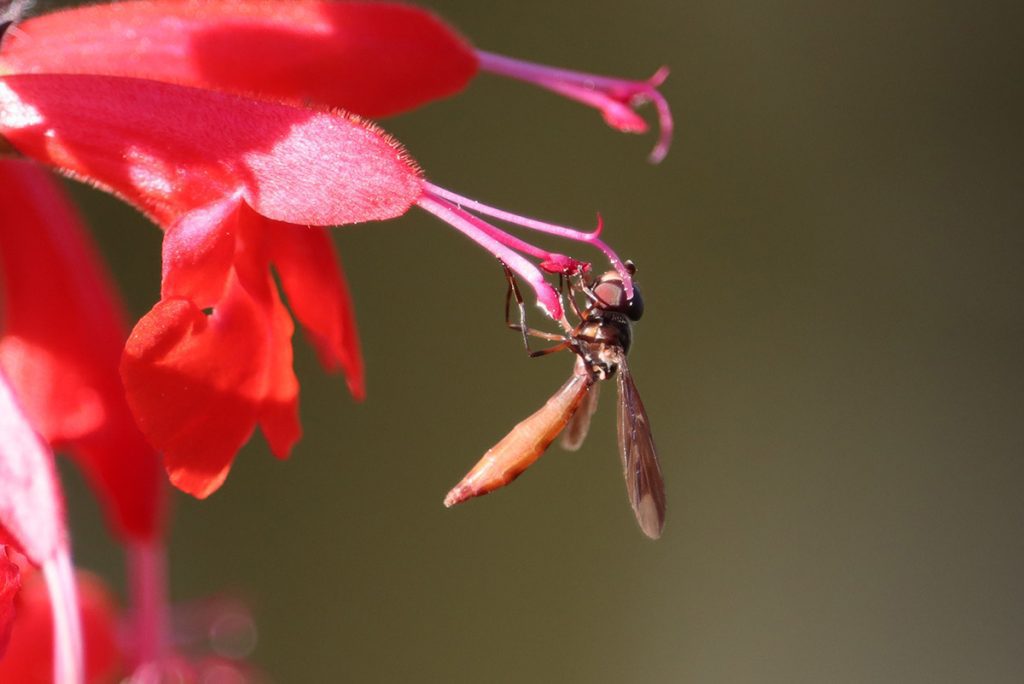
Finally, some pollinator pics!
They’ve been flying high overhead, visiting the cherry laurel flowers. Today, I saw a bumblebee briefly visit our blueberry flowers before I could get to a camera. But it was warm today, and a lot was flying.
I’ve been seeing dusky hoverflies in the yard, inspecting leaves on all sorts of plants. They look for aphids, lay eggs, and their larvae will do us a favor and eat the pests. This one is visiting one of the many newly bloomed scarlet sage flowers in the flower patch.
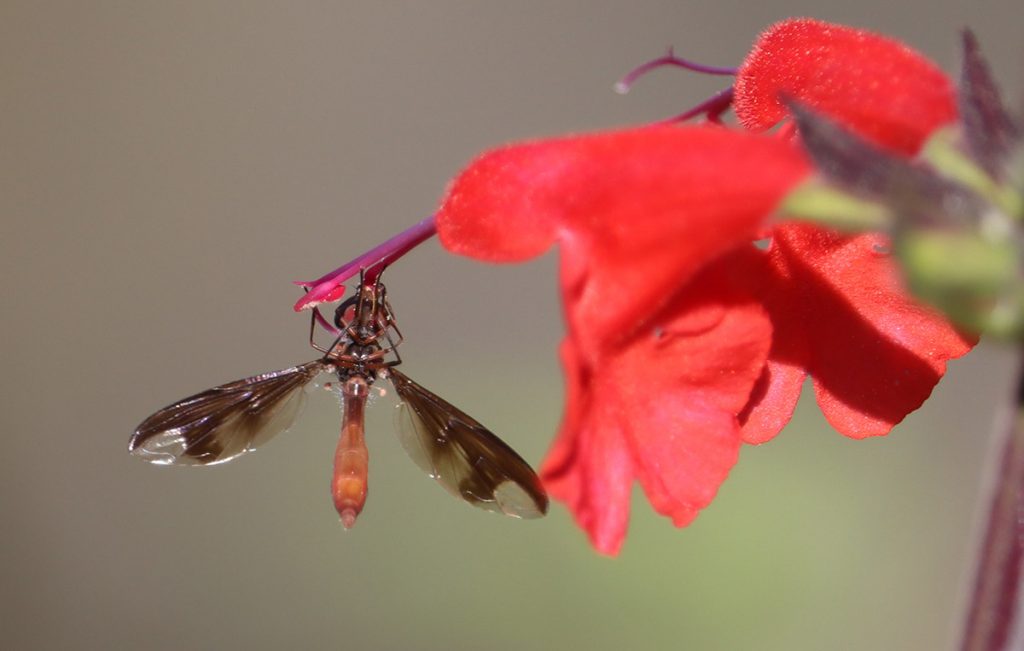
They’re patient pollinators and photographic subjects.
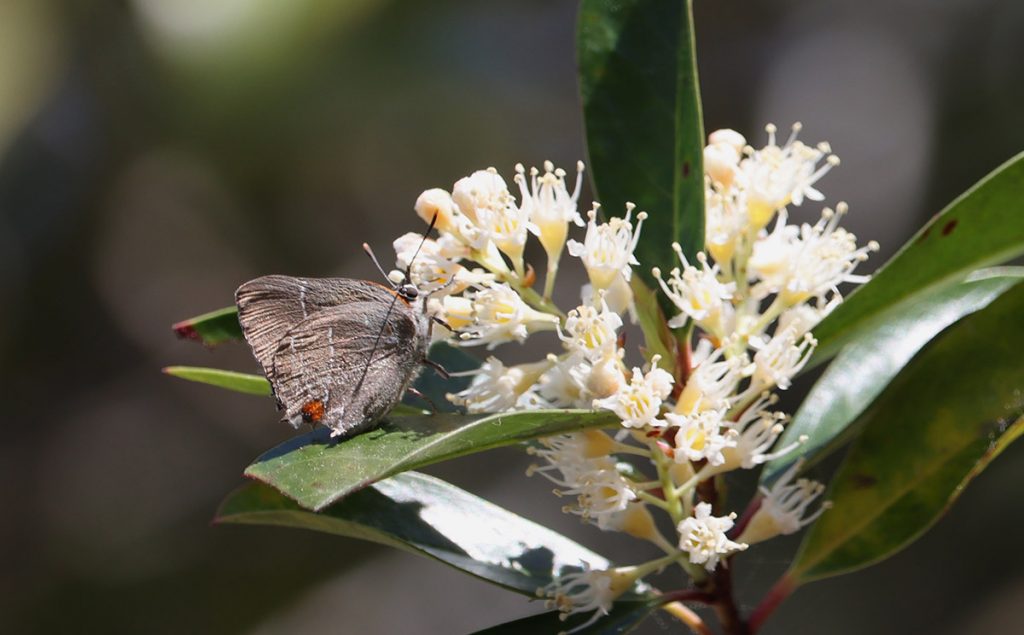
Every day, more and more of our overwintering pollinators emerge to find more and more flowers open to feed them. The White M hairstreak hosts on oaks, and makes its chrysalis in leaf litter. Amy’s been asking whether it’s time to rake the leaves, now that spring is here. I think there’s quite a lot more waiting in there, so we may be a few weeks away from that. Sorry!
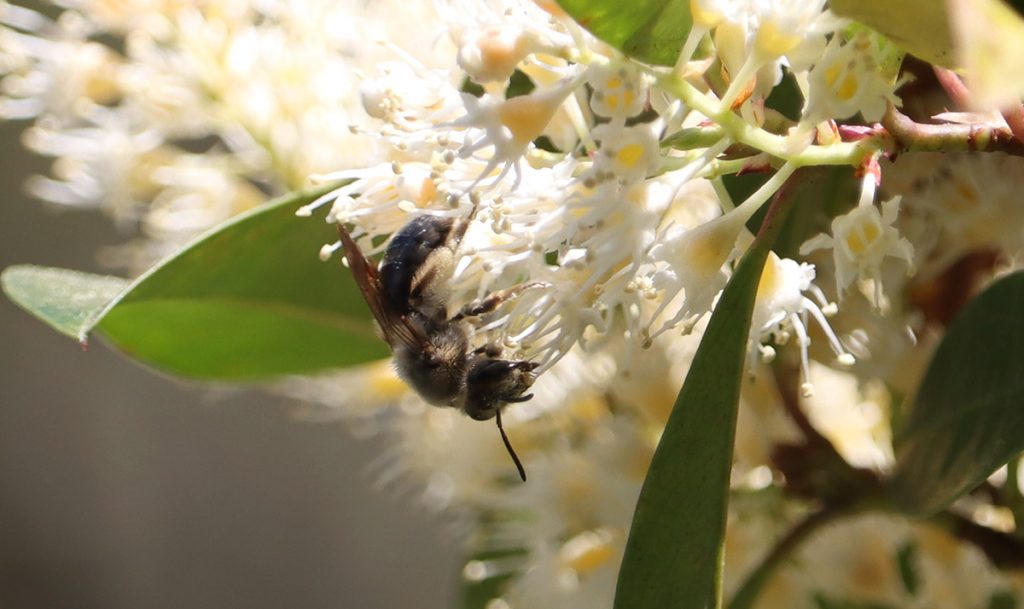
Occasionally, up in the most heavily flowered cherry laurel tree overhanging our yard, a bee would stay for a while on a lower down flower. I think this is a plasterer bee, a ground nester. We have a lot of bare earth in the yard, and quite a few holes have opened over the last few weeks.
Edit March 23 2021: Dr. John Ascher, iNaturalist’s top bee curator, has identified this as a mining bee in the genus Andrena. I ID’d one of these in January of 2018, tackling shriveled cherry laurel flowers on the ground. That makes it one of the earliest bee species I see in our yard, and one of the first insects busting out of the ground when I start noticing holes. It’s also a bee with an affinity for cherry laurel flowers.
Original Text: This is the first time I’ve ID’d a plasterer bee, if that’s what this is. We have a high diversity of native bees in Florida, and they’re not all in the forest. I don’t have multiple photos of this from different angles, so I wouldn’t be surprised if I didn’t get verification on iNaturalist.
March 10, 2021
I’ve looked over this video and my photos, and I think I somewhat know what we’re seeing here. I was looking at the leaf litter for signs of new plant growth. So many of the late winter/ early spring flowers are blooming, and quite a lot of other plants are leafing out all over the yard. So I’m looking around when I see the thrashing I videotaped above.
Looking closely, I could see that I was looking at two animals.
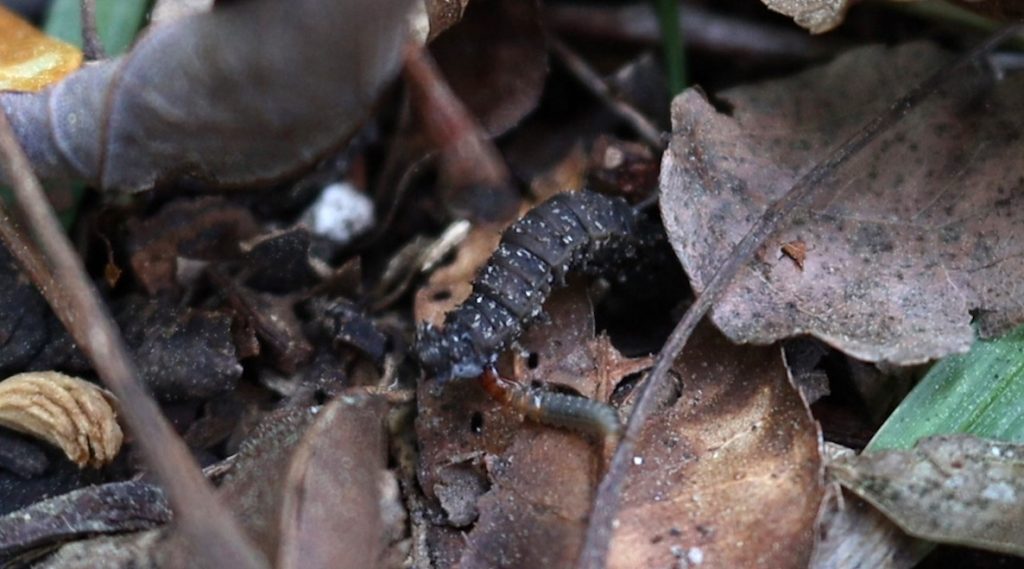
At first, I thought the larger thing was attacking the smaller thing, though that doesn’t appear to be the case when I freeze the video and export a frame. Eventually, the smaller insect is shaken free, and we can see a white foam at the tip of the larger being.
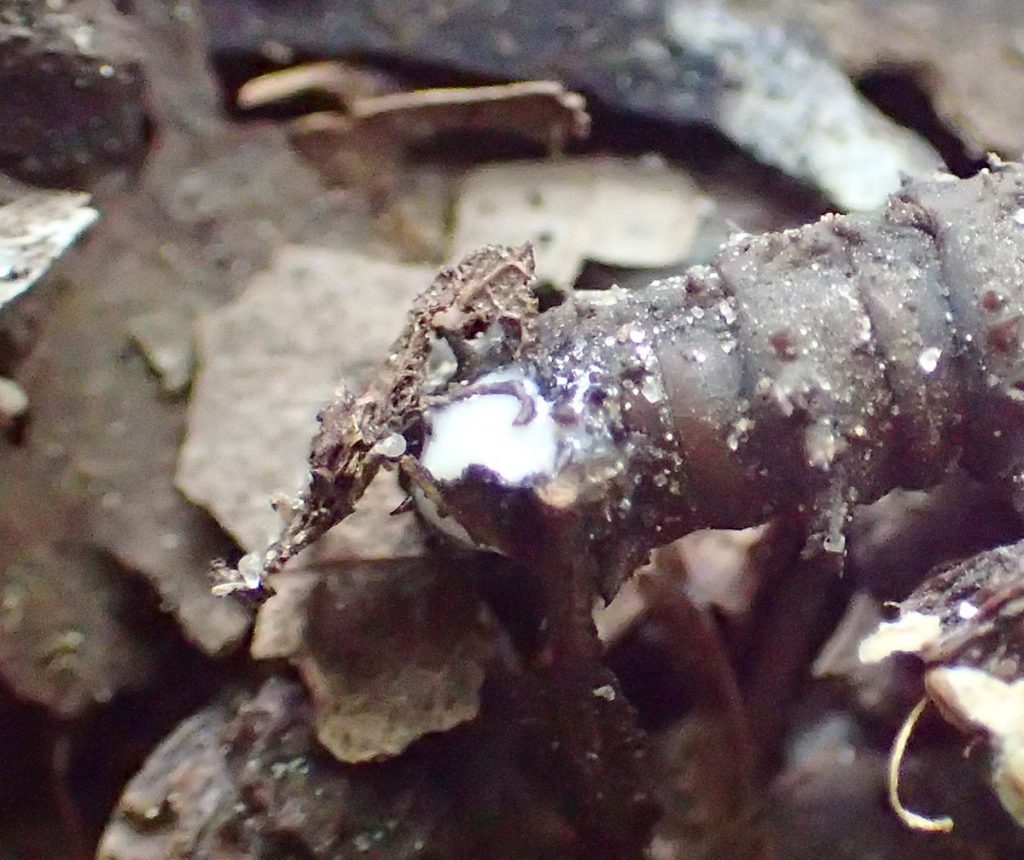
The foam is sticky, picking up bits of leaf.
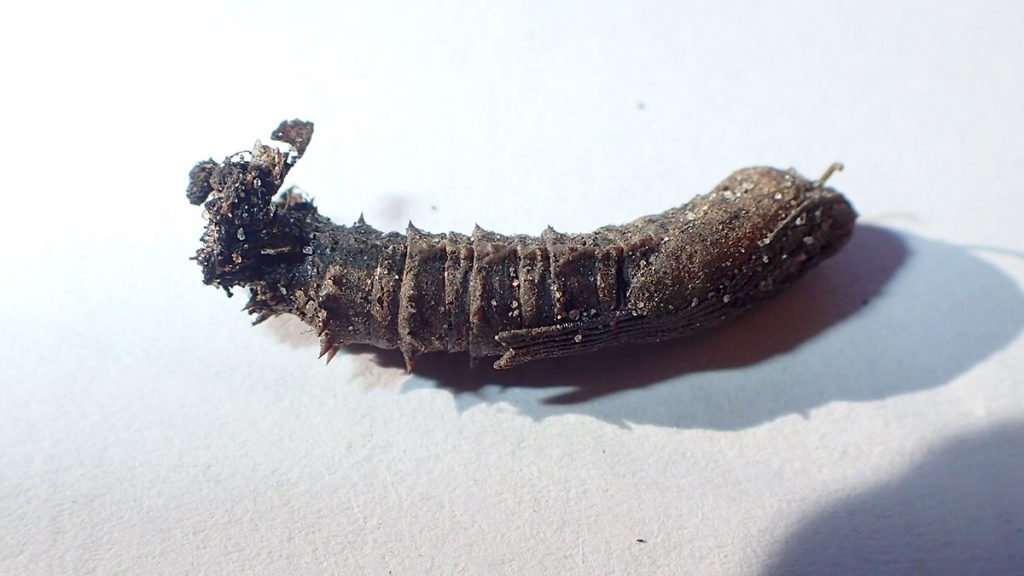
I think the smaller insect was attacking a moth chrysalis. Chrysalides do wiggle and thrash when touched, and that seems to have worked against the aggressor, which dug itself back into the leaf litter.
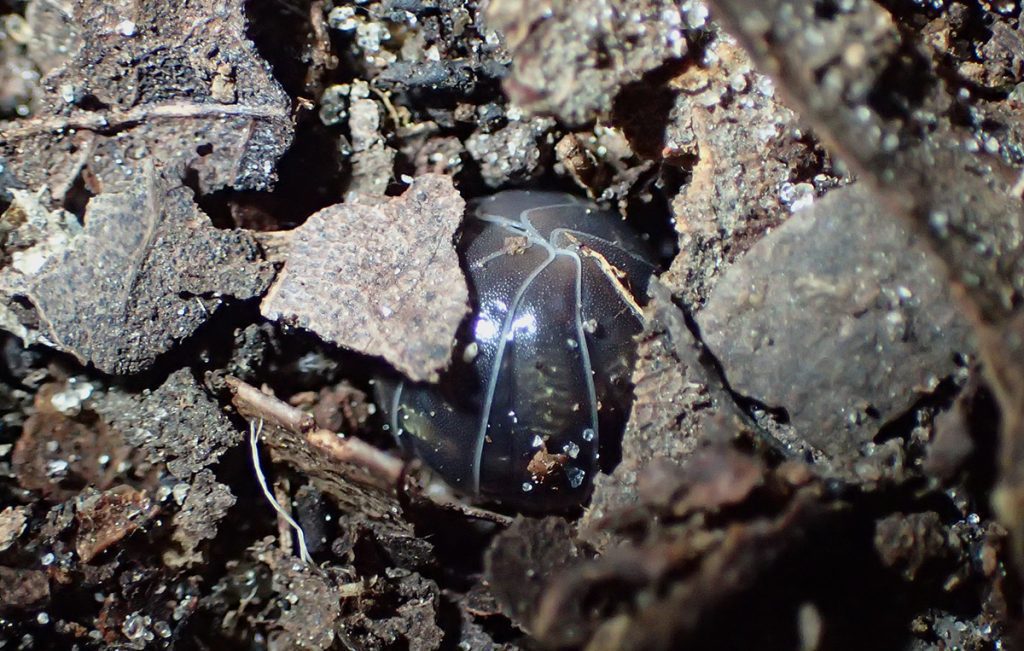
Looking for that smaller insect in the leaf litter, I found this resting roly-poly.
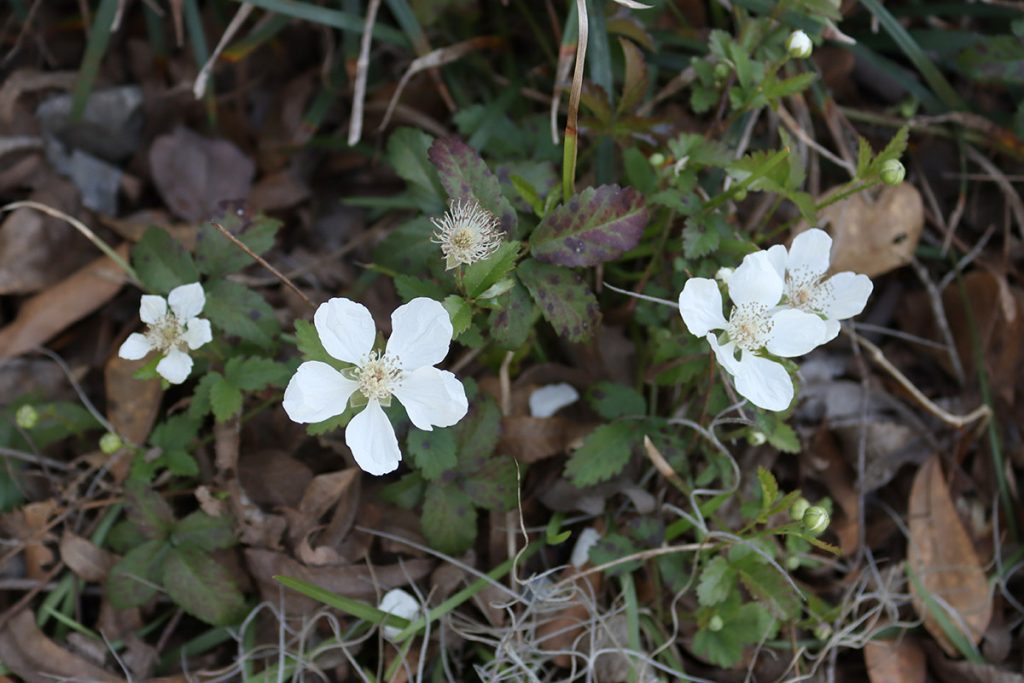
Nearby, a patch of dewberries is in bloom.
March 8, 2021
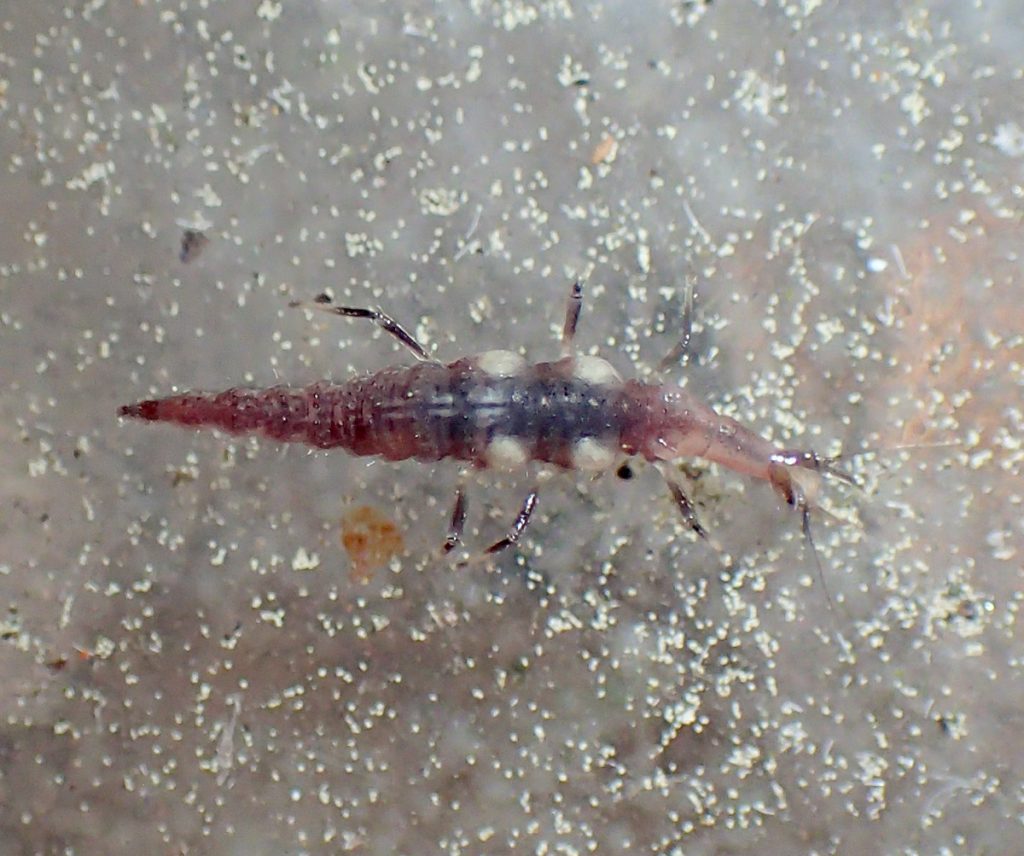
When I go on hikes with the family, or on shoots, I’ve seen a few bees and butterflies. I have seen carpenter and honey bees, mostly flying up high on cherry laurel blossoms.
The kind of thing above, that’s what I’m seeing a lot of in the yard now. I’m not sure what it is, but my best iNaturalist ID was a tube-tailed thrip. Another user suggested lacewing larva, which are predators. Lacewing larvae ambush their prey in debris, such as leaf litter, which is where I found this one.
I was disappointed in myself for not including anything in the photo to provide scale, when I realized those yellow speckles are pollen grains. This is a tiny critter.
March 1, 2021
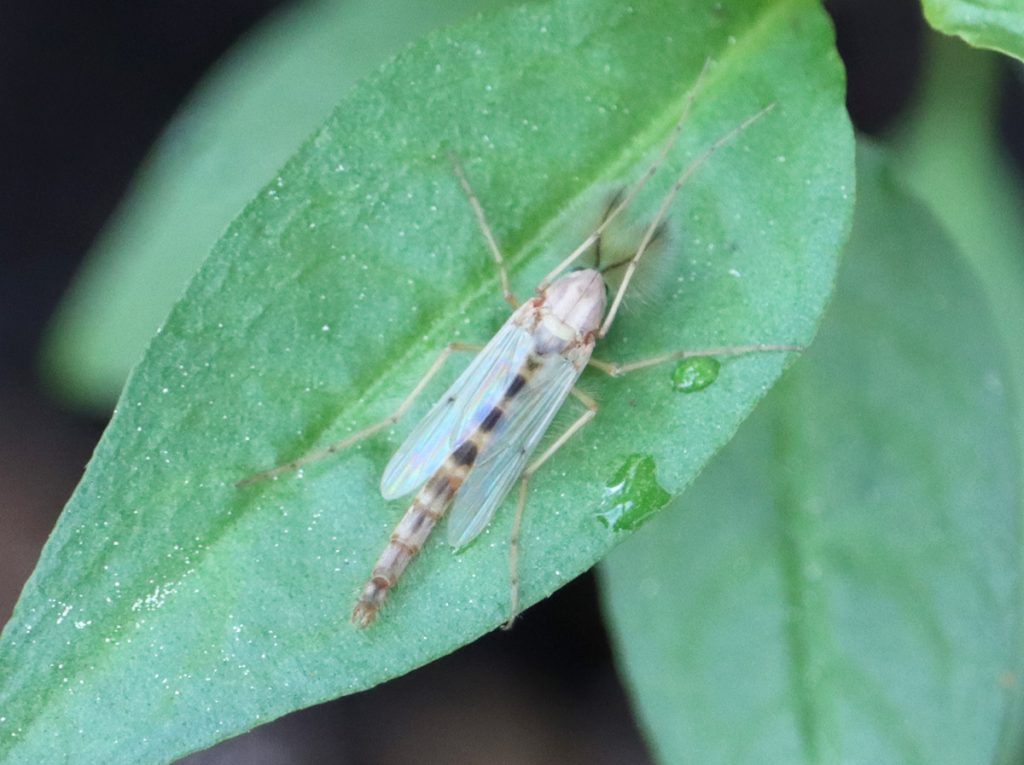
I saw this interesting looking insect sitting on a Vietnamese cilantro leaf. My iNaturalist ID is Chironomus, a midge that spends its larval stage in the sediment at the bottom of a lake or pond. According to its description, members of the genus are almost identical, needing a close expert look to tell one from the other.
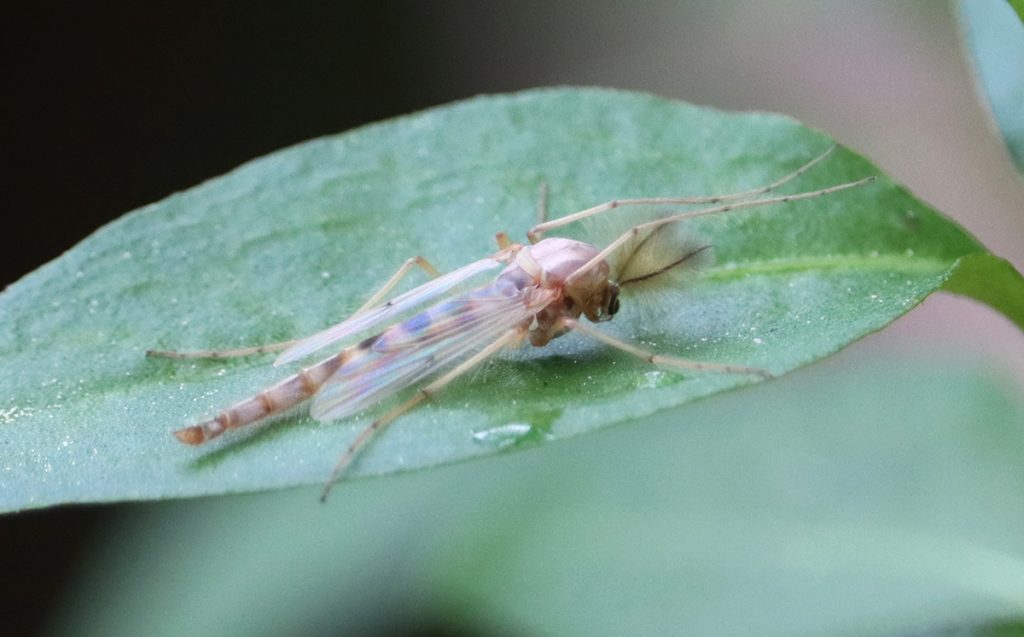
Here’s a closer look. I love the hairy antennae!
February 28, 2021
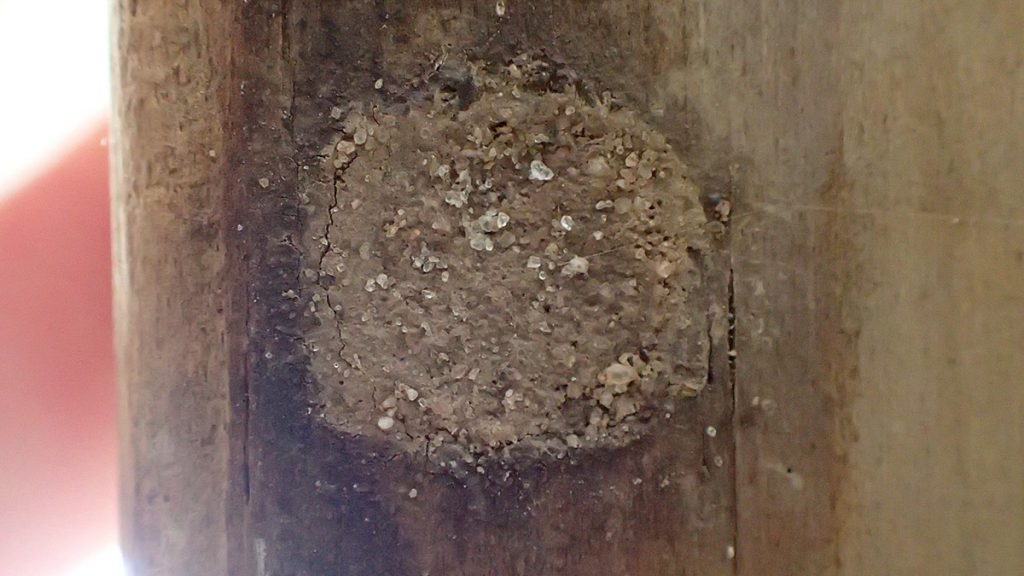
Today I laid in the hammock for a while, noticing two or three carpenter bees flying over the house, back and forth, towards and away from each other. One follows another, the other flees from it. It’s the same thing I see with butterflies when they’re feeling frisky.
Later, I was sitting on the back steps when I remembered there had been a couple of carpenter bee nests in the railing. One had been taken over by four-toothed mason wasps in recent years. I looked, and it was sealed with earth the way mason wasps seal their nests. There’s a brood in there waiting to pop out, and likely with a cuckoo wasp or two mixed in; for years I’ve seen cuckoo wasps crawl into nests after the mason wasps have left. Their nesting strategy is to add their eggs to the nests of other wasps.
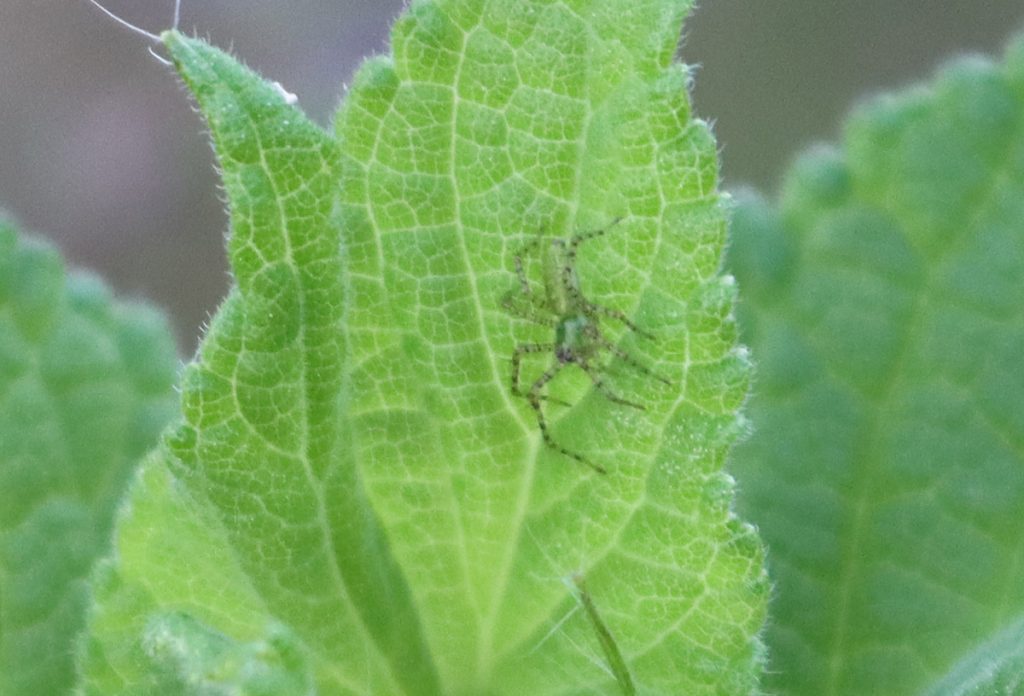
Insects are hatching, and there’s plenty of new plant growth for them to eat. I’ve cleared out last year’s woody salvia plants (leaving them in a brush pile in case any insects nested in their stalks) and the new salvia growth is getting taller and starting to bloom. If any plant eating insects are interested in this tender young leaf, they’ll have a little surprise waiting for them.
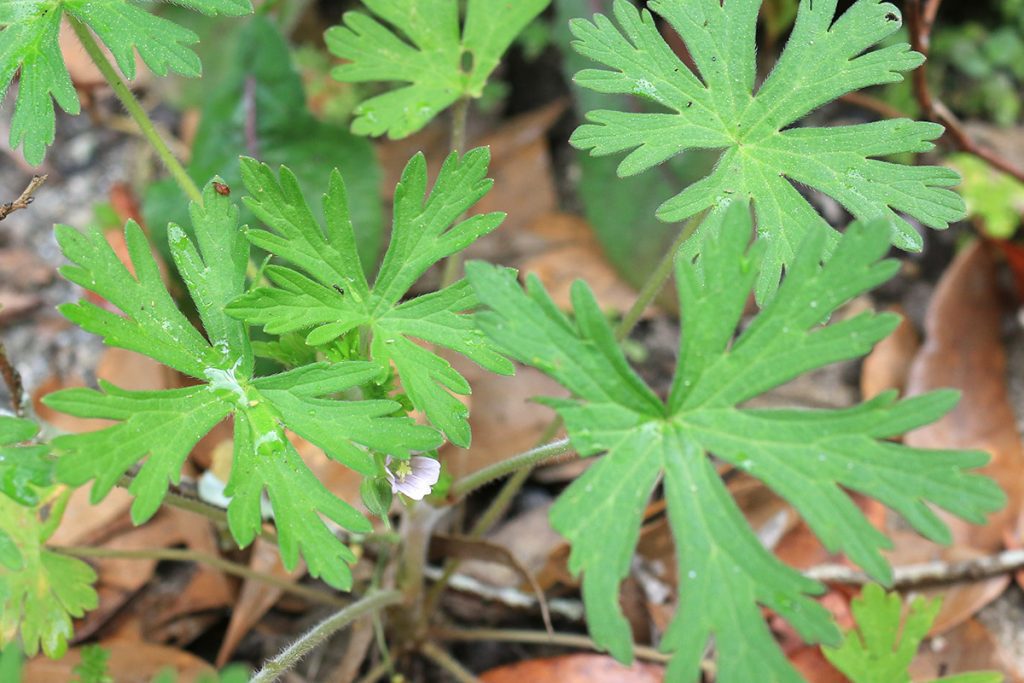
There’s another plant species in bloom now in the yard. The plant gets taller, and its leaves get much larger before it produces this tiny flower.
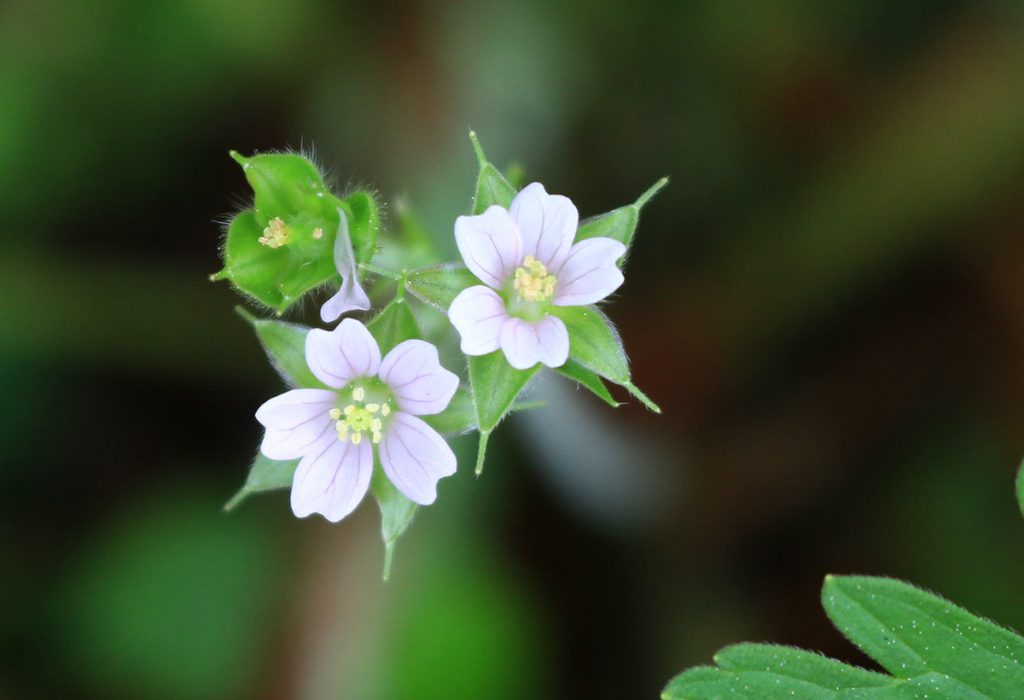
This is a spring plant, a native geranium that will disappear in the months to come.
February 27, 2021
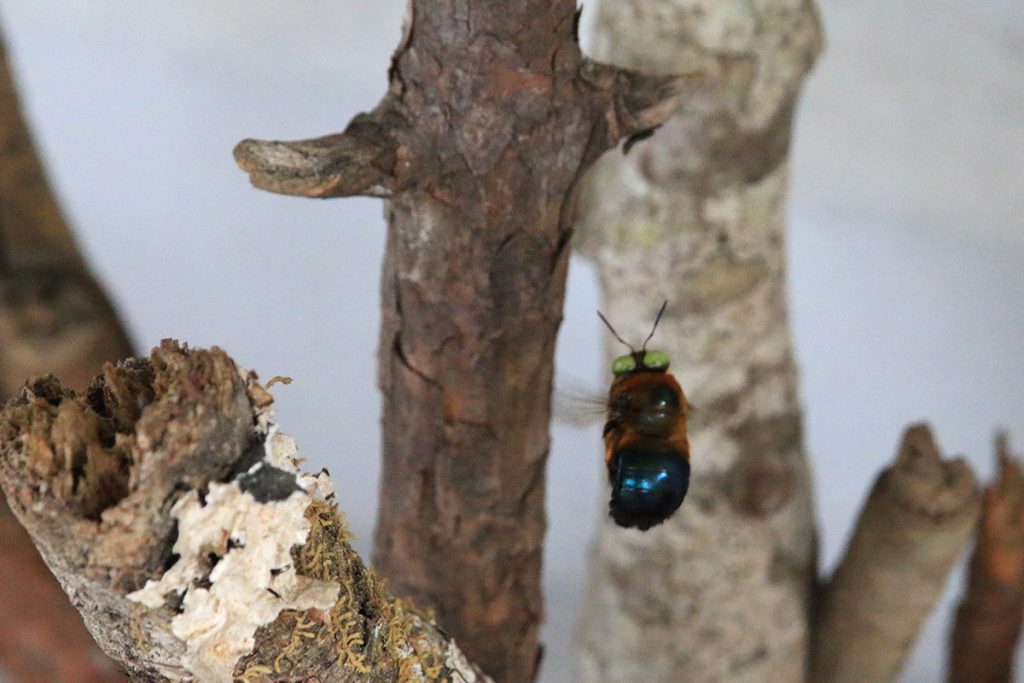
My sons collect a lot of items from nature that they had left in a pile on our porch over time. This includes a lot of special sticks, each with its own outstanding qualities that preclude our tossing them out, ever. One day I put all of those sticks and dried flowers and moss and bits of oyster shell into a pot, and kind of arranged them. I was proud of it, but I won’t bore you with the display.
Anyhow, I followed a carpenter bee onto the porch, and it eventually slowed down enough for me to take this not-great photo of it in flight. It then disappeared into a cavity in one of the sticks.
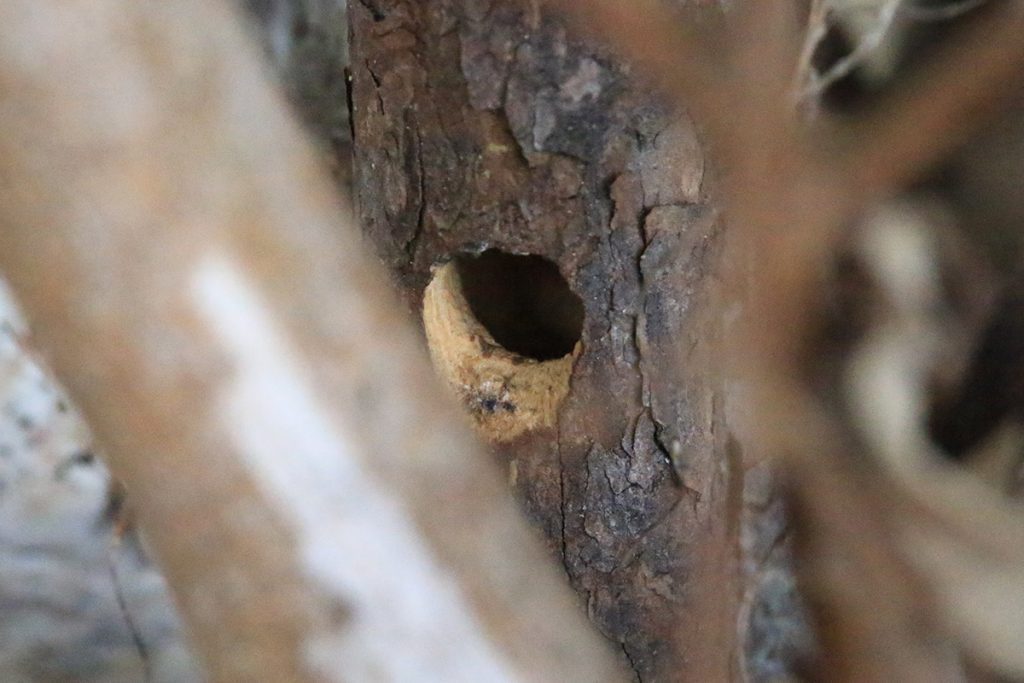
I told Max that his old stick had found a new purpose as a home for pollinators. He felt that the bee was defacing the stick that he had long forgotten about on the porch. Boo.
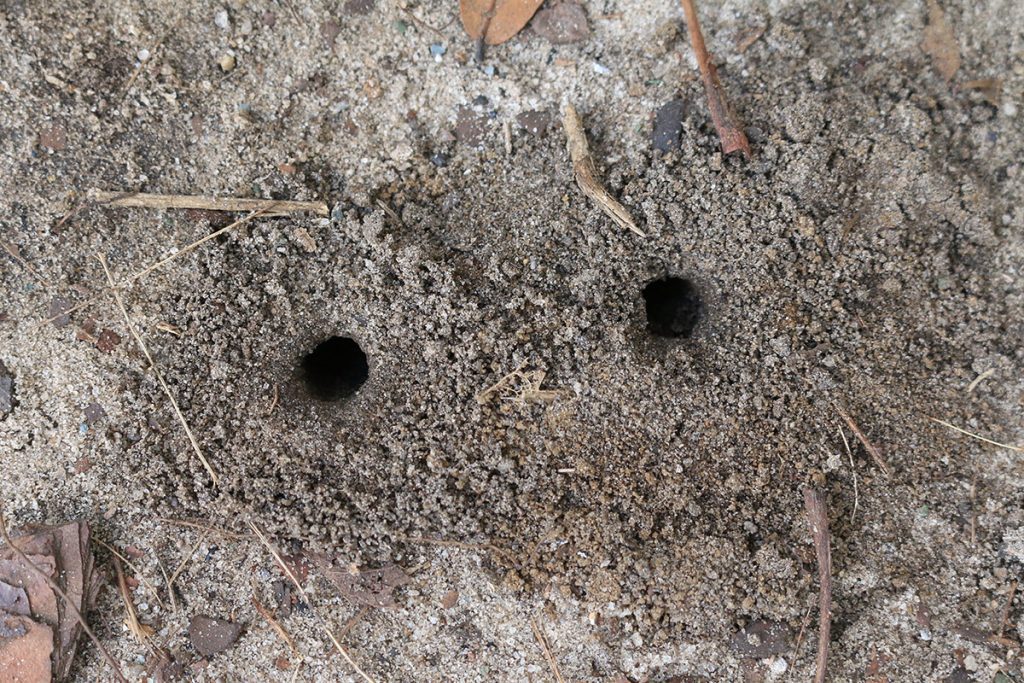
I’m seeing more evidence of insects emerging from or creating new nests as spring arrives. New holes and mounds are popping up throughout the yard. A few of them seem to be coming in twos.
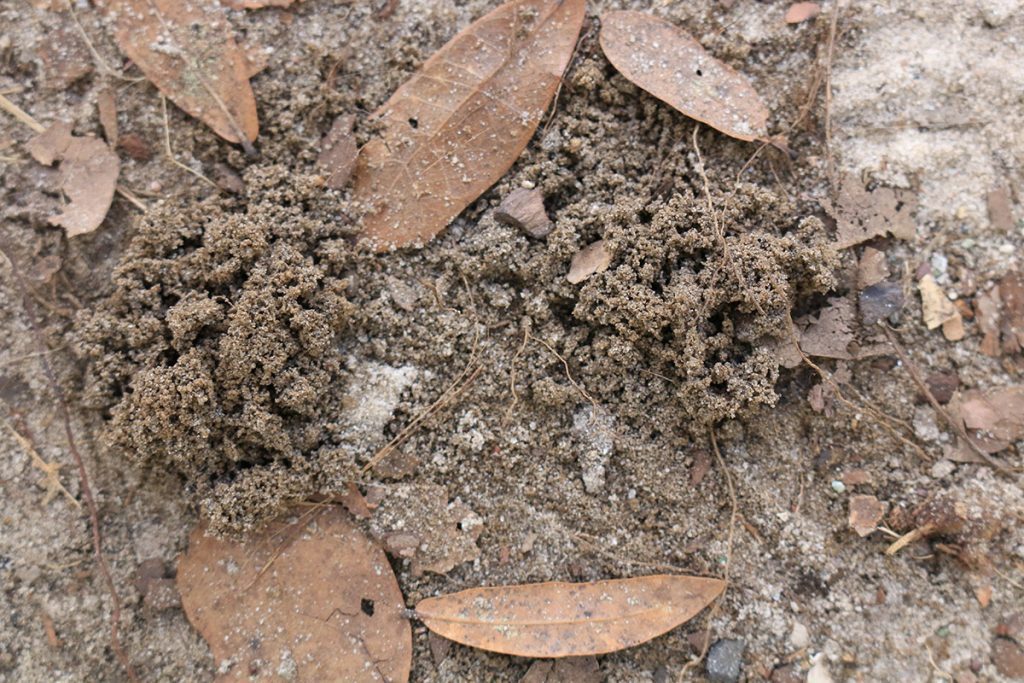
Are these two ends of the same tunnel?
I’m seeing some solo holes as well, of different shapes and sizes. I’ll also be seeing more insects in different shapes and sizes soon, I’m sure.
February 26, 2021
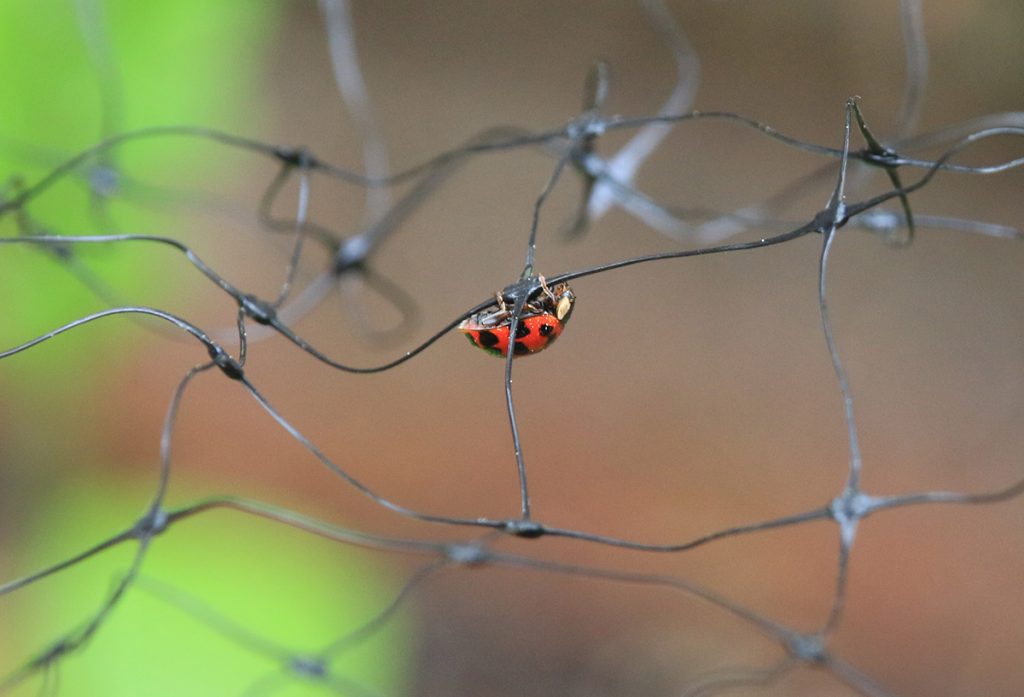
It follows that as soon as I started seeing new blooms and pollen, I’d see insects as well. I’m seeing a lot of insects in flight, like hoverflies and carpenter bees. Others are more cooperative and rest for the camera.
Hoverflies, the adults of which are pollinators, have been inspecting plants not yet in flower. They’re looking for aphids. When the hoverfly finds aphids, it will lay eggs near them, and their larvae will feed on the garden pests.
Here’s another aphid eater; our garden food web’s predators are now out and about. Unfortunately, this is an invasive lady beetle, and one that aggressively removes its native competition.
February 22, 2021
After a morning rain, we had a couple of puddles that slowly filtered through the clayey soil in the yard. At first I was worried about the yellow streaks across the puddles, when I remembered what I saw on my car yesterday. Tallahassee’s trees are starting to reproduce.
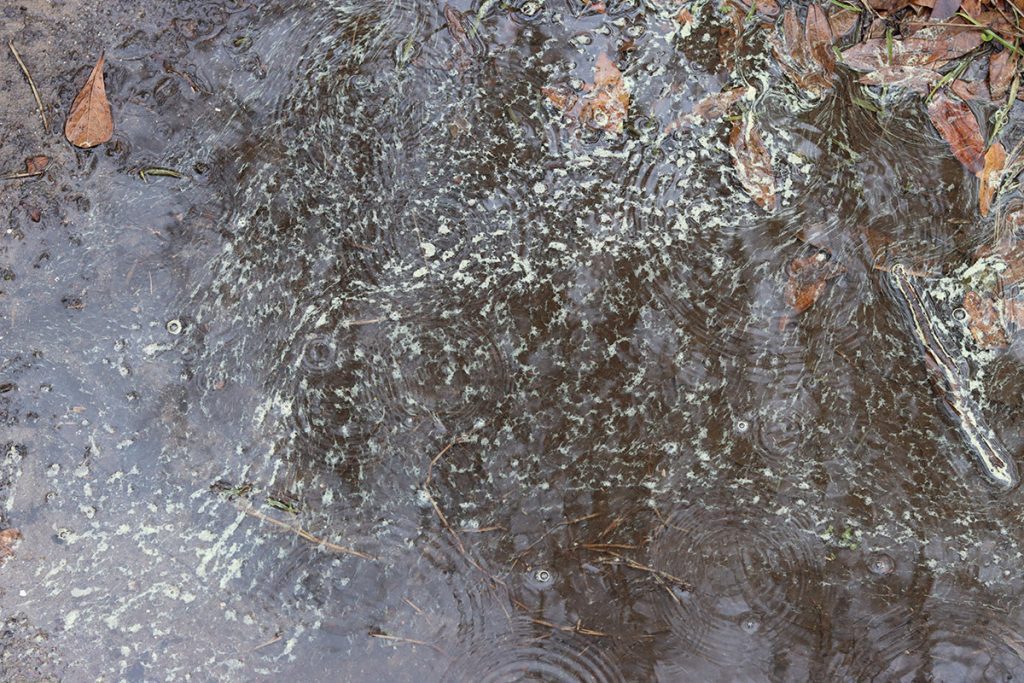
Flowers are staring to bloom as well. One of the first I noticed is a single lance-leafed coreopsis plant, which has been making flowers for a few weeks.
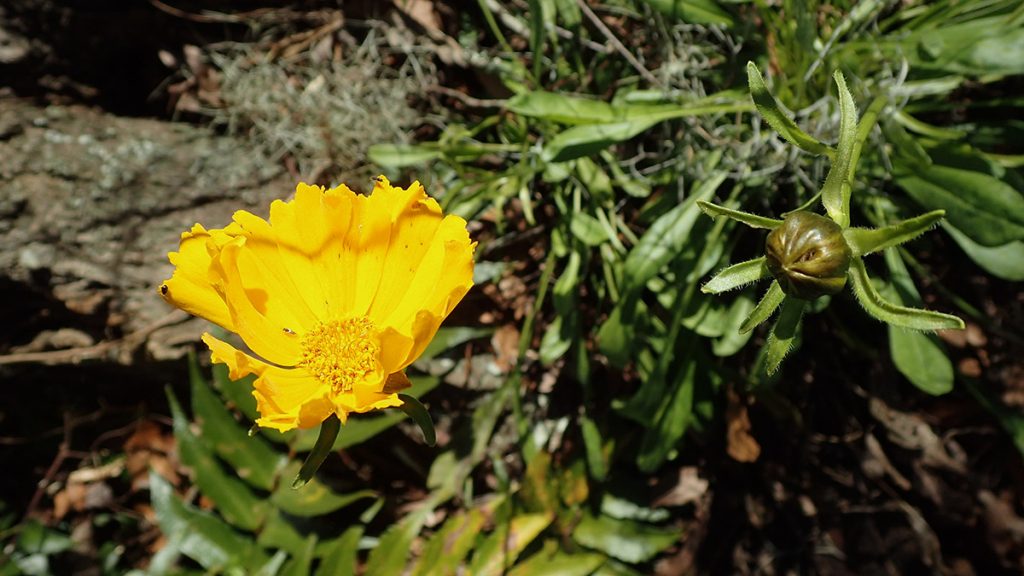
The blooms last a few days. You can see where the flower is starting to look ragged as another gets ready to bloom. I spread seed all over the yard last year, and while they grew, only one plant made flowers. Seeing this, I’m hopeful we’ll have many more of these flowers, which were popular with smaller sweat bee species.
A few weeds are starting to bloom:
Left to right: Bidens alba, Ohio spiderwort, and common vetch (Vicia sativa), visited by ants.
That little Bidens plant has been flowering throughout winter. That’s why it’s such an important flower for winter-flying pollinators. We have a couple of spiderwort flowers here in late February, and they were a major nectar source for our early spring bees last year. The vetch is non-native, but it’s a nitrogen fixer and it’ll die off in a couple of months.
A couple of my planted wildflowers are in bloom now as well.
The Leavenworth’s coreopsis started blooming a couple of weeks ago, while the sage had sparse blooms throughout the winter. That sage is constantly going to seed, and spreading itself in the yard. I recently cut back the older, woodier growth to give the new plants space.
February 20, 2021
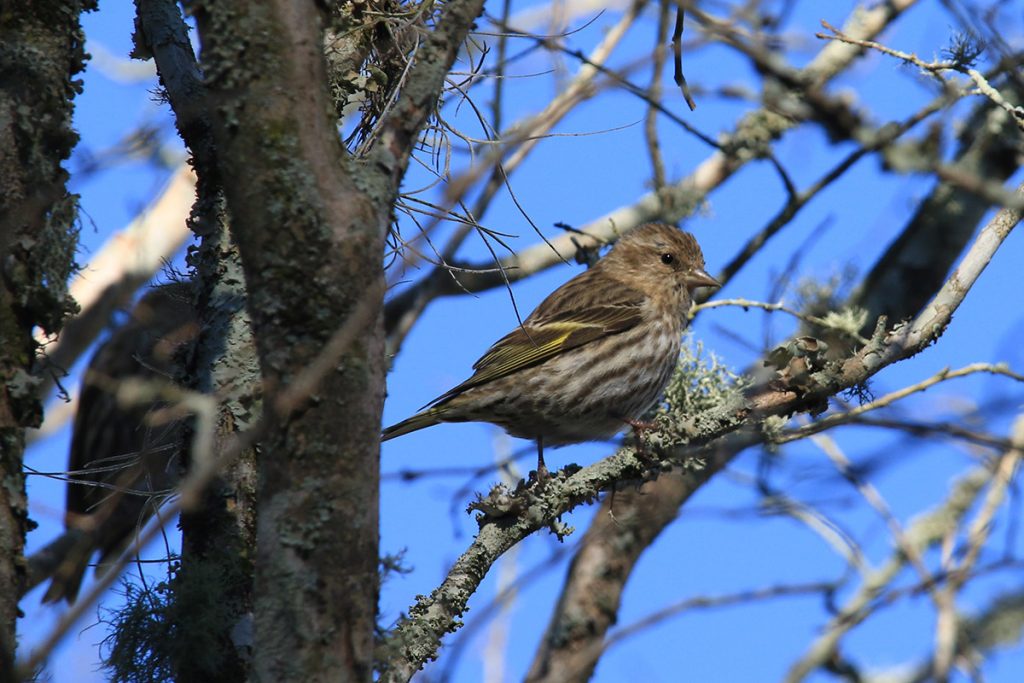
I got a closer look at one of the pine siskins that has been flocking around the neighborhood. In addition to the winter visitors I’ve photographed, I’ve also seen yellow-rumped warblers and goldfinches.
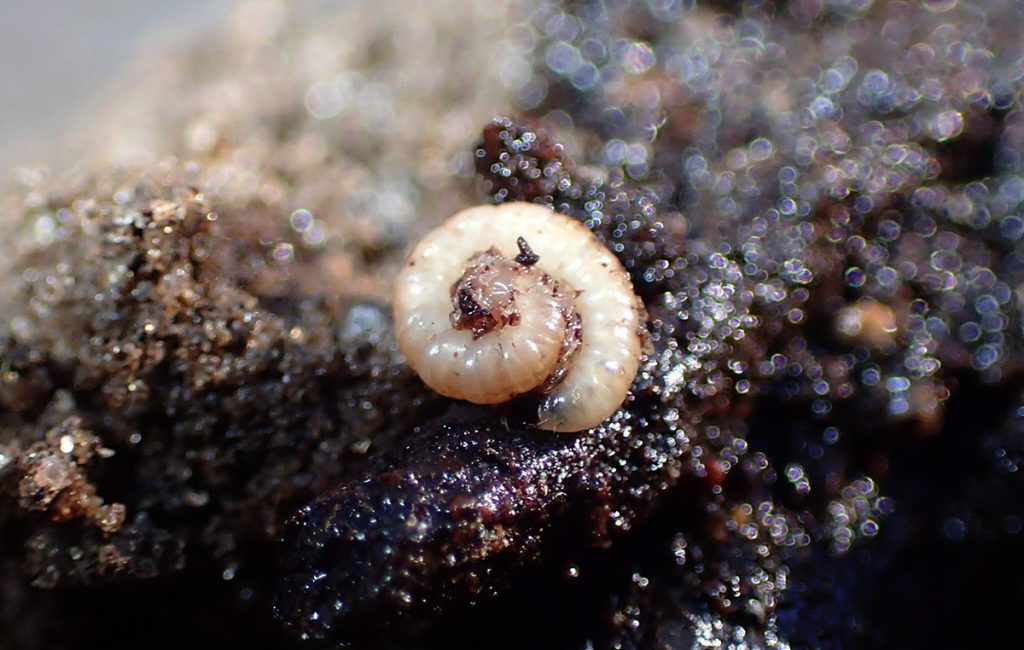
Adding compost to a flower, bed, I noticed a few of these little white creepy crawlies. At first I thought they were a beetle larvae, until I saw one uncurled, and all of its legs.
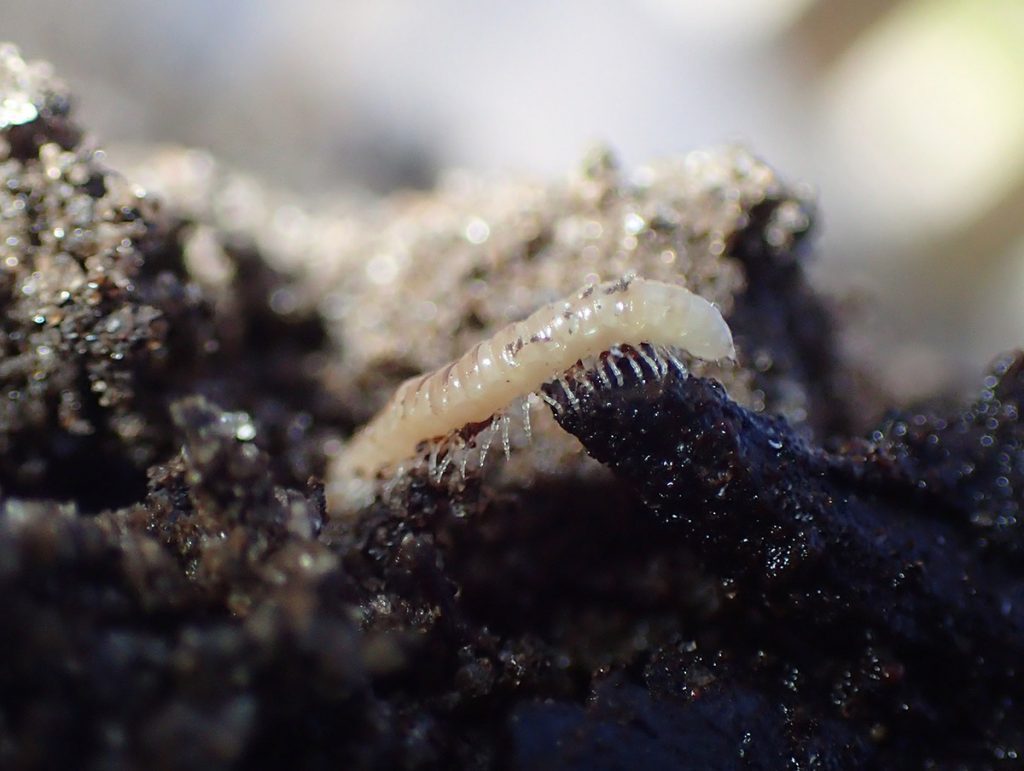
Since I started writing this, an iNaturalist user has identified this as a geenhouse millipede (Oxidus gracilis), a non-native that’s considered a garden pest. These, and slugs, and roly-pollies, and snails- these threaten seedlings in the yard. And many of them are exotic species.
February 18, 2021
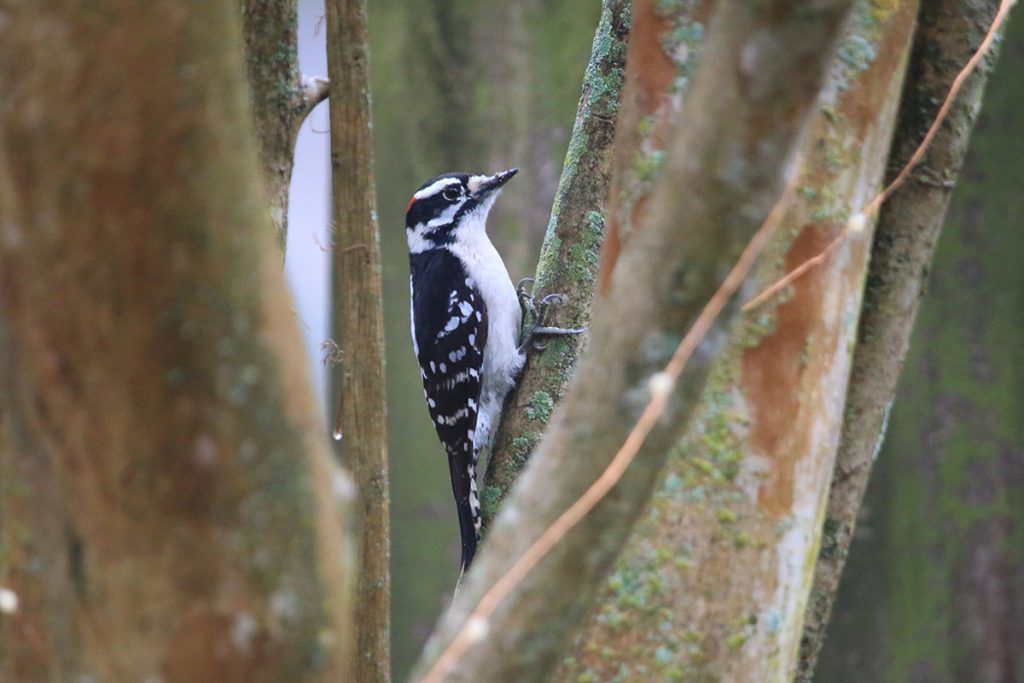
This is the second time in recent weeks that I’ve seen a downy woodpecker pecking at a wood structure in the yard. Today it was a wooden post left from a wooden bench I removed. When I removed the boards, I found sweat bees nesting in its soft wood. The remaining post is apparently soft enough for some kind of insect life, or so this woodpecker was hoping.
I must have startled it. It flew into the crepe myrtle and was very still, eve as I photographed it. It then slowly climbed up and around the trunk, safely out of view.
February 10, 2021
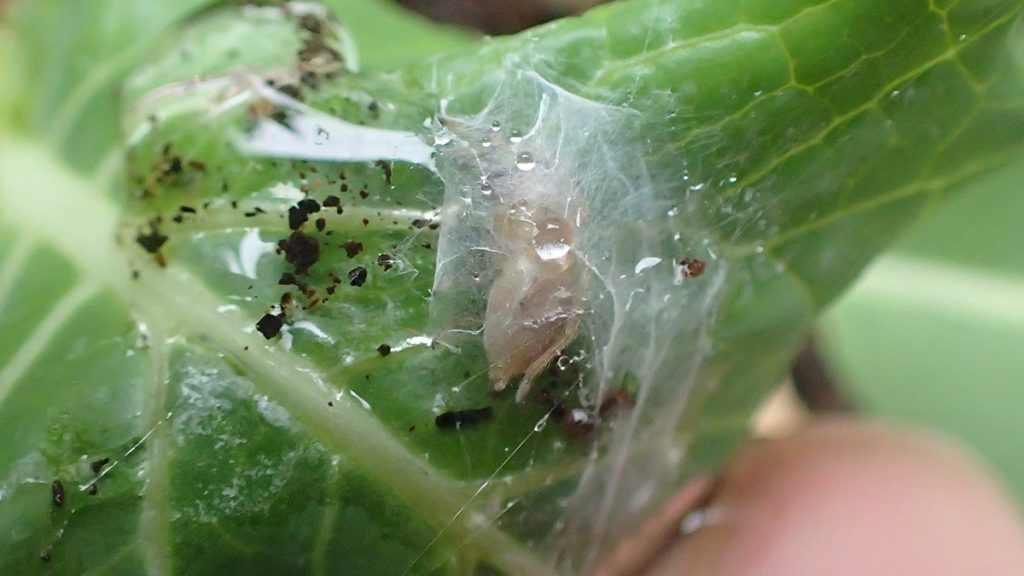
I was watering my plants when I saw what looked like ice on a brassicas leaf. Looking more closely, I see what looks like a moth cocoon. Getting an even closer look with a macro lens, I see legs. This could be a spider crab nest, they make silky nests like this on leaves.
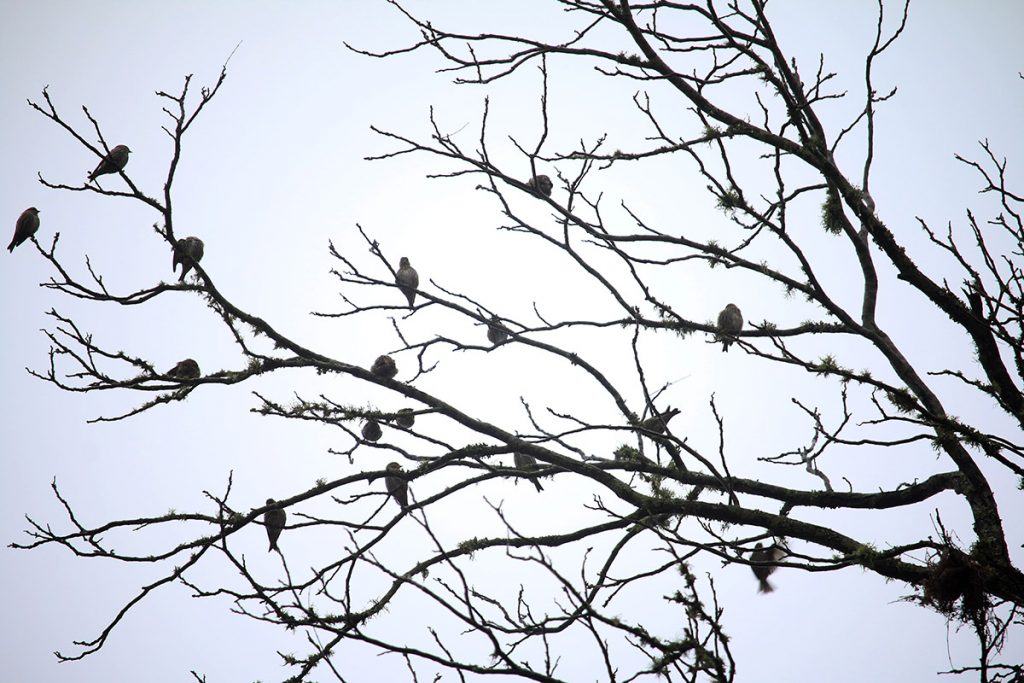
Once again, I hear a ruckus of birds outside. But these aren’t the winter visiting robins and cedar waxwings Ive been seeing. I look with binoculars and zoom in with my camera, and I can see their striped undersides but not much else.
Some friends have been posting about purple finches and pine siskins visiting their yards. I’m guessing siskins.
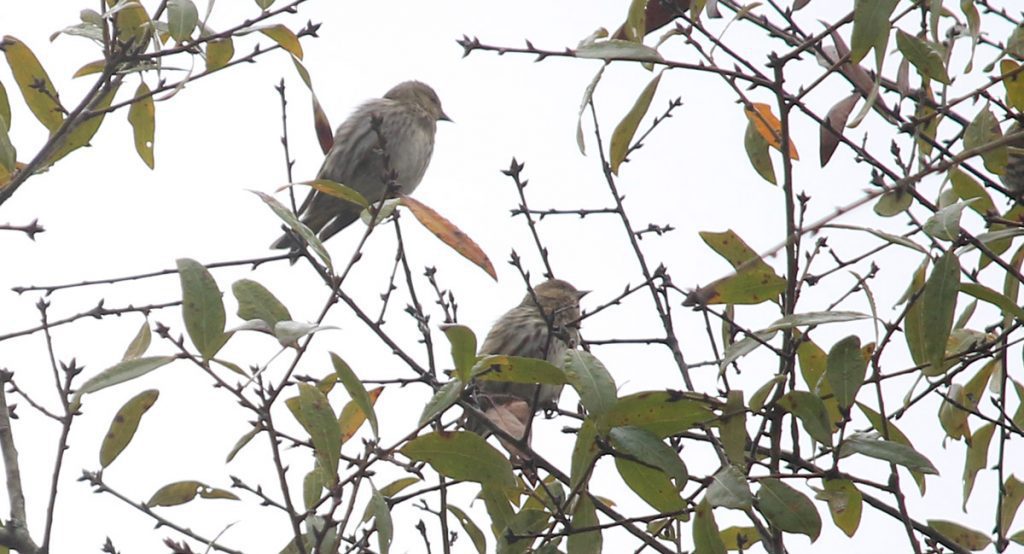
The beak is thinner and pointier than a finch. And siskins do fly in flocks. Even without a clearer photo, I’m pretty sure that’s what they are.
February 2, 2021
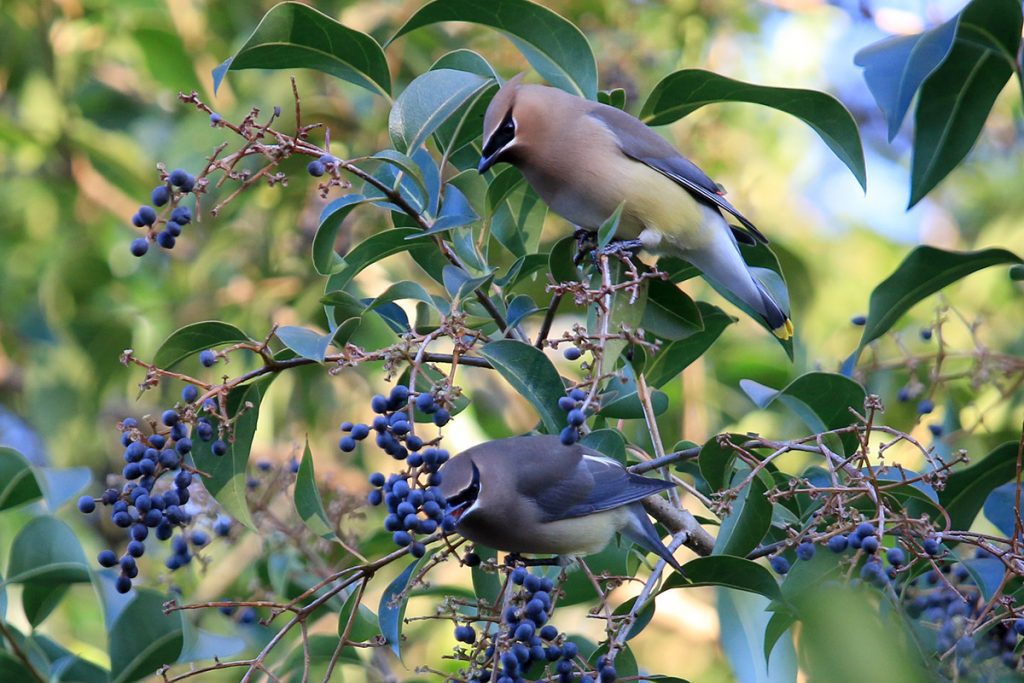
Great joy turned in to great disappointment today. Cedar waxwings returned to the yard again, with those large flocks of robins. Unlike on their other visits, the sun was shining. And I had figured out a better vantage point from which to photograph them. I was pretty pleased with myself.
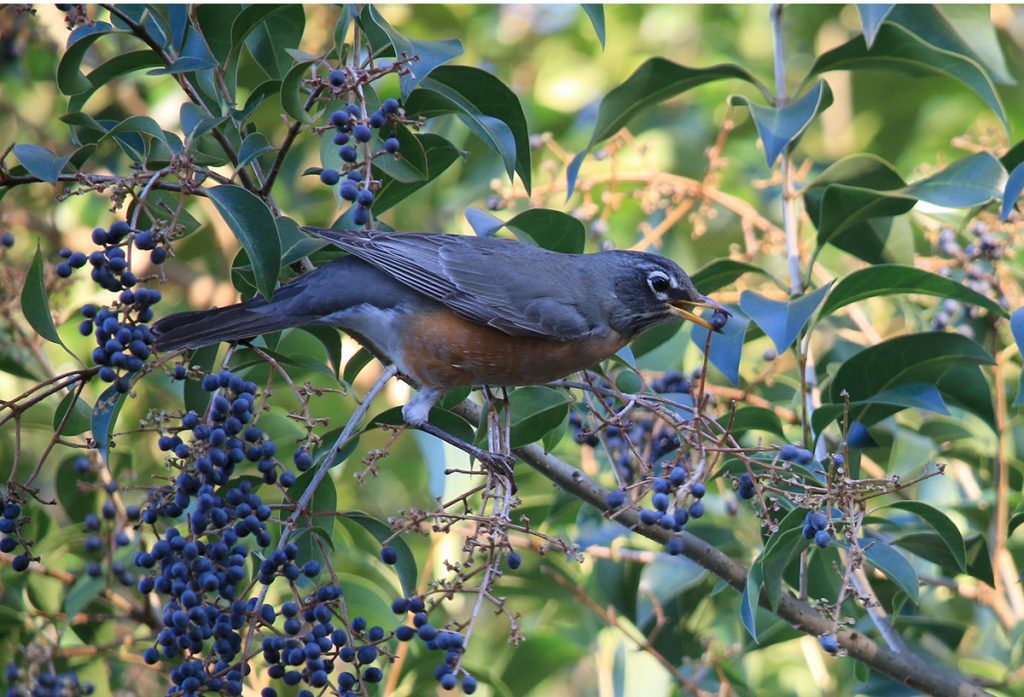
So I posted these photos on Facebook, and my bird loving friends responded in the way I’d expect. As you might imagine, I know some knowledgeable plant people as well. Having these migratory birds in the yard is, of course, wonderful. But they were eating something different than what I had thought.
We have a row of native cherry laurel trees planted on the other side of our fence. It’s a visual barrier between our yard and the parking lot next door. They have little blue berries, and in the past, robins have eaten them off the ground in our yard during this time of year. I though that the largest of the cherry laurels, growing in the corner of the yard next to ours, and which shades a good part of our yard, was having a banner year for fruit production. Not so.
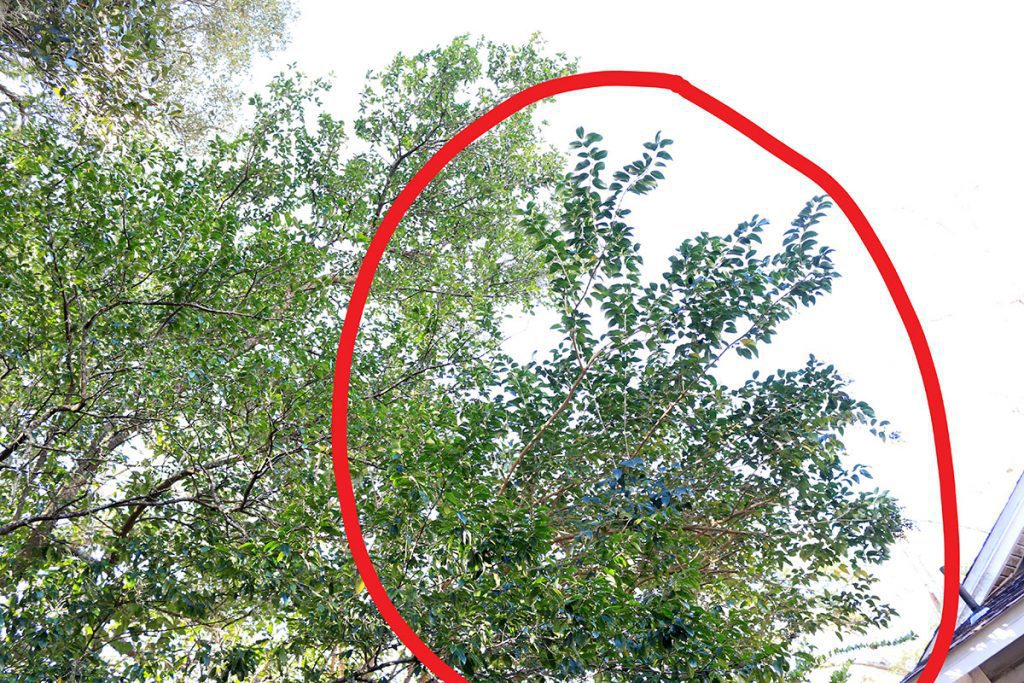
Once it was pointed out to me, it was obvious. This glossy privet plant is growing next to one of the shorter cherry laurels on the other side of the fence, and has grown in an arch shape over our yard. The taller cherry laurel is above it, and the shorter ones next to it. It was all a mass of leaves until I looked up and noticed how different some of the leaves looked, even from a distance.
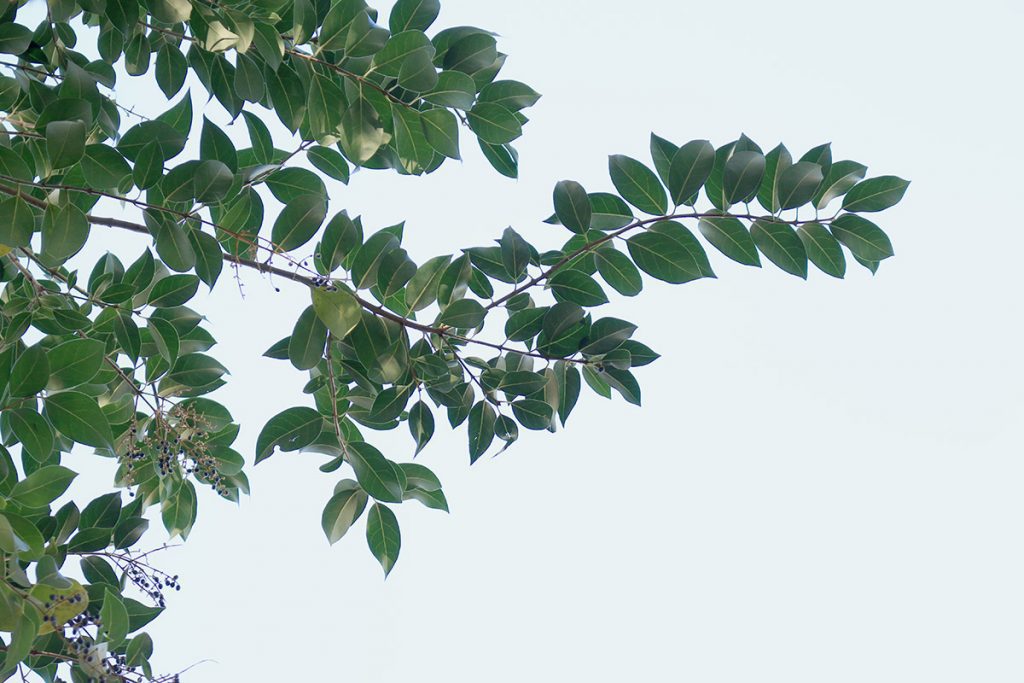
The opposite leaf pattern, the smooth sheen of the individual leaves, and those clusters of berries at the ends of the branches- when I looked more closely, it’s much different than its native neighbors.
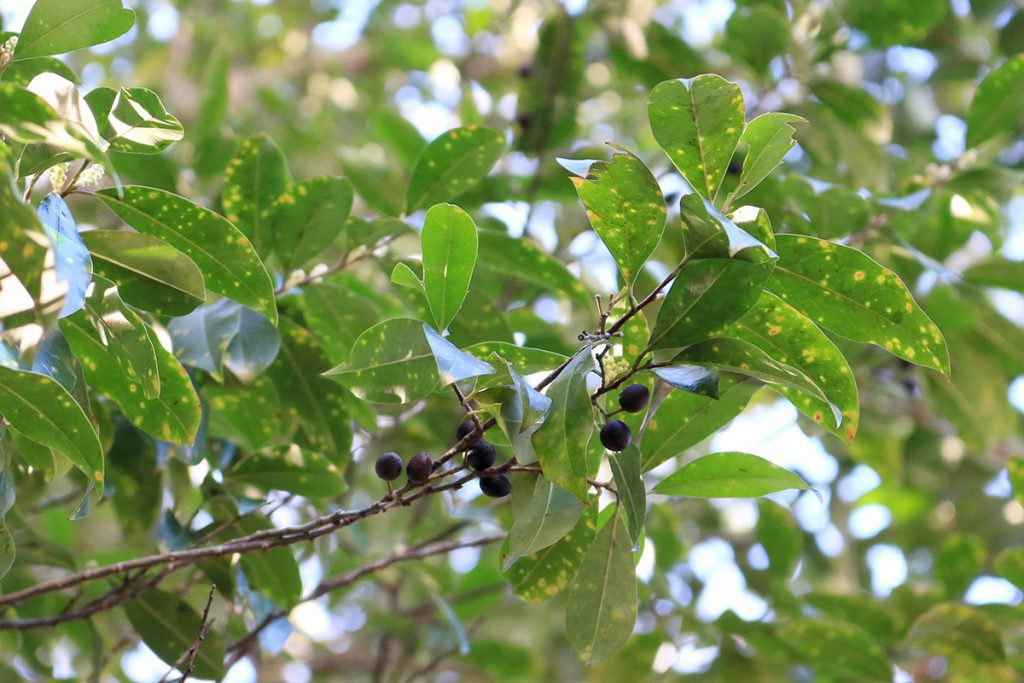
I’m disappointed in myself for not having been better educated on invasive trees, and for not noticing a different tree among the others. Now I know, and I can work to remove the invader. Unfortunately, these trees spread when birds eat their berries and poop them out, and birds have been feasting on it.
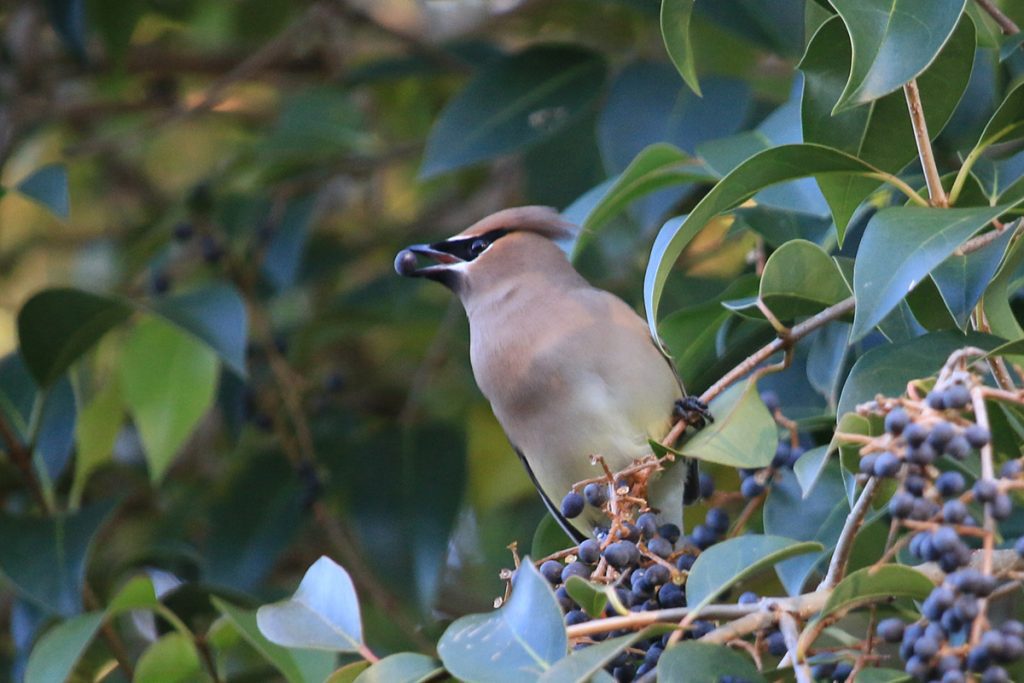
So, if it doesn’t hurt the birds, what’s the harm of the plant? For one, invasive plants spread easily and crowd out natives. Insects eat native plants. And, for most of the year, birds eat insects. In the winter, hollies, cherries, mistletoe, and even vines like Virginia creeper and poison ivy make berries and feed both our resident and our migratory visitors. But birds need multitudes of caterpillars and other plant eating insects to survive the year. If we let non-native plants overtake natives, there’s less bird food, and ultimately, less birds.
Thanks to Florida Native Plant Society’s Lilly Anderson-Messec and Leon County IFAS Extension Agent Mark Tancig for identifying the plant.
February 1, 2021
I was looking at a potted coreopsis plant when I noticed a few leaves weren’t looking so great. The soil surface was covered in leaves, so I started peeling a few back, when I saw this tiny cutworm caterpillar. Over the years, during the winter months, I’ve found the caterpillars of a few different moth species hiding in leaf litter. If you let a thick layer accumulate over soil, you have an insulated habitat for the hardier caterpillars to find shelter in months like this one, which alternate between slightly cold to moderate temperatures.
Anyhow, cutworms are generalist caterpillars, that can feed on a variety of host plants. This is why they become garden pests. Maybe there’s a bird that’s tired of berries, and wants a juicy caterpillar snack.
January 31, 2021
I didn’t take any photos today, but as we awoke this rainy Sunday, there was heavy bird activity around the bird feeder. House finches, cardinals, and a few red winged blackbirds took turns perching on the fence and on the feeder. A downy woodpecker clung to the pole holding it up, before jumping to peck on the fence.
And then I saw robins. A few in the yard, and a whole lot more across the street. Soon, house sparrows, chickadees, titmice, a bluejay, and a single warbler flew into and out of that part of the yard, most stopping for a few seeds. I saw this all from the window. These are all birds I’ve seen in the yard before, some more than others, but never all at once.
Stepping outside, those large flocks of robins and cedar waxwings from New Year’s were back in the cherry laurels. The robins in particular were on the ground and on various trees around the house and down the block. I imagine they descended in large numbers into a relatively small area, and flushed the other birds out of their trees and into the open. Or maybe it was something in the conditions, the rain and wind, that agitated all of the birds.
January 26, 2021
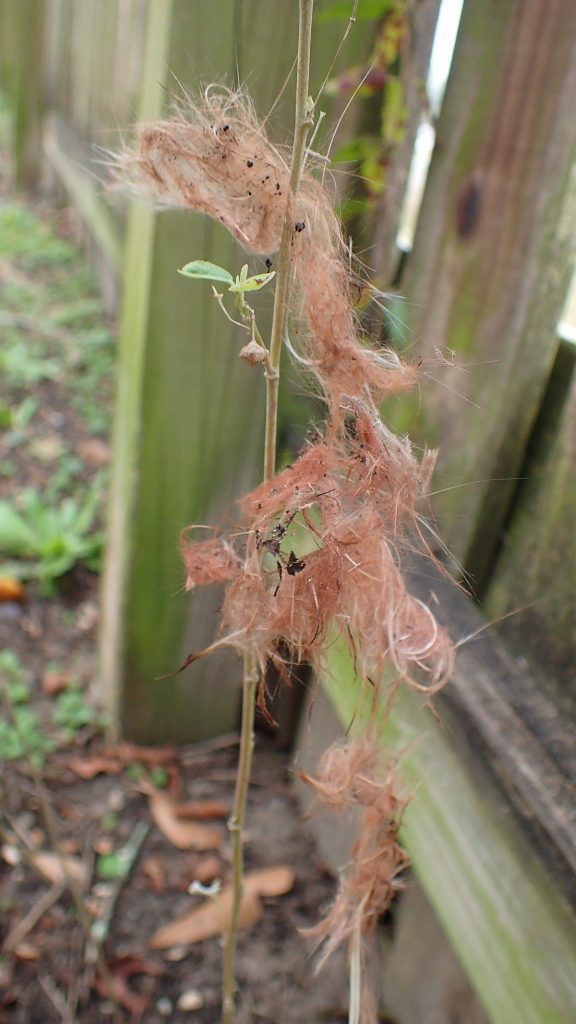
I’ve been seeing these curious clumps of red hair in the yard. At first, I thought they might be cardinal feathers, until I took a closer look. It looks like mammal hair, doesn’t it? I’ve been wondering if this hair isn’t related to the little holes dug in the yard (documented in last month’s Backyard Blog)- maybe a grey fox?
We’ve seen foxes in the neighborhood for years, and someone in the neighborhood Facebook page recently wrote about seeing one happily trotting towards a nearby park. Looking up their diet, they eat berries, insects, and birds, all of which they’d find in the yard.
This could be something else entirely, but a fox is not unlikely.
January 17, 2021
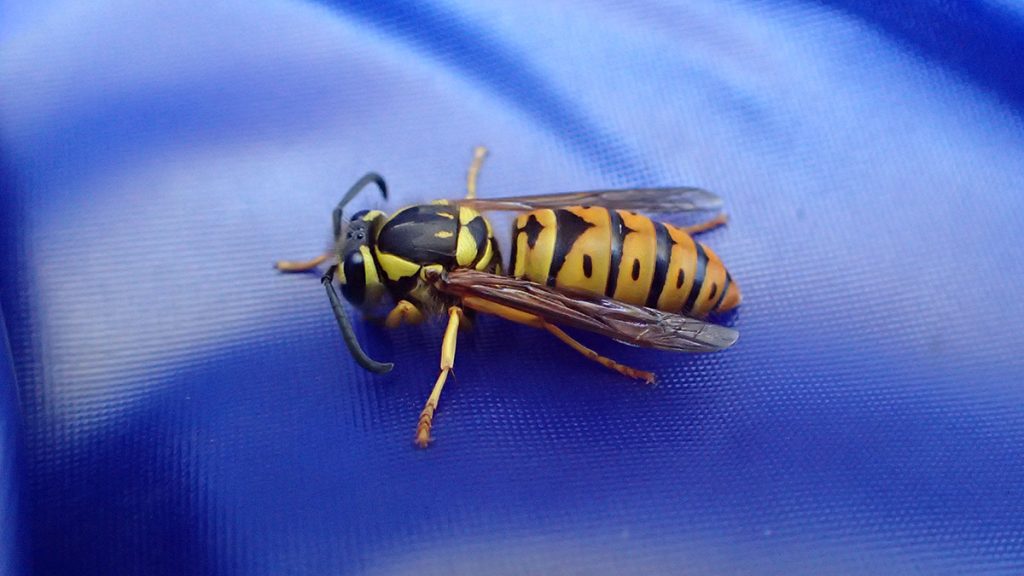
My wife was unfolding this inflatable kiddie pool to repackage it, and she found this wasp. The spots on the abdomen must have thrown me off, because it didn’t occur to me that this was an eastern yellowjacket. After iNaturalist confirmed its identity, I began to wonder about this solitary insect in the dead of winter. Bee colonies collapse before the end of year, and their queens mate before finding a secure place to spend the winter in a state known as diapause. I’ve seen a couple of wasp species flying on warmer days, but are yellowjackets one of the active winter wasps?
According to a page on the University of Florida Entomology Department web site, this is indeed a queen. Only queens have spots like these. We left her exposed for a few minutes during which she disappeared, either finding a new hiding place or, perhaps not yet fully awakened, taken by a predator.
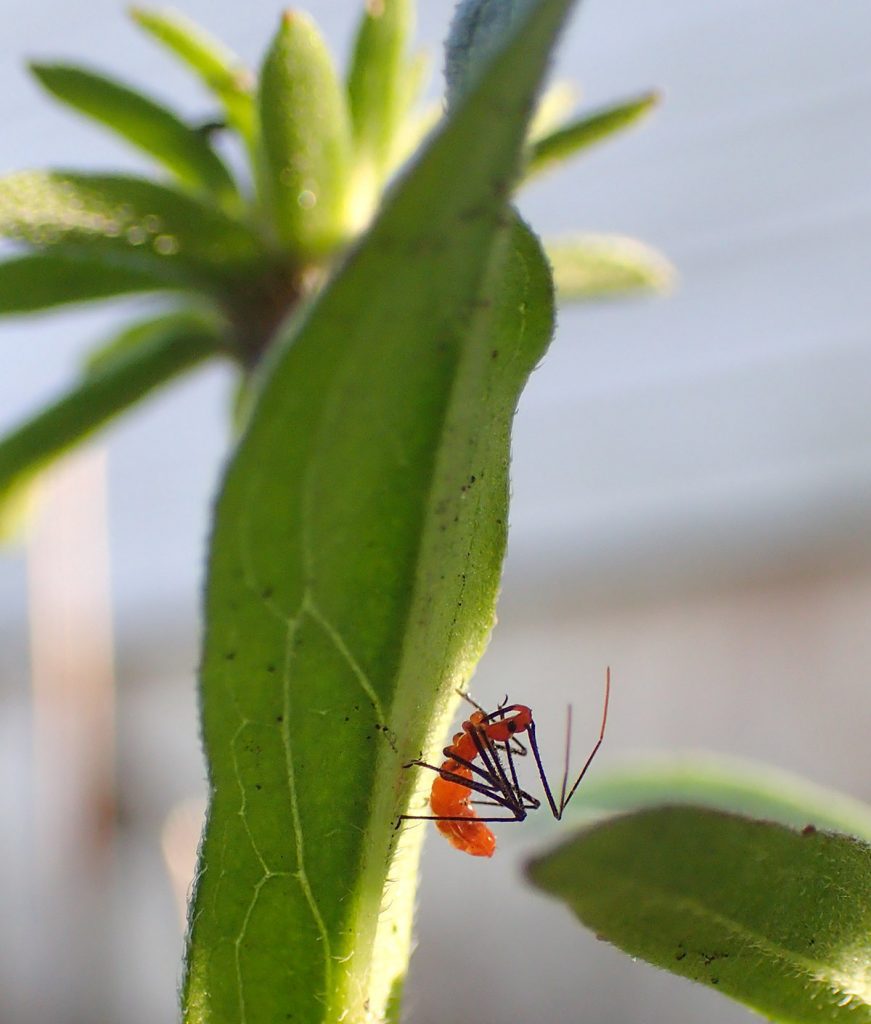
I checked the brown-eyed Susans to see if our milkweed assassin nymph was still hiding out there. This is a much better photo than I took in late December. Here, you can see its deadly proboscis tucked under its head.
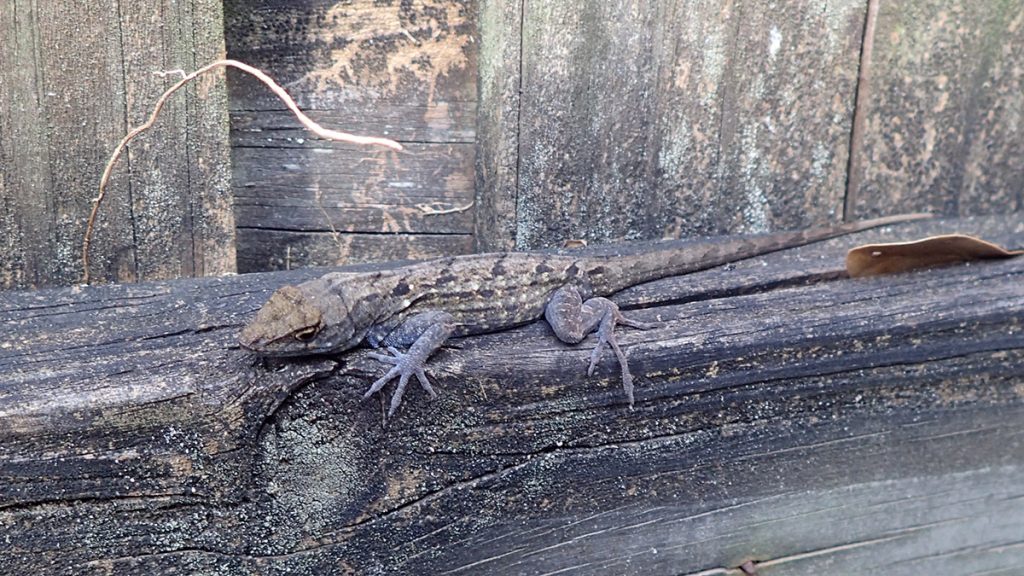
It was just warm enough today for this brown anole to venture out. This is about as active as I’ve seen the yard in January, aside from birds, without digging through leaves or into the soil.
As for the birds, I haven’t been snapping photos, but I have been watching. I occasionally hear the flock of robins down the street. One of them seems to have staked out a permanent spot in our cherry laurels, and what I’ve noticed is that it’s aggressive to other birds that want those berries. Robins are large for songbirds, and I’ve seen this one chase off a pair of cardinals, and chickadees as well.
January 9, 2021
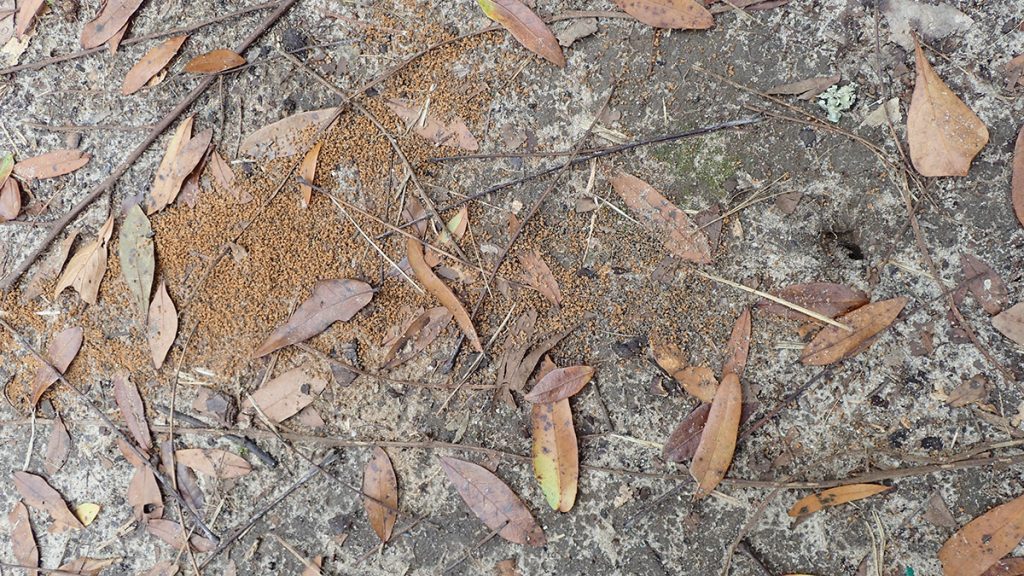
At the right in this photo, we see what appears to be a hole dug by an insect. Again, bare ground and fallen leaves are critical habitat for insects.
January 4, 2021
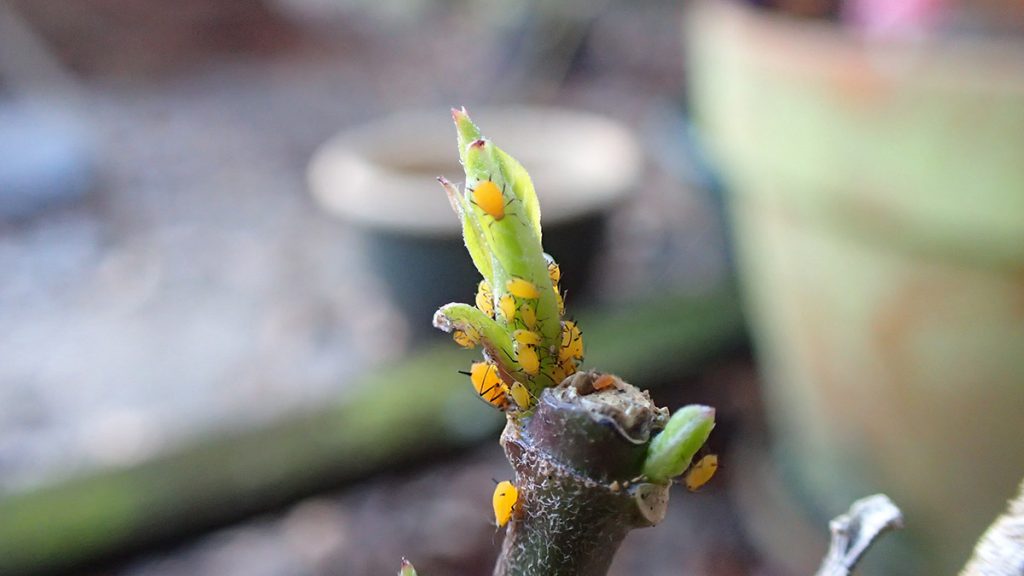
I dutifully cut back our nonnative milkweed in October, and it’s finally starting to grow new leaves. And just as soon as it did, we have milkweed aphids. In another part of the yard, we have native aquatic milkweed, which doesn’t lose its leaves in the winter. Those plants don’t have aphids, though that may have something to do with the milkweed assassin nymph I found on a neighboring plant.
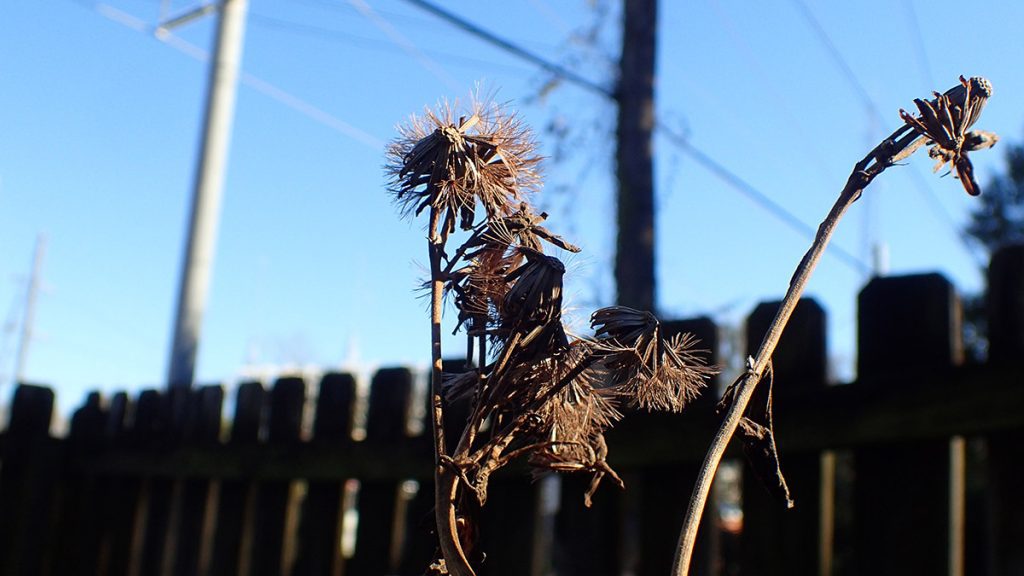
I may be in the minority here, but I do love the look of flowers gone to seed. It’s as much a part of winter as robins and mistletoe.
January 3, 2021
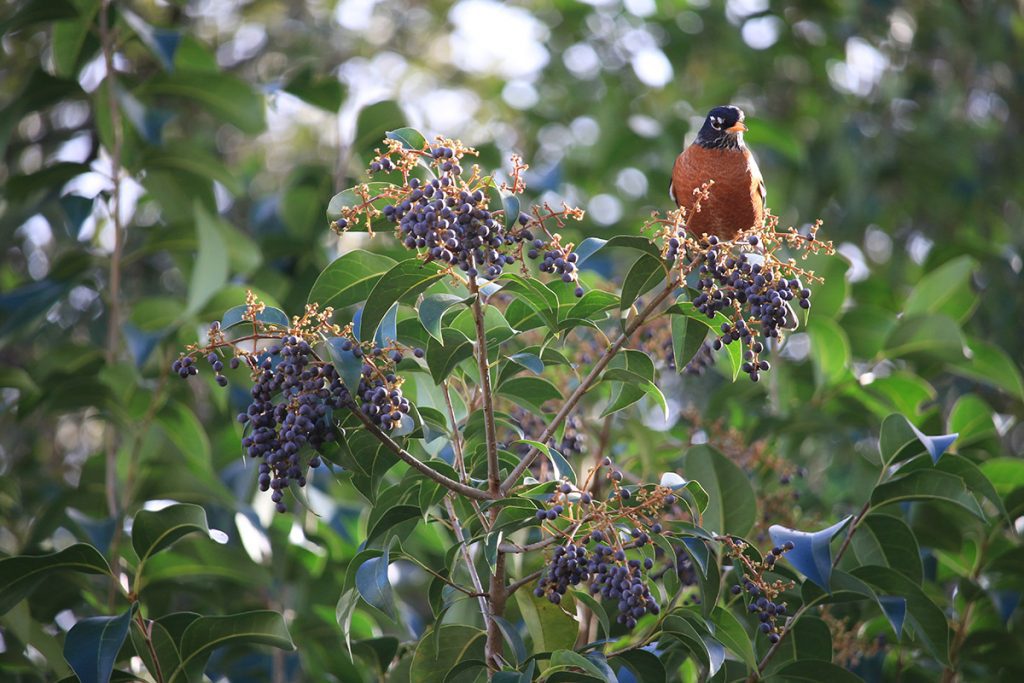
Flocks of robins are still flying around the neighborhood, even if they’re not raiding our trees in the same large numbers as New Years Eve and Day. I can’t help but notice how many berries are still on the trees. Was this an especially productive year for the cherry laurels? Pollinators flocked to their many flowers in May, and now I’m noticing more migratory birds on them in the winter. Was 2020 a good year for these trees, or am I finally noticing their ecological value?
January 1, 2021
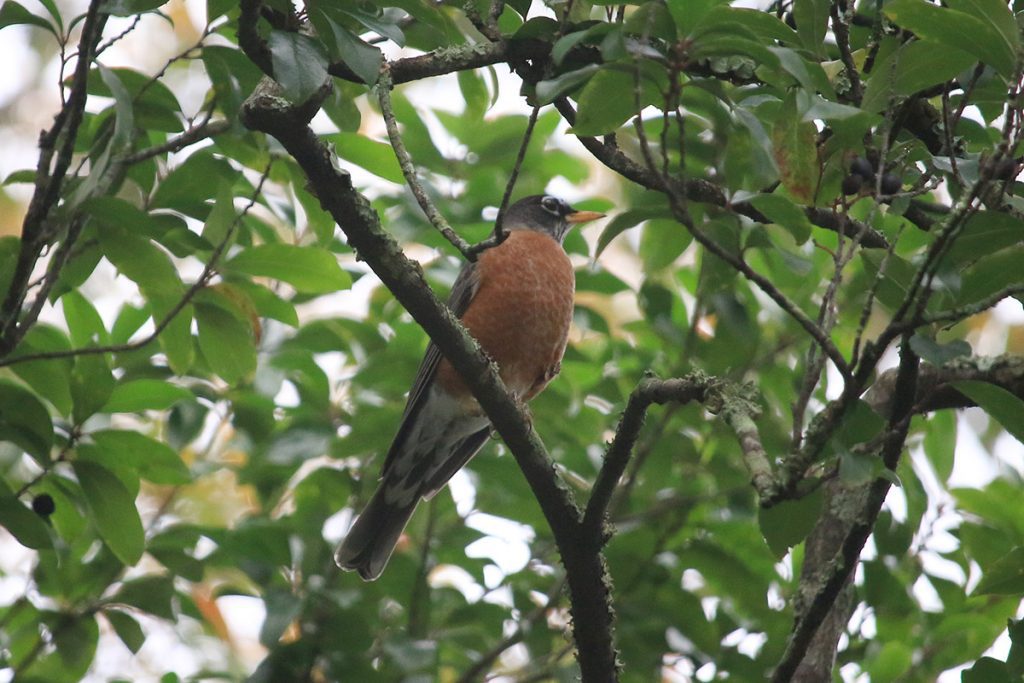
On the last day of 2020, flocks of robins and cedar waxwings feasted on cherry laurel berries over our yard. The flocks have been hopping around the neighborhood, with robins making an appearance for a little while in the morning.
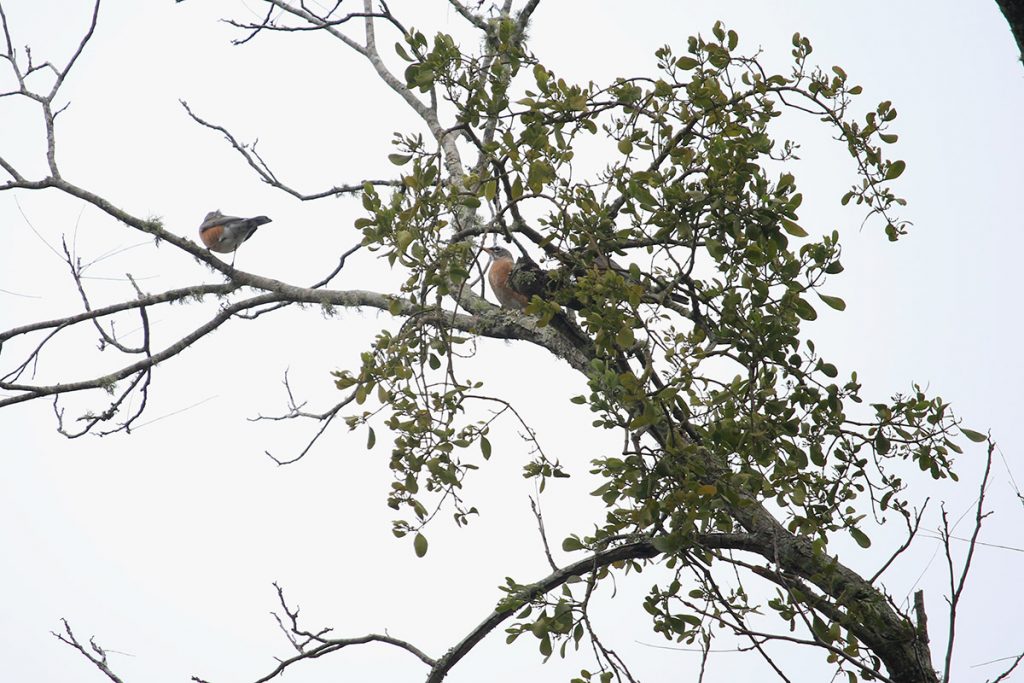
With insects scarcer in the winter months, berry producing trees like cherry laurels and hollies provide food for both our resident birds, and winter migrants like robins and cedar waxwings. Native vines like Virginia creeper and even poison ivy produce fruit eaten by birds as well. And then there’s mistletoe, which grows as a hemiparasite in trees, and fruits when those trees are leafless.
The mistletoe above is in our pecan tree. When robins visit our yard, I look to see if they’re eating any of those white berries (or any of the leaf footed bug nymphs I saw on the chunk of mistletoe that fell onto the driveway). They like to hang out there, anyhow.
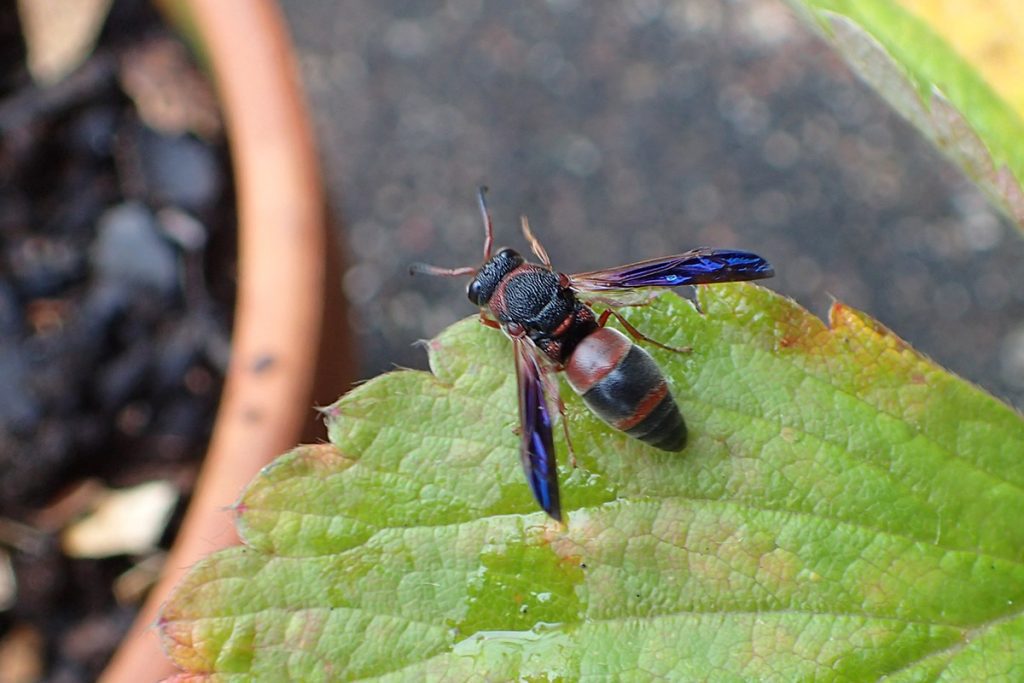
On the warmer winter days, I’ve been seeing wasps flying in the yard. I disturbed this mason wasp’s rest to take a photo. It was so still, like some of the bees and moths I’ve seen walking about as temperatures dropped in the fall. Many of those animals were dying, their offspring spending the colder months as larvae or pupae in leaf litter, or in the soil. Wasps seem to be a little hardier.
So what is hiding in the leaf litter?
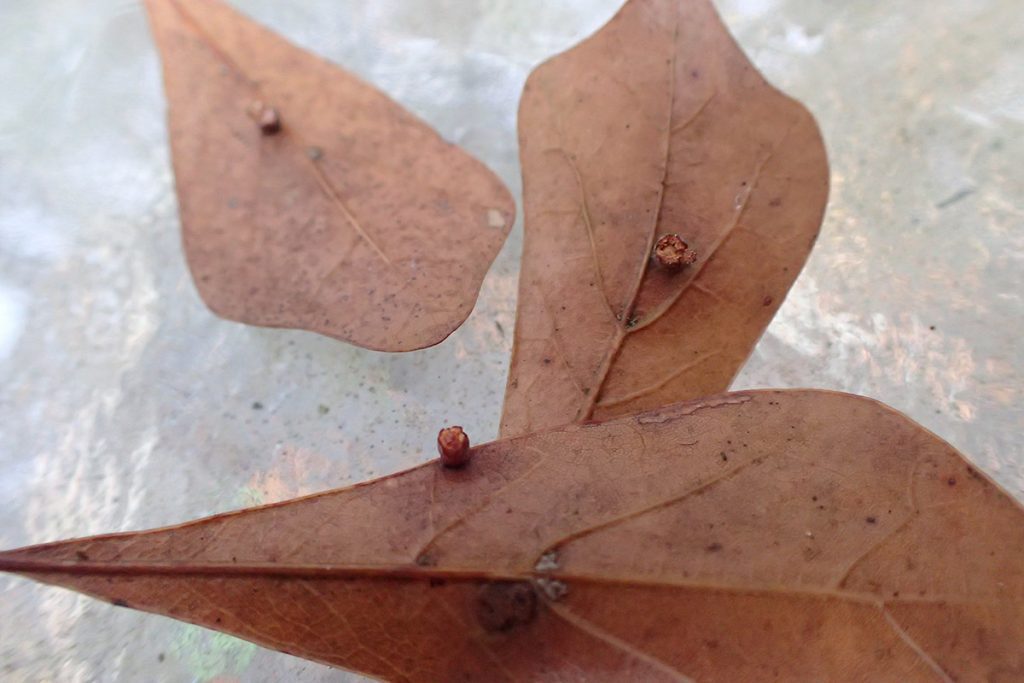
Speaking of larvae, pupae, and leaf litter, I found a few things when cleaning leaves out of a raised bed. I do like to let leaves alone in a lot of the yard. If I like seeing ground nesting bees, and much of the diversity of insect life I that enjoy, they need this habitat. But I do clean leaves out of raised beds with seedlings. Many animals that eat fallen leaves- snails, slugs, and roly-polies- will eat seedlings as well.
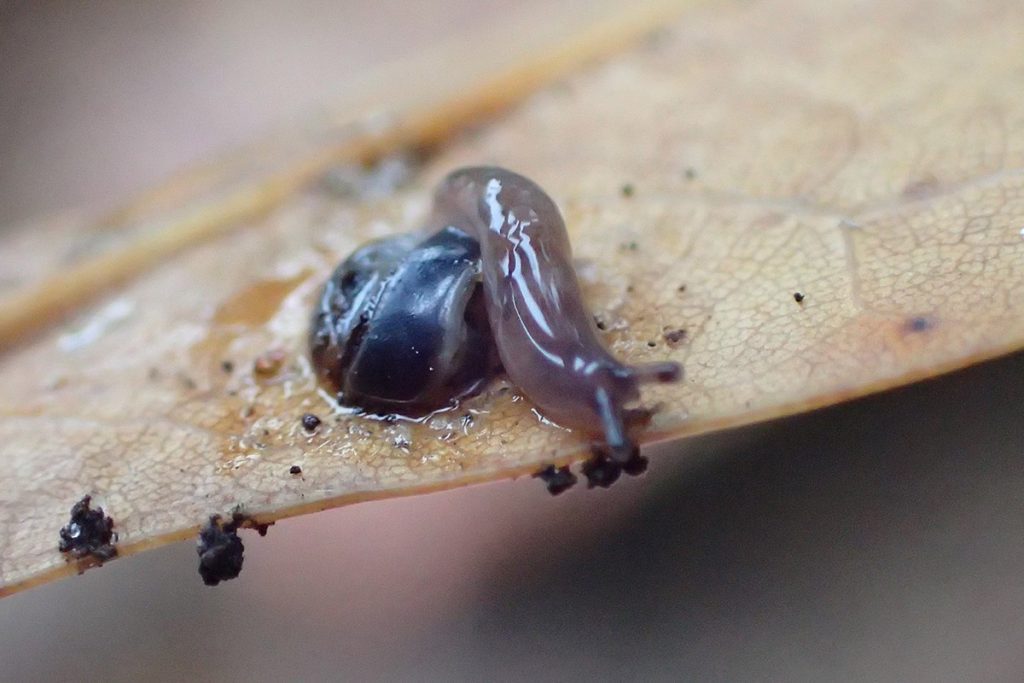
Clearing leaves, I find a lot of slugs and snails I move to other parts of the yard. But there are other interesting things as well.
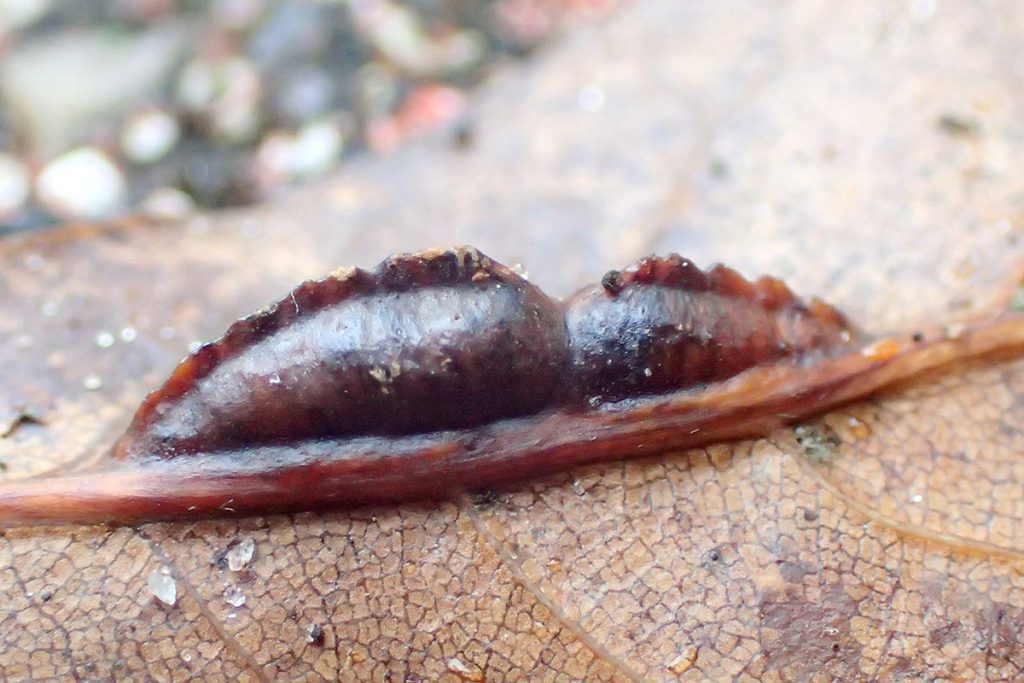
So many moths have similar looking caterpillars and chrysalides. I wonder if this one started high up in a tree and fell to the ground.
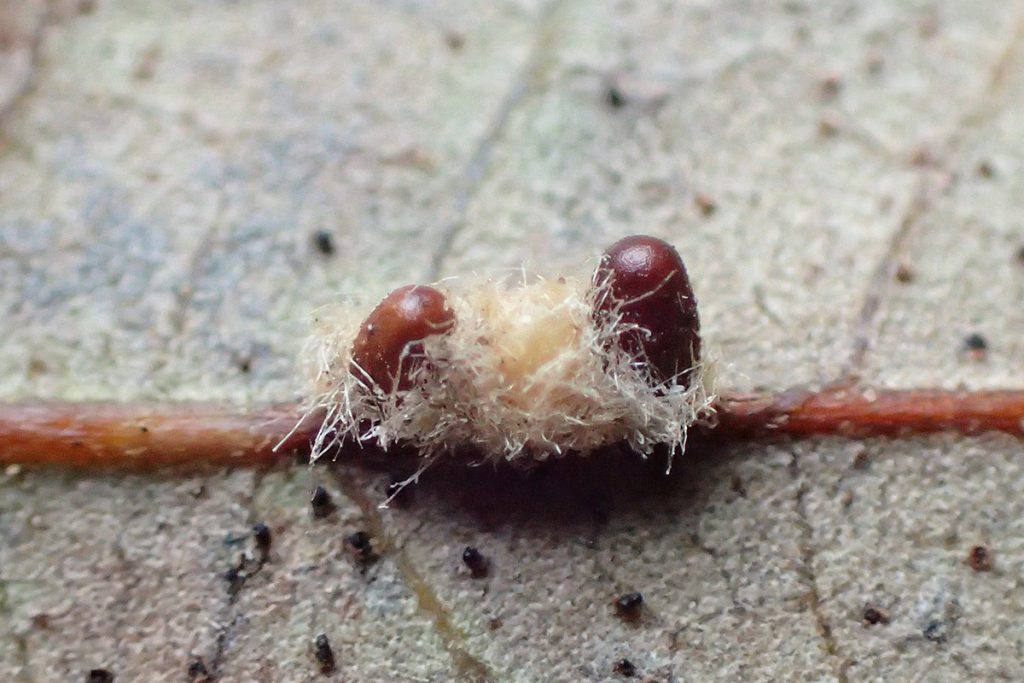
Gall wasps make so many different types of galls. Galls are structures made by this type of wasp, which injects a chemical into a leaf or branch when it lays eggs. The chemical creates a structure for the gall wasp larvae, which, depending on the species, can be perfectly round and translucent, or look like an acorn, or be pink and fuzzy.
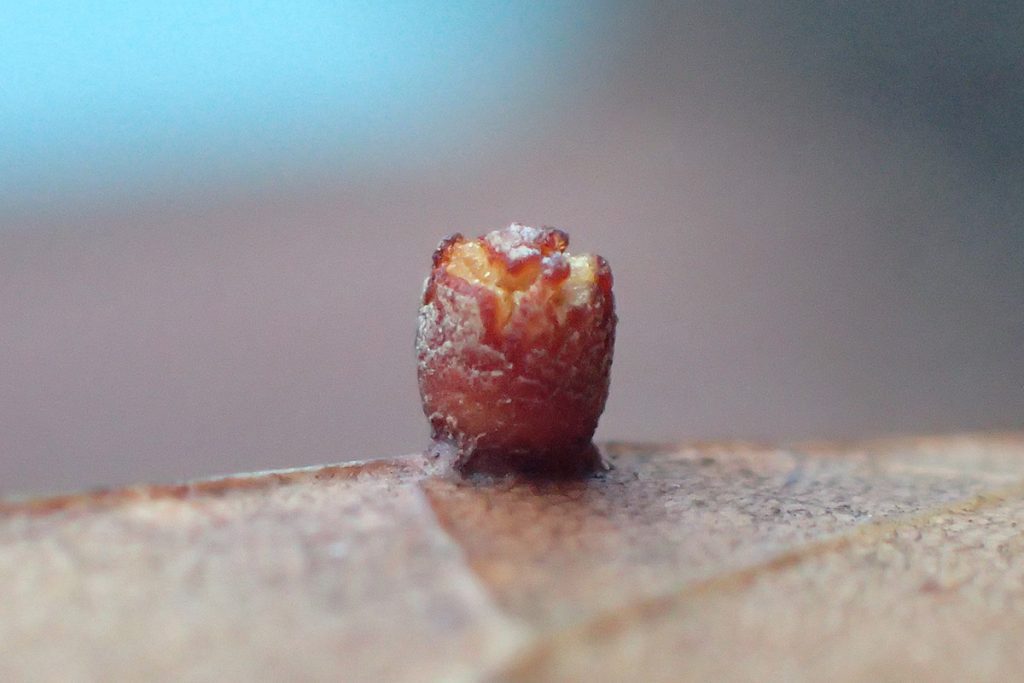
From what I could tell when comparing species on iNaturalist, and confirmed by one other user, this is a gall midge gall. Gall midges are flies, but they do the same kind of thing as gall wasps. This is a close up of the structure we see in the first leaf photo above.
Anyhow, this is the life I found under some leaves after a few minutes of searching. Pretty Cool!
Taking a closer look at some fallen branches
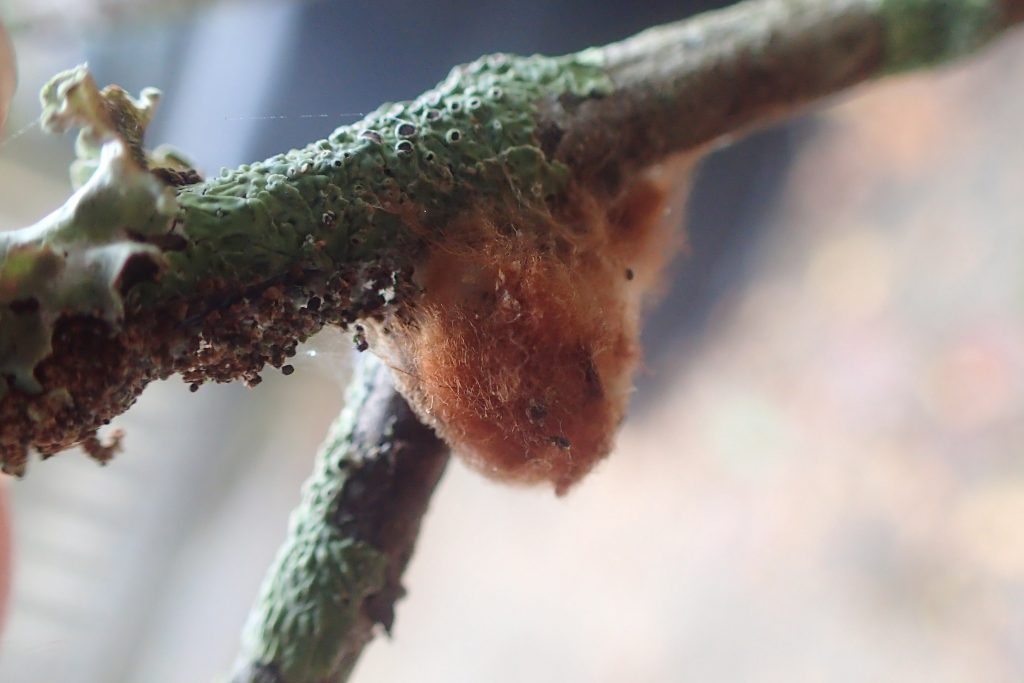
And while picking up branches, I found a couple more overwintering moth pupae.
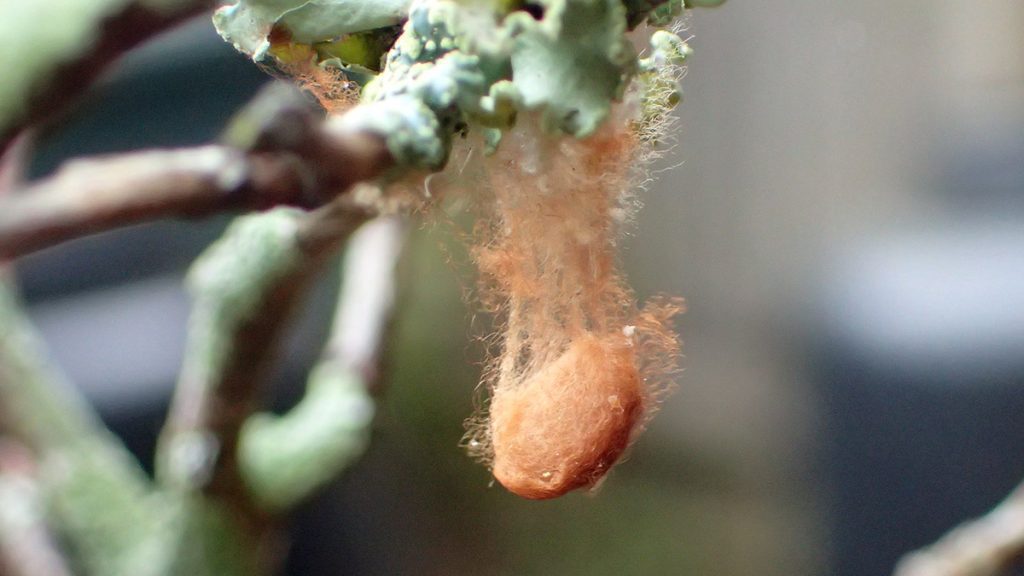
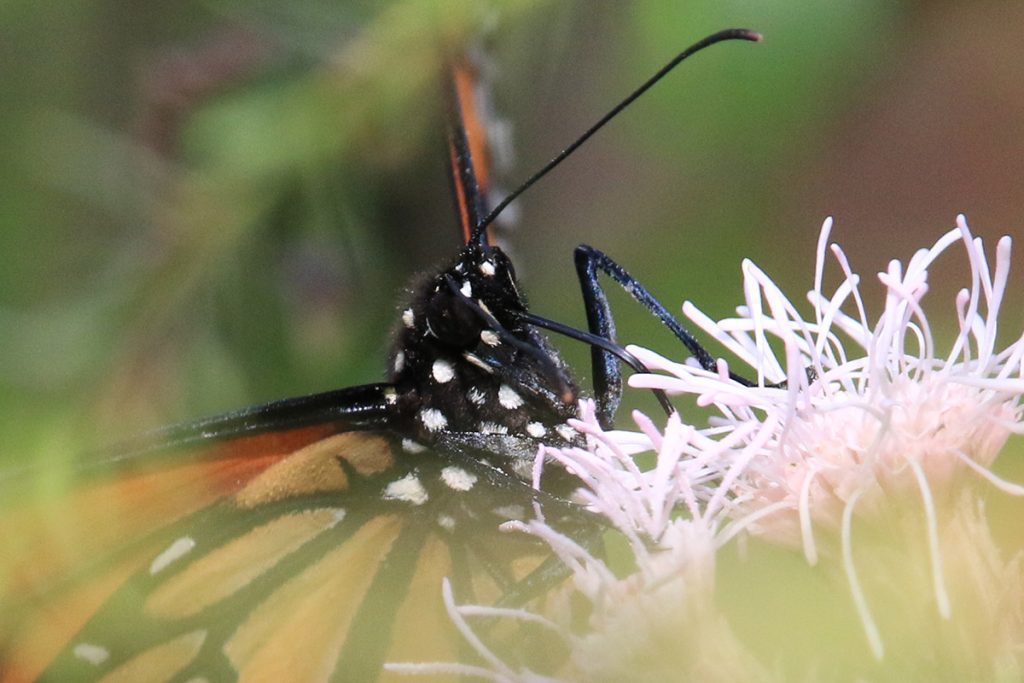
Dig Deeper into Backyard Ecology
What can we do to invite butterflies, birds, and other wildlife into our yards? And what about the flora and fauna that makes its way into our yards; the weeds, insects, and other critters that create the home ecosystem? WFSU Ecology Blog takes a closer look.
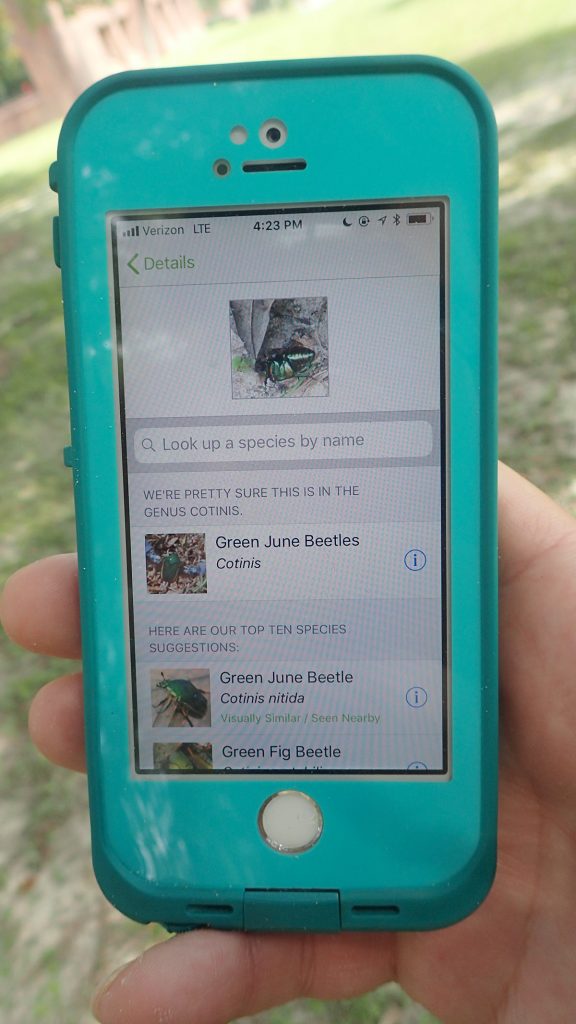
Apps and Citizen Science mentioned in the Backyard Blog
iNaturalist
Identify plants, animals, lichens, and fungi in your yard. Other users correct your identifications if you’re wrong, and even if they don’t, it can be a good springboard to further research.
Seek by iNaturalist
Instant identification, and it doesn’t record your location. This is a good option for kids with phones.
Monarch Larva Monitoring Project
Enter information about monarch caterpillars in your yard, and help researchers get a sense of the health of the monarch population that year, and how and when they’re migrating.
Great Sunflower Project
Record the number of pollinators visiting your flowers, and help researchers map pollinator activity across the country.


